Pittwater Roads II: Where the Streets Have your Name - Narrabeen
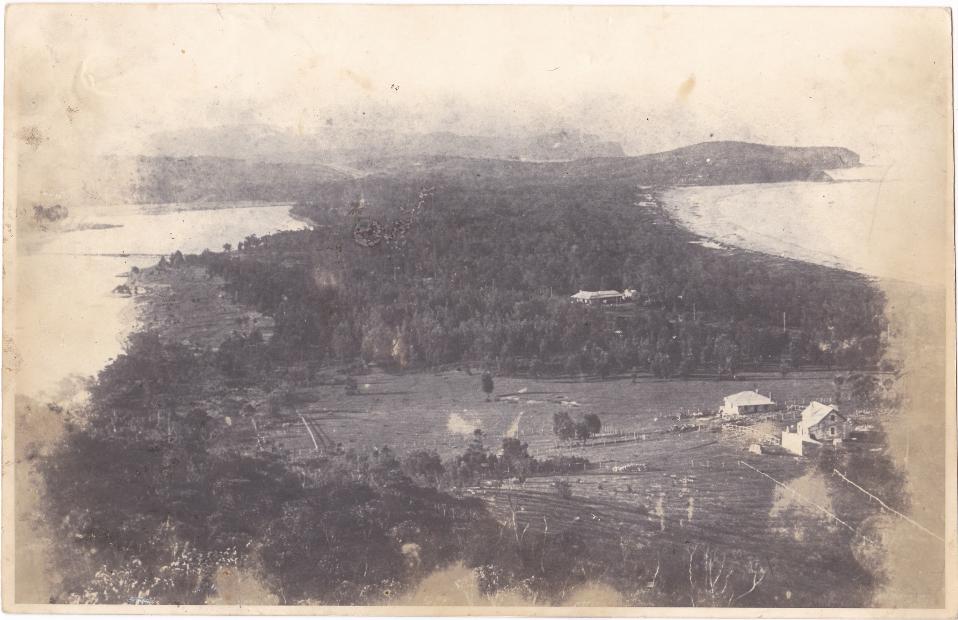
The Pittwater, Where the Streets Have Your Name series ending in Narrabeen presents a return to the commencement of the Roads TO Pittwater. Narrabeen returns to the initial 'gateway' roads-wise to Pittwater as it was along the original aboriginal paths that European colonises came, expanding these into tracks, with the first one then being named 'Jenkins' Road' as outlined in 'Roads To Pittwater: The Pittwater Road' and also seen in The Wild Coachmen Of Pittwater - A Long and Sometimes Bumpy Ride On Tracks Instead Of Roads and the commencement of a Mail Route that needed to include steamers that would call at Barrenjoey's Broken Bay Customs' Station and Lighthouse before continuing on to connect to the current day Central Coast. Our area of Pittwater was a place of coasters sailing down the seaboard to take goods to Sydney Town or, from the later 1860's, steamers that would bring excursionists in their thousands to visit and disembark at jetties for a few hours recreation in the country - Newport Wharf and Careel Bay Wharf being good early examples of these being built for those purposes. These jetties were also used as places to load produce, and later, as tons of produce was grown, or fish caught that needed transportation at Bayview, Church Point, the need for steamers to transport these, or later subdivisions at Coasters Retreat, Great Mackeral and Currawong, and schools for offshore children, resulted in jetties and dedicated local ferries for transport at these locations too. From earliest times, local fishermen mostly transported their catches to town themselves, as instanced in them being absent from one of the early Basin Regattas, and unable to win the £ that would have added vaubale income during those races, that Pittwater was alike a mini-Venice in that water transport was better than moving butter, fruit and grains along the Jenkins Road to the punt at The Spit.
What we today call the 'Mona Vale Road' came after the Jenkins Road- Pittwater Road as woodcutters in Warriewood, Church Point, Bayview, Lovett Bay, needing to transport whole trees via waggon tracks to places where they could be taken into town, did not eventuate until the early 1800's (1815-1820 on), while what we today call the Wakehurst Parkway was expanded from its original as a track to Oxford Falls during the later 1920's and 1930's for Soldiers Settlements or work connections and not completed until the 1940's and after World War II rationing of building materials eased, while the building of a bridge across The Spit did allow more access, this was essentially to fulfil public transport aspirations and connections, and funnelled more along the Pittwater Road.
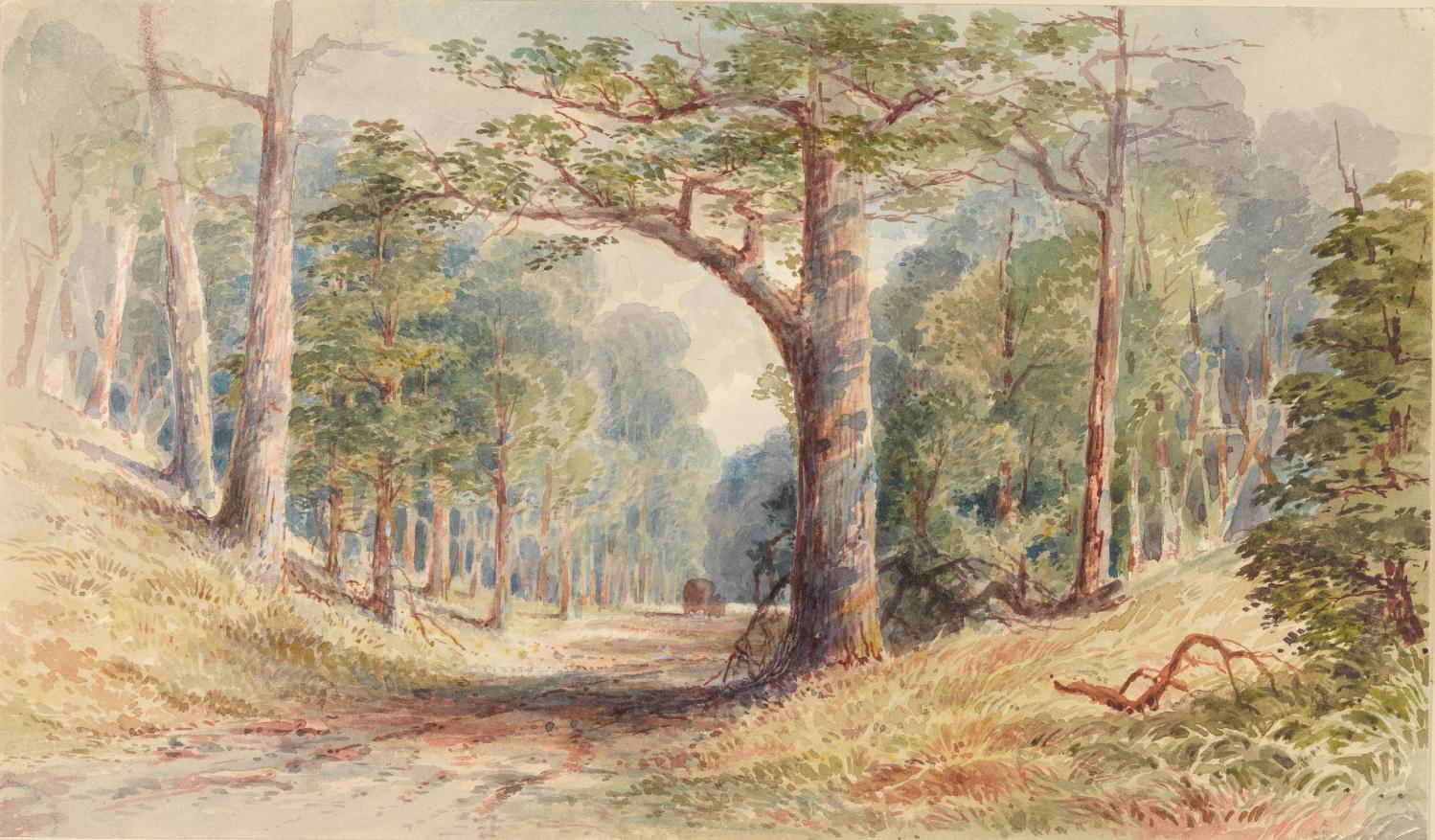
The roads and street developments record a shift from naming streets to honour the then ruling Monarchs and their children, as occurred at Careel Bay to streets named to honour the efforts of local people who built the community or worked to ensure it had what it needed. Roche avenue in Bayview, for example, honours a family who worked with other residents to ensure there was a wharf at Bayview, that worked to see a series of The Basin and then Pittwater Regattas bring people to the area so an existence that survived on farming and fishing could be extended to becoming a place to holiday, and were also among the many who gave sections of their land to be invested for the public good as places to permanently access the estuary or beaches and have a place to play – for recreation.
What the largest initial Narrabeen subdivision, that of John Wetherill's in October 1881, and Careel Bay in 1871, have in common is a core of stemming from 'co-operative communities' ideals, reflecting the places, circumstances, experiences and expressed beliefs of those behind the subdivisions and what had been happening in the United Kingdom. At Avalon Beach and Careel Bay Archpriest John Joseph Therry (1790 - 1864) wished to install one of these communities, a 'new town'.
'Josephton' was to be established on the shores of Careel Bay for his workers, those who sought coal at current day Avalon Golf Course, farmed or collected shells for the manufacture of lime. One of many wills he wrote illustrates his plans for his farm here:
"I desire that my farm of eighty acres, formerly known as Peter Petitta’s farm at Pitt Water, which is beautifully and most advantageously situated, should be divided into four equal parts of twenty acres each which are intended as the sites for educational establishments for the Benedictines, Jesuits, Franciscans, and the French Mission of the Propaganda respectively.”
Also; “to the land property with which I have been blessed, namely to establish five villages which are likely to become respectable towns the principal one at Pitt Water to be called Josephton” .
Other documents state he planned to call the whole district Josephton and Avalon was to be named 'Brighton' - while the first jetty at Careel Bay was named 'Clareville' and this name was extended to Avalon Beach for a while too. St Joseph is the Catholic patron saint for workers.
Lincolnshire born draper John Wetherill held similar beliefs and when the large Mount Ramsay Estate was drawn up for subdivisions in 1879, then released in 1881, the names he chose reflect, at least in choosing 'Octavia', a sympathetic connection to the expressed ideals and succesful models of social housing reformer Octavia Hill, and herknowledge, through her fathers' beliefs, of Lincolnshires' Robert Owen, a draper, textile manufacturer, philanthropist and social reformer, who was one founder of utopian socialism and the cooperative movement.
These ideas and structures developed the replacement of the 'tenant for life' with the owner of their own home and property, even if in 1/4 and 1/2 acre blocks,as the farms of acreage became places to live, surrounded by fresh air on healthy grounbds where 'beauty would meet the eye' and 'gladden the spirit' - 'lift up the soul'. This is where that Australian Dream of owning your own home commenced, along with schemes for green open spaces as suburbia, all initiated and supported by men who came here as paupers, or were born here and thus outside of the class system that excluded them from 'polite' society, and worked hard, worked in public office too, and began here what could never occur in the landed gentry system of the still ruling them from afar Great Britian.
That larger first Mount Ramsay estate subdivision, advertised as one of these 'new towns' being formed, in looking at the names chosen for those streets, and the stories behind their stories, presents a wonderful; example of this. This was a huge shift; to go from constantly being subject to eviction and starvation to being able to house and feed your children would lead to greater 'indulgences' such as education, having the right to vote, being able to purchase or create Art.
These people, as those in public office or those working in their own shops, fields and trades, worked together to create this shift - to draw up the architecture of it as a plan, to fund it through their own £ and pennies, to make it possible through the way payments could be met or giving the then expensive deeds for free. In some ways, although these street names were chosen to honour those presenting these ideals and making them happen during the times these lithographs were drawn, those who travel to their own little block along 'such and such' street were and are actually still are travelling there via and because of the work done by those inspired and practical people.
There is another Australian-first element that preceded this and allowed or encouraged this to occur; The Real Property Act 1858, 21 Vict. c. 15, or, in long title "An Act to simplify the Laws relating to the transfer and encumbrance of freehold and other interests in Land".
Robert Richard Torrens, son of Robert Torrens (economist and chairman of the South Australian Colonisation Commission), had previously worked in the civil service in customs roles in London and Adelaide, before being appointed Colonial Treasurer and Registrar-General from 1852 to 1857. He was elected as a member of the House of Assembly for the City of Adelaide in the new parliament in 1857. For years prior to his election, he had vigorously promoted the need for land titles reform, with the current system of transfer of land by deed ineffective, slow, expensive and insecure. It relied on verbose and complicated documents that had to be retained at least a century in order to validate new transactions and lawyers were needed to effect the transactions.
The Real Property Act 1858, was assented to on January 27th 1858 and came into effect on July 2nd 1858 in that state. It was well-received, apart from some lawyers who noted that the ease and clarity of the process would mean less in earnings for them. The Act transferred property by registration of title, instead of by deeds. It radically altered the method of recording and registering land under freehold title. Instead, government certificates were issued and a central register established. This system provided an indisputable record, thus almost eliminating litigation involving land disputes, got rid of difficulties created by lost certificates, and reduced the cost of land sales and transfers. The legislation was refined in the following few years, with Torrens overseeing major amendments to the Act in 1859 and 1862, which included allowing the licensing of registered land brokers instead of lawyers in land transactions, further reducing the cost.
Four main principles underlie the Act:
- Title to land is passed from one owner to another by registration on a public register.
- Title is evidenced by a government-issued and -guaranteed certificate issued.
- Once registered, the purchase is indefeasible; it cannot be set aside unless fraud is proven on the part of the purchaser.
- Land dealers who have been dispossessed of their land unfairly or accidentally are guaranteed compensation.
The first sale of land registered under the system was to pastoralist William Ransom Mortlock on August 25th 1858. So successful was the outcome that it was adopted in the rest of Australia and in many countries throughout the world. The system became known as the 'Torrens Title system', and the Act often referred to as the "Torrens Title Act 1858".
Torrens visited Victoria in 1860 and assisted in bringing in the new system in that colony. He also helped the other colonies to introduce their own variations of the system: Queensland adopted the 1859 version, while New South Wales, Tasmania and Victoria based their legislation on 1861 reforms. The Torrens Title system was introduced to NSW with the commencement of the NSW Real Property Act 1863.
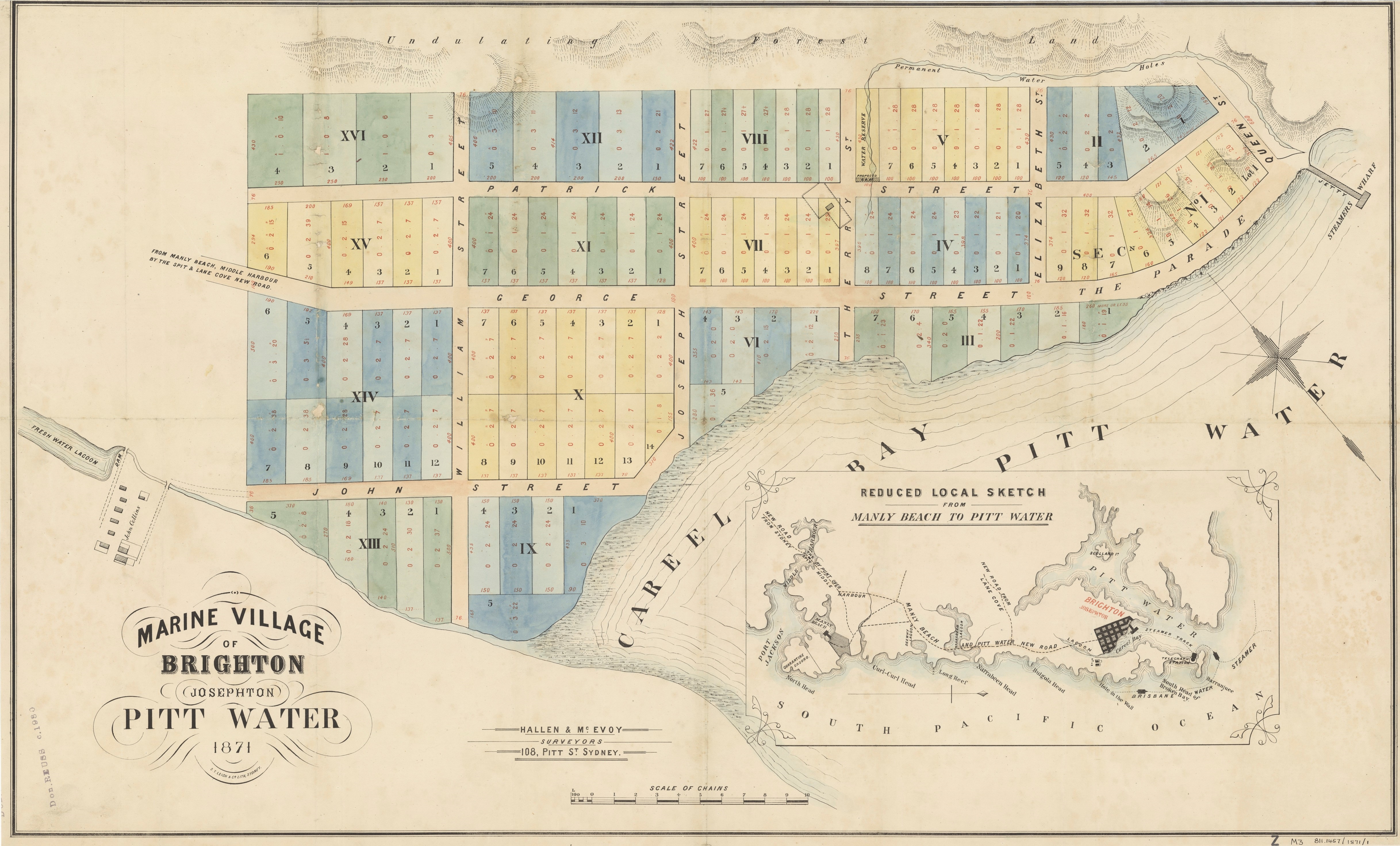
The 1871 'Josephton' Lithograph - Item e30116_0001_c
A further change towards naming streets using indigenous descriptive words as occurred during the 1930’s, 1940’s and 1950’s, particularly at Avalon, Clareville and Bayview, celebrate and honour a connection to the land is a further development of a uniquely Australian culture. Naming streets for Australian trees and flowers once found on those blocks also predominates some suburbs.
There are among these are the names of land owners' children and family members or those who passed away while the paddocks were being divided into blocks, but overall, love, not ego, and love of Australia is revealed at the core.
The series also highlights the commencement of a Town Planning vision for then and for the future that sought to ensure green connections through a series of pathways as well as park dedications and beach fronts being resumed through the efforts and policies of the then Warringah Shire Council.
Although some sections of the naming of streets in the Narrabeen surrounds have been collated in Pittwater Roads II: Where the Streets Have Your Name - Warriewood and Pittwater Roads II: Where the Streets Have Your Name - Elanora Heights, Green Hills and Ingleside, as a gateway to Pittwater itself in road terms, there were still a fair amount of larger and smaller developments, and even changing the landscape to facilitate some of these (Wimbledon Avenue) or creating a thoroughfare in the Wakehurst Parkway to provide access, that make starting where we commenced important.
Pittwater road, as an original 'Road To Pittwater', and the word ''Narrabeen'' itself as the gateway to all on the other side of the lagoon, is first recorded as 'Narrowbine' in February 1801 in the journal of Lieutenant James Grant.
In THE NARRATIVE OF A VOYAGE OF DISCOVERY, PERFORMED IN HIS MAJESTY'S VESSEL THE LADY NELSON, OF SIXTY TONS BURTHEN, WITH SLIDING KEELS, IN THE YEARS 1800, 1801, AND 1802, TO NEW SOUTH WALES. BY JAMES GRANT, LIEUTENANT IN THE ROYAL NAVY, [CHAPTER IV. Occurrences and Transactions in New Holland and New South Wales] his entry for February 1801 reads;
Governor King having appointed Garden Island for the purpose of raising vegetables for the crew of the Lady Nelson, I accordingly took possession of it. There was the shell of a tolerable house on it, which required much repair to make it habitable. I sent Dr. Brandt, who had volunteered with me at the Cape, with his dog and baboon to the island, as he had no inclination to go again to sea, having been much incommoded with sea sickness during the voyage hither. I therefore judged it would be a good place for him to reside at in my absence, and take charge of my property; a very necessary precaution against nocturnal visitors, who laid hold on and carried off every thing that was portable. As the poor Doctor was obliged to part with every article of provisions I had given him to some of these depredators, who paid him a visit, I applied to the Governor, who very readily issued an order that no person should attempt to land on the Island without his or my leave. This put a stop, in a great measure, to such practices. There not being any fresh water on it, I was obliged to lend the Doctor a small boat, which one person could pull about with a pair of sculls, till I could purchase one for the use of the Island; but, unfortunately the Doctor lost this. One of the young men who came out with me, and who had entered on board another vessel in the harbour, borrowed it from him for the purpose of fishing, leaving the vessel's boat that he came in with his companion till his return. Three days elapsed, and not hearing any tidings of them, the Doctor became very uneasy. I set on foot every enquiry, but without effect; and what vexed me much, was, that the young man was one of those who had run off with the same boat at Port Praya. I offered a reward to any one who would give me information of the boat; and though the weather was very bad, I was under the necessity of sending my first-mate round to Hawkesbury River with another in search of it. I also formed the resolution of walking to Pittwater, which joins the Hawkesbury, and branches inland a considerable way, affording many little Creeks and Coves, where the natives assemble at times to fish.
On the 25th of February I set out, the weather thick and cloudy, accompanied by a soldier of the New South Wales Corps, one of my own people, a native and his wife, as guides. Ensign Bareillier, of the same Corps, volunteered going in the boat with the mate. The path I took was intricate, but very romantic. As it rained hard towards evening, my guide halted near a wood, taking us to a place where two old men were sitting by a fire, and which had the appearance of several others having been there very recently. This temporary habitation was formed by a rock overhanging the place they were seated on, and called by them Gablegunnie, being the term for the hut, or the House of the Rock. The two men did not seem to receive us with any particular marks either of friendship or indifference; and from what I afterwards learned they were both doctors, which probably induced my guide to visit them, as his back had been much hurt, and he was troubled with a difficulty of breathing. They gave us from a bag-net a few fish they had gathered off the rocks; but on removing the skin, (which is used by them as bait in fishing,) they smelt so offensive that we could not eat them. I gave them some bread in return, and we parted well pleased with each other. They told us that a little farther on there was a party of natives employed in fishing, who had two huts built near a long sandy beach. As the night was likely to be very dark with heavy rain, I intended, if possible, to shelter ourselves with them. Our guide was so ill, that he appeared incapable of going on with us, and promised to get one of them to accompany us to Pittwater. ....
I found the huts larger and better constructed than I had as yet seen or heard of: they were built of timber procured from the wreck of a small vessel, which lay stranded on the shore at no great distance. In one but there were three men, four women and two children; and in the other, which was very small, a a man and his wife. The natives very kindly took from their hiding places some large and excellent fish, such as snappers, and salmon, so called in this country, I presume, from their scales. These they laid whole on the fire, which was placed in the middle of the hut. As soon as one side of the fish was done they placed it on the other, opposite to where I sat, beginning to eat while that was broiling, inviting me by signs to follow their example; which I and my companions readily did, being both hungry and wet, it having rained very hard, and we found ourselves very comfortable. Situated as we were, I could not avoid remarking to myself how easily nature was satisfied; the only thing I wanted being salt. The curiosity of these poor people with respect to many things about us was very great; particularly in observing a head raised in silver on the butt-end of the pistol stuck in my waist-belt; and also in the ticking-noise of my watch, which the women and children wondered much at, mimicking its sound as they held it up to their ears.
Having sent my guide and his wife with the seaman to the small hut, I and the soldier lay down to sleep with our feet to the fire. One of the women was very ill during the night, and groaned much, being seized with spasms in her stomach, as I afterwards understood. In the night-time the soldier was wakened by one of the men, who requested he would go with him to fetch some water. On the former (who understood the language) asking him why he could not go alone, he was answered, "You know me murrey jarrin, that is, much afraid. The soldier being unwilling to stir, asked, "What he was afraid of? The native said, "of the Bogle;" the term for the Evil Spirit, or Devil; which shews that superstition is very predominant amongst them. As I wished for some water, I desired the man to get up and bring me some, which he did in a small vessel shaped like a canoe, made of bark, the native accompanying him.
We got up before day-light, and having taken one of our hospitable friends for a guide, who was both more robust, and stronger than the natives are in general in this part of New Holland, he armed himself with a spear, and moved onwards with us till we came near to the banks of a stream, which the natives call Narrowbine. It was but barely peep of day, and objects were not easily distinguishable, yet the native informed me he saw somebody on the opposite side. As we proceeded on we soon perceived a person walking by the river side, but could not ascertain whether he was a native or not. Our guide, however, on enquiry said, that is, "no black fellow", and that he had a musket with him. Some of the Convicts having about this time absconded and taken with them the Norfolk sloop, with an intention of leaving the country, were cast ashore, but a short distance to the northward. They had been daring enough to attack and seize a settler's boat going to the Coal River; and as many of these people were still out, I made no doubt but he was one of them. The stream from the rain which had fallen during the night, and the tide of flood being in, as it was in the vicinity of the sea, was become deeper and more rapid than common, and had obstructed the fellow's progress. I called to him, and asked who he was, and where he was going? He answered, that he had been Kangarooing, had lost his way, and was almost starved. From the latter circumstance I was certain he was one of the Convicts, and therefore I desired him to stop, as I was going over, and would shew him the best place to cross at, which he had enquired for. While we were stripping, I desired the native, who was in a state of nature, that, if he saw the fellow attempt to get way, he would stop him, and should he offer any resistance, to spear him. The river was so deep that it came up to his chin; and as he was taller than any of us, we were under the necessity of leaving our clothes behind, and making two trips, in order to keep our fire-arms from the wet, which was not an easy matter, being obliged to carry them over our heads. The bottom of the river was very rugged with sharp-pointed rocks, which made us stumble and cut our feet; however we got over.
The poor creature gave himself up to me without condition, confessing he was one of the party who ran away with the Norfolk. At this moment he presented a most pitiable sight, being literally almost starved, and had he got across the Narrowbine, he never would have been able to reach Sydney. As to the musket, instead of being of any service to him, it was rather an incumbrance, as it was totally unfit for use. His comrades and he had endured the greatest misery and distress through hunger and fatigue. On being informed that some of them were taken and executed, he burst into tears, and said he was sure nothing could save him. He had a wound in his leg, which he got from a species of scate called a Sting Ray. In attempting to kill it in a shallow stream it had found its way into, it threw the sting, (which in large ones is sometimes eight or nine inches in length, indented like a saw,) through the calf of his leg. The fatigue of walking, and the scratching of the bushes had inflamed it to a great degree: his feet were also wounded and ulcerated from rocks and stumps of trees. In short, he was so wretched and helpless, that I directed my two companions to support him between them to Pittwater, where my boat was to meet me. The little bread I had remaining, bad as it was from the wet it had met with, was devoured by him with avidity; and this, with a little spirits I had left, recruited him. He shewed me the place where he had lain all night, on a few branches spread under a tree, without fire, and exposed to the heavy rain. On being asked where he had left his companions, he said, that himself and two others of the party, had left the remainder near Port Stephens, which is some considerable distance to the northward of the Hawkesbury; that they had some intention of forming a settlement there, until something should turn up favourable for them; that they had planted a few pumpkin and melon-seeds, and some Indian corn, which had come up, but was insufficient for the support of seven or eight persons. The ring-leader, who was there, had determined not to return. This man had been very ill with an intermitting fever, which indeed had been experienced more or less by all of them; and it was his intention, and that of two others, who left the place, to return and give themselves up; but one of them being very ill, he quitted him and his companion, who chose to remain with the sick man, on the other side of Pittwater. They had suffered much from hunger, living principally on the cabbage-tree; and he affirmed, that when they fell in with the natives, they behaved very ill to them; that indeed from some they got a fish or two; but that others, instead of assisting them, took away what rags of clothing they had left. This last circumstance is, in my opinion, rather improbable, for unless it be a blanket, I have never known any of the natives express even a wish for any article of clothing. On being asked how he got over Pittwater, he informed me that meeting with one of the natives, then on the banks, whom he knew, he partly through that acquaintance, and partly through the offer of a shirt, prevailed with him to put him across in his canoe; but that he had much ado afterwards to prevent some of them from spearing him, as they all asked him for bread, which they supposed he must have. Whether this was true or not with respect to his adventures, it is a fact that all the natives about the Settlement, or at a distance, who have tasted bread, are very fond of it, and always ask for it. No doubt the general keen state of their appetites may be a powerful incentive at the time they desire it; and it is not improbable that some of those he met with, being hungry, and encouraged by his helpless appearance, might endeavour to terrify him with the spear. The gun he had in his hand, he believed, prevented them from putting their threats in execution.
After experiencing much difficulty in getting this unfortunate wretch along, we soon discovered our boat by the help of a bugle-horn, two of which I had brought from England with me. These instruments are of the utmost service to all who have to travel through pathless woods, where the sight is intercepted, as they can always be used when a musket cannot. If they are made of different sizes, or of metal and horn, the sound will vary so much as to make it easily known which party they belong to: besides, ammunition will be saved by their use, which is often of the utmost importance. If made of a large size they will serve to carry water in occasionally; and this is often a very acceptable service in woods at a distance from a river. In short, in all business of discovery, these and a few watchmens' rattles, (some of which I also had with me,) will be found very useful. I had agreed to meet the boat at a certain part of Pittwater, but as neither my mate nor I had ever seen it, and our guides being little acquainted with the spot, I had recourse to the bugle. I was answered from the boat with the same instrument about a mile and an half distance from us. I hope this will fully illustrate the superior usefulness of the bugle-horn in respect to the musket (a signal which might have misled us as being used on other occasions); besides which the former, not only from the sound itself, but from the long continuance of it, has the best chance of being heard. My officer had made very diligent search for the boat taken from Garden Island, but without success. The poor runaway Convict was put into the boat, and supplied with food, which from the manner he began to devour it, I was obliged to give him very sparingly. The boat party had suffered much from the rain during the night, as well as from the heavy sea they were exposed to in their passage. We kindled a fire on the bank of the river, where we breakfasted. Pittwater is very broad at this place, dividing itself into several branches, which made a strict search for the boat very troublesome. I ordered the mate up to a small island, named Mullet Island, (perhaps from the great plenty of fish of that name in its vicinity,) giving him orders to examine the shore carefully on each side, and make enquiry of the natives or settlers that he might meet with. I concluded any farther search after this would be unnecessary, as above the island the boat would be discovered and secured. Ensign Bareillier preferred walking back with me and my party. We made an excursion to the top of Pitt-water, which ends in a mud flat of considerable extent. In the course of our walk we were much annoyed by a small aquatic plant of a conical form growing in clusters, with sharp points peeping through the mud. These, and innumerable small oyster-shells, washed from their native beds by the tide, fatigued and pained us in an uncommon degree. The before-mentioned plant, from its insignificant appearance, seems to have been but little noticed. It hardly ever exceeds five inches in length, and its thickness differs according to its age, seldom exceeding that of a man's finger. It is of a pale yellow colour on the top, very hard and tapering to a point: the nearest resemblance it has to any plant I know, is the asparagus when peeping through the earth. After searching the banks of the river without success, we proceeded on our return to Sydney; to which we were the rather induced from the small supply of provisions, particularly of bread, which we had procured from the boat. We were also in hopes of again seeing the natives we had met with the night before near the Narrowbine, who would supply us with some fish. The native we had as a guide had been probably induced to accompany us for the sake of getting plenty of biscuit, of which, as already has been mentioned, his countrymen are remarkably fond. As it was not full tide he led us along the sea shore under the heights we had travelled in the morning, and very near a gunnie, or house, which he made us understand was the place of his birth. The flood-tide set in very rapidly, which, with our having to travel over a large range of rocks, much retarded our progress, and from the dashing of the waves against the base I was apprehensive we should not be able to accomplish our intentions, but our guide pushed on, and wherever the passage was difficult or dangerous, he either pointed out the steps we were to take with his spear, or held out his hand to assist us. He always carried some of our things, particularly my boat-cloak. It is but proper for me to observe, that the care and attention of this rude and uncivilized Savage was highly exemplary, and merited our best regards.
Upon our arrival at the spot where we left the natives, to our great disappointment we found they had removed themselves. It was now about three o'clock, P.M. and it was dark about seven. From Rose Bay, where I had ordered the boat to meet us in the morning of the following day, it was nearly five miles to Sydney Cove. The guide, who now became very hungry, seemed as desirous as ourselves of finding the natives. He endeavoured by looking at the paths to find out which they had pursued; accordingly he pitched on that which led to the place where we had before seen the two canoes on the sand; but on reaching the spot they too were gone. As the canoes were not large enough to hold all the people we had seen, he informed us he knew the path the remainder had taken. We accordingly, at his request, walked at a round pace in quest of them, and on our way along the shore he picked up a lump of what appeared to me to be the Epidermis which adheres to rocks, and which the force of the tide had thrown up. It was composed of a glutinous substance and very fetid, yet in this disagreeable state he sucked and eat it. I have seen the Dutch fishermen at the Cape of Good Hope make use of it as bait. In following the track he led us, we penetrated a short distance into the woods. By the time we reached the place to which I had ordered the boat it was nearly dark; but as the natives the guide was searching for could not be a great way off, we were anxious to get to them. In the accomplishment of our purpose he led us through various thickets to places likely to be their haunts; and occasionally set up a kind of howl, at the same time listening if any answer was given. After he had howled thus for some time, we discovered a fire kindled on a height close to the shore, and soon after our guide's howling was answered by similar outcries, and the fire was seen to blaze forth. Here a kind of conversation took place betwixt them; when he informed me that he had told them he was very hungry, and their answer was, that at a short distance from where we then were, another party was to be found which had plenty of fish. Accordingly he conducted us to the spot where the boat was ordered to rendezvous, and giving me my cloak and the other articles, said he would find out his companions: he ascended a height and was soon out of sight. The moon now shewed a little light, having been obscured by clouds, and as a good many showers of rain had fallen during the day, the ground was wet; however, being very tired, we laid ourselves down on the sand, intending to wait till morning, for as to our hungry guide we did not expect his return. In about three quarters of an hour after his leaving us, to my great surprise, we heard the sound of voices approaching us, and it proved to be my first guide and his wife, already mentioned, coming towards us, dispatched by the others to our assistance. They brought with them a fish of about four pounds weight. Here was another trait of the friendly disposition of these poor people worthy of being noticed. Our quondam guide told us, that there had been a boat seen with two white men fishing in it a little before it grew dark, a short distance from where we then were. One of my people instantly set off with him in search of the boat, and soon after we heard the noise of oars in the water. In this boat were a man and boy going to the southward a fishing; but from the unsettled state of the weather, they chose to remain for the night near the harbour's mouth, that they might be ready to push out in the morning. They readily undertook, for a small gratuity, to pull us up to my house on Garden Island; and having taken leave of the friendly natives, we pushed off; and I got home about eleven o'clock at night.
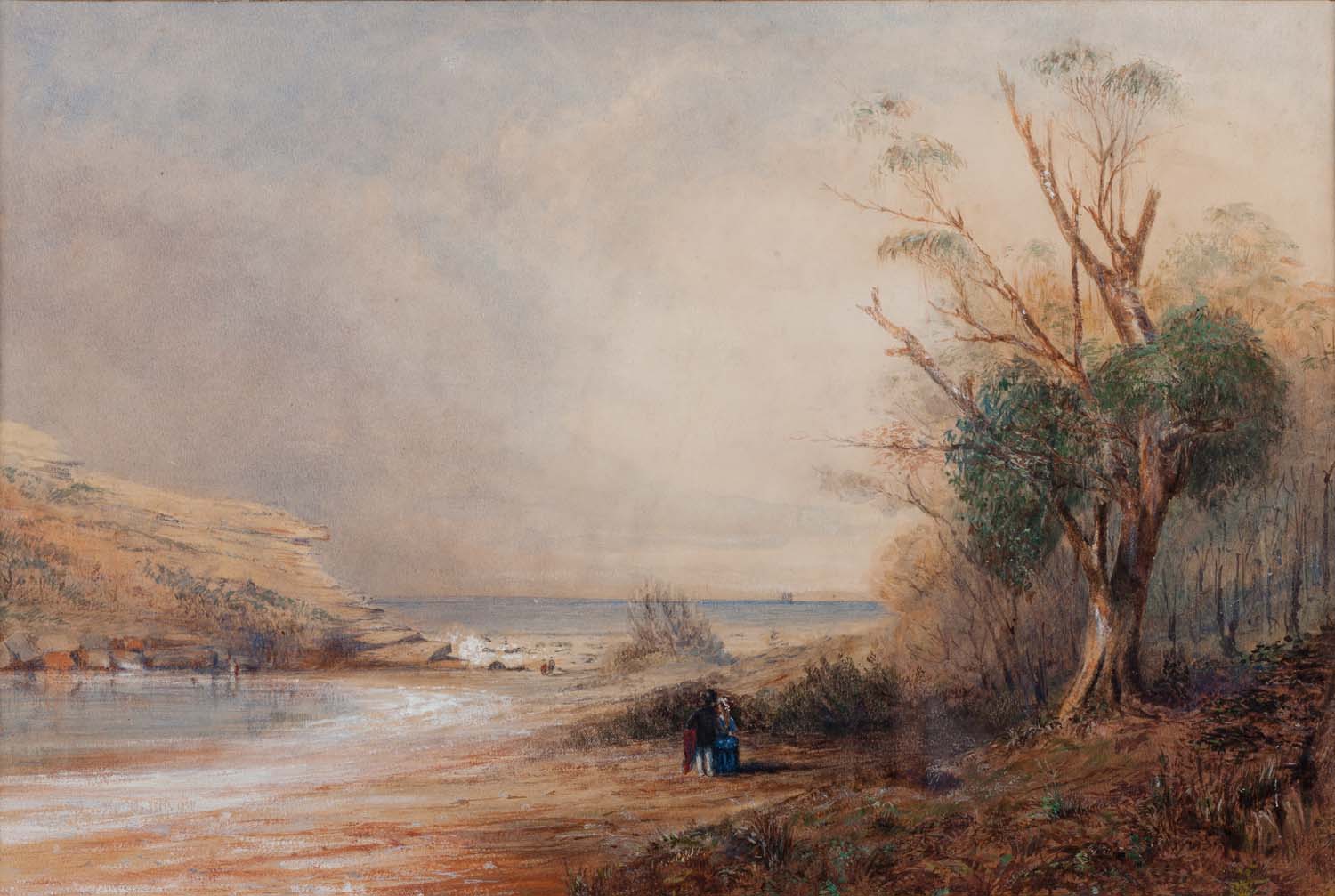
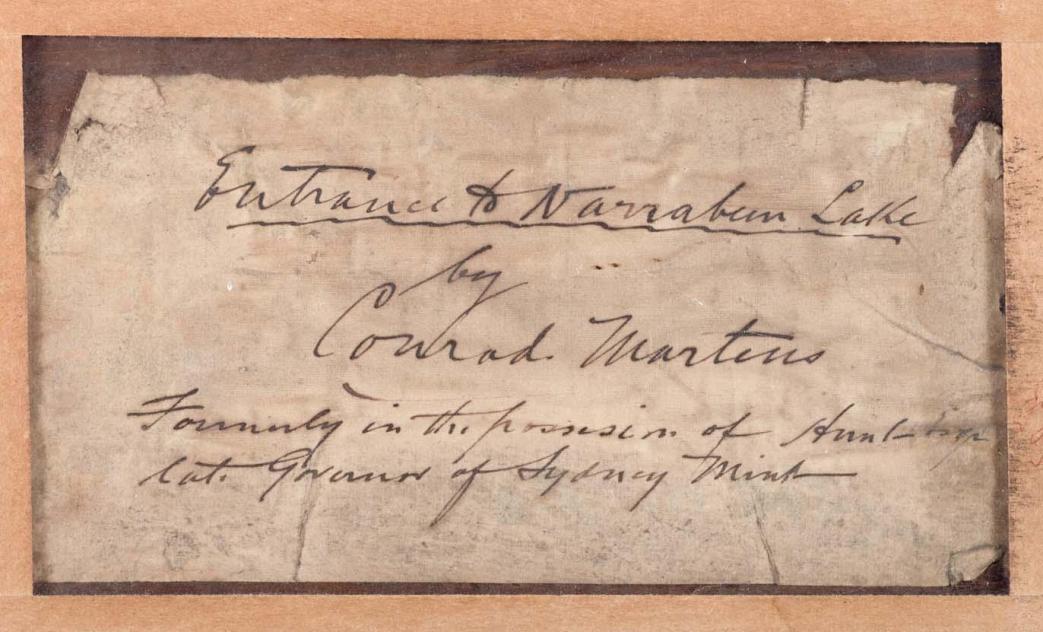
The spelling 'Narrowbine', without any indication of how this was actually pronounced, is one of a few spellings of what is currently spelt 'Narrabeen'. There have been 'Narrowbean' with one report stating the name refers to a type of bean that grew beside the lagoon, 'Narrabang' when describing John Ramsay's 410 Land Grant in 1818, 'Narrabene' as used by a member of the Jenkins family when offloading their 'inheritence' in 1877, as well as 'Narrabeen' and stating this was the name of an indigenous girl who, legend would have it, saved a settler from bushrangers. The February 1801 record in the journal of Lieutenant James Grant as a name given to the body of water is the only direct to those already present word or name on record - and how it was pronounced does not form part of that record.
Narrabeen was the name originally given to the stretch of beach and land between Narrabeen Lagoon and Long Reef - the name 'Collaroy' dates from a street named for the steamship of the same name in 1881.
Within a few decades of this hike from the Sydney harbour to the Pittwater estuary a series of land grants had been made:
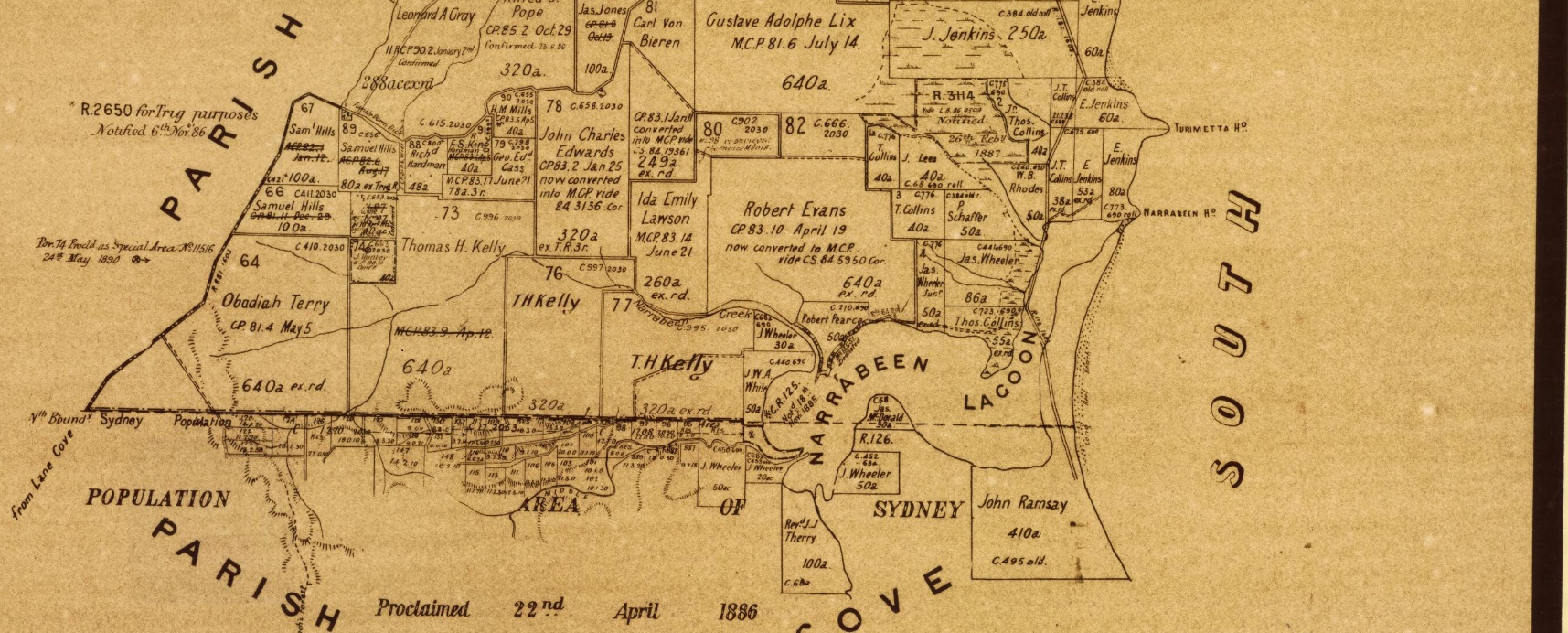
Section from: New South Wales. Department of Lands. (1886). Parish of Narrabeen, County of Cumberland Metropolitan Land District, Eastern Division N.S.W Retrieved from http://nla.gov.au/nla.obj-233833505
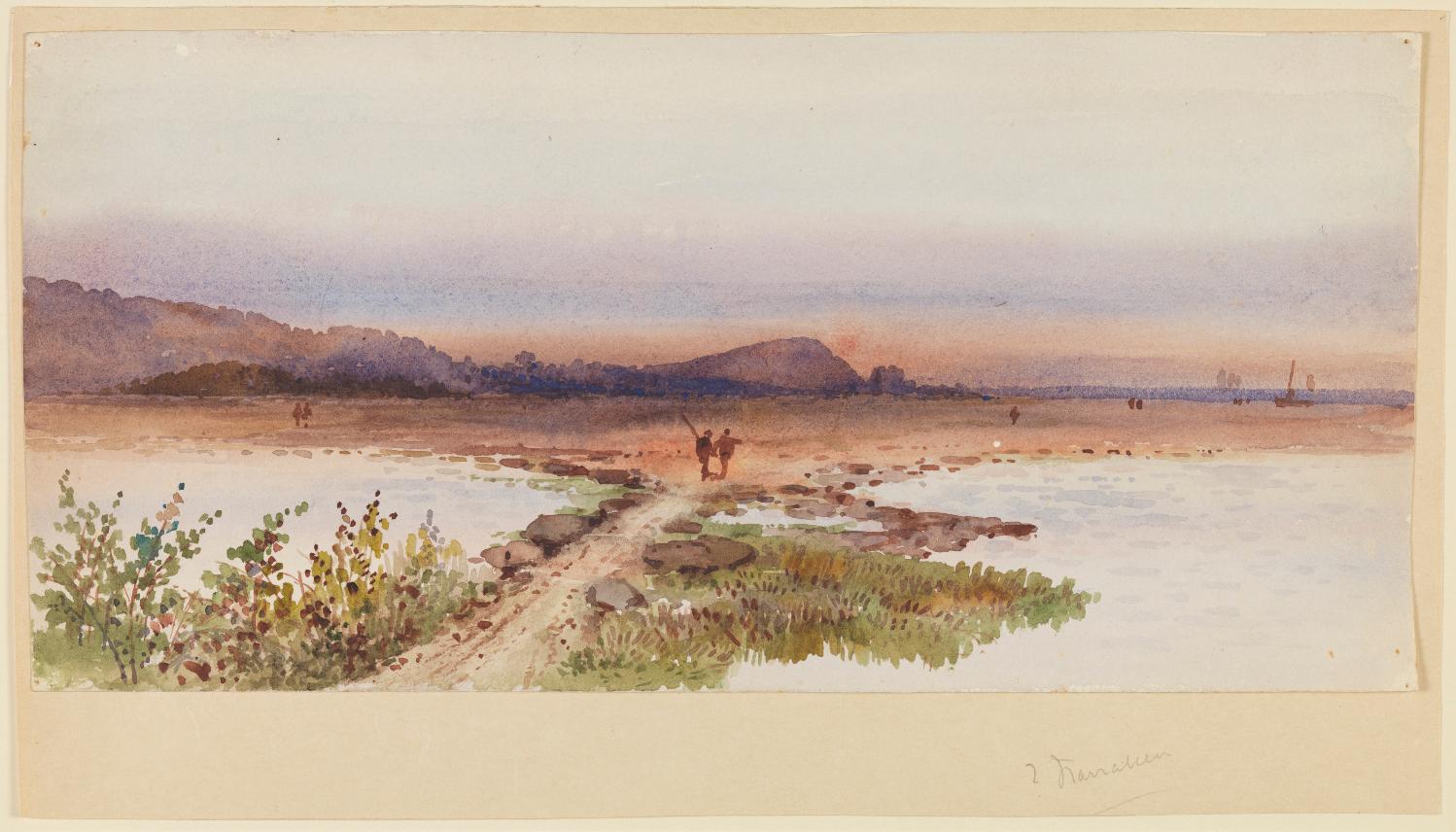
On the banks of the Narrabeen Lagoon, a pretty extensive and romantic sheet of water situated about nine miles from Manly Cove, and communicating with the ocean in high floods there is a small extent of superior land for cultivation with a considerable tract of very fair pasture land belonging to the family of the late Mr. Jenkins, of Sydney ; and about three miles farther on, towards the head of Pitt Water, there is a very fair cultivation farm leased to a small settler of the name of Foley. Colonial Statistics. (1838, February 28).The Colonist (Sydney, NSW : 1835 - 1840), , p. 2. Retrieved from http://nla.gov.au/nla.news-article31720524
The journey is an interesting one. On the road there is some pretty scenery; and in several places there are splendid views of the ocean. Two lakes (or lagoons, as they are here called) are passed on the road; the largest of which, Narrabeen, is several square miles in extent, and has many small islands on its surface. It is for the most part shallow, and abounds with fish, which might be taken with the greatest ease, as a net could be hauled through any part of it. At present it is separated from the ocean by a barren sandy neck; but after floods this is covered, and the traveller is obliged to wade through the water for a considerable distance. METEOROLOGY. (1850, January 30). The Sydney Morning Herald (NSW : 1842 - 1954), , p. 2. Retrieved from http://nla.gov.au/nla.news-article12915324
The first block of land offered for sale after the earliest Land Grants at Narrabeen was by John William Alexander White, who died at Inverell, intestate, in 1873:
NEW ENGLAND.
(from the Inverell Despatch, August 30 )
We have this week to record the death of Mr John William White, late Clerk of Petty Sessions of Inverell. The melancholy event took place at his residence in this township last Wednesday night, at 12 o'clock. From the time of his resigning his appointment as C P.S (some twelve months back) he had been gradually wasting away, and died at length from sheer exhaustion. NEW ENGLAND. (1873, September 4). The Maitland Mercury and Hunter River General Advertiser (NSW : 1843 - 1893), p. 3. Retrieved from http://nla.gov.au/nla.news-article18777072
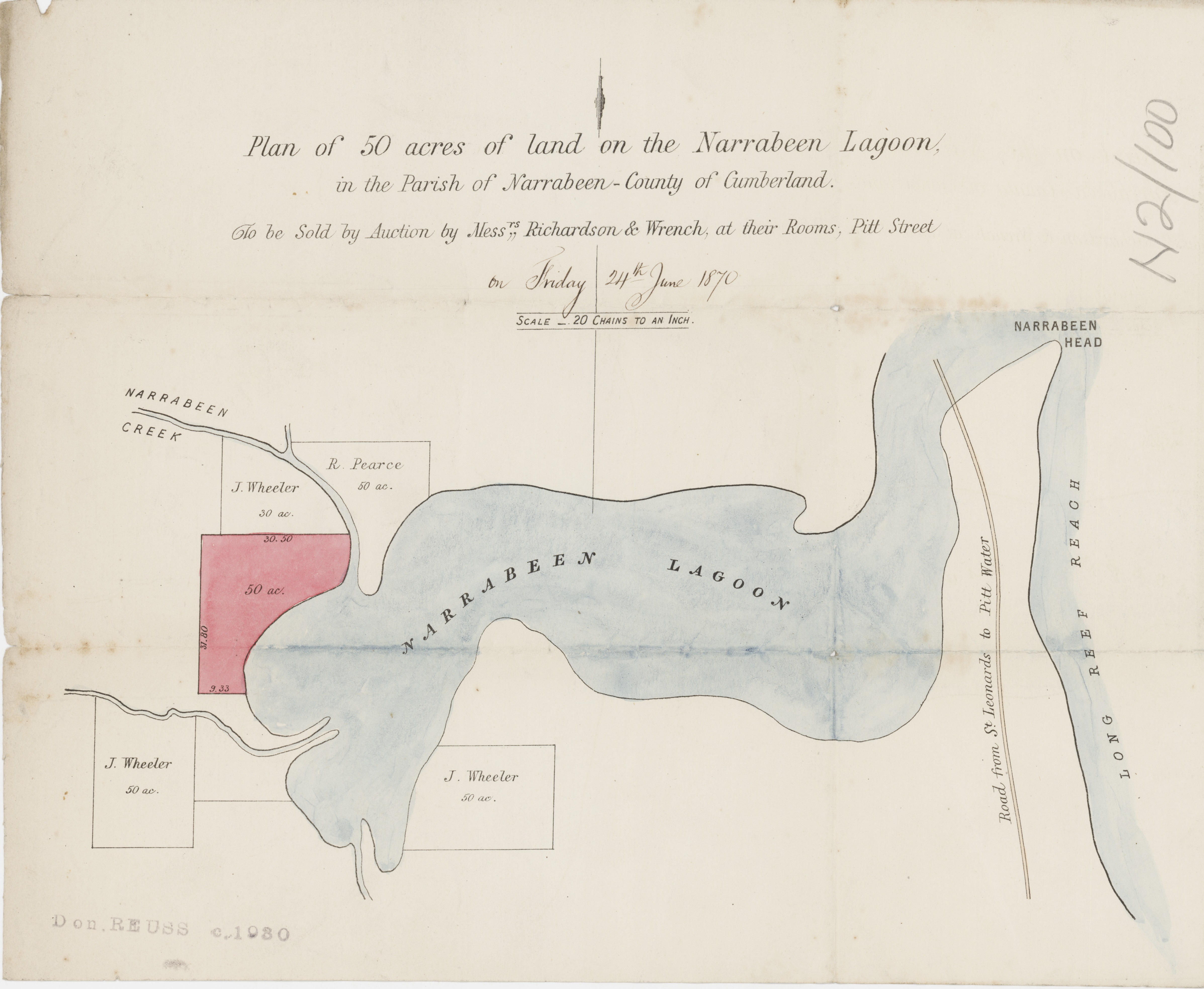
Item c050370107 plan of 50 acres on Narrabeen lagoon 1870 - courtesy State Library of NSW, Narrabeen Subdivisions folder
WITHOUT ANY RESERVE.
MANLY COVE.
50 ACRES of LAND, on NARRABEEN LAGOON, about SIX MILES from the Pier at MANLY BEACH, and adjoining the property of Mr. J. WHEELER
RICHARDSON and WRENCH have received instructions to sell by public auction, at the Rooms, Pitt-street, on FRIDAY, 24th June, at 11 o'clock, The above described 50 acres of land, NARRABEEN LAGOON, MANLY COVE.
LITHOGRAPHS showing the position of the land may be obtained on application at the Rooms. Terms at sale. Advertising (1870, June 18). The Sydney Morning Herald (NSW : 1842 - 1954), p. 9. Retrieved from http://nla.gov.au/nla.news-article13207024
It was still for sale in December 1870, but a later Notice where land was resumed for recreation shows Josiah Taylor had purchased it. Another land sale recorded in 1874 shows the price given for acreage at Narrabeen then:
PROPERTY CIRCULARS.
RICHARDSON AND WRENCH,-The election, together with the near approach of Christmas, has interfered somewhat with this market, sales consequently have not been for the last month so numerous as usual. We report the market quiet without alteration in value, the demand being principally for interest paying city investment and well situated building- allotments. There is considerable inquiry for suburban homesteads of moderate value. These are difficult to obtain, and if brought into the market would command attention. Medium-sized farms with good market access would also find ready purchasers at full rates. Among our sales for the past four weeks we notice .... 43½ acres land, parish of Narrabeen, at 20s per acre ; ....PROPERTY CIRCULARS. (1874, December 21). The Sydney Morning Herald (NSW : 1842 - 1954), p. 7. Retrieved from http://nla.gov.au/nla.news-article13345364
Although this reads like £1 could buy you an acre, when calculated against and in modern terms this would equal around $13,552.00 per acre in 2019 - still cheap, but not as cheap as the 1874 £1 or a $2 coin per acre for beautiful Narrabeen.
At the same time this parcel of land was advertised James Wheeler and a friend were in court over a complaint brought by others - some indication there were more than farmers and hikers now passing through or visiting the area:
CARRYING FIREARMS IN SYDNEY.—At the Water Police Court, Sydney, on Thursday, a decision of an important character was given with reference to the carrying of firearms on Sunday. The case arose out of the following circumstances :—A number of young men are in the habit of spending Sunday at Manly Beach, in pursuit of sport. Complaints were made to the police, and constable Carton, with commendable ardour to do his duty, determined to put a stop to it. He went out as far as Narrabeen, and succeeded in bringing two persons before the Water Police Court. Mr. W. Hellyer, for the defence, contended that the Act 5 Vict., No. 6, section 1, was very indistinct in its terms. And as one of the party was carrying his gun on his own land, he urged that he could do so for his own defence. The Bench ordered one defendant to pay a fine of 40s., costs of court, 5s. 6d., or levy and dis-tress, in default fourteen days' gaol. Mr. Hellyer gave notice of appeal to the Quarter Sessions, and the case against the other defendant was adjourned to the 16th of September. GREAT FLOODS AT THE JUNCTION OF THE DARLING AND THE MURRAY. (1870, August 23). The Newcastle Chronicle (NSW : 1866 - 1876), p. 2. Retrieved from http://nla.gov.au/nla.news-article111140650
Charles Bransby, on remand for carrying firearms at Narrabeen, Pittwater, on Sunday, the 31st July last, was ordered to pay a penalty of £2, and 5s 6d costs of Court, with the alternative of fourteen days in gaol. WATER POLICE COURT. (1870, September 17). The Sydney Morning Herald (NSW : 1842 - 1954), p. 5. Retrieved from http://nla.gov.au/nla.news-article13218265
QUARTER SESSIONS. — FRIDAY.
(Before his Honor Judge Dowling.)
APPEAL CASE. This was an appeal instituted by Mr. James Wheeler, the elder, of Narrabeen (for whom Mr. Hellyer appeared), against a decision of Mr. Cowper, W.P.M., and Mr. Evans, J.P. The appellant had, by the magistrates in question, been tried upon an information laid against him for having been found, on the 31st July last, unlawfully carrying fire-arms ; and he was sentenced to pay a fine of 40s. This judgment was now appealed against, and exceptions were taken to various portions of the evidence upon the trial in the police court. The substantial questions raised, however, were, whether the arresting constable had been entitled to enter upon the appellant's property, where the latter had been detected committing the offence with which he had been charged ; and whether the appellant had not been entitled to carry a gun for the purpose of protecting his crop from the wallabies. His HONOR sustained the conviction, holding that upon the face of the evidence before them the magistrates had been justified in fining Mr. Wheeler, and that it appeared that the latter had been using the firearm for sport merely. QUARTER SESSIONS.-FRIDAY. (1870, October 8). Evening News (Sydney, NSW : 1869 - 1931), p. 2. Retrieved from http://nla.gov.au/nla.news-article107129032
James Wheeler considered himself to be the owner of Narrabeen Lagoon as well as much of its surrounds, as he once stated and as shown in the previous history page, Pittwater Fishermen: The Sly Family Narrabeen Exploits and Manly Community Contributors: The First Surfboat at Manly Beach. The area was popular with hunters who shot everything that moved, sometimes for food, but more often for sport, as shown in what was donated to the earliest version of the Sydney Museum and as recorded in Charles de Boos record as 'My Holiday', and in the absence of birds where they once were, as shown in the Black Necked Stork that once frequented local lagoons and creeks. Wallabies along with 'gill birds', honeyeaters in modern terms, were pursued as fair game during this eras and the mindsets that predominated among some. Narrabeen was also a place where people would come to fish, to camp, to picnic - so much so that within a few decades land holders would be charginmg for people to picnic on the grounds they owned further north at Bayview.
James Wheeler, named among those mixed up in the Murder of David Foley, may not have been the pleasant happy to help his neighbours resident one would need or want in this then isolated rural area:
MANLY.—Impounded at Manly, on the 18th day of March, 1884, from Mount Brown Estate, Narrabean, by James Wheeler; sum due at date of notice, 10s. each :—
Bay mare, white stripe down face, white near hind foot, J G over D near shoulder, 14 hands.
Bay entire colt, white spot on forehead, unbranded, 18months, 14 hands.
If not released, will be sold at this Pound at noon on the 27th March, 1884.
2095—2b. J. BUNN, Poundkeeper. MANLY.—Impounded at Manly, on the 18th day of March, 1884, from Mount Brown Estate, Narrabean, by James (1884, March 18). New South Wales Government Gazette (Sydney, NSW : 1832 - 1900), p. 1890. Retrieved from http://nla.gov.au/nla.news-article223768456
First advertised in August for a September 10th auction date, after a dispute with a J.J Dargan which he lost, in court, James Wheeler almost lost all his land holdings as a requirement to pay fines and court costs levied. This Advertisement lists all of what he then owned:
Auction Sales.
NEXT TUESDAY, at 11.50 A.M.
Under instructions from FRANCIS MACNAB, Esq., OFFICIAL ASSIGNEE in the Estate of JAMES WHEELER, of NARRABEEN.
BATT, RODD, and PDRVES have received instructions to sell by public auction, at their ROOMS, 88, PITT-STREET, NEXT TUESDAY, 16th September, at 11.30 a.m.,
All the Official Assignee's
RIGHT, TITLE, and INTREST In and to the following Properties,
viz:
Lot. 1.-All that piece of Land situate at ST. LEONARDS, parish of WILLOUGHBY, county of Cumberland, containing 1 acre, 3 roods, 16 perches, or thereabouts, commencing at the Intersection of WILLIAM and MOUNT STREETS, and bounded on the south by MOUNT STREET, hearing westerly 7 CHAINS 88 LINKS to a RESERVED ROAD. 33 feet wide ; on the west by that road bearing northerly 8O LINKS to BERRY'S LAND ; on the north-west by part of the south-eastern boundary of that land, bearing-north-easterly 8 CHAINS 85 LINKS to WILLIAM-STREET aforesaid, and on the east by that street, bearing sotherly 8 chains 90 links to the point of commencement.
Lot 2. 90 ACRES, county of Cumberland, parish of MANLY, near DEE WHY LAGOON, bounded on the east by a line dividing it from JOHN HARPUR'S 40 acres bearing north 18 chains on the north by a line dividing It from W. Cossar's 200 acres, bearing West 49 chains 20 links to the ROAD from PITTWATER; on the west by that road, and on the south by a line bearing east 83 chains 80 links to the south-west corner of JOHN HARPUR'S 40 acres aforesaid. (Lot 20.)
Lot 3.-50 ACRES, at NARRABEEN LAGOON, bounded on the north by a line bearing east 22 chains, on the east by a line bearing south 20 chains, on the south by a line bearing west 29 chains 77 links, and on the west by NARRABEEN LAGOON. (Lot 16.)
Lot 4.-50 ACRES, at NARRABEEN LAGOON, bounded on the east by a line dividing it from a measured portion of 20 acres, bearing south 26 chains; on the south by a line bearing west 20 chains; on the west by a line bearing north 28 chains to a creek, and on the north by that creek to the north-west corner of 20 acres aforesaid. (Lot 15.)
Lot 5.-100 ACRES at NARRABEEN LAGOON, commencing at marked oak tree on a creek running into Narrabeen Lagoon, and bounded on the north by a line bearing east 35 chains, on the east by a line bearing south 58 chains 50 links, on the south by a line bearing west 24 chains 50 links to the north- east corner of a measured portion of 100 acres at the head of a small creek, and on the west by that creek, dividing it from part of that 100 acres and part of R. M'INTOSH'S 100 acres to the commencing north-west corner. (Lot 14.)
Lot 6.-20 ACRES, County of Cumberland, parish of MANLY COVE, at NARRABEEN LAGOON, bounded on the south by a line- from the north-west corner of ROBERT M'INTOSH'S 100 acres, bearing west l8 chains 50 links ; on the west by a line dividing it from a measured portion of 50 acres bearing north 16 chains and 88 links to a CREEK, on the north by that CREEK to Its mouth, and on the east by NARRABEEN LAGOON to the north-west corner of R. M'Intosh's 100 acres aforesaid.(Lot 9.)
Lot 7.-30 ACRES, parish of NARRABEEN, at Narrabeen Lagoon, commencing on NARRABEEN CREEK at the north-east corner at a unnamed portion of 50 acres, and bounded on the south by part of the northern boundary of that land bearing west 25 chains and 50 links, on the west by a line boating north 19 chains to NARRABEEN CREEK, and thence- by that creek to the north-east comer aforesaid.
Lot 8.-86 ACRES, parish NARRABEEN, at Narrabeen Lagoon, commencing at an IRONBARK TREE, being the south-west corner of E. Schaffer's 50 acres, and bounded on the north by that land, being a line bearing east to NARRABEEN LAGOON; on the east by NARRABEEN LAGOON, measuring 20 chains along the bank on the south by a line bearing west 35 chains 77 links, and on the west by a line bearing north 28 chains 75 links to the couth-west corner of E. Schaffer’s 50 acres aforesaid.
Lot 9.-14 ACRES, parish of MANLY COVE, at DEE WHY LAGOON, commencing at the south-cast corner, being 4 chains 60 links northerly from the south-west corner of JAMES JENKINS'S 500 acres, and bounded on the east by part of that land, being a line bearing north 17 chains; on the north by Crown land, being a line bearing west 12 chains ; on the west by Crown land, being a line bearing south 8 chains, and on the south-east by a line bearing south 58 degrees east 13 chains 60 link's to a creek, and thence by that creek to the south-east comer 4 chains 60 links northerly from the south-west corner of JAMES JENKIN'S 500 acres aforesaid.
Lot 10.-15 ACRES, county of Cumberland, parish of MANLY COVE, at NARRABEEN LAGOON, commencing at the north-vest corner of James Wheeler's 100 acres, and bounded on the east by a line bearing north 22 chains 50 links ; on the north by part of J. Wheeler's 50 acres, being a line bearing west 7 chains 50 links to NARRABEEN LAGOON and a creek, to the north-west comer of J. Wheeler's 100 acres aforesaid. (Lot 17.)
Lot 11-20 ACRES, MANLY COVE, near DEE WHY LAGOON, commencing at the north-east corner distant 6 chains north from north-west corner at a measured portion of 30 acres, und bounded on the north by a line bearing west 16 chains ; on the wept by a line bearing south 12 chains 50 links : on the south by a line bearing east 16 chains, and partly on the east by part of the western boundary of a measured portion of 30 acres, being a line bearing north 12 chains 60 links to the north-east comer aforesaid.
Lot 12.-2 ACRES 2 ROODS 32 PERCHES, parish of MANLY COVE, village of BALGOWLAH. Suburban portion No. 22, commencing on the north side of WHITE STREET at its intersection with the east side of CONDAMINE-STREET, and bounded on the west by the east side of that street northerly 6 chains; on the north by a line easterly at right angles to CONDAMINE-STREET 4 chains 50' links ; on the east by a line southerly 6 chains parallel to CONDAMINE-STREET, and on the south by 4 chains 50 links of the north side of WHITE-STREET westerly to the point of commencement.
Lot 13.-2 ACRES 1 ROOD, suburban portion No. 26 of section,-commencing at the north-east corner 1 chain west from the north-west commencing at James Jenkins's allotment, and bounded on the ….by WHITE-STREET, being a line bearing west ? chains 50 links; on the west by a line bearing south 4 chains 65 links dividing it from allotment No. 21 ; on the south by the shore of NORTH HARBOUR, and on the east by Boyle-street, being a line bearing north 6 chains 10 links to the north-east corner aforesaid.
Lot 14.-2 ACRES 2 ROODS 32 PERCHES, suburban portion. No. 16 of section-commencing at the north-east corner, and bounded on the north by WHITE-STREET, being a line bearing west 4 chains 50 links ; on the west by allotment No. 10, being a line bearing south 6 chains; on the south by allotment No. 15, being a line bearing east 4 chains 60 links ; and on the east by Condamine-street, being a line bearing north 6 chains to the north east corner aforesaid.
Lot 15.-5 ACRES 1 ROOD 24 PERCHES, suburban portion No. 80, commencing on the north side of White-street, at its intersection with the east side of BOYLE-STREET, and bounded on the west by the east side of that street, northerly 6 chains.; on the north by a line easterly at right angles to BOYLE-STREET, 9 chains to the east boundary of the village of Balgowlah; on the east by that boundary, southerly 6 chains parallel to BOYLE-STREET, divining it from JOHN WHEELER'S 20 acres to White-street and on the south by 9 chains of the north side of WHITE-STREET westerly to the point of commencement.
Lot 16.-15 ACRES, commencing at the south-east corner of the township of BALGOWLAH, on NORTH HARBOUR, and bounded on the west by part of the eastern boundary of the said township, bearing northerly 10 chains; on the north by it line bearing easterly 13 chains; on the east, by a line bearing southerly 17 chains 60 links to the North Harbour, and on the south-west by a line bearing westerly to the point of commencement.
Lot 17-All that PARCEL OF LAND at ST. LEONARDS, at NORTH SHORE, being part of lot 27 of BERRY'S SUBDIVISION, commencing at the corner of Henry Bourne's allotment, and with a frontage to the LANE COVE-ROAD of 40 feet, thence by a line parallel to Bourne's boundary to a watercourse ; thence by that watercourse to Bourne's land, and thence by that land to the point of commencement.
Subject to a lease, as under :
JAMES WHEELER, A. REYNOLDS, and G. H. FRENCH, to Anthony Ebert.
Lease 14 years, at £14 8s.
Lot 18.-Part of Lot 27, BERRY'S SUBDIVISION, commencing at ANTHON Y EBERT'S allotment, and having a frontage to-the LANE COVE-ROAD of 40 feet ; thence by a line parallel to a natural watercourse ; thence by that watercourse at right angles, to Anthony Ebert's boundary, and thence by that boundary to the point of commencement.
Subject to a lease as under :
J. WHEELER, REYNOLDS, and French to JOHN THOMPSON.
Lease, 14 years, £18,
Lot 19.-All the OFFICIAL ASSIGNEE'S RIGHT, TITLE, and INTEREST In and to all the INSOLVENT'S INTEREST under the will of the late GEORGE WHEELER.
Solicitors for the Estate.
Messrs. STEPHEN, LAURENCE, and JAQUES,
81, Pitt-street, ,
from whom all particulars as to TITLE may be obtained.
BATT, RODD, and PURVES, Auctioneers. Advertising (1884, September 13). The Sydney Morning Herald (NSW : 1842 - 1954), p. 20. Retrieved from http://nla.gov.au/nla.news-article13571386
He then discharged the debt:
In the Supreme Court of New South Wales.
IN INSOLVENCY.
In the Insolvent; Estate of James Wheeler, of Narrabeen, near Manly, farmer.
TAKE NOTICE that on the twenty-eighth day of May instant, at 11 o'clock in the forenoon, or as soon thereafter as the course of business will permit, this Honorable Court will be moved that the estate of the abovenamed insolvent be released from sequestration, upon the grounds that the whole of the debts proved in the estate and all claims made by or on behalf of the Official Assignee have been paid and satisfied in full, and on the further grounds disclosed by the affidavit of the insolvent filed herein.—Dated this 13th day of May, 1885.
A. H. M'CULLOCH,
Attorney for Insolvent. 3475 6s. 6d. IN INSOLVENCY. (1885, May 15). New South Wales Government Gazette (Sydney, NSW : 1832 - 1900), p. 3200. Retrieved from http://nla.gov.au/nla.news-article221692340
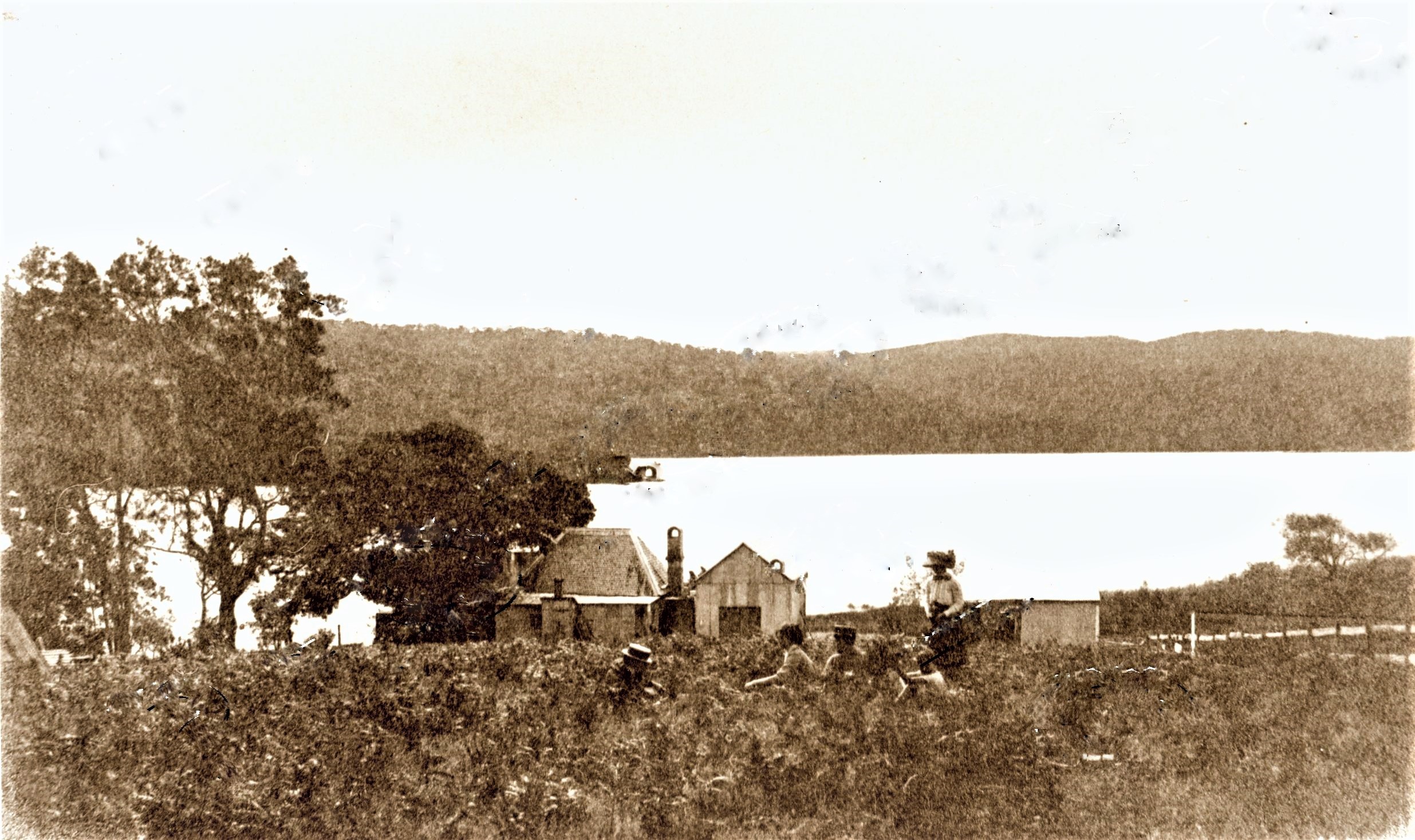
Wheeler's Homestead rear view - circa 1899-1913, courtesy State Library of NSW. Note the Boater hat - these became popular men's wear from 1894 on, reaching their peak in popularity during 1920's. The lady standing to right wears a Victorian era circa 1899 - 1913 wide brimmed hat that remained popular into 1910's.
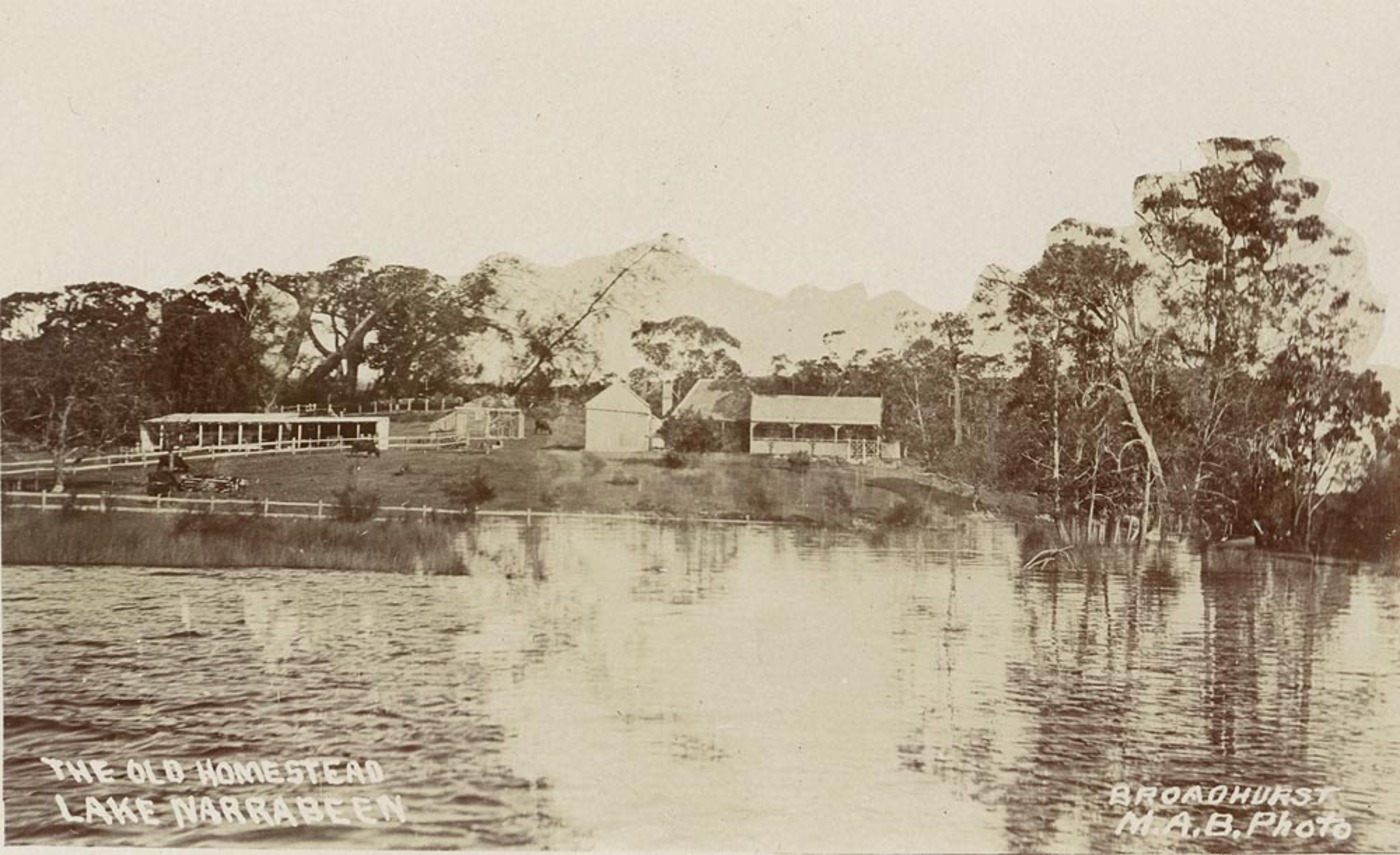
The Old Homestead, Lake Narrabeen, circa 1900-1927 from the Album 'Broadhurst Scenes of Narrabeen', Image no.: a116483, courtesy State Library of NSW.
Concerned about educating his children, James Wheeler returned to live in Sydney for the next few years and then moved to North Sydney where he built a row of terraced houses adjoining the post office. James was 80 when he died in 1890. His son James Jnr, unable returned to live permanently at Narrabeen in 1878. Today the area still has Wheeler Street and Wheeler Park, named after the family, and Wheeler, Delmar and Sturdee Parades are all part of James seniors' original land grants and estate.
MRS. HANNAH WHEELER. Mrs. Hannah Wheeler, wife of Mr. George Wheeler, one of the older residents of Manly and district, died recently at her home Delmar, Pittwater-road, Deewhy. The Wheeler family have been landholders in the Manly, Deewhy, and Narrabeen districts since 1836, where the late Mr. James Wheeler made extensive purchases, the family being established at The Homestead, at the top of Narrabeen Lake. Mrs. Wheeler went to reside at Deewhy many years ago, when the coach was still the principal means of communication in the Warringah district. She leaves six sons and four daughters. The interment took place in the Manly Cemetery. MRS. HANNAH WHEELER. (1930, August 2). The Sydney Morning Herald (NSW : 1842 - 1954), p. 20. Retrieved from http://nla.gov.au/nla.news-article1669265
Although there were a series of smaller land grants and land purchasers in the Narrabeen Lagoon area the main land holders from Long Reef to Narrabeen and beyond were the Jenkins Family in James I and his daughter Elizabeth and James Wheeler Senior. For instance James Macdonald's 30 acres is among the first to be subdivided for sale where smaller block and streets to access them were made. Shelagh and George Champion OAM's 'Profiles of the Pioneers' (2013) states -
James Macdonald of Bedlam Point (Gladesville) was ordered a grant of 30 acres on 31 March 1821. Meehan measured 40 acres for him “on the bank of the Narrabang Lagoon” (Pipeclay Point) on 16 April 1821. On 10 May 1822 John Oxley certified that “James Macdonnell was in actual possession and occupation of 30 acres of land in the district of Broken Bay.” [AO Fiche 3049; 4/1830, No. 226] On 11 May 1822 William Harper, Assistant Surveyor, stated that Macdonald had an order for 30 acres of land in the district of Broken Bay, “and the greater part thereof is cleared and in cultivation.” [AO Reel 6055; 4/1760, p.71] On 17 May James Macdonald, settler, and a convict servant were to be victualled from Stores at Sydney for six months [AO Reel 6009; 4/3505, p.308], and convicts were assigned to him in June 1822 and February 1823. [AO Fiche 3290; 4/4570D, p.43] The September 1822 Land and Stock Muster showed him as resident on his 30 acre grant. 20 acres had been cleared, with 8 acres of wheat, 4 of maize and 2 of potatoes in cultivation. He had 10 horned cattle and 6 hogs. It is probable that James Macdonald was the son of Alexander Macdonald, born in 1789 and raised by his convict mother on Norfolk Island.
In a petition to Governor Darling dated 15 July 1829, Constable Robert Melville stated that Macdonald had sold his Narrabeen Lagoon land to Matthew Bacon, “and afterwards sold by Execution and Purchased by Mr James Jenkins who still holds the same.” (The land was officially granted to James Jenkins on 15 August 1834. [LTO SN33/114]) Melville asserted that Macdonald “obtained money from each and on that account was dismissed from the Masonic Society.” Melville also alleged that James Macdonald “by false representations to your Excellency has obtained a double portion of Land.” By this second grant, Melville asserted, “the said James McDonald has pitched and settled on part of Petitioner’s Land.”
Robert Hoddle, surveyor, investigated the matter and reported on 25 July 1829:
“James McDonald has lately received a grant of 30 acres adjoining Melville on the North and bounded on the West by Pitt Water. Mr. McDonald has not yet been measured, but Melville was measured by Meehan. It would appear from the applicant’s representations that on inspecting the Maps in this Office, he found McDonald’s grant intruding on his; which is not the case, McDonald’s name being merely in pencil adjoining.
“With respect to Petitioner’s charge against McDonald; there is no memorandum on the maps to show that James McDonald has received any grant in the neighbourhood. Jenkins is said to have possession of most of the small farms there. There are two grants of 60 acres and one of 80 acres to an A. McDonald.” [AO Reel 1162]
Hoddle should have asked Jenkins about the matter, for Surveyor Larmer wrote to Surveyor General Mitchell on 2 September 1832:
“Mr. Jenkins claims a farm of 200 acres given to William Cossar at Deewy Lagoon, and another of 30 acres at Narrabeen Lagoon given to James Macdonald which appears (by papers I have seen) were sold by the then Sheriff John Mackaness Esquire on the 18th August 1825. Darcy Wentworth Esq. became the purchaser who afterwards sold them to Mr. Jenkins. I have no doubt the farms were originally measured by Meehan as the Trees are well marked and agree with the descriptions produced by Mr. Jenkins. Signed by the Sheriff and Meehan.”
Mr. Wentworth also owned William Cossar’s grants of 500 and 200 acre. These were all bought by James Jenkins on 29 September 1825.
John Ramsay, a former sailor, was convicted for highway assault and theft, and arrived in Port Jackson in the First Fleet, on the Scarborough. He married Mary Leary at Parramatta in December 1790 and settled at The Ponds, where Watkin Tench observed their great industry and likelihood of success. Whilst living at The Ponds, Ramsay in 1795, together with Matthew Everingham and William Reid set out to cross the Blue Mountains but failed and only reached to about Mt Tomah. [Everingham Letterbook]
By 1800 they had moved to Field of Mars, where Ramsay purchased 60 acres, and again they farmed successfully. John Ramsay was granted 410 acres in the District of North Harbour by Governor Macquarie, on 21 August 1818. It was to be known as “Mount Ramsay”.
However, he was already established just south of Narrabeen Lagoon in September 1815, when Meehan described his residence there as a house, rather than a hut, in his field book. With his residence given as Long Reef, he contracted to supply fresh meat for the use of His Majesty’s Stores in March 1817 and January 1818. - Sydney Gazette of December 27th 1817
On September 23rd 1818 Ramsay mortgaged his land to the Bank of New South Wales. In January 1822 the Sydney Gazette advised that 30 bushels of wheat would be received from Ramsay at Long Reef into His Majesty’s Magazines, and 30 bushels were required from Long Reef in April 1822. (It may have been the same 30 bushels.)
In August 1822 there were signs that John Ramsay was in trouble. His neighbour on Cossar’s land, Matthew Bacon, took action against him, the Provost Marshall giving notice that twenty-seven head of horned cattle belonging to Ramsay would be sold by public auction. [Syd Gaz 23 Aug 1822] The Land and Stock Muster held in September 1822 showed that Ramsay had 10 acres in wheat, 20 in maize, ½ acre in pease/beans, and 3 in potatoes. He had 6 horses, 20 horned cattle, and 16 hogs.
To recover the sum of £300, the President and Company of the Bank of New South Wales sold up the “Mount Ramsay” grant of approximately four hundred acres in January 1823, the purchaser being D’Arcy Wentworth, on 14th of February 1823. In March 1823 a crop of corn and potatoes growing on the farm, and Ramsay’s other effects were sold. [Syd Gaz 23 Jan & 6 March 1823]. This seems to have been the end of Ramsay’s presence in our area, as by 1828 he was working as a gardener at Kissing Point. He died in 1836 at the Sydney Benevolent Asylum. His burial was registered on 21 January 1836 at St Philip’s Church, Sydney. His age was given as 85 years but if he were born c1762 he would have only been about 73 or 74 years of age.
When John Ramsay’s Narrabeen farm was sold in February 1823, the purchaser was D’Arcy Wentworth, who in turn sold it to James Jenkins.
Jenkins also purchased Daniel Rowan’s 50 acre grant, and applied for and received his own grants of 250 and 100 acres from his ticket of occupation land, north of Narrabeen Lagoon. Overall, Jenkins’ land totalled 1540 acres, while his daughter Elizabeth owned a further 200 acres.
James Jenkins II reached the age of 21 in 1843, and applied to his mother, who had remarried and was now Elizabeth Burnicle, for his share of his father’s estate. He and the other interested parties agreed to the conveyance of the Mount Ramsay estate to James Junior. He had married Ann West in 1842 and they took up residence at Mount Ramsay, while James’ older, unmarried brother, William Jenkins, took over the Long Reef farm. James and William were both listed in Low’s 1847 directory as landholders, Pitt Water.
Both James and William Jenkins were on the road between their farms and North Harbour on the day David Foley was murdered, 8 November 1849. Both gave evidence at the murder trial, as also did James’ wife Ann, who, except for the murderer, was the last person to see Foley alive.
Philip died in 1851, aged 23, and William died in 1853, aged 33. Both were unmarried. After this date Miss Elizabeth Jenkins was regarded as head of the family at the Jenkins’ homestead at Long Reef. Also in the household were her unmarried sister Martha, and a much younger brother, John. Another sister, Ann, married William Hendren in 1854.
At the Mount Ramsay estate, Ann, the wife of James Jenkins II, died in 1852, aged 30. James remarried and then he died, on 31 October 1855, aged 33. Apparently it was James’ second wife, Eliza Louisa Jenkins (née Noble), with up to seven children, who were living at Mount Ramsay in 1861 when Charles de Boos and his friends stopped nearby to camp for the night:
“Tom was despatched to a station we saw ahead of us with instructions to purchase a piece of meat, that being an article which we, by some singular mischance had neglected to bring with us.” Tom, however, returned from Mount Ramsay station half an hour later empty-handed. “Poor Tom gave us a rueful account of the barrenness of the land into which our spirit of discovery had led us. The farm house ahead, which perched on a prominent rise, had a most imposing appearance, he described as little better than a heap of ruins inhabited by a varied assortment of women, children and fowls, the first of whom he summed up as being big, bony, and not too young; the second as being brown, chubby and ragged; and the last as being longlegged and rough-feathered. He had opened negotiations for the purchase of flesh of any kind, but his overtures were listened to with astonishment. ... ‘No,’ she said, she hadn’t got any meat. They didn’t use much of it; it was too hard to get. ‘Any eggs?’ ‘No, no eggs - the fowls weren’t laying.’ ‘Any butter?’ ‘No – didn’t make no butter.’ ‘What do you think of that?’ said Tom, ‘What do you think they live on?’ I could not say, of course, but suggested, ‘Corn cobs.’ Nat thought for a minute and then ventured, ‘Potatoes.’ ‘You’re nearest,’ said Tom, ‘They live on bread, pumpkins, potatoes, and honey, - except when they catch fish, and then they live on that as long as it lasts.’”
The Champions state that Philip Jenkins, the only son of James Jenkins Junior, finally came to a settlement with his stepmother and five sisters. Trustees of his father’s will had been appointed, and on 14 April 1877 Philip paid £600 to them; he then became the sole owner of the Mount Ramsay estate. He lost very little time in putting it up for sale, Mount Ramsay being advertised for sale in the Sydney Morning Herald on May 12th 1877:
“MOUNT RAMSAY, NARRABENE
FOUR HUNDRED AND TEN ACRES - TWO MILES FRONTAGE TO THE SEA
OVER A MILE FRONTAGE TO LAKE NARRABENE
~ One of the most beautiful Estates in the Colony.
GILCHRIST, STUBBS, and WESTON will sell by auction, at the Rooms, 273 George-street, on WEDNESDAY, the 23rd of May, at 11 o’clock ALL THAT FOUR HUNDRED AND TEN ACRES of land known as MOUNT RAMSAY, six miles by excellent road from Manly Beach pier.
This very excellent and picturesque estate possesses perhaps more advantages than any other property of like area in the colony. SOME 250 TO 300 ACRES are cleared and laid down in grass, the plentifulness of which even at this season is amply verified by the condition of the cattle depasturing on the property.
About 150 ACRES are still clothed with the beauties which nature has so bountifully lavished on this district, and more particularly on the portion now offered for sale. Combining real intrinsic value with all its charms of position, scenery, and climate, it is unsurpassed, and, either as a whole or cut up into farms, would form at once a substantial and paying investment, as well as a delight to the purchaser; in fact, words fail to convey any adequate idea of its merits, and it is seldom such an estate can be secured.
TITLE, indefeasible, may be inspected at the office of Messrs. Heron and Thompson, Solicitors, Pitt-street.” Advertising (1877, May 12). The Sydney Morning Herald (NSW : 1842 - 1954), p. 13. Retrieved from http://nla.gov.au/nla.news-article13391991
The Mount Ramsay estate was purchased by draper and Australian Mutual Fire Society (insurance) director John Wetherill for £2000 on July 4th 1877 and subsequently subdivided and put up for sale in Lots in 1881. So many people bought an acre or two that those then bringing these under the Real Property Act as the roads and transport means developed became a very long list - those that could be found, and there may be others, are listed below. In 1886 John Wetherill brought the 100 acres granted to David Moore under the Real Property Act, showing his Narrabeen-Collaroy purchase was not his only acquisition of acreage in our area:
No. 6,571. Narrabeen, 107 acres, parish Manly Cove, comprises the land granted as 100 acres to D. Moores. Applicant: John Wetherill, Sydney. NOTICE UNDER REAL PROPERTY ACT. (1886, April 2). New South Wales Government Gazette (Sydney, NSW : 1832 - 1900), p. 2418. Retrieved from http://nla.gov.au/nla.news-article227667518
An article from the same year this was sold:
Narrabean and Mona Vale.
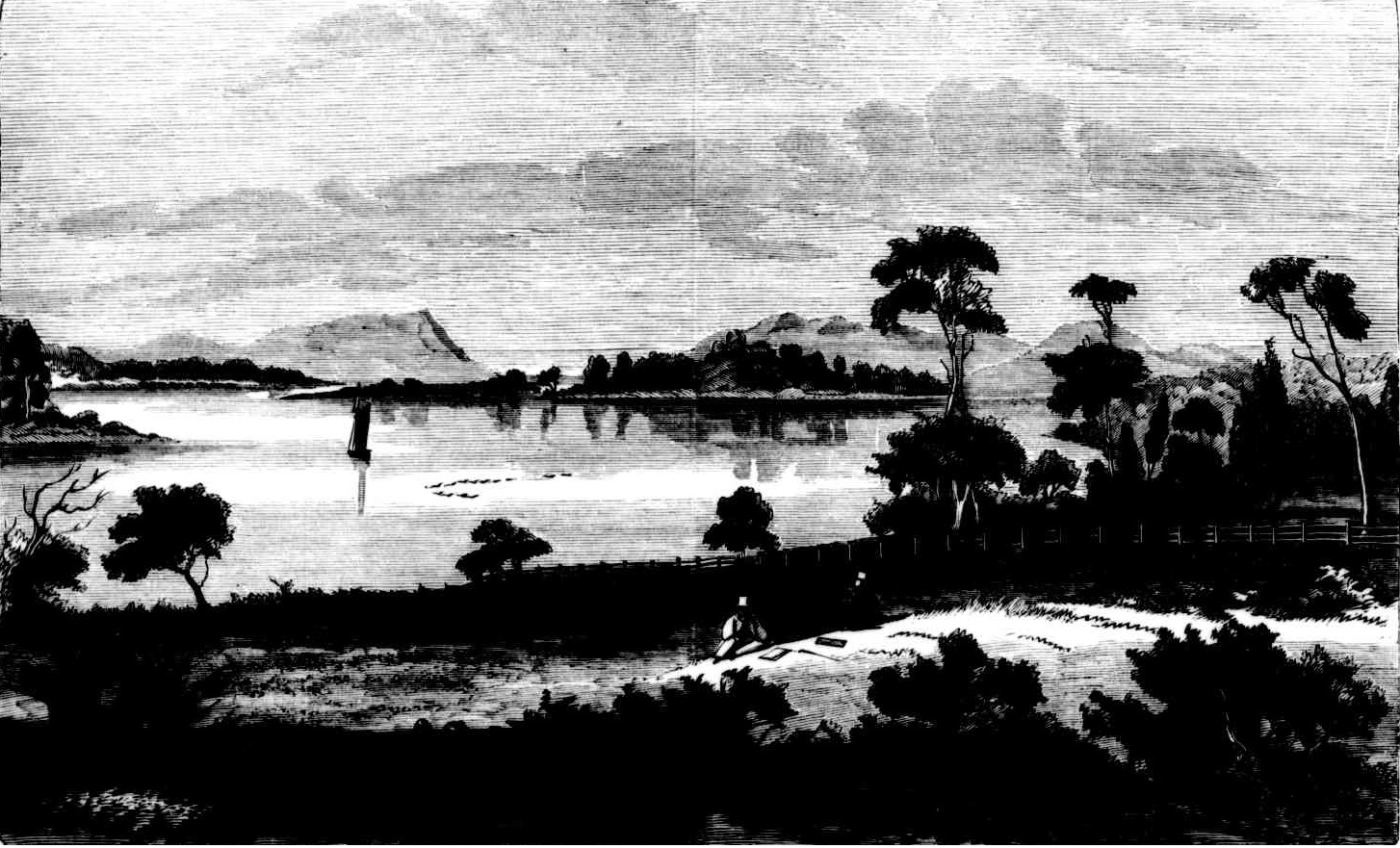
SCENE ON NARRABEAN LAGOON.
THERE are few spots about Sydney more picturesque and interesting than Narrabean and Mona Vale, Pitt Water, and the wonder is that more visitors from the noisy and dusty metropolis do not find their way to these peaceful sylvan scenes, to rusticate and recruit their flagging energies. Fish abound in the lagoon, and at the present season there is no lack of game in the underbrush near the shore, and the ridges that extend towards the higher country at the back. In addition to this, the character of the whole place is different from anything that is met with in any other part of the metropolitan districts ; and as the eye takes in the prospect afforded, particularly particularly at Narrabeen, one who knows the history of the locality can hardly help being impressed with the idea that it is a picture full of sad memories and mournful recollections. Right before the visitor, as he stands upon the piece of elevated land overlooking the lagoon, extends a fine stretch of grassy country, almost as level as a race-course Though within a few yards of the ocean, not a rock or sign of such proximity is visible, and the whole reach is protected from the violence of storms by a belt of thick forest which margins the ocean throughout. At the back rugged ridges rise precipitously, and these being clad with foliage to their very crown, add much to the sense of beauty and security, as it were, of the whole place. Hereabout are evidences of a once busy time ; but desolation now presents itself on every hand. The houses are in ruins, and the fences dilapidated, and one sees nothing now but what indicates a marvellous chance from the past ; remnants of once comfortable homesteads show themselves, and time indeed seems here to have destroyed all that the energy and industry of man once sought to produce or rear up. Turning round, and looking in a north-easterly direction, an enchanting view meets the eye. Our artist has endeavoured, in the accompanying engraving, to depict some of its beauty. Almost at one's foot the placid waters lie like a mirror, over an area of several miles, till the ridges push in their rugged outlines on either side, and thus intercept the view ; but then, farther on, the eye catches a glimpse of a piece of cultivated country, where, one would think, a man might dwell in peace and quiet all his days.
To the right the lagoon extends towards the ocean, from which it is separated by a sandy bar, which, however, allows of overflow one way and the other according to the circumstances of the hour. Cranes and aquatic birds abound, but there is very little sign of human life during the greater part of the year. At certain seasons, however, a few fishermen come to the place for a few weeks' stay, and with the aid of their boat and net are able to make the visit profitable.
Our view shows their boat upon the lake, moving silently along as a thing of life. No more enchanting sight presents itself than this when observed at an early hour- as day breaks, and the gloom disappears, and each headland and bay is lit up, and the whole whole scene which lies before the eye presents a magnificent panorama of undisturbed nature. Turning again to the ruins, one wonders why such a spot should be I deserted, and the mind is by degrees induced to picture the past, and ask where are those busy hands that first broke in upon this silent scene-that in old times toiled and toiled from day to day beneath the burning sun, to gather about them the comforts of civilisation - all scattered or fallen into disrepair and ruin. Each stone has its history, and the decayed and tottering posts erected by industrious hands tell of the men who have long since passed over to the majority.
But all must be left to the imagination ; there is no one about to reveal the past; nothing seems to live or flourish, save a gigantic cabbage-tree, which rears its head fifty or sixty feet, and, defiant of both time and tempest, looks complacently down on the surrounding scene of desolation.
Of late years the place has been in the possession of the Jenkins family, whose members have won for themselves the esteem of all the residents of the district, and whose generous hospitality is spoken of by every one who visits Narrabean. Their homestead is situated a short distance in from the coast, at Long Reef, and its unobtrusive yet comfortable appearance reminds one of an English country home. The land at Narrabean is not now cultivated ; the soil has been worked out long ago, but a few sheep and cattle are frequently depastured there. Wherever one looks in this district, the scenery presents an aspect totally different from what is usually met with on the coast, as here is found a long stretch of land within a stone throw of the ever-rolling ocean, originally of great fertility, but exhausted by long cropping and careless cultivation. It is much the same with the Mona Vale estate, which is situated about three miles on the opposite side of Narrabean, and usually reached by crossing the lagoon in its shallowest part, which is about the centre. As one wends his way along through the bush, and Mona Vale opens out before him, he stands to behold and enjoy the novel view that presents itself ; it is so secluded and quiet, and yet so grand, with the rugged ridges on the one hand, and the turbulent ocean on the other, that it singularly impresses the visitor, who becomes eager to learn its history, and feels sure there must be many pleasant reminiscences to tell of past occupants. What a sad mistake ! What fearful trials and losses and disappointments have been experienced here. Its history should be written in blood, for if ever red-handed crime flourished in any country, it flourished and triumphed here, till it brought ruin and death to honest people ; and justice, outraged beyond bearing, rushed in and brought the delinquents to punishment. The description of these places has already taken up all the space that can be afforded, so we must defer till a future opportunity a brief outline of the leading incidents in their history. Narrabean and Mona Vale. (1877, January 6). Australian Town and Country Journal (Sydney, NSW : 1870 - 1907), p. 20. Retrieved from http://nla.gov.au/nla.news-article70598057
And, as stated in this article, Philip Jenkins did not do too well out of the transaction. This also contains another spelling of current day 'Narrabeen' and why is was named thus:
MIGHT HAVE HAD £250,000, BUT GETS £2/10/- A WEEK
Sydney- Man Who Fought Salvation Army for Ancestral Estate
THE ARMY'S "NO BEER" COVENANT.
SO passes the glory of the world — in a mist of Blood and Fire. It is as well for Phillip Jenkins that he is a philosopher. The Jenkinses are gone — save for him, and he is 72, and childless. The homestead, built a century ago to nurse a proud line of colonial barons, has crumbled under the hands of the demolisher. The erstwhile forest lands are bare grassy hills scarred with new roads, and the old farm fields sprout a harvest of houses. Flivvers buzz over the landscape, trippers, weekenders, outer-suburbanites and market-gardeners throng the fertile valleys, and the estate agent is everywhere. And only yesterday all was silence, all was solitude.
The Jenkins held sway over a thousand acres, another settler ran cows back in the hills, a former assigned servant of James Jenkins tilled his land a little way up the coast, and between there and Brook-vale there was no one else to trouble the sea, and the sky, and the sand, and the scrub. As Phillip Jenkins grew up, fishing off Long Reef, hunting in the hills, riding over the estate that passed to his aunt Elizabeth, who had adopted him when his father died, others came to the district. It was still a wild region, the newcomers were wild folk, and wild deeds followed. They will still show you the place in the bush behind Narrabeen where murder stalked one night, and tell you that a convict came there to find a brutal master of earlier times, and strike him down. They will tell you how many a man was "put away" in those dark times by neighbors ill-disposed, and hint at wild orgies in the "Narrer Bean Camp" of the blacks — so called from the long slender native beans that grew beside the lake there. This was Phil. Jenkins' environment, but he was not of it. Up in the old homestead he lived under the care of an eccentric maiden lady who saw sin in almost all things, but who husbanded carefully the estate her father had left to her care. Phillip never thought hut that he would be heir to the lands his grandfather had pioneered. It was early in last century when James Jenkins came from England and started a shop in Sydney. Later a land grant of 200 acres at Deewhy was made to him and to one, William Cossar, a grant was made of 600 acres situated to the north of Jenkins' land. Jenkins later bought Cossar's land as well as 188 acres known as Sheep Station Hill on the northern side of Narrabeen lagoon. On re-measurement in after years this land is shown to be 259 acres. When Jenkins died, over 900 acres passed to his three surviving children— Elizabeth, Martha, and John. The other son, James, had died, leaving his son, Phillip, another part of the original holding-, which he later lost.
In 1885 Elizabeth, the leading spirit of the three, became interested in the work of the Salvation Army and from time to time she made gifts of money and land to the institution. Finally, in 1894 she was instrumental in having the whole of the land transferred to the Army in return for an annuity of £175, and an undertaking to take over her liability in connection with certain bank shares which she held. Miss Elizabeth Jenkins died in 1900 and her will under which she left all her remaining estate, amounting to £120, to the Army also, was attacked by Phillip Jenkins on the ground of incapacity and undue Influence.
Evidence in the Equity Court showed that she was an eccentric woman. The Judge refused probate, which had been asked for by Brigadier John Hendy of the Army, who, with Thomas Coombs, had been appointed executors. On appeal to the Full Court in 1901 this decision was reversed, Hendy and Coombs being granted probate. If the will could have been proved invalid, an attack would have been made on the deeds of settlement. At the time the deeds were executed an understanding was reached between members of the Jenkins family and the Army that although the latter was legally entitled to assume possession of the property, nothing would be done to disturb Its condition during the lifetime of any member or the family. This agreement was observed by the Army. Nothing was done until John's death about 1911 — Martha had died many years before. The tramway to Narrabeen was built in 1911-12 and opened for traffic on Eight Hours' Day, 1912. On that day the Salvation Army held its first sub-divisional sale, when land adjoining Collaroy Beach averaged over £5 a foot. Conditions of that sale — and of all subsequent subdivisional sales— were that all fences erected must be approved by General William Bramwell Booth, and that the purchasers and the registered proprietors for the time being must not sell, permit to be sold, or connive at or be parties to the sale of any intoxicating liquors on the land. In addition, there was a condition in respect of the first sale prohibiting the carrying of liquor In the land.
Subsequently the Army applied to bring one part of the land, the area of which was 824 acres, under the Real Property Act, but the Crown claimed that Deewhy Lagoon of 62 acres, which was included in the application, was not a part either of the Jenkins or the Cossar grant. The present Chief Justice, sir Philip Street, sitting in Equity, held that the lagoon waters were not tidal, waters, and that they, were included in one or other or both grants, Followed an appeal, about 1910, to the High Court, which decided that the Crown was entitled to all the area from time to time covered by water. As Deewhy lagoon was continually being drained, the judgement that the ownership of the land would shift from the Crown to the Army, and vice versa, with the covering and uncovering of the land by water. The obvious difficulty of interpreting the ownership based on this unusual judgement resulted in a compromise being reached.
The estate, for the most part a narrow strip skirting the coast from Deewhy to Mona Vale, comprised originally about a thousand acres. The Salvation Army authorities have shown careful discrimination in in the manner of their throwing the estate open for sale, having regard to its value in the coming years as an aid to the Army's work. Large sums of money have been laid out in the developmental work— — in the construction of roads, bridges, etc. To date about two-thirds of the total area has been disposed of, and further sales are planned for the early future. On the estate the Salvation Army has established a colony for aged men, about 85 being in residence there: also a large Home for Boys. A section, at Collaroy, is set apart for the purposes of a seaside holiday ground — used, among, other things, as a fresh-air camp for poor mothers and children from the city and suburbs, also for children from various metropolitan Institutions. In addition It provides a summer camping ground for the Army's Life Saving Scouts and Guards and other young people. Then there are erected on the estate two Salvation Army halls —one at Deewhy and one at Collaroy. The Army has been generous in its gifts from the property for public purposes, such as recreation grounds at Dee-why, Collaroy, Narrabeen, and Mona Vale. In addition to the usual statutory area for reserves, it set apart for similar purposes - a strip, of foreshore extending from Narrabeen to Mona Vale. The popular Griffiths Park, comprising at 177 acres, probably the most attractive section in the whole district, was included in the original estate. Proceeds of land sales are credited to a central fund at headquarters, for the purpose of assisting in the erection of Institutions for the care of the friendless and needy, also halls in localities where it is not possible locally to raise sufficient funds. ' Further, one-third of the net proceeds of sales is devoted to the missionary operations of the Army, which are now well established in India, Burma, China, the Dutch Indies, Korea, Zululand, Nigeria, and Kenya, From Australia many Salvation Army officers have gone forth to these lands in connection with missionary service. In all this, the Salvation Army claims that the intentions of Mr. and Miss Jenkins, from whom the Army derived this property, are being observed both in spirit and In deed. Not one penny of the proceeds of the estate, Army officials make clear, is used for the personal benefit of any, but those for whose aid the Army
During the past two years (owing to expenditures required for development purposes) the Army has not benefited at all from the estate. But prior to that period, for some twelve years the proceeds of the estate have assisted the funds of the organisation to the extent of about £9000 a year. Meanwhile, Phillip Jenkins . is philosophical. He has a roof over his head, a few shillings to keep the wolf from the door, a few old friends, and a good wife. He has farmed his little block in the past, but now, getting on in years, and in poor health he sits on his verandah watching the golden lemons dropping off his trees for want of a payable market, rather like golden coins slipping from a man's hand. He is philosophical. If ever he does cry out against Fate, rate's answer, it seems, is a lemon.
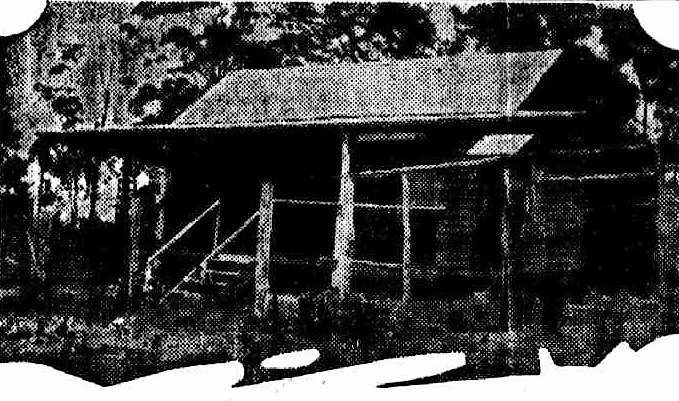
Phillip Jenkins' Cottage in the Narrabeen Bush
IN a weatherboard cottage in the bush at Warriewood, a few miles from Narrabeen, lives a man who, but for an old woman's whim, might today be worth, anything up to a quarter, of a million pounds. He is Phillip Jenkins, sole survivor of a family that settled in the district 100 years ago, and to-wards the end of last century owned, land from Narrabeen to Deewhy
THAT land was transferred to the Salvation Army by Phillip Jenkins' aunt, Miss Elizabeth, and approximately £108,000 has already accrued to the Institution from the sale of a portion of the property. Jenkins fought the Army at law and lost. Now, he receives from the Salvationists an annuity panning out at £2/10/- a week.
.jpg?timestamp=1534833646312)
PHILLIP JENKINS
MIGHT HAVE HAD £250,000, BUT GETS £210- A WEEK (1928, November 3). Smith's Weekly (Sydney, NSW : 1919 - 1950), p. 2. Retrieved from http://nla.gov.au/nla.news-article234382625
The Wheeler family and the McIntosh, along with Thomas Collins and the Macphersons held onto large land holdings longest, gradually selling these off to larger subdividers in Friedrich Caesar Hedemann, Henry Halloran and the groups such as a few banks and the NSW Realty company, who also took over and sold off lots at Mona Vale and Newport, or those who formed a company to subdivide the Green Hills - Elanora Heights estates.
The first big shift in making the area more attractive to those who wanted a smaller block for camping or a residence, or even just a holiday place, came with the installation of a bridge across the lagoon.
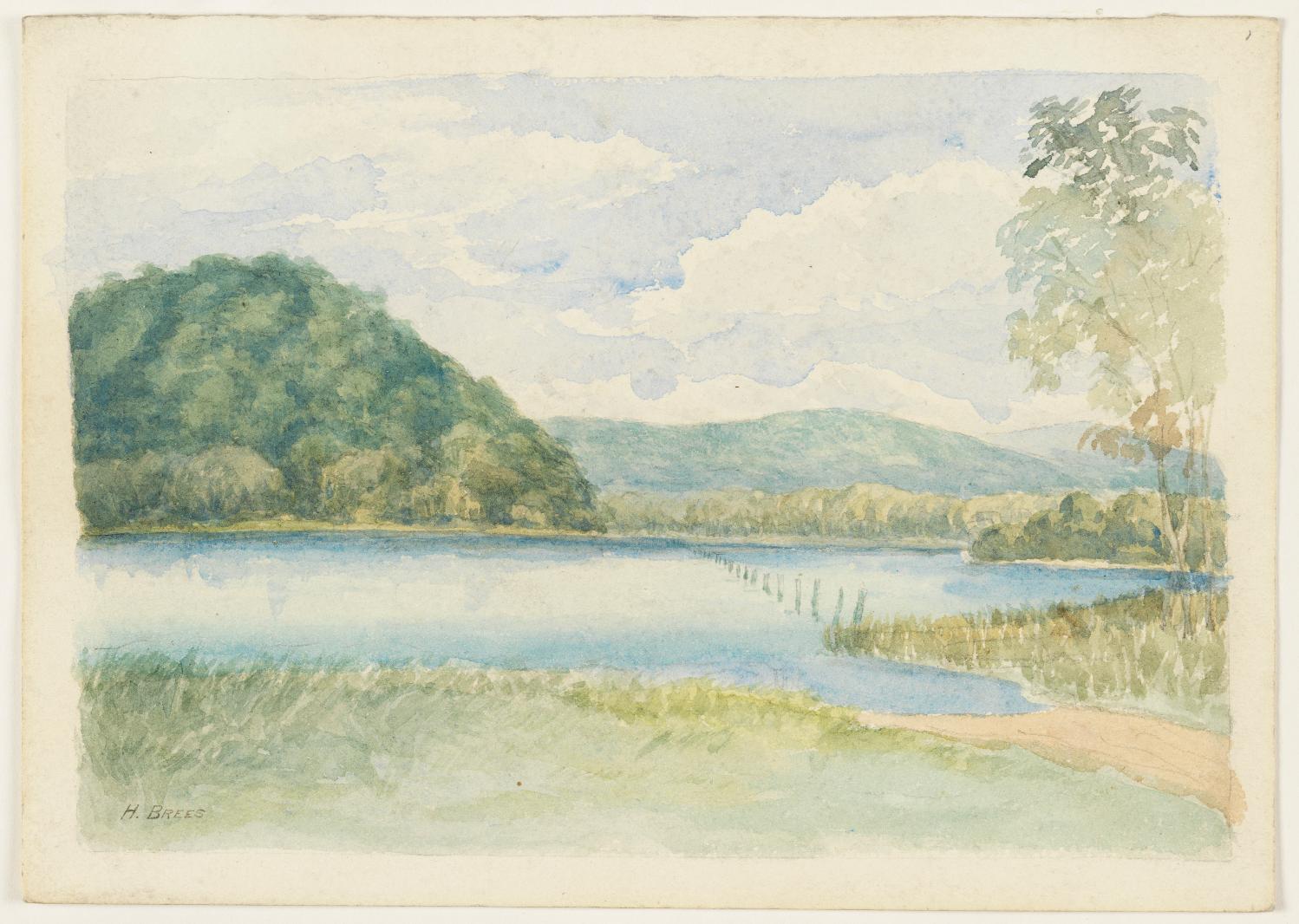
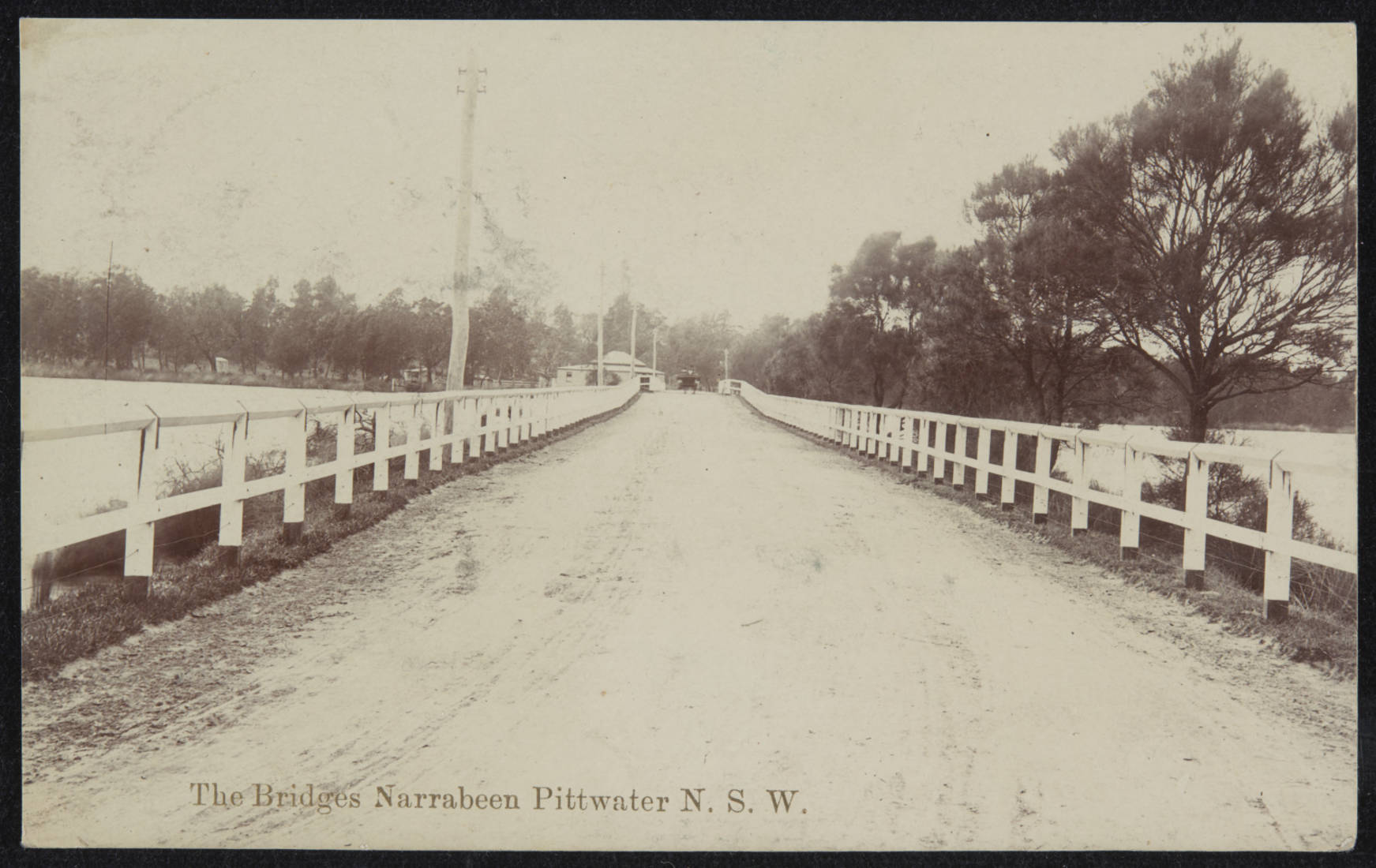
The other big attraction in drawing people to the area was a little further south. On Thursday January 20th 1881, at just after 4.15 am on a foggy morning, the steamer Collaroy beached itself inside the northern reach of Long Reef on what was then called 'Jenkin's Cove', named after early settler James Jenkins, and the family farm then at Long Reef. The 'SS Collaroy' remained there for almost 3 years, giving her name to the stretch of sand and ocean we today call by that same name and attracting thousands of tourists who came to gawk at the beached vessel as well as picnic and see the surrounding area, including Narrabeen. When refloated she went back into service plying between Sydney and the Hunter River but was withdrawn from duty in 1886, converted to a schooner, sailed to San Francisco, where she again ran ashore and broke her back on the Californian Coast in 1889.
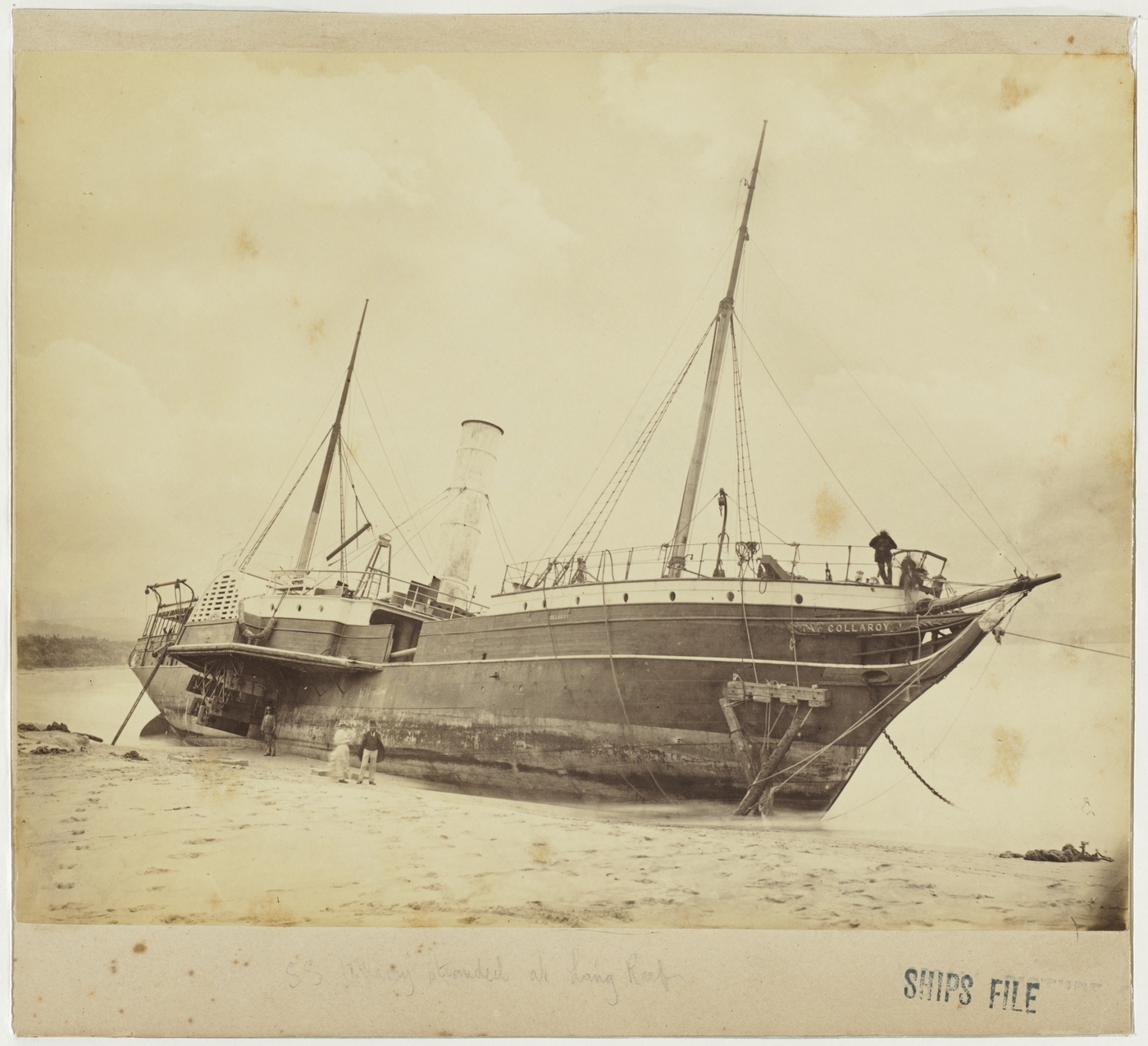
Wreck of the S.S. Collaroy, 1881 / photographer unknown. State Library of NSW Image No: a1528938
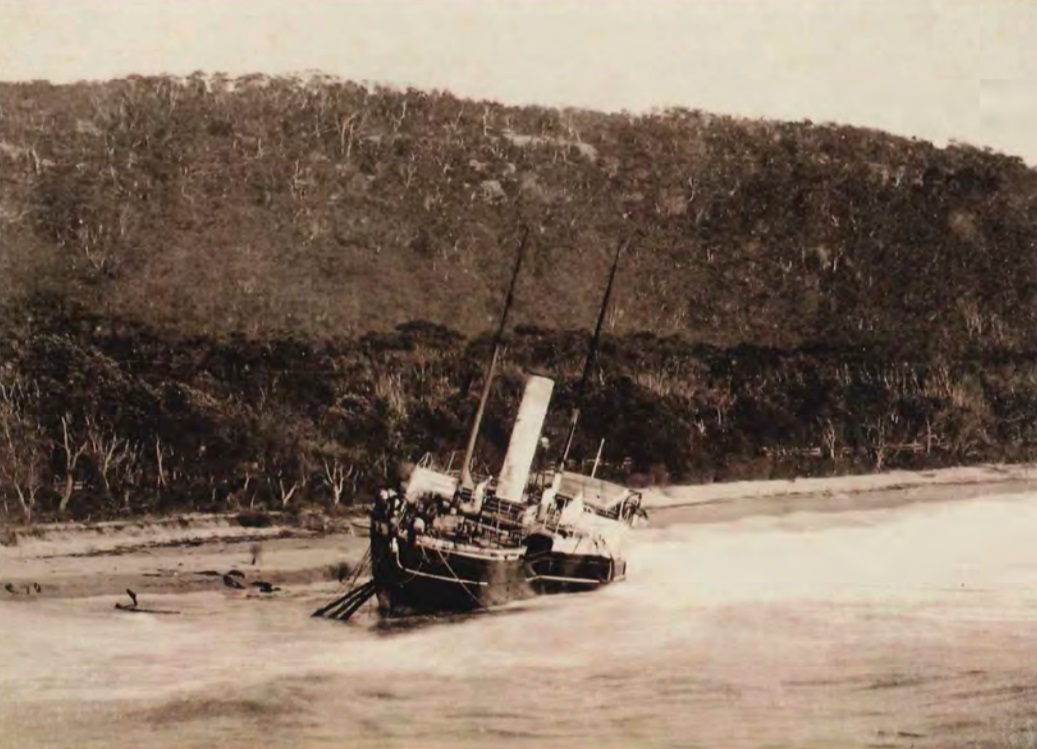
This image version shows the landscape and 'road' of Collaroy behind the stranded steamer of then.
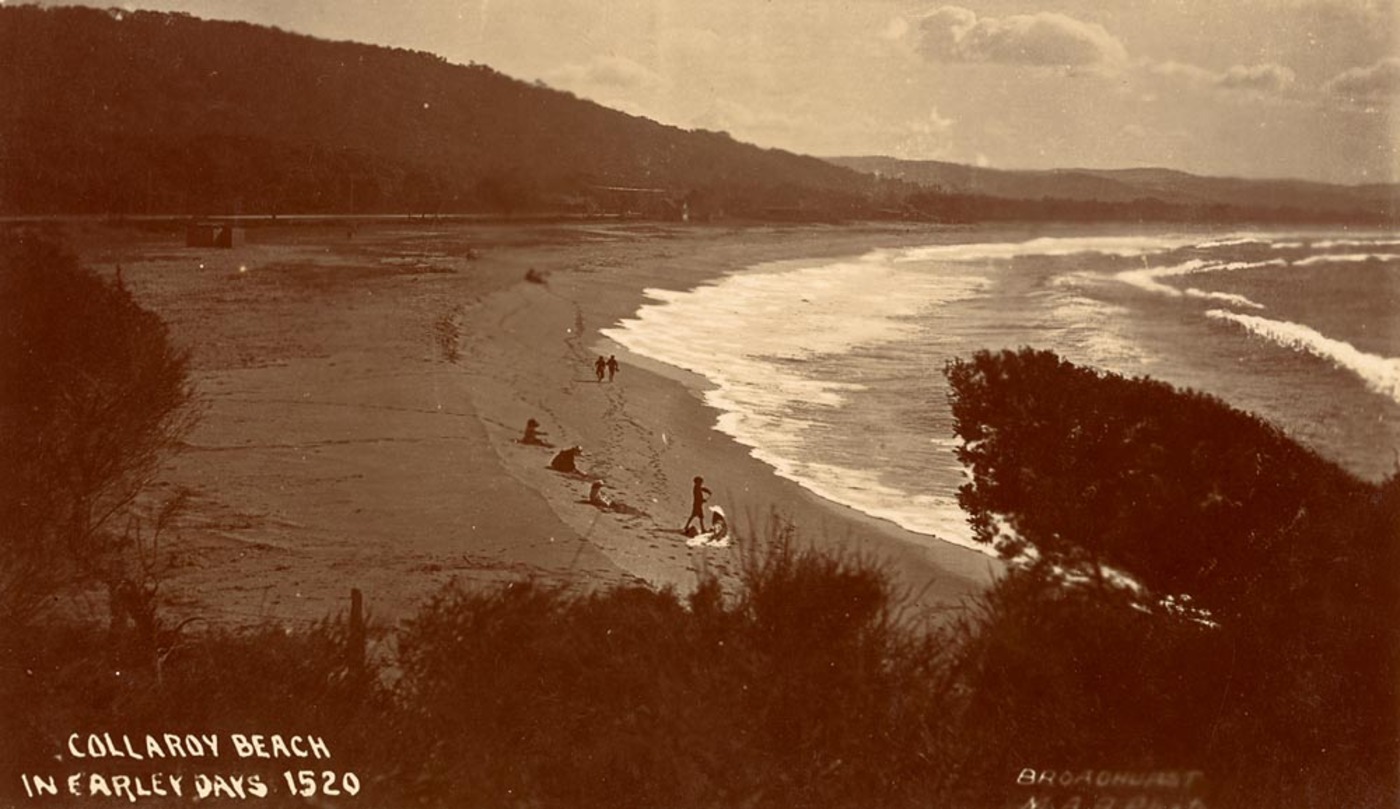
Collaroy Beach in earley [ie. early] days ca. 1900-1927; Sydney & Ashfield : Broadhurst Post Card Publishers, by William Henry Broadhurst, 1855-1927, courtesy State Library of New South Wales
The SS Collaroy was preceded by others coming unstuck along this section of coast and followed by many. One example from a few years earlier (others are listed in Dad's Fishing Shack at Long Reef by Ken 'Sava' Lloyd):
STRANDING OF THE SWANSEA, STEAMER.-The excursion steamer Swansea, belonging to Mr. Harmer, of Watson's Bay, left Sydney on Monday morning early with a fishing party. She is ashore at Narrabeen, a small indent on the coast, situated about six miles from Sydney North Head. Captain Hixson, on learning the particulars, at once dispatched the pilot steamer Captain Cook to her assistance. The steamer returned last night, and reports the vessel on the rocks with a hole, through her bottom. SHIPS' MAILS. (1877, December 5). The Sydney Morning Herald (NSW : 1842 - 1954), p. 4. Retrieved from http://nla.gov.au/nla.news-article28394828
While in April 1881 previous discussions and announcements to reserve land from present day Gordon and Pymble to Mona Vale and Narrabeen for a railway and other purposes was proclaimed, possibly adding to 'good reasons to sell now':
Department of Lands,
Sydney, 20th April, 1881.
RESERVES FROM SALE FOR RAILWAY AND OTHER PUBLIC PURPOSES.
HIS Excellency the Governor, with the advice of the Executive Council, directs it to be notified that in pursuance of the provisions of the 4th section of the Crown Lands Alienation Act of 1861, the land specified in the Schedule appended hereto shall be reserved from sale for railway and other public purposes.
JAMES HOSKINS.
No. 63. County of Cumberland, parishes of Broken Bay, Narrabeen, and Gordon, area about 20,000 acres. The Crown Lands within the following boundaries: Commencing on the right bank of Cowan Creek, at a point where the north extremity of the west boundary of reserve No. 51, notified 21st June, 1880, meets that creek; thence bounded by the west boundary of that reserve south to its south-west corner thence by the south and east boundaries of that reserve east and north to the south boundary of reserve No. 55, notified 21st June, 1880; thence by part of that south boundary east to the west boundary of John Clark's 100 acres thence by part of the west and south boundaries of that portion south and east to Pittwater; thence by Pittwater southerly to the north-east corner of Robert M'Intosh's 50 acres; thence by the north boundary of that portion and the north boundary of the reserve for public recreation, dedicated 7th January, 1879, west, to the north-west corner of that reserve; thence by the west boundary of that reserve south to its south-west corner, and by the south boundary of that reserve and the south boundary of James M'Cauley's 50 acres east to the south-east corner of that portion; thence by part of the east boundary of that portion north to the south boundary of John Andrews' 50 acres, and by that south boundary east to Pittwater; thence by Pittwater southerly to M'Carr's Creek, and by that creek upwards to its head; thence a line southerly, forming a west boundary of the parish of Narrabeen, to the road from Lane Cove to Bulgola Head; thence by that road south-westerly to the north boundary of the reserve on account of population for City of Sydney, as per Census of 1871; thence by part of that north boundary westerly to the east boundary of reserve No. 62, notified 23rd March, 1881, on Cowan Creek ; and thence by that creek downwards following its right bank, to the point of commencement. [Ms. 81-6,401]
No. 64. County of Cumberland, parishes of Marra Marra and Berowra, area about 26,000 acres. The Crown Lands within the following boundaries: Commencing on the road from Wiseman's Ferry to Parramatta, at a point where the northern boundary of George Acre's 1,500 acres, situated in the parishes of North Colah, Nelson, and Berowra, meets the north-eastern side of that road; thence bounded by that road in a north-westerly direction about 6£ miles in a direct line to the top of the 'range forming the boundaries between the parishes of Frederick and Marra Marra; thence bounded by that range and a small gully forming that parish boundary in a north-easterly direction to the right bank of the Hawkesbury River; and thence by that bank of that river downwards to the junction of Berowra Creek with that river at Fisherman's Point; and by the left bank of Berowra Creek upwards to a small gully which forms part of the boundary dividing the parishes of Berowra and North Colah; thence by that gully upwards to a point east from the point of commencement; thence by a line partly forming part of the north boundary of George Acre's 1,500 acres aforesaid westerly, to the point of commencement. [Ms. 81-6,401]RESERVES FROM SALE FOR RAILWAY AND OTHER PUBLIC PURPOSES. (1881, April 20). New South Wales Government Gazette (Sydney, NSW : 1832 - 1900), p. 2275. Retrieved from http://nla.gov.au/nla.news-article224294826
Also, on April 3rd, 1881 the first simultaneous census of Australia and the rest of the British Empire took place. The population of Australia then was 2,250,194 with New South Wales was the second most populous state behind Victoria, with a population of 749,825. Sydney had 224,939 inhabitants. None of those census records for 1881 have survived that record individual names as they were destroyed in the Garden Palace Fire of 1882.
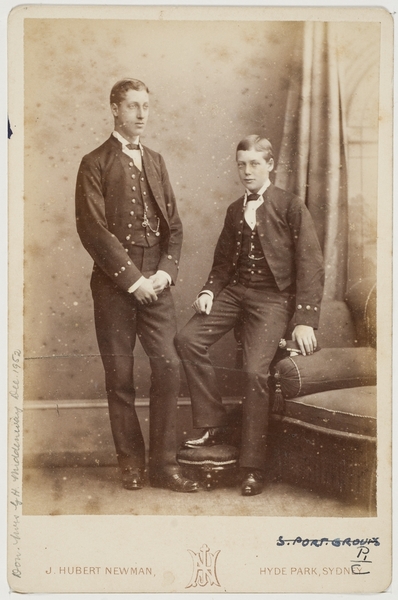 In 1881 the Governor of New South Wales was Lord Augustus Loftus, Sir Henry Parkes was the Premier. On June 18th the Art Gallery of South Australia was opened by Prince Albert Victor, Duke of Clarence, the eldest child of the Prince and Princess of Wales (later King Edward VII and Queen Alexandra) and grandson of the reigning British monarch, Queen Victoria. Princes Albert and George (later King George), were sent as naval cadets on HMS Bacchante for a three year world tour of the then British Empire. They visited Newport in 1881 and an excursion they were taken on up the Hawkesbury River departed from the then quite new Newport wharf, built by Charles Jeannerett and then named 'Victoria' wharf:
In 1881 the Governor of New South Wales was Lord Augustus Loftus, Sir Henry Parkes was the Premier. On June 18th the Art Gallery of South Australia was opened by Prince Albert Victor, Duke of Clarence, the eldest child of the Prince and Princess of Wales (later King Edward VII and Queen Alexandra) and grandson of the reigning British monarch, Queen Victoria. Princes Albert and George (later King George), were sent as naval cadets on HMS Bacchante for a three year world tour of the then British Empire. They visited Newport in 1881 and an excursion they were taken on up the Hawkesbury River departed from the then quite new Newport wharf, built by Charles Jeannerett and then named 'Victoria' wharf:
On the 1st August a party from Government House and the Detached Squadron made an excursion up the Hawkesbury and fortunately the weather was so fine that every lovely scene on the river appeared to the best advantage. The Royal Princes were of the party.
At an early hour those engaging in the excursion left Man-of war Stairs, and proceeded in the steam launch Nea to Manly, whence they were conveyed by Mr Boulton's coaches to Newport. There they were received by Mr Jeannerett on board the steam launch Pelican.
Barrenjuey was passed about 11 o'clock, the boat then proceeded up the river. The day being beautifully clear, the scenery of the Hawkesbury was seen to the best advantage and was very much admired. Wiseman's Ferry was reached about 3 o'clock in the afternoon.
The Pelican stopped at the wharf for a few minutes, and on-the Princes appearing the residents assembled, and an address of loyal welcome was read and presented to them by the master of the Public school, on behalf of the inhabitants of the village.
The school children sang the National Anthem and those assembled then gave three hearty cheers for the Queen and the Princes. Prince Edward acknowledged the compliment in a few appropriate words.
The Pelican resumed her journey, and went up the river as far as Sackville Reach, at which spot the party disembarked and drove thence to Windsor, returning from Windsor to Sydney by special train at night.
The Princes slept at Government House on August 1, and on Tuesday took part in tho ceremony of laying the foundation stone of the pedestal for the statue of her Majesty the Queen which will be placed in the circular reserve at the top of King street, near St James s Church. THE ROYAL PRINCES IN SYDNEY. (1881, August 11). The Sydney Morning Herald (NSW : 1842 - 1954), p. 9. Retrieved from http://nla.gov.au/nla.news-article13492318
Lord Augustus William Frederick Spencer Loftus, GCB, PC (4 October 1817 – 7 March 1904) was the 15th Governor of New South Wales and in office from August 4th 1879 to November 9th 1885. He was associated with the Ingleside Powder Works and his visit to Newport in August 1881 when hosting the princes, and where Mount Loftus was named to honour him, was not the only excursion to our area:
At the invitation of the Government the Earl and Countess of Rosebery paid a visit to the Hawkesbury. They were accompanied by His Excellency the Governor and Lady Loftus, Sir William and Lady De Voux, Mr. Eustace Smith (member of the House of Commons for Tynemouth), Mrs. and Miss Smith, the Hon. A. Stuart and Mrs. Stuart, the Hon. W. B. Dalley, the Hon. J. P. Abbott and Mrs, Abbott, the Hon. G. B. Dibbs, the Hon. E. Barton, Professor and Mrs. Badham, Mr. McQuade, M.L.A., and several others. The party left Sydney at an early hour by steam launch for Manly. They drove from Manly to Pittwater, where they embarked on board Mr.Thomas Dibb's steam yacht Ena, and proceeded up the river to Wiseman's Ferry. To the Editor. ". (1883, December 1). Australian Town and Country Journal (NSW : 1870 - 1907), p. 21. Retrieved from http://nla.gov.au/nla.news-article71006207
The Ramsay Estate went from John Wetherill's hands into than hands of many buyers of larger tracts who then subdivided these, including those alike Cyrus Fuller, born July 14, 1846 to Edward and Elizabeth Sarah (nee Moore). His father died in 1853 and his mother remarried, this time to John Black (1806-1866) who already had 8 sons and 3 daughters with his wife Jessie Dodds Moffit (1813-1856) including James Edward Black (1841–1907) and Joseph Ebenezer Black (1846-1919) who ran the coaches out to Pittwater from Manly after winning the mail contract in 1884. Joseph's first marriage ended in divorce after his wife, Emma Jane Bonfield, 'eloped' with another man with whom she had already had two children. On November 23rd, 1886 Joseph Black married Martha Frances Baker (December 9, 1861–September 30, 1950), born in Pittwater to William Richard Joseph Baker (1828–1898), Orchardist of Pitt Water (Church Point - 'Bakers Orchard') and Marianne (nee Turnbull 1834–1905).
Cyrus Edward Fuller, newspaper proprietor, stationer and developer, married Sarah Mason in 1871.
MARRIAGES. On the 6th July. at St. John's Church. Parramatta, by the Rev. W. J. Gunther, M.A.. Cyrus Edgar Fuller, Bringelly, youngest son of the late Edward Fuller, Castle Hill, to Sarah, eldest daughter of Edmund Mason, Esq., Broadview, near Parramatta. Family Notices (1871, August 16). Evening News (Sydney, NSW : 1869 - 1931), p. 2. Retrieved from http://nla.gov.au/nla.news-article129968194
Children of the union:
FULLER CLAUDE 15628/1872 CYRUS E SARAH PARRAMATTA
FULLER ELSIE SARAH16995/1874 CYRUS EDGAR SARAH PARRAMATTA
FULLER STELLA MARY 17985/1876 CYRUS EDGAR SARAH PARRAMATTA
FULLER HARRY B19713/1878 CYRUS E SARAH PARRAMATTA
FULLER AUBREY EDGAR 21065/1879 CYRUS EDGAR SARAH PARRAMATTA
FULLER IDA EMILY 13878/1881 CYRUS EDGAR SARAH PARRAMATTA
FULLER HILMA EVA 17324/1884 CYRUS EDGAR SARAH PARRAMATTA
FULLER VICTOR E M 13047/1886 CYRUS E SARAH MANLY
FULLER CYRUS R13669/1888 CYRUS E SARAH MANLY
Richardson and Wrench commenced selling Lots of the Mount Ramsay estate. The Lithograph plan for this October 24th,1881 Mount Ramsay Estate Auction lists, importantly, Collaroy Street, as well as Frazer, Fielding and Stuart streets, Robertson, Devitt, Mactier, Goodwin, Loftus, Albemarle, Malcolm St, Emerald St, Tourmaline St, Octavia St, Loftus St, Albemarle St, Wellington St, Waterloo St, Victoria St, Albert St, King St, Pittwater Rd Bridge, Lagoon St, Ocean St - in fact most of those which still exist with the same names today.
UNRESERVED SALE Victoria St,
IN ALLOTMENTS. IN ALLOTMENTS
THE MOUNT RAMSAY ESTATE
having frontages to LONG REEF BEACH, NARRABEEN LAGOON, and PITT-WATER-ROAD.
only SIX Miles from MANLY BEACH PIER, is for AUCTION SALE, at the ROOMS, Pitt-street on MONDAY, 24th OCTOBER, at 11 o clock.
NOTE THE VERY LIBERAL TERMS - £2 DEPOSIT PER LOT AND THE RESIDUE IN MONTHLY INSTALMENTS OF £1 WITHOUT INTEREST.
FREE DEEDS. FREE DEEDS.
LITHOS now ready.
RICHARDSON and WRENCH. UNRESERVED SALE. (1881, October 21). The Sydney Morning Herald (NSW : 1842 - 1954), p. 11. Retrieved from http://nla.gov.au/nla.news-article13497343
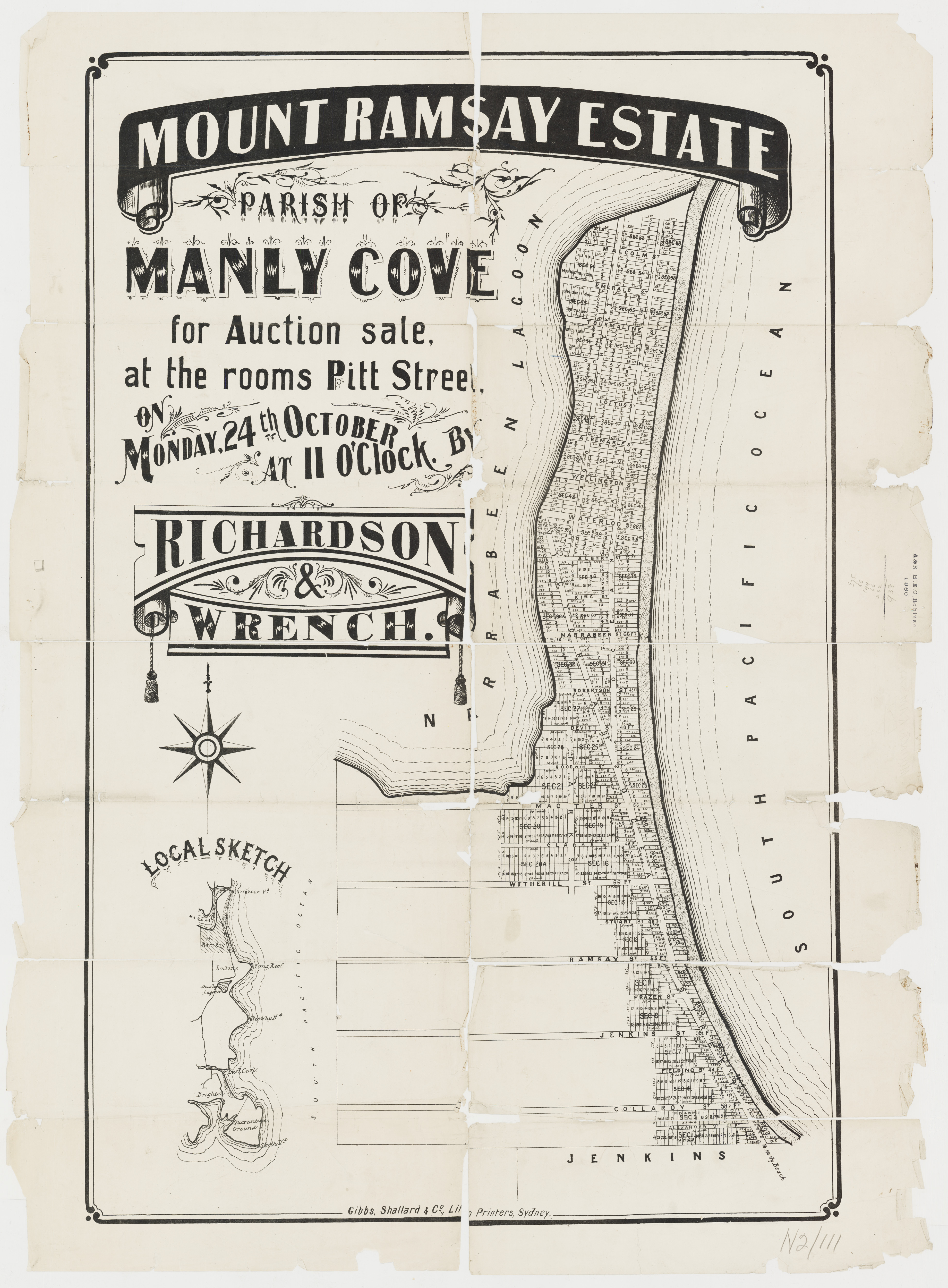
Mount Ramsay Estate, Parish of Manly Cove - Collaroy street, Malcolm St, Alexander etc. - 1881 - Auction Monday October 24th. Richardson and Wrench. Item: c050370117 - and parts from to show Section/Lot Numbers, courtesy the State Library of New South Wales.
.jpg?timestamp=1608525429380)
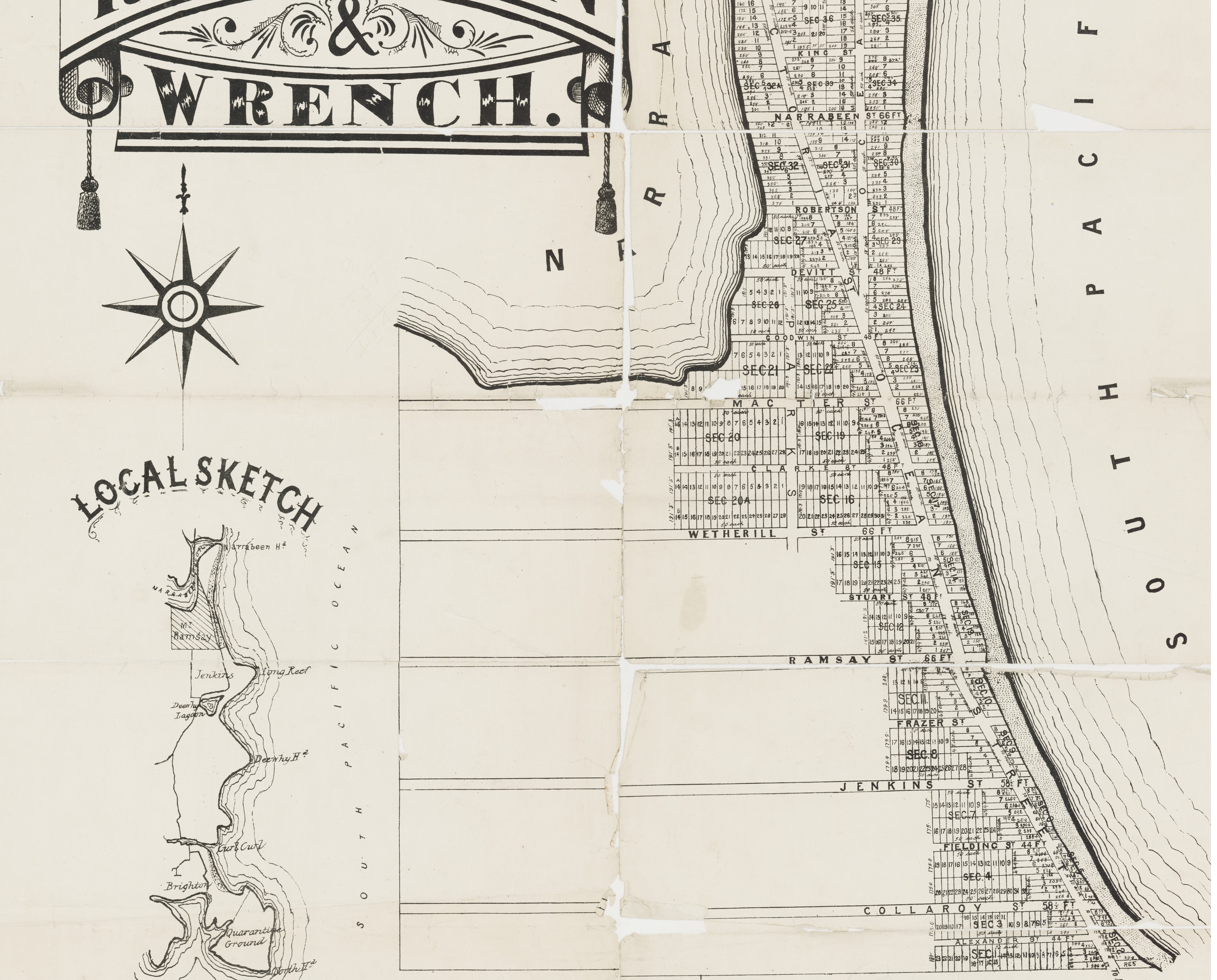
The Saturday paper, just before the Auction:
NEXT MONDAY.
UNRESERVED SALE.
MOUNT RAMSAY ESTATE,
having TWO MILES' FRONTAGE to LONG REEF BEACH,
. . . and
EXTENSIVE FRONTAGES
to
NARRABEEN LAGOON
...... and ... ... PITT WATER-ROAD,
only SIX MILES from MANLY BEACH PIER. NOTE THE VERY LIBERAL TERMS:
£2 DEPOSIT PER LOT, and the RESIDUE in MONTHLY INSTALMENTS of £1.
FREE DEEDS. FREE DEEDS.
RICHARDSON and WRENCH have received instructions to sell by public auction, at the Rooms, Pitt-street, on
MONDAY, 24th OCTOBER, at 11 o'clock.
THE NEW TOWNSHIP
on
LONG REACH BEACH,
and
NARRABEEN LAGOONS,
at the
CROSSING PLACE.
The subdivision is so arranged that purchasers, by taking a number of lots, can thereby secure a large area of land, even to the extent of a WHOLE SECTION.
There are in this portion of the MOUNT RAMSAY ESTATE, SIXTY-FIVE SECTIONS,
Comprising in all about 925 ALLOTMENTS, with Frontages to the MAIN PITT WATER-ROAD, and other streets, all ONE CHAIN WIDE, also to the BEACH known as LONG REACH, and the waters of NARRABEEN LAGOON.
This new township is in the prettiest and most beautiful position in this healthful and really attractive locality, known as the PARISH of MANLY, and is approached by a good, well-formed road from Manly Beach, distant only 6 miles.
PUBLIC CONVEYANCES run through this township daily in their trips to and from MANLY and PITTWATER
The scenery along the road is acknowledged by all to be the most pleasing and enlivening out of the city.
An inspection of the new township subdivision will convince those in search of safe investments that a few pounds judiciously laid out in the purchase of some of the Building Allotments here must turn out a good speculation and return to the investors handsome profit in a very short time.
NOTE THE VERY LIBERAL TERMS
£2 DEPOSIT PER LOT AND THE RESIDUE IN MONTHLY INSTALMENTS Of £1, WITHOUT INTEREST.
FREE DEEDS. FREE DEEDS.
LITHOS. now ready. Large Auction Plan on view at the rooms.
MOUNT RAMSAY ESTATE.
THE NEW WATERING PLACE
and TOWNSHIP
on the BEAUTIFUL and EXTENSIVE SANDY BEACH,
north of MANLY COVE, and extending to the SITE on which the . .
NEW BRIDGE
ls About to be erected across
NARRABEEN LAGOON.
This township is in one of the MOST ROMANTIC and extremely attractive positions on the coast, taking in and having frontages to
THE GRANDEST SEA BEACH
north of Sydney, that will be long remembered by many as the spot upon which the
STEAMSHIP COLLAROY
now lies high and dry.
The drive by road to Mount Ramsay is acknowledged by all who have enjoyed it to be the most attractive and enlivening one along our charming coast.
LIBERAL TERMS. LIBERAL TERMS.
£2 deposit per lot, and the residue in monthly instalments of £1 without interest.
Lithos. are now ready for distribution, and the Auction Plan is on view at the Rooms.
DAY OF SALE,
MONDAY, 21th OCTOBER, at the Rooms, Pitt-street, at 11 o'clock.
FREE DEEDS. FREE DEEDS.
RICHARDSON and WRENCH, Auctioneers. Advertising (1881, October 22). The Sydney Morning Herald (NSW : 1842 - 1954), p. 17. Retrieved from http://nla.gov.au/nla.news-article28382743
NSW Archives holds the following records for lands held by John Wetherill in our area:
- NRS-17513-38-31-PA 4536 | Primary Application - John Wetherill 410 acres on Narrabeen Lagoon in Parish Manly Cove County Cumberland; 01-01-1863 to 18-09-1877
- NRS-13012-3-[6/10080]-PA 4536 | Primary Application -John Wetherill, County of Cumberland; 18-09-1877 to 24-06-1879 - the Mount Ramsay and Collaroy to Narrabeen lands
- NRS-13012-3-[6/10100]-PA 6571 | Primary Application -John Wetherill, Parish of Manly County of Cumberland; 16-12-1885 to 21-07-1886
- NRS-17513-38-198-PA 6571 | Primary Application - John Wetherill 107 acres in Parish Manly Cove County Cumberland Volume 798 Folio 188; 01-01-1863 to 21-07-1886
In the names chosen for these streets is seen a mix of honouring local early land grantees, his own family surname, royalty and governorship and politicians who started simply, as he did, in trades works, and excelled in their chosen fields. John Wetherills' name choices reflect those who held similar ideals to his, and history - Wellington at Waterloo in 1815 standing out as one example.
John Wetherill was elected Mayor of Leichardt in 1874 and 1875, a Council he had served on since its formation in December 1871 and subsequent election of Aldermen in 1872. The published receipts of the first few years of this council show he contributed £ to the building of their first Town Hall and would 'loan' £ when there was a deficit. He was also a founding member in 1872 of the Australian Mutual Fire Insurance Society, modelled on then evolving cooperative movements, which not only generated big profits but also reinvested these in Australians and building Australia. The register of companies investing in mining show him to be a larger shareholder and Director of companies that sought gold and tin. John Wetherill was also a founding Director of the Land Company of Australasia Limited
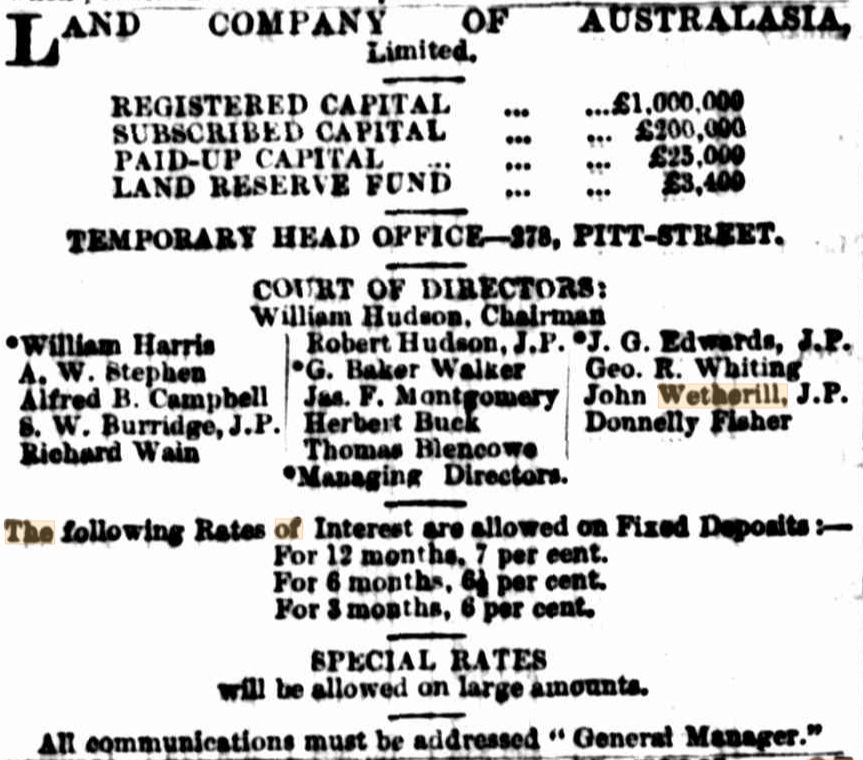
.jpg?timestamp=1609200526371)
Advertising (1886, July 22). The Sydney Morning Herald (NSW : 1842 - 1954), p. 12. Retrieved from http://nla.gov.au/nla.news-article13634655
Then soon after:
In the matter of the Land Company of Australasia (Limited).
AT an Extraordinary General Meeting p| the above-named Company, duly convened and held at the Head Office of the Company, 54, Pitt-street, Sydney, on Monday, the 27th day of February, 1893, at the hour of two o'clock in the afternoon, the following Extraordinary Resolution was duly passed:—
" That it has been proved to the satisfaction of the meeting that the Company cannot, by reason of its liabilities, continue its business; and that it is advisable to wind up the same, and accordingly that the Company be wound up voluntarily."
And Robert Fisher, of Sydney, licensed surveyor, was appointed one of the Liquidators of the Company for the purpose of winding up the same in conjunction with such other person or persons (if any), not exceeding two in number, as should thereafter be appointed as Liquidators by the shareholders. And the meeting having been duly adjourned to Friday, the 3rd day of March, 1893, at the hour of 4 o'clock in the afternoon, a resolution was at such adjourned meeting duly passed, whereby James Robertson, of Sydney, public accountant, was appointed one of the Liquidators of the Company, for the purpose of winding up the same in conjunction with the said Robert Fisher and such other person (if any) as should thereafter be appointed as Liquidator by the shareholders.—Dated this 7th day of March, 1893.
WM. HARRIS, Chairman. In the matter of the Land Company of Australasia (Limited). (1893, March 10). New South Wales Government Gazette (Sydney, NSW : 1832 - 1900), p. 1976. Retrieved from http://nla.gov.au/nla.news-article221707579
Finally completely Liquidated in 1912: THE LAND COMPANY OF AUSTRALASIA LIMITED. (1912, February 28). Government Gazette of the State of New South Wales (Sydney, NSW : 1901 - 2001), p. 1519. Retrieved from http://nla.gov.au/nla.news-article226771572
Although clearly a hard worker, who amassed a fortune, John Wetherill had a soft spot for anything or anyone connected to his birthplace and moved many of his larger land holdings across Sydney under the Real Property Act that were then made into smaller lots to create 'new towns' and opportunities for others. There were numerous forms of co-operative societies forming in Sydney during these decades many of them stating their object and aims were "the purchase of land on such terms as would enable working men and others of limited means to become possessors of their own freeholds on which to build their own homes". Mr. Wetherill, although he would be tough on defaulters of mortgages he covered, appears to have been a subscriber to providing such opportunities. There are more connections hinting of his old home and beliefs that may have been held from his youth under the naming of 'Octavia' street for this 1881 subdivision.
Born in Caythorpe, Lincolnshire, England on 1830 (some state 1836) to William Singleton Wetherill and Anne Hancock (married 27th of March 1821), he arrived in Sydney in the ship Bank of England about 1850. By 1854 he had gone into partnership with James Hancock at Brick Hill in town and later they were selling blankets, bonnets and tartan at 409 George Street, Sydney (opposite the Cathedral). The partnership was dissolved in 1857 and he continued in the drapers business by himself with news reports during the 1850's and 1860's showing he would not hesitate to have any thieves in his shop prosecuted. By 1867 he was installed in 'Waterloo House' in Pitt street, which would be the offices of the Australian Mutual Fire Insurance Society until the new building erected for that purpose would be completed in the mid 1880'son the corner of Pitt and King Streets.
John Wetherill named streets for his children and his second wife Elizabeth Australia Wetherill in his western Sydney subdivisions, as well as one for long-term friend and business partner, John Sutherland MLC, while those at Narrabeen reflect a belief of anything being achievable through hard work. His choices, and where they appear to stem from based on the few threads about his own nature that can be garnered, are a great contrast to those names chosen for the 1870 Therry subdivisions at Careel Bay. At Careel Bay there was an adherence to naming streets after royalty and honouring the memory of Rev. Therry rather than an embracing of this place and its peoples. Wetherill did this too, but his selections are predominated by people who had left a place where they were poor and succeeded in the opportunities offered them here, attained through hard work, integrity and honesty, who almost all served in public office in one form or another.
He died in January 1909 with his assets, showing a penchant for books, art and history, in what was sold off by his relatives and in the names given to some streets for the 1881 Mount Ramsay subdivisions. Even in one article that appears years after he passed away his love for history, particularly local history, is apparent:
WETHERILL, JOHN. -At his late residence, Aloha, Ada-street, Randwick, aged 79. Family Notices (1909, January 5). The Sydney Morning Herald (NSW : 1842 - 1954), p. 6. Retrieved from http://nla.gov.au/nla.news-article15024997
WETHERILL -The Friends of the late Mr JOHN WETHERILL are invited to attend his Funeral which will leave his late residence, Aloha, Ada-street, Randwick, THIS (Tuesday) AFTERNOON at 1 o'clock for Church of England Cemetery, Necropolis. WOOD and COMPANY, Funeral Directors, Tel, 726 etc. Sydney and Suburbs. Family Notices (1909, January 5). The Sydney Morning Herald (NSW : 1842 - 1954), p. 12. Retrieved from http://nla.gov.au/nla.news-article15024875
ART TREASURES. There is now on view at Messrs James Lawson and Little's galleries In Pitt-street a collection of art-treasures originally formed by the late James Wetherill. In addition to graceful examples of furniture by Sheraton and other great makers of the past, there are a collection of rare coins, a number of old English and French clocks, some excellent bronzes, marble statuary, and modern sideboards carved with fruit and flowers. The china section embraces Sevres, Japanese, Worcester, Crown Derby, and other makes, and there are oil and water colour paintings of value, by Franthini, Tully Latt, and other artists. Visitors should not fail to examine the old etchings and engravings, several of which, as "Landing of Charles II," by Woollett West (1789), and "Cromwell and the Long Parliament " by Hall West (1780), are of historic interest. These art-treasures will be sold at the rooms to-morrow and Friday. ART TREASURES. (1909, May 5). The Sydney Morning Herald (NSW : 1842 - 1954), p. 4. Retrieved from http://nla.gov.au/nla.news-article15055843
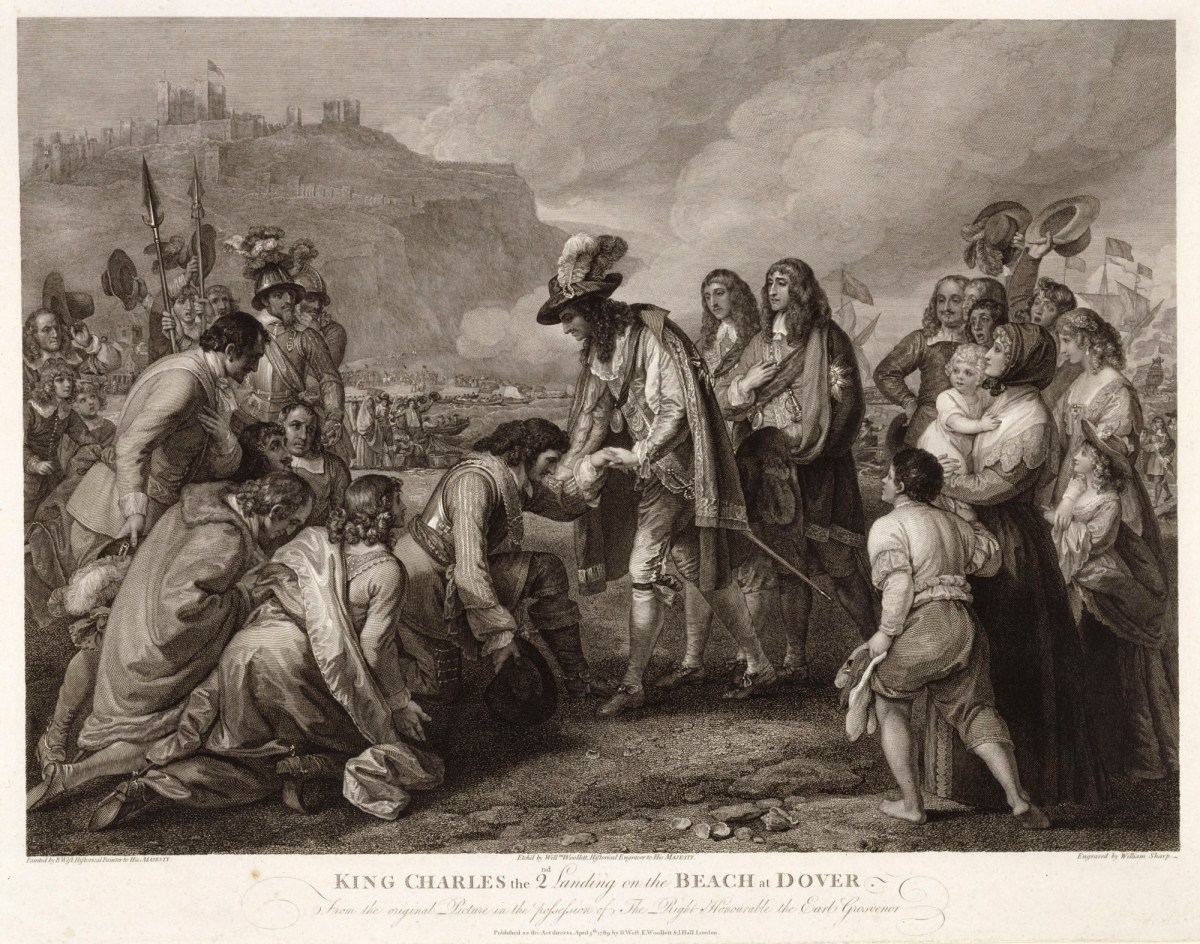
King Charles II landing on the Beach at Dover, 5 April 1789. Engraved by William Sharp (1749 - 1824). Etched by William Woollett (1735 - 1785). Published by Benjamin West PRA (1738 - 1820) and John Hall (1739 - 1797) and E. Woollett
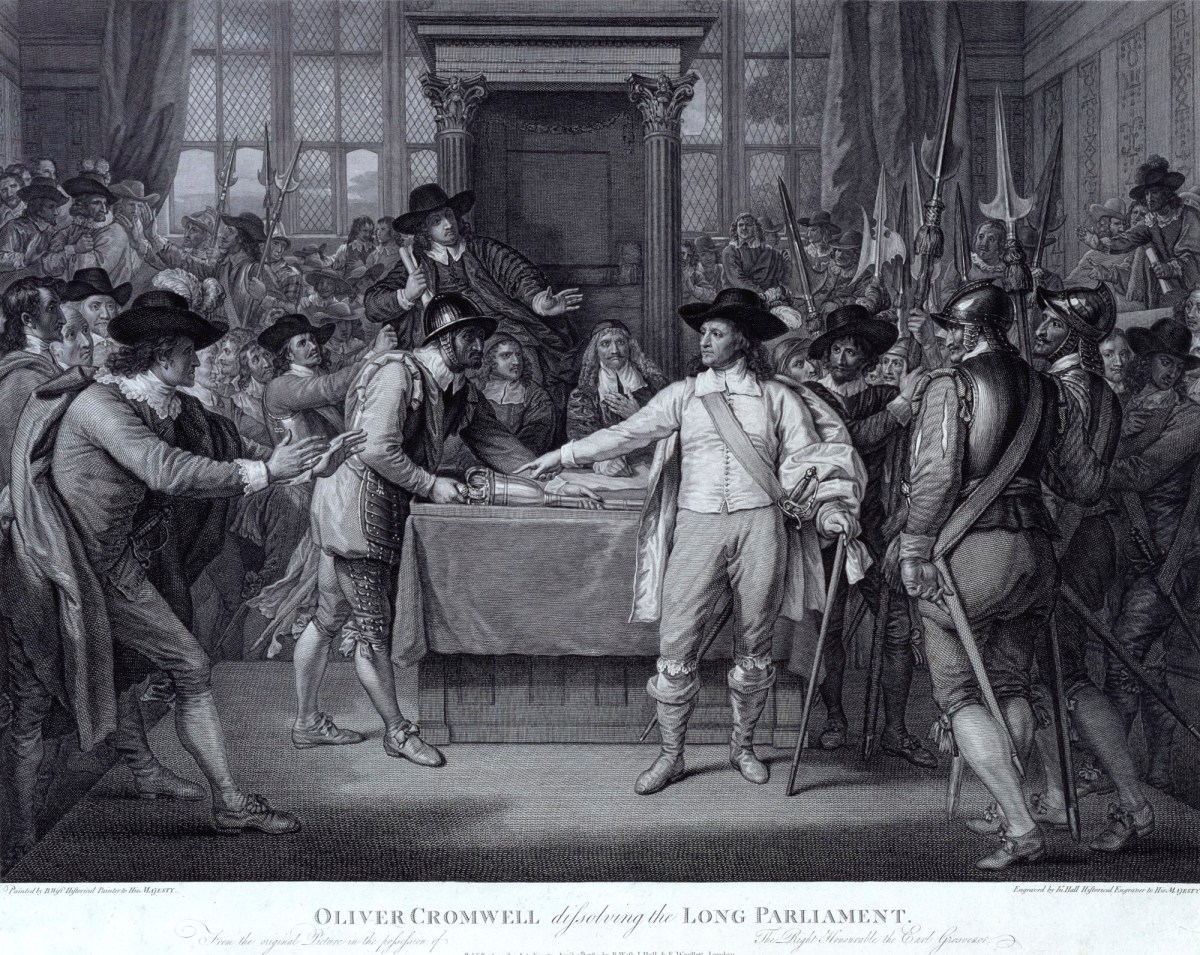
Oliver Cromwell dissolving the Long Parliament, 5 April 1789. Engraved by John Hall (1739 - 1797). Published by Benjamin West PRA (1738 - 1820) and John Hall (1739 - 1797) and E. Woollett.
SECOND DAY'S SALE.
THIS DAY, FRIDAY, 7th MAY, AT ELEVEN O'CLOCK A.M. AT THE AUCTION ROOMS AND GALLERIES JAMES R. LAWSON AND LITTLE, 128 and 130 PITT-STREET. NEAR KING-STREET.
Under instructions from the Family of THE LATE JOHN WETHERILL, and ON ACCOUNT OF NUMEROUS PRIVATE INTERESTS.
SUPERIOR FURNITURE and GENERAL HOUSEHOLD EFFECTS, including COMPLETE FURNISHINGS FOR DINING AND DRAWING ROOMS, ENTRANCE HALL, LIBRARY, AND SEVERAL WELL-APPOINTED BEDROOMS.
Also, SEVERAL PIANOFORTES
JAMES R. LAWSON AND LITTLE, FINE ART AUCTIONEERS. Advertising (1909, May 7). The Sydney Morning Herald (NSW : 1842 - 1954), p. 4. Retrieved from http://nla.gov.au/nla.news-article15056382
If the Ghost of Wentworth could return!
-MAKING HIS HOME AS HE LEFT IT.
IF William Charles Wentworth could cross the valley from the hillside where he rests, to Vaucluse House, he could now enter some of the rooms hardly knowing that half a century had intervened since he was last there. When he left, the atmosphere of the old home went with him; the furniture disappeared; the house lost its character. But now its old glory is coming back; the lost furniture is being recovered and restored to its right setting; the "atmosphere" is being built up again.
Already many of the familiar things which he loved so well have come back to the old mansion, and they have been disposed as they were when Vaucluse House was tenanted by a flesh-and-blood Wentworth instead of by his ghost. These are not mere inanimate things. They have character as well as charm. You can read into them, the old house and its contents, the concentrated, essence of our early political history.
The commanding figure of Wentworth walks in and out the doors, and where Wentworth walked history went with him. A century falls away as you enter. You are surrounded by yesterday, and you feel something of a parvenu.
The eight gentlemen who are charged with its preservation for the nation are seeking to furnish Vaucluse House with the things that grew up with it. They would, reappoint the lovely old home exactly as it was in Wentworth's day.
Most of the original furniture was sold by auction in 1883, and became scattered far and wide throughout Australia and even beyond. ....
Most complete of all the rooms is the family dining-room. The massive table, its 15 feet of surface like a still, oblong pool; the ten sturdy leather chairs, the century-old sideboard carved out of good English oak, the tall dinner waggon — they all are there, just as the butler might have left them after he had cleared away.
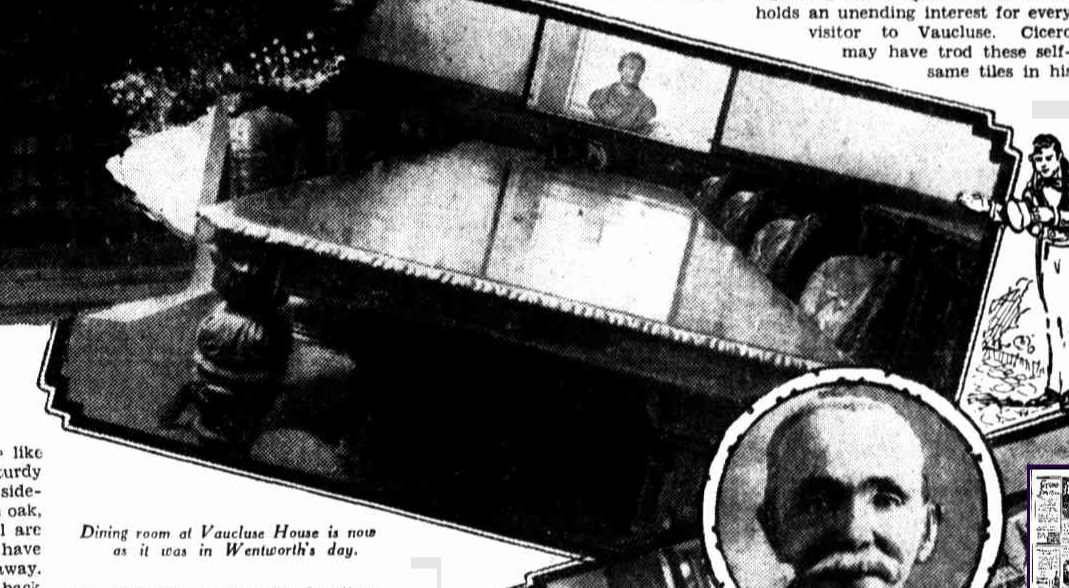
For 40 years before they came back to their rightful setting, these handsome old pieces reposed on the third-stoey floor of the Randwick house of Mr. Wetherill, formerly a Pitt-street draper, and a collector of old and beautiful things... If the Ghost of Wentworth could return! (1928, April 1). The Sun (Sydney, NSW : 1910 - 1954), p. 27. Retrieved from http://nla.gov.au/nla.news-article222012552
Also of interest regarding this October 1881 subdivision into allotments is his purchase of land in May of 1881 which may have led to selling off the Mount Ramsay estate:
SALE OF AN ESTATE.-Messrs. Richardson and Wrench report to the Herald having sold, by private contract, an improved estate at Prospect, County of Cumberland, near Veteran Hall Estate, in area 500 acres, more or less, for the sum of £15,000, to Mr. John Wetherill. Destruction of Casamicciola, Ischia. (1881, May 21). The Maitland Mercury and Hunter River General Advertiser (NSW : 1843 - 1893), p. 6 (Second Sheet to The Maitland Mercury). Retrieved from http://nla.gov.au/nla.news-article817384
Caythorpe is a large village and civil parish in the South Kesteven district of Lincolnshire, England. Notable people include Edmund Weaver, 18th-century astronomer and land agent, who lived at Frieston, and George Hussey Packe (1796–1874), MP, who was an army officer present at the Battle of Waterloo. George Hussey Packe was a scion of the family of Sir Christopher Packe, a 17th-century Lord Mayor of London. He was born at Hanthorpe House, Morton and Hanthorpe, Lincolnshire in 1796, the second son to Charles James Packe (1758–1837), of Prestwold Hall, Leicestershire, and his first wife Penelope, of Blythe Hall, Warwickshire. He married in 1824 Maryanne-Lidia (1796–1876), daughter of John Heathcote – of Connington Castle, Huntingdonshire, and MP for Ripon – and Mary Anne (née Thornhill). They had two children: Marianne Penelope Packe (1832–1921) and Hussey Packe (1846–1908). Packe inherited Prestwold Hall and its estates. Caythorpe Hall at Caythorpe, Lincolnshire was a further residence, built for him in 1823, and a rebuild of a previous hall, the residence of Sir Giles Hussey. With Caythorpe Hall came 4,000 acres of estate. Packe was Lord of the Manor of Caythorpe, with the parish living and rectory under his patronage. He built and supported the village school connected to St Vincent's Church, and for the church provided a peal of eight bells and a clock.
As can be seen in the small threads found, John Wetherill had a love for history and art depciting this, as well as a fondness fopr books. The 1881 Mount Ramsay Estate Auction streets list and named for, running north to south, are:
Victoria St: named for the then Queen of the Commonwealth, Victoria. Although 'the road to Pittwater', the cart and horse track between Collaroy and Narrabeen Primary School, obviously already existed, it was called 'Ocean Street' from Long Reef to the present day school, and from there to Narrabeen Terminus it was known as 'Victoria street'.
Malcolm st.: Possibly after Major-general Sir John Malcolm GCB, KLS (2 May 1769 – 30 May 1833) a Scottish soldier, diplomat, East India Company administrator, statesman, and historian. Born in 1769, one of seventeen children of George Malcolm, an impoverished tenant farmer in Eskdale in the Scottish Border country, and his wife Margaret (‘Bonnie Peggy’), née Pasley, the sister of Admiral Sir Thomas Pasley. His brothers included Sir James Malcolm, Admiral Sir Pulteney Malcolm and Sir Charles Malcolm. He left school, family and country at the age of thirteen, and achieved distinction in the East India Company over the next half century. A spirited character, he was nicknamed ‘Boy Malcolm’; for throughout his life he retained a youthful enthusiasm for field sports and fun and games. But behind this boisterous exterior lay serious intellectual ability and a considerable talent for government. In the Anglo-Maratha war of 1803-05, he accompanied Sir Arthur Wellesley (later Duke of Wellington) as the Governor-General’s representative and diplomatic agent; the two men forming a lifelong friendship. The Second Anglo-Maratha War (1802–1805) was the second conflict between the British East India Company and the Maratha Empire in India. In September 1803, Scindia forces lost to Lord Gerard Lake at Delhi and to Arthur Wellesley at Assaye. From: https://en.wikipedia.org/wiki/Second_Anglo-Maratha_War The Battle of Assaye was a major battle of the Second Anglo-Maratha War fought between the Maratha Empire and the British East India Company. It occurred on 23 September 1803 near Assaye in western India where an outnumbered Indian and British force under the command of Major General Arthur Wellesley (who later became the Duke of Wellington) defeated a combined Maratha army of Daulat Scindia and the Raja of Berar. The battle was the Duke of Wellington's first major victory and the one he later described as his finest accomplishment on the battlefield, even more so than his more famous victories in the Peninsular War, and his defeat of Napoleon Bonaparte at the Battle of Waterloo. The Deccan plateau is very rich in minerals and precious stones. The plateau's mineral wealth led many lowland rulers, including those of the Mauryan (4th–2nd century BCE) and Gupta (4th–6th century CE) dynasties, to fight over it. Major minerals found here include coal, iron ore, asbestos, chromite, mica, and kyanite.
Emerald St: named for the gem, and perhaps influenced by how green Narrabeen was then or by gifts given to his wife. His daughter 'Ruby' Louise was born June 3rd, 1879.
Tourmaline St: named for the gem/crystal, which can be a bluish-black, or in the crystal form, green at one end and pink at the other. One item found shows the tourmaline his wife may have possessed was pink: Stolen, about three weeks ago, from the residence of John Wetherill, draper, Petersham,—A lady’s heavy gold ring with five pink stones, claw setting; value, about £3. Identifiable. Burglaries, Stealing from the Premises, &c. (1877, February 28). New South Wales Police Gazette and Weekly Record of Crime (Sydney : 1860 - 1930), p. 64. Retrieved from http://nla.gov.au/nla.news-article252089767. There is also a link in this to the Battles of Wellington on the mineral rich Deccan Plateau in India. There is also Luxullianite (also Luxulyanite, Luxulianite) a rare type of granite, notable for the presence of clusters of radially-arranged acicular tourmaline crystals enclosed by phenocrysts of orthoclase and quartz in a matrix of quartz, tourmaline, alkali feldspar, brown mica, and cassiterite. The name originates from the village of Luxulyan in Cornwall, England, where this type of granite is found. An example of its use may be seen in the Duke of Wellington's monument at St Paul's Cathedral in London.

Luxullianite from Cornwall, showing dark patches of tourmaline and pink crystals of orthoclase - photo by and courtesy Kevin Walsh
Octavia St: Octavia, byname Octavia Minor, (born c. 69 BC—died 11 BC), full sister of Octavian (later the emperor Augustus) and wife of Mark Antony. Octavia was the faithful wife and mother who raised Mark Antony's children by Cleopatra along with her own children. Octavia was the daughter of Gaius Octavius and his second wife, Atia. Before 54 BC Octavia was married to Gaius Marcellus, by whom she had two daughters and a son. On the death of Marcellus in 40 she was married to Mark Antony, who at the time was ruling the Roman state with Octavian and Marcus Aemilius Lepidus. At first this marriage helped to reduce tensions between Antony and Octavian, and when the two rulers quarrelled in 37, Octavia brought about peace between them, which resulted in the Treaty of Tarentum. In 36 Antony left Italy to command troops in Parthia and while in the East resumed his liaison with the Egyptian queen Cleopatra. Although Octavia brought troops and money to him (35), he refused to see her, and in 32 he obtained a divorce. The Porticus of Octavia in Rome is named for her.
Octavia, in Narrabeen, was possibly named to honour Octavia Hill, (3 December 1838 – 13 August 1912) and harking back to his birthplace and his own beliefs in setting up the Australian Mutual Fire Society along co-operative models. Octavia was an English social reformer, whose main concern was the welfare of the inhabitants of cities, especially London, in the second half of the nineteenth century. Born in Wisbech, Isle of Ely, Cambridgeshire, the daughter of James Hill, a corn merchant, former banker and a follower of Robert Owen(a Welsh textile manufacturer, philanthropist and social reformer, who was one founder of utopian socialism and the cooperative movement. He is known for efforts to improve factory working conditions for his workers and promote experimental socialistic communities. In the early 1800s, he became wealthy as an investor and eventual manager of a large textile mill at New Lanark, Scotland. He had initially trained as a draper in Stamford, Lincolnshire, and worked in London before relocating aged 18 to Manchester and becoming a textile manufacturer. He continued to champion the working class, led the development of cooperatives and the trade union movement, and supported the passage of child labour laws and free co-educational schools), and his third wife, Caroline Southwood Smith. James Hill had been widowed twice, and had six surviving children (five daughters and a son) from his two previous marriages; Octavia was her father's eighth daughter and tenth child. He had been impressed by the writings on education of his future wife, the daughter of Dr Thomas Southwood Smith, a pioneer of sanitary reform. He had engaged Caroline as a governess to his children in 1832, and they were married in 1835. The family's comfortably prosperous life was disrupted by James Hill's financial problems and his mental collapse. In 1840 he was declared bankrupt. Caroline Hill's father gave the family financial support, and took on some of Hill's paternal role. Southwood Smith was a health and welfare reformer concerned with a range of social issues including child labour in mines and the housing of the urban poor. Caroline Hill held similar views on social reform, and her interest in progressive education, influenced by Johann Heinrich Pestalozzi, and Southwood Smith's daily experience in his work at the London Hospital in the East End inspired Octavia Hill's concern for the poorest in early Victorian London. She received no formal schooling: her mother educated the family at home. A co-operative guild providing employment for "distressed gentlewomen" accepted Hill for training in glass-painting when she was 13. When the work of the guild was expanded to provide work in toy-making for Ragged school children, she was invited, at the age of 14, to take charge of the workroom. The following year she began working in her spare time from the guild as a copyist for John Ruskin in Dulwich Art Gallery and the National Gallery. She was deeply aware of the dreadful living conditions of the children in her charge at the guild. Parliament and many concerned reformers had been attempting to improve the housing of the working classes since the early 1830s. When Hill began her work, the model dwelling movement had been in existence for twenty years, royal and select committees had sat to examine the problems of urban well-being, and the first of many tranches of legislation aimed at improving working class housing had been passed.
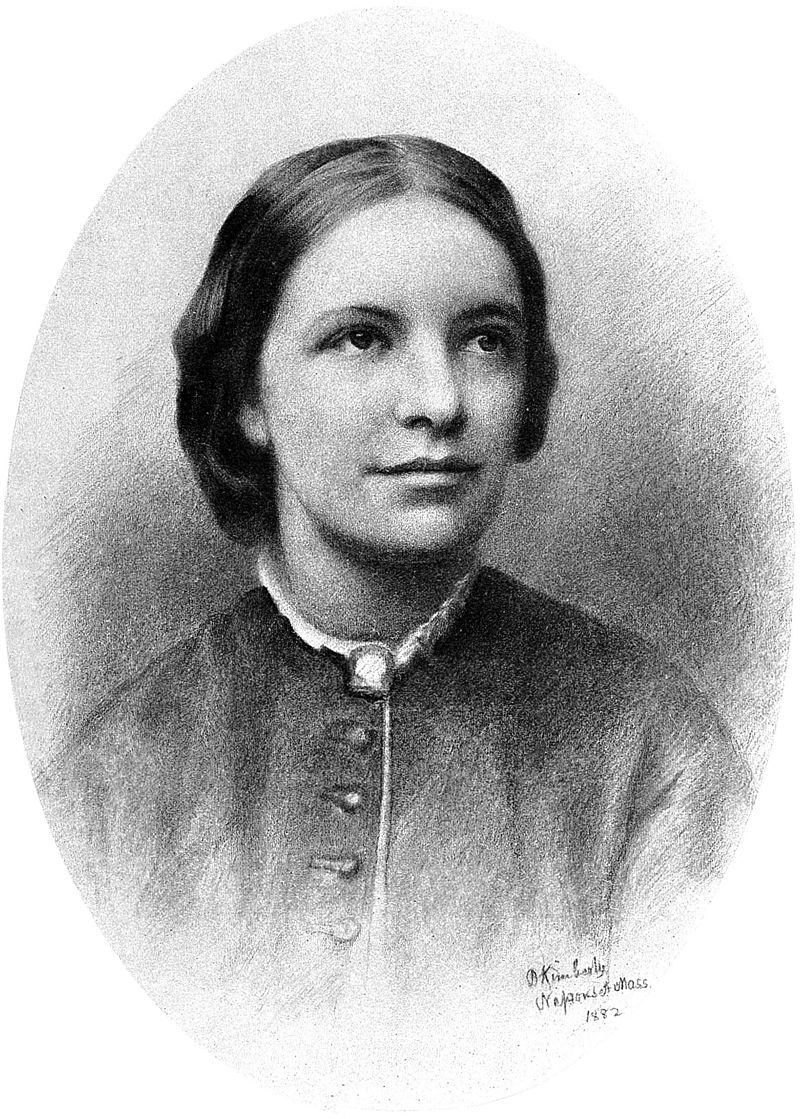 Right: Octavia Hill in 1882
Right: Octavia Hill in 1882
From Hill's point of view these had all failed the poorest members of the working class, the unskilled labourers. She found that their landlords routinely ignored their obligations towards their tenants, and that the tenants were too ignorant and oppressed to better themselves. She tried to find new homes for her charges, but there was a severe shortage of available property, and Hill decided that her only solution was to become a landlord herself. John Ruskin, who was interested in the co-operative guild, knew Hill from her work as his copyist and was impressed by her. As an aesthete and a humanitarian he was affronted by the brutal ugliness of the slums.In 1865, having inherited a substantial sum of money from his father, he acquired for £750 the leases of three cottages of six rooms each in Paradise Place, Marylebone. Ruskin placed these houses, which were "in a dreadful state of dirt and neglect", under Hill's management. In 1866 Ruskin acquired the freehold of five more houses for Hill to manage in Freshwater Place, Marylebone. The Times recorded, "The houses faced a bit of desolate ground occupied by dilapidated cowsheds and manure heaps. The needful repairs and cleaning were carried out, the waste land was turned into a playground where Mr. Ruskin had some trees planted." After being improved the properties were let to those on intermittent and low incomes. A return of five per cent on capital was obtained as promised to Ruskin; any excess over the five per cent was reinvested within the properties for the benefit of the tenants. Rent arrears were not tolerated, and bad debts were minimal. As Hill said, "Extreme punctuality, and diligence in collecting rents, and a strict determination that they shall be paid regularly, have accomplished this." In consequence of her prudent management, Hill was able to attract new backers, and by 1874 she had 15 housing schemes with around 3,000 tenants. Hill's principles were summed up in an article of 1869: "Where a man persistently refuses to exert himself, external help is worse than useless." She was an outspoken critic of the principles of "outdoor relief" or the Speenhamland system of poor relief as operated by various Poor Law Boards. Because these systems did not encourage recipients to work, she regarded them as "a profligate use of public funds." Under her methods, personal responsibility was encouraged. She insisted on dealing with arrears promptly; she appointed reliable caretakers; she took up on references of prospective tenants, and visited them in their homes; she paid careful attention to allocations and the placing of tenants, with regard to size of families and the size and location of the accommodation to be offered; and she made no rules that could not be properly enforced.
Among Hill's concerns was that her tenants, and all urban workers, should have access to open spaces. She believed in "the life-enhancing virtues of pure earth, clean air and blue sky." In 1883 she wrote:
There is perhaps no need of the poor of London which more prominently forces itself on the notice of anyone working among them than that of space. ... How can it best be given? And what is it precisely which should be given? I think we want four things. Places to sit in, places to play in, places to stroll in, and places to spend a day in. The preservation of Wimbledon and Epping shows that the need is increasingly recognised. But a visit to Wimbledon, Epping, or Windsor means for the workman not only the cost of the journey but the loss of a whole day's wages; we want, besides, places where the long summer evenings or the Saturday afternoon may be enjoyed without effort or expense.
Octavia campaigned hard against building on existing suburban woodlands, and helped to save Hampstead Heath and Parliament Hill Fields from development. She was the first to use the term "Green Belt" for the protected rural areas surrounding London. Three hills in Kent (Mariners Hill, Toys Hill and Ide Hill) which she helped to protect from development form part of the belt.
In 1876 Hill became the treasurer of the Kyrle Society, founded in that year by her eldest sister, Miranda, as a "Society for the Diffusion of Beauty". Under the slogan "Bring Beauty Home to the Poor" it aimed to bring art, books, music and open spaces into the lives of the urban poor. For a short period it flourished and expanded, and although it declined after a few years, it was a template for the National Trust, 20 years later.
Women who had trained under Hill formed the Association of Women Housing Workers in 1916. This later changed its name to the Society of Housing Managers in 1948. After merging with the Institute of Housing Managers in 1965, the society became the present day Chartered Institute of Housing in 1994. The CIH is a professional body for those working in the housing profession in the UK and overseas. The training that Hill gave to Charity Organisation Society volunteers contributed to the development of modern social work, and COS continued to be instrumental in developing social work as a profession during the twentieth century. COS is still in operation today as the charity Family Action.
In 1907, Parliament passed the first National Trust Act, enshrining the trust's permanent purpose and giving it powers to protect property for the benefit of the nation. The trust now looks after a wide range of coast, countryside and historic buildings. According to the trust's website, "Staff, volunteers and tenants are engaged daily in providing access to open spaces for people's enjoyment, providing habitats for wildlife and in improving our environment – 'for ever, for everyone'."
Loftus: named for Sir Augustus Loftus, then Governor of NSW.
Albemarle: Possibly named for Montague Peregrine Albemarle or more likely, Albemarle Bertie, 9th Earl of Lindsey of Lincolnshire, and a hearkening back to the place of John Wetherill's birth as well as showing what will be done by a loyal Royalist - from the pages of then, an Australian link:
LORD AND LADY BERTIE.
(See portraits on page 33.)
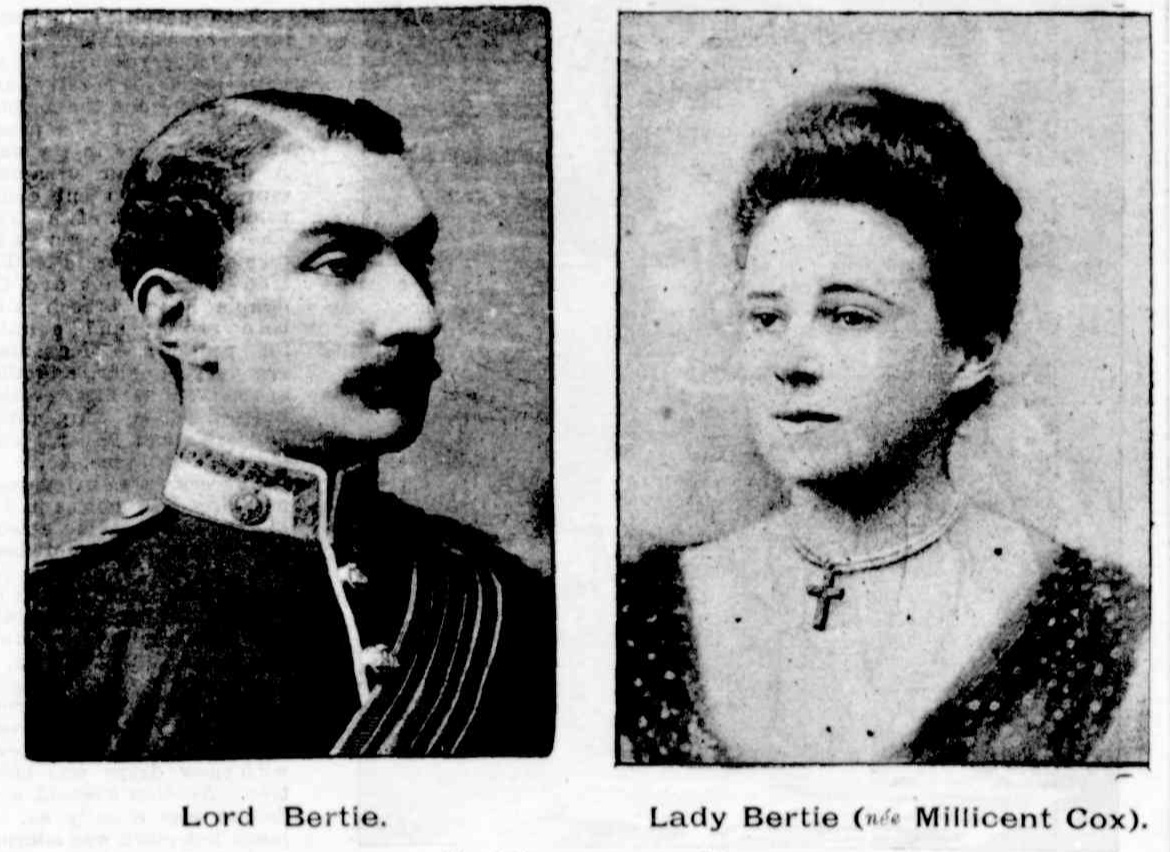
Lord Bertie. Lady Bertie (née Millicent Cox).
(See letterpress on page 35.)
Montague Peregrine Albemarle, Lord Bertie, is the only son and the heir of the Earl of Lindsey, in the peerage of England, and eleventh earl of that name. The family belongs to Lincolnshire, and must not be confounded with the Lindsay's of the Scottish peerage. The first Earl Lindsey (creation 1626) was Lord Great Chamberlain of England ; and he laid claim, though unsuccessfully, to the earldom of Oxford. In the time of Charles I. he was Lord High Admiral of England and he was killed at the decisive battle of Edgehill, when he fought in the Royalist cause. He left, however, a younger son, from whom the present earl's descent is traced. The fourth earl was created Dulce of Ancastor and Kest even in 1715 ; but the title became extinct in 1809 ; and the earldom reverted to the present poor's father. Lord Lindsey was born in December, 1815, and married in 1854 a daughter of the Rev. J. E. Welby, rector of Hurston, in Leicester shire, by whom he has issue one son (Lord Bertie), and three daughters. Lord Bertie was born in September 1861, and was educated at Eton and Magdalen College, Cambridge. In 1881 he was appointed lieutenant in the 4th battalion of the Northampton shire Regiment of Militia; and in our portrait he is represented in his lieutenant's uniform. He is also a Justice of the Peace for Lincolnshire. Lord Bertie came to Sydney as aide-de-camp to Lord Carrington, a position which he, of course, resigns upon his marriage. Our portrait is from a photograph by Messrs. Freeman and Co., of George-street, Sydney. It may, perhaps, be worth noting by those who take an interest in these matters that the coat of arms of the Lindseys is very similar to that of the Euria of Abingdon. Indeed the families are connected. But, though the earldom of Lindsey is nearly fifty years older than Abingdon, yet the barons of Norreya (the Abingdon second title) are fifty years older still the first Lord Nerreys having been ambassador to the Court of France in the time of Queen Elizabeth.
Lady Bertie is the daughter of Dr. James Charles Cox, who has for many years occupied a prominent position in Sydney, both as a medical practitioner and a scientist. He is the youngest son of the late Hon. Edward Cox, and grandson of Capt. William Cox, of the 28th regiment ; his mother being a daughter of the late Captain Brooks, of Denham Court. Dr. Cox was born in 1834, at Fernhill Cottage, Mulgoa, near Penrith, where his father had established one of the first sheep stations in the country. Up to the age of 11 years he was educated in the Parsonage School at Mulgoa, whence he was transferred to the famous King's School, in Parramatta (then in charge of the late Dr. Forrest). After two years' sojourn there he was apprenticed to Dr. H. G. Douglas, previously to his entering upon the study of medicine as a profession. In 1852 he went to the University of Edinburgh ; and there in 1857 he took his M.D. degree, passing in the same year as surgeon in the Royal College of Surgeons, Edinburgh, in which institution he also obtained a fellowship. After qualifying himself for the practice of his profession, he returned to Sydney, where he acquired a large and fashionable practice afterward. He was elected honorary physician of the old Sydney Hospital, which position he held for sixteen years. He has been a member of the Board of Inspectors for Lunatic Asylum a for many years; and he is lecturer on the Practice of Medicine in the Sydney University, and chief medical adviser to the Australian Mutual Provident Society, Dr, Cox has a strong love for natural history : and it was his taste in this direction which decided his adoption of the medical profession. While a pupil of the late Dr. Douglas he made a splendid collection of the seaweeds of Port Jackson, which he presented, through Professor Balfour, to Dr. Bentham, who wrote a valuable illustrated monograph on Australian seaweeds. While in Edinburgh Dr. Cox entered on the study of conchology, under the late Professor Edward Forbes ; and he followed up this branch of natural science on his return to Sydney. In 1864 he published an illustrated monograph on Australian and shells, which were then but little known. This is still recognised aa a standard work. He devoted considerable time to the question of air-breathing molluscs, as well as to the marine and fresh water forms. From time to time he published the results of his observations in the proceedings of the Zoological Society of London, of which he was elected a corresponding member. He has contributed to other local and foreign scientific periodicals, and is recognised as an authority on oyster culture. As far back aa 1864 he wrote very fully on the oyster beds in our rivers and along the coast ; and in 1880 he was appointed a member of the Royal Commission for investigating the state of our fishing industries. He is a member of the Linnean Society, London, and a vice-president of the affiliated society of New South Wales, and a member of the Smithsonian Institution in Washington (U.S.A.), and of various other scientific bodies. Dunner four or five yeara he occupied the position of President of the Linnean Society of New South Wales ; and for many years he has acted as one of the trustees of the Australian Museum in Sydney. Dr. Cox married in 1858 Margaret Wharton Maclellan, daughter of Mr. John Maclellan, of Greenock (Scotland). Miss Millicent Emma Inglis Cox is the oldest daughter of that marriage, and was born in Sydney on September 30, 1862. At the age of 14 years Miss Cox was sent to Edinburgh, and was educated in that city for three years, finishing her studies in Stuttgart (Germany) and in Paris. Miss Cox is a highly accomplished young lady, and will, as the present Lady Bertie, and the future Countess of Lindsey, worthily represent the daughters of Australia. Our portrait is from a photograph taken by messrs. Kerry and Jones, of George-street, Sydney. LORD AND LADY BERTIE. (1890, February 15). Australian Town and Country Journal (Sydney, NSW : 1870 - 1907), p. 33. Retrieved from http://nla.gov.au/nla.news-article71107916
James Charles Cox (21 July 1834 – 29 September 1912) was a son of Jane Maria (née Brooks) Cox and Edward Cox of Fernhill in Mulgoa. Among his siblings was Edward King Cox, who was appointed to the New South Wales Legislative Council, and Richard William Cox, a prominent sheep grazer. His father was a non-elective member of the New South Wales Legislative Council. As a child, he played with Aboriginal children and learned from them about native birds and animals. He became an assistant to Professor John Smith, the foundation professor of chemistry and experimental physics at the University of Sydney at its original site near Hyde Park, now occupied by Sydney Grammar School and established what became the Sydney Museum next door. He earned an M.D. in 1857 presenting the thesis "On the icterus neonatorum" and F.R.C.S. in 1858 at the University of Edinburgh. He was registered as a medical practitioner in New South Wales in February 1859 and developed a lucrative private practice in Sydney.
Dr. Cox retained an interest in nature all his life. He was elected a fellow of the Royal Society of New South Wales (then the Philosophical Society) in 1859. He was first president of the New South Wales Board of Fisheries and first secretary of the Entomological Society (later the Linnean Society of New South Wales), both in 1862. He was elected a fellow of the Linnean Society of London in 1868. He was a trustee of the Sydney Museum and left it his collection of land shells. His wrote extensively in the journals of these societies on the conchology of Australia and Melanesia. Dre. Cox died on September 29th 1912 in the Sydney suburb of Mosman.
Possible context for Albemarle too: The Battle of Albemarle Sound was an inconclusive naval battle fought in May 1864 along the coast of North Carolina during the American Civil War. Three Confederate warships, including an ironclad, engaged eight Union gunboats. The action ended indecisively due to the sunset. James W. Cooke, commander of Albemarle sailed out of Plymouth in early May 1864, along with the captured steamer CSS Bombshell and the transport CSS Cotton Plant. Steaming south toward New Bern, Cooke ran into a Union fleet at the mouth of Albemarle Sound, commanded by Captain Melancton Smith. This fleet consisted of the double-ender gunboats USS Mattabasett, USS Sassacus, USS Wyalusing and USS Miami, the converted ferryboat USS Commodore Hull, USS Ceres, USS Whitehead and USS Isaac N. Seymour.[3] When the Confederate ships were spotted, Mattabasett, Sassucus, Whitehead and Wyalusing immediately formed a line of battle supported by Miami, Commodore Hull and Ceres. Albemarle opened fire first, wounding six men working one of Mattabesett's two 100-pounder Parrott rifles. Mattabesset, Whitehead and Wyalusing opened fire almost simultaneously. Albemarle then attempted to ram Mattabesett, but the sidewheeler managed to round the ironclad's armored bow. She was closely followed by Sassacus, which then fired a broadside of solid 9 in (229 mm) and 100-pound shot, all of which bounced off Albemarle's casemate armor. However, Bombshell, being a softer target, was hulled by each heavy shot from Sassucus's broadside and surrendered. Cotton Plant withdrew back up the Roanoke, and Albemarle continued the fight alone.The battle itself was a standoff, but the events that followed had more decisive results. Albemarle had held its own against greater numbers but the damages caused the during the battle had forced the ship into port for the next several months, preventing it from being used in General Hoke's planned assault on New Bern. Hoke went ahead with his campaign even without Albemarle. He achieved nothing before being recalled to Virginia to help defend Petersburg and Richmond. The events in October had a greater impact on the situation when William B. Cushing led a naval raid and detonated a torpedo beneath the Albermarle's hull. The removal of Hoke's force and the destruction of Albemarle allowed both Plymouth and Washington, North Carolina, to fall back into Union hands
Wellington St: named for Arthur Wellesley, 1st Duke of Wellington (1769-1852).
Waterloo St: named for the battle the 1st Duke of Wellington fought on June 18, 1815, defeating Napoleon - and remembering John Wetherill was a 20 year old man by the time he came who must have grown up hearing these legends and histories. Waterloo in Belgium was part of the United Kingdom of the Netherlands at the time. An exchange with Clausewitz( Prussian political-military theorist Carl von Clausewitz, Feldzug von 1815: Strategische Uebersicht des Feldzugs von 1815, English title: The Campaign of 1815: Strategic Overview of the Campaign, was Clausewitz's last study and is widely considered to be the best example of Clausewitz's mature theories concerning such analyses. It attracted the attention of Wellington's staff, who prompted the Duke to write his only published essay on the campaign [other than his immediate, official after-action report, "The Waterloo Dispatch"], his 1842 "Memorandum on the Battle of Waterloo". While Wellington disputed Clausewitz on several points, the Prussian writer largely absolved Wellington of accusations levelled against him by nationalistic German axe-grinders ) was quite famous in Britain in the 19th century - it was heavily discussed in, for example, Chesney's Waterloo Lectures (1868).
The other vital fact in the naming of 'Waterloo' is his premises for his drapery business was in 'Waterloo House, 233 and 235 Pitt street, Sydney from 1870.
Waterloo House 233-235 Pitt-Street
Drapers, tailors and outfitters were well established along Pitt Street, Sydney between King and Market Streets from the 1840s to the 1880s in a city block that included the popular Royal Victoria Theatre at No’s. 243-247 Pitt Street. Their stock-in-trade was primarily fine fabrics imported from England on board merchant barques.
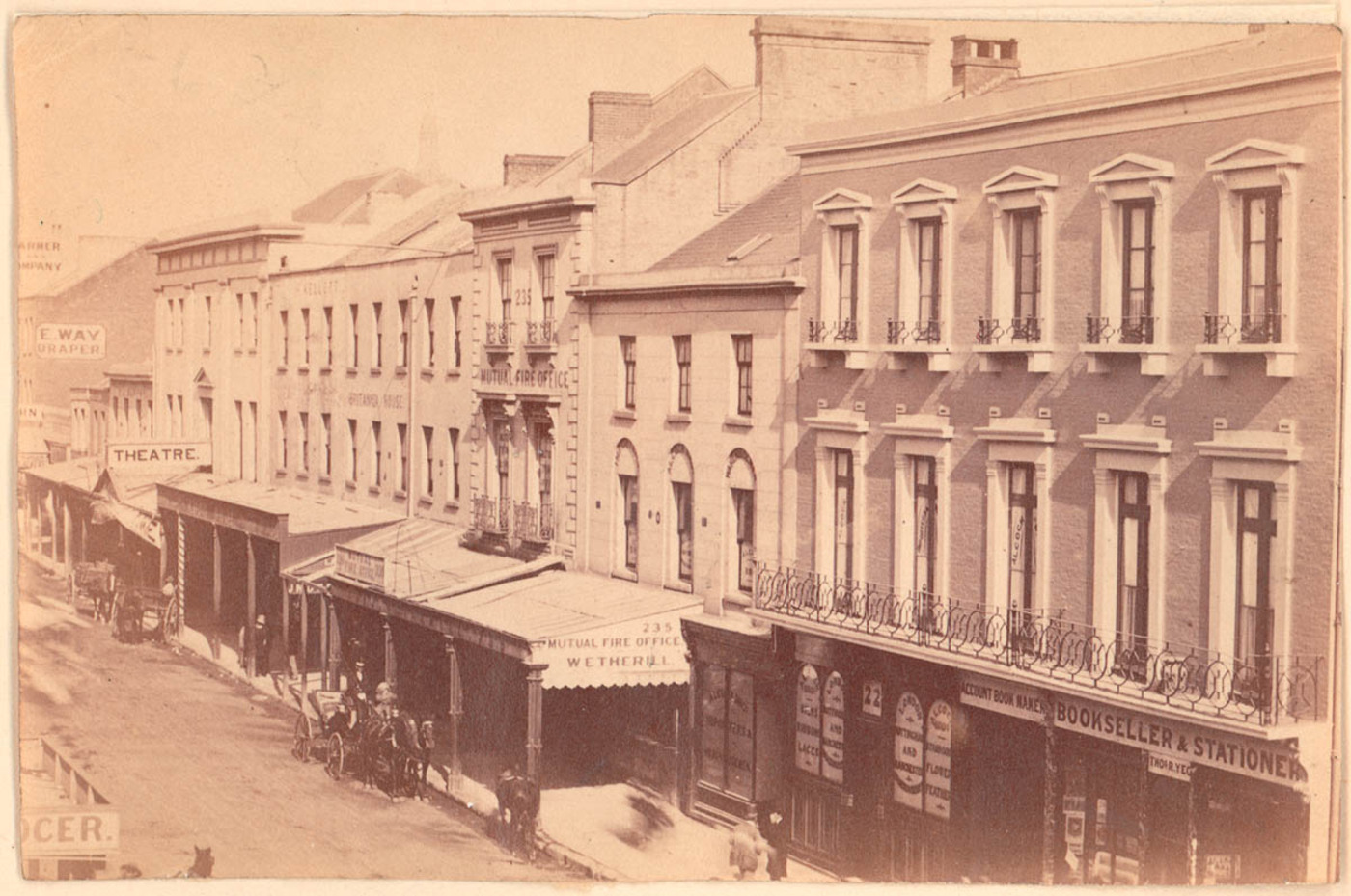
227 to 267 Pitt Street, Sydney, circa 1870 to 1875. Photo Digital order no: a089579, courtesy the State Library of New South Wales. Showing Wetherill drapery business and Mutual Fire Office. Records indicate John Wetherill owned this property too and this is just a short distance from his original 'Brick Hill' premises.
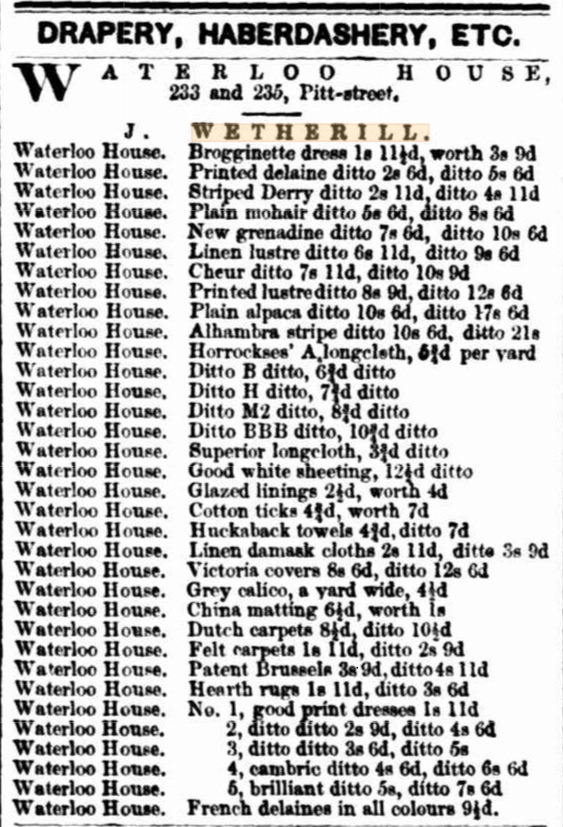
Advertising (1870, October 24). The Sydney Morning Herald (NSW : 1842 - 1954), p. 6. Retrieved from http://nla.gov.au/nla.news-article13222725
Waterloo is an inner-city suburb of Sydney, located 3 kilometres (1.87 mi) south of the Sydney central business district and is part of the local government area of the City of Sydney. Waterloo is surrounded by the suburbs of Redfern and Darlington to the north, Eveleigh and Alexandria to the west, Rosebery to the south, and Moore Park, Zetland, and Kensington to the east. Waterloo took its name from the Battle of Waterloo in 1815, when Allied and Prussian forces under the Duke of Wellington and Blücher defeated the French forces under Napoleon Bonaparte. In the 1820s Waterloo began supporting industrial operations including the Fisher and Duncan Paper Mill and the Waterloo Flour Mills owned by William Hutchinson and Daniel Cooper. William Hutchinson, superintendent of convicts and public works, had been granted 1,400 acres (5.7 km2) of land in 1823. He sold Waterloo Farm to Daniel Cooper (1785–1853) and Solomon Levey (1794–1833). Cooper later bought out Levey's share and on his death the Waterloo Estate passed onto his nephew, also named Daniel Cooper, who was the first Speaker of the New South Wales Legislative Assembly. Sir Daniel Cooper, 1st Baronet GCMG (1 July 1821 – 5 June 1902) was a nineteenth-century politician, merchant and philanthropist in the Colony of New South Wales. He served as the first speaker of the Legislative Assembly of the colony and was a noted philatelist. Cooper was conferred the hereditary title of Cooper baronet of Woollahra in 1863, the second of four baronetcy conferred to British expatriates in the Australian colonies. There are threads interwoven through the Clareville Streets Have Your Name page of that places association with New South Wales first Speaker. He was born at Bolton, Lancashire, England, the son of Thomas Cooper, merchant, and his wife Jane Ramsden. He was the nephew of the emancipated convict and extraordinarily successful businessman, Daniel Cooper, who took an interest in the education of his nephew. Bolton is a large town in Greater Manchester in North West England, historically and traditionally a part of Lancashire and, as a former mill town, Bolton has been a production centre for textiles since Flemish weavers settled in the area in the 14th century, introducing a wool and cotton-weaving tradition.In 1849 at the age of 28, Cooper was made a member of the legislative council, and in 1856 he was elected as a member for Legislative Assembly seat of Sydney Hamlets [an electoral district of the Legislative Assembly in then British colony of New South Wales from 1856 to 1859, including what were then outer suburbs of Sydney and are now the inner suburbs of Paddington, Surry Hills, Redfern, Chippendale, Glebe, Camperdown, O'Connell Town (north Newtown), Balmain, North Sydney, Kirribilli and McMahons Point] of the first Parliament of New South Wales. He represented Paddington from 1859 to 1860. At its first meeting, Cooper was elected Speaker by a majority of one vote over Henry Watson Parker. Although his election was not popular, Cooper held office with dignity and impartiality and set a standard for future speakers. He successfully established rules of procedure and parliamentary conventions, which influenced the Parliament in the following years. In politics, he was close to Charles Cowper and Henry Parkes and supported Parkes' The Empire, financially. In return it described his political principles as being 'of so liberal a cast that, were he less identified with the great interests of property, he would be set down as a dangerous democrat'. He acquired an interest in a mercantile firm, afterwards known as D. Cooper and Company, and bought much property in Sydney and its suburbs. This afterwards appreciated in value and Cooper became a wealthy man. In 1853 he inherited the bulk of the enormous fortune of his uncle, Daniel, who had no children.
Albert St: possibly named for his son christened Albert, born in 1878, birth registered at Balmain, with second wife Elizabeth Australia Wetherill. May have also been influenced by the Prince Consort of Queen Victoria or the Royal Albert, currently visiting Australia at that time and had just been 'coached' through the area to Newport wharf (then named 'Victoria' wharf) in August 1881. Albert's birth: WETHERILL.—May 27, at Elswick House, Petersham, the wife of J. Wetherill, of a son. Family Notices (1878, June 15). The Sydney Mail and New South Wales Advertiser (NSW : 1871 - 1912), p. 833. Retrieved from http://nla.gov.au/nla.news-article162693525
In 1831-32 Captain Piper sold four large portions of his estate to James Forster (Elswick Estate), Abraham Hearn, Prosper de Mestre (Helsarmel Estate), and David Ramsay. In 1834 James Norton purchased Elswick Estate (which included Elswick House built by Forster) and 100 acres where he developed an 'old world' garden complete with pond. James Norton was the founder of Messrs Norton, Smith & Co., and a member of the first Legislative Council. Marion Street was named after his second wife. He passed away at Elswick in 1862. At this time what would become Leichhardt was still part of Petersham. The Trustees of his estate converted some of the acreage to Torrens Title while a parcel of 52.5 acres, including Elswick House, was sold to John Wetherill on October 14 1868 with the title deed changing hands on the 20th of that month.
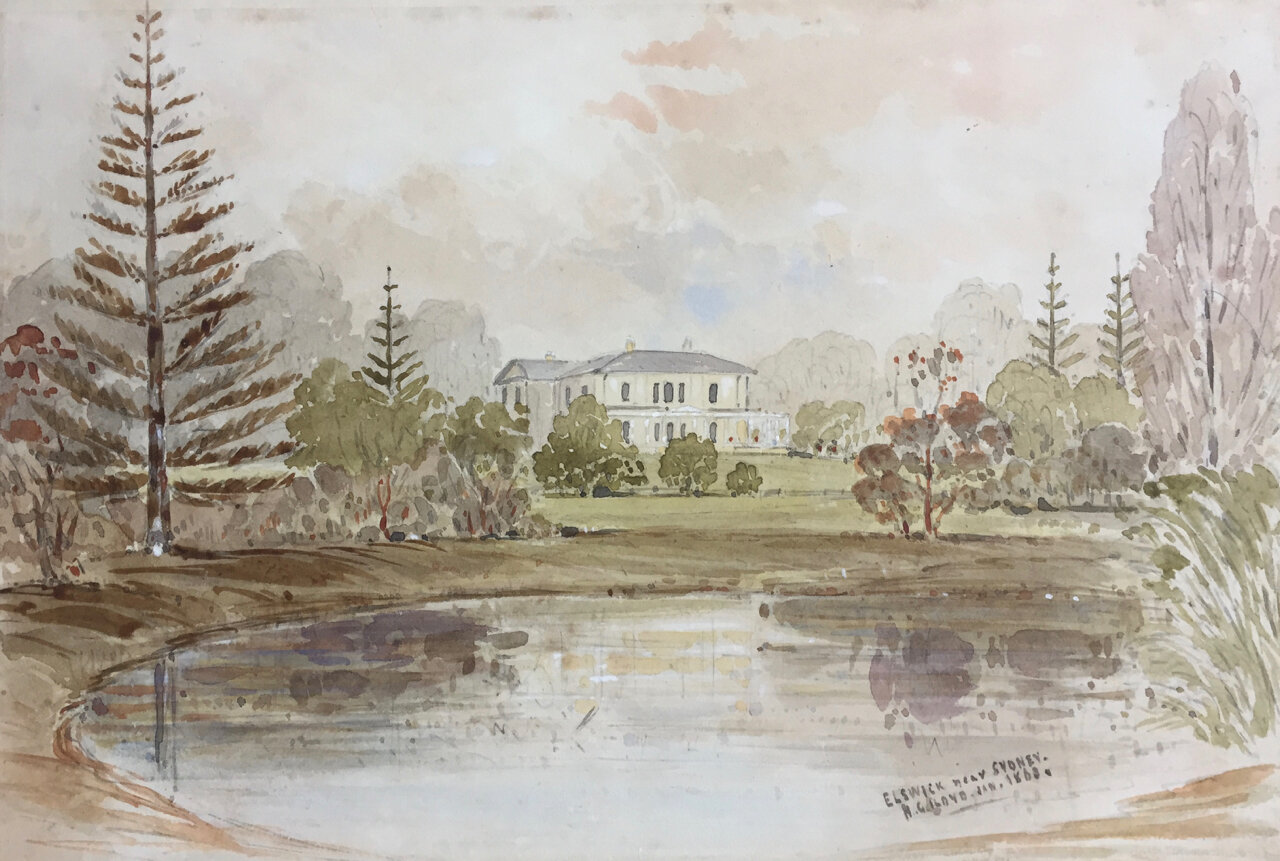
'Elswick House' Leichhardt, in January 1863, by Henry Lloyd Grant, courtesy State Library of NSW
In 1880 John Wetherill sold 'Elswick', to according to the Liechardt Historical Journal (no. 21), to the Excelsior Building Society, which reads very 'Octavia Hill' inspired. The Historical society states:
''John Wetherill, had sold his Elswick House estate of 52 acres to a group of speculators, who formed the Excelsior Land Investment & Building Company to subdivide and sell the estate. Among the directors were the Mayor of Glebe, William Cary, the temperance advocate, John Roseby, MLA, the architect, Ambrose Thornley junior, and George Renwick, political supporter of Henry Parkes. The company planned to manage the occupation of the subdivision in the way that had been proved at Annandale. Ambrose Thornley and his partner John Smedley were asked to build a range of one-storey cottages and two-storey villas in Norton and Renwick Streets to tempt the buyers.
Members may choose their allotments and a plan of building - the merchant his mansion, the mechanic his cottage - and if approved of by the Board, the Company will er~ct the building and place him m possession on payment of 19 per cent of the value of the property. The balance of the purchase money may be spread over a period of twelve years in the shape of rent.
The property was then subdivided, selling for £3-£8 per foot. In 1888 St Martha's Industrial Girls Home opened in Elswick House. Domestic skills were taught to poor and orphaned girls.
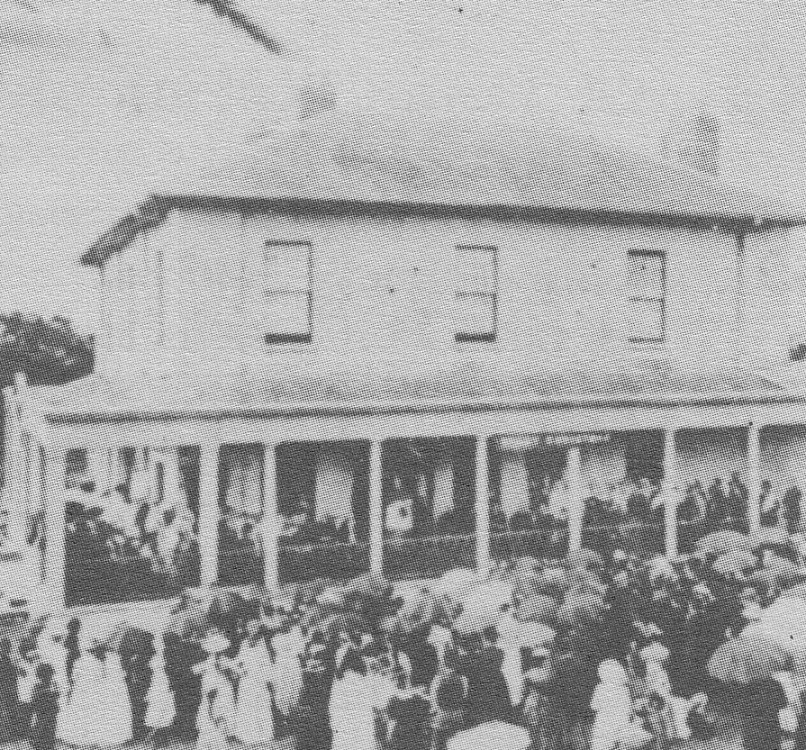
The opening of St Martha's Industrial Home, Leichhardt - copy of an image reproduced in K.E. Burford's Unfurrowed Fields, image is dated 1890.
Leichhardt began its existence as a number of land grants. In particular two brothers Hugh and John Piper had a number of large grants between them. Hugh Piper established "Piperston". This estate was bought in 1846 by Walter Beames who was a friend of Ludwig Leichhardt. Beames assisted Leichhardt with provisions for his explorations and he also changed the name of "Piperston" to Leichhardt after his friend. One of the largest estates in Leichhardt was the Elswick estate which was owned by James Norton, solicitor and MLC. This was eventually subdivided into hundreds of blocks of land. There were also dairies in Leichhardt but these too, eventually fell victim to residential development. Leichhardt was incorporated as a municipality in December 1871. There is a Wetherill street in the suburb too, along with streets named for these early developers, such as Norton and the first Mayor, Walter Beames. Wetherill was the second Mayor.
King:
Narrabeen: named for the place
Robertson: possibly named for Sir John Robertson, KCMG (15 October 1816 – 8 May 1891) Premier of New South Wales on five occasions. Sir Robertson is best remembered for land reform and in particular the Robertson Land Acts of 1861, which sought to open up the selection of Crown land and break the monopoly of the squatters. Visit: Pittwater Reserves: The Green Ways; Mona Vale's Village Greens A Map Of The Historic Crown Lands Ethos Realised - Robertson was renowned as ''the most representative New South Wales colonist of the 1850s, moulded by his personal and perceptive experience of the main forces that had shaped colonial society and politics: the competing claims of convict and non-convict elements, as moderated by the role of the native-born; the complex movement for representative government; and the demands of the squatters for security of tenure with the help of the British government and at the expense of the majority of colonists. No other politician had such sympathetic insight into the texture and subtleties of the radical needs of the times: some belonged to the past order of social snobbery and imperial control, such as (Sir) Stuart Donaldson, (Sir) Edward Deas Thomson, and (Sir) Henry Watson Parker; others were hindered in their understanding by their family connexions, such as Cowper; or by their English formation, such as (Sir) Henry Parkes; or by their social ambitions, such as (Sir) James Martin. Only Wentworth might have rivalled Robertson, but his day was over, his radicalism dimmed by age and wealth. Above all, none, with the minor exception of William Forster, had anything like Robertson's familiarity with the Australian outback, and land dominated the politics of the late 1850s and remained a major question for the rest of the century. But if he led enlightened social and political opinion he was not acceptable to polite society. By 1850 his peculiar voice gave authority to a comprehensive repertoire of profanity and he had an enviable capacity to take and hold his liquor; his bushman's clothes were crumpled by constant riding; but he was handsome, with reddish-brown hair and beard, sparkling blue eyes'' of His Land Act; ''Some historians have seen Robertson's great land reforms as necessary for the triumph of the 'middle classes', including owners of freehold land and urban liberals, over the squatters, with no sincere intention of concentrated land settlement. But colonial society did not lend itself to this over-simplification. Many urban residents, of diverse occupations and financial and political interests, were squatters; many rural residents were neither freeholders nor squatters, and many were liberals. Robertson himself reflected the social and political complexity: he was a country freeholder, but held squatting leases and leased land to tenant farmers, and he was the most radical of the liberals. He certainly saw his gruelling campaign as an honest and balanced attempt to compose the long-standing land problem for the benefit of all colonists, not least the landless country people. He was the great apostle of social equilibrium through land justice and he tapped city and country resentment, built up over a generation, to become one of the great land reformers of the nineteenth century: a result of his individuality and integrated colonial formation. Only he could have responded to the deeply-rooted levelling cry for easy access to land for all who wanted it, and he saw in agriculture a dual opportunity for land settlement and economic differentiation. Virtually none of his parliamentary supporters understood the complexities of his proposals; all of them were dragged along by the force of his personality and his relentless energy to accept the propositions that unsurveyed land could now be selected and bought freehold in 320-acre (130 ha) lots at £1 per acre, on a deposit of 5s. per acre, the balance to be paid within three years, an interest-free loan of three-quarters of the price; and that wealthy people would find it hard to speculate because bona fide residence was stipulated. He had formulated the greatest social theme in nineteenth century Australian history.'' - Bede Nairn, 'Robertson, Sir John (1816–1891)', Australian Dictionary of Biography, National Centre of Biography, Australian National University. 1976.
Devitt: possibly named for Edward O'Donnell M'Devitt (1845-1898), barrister and politician, at one time Attorney-General of Queensland, appointed one of three Queensland commissioners to the Paris Exhibition in 1878, settled in Dublin to practise in land cases and after the Land Act was passed in 1881 published two technical pamphlets explaining it. In 1864-65 M'Devitt was active in the campaign against secular education and in 1866-67 practised in Sydney. He died on February 4th, 1909 while riding a bicycle in Malvern, Victoria, during a heatwave.
Goodwin: possibly named, in keeping with the 'Wellington' and 'Waterloo' themes, for the naval Battle of Goodwin Sands (also known as the Battle of Dover), fought on 19 May 1652 (29 May 1652 Gregorian calendar),[a] was the first engagement of the First Anglo-Dutch War between the navies of the Commonwealth of England and the United Provinces of the Netherlands. The English Parliament had passed the first of the Navigation Acts in October 1651, aimed at hampering the shipping of the highly trade-dependent Dutch. Agitation among the Dutch merchants had been further increased by George Ayscue's capture in early 1652 of 27 Dutch ships trading with the royalist colony of Barbados in contravention of an embargo. Both sides had begun to prepare for war, but conflict might have been delayed if not for an unfortunate encounter on 29 May 1652 (19 May in the Julian calendar then in use in England) near the Straits of Dover between a Dutch convoy escorted by 40 ships under Lieutenant-Admiral Maarten Tromp and an English fleet of 25 ships under General-at-Sea Robert Blake. An ordinance of Cromwell required all foreign fleets in the North Sea or the Channel to dip their flag in salute, but when Tromp did not comply because he saw no reason to lower his flag for the English, Blake fired three warning shots. When the third hit his ship, wounding some sailors, Tromp replied with a warning broadside from his flagship Brederode. Blake then fired a broadside in anger and a five-hour battle ensued. Both fleets were damaged, but as darkness fell the Dutch fleet withdrew in a defensive line to protect the convoy, and the English captured two Dutch stragglers: Sint Laurens, which was taken back by them but not used, and Sint Maria, which was abandoned in a sinking condition and later made its way to the Netherlands. Tromp then offered his excuses to Blake and asked for the return of the prize, but this was refused by Blake. War was declared by the Commonwealth on 10 July 1652.
Also possibly named, in keeping with John Wetherill's support of all those who did well in life and public office and his involvement with lands, for Thomas Henry Hall Goodwin (11 December 1848 – 1 July 1921) Australian politician. He was born at Scone to medical practitioner John Goodwin and Elizabeth Russell. He worked as a pastoralist and surveyor, and was involved in the discovery and settlement of Broken Hill with William Jamieson selected the site of the town and made investments there. Owned Booloocooroo Station, Curlewis. In 1887 he was elected to the New South Wales Legislative Assembly as the Protectionist member for Gunnedah, but he resigned in 1888. Sat on Crown Lands Purchases Validation Bill Committee No.9; 28 Sep 1887 23 May 1888, 7 months 26 days. He returned to the Assembly in 1895, winning re-election in 1898 before retiring for good in 1901. He died in Sydney in 1921. The Late Mr. T.H. H. Goodwin AN OLD SCONEITE. The very large and representative attendance at the funeral of the late Ijr. Thomas Henry Hall Goodwin, in spite of the difficult conditions of travel was a testimony to the regard in which he was held by a very large circle of friends and the public in general (says the 'Gunnedah Advertiser and Independent* ') The deceased, who was 73 years of age, was born at Scone, where his father, Dr. Goodwin, was practising his profession. Mr. Goodwin as a youth came into this district with an elder brother and often spoke of the great change in the aspect of the country since he first saw it. He afterwards became a surveyor, and in the days of free selection never spared himself in his efforts to secure holdings for selectors, a fact which stood him in good stead when he afterwards sought election to Parliament. After being in Parliament for a short period- he resigned and went into the survey department, being appointed to Silverton district. 'While there the Broken Hill mining boom came along, and it became part of his duty to survey what is now the city of Broken Hill. It was due to his recommendations that the streets of Broken Hill now have names associated with the mining Industry, instead of the names of then prominent politicians. Mr. Goodwin's first suggestion was that the streets should be numbered according to the American practise, but he suggested as an alternative metaliferous - names, and the latter suggestion .was adopted by the Department'. While in Broken Hill he was a successful mining Investor, and returning to this district he purchased Hartfell Station which was afterwards known as Booloocooroo. A few years ago he sold the Booloocooroo portion and retained; the Ruvigne portion, on which he resided until his death.' While residing there-he was again elected to the State Parliament prior to Federation on the retirement of the late Mr. E., W . Turner, and sat for two Parliaments. He could not be regarded as a prominent politician, and losing sympathy with party politics as they presented themselves to him he retired from Parliament, Mr. D. R. Hall being elected In his place, but as a Labor man. Mr. Goodwin often spoke to the writer of his reason for retiring from Parliament, a reason that was creditable' to himself, if it reflected on the Apolitical methods of the party with which he had been associated. He was a man whose word was as good as his bond; quite fearless in the expression of his views. A man of strong character, his faults were the excess of his good qualities, for once having made up his mind rightly or wrongly, he was very determined In the stand he took. As a employer of labor at a time when wages were not so high as they are now, he was always regarded as a-generous employer and the loyalty and good feeling towards him of those who had worked for him was well known. He leaves a widow and a family of two sons asd three daughters, for whom, together with his widowed sister, Mrs. Russell, the greatest sympathy is oxpressed in their tragic bereavement. We understand an inquest will be held Into the circumstances surrounding Mr. Goodwin's death. The Late Mr. T.H.H. Goodwin (1921, July 8). The Scone Advocate (NSW : 1887 - 1954), p. 5. Retrieved from http://nla.gov.au/nla.news-article157127330
Mactier: possibly named, in keeping with John Wetherill's love of history and historic battles, and being part of what was happening while he was growing tall, for Brigadier W. Mactier’s Brigade under Field Marshal Hugh Gough, 1st Viscount Gough, KP, GCB, GCSI, PC (3 November 1779 – 2 March 1869) - a British Army officer, during the 1st Sikh War, also called the First Anglo-Sikh War or the Sutlej Campaign (1845-1846). After the death of Ranjit Singh in 1839, there was a period of internal strife as the succession to Sikh leadership was contested. Sikh forces were increased as were those of the British in the newly acquired territory adjoining the Punjab. Tension built up with demand and counter-demand until the British moved forces toward Firozpur and the Sikh Khalsa crossed the Sutlej. Four major actions were fought and all were won by the British. Large areas of territory were ceded to the British and a British Resident placed in Lahore effectively controlled the Sikh government. From THE VICTORIES OF WELLINGTON AND THE BRITISH ARMIES ; “The army was in a state of great exhaustion, principally from the want of water, which was not procurable on the road, when about three P. M., information was received that the Sikh army was advancing; and the troops had scarcely time to get under arms and move to their positions, when that fact was ascertained. “I immediately,” says Lord Gough, “pushed forward the horse artillery and cavalry, directing the infantry, accompanied by the field batteries, to move forward in support. We had not proceeded beyond two miles, when we found the enemy in position. They were said to consist of from 15,000 to 20,000 infantry, about the same force of cavalry, and forty guns. They evidently had either just taken up this position, or were advancing in order of battle against us. “To resist their attack, and to cover the formation of the infantry, I advanced the cavalry under Brigadiers White, Gough, and Mactier, rapidly to the front, in columns of squadrons, and occupied the plain. They were speedily followed by the five troops of horse artillery, under Brigadier Brooke, who took up a forward position, having the cavalry then on his flanks. “The country is a dead flat, covered at short intervals with a low, but in some places, thick jhow jungle and dotted with sandy hillocks. The enemy screened their infantry and artillery behind this jungle and such undulations as the ground afforded; and, whilst our twelve battalions formed from echellon of brigade into line, opened a very severe cannonade upon our advancing troops, which was vigorously replied to by the battery of horse artillery under Brigadier Brooke, which was soon joined by the two light field batteries. The rapid and well-directed fire of our artillery appeared soon to paralyze that of the enemy; and, as it was necessary to complete our infantry dispositions without advancing the artillery too near to the jungle, I directed the cavalry under Brigadiers White and Gough to make a flank movement on the enemy’s left, with a view of threatening and turning that flank, if possible. With praiseworthy gallantry, the 3rd light dragoons, with the 2nd brigade of cavalry, consisting of the body-guard and fifth light cavalry, with a portion of the 4th lancers, turned the left of the Sikh army, and, sweeping along the whole rear of its infantry and guns, silenced for a time the latter, and put their numerous cavalry to flight. Whilst this movement was taking place on the enemy’s left, I directed the remainder of the 4th lancers, the 9th irregular cavalry, under Brigadier Mactier, with a light field battery, to threaten their right. This manœuvre was also successful. Had not the infantry and guns of the enemy been screened by the jungle, these brilliant charges of the cavalry would have been productive of greater effect. “When the infantry advanced to the attack. Brigadier Brooke rapidly pushed on his horse artillery close to the jungle, and the cannonade was resumed on both sides. The infantry, under Major-Generals Sir Harry Smith, Gilbert, and Sir John M’Caskill, attacked in echellon of lines the enemy’s infantry, almost invisible amongst the wood and the approaching darkness of night. The opposition of the enemy was such as might have been expected from troops who had every thing at stake, and who had long vaunted of being irresistible. Their ample and extended line, from their great superiority of numbers, far outflanked ours; but this was counteracted by the flank movements of our cavalry. The attack of the infantry now commenced; and the roll of fire from this powerful arm soon convinced the Sikh army that they had met with a foe they little expected; and their whole force was driven from position after position with great slaughter, and the loss of seventeen pieces of artillery, some of them of heavy calibre; our infantry using that never-failing weapon, the bayonet, whenever the enemy stood. Night only saved them from worse disaster, for this stout conflict was maintained during an hour and a half of dim starlight, amidst a cloud of dust from the sandy plain, which yet more obscured every object. “I regret to say, this gallant and successful attack was attended with considerable loss; the force bivouacked upon the field for some hours, and only returned to its encampment after ascertaining that it had no enemy before it, and that night prevented the possibility of a regular advance in pursuit.” In this brilliant and sanguinary battle, the British loss was necessarily heavy. Sir Robert Sale, and Sir John M’Caskill were killed—and Brigadiers Bolton and Mactier, with Colonels Byrne and Bunbury, wounded. The total casualties amounted to 872 of all arms. Also reported here in: India. (1846, March 28). Morning Chronicle (Sydney, NSW : 1843 - 1846), p. 3. Retrieved from http://nla.gov.au/nla.news-article31747667 Also noted in The London Gazette: Downing-Street, April 3, 1846- Her Majesty has also been pleased to appoint the under-mentioned Officers in the Service of the East India Company; viz; Brevet Lieutenant Colonel William Mactier, 4th; Bengal Light Cavalry. William Mactier (16th of July 1793 - 16th of September 1855) - Scottish. Son of Alexander Mactier and his wife Rosanna. Brother of Anthony Mactier, Head Commissioner, Court of Bequests, Bengal and of Durris House, co. Kincardine. Married Miss Harriet Armstrong in Muttra, 10.06.1821. Full Epitaph on gravetsone: Sacred/ To the memory of/ Lieut Col WILLIAM MACTIER/ of the Bengal Light Cavalry/ Colonel of the Indian Army/ Companion of the Order of the Bath/ Who died at Indore/ 16 September 1855/ Aged 62 years/ His mortal remains were brought down to Calcutta/ And interred 9 April 1856. Occupation: Officer of the British Army (Lieut. Col.), Deputy Judge Advocate General, Member of the Military Board. Brevet Colonel CB, Second Light Cavalry Brigadier Commanding Benares Division. Attained the ranks of Cadet (1809), Cornet (28.03.1810), Lieutenant (1.09.1818), Captain (1.05.1824), Major (13.01.1842), Lieutenant Colonel (2.02.1851), Brevet Colonel (20.06.1854). Attended Barasat Cadet College for eight and a half months; admitted to the military 17.11.1810; Cadet in 4th Northern Command 1811; Cornet in 4th Northern Command 1813; took leave for six months to sea (with sick certificate) in July 1817; Third Mahratta War 1813 as Cornet in 4th Northern Command; Interpreter and Quartermaster in 4th Light Cavalry 10.04.1819 till 29.06.1824; operations in Kotah 1821; Mangrol (?w); Lieutenant 4th Light Cavalry leave (urgent private affairs) to Calcutta 19.04 till 14.12.1822; leave (sick certificate) 12 months to New South Wales 3.05.1823 till 16.04.1826; furlough (sick certificate) 4.06.1826 till 14.05.1831. Was active in Shekhawat expedition 1834 as Captain in 4th Light Cavalry. Acted as Officiating Deputy Judge Advocate General in Sirhind Division (23.02.1838), D.J.A.G. for Dinapore and Benares 6.03.1839, and for Presidency Division 25.06.1839 till 21.12.1842. In the Gwalior campaign of 1843, he served as Major commanding the 4th Light Cavalry (Lancers) under Brig. Scott CB. He was active in the Battle of Maharajpur (29.12.1843) which was reported in the London Gazette of 8th March and 30th April 1844. For his feats in this battle he won the Bronze Star. He then served as Brigadier in the First Sikh War, leading the 3rd Cavalry in the Battle of Mudki (18.12.1845) in Maj. Gen. Sir Joseph Thackwell's Cavalry Division. The cavalry, under Brigadiers White, Gough, and Mactier, played a crucial role in this battle, advancing to the front in columns of squadrons and occupying the plains to allow the passage of five troops of horse artillery under Brigadier Brooke. Mactier was severely wounded. In the Battle of Ferozeshah he was Brevet Lieut. Col. commanding the 4th Light Cavalry, and won a "medal with clasp" for his services. He was officiating Member of the Military Board from 1849-50 and stipendiary M.M.B. from 8.11.1850. Posted as Lieut. Col. to 1st Light Cavalry December 1851; to 2nd Light Cavalry November 1852; Brigadier 2nd Class in Delhi 22.09.1854 and in Benaras January 1855 until his death. CB 3.04.1846. His grave seems to be in need of repair and the tablet is supposed to have been moved to South Park Street Cemetery. A plaque dedicated to his memory can be found in St. Andrew's Church, Calcutta. The image of the latter is displayed here. Source: V. C. P. Hodson, List of the Officers of the Bengal Army 1758-1834 Vol. 3, p. 202-203
Clarke: There was an early Land Grantee with the surname of 'Clarke' worth noting, although confirming exactly which 'Clarke' is referred to here, without access to any Wetherill notes/journals, is circumspect. Worth noting is, in view of his honouring in street names the earlier land grantees here, is John Clarke - one of the original grantees [notes under 'Extras'] - although his grant was further north and closer to the lagoon. Other options are:
Possibly named for Sir Alured Clarke GCB (24 November 1744 – 16 September 1832) a British army officer. He took charge of all British troops in Georgia in May 1780 and was then deployed to Philadelphia to supervise the evacuation of British prisoners of war at the closing stages of the American Revolutionary War. He went on to be Governor of Jamaica and then lieutenant-governor of Lower Canada in which role he had responsibility for implementing the Constitutional Act 1791. He was then sent to India where he became Commander-in-Chief of the Madras Army, then briefly Governor-General of India and finally Commander-in-Chief of India during the Fourth Anglo-Mysore War.
Also possibly named, in view of John Wetherill's love of etchings depicting historical events and a passion for the Life of the Duke of Wellington for Francis L. Clarke author of The life of the most noble Arthur Marquis and Earl of Wellington : with copious details and delineations, historical, political and military ... by Francis L. Clarke ; Arthur Wellesley Wellington Duke of, 1769-1852. Published in London : J. and J. Cundee, 1813. [With Etchings]
Also possibly named for a City Surveyor or a few politicians of then, although Francis; Francis, Henry, Thomas and William Clarke. Those most well-known for associations with land or 'uprightness'.
HENRY CLARKE. A fine old figure in the public life of this State has disappeared in the death of Mr. Henry Clarke, for many years the legislative choice of the Bega district. Long before ''is retirement, three years ago, Mr. Clarke was the acknowledged 'Father of the Legislative Assembly' ; but he had put in a much higher claim to public respect. As a party man, whether in office or in opposition, he was loyal to his political principles in the broadest sense, and to his party in every sense. His unselfishness in the latter respect amounted almost to quixotism. When the Bega electorate returned two men, he and the late James Garvan were colleagues in presentation. On the advent of the single-member electorate system, Mr. Clarke, with a chivalry rare in politics, chose to contest the more difficult division, with the result that both colleagues were defeated. But politics were not Mr. Clarke's whole world. In Sussex-street, as in Macquarie-street, he was a well-known figure, and the name of Henry Clarke stood in commercial circles for a probity as perfect as that which it meant an the rough-and-tumble of parliamentary life. It also stood for a sweetness and tolerance in his ordinary relations with men worthy of general emulation. Up to a few weeks ago this fine old Ulsterman carried his 85 years with a figure as erect as a pike-staff. The straightness extended to his whole personality.' HENRY CLARKE. (1907, November 28). Freeman's Journal (Sydney, NSW : 1850 - 1932), p. 21. Retrieved from http://nla.gov.au/nla.news-article108037887
Henry Clarke (1822-1907), merchant and politician, was born on 22 June 1822 in Maghera, Londonderry, Ireland, son of William Clarke, cotton-printer, and his wife, née Johnston. He was educated in Maghera. To improve his position he emigrated and reached New South Wales in September 1841. Unable to find urban work he went to Broulee (Moruya) on the South Coast, where he ran a farm. He found produce hard to export and 'the blacks pretty bad'. In 1845 he returned to Sydney and set up as a produce agent. In 1847 he married Jane Rayner; they had six sons and five daughters. In 1848 Clarke started a shipping agency in partnership with Robert Gee. In the gold rush of the early 1850s they had three ships running to Melbourne. By 1861 Clarke had 'amassed a fair fortune', and took his family to Ireland for a year. They returned in the George Marshall, which struck a reef in Bass Strait. The captain beached the ship on Flinders Island, went to Launceston in an open boat and sent a steamer to rescue the passengers who were living in tents with sealers and mutton-bird hunters. After the family reached Sydney Clarke took up Bergalia station near Moruya. In 1865 he returned to Sydney for his children's education and resumed his produce agency, Clarke & Co., in Sussex Street. He remained in business until 1894 when he handed it over to his son. He was a justice of the peace for forty-five years, and a trustee of the Savings Bank. Clarke first tried to enter parliament in 1860 when he contested Eden; believing survey should precede selection he was opposed to John Robertson's land reform and lost to Daniel Egan. Clarke did not nominate again until 1869, when he defeated Egan. Clarke was an exemplary parliamentarian: he was usually present at divisions, created no disorder and preferred work to talk. He was a protectionist and well fitted to care for his constituents, who returned him, often unopposed, until 1904, except in 1894 when he lost his seat to a free trader for a year. In his thirty-four years in the Legislative Assembly Clarke introduced only one bill which became the Illawarra Steam Navigation Act of 1887. Clarke twice refused office but served as postmaster-general in the short Dibbs ministry of 1889. In the assembly he 'commanded the respect of all parties, and although he had not powers of oratory he was listened to with attention'. In his last years Clarke was known as 'father of the House': he was its oldest member and had sat far longer than anyone else. Predeceased by his wife he died after a stroke on 22 November 1907 at his home in Randwick; although Presbyterian he was buried in the Anglican section of the Long Bay cemetery. His boyhood hopes had been fulfilled: he had not only improved his position by emigrating, but had served his country well.
Or Francis Clarke - city Surveyor:
Letter: November 20, 1854: Francis Clarke, former City Surveyor, answering a Commissioners' letter of 20th inst. says ays he has never heard of any public fees in the City Surveyor's Office for giving Levels and in consequence can have neither demanded nor received any. However, he has always supplied private applications as Mr Rae well knows and was not aware that the Office was opposed to it- even had he been officially appointed as proposed from 1st January last. From City of Sydney (Council) archives.
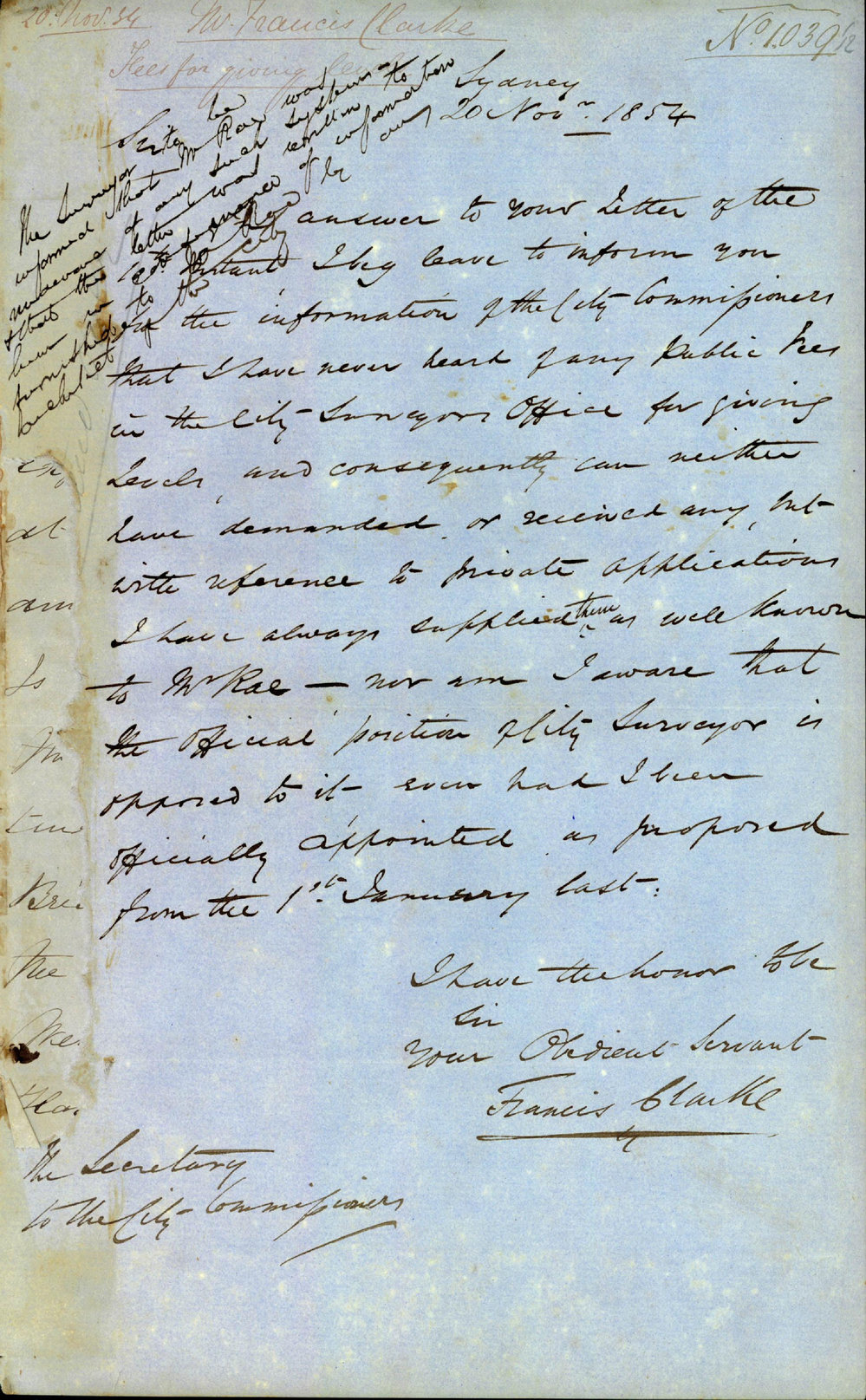
Francis Clarke (1857 - 1939) - Place of Death: Manly, New South Wales - Mayor of North Sydney in 1898 Surveyor. Educated at St Stanislaus' College at Bathurst. Was a surveyor when he was elected to the Legislative Assembly. Between 1883 and 1930, was a licensed, practising surveyor. He lived for some time at West Kempsey in New South Wales, moving to North Sydney around 1893. Membership of other Parliaments & Offices Held : Member of the Parliament of the Commonwealth of Australia. Member of the House of Representatives for Cowper 1901 - 1903. Personal; Son of Thomas, a farmer, and Ellen, nee Welsh, Irish immigrants. Married Mary McCarthy on 21 October 1885 and had issue, 3 sons and 3 daughters. Roman Catholic. Date of Birth: 25/03/1857. MARRIAGES. CLARK — McCARTHY. — October 21, 1885, by special license, at St. Patrick's, Sydney, by the Very Rev. Dean Hanly, assisted by the Rev. P. Le Rennetel, S.M., and Very Rev. J. Dalton, S.J., Francis, youngest son of the late Thomas Clark, Esq., of Sherwood, Macleay River, to Mary (May), only daughter of James McCarthy, Esq., of Kelverdale, Dawes Point, Sydney. Family Notices (1885, November 14). Freeman's Journal (Sydney, NSW : 1850 - 1932), p. 10. Retrieved from http://nla.gov.au/nla.news-article115464652 Former M.P's. Death. MR. FRANCIS CLARKE NATIVE OF STROUD. Mr. Francis Clarke, who held a seat in the first Federal Parliament, died at his home at Manly on Tuesday, after a brief illness. He was 82. Born at Stroud on March 25, 1857, Mr. Clarke was educated at St. Stanislaus' College, Bathurst. He was elected to the New South Wales Legislative Assembly for the Macleay (later the Hastings and the Macleay) in 1893, but he resigned in 1898 to provide a seat for Mr. Edmund Barton, afterwards Sir Edmund Barton, who in those pre-Federal days was needed in Parliament to assist the passage of the Enabling Bill. Mr. Clarke was one of Mr. G. H. Reid's appointees to the Legislative Council in 1899. He resigned the next year to successfully contest the Cowper Federal seat, which he held only until the following election. In the early days of the Commonwealth he served on two Royal Commissions. He was a member of the Royal Commission which inquired into the tariff in 1904-7, and he was chairman of a Commission which investigated the ports and railways possibilities of the Northern Territory in 1913, with a view to its early development. The Commission's report was never implemented. Mr. Clarke, who passed the examination for licensed surveyors in 1883, carried on his profession until 1930. In 1898, he was Mayor of North Sydney. He is survived by six children. The funeral left Manly on Wednesday for Gore Hill cemetery. It was preceded by Requiem Mass at Mary Immaculate Church, Manly. Former M.P's. Death (1939, April 21). Dungog Chronicle : Durham and Gloucester Advertiser (NSW : 1894 - 1954), p. 2. Retrieved from http://nla.gov.au/nla.news-article140925129
Wetherill: surname of John Wetherill
Stuart: possibly named for Sir Alexander Stuart, NSW politician from 1874 to 1885 and Premier of New South Wales from 5 January 1883 to 7 October 1885. See Alexander.
Ramsay: named for original land grantee.
Frazer: possibly named for John Frazer MLC, (1827-1884), merchant, company director and philanthropist, and business partner of John Sutherland, who was a business partner of John Wetherill. He arrived at Sydney as a bounty immigrant in the Margaret on 23 January 1842, with a brother and two sisters. He first went up country 'to learn something of squatting', on 'a very modest salary indeed', and then worked as a clerk in Sydney. In 1847 he opened his own wholesale grocery business and in 1853 he married Elizabeth, daughter of James Ewan. Her two sisters married William Manson and James Watson who with her brother James, became Frazer's closest friends and business partners. In 1858 he moved into larger premises in York Street and next year took Manson as a partner. By hard work, 'integrity, prudence and punctuality' Frazer made John Frazer & Co. into one of the most influential mercantile houses in Sydney. The York Street stores were burnt down in 1865 and rebuilt for £15,000 in massive stone and with modern fire-fighting equipment. From the mid-1860s Frazer speculated in land in Queensland and by 1871 had four runs of his own and eighteen in partnership. In Sydney he had built two large new stores, a bonded warehouse and the impressive Frazer House. He had also sold his home, Ranelagh at Darling Point, and about 1874 bought Quiraing at Edgecliff. His directorships included the Australian Joint Stock Bank, the Mutual Life Association of Australasia and the Sydney Exchange Co. in addition to three other insurance companies, a shipping line, an ironworks and several mining companies. Later he was also a director of the Commercial Banking Co. of Sydney and the Australian Gaslight Co. Apart from a brief return in 1878 to retain his seat in the Legislative Council, he stayed in England until 1880, although homesick for Sydney. He was a representative commissioner at the Melbourne International Exhibition, as he had been at the Paris Universal Exhibition in 1878. Frazer died aged 57 at Quiraing on 25 October 1884, survived by his wife, two sons and two daughters, and left a personal estate worth £405,000. His business success was matched by his philanthropy. He had assisted the Sabbath school at the Scots Church for years, wrote 'a hymn to the Creator' and became an elder of the Presbyterian Church, supporting it liberally in his lifetime and in his will. Long active in the Lord's Day Observance Society he left £2000 for an annual prize essay in 'Defence of the Christian Faith'. He served on numerous charitable committees, all of them benefiting under his will. Other gifts included £2500 for drinking fountains, one near Hyde Park and another in the Domain. With an insatiable appetite for culture and mental improvement he denied himself sleep in his youth for literature, history and philosophy. He also collected water colours on his travels and in 1875 he became a member of the Royal Society of New South Wales. In 1876 he joined the Council of St Andrew's College and became vice-president of the Young Men's Christian Association, giving it a library. In that year he also gave £2500 for two bursaries to enable 'poor lads from the bush' to go to the University of Sydney and, at a large farewell banquet in his honour, called for the foundation of a chair of history and conditionally gave £2000 for it. In 1890 his family donated this sum to the university where it was used to found the Frazer scholarship in history. - Martha Rutledge, 'Frazer, John (1827–1884)', Australian Dictionary of Biography, National Centre of Biography, Australian National University. 1972.
Jenkins: named for the Jenkins family and near the site of their Long Reef homestead and farm.
Fielding: possibly named for Theodore Henry Adolphus Fielding (1781 – 11 July 1851) an English painter, engraver, and author. In addition to his watercolours, Fielding also worked in stipple and aquatint, and published numerous sets of engravings in the latter technique, including illustrations to Excursion sur les côtes et dans les ports de Normandie, after Bonington and others; Cumberland, Westmoreland, and Lancashire Illustrated (44 plates, 1822); A Series of Views in the West Indies (1827); Ten Aquatint Coloured Engravings from a work containing 48 Subjects of Landscape Scenery, principally Views in or near Bath, painted by Benjamin Barker (1824); British Castles; or, a Compendious History of the Ancient Military Structures of Great Britain (1825); A Picturesque Tour of the River Wye, from its Source to its Junction with the Severn, from Drawings by Copley Fielding. Fielding published several works on the technical aspects of art: On Painting in Oil and Water-colours for Landscape or Portraits (1830); Index of Colours and Mixed Tints (1830); On the Theory of Painting (1836); Synopsis of Practical Perspective, lineal and aerial, with Remarks on Sketching from Nature (1829); The Knowledge and Restoration of Oil-paintings, the Modes of Judging between Copies and Originals, and a brief Life of the principal Masters in the different Schools of Painting (1847) and The Art of Engraving, with the various Modes of Operation (1844); this was mostly reprinted in Robert Hoe's edition of Joseph Maberly's Print Collector (1880). Among his works are a connection to John Wetherill's collection of Westhall engravings; ''Victories of the Duke of Wellington (Harley-Mason. Date of Publication: 1819). Among the purposes of this set of 12 plates of battle scenes from the Peninsular War and Waterloo was ‘to recal[l] the exultations which each triumph produced, by a representation of the decisive moment that occasioned it’. Westall’s drawings were engraved by Theodore Henry Fielding.''
_-_trimmed.jpg?timestamp=1609021392301)
Depiction of the Grosmont Castle in 1823, by Theodore Fielding
Collaroy: named for the steamer that was then adjacent to this street and on the beach.
Alexander: named for Sir Alexander Stuart, NSW politician from 1874 to 1885 and Premier of New South Wales from 5 January 1883 to 7 October 1885. Stuart succeeded in passing a land act in 1884 after much opposition( Crown Lands Act of 1884 - NSW legislation. XVIII. An Act to regulate the Alienation Occupation and Management of Crown Lands and for other purposes. [17th October, 1884].), and other acts dealt with the civil service, fire brigades, the university, and licensing.
Lagoon St: named for the Narrabeen lagoon.
Ocean St: named because it runs beside the ocean - would later be renamed as a section of the Pittwater Road and also retain 'Ocean Street' on its section to North Narrabeen on the ocean side.
This lithograph from the National Library of Australia appears to show which Sections and Lots sold first:
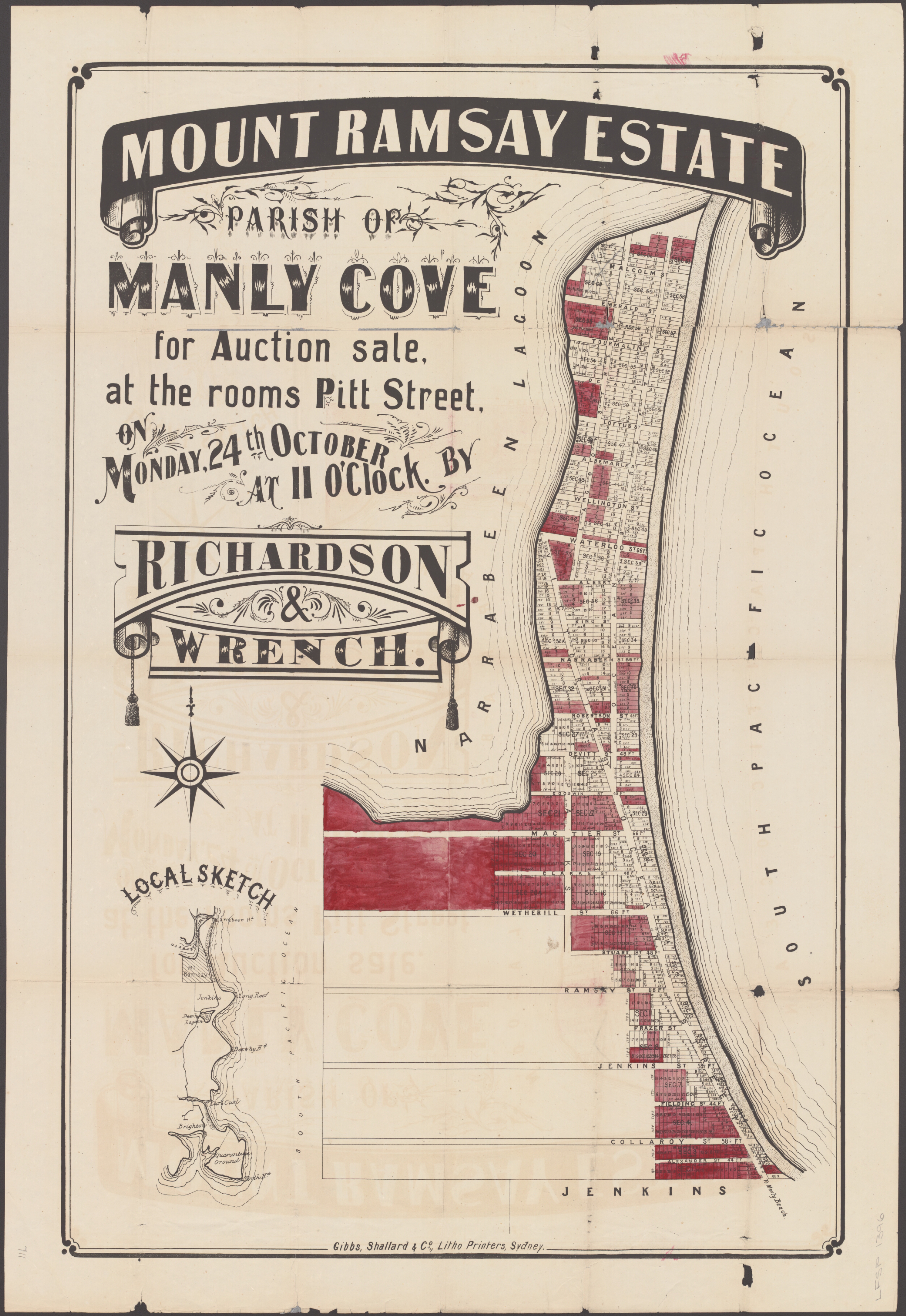
Richardson & Wrench & Gibbs, Shallard & Co. ([1881]). Mount Ramsay Estate, Parish of Manly Cove for auction sale at the rooms Pitt Street on Monday 24th October at 11 o'clock Retrieved from http://nla.gov.au/nla.obj-230276359
The Crown Land Acts 1884 (NSW), which commenced on January 1st, 1885, replaced the Sir John Robertson led Crown Lands Alienation Act of 1861 and Crown Lands Occupation Act of 1861, and created a new structure, introducing new tenures including grazing licences, homestead leases, conditional leases, pastoral leases and permits for wharves and jetties. This Act led to the division of land in NSW into eastern, central and western divisions. Local land boards were introduced in the three divisions in 1886, effectively decentralising Crown land administration. However the changes led to a rush to buy land under Robertson's old system in 1884.
In 1886 the lots on the Collaroy Plateau were advertised:
THE PLATEAU. THE PLATEAU.
MOUNT RAMSAY, NARRABEEN LAKES.
Many have been the inquiries respecting the time of the Sale of this beautiful Estate. FEBRUARY IS THE MONTH FIXED UPON. The lots will be sold privately, at nominal prices per lot, and the terms will be excessively liberal, WITHOUT INTEREST.
Thus all classes of the community will have an opportunity of securing an allotment for a summer residence in this most charming locality.
Narrabeen is fast becoming popular; It is the sporting ground of the colony, and must become a second Manly.
The rapidity with which it is progressing is told in a very few words. Three years ago allotments were sold UPON THE FLAT at from £5 to £10 per lot. Last week ONE Allotment was sold for £60. It will be just the same on THE PLATEAU ; allotments will be obtainable on and after MONDAY, the 1st February, from £5 per lot and upwards. Think what they will be worth in 12 months hence.
Lithographs now ready.
Arrangements have been made with Messrs. Black and Co., of Manly, to meet the 9 o'clock steamer from Sydney daily, and convoy intending buyers to and from the estate for the nominal charge of 1s 6d. Tickets for Mondny mornbig will be issued up to 1 o'clock to-day, at our office, 1s 6d return.
CAMPBELL, MITCHELL, and COMPANY,
The City Property Exchange, 418 George Street. Advertising (1886, January 30). The Sydney Morning Herald (NSW : 1842 - 1954), p. 6. Retrieved from http://nla.gov.au/nla.news-article28360280
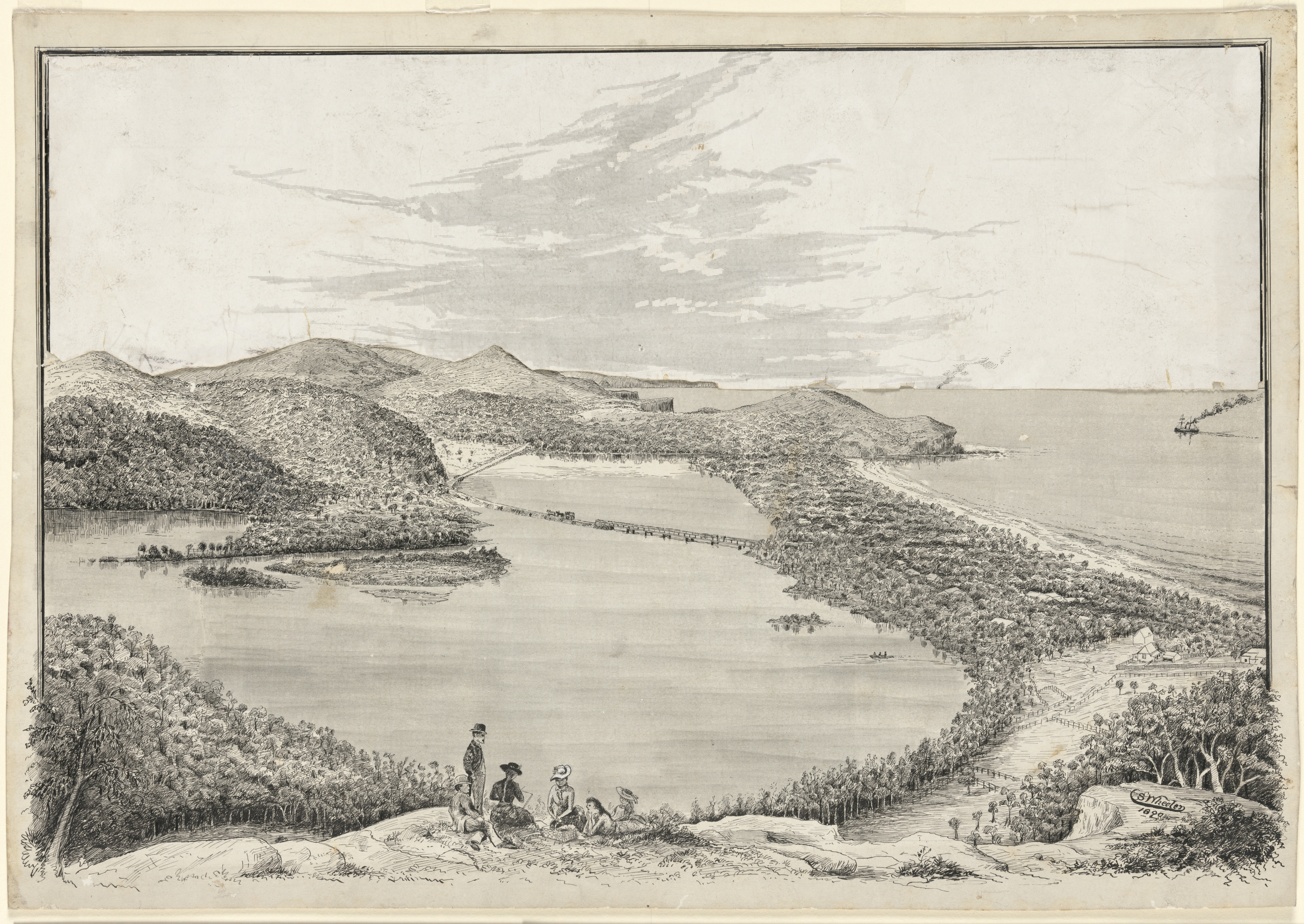
Narrabeen Lagoon, 1890/ C. S. Wheeler/Wheelan or S. Wheeler(note lady to left, dark hat, is actually drawing the view). Item: c11295_0001_c, courtesy Dixson Library, State Library of New South Wales
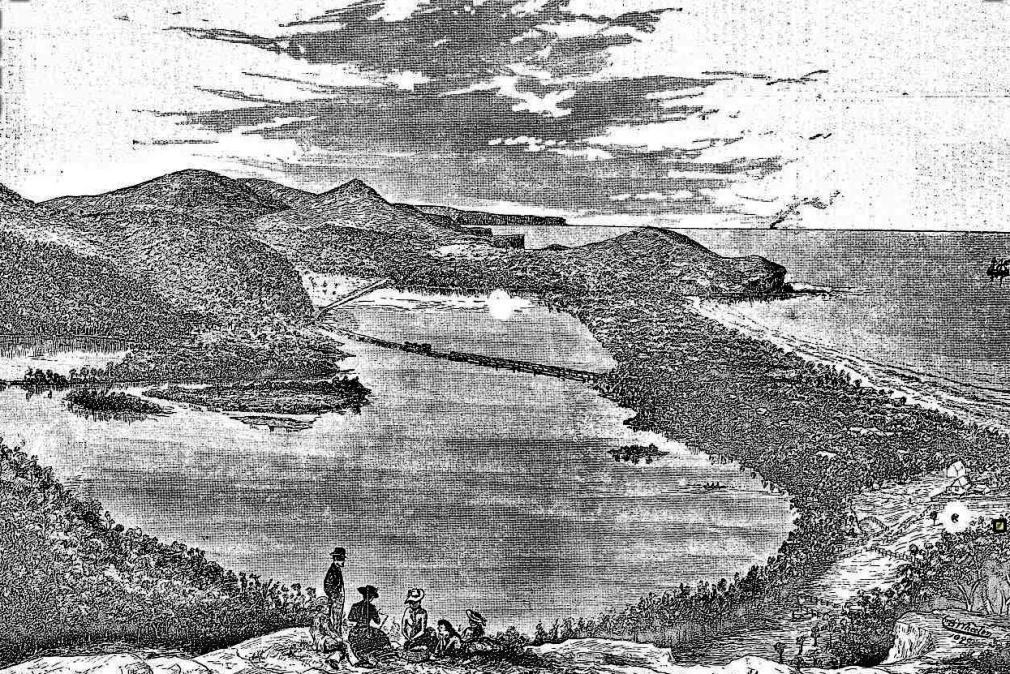
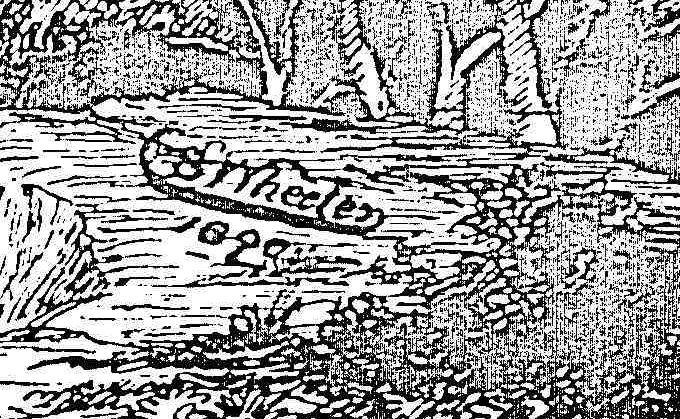
Some of those who purchased land during this 1881 subdivision and in the years that followed including were:
Mount Ramsay Estate subdivision, near Narrabeen, L88— Mr Obed West, sen, ; lot 8, section G, ... SALES OF PROPERTY. (1883, December 22). The Sydney Daily Telegraph (NSW : 1879 -1883), p. 7. Retrieved from http://nla.gov.au/nla.news-article239272826
Mount Ramsay estate subdivision, Narrabeen, section 48, lots 2 to 8, £85 : section 11, lots 15, and 20, section 48, lot 1, £16— Mr W. A. Lipscombe ; section 8, lots 14, 16, and 10, £16— Mr W. H. Tibbitts. PROPERTY SALES. (1884, May 10). The Daily Telegraph (Sydney, NSW : 1883 - 1930), p. 2. Retrieved from http://nla.gov.au/nla.news-article237138983
lots 28, 27, and 28, section 8 ; and lots 9 to 11, section 12, of Mount Ramsay Estate subdivision, Narrabeen,L40— Mr George Wheeler ; ... PROPERTY SALES. (1884, June 28). The Daily Telegraph (Sydney, NSW : 1883 - 1930), p. 2. Retrieved from http://nla.gov.au/nla.news-article237136731
Messrs. Richardson and Wrench sold by auction and private contract, at their rooms, Pitt-street, during the week, the following properties : ...10 allotments of land, portion of Mount Ramsay Estate subdivision, Narrabeen, £200. PROPERTY SALES. (1884, July 5). The Sydney Morning Herald (NSW : 1842 - 1954), p. 9. Retrieved from http://nla.gov.au/nla.news-article13561688
lot 3, Sec 47 and lots 6 to 28 section 32a, of Mount Ramsay Estate subdivision, Narrabeen, £70-Mr John Davison ...PROPERTY SALES (1884, August 2). The Sydney Morning Herald (NSW : 1842 - 1954), p. 9. Retrieved from http://nla.gov.au/nla.news-article13571025
Among our sales since the departure of the last mail we notice the following .... 50 allotments of land, portion of Mount Ramsay Estate subdivision. Narrabeen, £250; PROPERTY CIRCULAR. (1884, July 23). The Sydney Morning Herald (NSW : 1842 - 1954), p. 12. Retrieved from http://nla.gov.au/nla.news-article28370678
sec. 60 of Mount Ramsay Estate subdivision, Narrabeen, £226-Mr. C, E. Fuller; PROPERTY SALES. (1884, November 15). The Sydney Morning Herald (NSW : 1842 - 1954), p. 15. Retrieved from http://nla.gov.au/nla.news-article13575025
lots 1 to 6, sec 16, of Mount Ramsay estate subdivision Narrabeen, £63-Mr S B Bailey ... PROPERTY SALES. (1886, January 16). The Sydney Morning Herald (NSW : 1842 - 1954), p. 15. Retrieved from http://nla.gov.au/nla.news-article13609220
Around the time his son Victor was born Cyrus Fuller obtained some of the larger sections of the Mount Ramsay estate, as did his relations. This first one would be him too, just with his initials reversed (typo?) - these sections were towards Narrabeen Lagoon and around where the present day Narrabeen hotel is:
Mount Ramsay Estate subdivision, Narrabeen, near Manly, section 36, lots 12 to 19; section 41, lots 9 to 11; section 44, lots 9 to 16; section 47, lot 3, £345 — Mr. E. C. Fuller; ... PROPERTY SALES. (1886, February 15). The Daily Telegraph (Sydney, NSW : 1883 - 1930), p. 7. Retrieved from http://nla.gov.au/nla.news-article237235612
Fuller's subdivision, Mount Ramsay Estate, Narrabeen, £50-Mr. George A. Moore. ... Miller's subdivision, Mount Ramsay Estate. Narrabeen, sec. 87, lots 3 to 10 and 12 to 15, £247 ; sec. 33, lots 1 and 6, with cottage thereon, £215-Mr. Oliver Osborne. PROPERTY SALES. (1886, May 15). The Sydney Morning Herald (NSW : 1842 - 1954), p. 16. Retrieved from http://nla.gov.au/nla.news-article13631015
Obeli's Subdivision, Mount Ramsay Estate, Narrabeen, section 37, lots 8 to 10 and 12 to 15, £247 ; section 88. lots 1 and 6, with cottage thereon, £215 — Mr. Oliver Osborne. PROPERTY SALES. (1886, May 15). The Daily Telegraph (Sydney, NSW : 1883 - 1930), p. 7. Retrieved from http://nla.gov.au/nla.news-article237300316
Fuller's Subdivision, Mount Ramsay Estate, Narrabeen, sec, 83, lots 2 and 7, £50 - Mr. William Ashley; sec. 33, lots 3 and 8, £50-Mr. Joseph Black ; sec. 33, lots 4 and 9, £30-Mrs. Martha F. Black; PROPERTY SALES. (1886, May 29). The Sydney Morning Herald (NSW : 1842 - 1954), p. 15. Retrieved from http://nla.gov.au/nla.news-article13632592
It should also be noted that those who had purchased lands around the Ingleside 'Narrabeen Powder Works', with that venture attracting visitors in August 1885, and then failed as 'Baron Von Bieran' fled the country, also sought to at first buy large tracts of land and then offload their acreage and that some sales listed for there may be mixed among those that were part of the Mount Ramsay estate. There also appear other advertisements for sale of acreage at Narrabeen and advise to apply for them under a variety of other land dealers/land agents - one of these later took one of the Macpherson clan members, from whom we get the name 'Wharriewood', to court to get payments due for acting as an agent - there is more on the Macphersons below, but it is worth noting among these larger land sales that big lots of acreage were already beginning to fetch higher prices:
PROPERTY SALES. Messrs Hardie and Gorman report the sale of the following properties by public auction and by private sale during the week: ... Large subdivision blok, between Manly and Narrabeen, £2250 PROPERTY SALES. (1885, January 24). The Sydney Morning Herald (NSW : 1842 - 1954), p. 11. Retrieved from http://nla.gov.au/nla.news-article13583412
A GRAND OPPORTUNITY.-100 ACRES, the pick of the foreshore of Narrabeen Lake, well adapted for sub-division, possesing some of the grandest views in Australia; price £5000. Apply W. DUNN, Punchbowl-road, Druitt Town. Advertising (1885, February 21). The Sydney Morning Herald (NSW : 1842 - 1954), p. 7. Retrieved from http://nla.gov.au/nla.news-article13577986
SUBDIVISION BLOCK-.
To Speculators, Building Societies, and others.
BOYD and KING are instructed by the owners to sell the following properties, suitable for immediate subdivsion:
NARRABEEN-350 acres, with water and main road frontage.
PITTWATER-Commanding 50 acres, with bold frontage to Broken Bay.
Particulars can be obtained at the Auctioneers' Rooms, 96, Pitt-street. Advertising (1886, January 13). The Sydney Morning Herald (NSW : 1842 - 1954), p. 15. Retrieved from http://nla.gov.au/nla.news-article13608940
NARRABEEN.-Quarter-acre Lots for £10, 10s deposit, 10s month, no interest; Torrens'. .... For Particulars and cards apply to HENRY M. DEAKIN, 126, Pitt Street. Advertising (1886, December 6). The Sydney Morning Herald (NSW : 1842 - 1954), p. 11. Retrieved from http://nla.gov.au/nla.news-article13622226
The lots continued to be advertised under Richardson and Wrench as well - with 300 allotments of the original 925 still available:
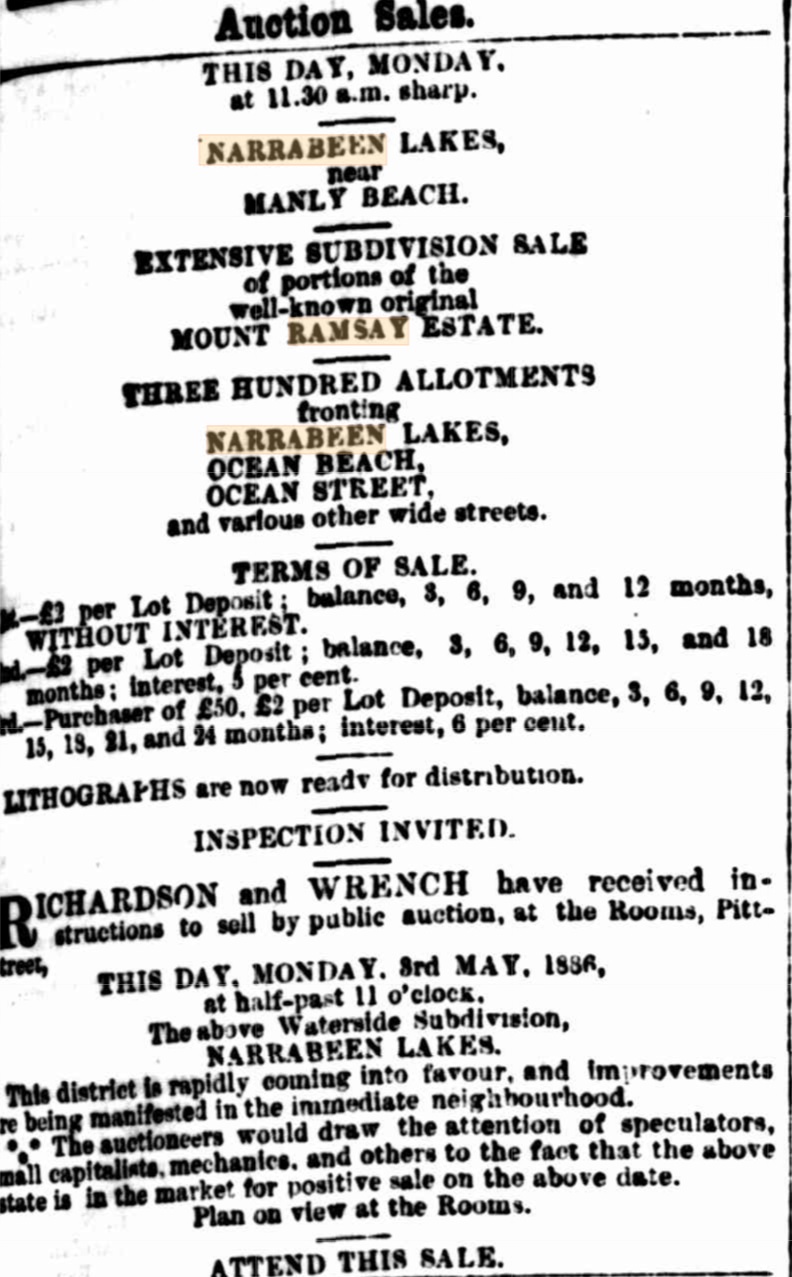
Advertising (1886, May 3). The Sydney Morning Herald (NSW : 1842 - 1954), p. 11. Retrieved from http://nla.gov.au/nla.news-article13641167
During the later 1880's and into the 1900's a Depression-Recession hit Australia. In 1889 property prices collapsed and many people lost everything. Some of the earliest roads or tracks built around Narrabeen were done so through a work relief scheme, first noted in Roads To Pittwater: The Pittwater Road, which Mr. Cyrus Fuller bore witness to:
THE UNEMPLOYED QUESTION.
TO THE EDITOR OF THE HERALD.
Sir,—Very frequently during the past year or two have correspondents to your columns had something to say on the above subject, and at various times have you dealt with the subject very ably in your leading articles. As the question of the " unemployed " is still unsettled and as the State is still burdened with providing food and, I was about to say, clothing, for such as seek the " relief works," a few words at this time may be opportune. The attitude which Sir Henry Parkes expresses as the right one for the State to take is emphatically the right one, from a State policy point of view, and with your permission I want to show that from a practical labour point of view it is also correct. During the past year or two I have had many opportunities of watching and making notes of the actual camp life of the unemployed engaged on the relief works at or near Narrabeen Lake, in the Manly Cove parish. I have lived a great part of the time within 20 minutes' walk of the ' main camp," have been many times through it, and had many conversations with the men. I lived near the Narrabeen Inn, and travelled very often between Manly and the camp. I have also carefully examined the manner in which the work has been carried out, and am thoroughly acquainted with most of the visible things transpiring, and I am sorry to say my knowledge thus practically acquired has led me to pronounce the utmost disapprobation of any continuance of this pernicious institution. As it may be interesting to some of your readers to know some of the facts and details which have thus influenced me, with your permission I will briefly note a few.
As is generally known, alternate Fridays were paydays, when each man drew according to the average earnings of his gang, some less, some more. Immediately upon the receipt of their money, from 75 per cent. of the men upwards made a general stampede from the camp—some towards Manly, some to Narrabeen, and some to the Rock Lily Hotel, near Pittwater, some few finding their way to Sydney. After that, from dark on the same evening up till early on Monday morning, scores of men in all stages of intoxication, from the funny to the beastly drunk stage, were to be met with from Manly nine miles outward, and it was positively dangerous to travel the road after nightfall. Many and many times have I narrowly escaped running over drunken bodies and drunken parties of men between Manly and Narrabeen, at night, and both their and my escapes can only be traced to my horse, which was spirited and skittish, jumping promptly from danger. These men were not staggering along the road, but lying across the very wheel-tracks, too drunk to get up or crawl off the road.
At Narrabeen I came more closely into contact with the habits of these men, for prior to my location in the neighbourhood numbers of them had been in the habit of sleeping off and bringing on their booziness from day to day and night to night under the shelter of the shady trees which surrounded the residence, and it was with great determination and continued effort that I taught them that they were trespassers—and trespassers of an insufferable class. As a further proof and evidence of my verdict, the path between the main camp and the Narrabeen-road led for a considerable distance through my lands, and the track for the whole distance was strewn with empty bottles— bottles white and bottles red, bottles green and bottles black, bottles big and bottles little, and these bottles had been drained of their contents in meandering back to the main camp. Here let me mention one little happy faculty all heavy imbibers appear to possess—that is, the ability to tie four pint bottles in a bundle handkerchief in such a manner as they will bear considerable knocking about. In a fashion peculiar to them they gathered the tops of the four bottles into the four loose folds of the handkerchief, and the knots acted as buffers. It was, seldom, how- ever, that the camp saw this compactness, as thirst on the way generally necessitated disturbing their order. The men who carried bottles were generally of the more provident class. They feared to stay at the " pub." to knock down their last few shillings, lest they should be too late at the camp for " Rations, O," which were served out at stated hours upon given days; hence they carried their store of grog, and thus conserved their fortnightly spree, and were home in time for supper. Apart from the beastliness of the sight of a number of drunken men lying promiscuously about, it was simply comical to note the manner in which each appeared to hug his black companion, even in sleep, the said black companion being a pint bottle containing the sleep-producing element. There is just one other mention I should like to make on the moral aspect of this subject, and that is that, while these men spent their fortnightly earnings, with a religious punctuality, at the grog shops, they just as religiously neglected to clothe their bodies decently; generally they were half bootless, and otherwise ragged and untidy. So much for the moral and social aspect of the question.
And now a word or two about the material State benefit they have accomplished. As a man trained and experienced in the labour question, I maintain that unless the benefit of the work carried out be speedily availed of it will be almost, if not entirely, lost to the State. Some of the land they have scrubbed, and other of it they are supposed to have cleared, or, in other words, rooted out rump and stump. From my knowledge of this class of scrub-bearing country, and from my observation of the manner in which the work was done, I positively assert that in less than three years a crop of suckers (already fast appearing) will re-clothe the thousands of acres gone over with a density of bush and brush tenfold that just consumed. The men worked by piece, and the greater area they covered the larger the money they drew ; hence quantity was more than quality, and to get over the ground was the main desideratum. Of practical workmen there were a few—say a fifth of the crowd—but these were handicapped by being linked in gangs with the off-scum of society-men, who knew not a mattock from a spade nor a shovel from a broad axe.
There are many other details of fact concerning the Narrabeen Camp I could give you ; but I trust the two principal ones abovementioned may influence some-body's mind—perhaps our practical barrister, Hon. Bruce Smith—and induce him to insist on an extinction of this obnoxious system—a system fraught with injury alike to the individuals for whose benefit it is intended, to the State which inaugurated it, and to the honest industrious colonists whose labours have to bear its burden. I am, &c.,
CYRUS E. FULLER.
P.S.—I ought to say that the roads formed through-out the district under consideration are splendidly and substantially made—such, indeed, as would be a credit to any town or city in Australia. They are likely to re-main good inasmuch as there is no likelihood of their being used for the next half-century.—C. E. F. THE UNEMPLOYED QUESTION. (1889, March 21). The Sydney Morning Herald (NSW : 1842 - 1954), p. 5. Retrieved from http://nla.gov.au/nla.news-article13718186
The 'camp' for the unemployed who did so much work around the Narrabeen area was, according to other newspaper reports, in a 'valley opposite Dee Why Lagoon'. Other reports details what was done and what was sold as a result of their works to create access to these plots of land:
At Narrabeen 822 acres have been cleared and underscrubbed, 10 miles 42 chains of road have been cleared, 3 miles 32 chains formed, 24½ chains of drainage have been cut, and one culvert is in course of construction. Tenders are being received for culverts, stonebreaking, and pipe culverts. 2500 acres of Crown lands will be available for sale here, and land is likely to realise high prices. THE WORK OF THE "UNEMPLOYED." (1887, November 11). The Sydney Morning Herald (NSW : 1842 - 1954), p. 5. Retrieved from http://nla.gov.au/nla.news-article13675663
Among the papers laid on the table of the Legislative Assembly yesterday was a return of works carried out under the control of the Casual Labour Board. It appears from this return that the "unemployed" did the following work since they were under the management of the board:—They cleared and under-scrubbed 31,706 acres; roads cleared, 358½ miles; roads cleared and formed, 222 miles ; roads cleared, formed, and made, 86¾ miles ; bridges, 26, side drains cut, 18 miles; culverts, 185.
Crown lands upon which these men had been employed had been sold as follows:—Berowra, 100 acres, for £600; Como, 100 acres, £2000; Heathcote, 203 acres, £8285; Dobroyd, 30 acres, £4500; Field of Mars, 697 acres. £70,000; Gordon, 430 acres, £34,000; Hornsby, 100 acres, £3856; Narrabeen, 1818 acres, £29,000 ; Rookwood, 79 acres, £9000.
There was still available for sale—At Peakhurst, 90 acres, valued at £55 per acre, total £5050; Rookwood, 613 acres, £150 an acre total £91,950 ; Garie, 200 acres, £50 an acre, total £10,000 ; Dobroyd, 50 acres, £150 an aura, total £7500; French's Forest, 10,000 acres, £50 an acre, total £500,000; Gordon, 4000 acres, £100 an acre, total £400,000; Hornsby, 2500 acres, £50 an acre, total £125,000; Holdsworthy, 10,500 acres, £15 an acre, total £157,500 ; Manly Cove parish, 10,000 acres, £80 an acre, total £300,000 ; Bankstown Common; 66 acres, £75 an acre, total £4950; Berowra, 3000 acres, £10 an acre, total £30,000 ; Bulgo, 200 acres, £100 an acre, total £20,000 ; Camp Creek, 8840 acres, £100 an acre, total £884,000: Echersley, 10,500 acres, £15 an acre, total £157,500; Field of Mars, 5903 acres, £75 an acre, total £442,725; Heathcote, 227 acres, £50 an acre, total £11,350. This made a total area of 61,689 acres, estimated at £2,647,525. NEWS OF THE DAY. (1889, January 9). The Sydney Morning Herald (NSW : 1842 - 1954), p. 6. Retrieved from http://nla.gov.au/nla.news-article13709680
And then the Recession hit Mr. Fuller too, with his brother James Edward Black becoming official assignee:
[Notice under Section 11 of the Bankruptcy Act, 1887-3]
In the Supreme Court of New South Wales. (3,602)
IN BANKRUPTCY.
Re Cyrus E. Fuller, of Narrabeen, near Sydney, stationer.
NOTICE is hereby given that a Sequestration Order has this day been made against the abovenamed bankrupt, on the petition of George Coates, of Parramatta, builder.—Dated at Sydney, this 21st day of May, A.D. 1891.
ARTHUR HENRY,
Registrar in Bankruptcy. IN BANKRUPTCY. (1891, May 29). New South Wales Government Gazette (Sydney, NSW : 1832 - 1900), p. 4033. Retrieved from http://nla.gov.au/nla.news-article222095610
Cyrus Edgar Fuller's Bankruptcy. The Narrabeen and Sherwood Land.
In Bankruptcy. — (Before his Honor Mr. Justice Manning.)
MOTION UNDER SECTION 130.
Re: Cyrus Edgar Fuller (bankrupt), ex parte the official assignee, Emily Mason (respondent). Mr. Gordon, instructed by Mr. W. Lindsay, appeared for the official assignee, and Mr. Minter for the respondent. This was a motion for an order declaring that the official assignee is entitled as against Emily Mason (respondent) to the share and interest of the respondent in certain lands (some forming part of the Mount Ramsay Estate, and others being situated within the municipality of Prospect and Sherwood), and at Narrabeen standing in the name of Emily Mason, and for an order directing her to transfer, hand over, and assign to the official assignee such lands and her share and interest therein, upon the grounds that the lands were in truth and in fact portion of the estate of the bankrupt, and as such passed to the official- assignee for the purpose of paying the creditors of the bankrupt ; that the lands, or certain portions thereof, were lands belonging to the bankrupt, and were transferred by him to Emily Mason with intent to defeat and delay his creditors within the meaning of the statue 13 Elizabeth, chapter 5, and within the meaning of the 4th section, of the Bankruptcy Act of 1887 ; that the purchase of the lands was a fraudulent and collusive arrangement between the bankrupt and Emily Mason with intent to defeat and delay the creditors of the bankrupt, and although bought in the name of Emily Mason, the lands were in fact purchased by the bankrupt; that the purchase of the lands in the name of Emily Mason by the bankrupt constituted a settlement void as against the official assignee within the meaning of the 55th section of the Bankruptcy Act of 1887. Or in the alternative for an order declaring that the official assignee is entitled to a charge upon the lands for all moneys of the bankrupt expended in the purchase thereof, upon the grounds that the expenditure of those moneys or a part thereof constituted a preference within the meaning of the 56th section of the Act ; and the expenditure of those moneys was void within the 58th section of the Bankruptcy Act of 1887. And for an order restraining Emily Mason from charging, alienating, or otherwise dealing with the lands in defraud of the rights of the official assignee therein. And for such further or other order as might be necessary in the premises.
Negotiations had taken place between the parties with a view to settlement and terms had actually been agreed upon, but afterwards a difference of opinion arose in regard to details. It seemed that mortgages had been given over the properties to the extent of £1440, including a mortgage to the Bank of New South Wales for £850. The terms of settlement which had been agreed upon were that the official assignee should give Miss Mason releases from the persons holding mortgages over the lands claimed, and that thereupon Miss Mason should convey her equities of redemption to the official assignee. Of the £850 borrowed from the bank £400 was said to be money borrowed for J. E. Black. Miss Mason asked that her rights as against Black in relation to this sum should not be interfered with. His Honor asked whether there was any possibility of a compromise
Mr. Minter : No your Honor.
His Honor decided that he could not make any such stipulation in favour of Miss Mason; but at the same time said that of course the official assignee would not be entitled to recover the same amount twice from Black. He was sorry that he had to put any more on Black's shoulders, which, had enough to bear already. It seemed that he was a very kind-hearted man. That was why he suggested the compromise.
An order was made that the official assignee obtain and deliver to Miss Mason within four weeks releases from the persons holding mortgages over the lands claimed in the notice of motion, and that thereupon Miss Mason should convey her equities of redemption to the official assignee. Cyrus Edgar Fuller's Bankruptcy. (1892, March 26). The Cumberland Argus and Fruitgrowers Advocate (Parramatta, NSW : 1888 - 1950), p. 7. Retrieved from http://nla.gov.au/nla.news-article86274402
Cyrus Edgar Fuller.
Death at Berowra.
Our Hornsby representative writes: —
A message reached Hornsby on Monday afternoon that a murder, or attempted murder, had taken place in the bush district known as Beautiful Berowra. It was alleged that a woman had been nearly killed, and that a man had had his throat cut.
Senior-constable Wade, Dr. Ramsden, and an "Argus" reporter proceeded to the scene to investigate. Berowra presented its usual somnolent appearance, but on getting closer to the scene of the tragedy, there was some excitement noticeable among the scattered house-holders. Inquiries located the house concerned, but the woman who was alleged to have been nearly killed was found in Mrs. Ryan's house, suffering from shock caused by fright. She had gone to a "humpy" at the back of Mrs. Ryan's domicile, and, looking in the doorway, had seen a man lying on the floor with blood coming; from his mouth. She didn't stop to take in further details, but made up for the house at once. Nobody seemed to know much about the affair, and, though curiosity was not dormant by any means, it didn't lead anyone to enter the hut, and see if he or she could render the man any assistance.
The police entered the room, and there, by the light of a lantern, they saw the body of an elderly man named Cyrus Edgar Fuller lying on its back. Some blood had issued from the mouth of deceased, and this had caked on his face, giving it, with its staring eyes and wide open mouth a sufficiently terrifying appearance. Dr. Ramsden examined the body, and, as far as he could judge, death had apparently resulted without external violence, save such as might have been caused by deceased being overcome by an attack of giddiness, and, falling backwards on the hard floor of the hut. There was a slight fracture of the base of the skull, which would account for the hemorrhage.
Deceased was, apparently, a man of about 65 or 60 years of age, strong and sturdy for his years. He was well known and respected locally, and seemed to be in easy circumstances. The humpy in which he lived was on the same land as a comfortable cottage, of which he is said to be the owner. The hut is very clean and comfortable, and deceased, who is known as a bachelor, seemed to live there in very happily.
He was last seen alive by Mrs. Ryan, the occupier of the cottage, about 10 o'clock on Sunday morning. He was then in his usual, health and spirits. The baker had called on Monday morning, and left the old man's bread and mail, which remained in his box at the gate. Mrs. Ryan had commented on his non-appearance, on Monday, and it was on this account that another woman went along to his hut to see if he were all right.
From what we have been able to gather, the deceased was identical with Mr. Cyrus Edgar Fuller, who conducted the "Cumberland Mercury"' in Parramatta for years before it was incorporated in "The Argus."
A lady who had regular transactions with the deceased stated that he had informed her of his newspaper enterprises in Parramatta many years ago. The impression "the old gentleman," as she called him, left in the district was that he owned considerable property. His manner was said to be haughty and pompous, and, as he spoke little of his private affairs, he was understood to be a bachelor. As a matter of fact, Mr. Fuller had been living apart from Mrs. Fuller and the family for years.
It has since transpired that he was in very poor circumstances, and was only renting the property on which he lived. Mr. Cyrus Edgar Fuller played a prominent part in Parramatta and Central Cumberland affairs thirty years ago. He aspired for Parliamentary honors once or twice, and would have gone in with a great majority on one occasion had the polling taken place a fortnight earlier. But the attitude of the "Mercury'' (of which he was then proprietor) and his own inconsistences set a strong tide in against him, just when he was certain of winning the prize. Cyrus Edgar Fuller. (1911, November 8). The Cumberland Argus and Fruitgrowers Advocate (Parramatta, NSW : 1888 - 1950), p. 2. Retrieved from http://nla.gov.au/nla.news-article85991085
PERSONAL.
The late Cyrus Edgar Fuller was perhaps the most enterprising business mam that Parramatta ever possessed He paid £60 a foot for land in Church-street thirty years ago, and lie built that fine row of shops ,dh the corner, of Church and Macquarie streets, extending for some distance down each street. He also built some shops at Parramatta North, as well as 'The Argus' printing works and the house, on the corner of Marsden and Macquarie streets. Probably at one time he was easily worth £20,000. He owned paddocks of the best land at Narrabeen, but he lost all when he was forced into bankruptcy. Had he retained the Narrabeen land alone, he would have been a very wealthy man. At one time Mr. Fuller was going against 'The Argus' for some pungent comments on his manipulation of the affairs of the old show council. In fact, he went that far that eminent counsel (Sir Julian Salomons and Mr; C. H. Stephen) were waiting in the Supreme Court to act on behalf of the newspaper, but neither Mr. Fuller nor his counsel turned up. ' The taxed costs amounted to over £100, but the newspaper had to part up, as Mr. Fuller, being an uncertificated bankrupt, could not be recovered against. PERSONAL. (1911, November 11). The Cumberland Argus and Fruitgrowers Advocate (Parramatta, NSW : 1888 - 1950), p. 6. Retrieved from http://nla.gov.au/nla.news-article85987347
With the opening of a bridge across Narrabeen Lagoon in 1883, and those visiting to see the SS Collaroy, 'villa sites' were soon offered on Narrabeen Lagoon - Readers should also bear in mind the Ingleside Powder Works were failing in this year and around this time too with some of those lots being offered for sale:
On WEDNESDAY, February 27, 1884.
IN THE PARISH OF NARRABEEN, between MANLY and PITTWATER.
THE PICK OF THE DISTRICT, about 7 miles from Manly Beach, and only a short distance on the other side Of the newly-erected bridge across the Narrabeen Lagoon.
281 ACRES of RICH ARABLE LAND, situate at the junction of the main PITT WATER-ROAD with the LANE COVE ROAD.
THE PROPERTY will first be offered In ONE LOT, and, If not so sold,- then in THREE LOTS as per plan, comprising blocks of of 114a. 1r. 89p, 84a. 1r. 21p., and 80a. respectively.
THE LAND itself is of the richest possible soil, and most eminently adapted for fruit-growing, vine culture, market gardens, or equally well suited for subdivision into small farms of from 10 to 20 acres, the whole of the Land, with exception of about 20 acres (on which are good stones for building purposes), is capable of being ploughed. The property is bounded on almost all sides by good roads, and several Creeks run through the land, which, if regulated by a small outlay, would ensure a permanent water supply.
TITLE-CROWN GRANT.
Plans are ready and can be had on application at the Rooms, 133, Pitt-street.
HARDIE and GORIIAN have received instructions to sell by public auction, at their Rooms, 133, Pitt-street, at-11.30 a.m., on WEDNESDAY. FEBRUARY 27, 1884.
The above-described block of RICH ARABLE LAND containing 281 ACRES, situate in the Parish of NARRABEEN, between MANLY and PITTWATER. Advertising (1884, February 20). The Sydney Morning Herald (NSW : 1842 - 1954), p. 14. Retrieved from http://nla.gov.au/nla.news-article28373191
NARRABEEN, beyond MANLY BEACH.
MINERAL SELECTION of 40 acres, between the road to Pitt Water and Stony Creek-road.
RICHARDSON and WRENCH have received instructions to sell by public- auction, at the Rooms, Pitt-street, on FRIDAY, 21st November, at 11 o'clock,
The above mineral selection, without reserve, it is near the powder works. Advertising (1884, November 12). The Sydney Morning Herald (NSW : 1842 - 1954), p. 15. Retrieved from http://nla.gov.au/nla.news-article28366266
NARRABEEN LAGOON, MANLY
WATER FRONTAGE BUILDING SITES.
This Property, only a few miles from Manly, on the main road to Pittwater and new Government Bridge, beautifully situated on the shores of the Narrabeen Lagoon, is now liberally sub-divided In Villa Sites Allotments, from 1/2 to 1 1/4 acre each. The scenery is grand and cannot be surpassed, and as most of the allotments have extensive water frontage, this Sale offers a splendid opportunity for those wishing to secure really good and large sites for residences In this healthy and favoured suburb. Exceptionally good opportunities offers this sale also for Investors and Speculators, as without doubt the value will more than double itself In less than 12 months, as nowhere so near to the city equal advantages for fishing, boating, salt water bathing, and pure air can be found.
TITLE, CROWN GRANT.
Plans will be ready at the Rooms In a few days, Terms-25 per cent, deposit, balance in 12 equal monthly payments, without interest, MESSRS. HARDIE and GORMAN have been instructed to sell at their Rooms, 133, Pitt-street, This splendid property, in 74 large allotments, varying from 1 to 1 1/4 acre each, on WEDNESDAY, 22nd OCTOBER, 1884, at 11. 30 am.
Inspection of the property, the allotments of which are all pegged and numbered, is Invited, as the beautiful situation on the well-known, romantic, and pretty Narrabeen Lagoon will recommend itself favourably to the public. Advertising (1884, September 27). The Sydney Morning Herald (NSW : 1842 - 1954), p. 20. Retrieved from http://nla.gov.au/nla.news-article13564282
The above description and lithograph below shows the 55 acres granted to Thomas Collins which was conveyed to F. C. Hedemann on November 26th 1883 for £460. Mr. Hedemann may be read about in the Warriewood Street names history page. Frederick Caesar Hedemann traded between Europe and the South Seas with his younger brother Ferdinand Hugo Hedemann - who was based at Fiji.
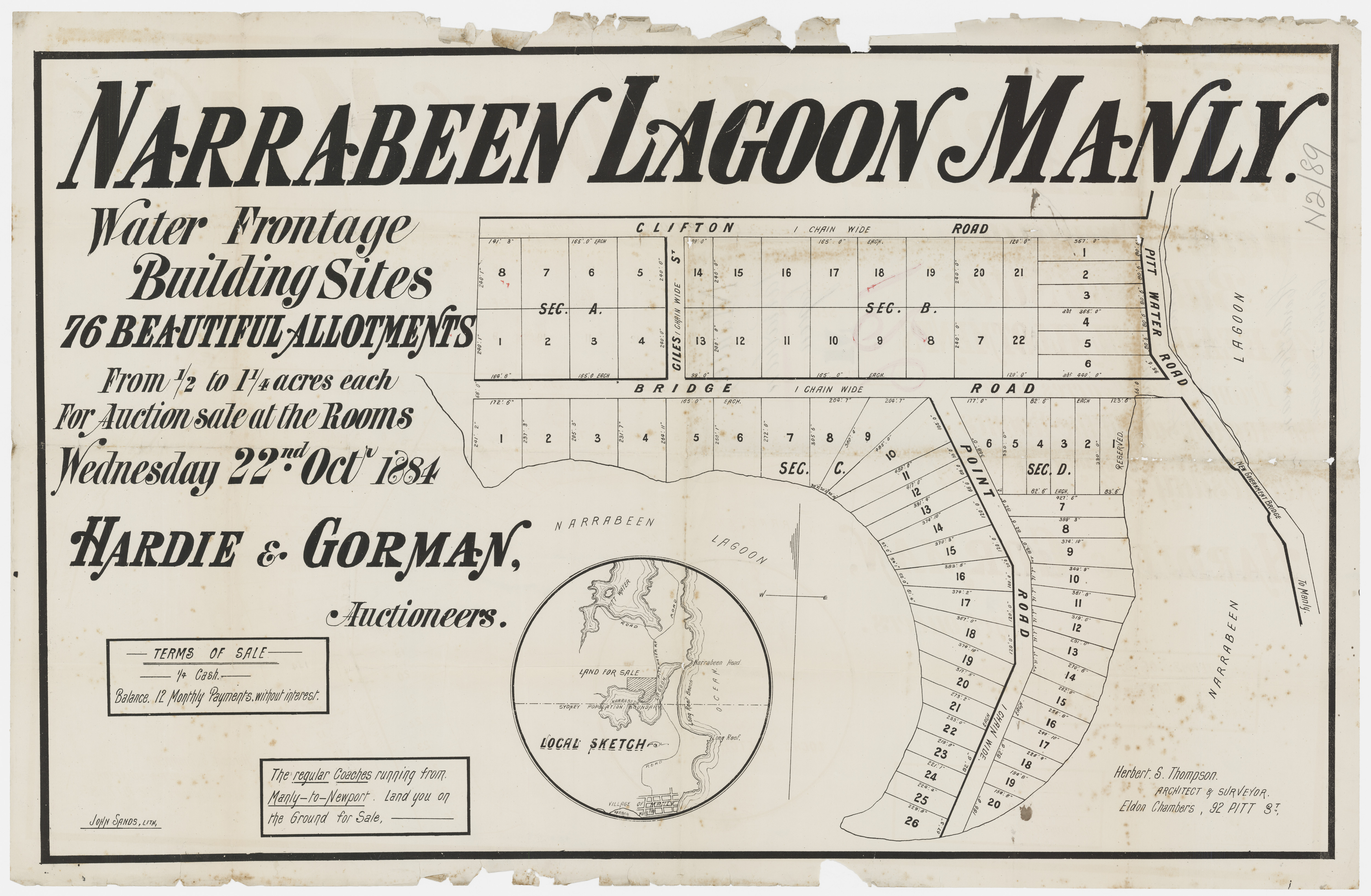
Narrabeen Lagoon 1884 land sales, Clifton Road, Giles road, Bridge Road Point road - sold by Hardie and Gorman Item c050370092, courtesy State Library of NSW
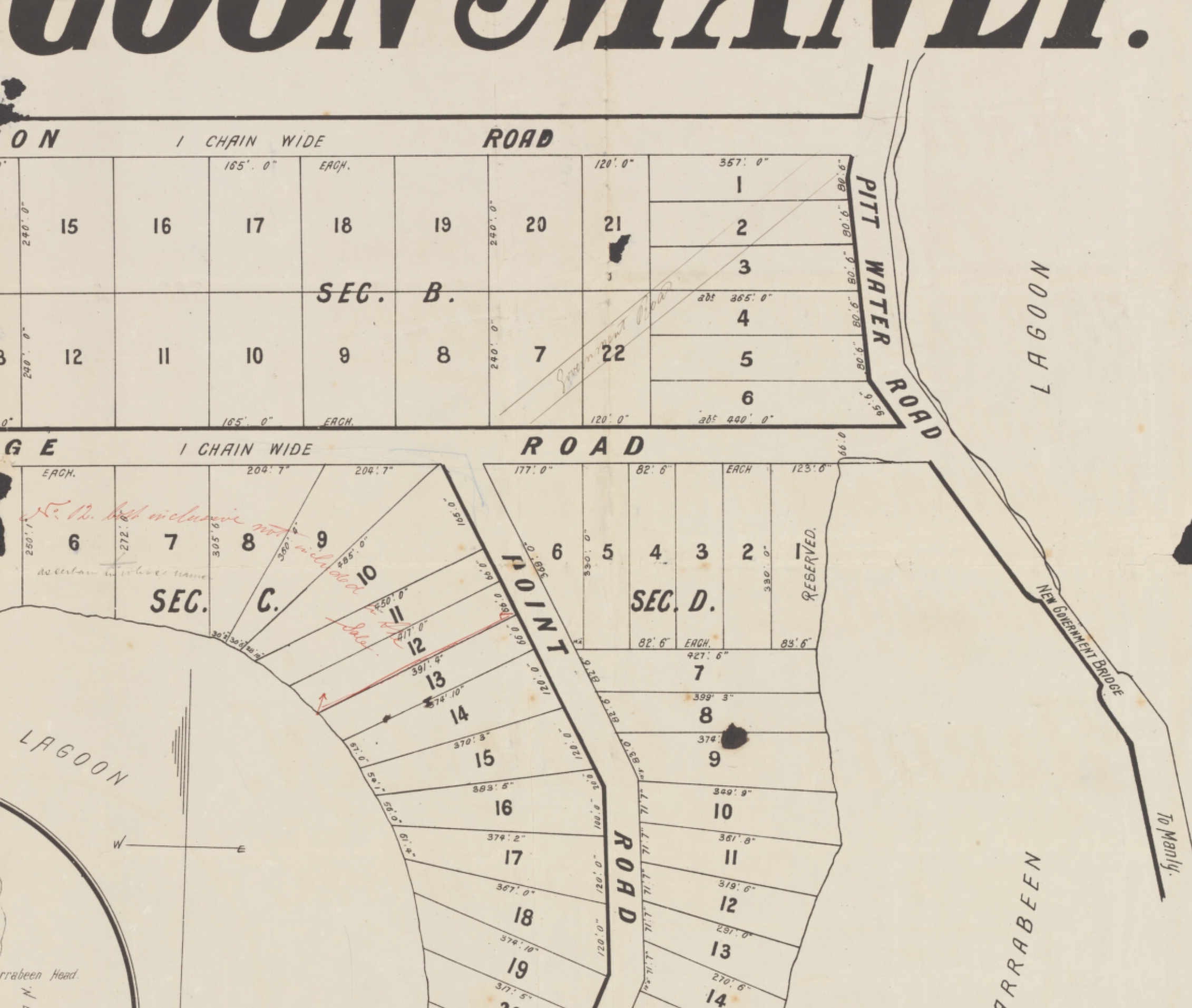
Hardie & Gorman Pty. Ltd & Thompson, Herbert S & John Sands (Firm). (1884). Narrabeen Lagoon Manly water frontage, building sites, 76 beautiful allotments : from 1/2 to 1 1/4 acres each, for auction sale at the rooms, Wednesday 22nd Octr 1884 Retrieved from http://nla.gov.au/nla.obj-230340087
Worth noting is the government's bringing the below under their jurisdiction during 1885, 1886, 1888 and 1889:
Department of Lands,
Sydney, 18th November. 1885.
RESERVES FROM SALE FOR CAMPING AND PUBLIC RECREATION.
HIS Excellency the Lieutenant-Governor, with the advice of the Executive Council, directs it to be notified that in pursuance of the provisions of the 101st section of the Crown Lands Act of 1884, the land specified in the Schedule appended hereto shall be reserved from sale for camping and public recreation, and is hereby reserved accordingly.
JOSEPH P. ABBOTT.
No. 126. County of Cumberland, parish of Manly Cove, area about 50 acres. The Crown Lands within the following boundaries: Commencing at the water's edge, on the eastern side of Narrabeen Lagoon, at a point west of the north-west corner of James Wheelers 60 acres; thence by a line east to the north-west corner of that portion and its north boundary and its prolongation east to the west boundary of John Ramsay's 410 acres grant; thence north by part of that boundary to the waters of Narrabeen Lagoon ; thence by the water's edge of that lagoon westerly to the south-eastern corner of James McDonald's 80-acre grant; thence by the south boundary of that portion and its prolongation west to the water's edge of the aforesaid lagoon; thence by the water's edge of that lagoon, to the point of commencement, [Ms* 85-17,154]
No. 125 of the county of Cumberland, parish of Narrabeen, area 12 acres. The Crown Lands within the following boundaries: Commencing at the south-east corner of J. W. A. White's, now Josiah Taylor's 60-acre grant, at high-water mark of Narrabeen Lagoon; and bounded on the north by the south boundary of that grant, being a line bearing west about 9 chains 33 links; thence on the west by a line bearing south to the left bank of Wheeler's Creek; thence on the south by the left bank of that creek downwards to the Narrabeen Lagoon, thence on the east by high-water mark of Narrabeen Lagoon to the point of commencement. [Ms. 85-18,909] RESERVES FROM SALE FOR CAMPING AND PUBLIC RECREATION. (1885, November 18). New South Wales Government Gazette (Sydney, NSW : 1832 - 1900), p. 7445. Retrieved from http://nla.gov.au/nla.news-article223763666
Department of Lands,
Sydney, 6th November, 1886.
RESERVE FROM SALE FOR TRIGONOMETRICAL PURPOSES.
HIS Excellency the Governor, with the advice of the Executive Council, directs it to be notified that, in pursuance of the provisions of the 101st section of the Crown Lands Act of 1884, the land specified in the Schedule appended hereto shall be reserved from sale for trigonometrical purposes, and is hereby reserved accordingly.
HENRY COPELAND.
EASTERN DIVISION.
Land District of Sydney,
No. 2,650. County of Cumberland, parish of Narrabeen, area 1 acre 2 roods. The Crown Lands within the following boundaries : Commencing on the south-western side of a road forming the north-eastern boundary of portions 67 and 69, at a stake marked broad-arrow, bearing south 59 degrees 21 minutes east, and distant 1 chain 76 links from the north-east corner of portion 67 ; and bounded thence on the north-west by a line bearing south 9 degrees 30 minutes west 4 chains 62 links; thence on the south-west by a line bearing south 80 degrees 30 minutes east 4 chains 5 links ; thence on the southeast by a line bearing north 9 degrees 30 minutes east 3 chains and 5 links to the south-western side of the aforementioned road ; and thence on the north-east by that side of that road bearing north 59 degrees 21 minutes west 4 chains 34 1/2 links, to the point of commencement,—shown on plan catalogued C. 903-2,030. RESERVE FROM SALE FOR TRIGONOMETRICAL PURPOSES. (1886, November 6). New South Wales Government Gazette (Sydney, NSW : 1832 - 1900), p. 7743. Retrieved from http://nla.gov.au/nla.news-article223778833
Department of Lands,
Sydney, 6th October, 1888.
RESERVES FROM SALE FOR PUBLIC RECREATION
HIS Excellency the Governor, with the advice of the Executive Council, directs it to be notified that, in pursuance of the provisions of the 101st section of the Crown Lands Act of 1884, the land specified in the Schedule appended hereto shall be reserved from sale for public recreation, and is hereby reserved accordingly.
JAMES N. BRUNKER.
Metropolitan Land District.
No. 7,498. County of Cumberland, parish of Manly Cove, containing an area of about 44 acres. The Crown Lands within the following boundaries : Commencing on the shore of Narrabeen lagoon, at the western extremity of the northern boundary of James Wheeler's 50 acres; and bounded thence by that shore north-easterly to the south-west corner of J. M'Donald's 30 acres; thence on the north by the southern boundary of that land east to the shore of Narrabeen lagoon aforesaid, and by that shore easterly to the western side of a road 1 chain wide along the western boundary of John Ramsay's 410 acres, thence on the east by that side of that road south to the northern side of a road 1 chain wide along the northern boundaries of portions 568,570,571, and 572; thence on the south and south-west by that side of that road west and north-westerly to a point north of the north-east corner of James Wheeler's 50 acres aforesaid; again on the east by a line south to that corner; and thence on the remainder of the south by the northern boundary of that land west to the point of commencement.
The above is partly in lieu of reserve 126, revoked this day. Plan catalogued C. 1,209-2,030. [Ms. 88-10,355]
No. 7,499. County of Cumberland, parish of Manly Cove, containing an area of about 44 acres. The Crown Lands within the following boundaries: Commencing on the southern boundary of portion 77, parish of Narrabeen, at the north-east corner of portion 96, parish of Manly Cove; and bounded thence on the west by the eastern boundary of the, latter portion south to the left bank of Middle Creek; thence on the south by that bank of that creek downwards and easterly to- the shore of Narrabeen lagoon; thence on the north-east by that shore generally north-westerly to the south-east corner of J. W. A. White's 50 acres; thence on the north and east by the southern boundary of that land west and by part of its western boundary north to a southeast corner of portion 77, parish of Narrabeen aforesaid ; and thence again on the north by part of the southern boundary of that portion west to the point of commencement.
The above includes surveyed portion 95, shown on plan catalogued C, 1,208-2,030, and is partly in lieu of reserve 125, notified 18th November, 1885, revoked this day, [Ms. 88-10,355] RESERVES FROM SALE FOR PUBLIC RECREATION. (1888, October 6). New South Wales Government Gazette (Sydney, NSW : 1832 - 1900), p. 7056. Retrieved from http://nla.gov.au/nla.news-article219883641
The above is what is today's Jamieson Park that would be reduced by 11 acres in 1937 as the state government excised some for the war Veterans home:
GIFT OF PARK LAND
Legacy Club's Home At Narrabeen
Eleven acres, portion of Jamieson Park, Narrabeen, will shortly be made available to the Legacy Club for the erection of a war veterans' home. The area is Crown land, under the control of the Warringah shire Council. The Minister for Lands (Mr. Buttenshaw) to-day discussed the matter with the president of the R.S.L. (Mr. L. A. Robb), the president of the Legacy Club (Mr. Church), and Councillors A. H. Hughes and W. R. Batho, of Warringah Shire. It was indicated that the Government would provide the council with eleven acres elsewhere to compensate for the land taken from Jamieson Park. GIFT OF PARK LAND (1937, May 18). The Sun (Sydney, NSW : 1910 - 1954), p. 8 (LATE FINAL EXTRA). Retrieved from http://nla.gov.au/nla.news-article229409980
NOTIFICATION OF RESUMPTION OF LAND UNDER 44 VICTORIA No. 16.
New South Wales, to wit.
(L.S.) Carrington, Governor.
By His Excellency, The Right Honourable Charles Robert, Baron Carrington, a Member of Her Majesty's Most Honourable Privy Council, Knight Grand Cross of the Most Distinguished Order of Saint Michael and Saint George, Governor and Commander-in-Chief of the Colony of New South Wales and its Dependencies.
WHEREAS the parcel of land hereinafter described is required for the purpose of the erection thereon of a Public School and of buildings to be used in connection therewith : And whereas I, as such Governor as aforesaid, with the advice of the Executive Council of the said Colony, have sanctioned the acquisition of the said land for a site for a Public School: Now, therefore, I, Charles Robert, Baron Carrington, the Governor aforesaid, with the advice of the said Executive Council, in pursuance of the power and authority given to or vested in me by "The Lands for Public Purposes Acquisition Act," by this notification, published in the Gazette and a newspaper circulated in the Police District wherein the said land is situated, that is to say, in the " Sydney Morning Herald " newspaper, declare that the parcel of land hereinafter particularly described has been resumed for the purpose of the erection thereon of a Public School and of buildings in connection therewith : And that the said land hereinafter described is resumed with the intent that by the publication in the Government Gazette, and in a newspaper circulated in the Metropolitan Police District, of this notification of the said land being so resumed, the said land shall forthwith become and be vested in the Minister of Public Instruction of the said Colony and his successors, on behalf of Her Majesty, for the purposes of the said Act, for an estate of inheritance in fee simple in possession, freed and discharged from all trusts, obligations, estates, interests, contracts, charges, rights-of-way, or other easements whatsoever, and that the legal estate therein, together with all powers incident thereto or conferred by the said Act, shall be vested in the Minister of Public Instruction as a Trustee, as in the said Act is provided : And I declare that the following is the parcel of land hereinbefore referred to as resumed by this notification, that is to say:—
All that piece or parcel of land situated at Narrabeen, containing 1 acre 3 roods 4 perches, being allotments 1 to 4 and 12 to 15 inclusive, of section 25 of the Mount Ramsay Estate, being part of John Ramsay's 410 acres, in the parish of Manly Cove, county of Cumberland: Commencing at the intersection of the north side of Goodwin-street with the south-west side of Victoria-street; and bounded thence on the north-east by the south-west side of the last-mentioned street bearing north 17 degrees 2 minutes west 3 chains 3 links ; thence on the north by the south boundary of allotments 5, 9, 10, and 11, bearing west 5 chains 70links ; thence on the west by the east side of Park-street bearing south 2 chains 89 1/2 links to the north side of Goodwin-street aforesaid; and thence on the south by that side of that street bearing east 6 chains 59 links, to the point of commencement.
In testimony whereof I have hereunto set my Hand, and caused the Great Seal of the Colony to be hereto affixed, at Government House, Sydney, this eighteenth day of March, in the year of our Lord one thousand eight hundred and eighty-nine, and in the fifty-second year of Her Majesty's Reign.
By His Excellency's Command,
J. H. CARRUTHERS.
[2237] GOD SAVE THE QUEEN! NOTIFICATION OF RESUMPTION OF LAND UNDER 44 VICTORIA No. 16. (1889, March 22). New South Wales Government Gazette (Sydney, NSW : 1832 - 1900), p. 2228. Retrieved from http://nla.gov.au/nla.news-article223991513
Work commenced on the school building when the Department of Public Instruction received a letter on behalf of James Edward Black. The letter read in part:
"I have the honor to draw your attention to the fact that carpenters and builders acting upon the authority of your department, have entered upon, taken possession of, and proceeded to erect a structure upon land belonging to me, near Narrabeen Lake, Parish of Manly Cove - more particularly known as the Mount Ramsay Estate Subdivision.
I hereby give you notice to yield up possession, and withdraw the aforesaid workmen forthwith. Failing to comply with this notice I shall instruct my solicitor to issue a Writ of Ejectment of Wednesday next, and to further proceed at law for the recovery of damages for this trepass."
The Department had not known the identity of the former owner of the resumed land. A formal 'Notice of Claim and Abstract' was submitted on March 28th 1890 and Mr Black was paid £803 pounds, one shilling and seven pence in compensation for his land.
And also in 1886 part of the land advertised for sale in 1884 is advertised as 2 acres and in 1887 'railings' for the approaches to the road bridge are called for:
NARRABEEN LAKE, beyond MANLY.
2 ACRES 10 PERCHES, having 330 foot frontage to BRIDGE ROAD, and about 335 feet frontage to the famous lake. It is Lots 6 and 7 of subdivision of Thomas Collins's 55-acre grant. This district is rapidly coming into favour, and Improvement!, are being manifested around. RICHARDSON and WRENCH will sell by public auction, at the Rooms, Pitt-street, on FRIDAY, 30th APRIL, at 11 o'clock, The above block of land, NARRABEEN LAKES, near Manly. Terms at sale. Advertising (1886, April 24). The Sydney Morning Herald (NSW : 1842 - 1954), p. 14. Retrieved from http://nla.gov.au/nla.news-article13641544
Several accidents at Jenkins's Bridge, Narrabeen, on Prince of Wales's Birthday. Brevities. (1886, November 11). Evening News (Sydney, NSW : 1869 - 1931), p. 6. Retrieved from http://nla.gov.au/nla.news-article107315131
NARRABEEN.
The new bridge at Jenkins' Creek is to be commenced. The approaches on either side of this creek are in a fearful state. As there has been such an enormous increase of traffic on this road, the authorities should allow a special grant to have the road properly made. The amount allowed per mile would then be sufficient to keep same in repair. It is hoped that the promise made by the Commissioner of Roads, viz., to have a railing put upon the approaches to Narrabeen bridge will be fulfilled. The Hon. W. B. Dalley was on one occasion capsized into the lake. This district is looking beautiful; the rock lilies and wild flowers are commencing to bud, and flowers in great profusion will be displayed in full bloom by the end of August. Gillbirds have not been at all plentiful this season. Hundreds of disappointed shootists have had to return home without a brace. Many have taken revenge by shooting a few magpies or a stray parrot. NARRABEEN. (1887, July 29). Evening News (Sydney, NSW : 1869 - 1931), p. 5. Retrieved from http://nla.gov.au/nla.news-article108007815
Although the 1897 Crown Land sale 'near Narrabeen Lagoon' is a bit out of the picture - this is worth listing here to show what was being sold and where, and to mark that something similar happened at Mona Vale around the same time. The system of unconditional sales was still continued under the Act of 1861, and remained in force until its abolition in 1884. With many benefits there was also considerable mischief as a result of the operation of Robertson's Act, chiefly for the reason that land, being held under pastoral leases not exempt from free selection, could be the subject of speculative selecting without bona fide intention of settlement. The Crown Lands Act of 1884 and the supplementary Act of 1889 were accordingly passed to remedy this state of things. These measures, while maintaining the principle of free selection before survey, were designed to give fixity of tenure to the pastoral lessees, and at the same time incidentally tended to restrict the area sold unconditionally. Pastoral leases were required to be surrendered to the Crown and divided into two equal parts. One of these parts was returned to the lessee under a lease with fixity of tenure for a certain term of years ; the other half, called the resumed area, the lessee was allowed to hold under an annual occupation license, but this half was always open to selection.
It was found after a few years that the Acts of 1884 and 1889 did not succeed attaining the objects for which they were designed; settlement proceeded very slowly and the accumulation of land into large estates continued. Parliament was led to introduce entirely new principles into the agrarian legislation of the State, embodied in the Crown Lands Acts 1895 to 1909, the Labour Settlements Act 1902, the Closer Settlement Acts 1904 to 1909, and the Closer Settlement Promotion Act 1910, which, while still giving fixity of tenure to pastoral lessees, retain the principle of free selection before survey, and to offer bona fide settlers special inducements by the introduction of new forms of tenure on easy terms and conditions.
It is also worth noting that the Public Roads Act of 1897 No 5 came into being at the same time. Long title; An Act to amend and consolidate the law relating to the opening, closing, and survey of roads; to make provision for the disposal of unnecessary roads and of lands resumed or withdrawn but not required for roads, and of certain other lands ; for the prevention of the obstruction and injury of roads ; for the alignment and the alteration of the alignment of streets in Municipalities; for granting leave to place public gates in certain cases ; and for other matters of the like nature ; and for that purpose to amend the Act 4 Wm, IV No. 11 ; the Public Gates Act of 1875 ; and the Crown Lands Acts of 1884 and 1889. [30th June, 1897.]
It is worth noting that William Houston, a nephew of John Wetherill's first wifes' father Hugh Houston, was Under-Secretary for Lands and 'called on to assist with the Land Bill introduced by Mr. J. S. Farnell in 1883, which came into operation on January 1, 1885.
Near here just a few years prior to this:
Died in the Bush.
THE NARRABEEN MYSTERY. THE CORONER'S INQUEST. AN OPEN VERDICT.
At the Croydon Hotel, .to-day, before Mr. J. C. Woore, City Coroner, an inquest was opened regarding the death of the man whose body was found in the bush at Narrabeen, on the 1st instant. Senior-sergeant M'lntosh watched the case on behalf of the police.
Alfred M'lntosh deposed that he was a boarding-house keeper at Narrabeen. On Monday morning at 7.30 he was in the bush at Long Reef with Ernest Yates and others. He found the remains of the body lying on its back.' The left arm was extended, and the right lay across the body. The boots were off, and a blanket covered the upper part of the body. There was some clothing under the shoulders and head, and other clothing was lying near. There was a billy near the feet, but no traces of a fire. Witness was present when the photograph produced was taken. It represented the position of the body. He could positively identify the clothing deceased wore as that of a man he spoke to about two months ago in the same locality. He did not know his name, and could not remember the exact date when he spoke to him. Witness was talking to 'him regarding mining at Long Reef. Deceased did not say anything regarding his name or where he lived. He told, witness he intended returning to Sydney in a day or two. Deceased had a billy, pannikin, tomahawk, and knife, and was within threequarters of a mile from where the body was found. A young man about 26 years of age was with deceased. Witness did not know him, and had not seen him since. They were cooking at the time. The body was about 20 yards from high water mark. About 60 or 70 head of cattle ran about there. After finding the remains they were photographed by a Mr.Vogan, and the police were sent for.
Senior-Sergeant M'lntosh, took the remains in charge. Identified the book produced, having written in it at the request of deceased with a pencil handed him by the young man. He believed the knife produced to be one he saw with deceased. Deceased's companion was like a sea-faring man. He wore a complete suit of blue serge and a can, had no hair on his face, and was dark with close-cut hair. He was about 5ft 9in in height. Deceased showed witness some samples of clay. Similar clay was found in a bag near the remains. Deceased was a short, thick-set man of slovenly appearance, and had a strong foreign accent. He spoke to witness of j having been in Germany, where he was engaged in making cement. In appearance the man was like a German. The young man said he had been with deceased about a fortnight, and had been in the colony about seven months. He was an Englishman and spoke very accurately. Deceased said he had money, and showed -witness a bag saying he had enough there to get a miner's right and a pair of boots so as to go to work on the reef.
Henry Cohen, dealer, living near Manly, said he identified the clothing at the Morgue as that worn by a man he saw near his camp some time in November. Witness saw him twice, and there was no one with him at first. He described the appearance of deceased and his clothes, and said he appeared to be about 50 years of age. Witness thought from his speech deceased was a Scotsman, and he spoke of Aberdeen. He showed witness some clay he got from Dee Why Lagoon, at Narrabeen, and said he was an old New Zealand miner. When witness saw deceased the second time a young man was with him. Deceased said he had been to the Lands Office three years ago regarding the working of the land at Dee Why. He also said he was going to get up a syndicate to work the clay, and that he had a gentleman behind him. The young man wore dark clothes and a black hard hat; he was about 30 years of age, clean shaved, and of dark complexion.
Constable Clibbon, stationed at Manly, deposed to finding the memo book produced and also a circular from the Fisheries Department among the clothes of deceased. The latter was addressed to ' A. Hunter, Wellington, N.S.W.' A portion of a packet of sugar of lead, labelled, was in the inside breast pocket of the coat. A small bottle and 1d were found in the trousers pocket.
George E. Rennie, Government Pathologist, deposed that he had examined the remains of deceased. He had been a man of between 50 and 60 years, and had been dead about two months. There was scarcely anything but the skeleton left. The skull and breast bone were broken. In his opinion, this was done after death. Portion of the scalp adhered to the skull, and there was no trace of blood on it. Nothing whatever was found to indicate the cause of death. The breakage of the bones might have been caused by the trampling of cattle.- If the bones of the head had been broken during life, witness would have expected to have found blood on them.
Arthur James Vogan, of the Railway Estate Branch, gave evidence as to having been with the witness Mintosh when the body was found. Witness photographed the remains exactly as they found them. Deceased had evidently died in agony as his fingers were dug into the ground, and his feet and legs were contorted.
James Day, mariner, residing at Manly, deposed that he last saw the man he believed to be deceased about two months ago. That was when corning back from Manly in the steamer Fairlight. He was one of the passengers. Witness was one of the crew of the steamer, and often saw him before on board, and spoke to him. Did not know him by any other name than ' Scotty.' He told witness five or six times that he was after clay near Long Reef, which he said was good for paint or fireclay. The clothing on the remains resembled those worn by ' Scotty,' and so, too, did the hat he saw. The last time witness saw the man he remarked to him (witness) that he had not been very well.
Senior-sergeant M'Tntosh, of Manly, produced a memo book found in a bag near the remains. In the book was an entry in red ink. It was compared with letters sent by Archibald Hunter to the Fisheries Department, the address being 'Wellington Post Office.' The letters were regarding some persons fishing in the Macquarie. They corresponded with the entries in the book, were in the same handwriting, and had, apparently, been written on leaves torn from the book. One bore date October 13, and the other October 14, 1893.
Livingstone F. Mann, draftsman in the Fisheries Department, produced two letters written in red ink on paper like that in the memo, book, and signed 'Archibald Hunter, Wellington.'
The jury returned a verdict to the effect that the deceased, whose name they believed to be Archibald Hunter, came to his death on or about November 20, 1893, and that there was no evidence to show the cause of death. Died in the Bush. (1894, January 3). Evening News (Sydney, NSW : 1869 - 1931), p. 5. Retrieved from http://nla.gov.au/nla.news-article114070421
Arthur James Vogan had land at Newport, near the hotel and then called 'Vogan's Point', and was an early photographer of Pittwater. He would later return to the Dee Why - Collaroy area, where he passed away, years later. Journals of his, held by the State Library of New South Wales, show he had a passion for aboriginal carving and sought these in the Narrabeen area. This may have been what he was doing with a camera in that area on the day this gentleman's body was found.
The 1897 Crown Land Sale:
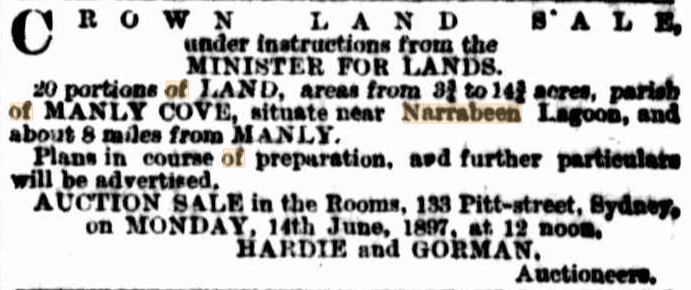
Advertising (1897, April 24). The Sydney Morning Herald (NSW : 1842 - 1954), p. 15. Retrieved from http://nla.gov.au/nla.news-article14119869:
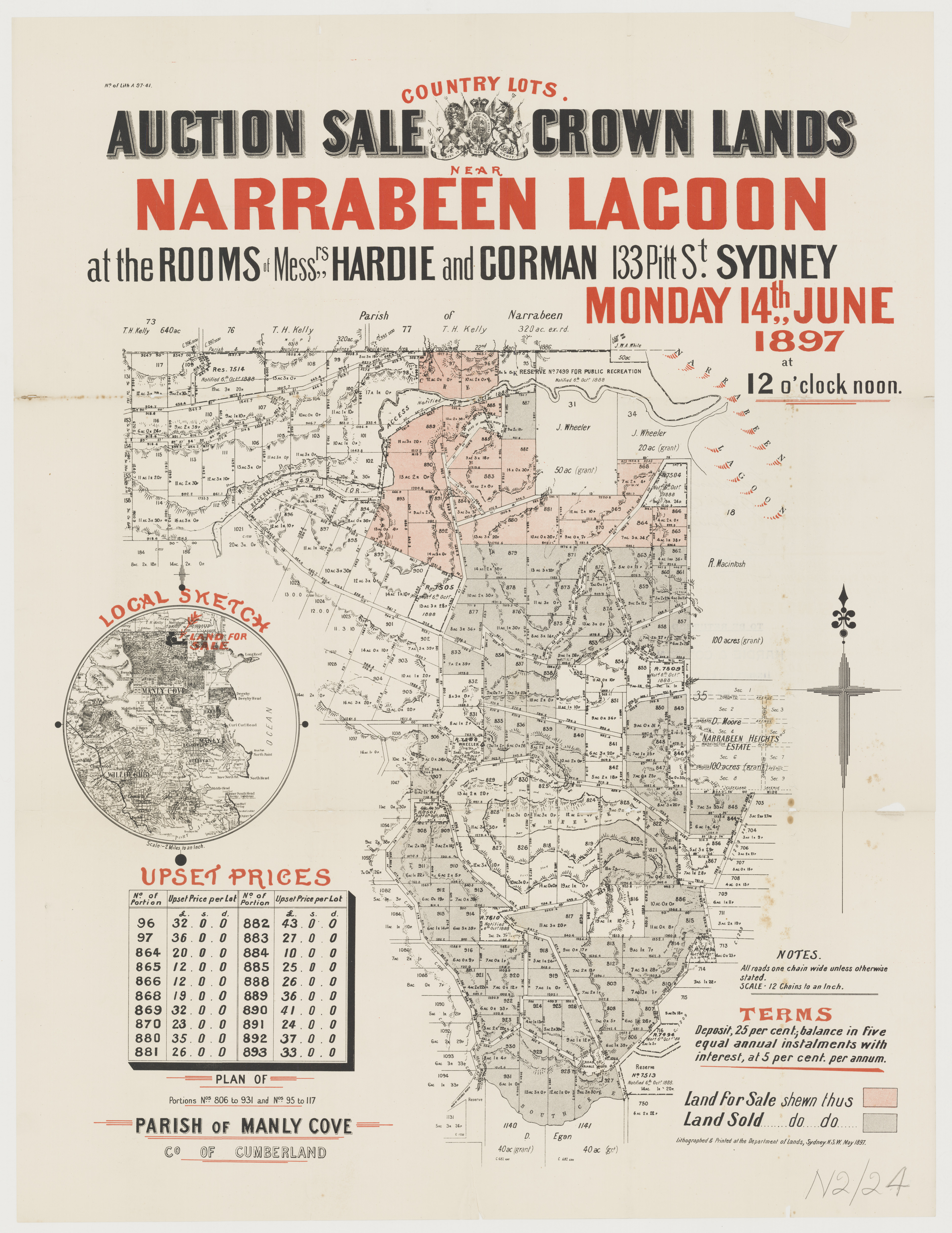
Narrabeen Lagoon 1897 - Item c050370024
Also happening at Narrabeen during 1897:
N.S.W. Field Artillery. FIRING EXERCISES NEAR NARRABEEN.
(See illustrations on this page.)
The Field Artillery of New South Wales last month formed a camp near Narrabeen, on the road from Manly to Broken Bay, with the object of giving officers and men some practical work in the shape of range and competitive firing. The camp was formed on June 7, and three days later was occupied by the A battery of Permanent Artillery. This battery was in camp continuously for more than a week. The partially-paid batteries also took part in the exercises, but only to the extent of one whole-day parade. B battery (partially-paid) went into camp on June 12, when both gunners and .drivers were given a day'à sound work at drill and firing. C battery (partially-paid) were put through similar exercises on June 19. The A battery, (permanent), of course, had daily drills during the period they were camped.
The officers at the camp were as follow: A battery (permanent)-Lieutenant-Colonel H. P. Airey, D.S.O., in charge; Lieutenant E. A. Antill, adjutant, B.D.F.A. ; Lieutenant Christian, B.D.F.A.; Brigade Sergeant-major H. Coleman; Brigade Quartermaster-sergeant Rauchle. B battery, (partially-paid)-Major R. M. S. Wells, and Lieutenants J. H. Plunkett, J. H. Schwabe, V. Airey, and C. Griffiths. C battery (partially paid)- Captains Lenehan and Anderson, and Lieutenants E. A. Pearce, Flannery, and H. G. Shaw.
The chief umpire was Colonel S. C. TJ. Smith, R.A. (commanding N.S.W. Artillery Forces), and the assistant umpires were Lieutenant-Colonel H. V. Savage and Captain Le Mesurier. Major Bridges acted as instructor to the camp, and Lieutenant J. Mair as range officer. A detachment of the Medical Staff Corps, under Surgeon Lieutenant-Colonel Dansey, was also on duty.
Field Artillery Exercises-Long Range Firing by the N.S.W. Brigade Division.
* (FROM PHOTOGRAPHS BY 'IMHO CHOWN STUDIOS, SYDNEY.)
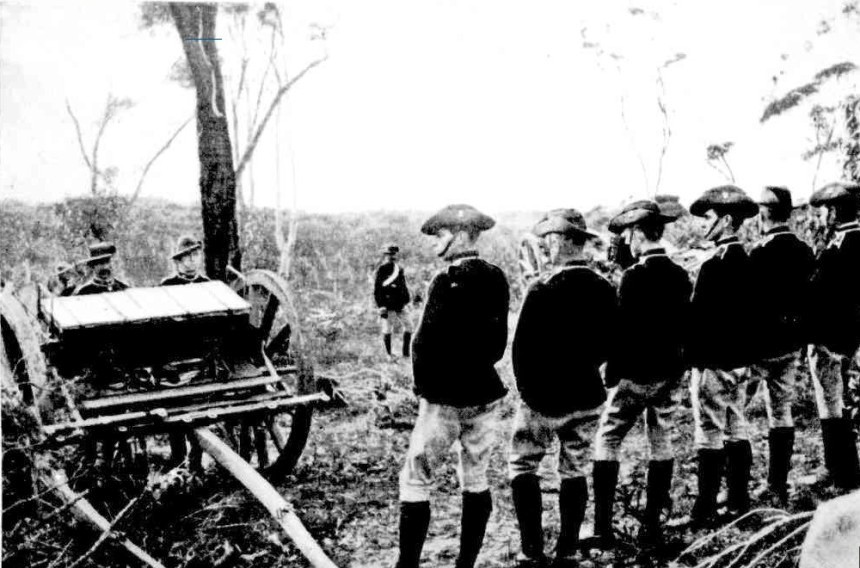
Ready for Action.
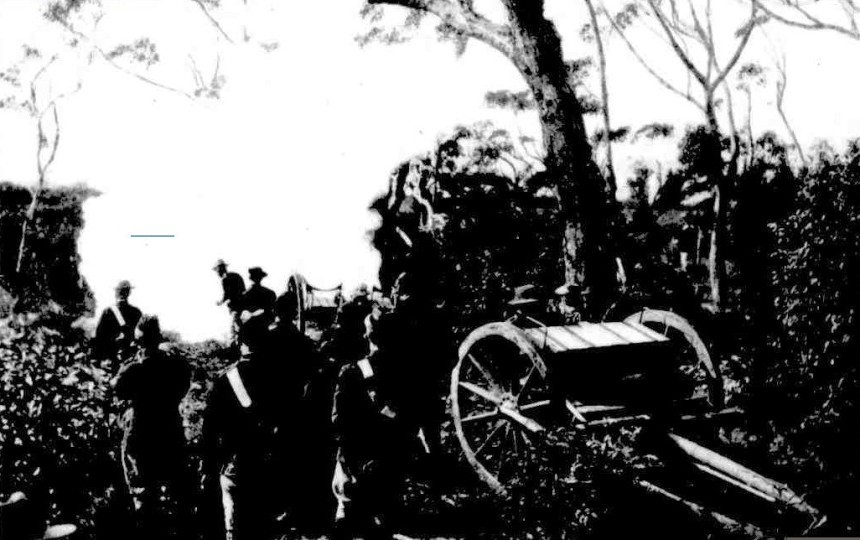
"B" Battery Firing.
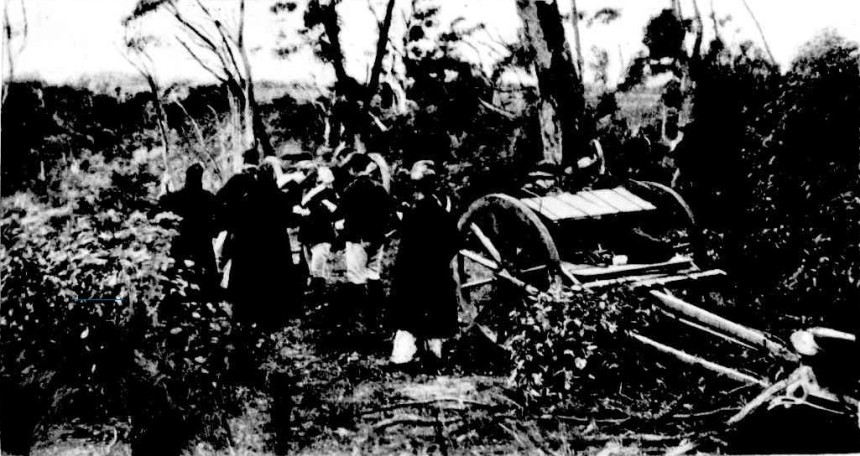
After the Firing.-The Umpires Comparing Notes.
N.S.W. Field Artillery. (1897, July 3). Australian Town and Country Journal (NSW : 1870 - 1907), p. 32. Retrieved from http://nla.gov.au/nla.news-article71275301
NARRABEEN
We are just back from Narrabeen, after such a delightful week. We have been cycling, boating, swimming, fishing and picnicking. Really, Narrabeen is the most charming place I know, so easy to get at, and so cheap. What do you think it cost us for the trip ? — only 10s each, and what a lot we got for our money. I will give you all the details of our expenditure.
First of course came the boat fare to Manly (6d). Arrived at Manly, the party divided, half patronising tho coach, which takes you down to Narrabeen for a shilling, and the other more fortunate half mounting our bicycles to enjoy the eight-mile spin over a capital road which lay between us and our destination.
We had engaged the largest cottage to be had in the place, as our party was a large one, numbering some ten or twelve. It cost us £2, but I think it was well worth the money, as there was ample accommodation for us all, and everything that we could possibly want was provided, with the exception of knives and forks and house linen, which we brought with us. It was also most conveniently near the little store, where we bought all our provisions and ran up a bill for milk, bread, potatoes, groceries, &c., which amounted to some 30s when settling day arrived. From the store we also engaged a boat for the week, which cost us 10s.
Perhaps you don't know that there is a very pretty lake at Narrabeen? To be sure it is not very deep, and we occasionally got stranded on sand banks at first, but the boys were always quite ready to get out and push us off, and we soon learnt to know the channels so well that their assis-tance in that line was no longer necessary. There is much deeper water in the three creeks which empty themselves into the lagoon, and if you want to bathe I advise you to choose the middle of the three, which is about 5ft deep, and has a delightfully sandy bottom. We also "spreckled by moonlight" on the ocean boach (if you don't know what that means ask a Scotchman), and enjoyed a ride to Newport on our bicycles, with a halt at Rock Lily for refreshments. — Cousin Kate. NARRABEEN. (1897, December 26). Sunday Times (Sydney, NSW : 1895 - 1930), p. 4. Retrieved from http://nla.gov.au/nla.news-article126247931
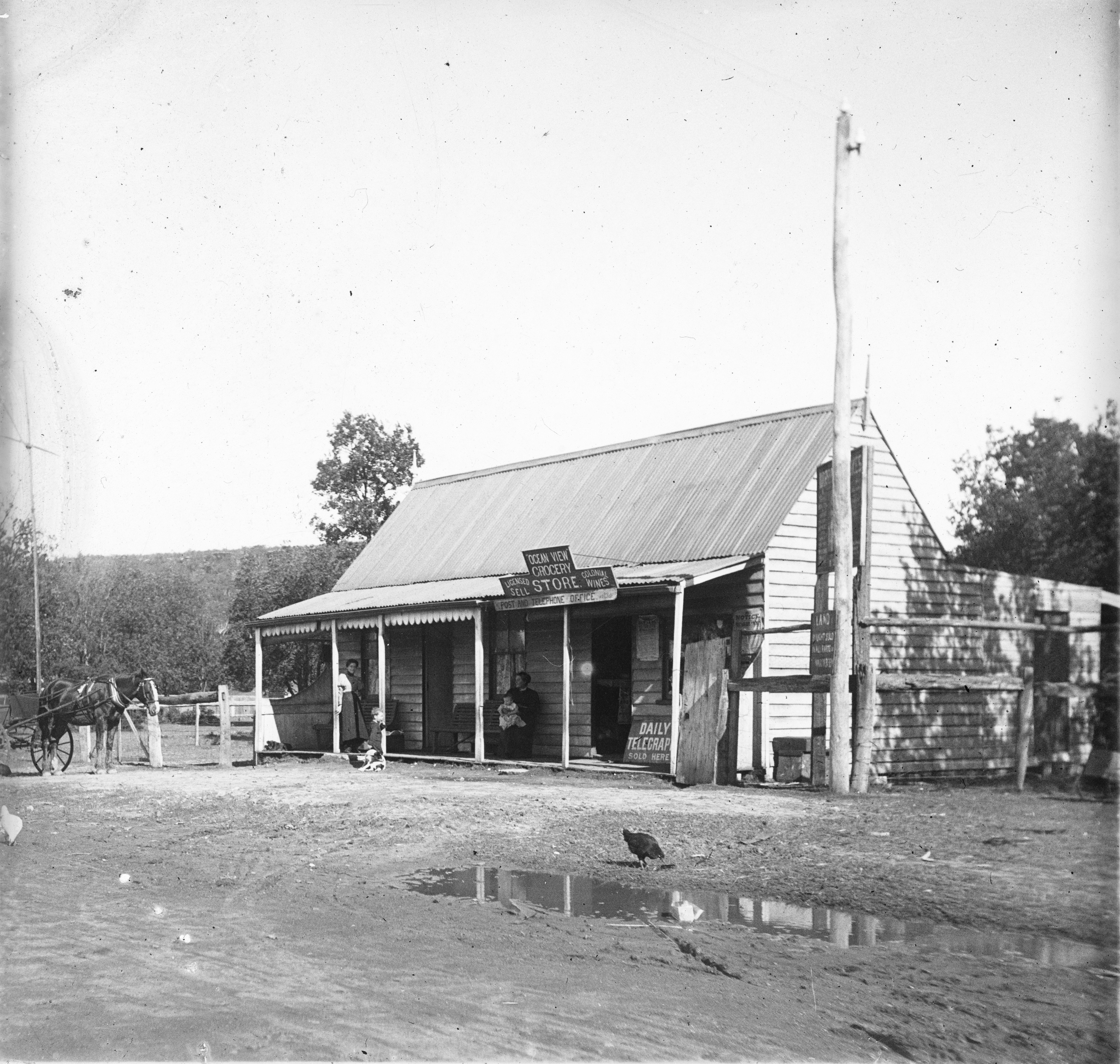
Ocean view store Narrabeen circa 1899-1910. Item c071860044, from Macpherson Family Albums, courtesy State Library of NSW. Narrabeen Post Office opened on march 1st 1898.
A post office will be established on the 1st proximo at Narrabeen (in lieu of the receiving office), between Manly and Newport. GOVERNMENT GAZETTE. (1898, February 21). Evening News (Sydney, NSW : 1869 - 1931), p. 3. Retrieved from http://nla.gov.au/nla.news-article108772830
NEW COLONIAL WINE LICENSES.
At the Licensing Bench sitting at the Water Police Court yesterday the applications of the following persons for new colonial wine licenses were granted: John James Jones, Military-road, Mosman; Arthur Cowley, Lane Cove-road, Turramurra; William M'Farlane Logan, Trafalgar Square, Mosman; Robert Henry Lawrence, 180 Blue's Point-road, North Sydney; Daniel A. Casey, 163 Miller- street, North Sydney; Louis Charles Roberts, 122 Oxford-street, Sydney; Edward Hemmings, Bunnerong-road, Randwick; Edgar Charles Russom, 4 Elizabeth-street, Paddington; Mary Mooney, Ruthven-street, Waverley; Louis Becker, Yurong and Stanley streets; Edward Anglin, 153 Oxford-street, 'Waverley; Arthur Quinnell, 92 Oxford-street, Paddington; John S. M. Edwards, 111 Pitt-street, Sydney; Domenico Picone, Erskine-street, - Sydney; Adolph Stephan, 50 Kent-street; Henry Rodick, 98 Hunter-street; James Duggan, 73 and 75 Cumberland-street; William Layton, 60 Darling-street, Balmain; Donald M'Lean, Narrabeen; Charles Thorpe, 630 Darling-street, Balmain; Thomas Murphy, The Corso, Manly. NEW COLONIAL WINE LICENSES. (1899, January 12). Evening News (Sydney, NSW : 1869 - 1931), p. 7. Retrieved from http://nla.gov.au/nla.news-article113702488
A telephone was installed at Narrabeen Receiving Office in 1897. Mr Dugald Thompson, MP wrote on behalf of Narrabeen residents in January 1898, asking that the Receiving Office be made a Post Office. Donald McLean was the Receiving Office Keeper and also the Telephone Operator, which increased his earnings by ten pounds per annum. He had numerous children and grandchildren, some of whom brought land under the Real Property Act from 1915 on, with a bigger one in 1944.
OBITUARY.
MR. DONALD McLEAN.
Mr. Donald McLean, who died at Narrabeen at the age of 75 years, had a varied career. He had been storekeeper and postmaster, a road contractor, and a bridge builder. The funeral took place at the Roman Catholic portion of Manly Cemetery. Mr. McLean Is survived by 12 children. OBITUARY. (1932, June 21). The Sydney Morning Herald (NSW : 1842 - 1954), p. 6. Retrieved from http://nla.gov.au/nla.news-article16900564
The McLeans had 14 children.
.jpg?timestamp=1559522867216)
Narrabeen - Plan of Portions 94, 95 & 97, Parish of Narrabeen, County of Cumberland - No boundaries shown, 1902, Item No.: c050370036, courtesy State Library of NSW - Narrabeen Subdivision Plans - Note 'now E A Macpherson' lands owned. Enlarged sections from described as ' Mahogany and Apple' and 'Scrubby and Swampy'.
Edward Augustus Macpherson was the son of Joseph Wharrie and Catherine Macpherson. He took an assignment of land dated December 28, 1875 and house known as “Hawthornden” in Roslyndale Avenue, Woollahra, New South Wales. The Macpherson family resided there between 1876 and 1902 but remained associated with the site until 1918. He owned land at Bayview, Dee Why, on Narrabeen Lagoon and of course 'Wharriewood' as shown above.
DISTRICT COURT.
Monday, September 19.
(Before Judge Wilkinson.)
Claim for Commission.— J. E. Robberds and Thomas William Woodin v. Edward Augustus MacPherson. The plaintiffs sued the defendant for work, journeys, and attendances performed as agents for the defendant, and for commission in connection with the sale of land at Narrabeen, near Manly. The amount of claim was £200. Judgment was given for the plaintiffs for £150. DISTRICT COURT. (1892, September 20). The Daily Telegraph (Sydney, NSW : 1883 - 1930), p. 3. Retrieved from http://nla.gov.au/nla.news-article235968204
In 1899 part of these lands were resumed for a road 100 links wide:
Department of Lands,
Sydney, 29th March, 1899.
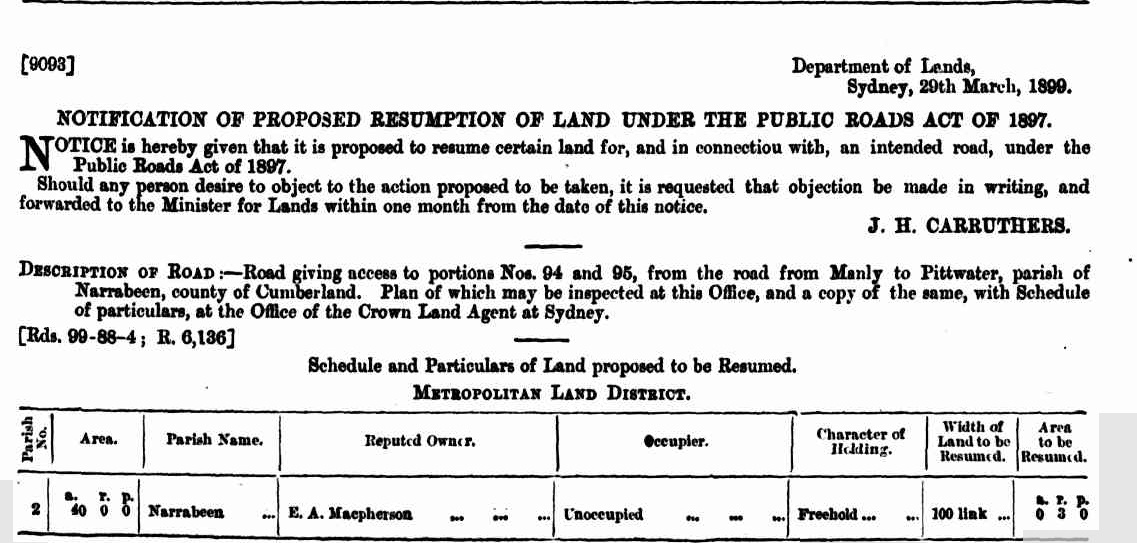
NOTIFICATION OF PROPOSED RESUMPTION OF LAND UNDER THE PUBLIC ROADS ACT OF 1897. NOTIFICATION OF PROPOSED RESUMPTION OF LAND UNDER THE PUBLIC ROADS ACT OF 1897. (1899, March 29). New South Wales Government Gazette (Sydney, NSW : 1832 - 1900), p. 2547. Retrieved from http://nla.gov.au/nla.news-article220982847
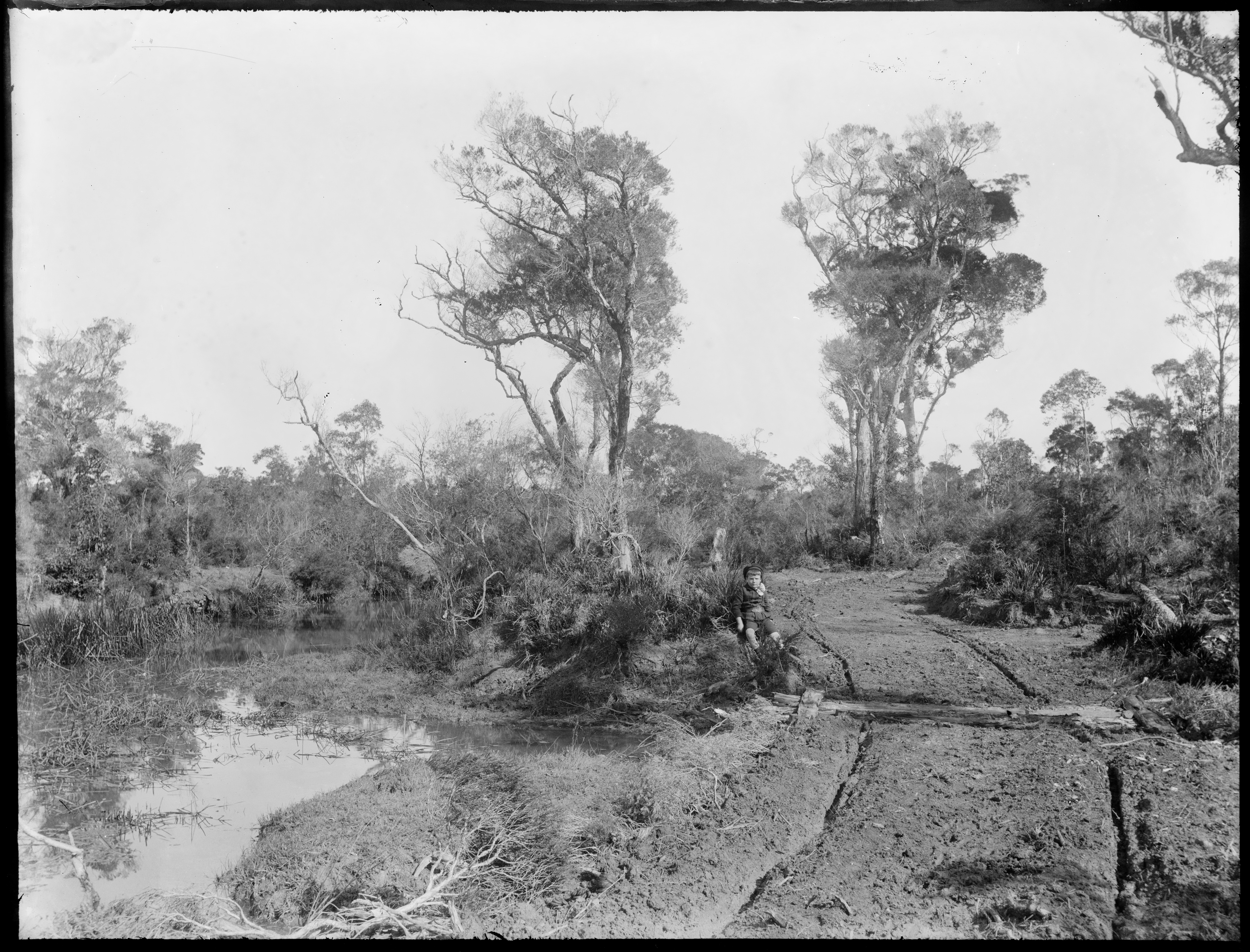
Land resumed confirmed:
Department of Lands,
Sydney, 28th June, 1899.
LANDS RESUMED FOR ROADS DECLARED TO BE PUBLIC ROADS.
NOTICE is hereby given that the lands which have been resumed by notification in the Government Gazette for Roads, under the Public Roads Act of 1897, are now declared to be Public Roads.
By His Excellency's Command,
J. H. CARRUTHERS.
Roads No. Description of Roads. Date of Gazette of last notice
99-88-9 R. 6,136 Road giving access to portions Nos. 94 and 95, from the road from Manly to Pittwater, parish of Narrabeen, county of Cumberland. 3rd of June 1899, folio 4398. LANDS RESUMED FOR ROADS DECLARED TO BE PUBLIC ROADS. (1899, June 28). New South Wales Government Gazette (Sydney, NSW : 1832 - 1900), p. 4889. Retrieved from http://nla.gov.au/nla.news-article220944536
A letter from Mr. M'Pherson, secretary to the Narrabeen Progress Association was read at the last meeting of the Manly Council, which called the aldermen's attention to the fact that an application had been made to grant under the Real Property Act a title to certain lands at the mouth of the Narrabeen Lagoon, comprising the whole of the sand spit which forms the southern part of the entrance to the Lagoon, also asking the aldermen to co-operate in a united protest to the Department of Lands against any alienation from the Crown. The reading of the missive caused some discussion among the aldermen, some declaring that 'a land grab' was being attempted. It was pointed out what the consequences were when a religious body secured a similar piece of land at Deewhy Lagoon. Several petitions are going the rounds of Manly, and are being extensively signed. The spot required is much thought of as a camping ground for fishing parties from Manly and the city. The aldermen determined to be cautious, and resolved to ask for further particulars. MUNICIPAL MATTERS. (1901, April 22). Evening News (Sydney, NSW : 1869 - 1931), p. 3. Retrieved from http://nla.gov.au/nla.news-article112568594
The tram to Collaroy and then further to Narrabeen would commence a whole slate of acreage being brought under the Real property Act in smaller suburban sized parcels. What's interesting about this news report, or the extract from it included, is that many of those listed held land and would do just that during the 1910's and later:
THE LAKE DISTRICTS OF PITT-WATER AND NARRABEEN.
A PROGRESSIVE MOVEMENT.
There are many parts of Sydney and its suburbs better known to most people than the charming district comprising Narrabeen, Pittwater, Newport. etc.. which stretches away to the north-west of Manly, skirting the ocean on one side, and extending on the other to the picturesque reaches of the Hawkesbury. Yet there is no more delightful and bracing spot among the many pleasure resorts of the metropolis. At a first glance it seems difficult to understand why there should be this ignorance, especially in view of the nearness of the district to Sydney. In all probability it is owing lo the fact that the harbor divides the district from Sydney proper, and that thousands who visit Manly each year regard that pleasant watering-place as being in that direction the ''Land's End" of the colony. But the residents are now bestirring themselves to impress the claims of their district for larger share of consideration In the expenditure of Government money on local improvements, and also for the construction of a tramway to open up the district from Manly, If not all the way from Sydney, via the Spit. The difficulty of taking the line the on the distance is the cost of a bridge across Middle Harbor, but it is believed that a line could be constructed from Manly which would pay well within a very short time of completion, as far as Narrabeen, if not even to Pittwater.
On Saturday evening last the various Progress Committees of the district foregathered at a banquet held in the Narrabeen Hotel for the purpose of ventilating their views on the subject, and by way of Initiating a combined movement on the part of these districts to advance their common interests. There were over 40 gentlemen present, including Mr. T. J. West (Mayor of Paddington), who occupied the chair, the Rev. A. G. Stoddart, Mr. Passau (Mayor of Manly), Mr. D. C. M'Lachlan, Mr. J. Taylor, Mr. John Woods (of Manly), Mr. Iredale, and the chairmen of the Narrabeen, Newport, and Pittwater Progress Committees. An excellent spread was provided, and a lengthy list of toasts having been honored, the larger property-owners present, as well as several influential visitors, pledged themselves to do all in their power to secure improved means of communication with the district, and a working committee was formed to take the matter in hand. THE LAKE DISTRICTS OF PITTWATER AND NARRABEEN. (1898, March 30). The Daily Telegraph (Sydney, NSW : 1883 - 1930), p. 4. Retrieved from http://nla.gov.au/nla.news-article238375681
THE MINISTER FOR WORKS AT MANLY.
INSPECTION OF THE TRAMWAY.
SPEECH AT NARRABEEN.
Mr. E. W. O'Sullivan paid a visit of inspection on Saturday to the Manly tramway and tram sheds, and then traversed the route, as far as Narrabeen, along which it is proposed at some future date to carry the extension. In the party accompanying him there were Mr W. Kennett, M L.A.,, Alderman E. W. Quirk, M.L A , Aldermen D. S Ogilvy and D. S. Passau (Manly). Alderman T. J. West (city), Mr. P. W. Shaw (engineer), Mr. D Hogan (council clerk), Messrs. E. Ridge, Maclean, D. Farrell, Fishbourne, Robey, Jamieson, Edwards, Skene, Parker (2), Collins, Read, Markham, Prowse, Bagnall, Symons, Marshall, Gibbons, and Kingsmill.
A start was made from Manly wharf about 2.30 p.m, and a halt was made at the the sheds, which were inspected. After light refreshment the journey to Narrabeen was resumed. On arrival at Narrabeen the party sat down to dinner at the hotel. Mr, Quirk defended the Government over the recent vote of censure, and then called upon Alderman T. J. West to propose the toast of "The Ministry,".... THE MINISTER FOR WORKS AT MANLY. (1903, July 6). The Sydney Morning Herald (NSW : 1842 - 1954), p. 3. Retrieved from http://nla.gov.au/nla.news-article14566666
Photos taken by E H Macpherson, or William Macpherson - on their way to their Deep Creek, Warriewood and later, Church Point/Brown's Bay lands:
MANLY TO BAY VIEW—A POPULAR EASTER RESORT BY ROAD
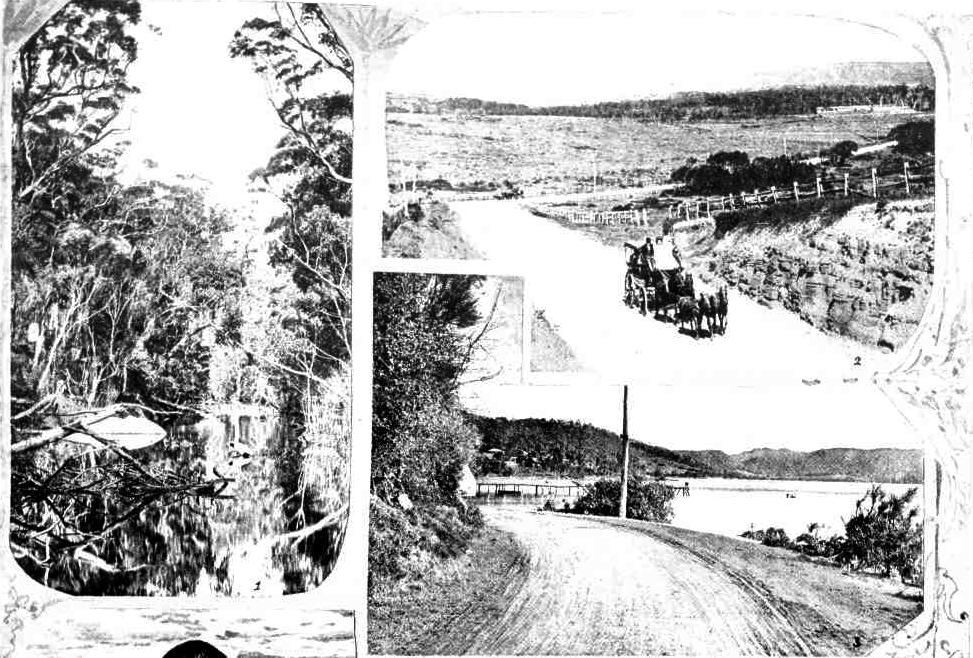
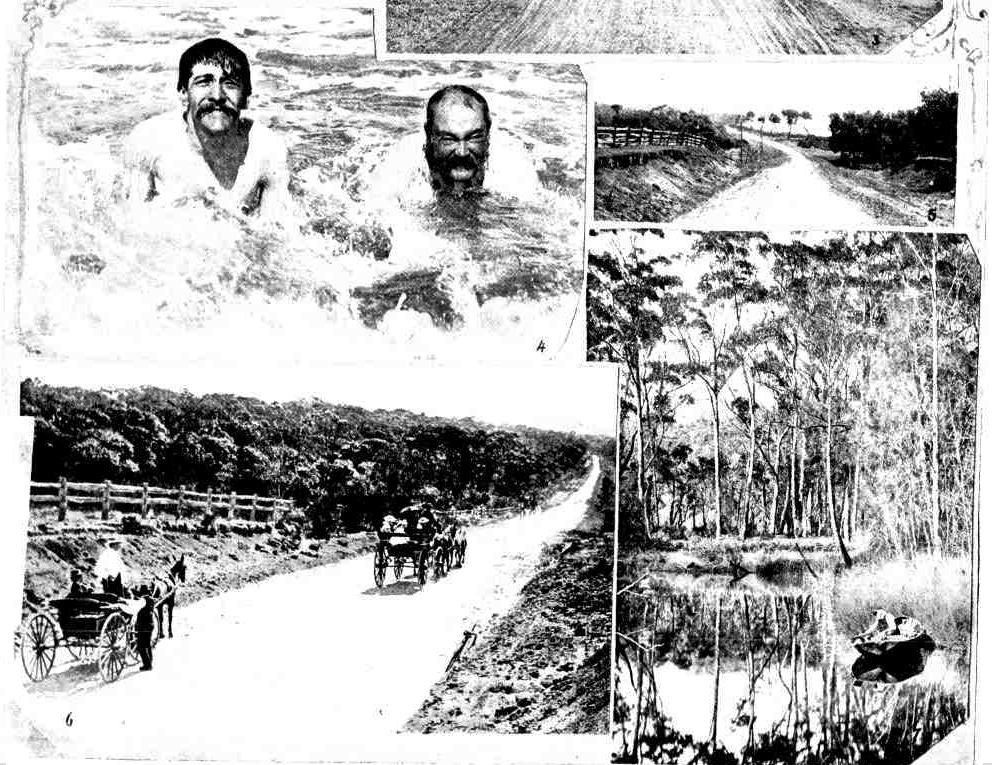
1. On the Narrabeen Lagoon. 2. View from Sheepstation Hill, looking south. 3. Bay View. 4. a dip in the surf at Narrabeen. 5. Near Long Reef. 6. Approaching Narrabeen. 7. One of the creeks.
The distance from Manly to Bay View is about 15 miles. The road is by the Narrabeen-road past Rocklily. A proposal to put down a tram line is now being considered, and a member of the ministry was recently driven over the country, which in many parts is remarkably picturesque.
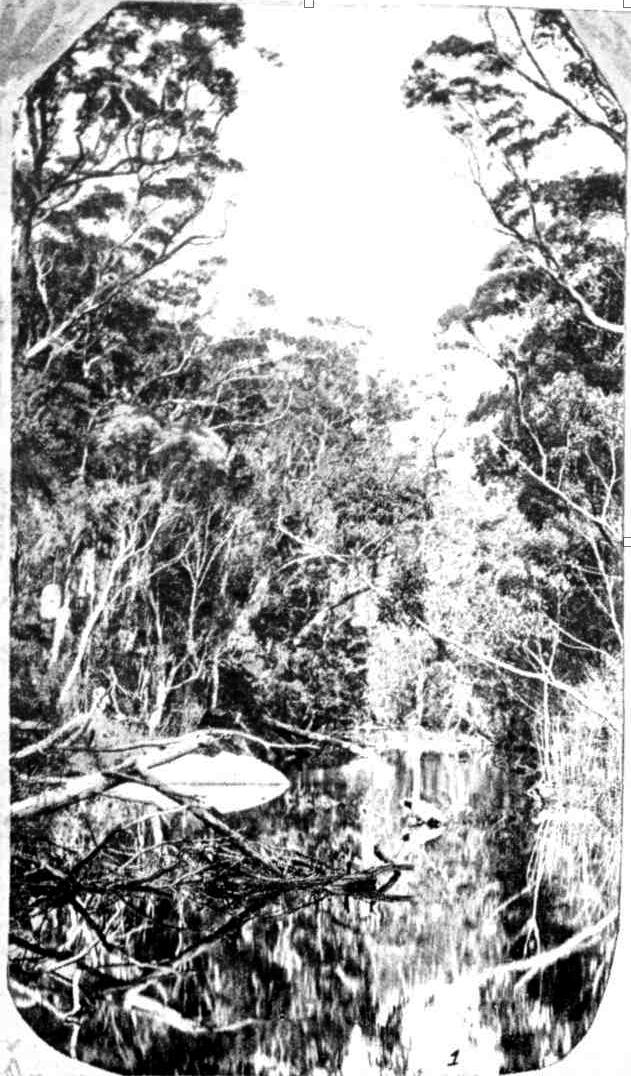
1. On the Narrabeen Lagoon.
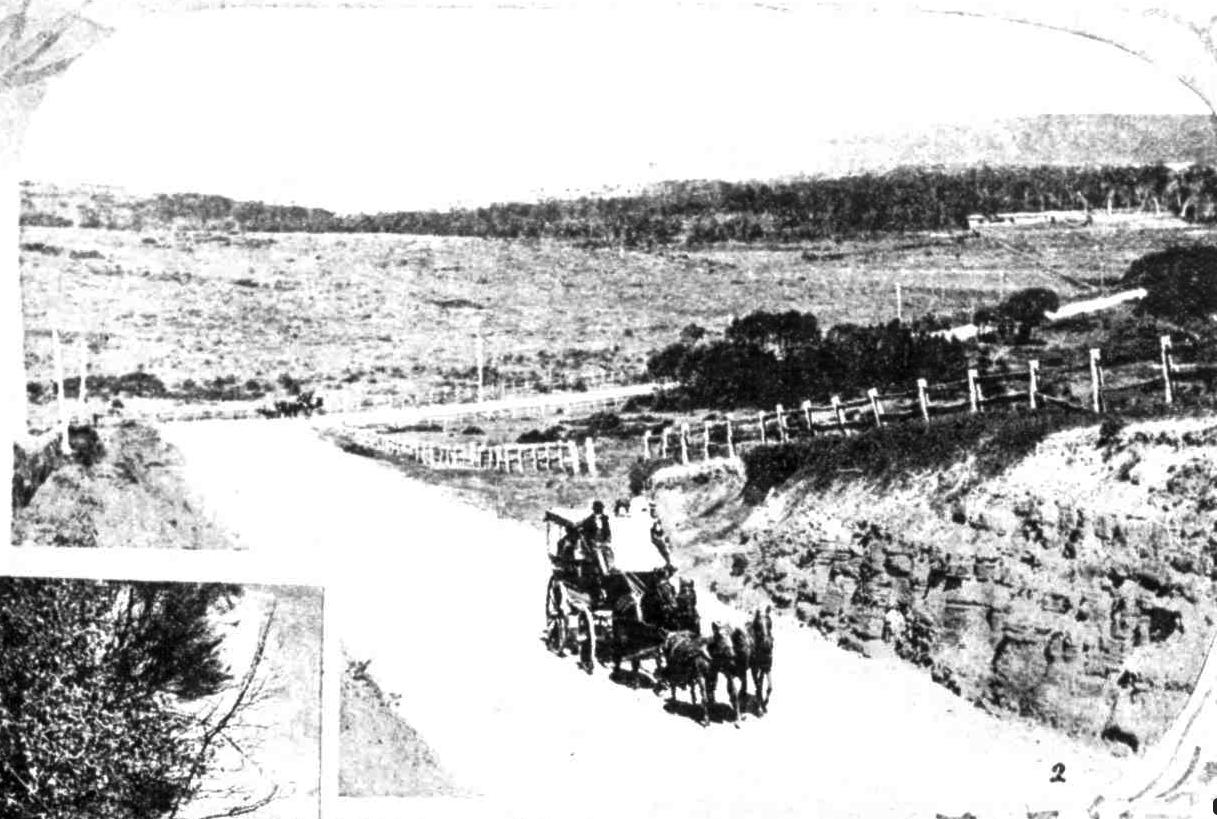
2. View from Sheepstation Hill, looking south.
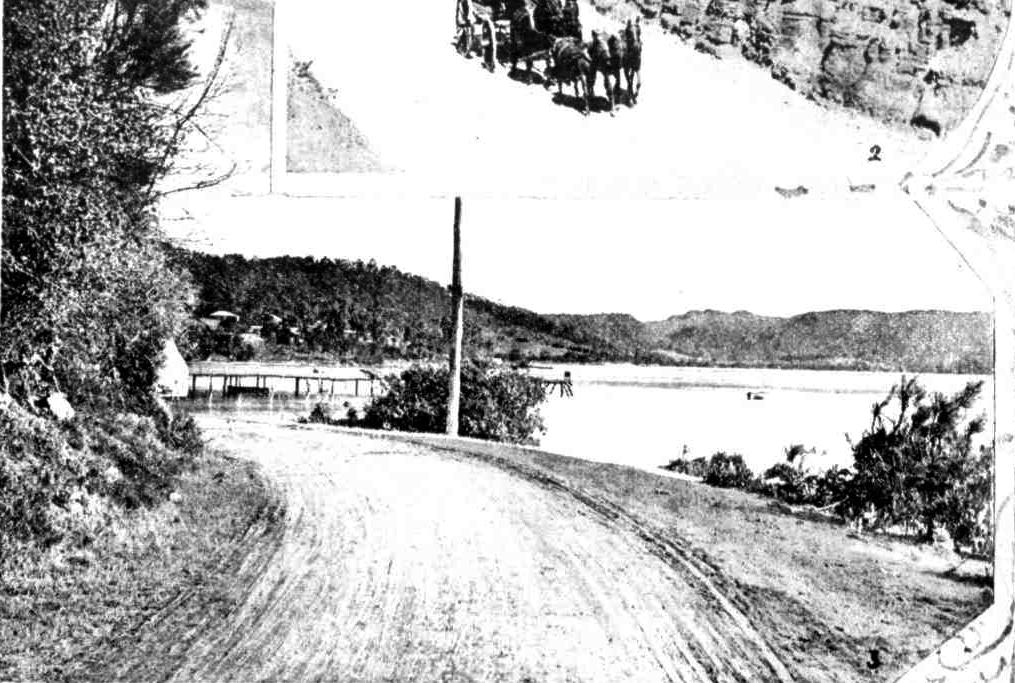
3. Bay View.
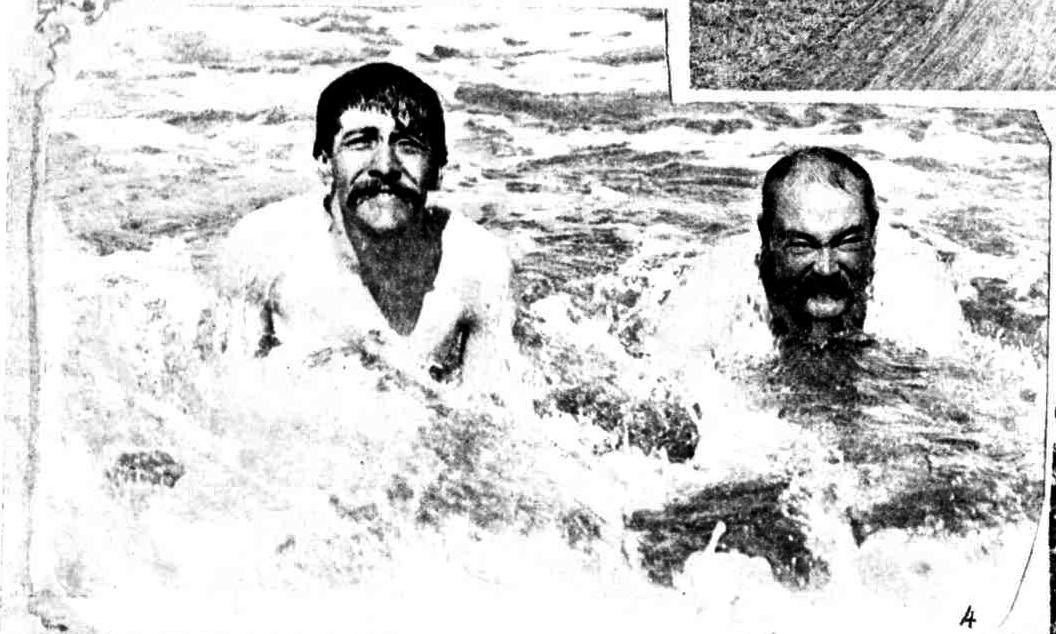
4. A dip in the surf at Narrabeen.
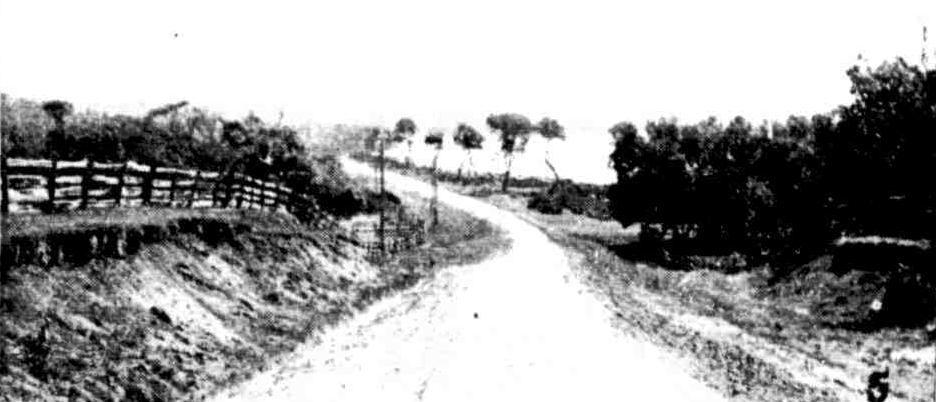
5. Near Long Reef.
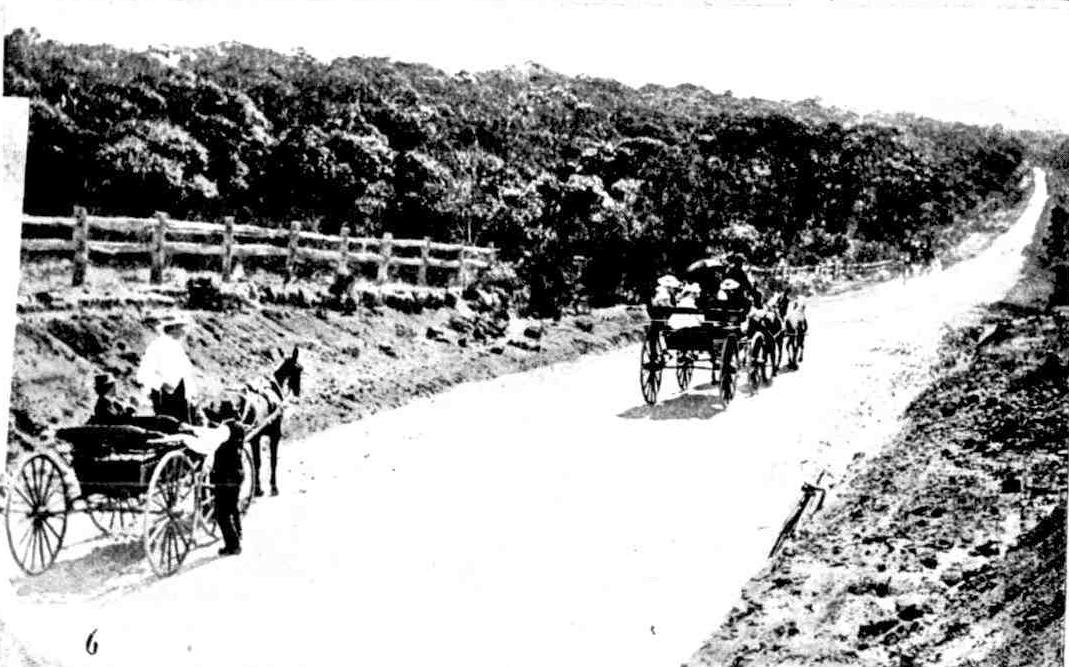
6. Approaching Narrabeen.
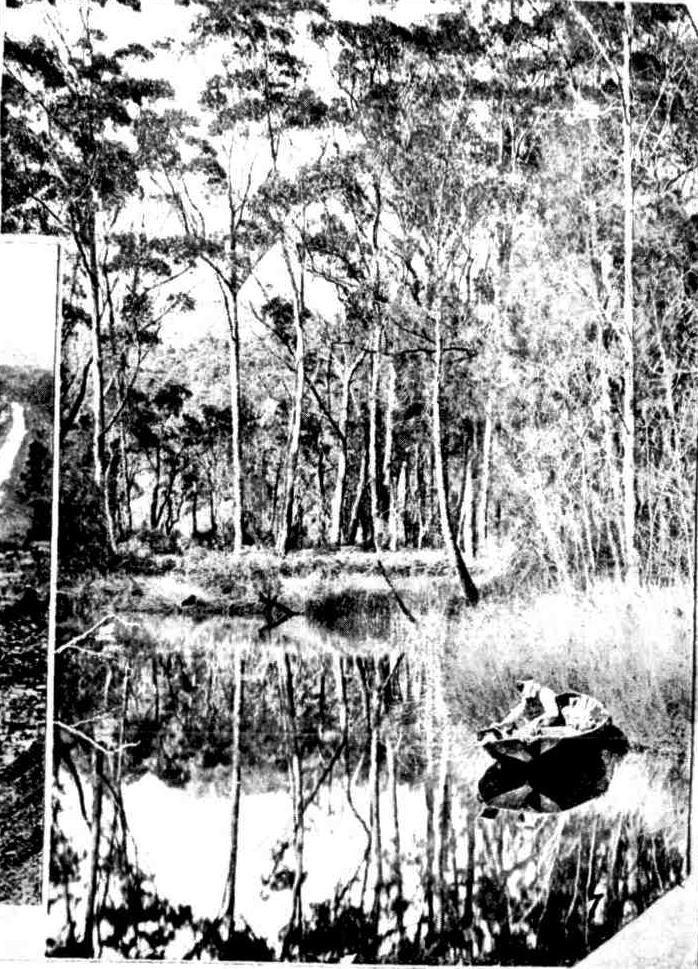
7. One of the creeks.
MANLY TO BAY VIEW—A POPULAR EASTER RESORT BY ROAD. (1900, April 14). The Sydney Mail and New South Wales Advertiser (NSW : 1871 - 1912), p. 878. Retrieved from http://nla.gov.au/nla.news-article165297416
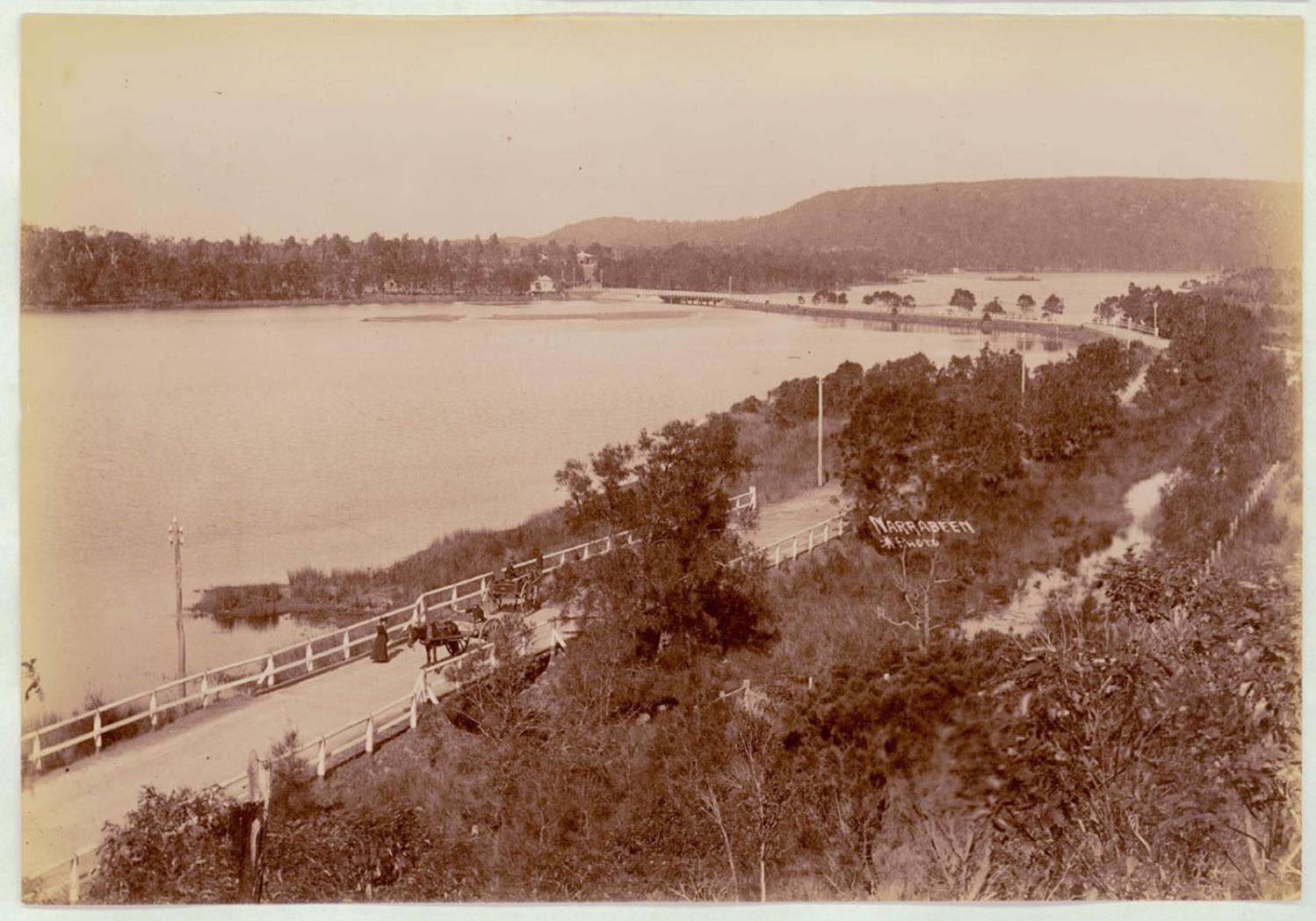
NOTICE UNDER REAL PROPERTY ACT.
APPLICATIONS having been made to bring the lands hereunder described under the provisions of the real Property Act( Certificates of Indefeasible Title will issue, unless Caveats be lodged in accordance with, the Third Schedule to the said Act, on or before the date named opposite each case respectively.
No. 13,759. County of Cumberland, parish of Manly Cove, 1 acre 2 roods 374 perches, 1 acre 2 roods 29 1/2 perches, 1 acre 2 roods 34 perches, 1 acre 2 roods 38 1/2 perches, 1 acre 3 roods 3 1/2 perches, 1 acre 3 roods 8 perches, 1 acre 2 roods 22 perches, 2 acres 2 roods 17 perches, 1 rood 1 perch, 4 acres 1 rood 22\ perches, 3 acres 3 roods 1 1/2 perches, 3 acres 2 1/2 perches, 4 acres 1 rood 22 1/2 perches, 4 acres 12 1/2 perches, 4 acres 1 rood 22 1/2 perches, 4 acres 1 rood 33 perches, 4 acres 18 1/2 perches, 4 acres, 2 roods 34 1/2 perches, 4 acres 2 roods 34 1/2 perches, 4 acres 3 roods 34^ perches, 4 acres 1 rood 21 1/2 perches, 4 acres 3 1/2 perches, 3 acres 3 roods 35 perches, 3 acres 2 roods 39 1/2 perches, 4 acres 3 roods 23 perches, 4 acres 2 roods 32 1/2 perches. 3 acres 36 1/2 perches, 3 acres 2 roods 6 1/2 perches, 2 acres 1 rood £2 perches, 1 acre 35 1/2 perches, 2 roods 15 perches, 2 acres 3 rood, 2 acres 3 roods 16 1/2 perches, 2 acres 3 roods 11 perches 2 roods 30 perches, 3 roods 20| perches, 2 roods 25 1/2 perches 2 acres 2 roods 7 1/2 perches, 1 acre 32 perches, 1 acre 1 rood 20 1/2 perches, 1 acre 3 roods 13 1/2 perches, 361 perches, 3 acres 2 roods 25 perches, 1 acre 3 roods 32 perches, 2 acres 4 perches, 3 acres 2 roods 24 1/2 perches, 2 acres 17 1/2 perches, 1 acre 1 rood 25 1/2 perches, 1 acre 13 perches, 1 rood 6 1/2 perches, 2 acres 2 1/2 perches 3 acres 2 roods 25 1/2 perches, 2 acres 1 1/2 perches, 2 acres 173 perches. 3 acres 2 roods 24 1/2 perches,—comprising lots Nos. 1 to 16, section A; lots Nos. 1 to 16, section B; lots Nos. 1 to 16, section C; lots Nos. 1 to 16, section D; lots Nos. 1 to 16. section .E; lots Nos. 1 to 16, section F; lots Nos. 1 to 7 and 9 to 16, section 6; lots Nos. 1 ti 16, section J; lot No. J, section K; lots Nos. 1 to 42, section L; lots Nos. 4 to 21 and Nos. 25 to 42, section M; lots Nos. 7 to 35, section O; lot? Nos. 1 to 42, section P; lots Nos. 1 to 21 and Nos. 25 to 42, section Q,; lots Nos. 1 to 42, section K; lots Nos. 1 to 36, section S ; lots Nos. 3 to 22 and Nos. 25 to 44, section T; lots Nos. 1 to 44, section U; lots Nos. 1 to 44, section V; lots Nos. 1 to 44, section W; lots Nos. 1 to 21 and Nos. 23 to 42, section X; lots Nos. 1 to 36, section Y; lots Nos. 2 to 21 and Nos. 26 to 43, section Z; lots Nos. 4 to 20 and Nob. 24 to 40, section A1; lots Nob. 1 to 40, section Bl; lots Nos. 1 to 38, section C1; lots Nos. 1 to 14 and Nos. 16 to 27, section D1; lots Nos. 1 to 29, section E1; lots Nos. 7 to 16 and Nos. 22 to 31, section F1; lots Nos. 6 to 9 and Nos. 11 to 14, section G1; lots Nos. 1 to 4, section H1 lots Nos. 7 to 21, section H1; lots Nos. 1 to 16, section K1; lots Nos. 1 to 18, section L1; lots Nos. 1, 2, and 3, section M1; lots Nos. 3, 4, 5, and reserve section Nl; lots Nos. 8 to 11, section M1, and Plateau Park of The Plateau; lots Nos. 2,3,4,7,8, and 9, section No. 33 of Fuller's subdivision; lots Nos. 9 to 14, section No. 41; lots Nos. 9 to 16, section No. 44; lot No. 3, section No. 47; lots Nos. 1 to 16, section No. 50; lots Nos. 1 to 8, section No. 51; lots Nos. 1 to 8, section No. 52 lots Nos. 1 to 16, section No. 53 ; lots Nos. 1 to 20, section No. 54 of Mount Ramsay Estate; lots Nos. I to 10, section No. 54, lots Nos. 1 to 5, section No. 55a ; lot No. 10, section 55a ; lots Nos. 2 to 20, section No. 55 of Fuller's subdivision; lots Nos. 1 to 16, section No. 56; lots Nos. 1 to 8, section No. 57; lots Nos. 1 to 8, section No. 58 ; lots No. 1 to 16, section No. 59 of Mount Ramsay Estate, situated at Narrabeen, in Victoria, Sturt, Lagoon, Ocean, Wellington, Albemarle, Loftus, Octavia, Tourmaline, Emerald, Malcolm, Collaroy, Jenkins, Ramsay, Wetherill, Mason, Fuller, Claudare, Essilia, Stella, Bland ford, Aubreen, Idaline, Hilma, and Alexander Streets, Park Road and Edgecliffe Boulevarde,— being parts of 410 acres (portion No. 1,217 of parish) granted to John Ramsay; adjoining the properties of F. B. Bays, Miss Alice M. Neal, E. J. Black, A. E. C. K. Lindfield, A. Porter, J, Berry, Isabella E. J. Shortland, Sarah Morris and G. Morris, Maude M. Rowson, Elizabeth Campbell, S. J. Fowler, C. Shepherd, G. E. Litchfield, Emily Mason, Amy F. Barton, T. W. Willans, A. Smithson, The Bank of New South Whales, The Salvation Army, Mrs. Mary Ann Osborne, Maria E. Mitchell, Dowling and Sullivan, D, McNab, A. Amos, — Harlow, Christina Beel, The Commercial Banking Company of Australia (Limited), J, Wheeler (junior) and J. Wetherill. Applicant. The Union Bank of Australia (Limited). NOTICE UNDER REAL PROPERTY ACT. (1905, November 17). Government Gazette of the State of New South Wales (Sydney, NSW : 1901 - 2001), p. 7654. Retrieved from http://nla.gov.au/nla.news-article220985744
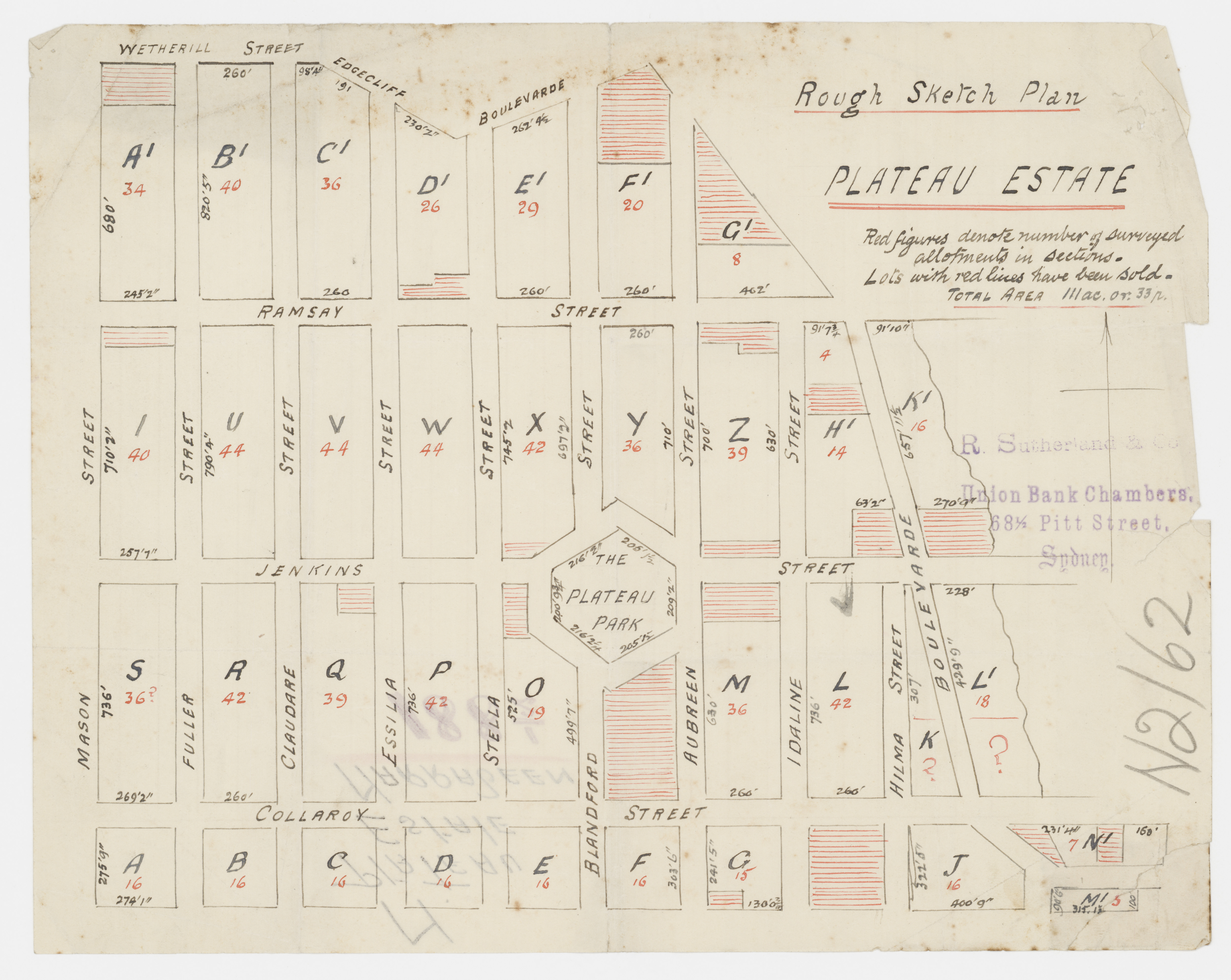
Rough sketch plan , Plateau Estate] - Mason St, Fuller St, Claudare St, Essilia St, Stella St, Blandford St, Aubreen St, Idaline St, Hilma St, Boulevarde, Collaroy St, Jenkins St, Ramsay St - circa 1905-1906. For the Union Bank of Australia (see below). Item: c050370064, courtesy the State Library of New South Wales.
Thomas Henry Green buys this acreage and lots on July 9 1907 and transfers the whole to to Jessie (Nee Bedford) Greenon July 11 1909. Whole of land sales Vol - Fol 1689 - 4 (16 pages available in HRLV - relevant ones to this subject only) - Jessie continues selling these lots until 1947. :
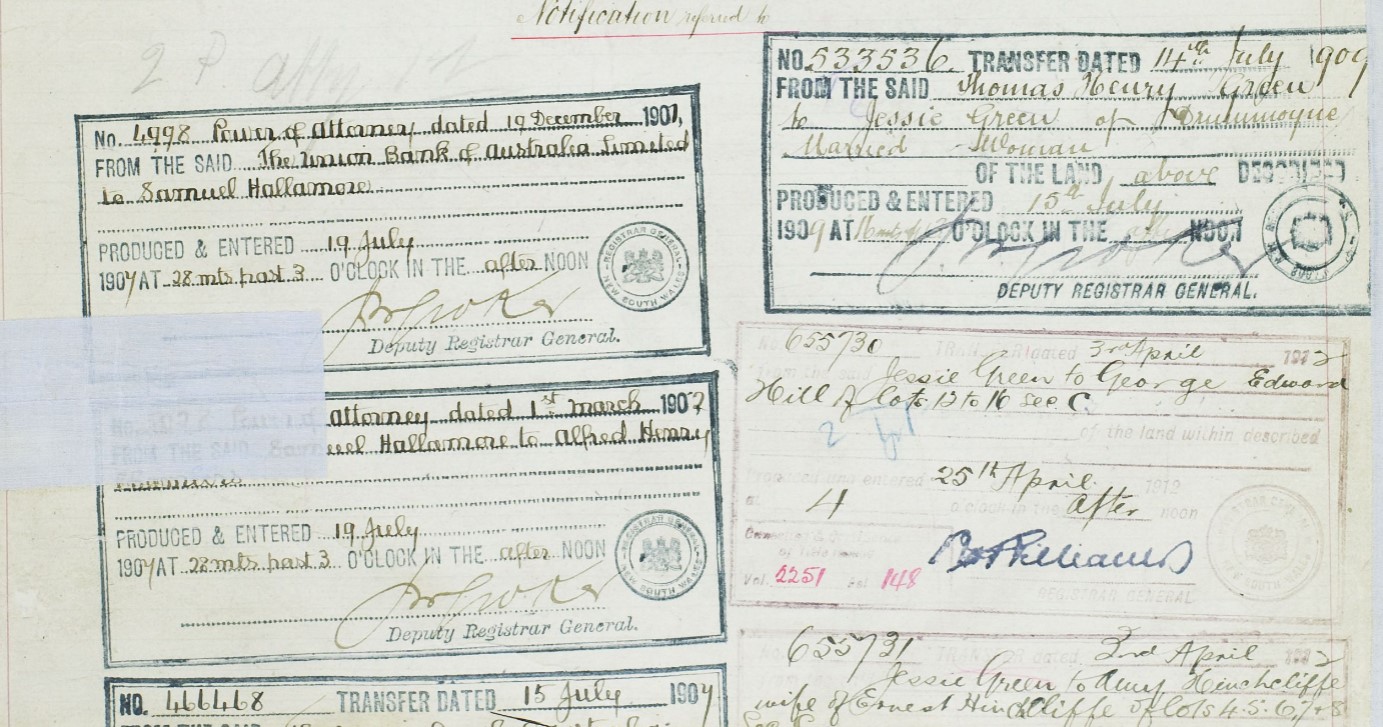
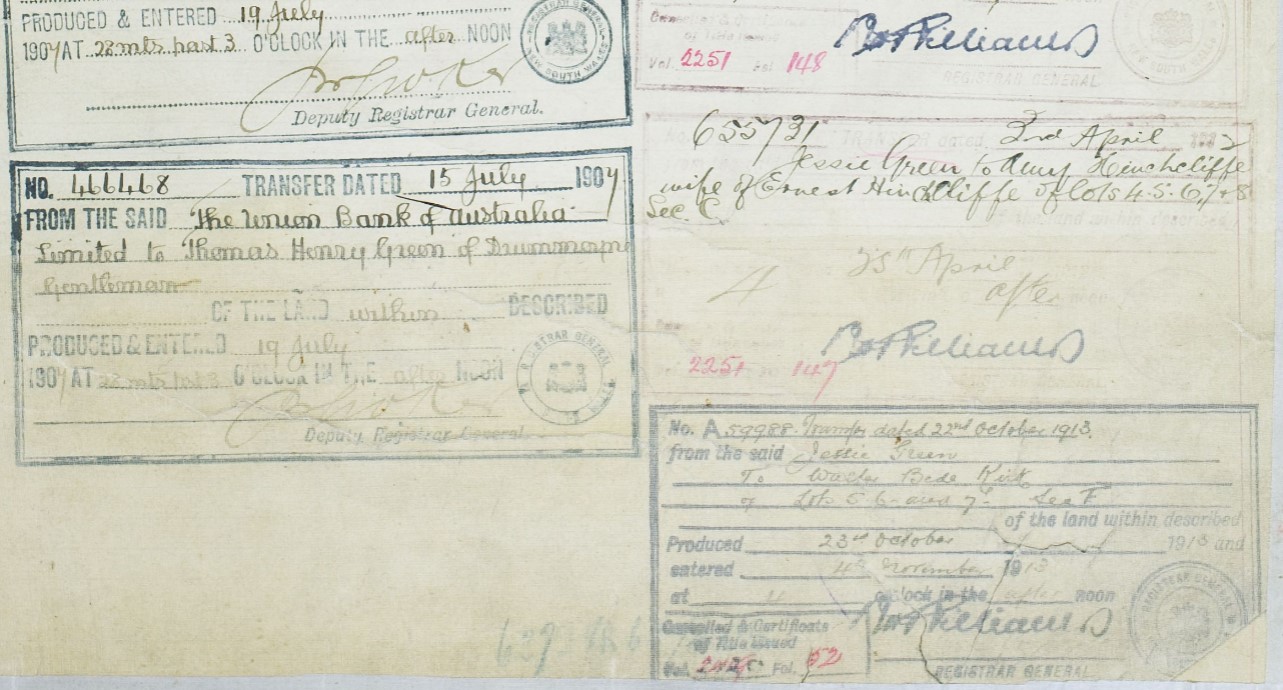
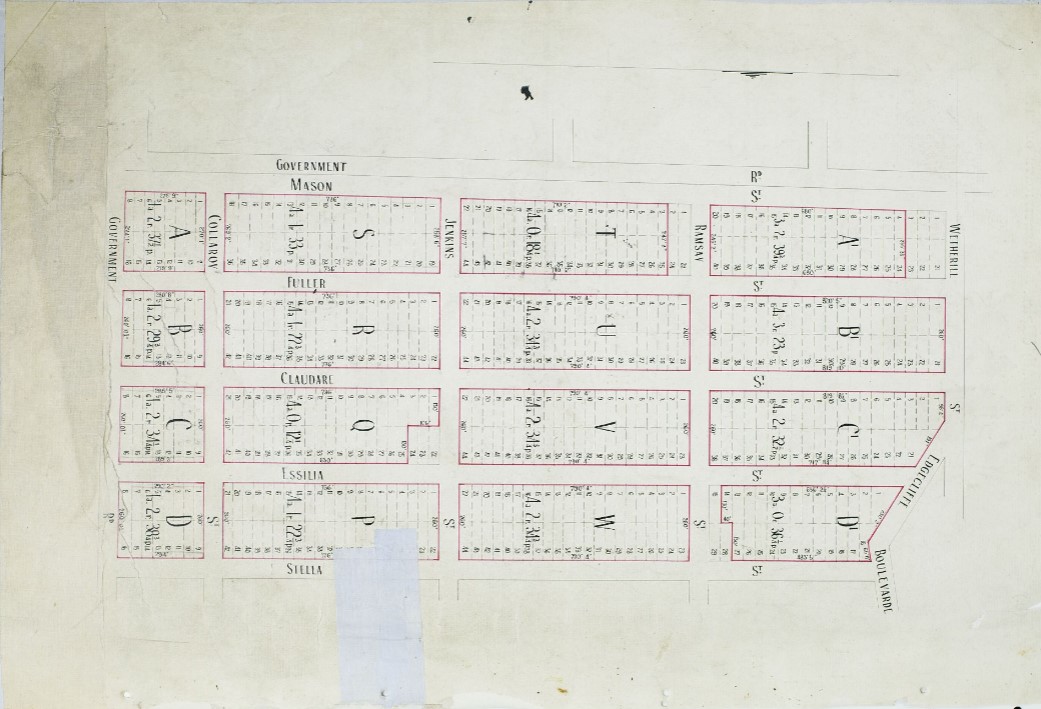
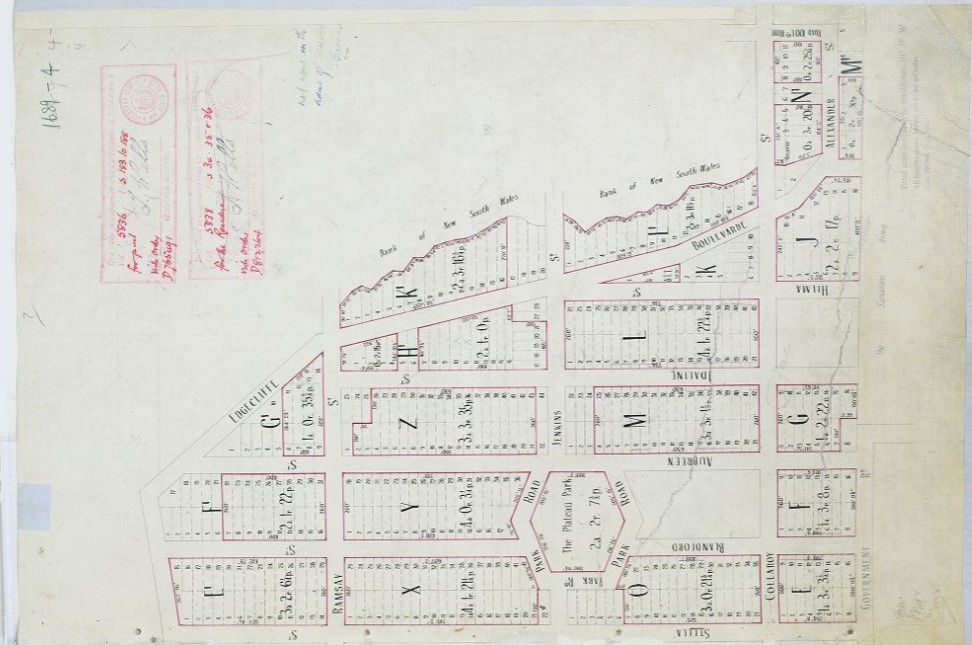
Jessie Green family - Notes
Jessie Green actually owned all of that land from Long Reef to North Narrabeen by then, or was authorised to sell it. Thomas Henry Green of Drummonye ‘gentleman’ actually took over the selling of these lots on July 15 1907 – this then passed to from him to his wife, Jessie Green on July 14 1909 who kept selling the lots from then on until March 27 1947 [Vol/Fol: 1689-4]. She passed away at Manly in 1951, aged 86 according to the NSW BDM’s register.
At the weekly meeting of the Central Licensing Court transfers of publicans' licenses were granted from George Burton to Thomas Henry Green, White-horse Hotel, Drummoyne, …. CENTRAL LICENSING COURT. (1894, December 25). The Daily Telegraph (Sydney, NSW : 1883 - 1930), p. 2. Retrieved from http://nla.gov.au/nla.news-article236121979
The White Horse Hotel opened in what was then Cambridge Road in around 1880 and was forced to close in 1911 when the government decided that there was too many pubs in Sydney.
METROPOLIAN WATER, SEWERAGE AND DRAINAGE
ACT, 1924-1945.
Water Supply Purposes (Site fob Reservoir) : Collaroy.
Acquisition of Land.
APPLICATION by The Metropolitan Water, Sewerage and Drainage Board having been made that the land described 111 the Schedule hereto be appropriated or resumed for water supply purposes (site for a reservoir), IT IS HEREBY NOTIFIED £ND DECLARED by His Excellency the Governor, acting with the advice of the Executive Council, and by the Minister for Public Works, that so much of the said land as is Crown land is hereby appropriated and so much of the said land as is private property is hereby resumed under Division 1 of Part V of the Public Works Act, 1912, for the purposes aforesaid; AND the Minister for Public Works hereby further notifies that the said land is vested in The Metropolitan Water, Sewerage and Drainage Board.
Dated at Sydney, this eighth day of December, 1948.
J. NORTHCOTT, Governor, J. J. CAHILL, Minister for Public Works.
* Schedule.
All that piece or parcel of land containing 38 ½ perches or thereabouts, having a frontage of 80 feet 2 inches to Aubreen-street, situate in the Shire of Warringah, parish of Manly Cove, county of Cumberland, and State of New South Wales, being lots 21 and 22, section Z, of the Plateau Estate, and said to be in the possession of Mrs. Jessie Green. (Misc. 489,236) * (4331) METROPOLIAN WATER, SEWERAGE AND DRAINAGE ACT, 1924-1945. (1948, December 17). Government Gazette of the State of New South Wales (Sydney, NSW : 1901 - 2001), p. 3390. Retrieved from http://nla.gov.au/nla.news-article224785396
Warringah Shire Council selling her land out from under her after she had passed away:
20. Jessie Green, of Manly, and William Arthur Richards, of Petersham; overdue rates, £57 4s. 5d.; land, lot 4, section F, Blandford-street, Collaroy Plateau. SHIRE OF WARRINGAH.—LAND TO BE SOLD FOR DEFAULT. (1954, May 28). Government Gazette of the State of New South Wales (Sydney, NSW : 1901 - 2001), p. 1629. Retrieved from http://nla.gov.au/nla.news-article220375209
CITY WEDDING
DIGBY-BENNET—GREEN
Rev. P. A. Micklem, at St. James's, city, on Saturday afternoon, celebrated the marriage of James Digby-Bennet, only son of the late Mr. George Digby-Bennet, of Adelaide, and Mrs. Digby-Bennet, with Beatrice Alice, daughter of the late Mr. T. H. Green, and Mrs. Jessie Green, of Manly.
The service was fully choral. The bride wore a frock of ivory-tinted marocain and georgette, having a knife-pleated jupe and a pale pink and white girdle. Her white hat was adorned with pink and white tulle, which fell in long streamers to the hem of her skirt, She carried a bouquet of pink carnations and maiden hair fern tied with pink and white tulle streamers. Miss Dorothy Wootlcy -the bridesmaid— was in a quaint Early Victorian gown of almond green marocain veiled in ecru lace, and finished with a hand-made posy. A poke hat to tone trimmed with buttercups and a bouquet completed her toilette. Mr. George Ryrie was best man. The reception, followed by a dinner, was held at the Felix Cafe. King Street, the room being massed with white roses.
Mrs. Jessie Green received in a handsome gown of black matclasse, set off with oriental shades. Her upturned black hat was adorned with a black plume. She carried a shower bouquet of red roses. Mrs. Dorothy Maas, the bride's sister, was in a gown of black marocain worn with a grey hat swathed with grey georgette caught with a bunch of red roses, her bouquet being of the same flowers.
The guests included Mr. and Mrs. George Green, Mrs. Hastings Woolley, Mr. and Mrs. C. G. Rigdon, Mr. Darcy Osborne, Mrs. Arnold Liney, Mrs. E. A. Thomas, Mr. Norman Mack, Mrs. W, Simms, Mr. S. Hill, Mrs. E. Albert, and Mr. G. Gate. Later Mr. and Mrs. Digby-Bennet left for the South Coast, the bride wearing a smart gown of French grey marocain, embroidered in nattier blue. Her blue hat was wreathed with champagne tinted flowers. CITY WEDDING (1923, October 29). The Daily Telegraph (Sydney, NSW : 1883 - 1930), p. 3. Retrieved from http://nla.gov.au/nla.news-article246002117
GREEN, Jessie.-September 29 1951. In hospital. Manly, and of 19 Lombard Street. Balgowlah, relict of the late George Henry Green and loving mother of George, Dorothy and Beatrice, and loved aunt of Fred Seymour aged 86 years. At rest.
GREEN.-The Relatives and Friends of the late Mrs. JESSIE GREEN are kindly Invited to attend her Funeral to leave Our Private Chapel. 32 Sydney Road, Manly, on Tuesday Morning, October 2. after a short service commencing al 10.30 a m.. for Manly Cemetery. F TIGHE AND CO A.F.D A 32 Sydney Rd. Manly. XU4S29. Family Notices (1951, October 1). The Sydney Morning Herald (NSW : 1842 - 1954), p. 10. Retrieved from http://nla.gov.au/nla.news-article27531305
Marriage: 514/1904 GREEN THOMAS H to BEDFORD JESSIE at SYDNEY
Other family records state:
Jessie (Bedford) Green (1855 - 1951). Born 26 Nov 1855 (? or 1865 ?) in Bethnal Green, Middlesex, England, United Kingdom, Died 29 Sep 1951 at age 95 in Manly, Daughter of Christopher Bedford (abt 1829 - 08 Aug 1882 London Tower Hill, London, Middlesex, England) and Elizabeth Farmer (02 Oct 1825 - before 1870, Whitechapel, Middlesex, England).
Her father had more children with an Elizabeth Farmer: Jessie was a sister of Isabella (Bedford) Seymour [half] - and through her marriage, a sister-in-law of Elizabeth Green [half], Frederick Richard Green [half] and Ellen (Green) Kitteridge [half].
Isabella (Bedford) Seymour (Born 1 Jan 1855 in Bethnal Green, Middlesex, England, United Kingdom, Died 5 Jan 1931 at age 76 in Leytonstone, Essex), Daughter of Thomas Green and Elizabeth Farmer. Wife of Walter Edwin Seymour — married 8 Jul 1878 in Leytonstone, Essex, England
Jessie became the Wife of Thomas Henry Green — married in 1904 in Sydney, New South Wales. Thomas Henry Green was born 1853 in Kent, England, United Kingdom, the son of Thomas Green and Caroline Rosina Freame.
NSW BDM’s births - children - registered prior to their marriage in 1904 for some reason:
GREEN DOROTHY I 10895/1888 to HENRY and JESSIE at WAVERLEY
GREEN GEORGE H 6016/1890 to THOMAS H and JESSIE at BALMAIN
GREEN BEATRICE A 5581/1892 THOMAS H JESSIE at BALMAIN
Eldest daughter’s marriage: 9499/1916 MAAS WILLIAM to GREEN DOROTHY registered at SYDNEY
Son George Henry's marriage to Laura Hathaway (1896-1957) - they were the only ones shown to have had children, 2, one named Dorothy, who went on to have 4 children: 19144/1920 GREEN GEORGE H to HATHAWAY LAURA B registered at MANLY
Dorothy Isabella (1888-1970), George Henry (1890-1957), Beatrice Alice (1892-1975).
Deaths: Thomas Henry Green. Born: 1853 Died: 3 Mar 1923. Age: 70. Cemetery: Manly
GREEN.-March 7. 1923 at his residence, 5 Smith street, Manly, Thomas Henry Green, aged 70 years. Family Notices (1923, March 8). The Sydney Morning Herald (NSW : 1842 - 1954), p. 8. Retrieved from http://nla.gov.au/nla.news-article16058237
NSW BDM's - Deaths:
GREEN THOMAS H 3882/1923 parents: THOMAS and CAROLINE registered at MANLY
GREEN JESSIE 26755/1951 father CHRISTOPHER aged: 86 YRS registered at MANLY – born 1865 - so Thomas Henry Green would be 12 years older than Jessie if this is correct?
RE intestate estate of JESSIE GREEN, late of Balgowlah, in the State of New South Wales, deceased.—Letters of administration de bonis non administratis granted by Supreme Court of New South Wales on 24th September, 1957.—Pursuant to the Wills, Probate and Administration Act, 1898-1954, Testator's Family Maintenance and Guardianship of Infants Act, 1916-1954, and Trustee Act, 1925-1942, Permanent Trustee Company of New South Wales Limited, the administrator of the estate of the said Jessie Green, who died on 29th September, 1951, hereby gives notice that creditors and others having any claim against or to the estate of the said deceased are required to send particulars of their claims to the said administrator at 23-25 O'Connell-street, Sydney, on or before the 12th December, 1957, at the expiration of which time the said administrator will distribute the assets of the said deceased to the persons entitled, having regard only to the claims of which it then has notice.—Dated this 30th day of September, 1957. DETTMANN, AUSTIN & MACLEAN, Proctors for Permanent Trustee Company of New South Wales Ltd., F. R. Garland, Manager. 1327—£1 5s. RE intestate estate of JESSIE GREEN, late of Balgowlah, (1957, October 18). Government Gazette of the State of New South Wales (Sydney, NSW : 1901 - 2001), p. 3327. Retrieved from http://nla.gov.au/nla.news-article220358395
Isabella, Jessie's sister, and wife of Walter Edwin Seymour was the mother of of Frederick Victor Seymour – who was Husband of Edith Lillian (Smith) Seymour — married at Gosford. They were the parents of Phyllis Bedford (Seymour) Williams, Alex (Seymour) Hughes and Laurel Edith (Seymour) Cawthorne.
Phyllis Bedford Williams formerly Seymour, daughter of Frederick Victor Seymour and Edith Lillian (Smith) Seymour, Sister of Alex (Seymour) Hughes and Laurel Edith (Seymour) Cawthorne and Wife of Francis Hayden Williams — married 1936 in Manly - came to live on land at Narrabeen her and her husband could afford to buy due to £ being made available from Jessie's estate.
Family anecdotes, retold by Phyllis Bedford Williams to Roslyn Burge in 2001, Interviewer for Australian Centre for Public History University of Technology, Sydney, Broadway, stated:
''She lived with this aunt, her grandfather and two older boy cousins who had been orphaned until she finished primary schooling. Meanwhile her birth family moved to North Ryde and her father built a home there before moving to Collaroy in 1926. Mrs Williams visited the family at weekends and holidays and in one sense has an ongoing sense of being part of the family – yet also articulates her sense of never fitting in. She felt closer to the aunt she grew up with than her own family.
She talks about studying at Fort Street, her persistence in studying sewing at East Sydney Technical College and her sewing became the back stay of the family’s finances.
Mrs Williams met her husband in the Narrabeen church fellowship and after a courtship of some years they married in 1936. Her husband had been unemployed for part of the early 1930s and he’d bought a smallgoods delivery business. Buying house in Collaroy. Evaluation of interview [include: surroundings in which interview was undertaken; difficulties encountered; special features; and responses of interviewee to interview (eg shy; confident)] Mrs Williams is in her late 80s but has plenty of energy. The sound of a grass trimming machine and a lawn mower intrude loudly at various times. However the interview could not be aborted.
Mrs Williams is a small, compact woman, moves with agility and is quite definite about what she chose to do in life. She is also quite definite in her views of family member’s actions.
Her mother had the “restaurant” beside the silent picture show and people would buy their soda fountains there. Her father was a builder and he helped build a breakwater/reinforcing after the great storm of 1920 washed out the beach. In 1945 “sea came in again - and took a number of houses out to sea. “The light was still going in one house as it went out to sea… until the electricity wire broke”.
Father worked as maintenance man at Inglis, Billy tea makers in city. Her grandmother was Jessie Green who owned large parcel of land. Jessie came from UK aged 17 to escape an older man. He followed her and they ran a pub together in Drummoyne. In 1904 they came to Manly and Jessie brought large tract of land. Three children of Jessie’s were illegitimate and unable to inherit. They fought through courts and father won £75000 pounds: father died by then and Phyllis and 2 sisters each got £24,000, “enough to buy this house”.
Husband unemployed for 4 years. Worked for McIlwraths but they sacked him when he turned 21. He had a butter and egg run until wartime and then no petrol and had to give that up. Then worked at AWA in plating section – acid baths.
Phyllis lived Wetherill Street, Narrabeen for 32 years. Leisure – pictures 1/-, fellowship at church, picnics, Douglass’ Boats. 6 months at Narrabeen school when she came to the city for a back op. Happy to live on the plateau. Doesn’t always like the smell of the sea.
Remembered Mr Monk and his wife and kids coming round selling fruit and vegies. Greenwood Real estate, Keith Parr in the paper shop. McCleans (?sp) wineshop at Narrabeen near the school.
Father was carpenter and builder – when mother met him he was helping building houses in Wyong. Father was English – he’d been at sea and in 1800’s jumped ship. They were introduced by her mother’s niece. Parents only lived in Wyong a couple of years. Still a baby when they left and went to North Ryde. His aunt – Jessie Green – had a lot of land and she gave him couple of blocks on Cressy Road. Father built house and sold it. Mum was always living in a half finished house. From 15 months old Phyllis was sent to live with her aunt who was unmarried and looked after her father on the farm. Aunt also looked after 2 other boys – made orphans in 1904 – brought those boys up. Youngest boy was 11 when Phyllis went there. The boys were her mother’s eldest sister’s children. (Mother was one of 4 girls.) Had to milk the cow, make the butter, pack the fruit from the orchard for market. Phyllis had to collect sticks for the fire. Went to Wyong Creek School (about 1.5 miles away from the house). Had to go to the orchard gate, another long walk to the next gate, down a lane, across a bridge over the creek and up the other way to the school. Neighbours – 2 houses and an old lady and her husband who was a bullock driver. Mrs Manning had 5 children and lived in really old house – eldest went to school.
Alice Elizabeth Heaton Smith. Looked at her more as a mother than her own mother. At school holidays always taken to live with her family – came by train, ferry to Manly, another tram to Collaroy.
In 1919 family came to Collaroy and built the house. Lived next door while they built the house. Big stone foundation – great slope to the land – one storey at one end and 3 stories at the back. Creek at the back of the land. Father built stone wall on perimeter. From The Avenue to Phyllis house was a walking track, no road, had to carry all the material up a steep track.
The houses were all weekenders – people came mostly for holidays. Phyllis met one girl, Nancy Thom. Phyllis was only there at weekends and holidays. Rays lived next door and came down for holidays. Family – managed to fit in – always felt a bit out – did all my life. Never got on with my sisters very much. Second sister was jealous about Phyllis living away – aunt would say Phyllis needs a new pair of shoes or Phyllis needs a new dress. Mother would say she’d just bought one for Alex and would have to send that. Auntie Effie was a good seamstress and made clothes for Phyllis.
Marriage – didn’t have a penny – made her own wedding dress, made her Honiton lace veil – made her sister’s dresses too. Married in Presbyterian church at Narrabeen and reception at the Masonic Hall (father was a Mason) along the main road. It was the first place in Collaroy to have electricity (1926). They could see the lights go on from the house, lights just along the main road. Everything was pitch black.
Dressmaking at home is what kept us going. Husband didn’t earn that much money – couldn’t have lived on his salary alone – just worked together, didn’t think about. Used to make wedding dresses and all kinds of things. Had the children too by then. 1939 – lost twins – pretty sick with that. 1941 - David, 1943 - Bruce, 1946 – Owen, 1948 – Trevor, 1954 – Bonny. Twins born at one-nurse hospital at Collaroy – she took fits, eclampic (excessive albumin in the blood) fits, took 5 fits. Babies were still born – 8 months and 2.5 lb each. Had to call another doctor in – Dr Black (he was hopeless). Phyllis swelled up – he was treating sister later and was called up – just went off without telling patients. Called old doctor in – it was he who saved Phyllis. (He’d been up the islands and he’d been rude to Phyllis’ husband so she wasn’t allowed to go back to him.) After 2 weeks in hospital she went back to sewing at home. Money was always very scarce – if you take care of the pennies the pounds will look after themselves. Always tried to save.
Affinity with the area – selling houses in Wetherill Street in 1970 for units. Came to Fuller Street in 1970. Sand and metal people moved in next door and the sand came over the fence. Had to sell with the lady next door – only had 40 foot blocks, couldn’t sell that size for units. 5 blocks sold together. Didn’t mind leaving that part of Collaroy – had to come somewhere she could afford to buy.
Phyllis Bedford Williams (Seymour), Born 1913 – at Wyong opposite the water tank for the trains Born at home – only one doctor in the district. Chandelier fell on the table and that brought on the birth. First child – another sister 16 months later, then another sister 6.5 years later. ''
NSW BDM’s: birth: SEYMOUR PHYLLIS B 39404/1913 to FREDERICK V and EDITH L GOSFORD
Parents marriage: 14077/1912 SEYMOUR FREDERICK V to SMITH EDITH LILLIAN at GOSFORD
Father's Death: SEYMOUR FREDERICK VICTOR 26239/1961 parents: ''ALBERT EDWARD'' and BELLE (Isabella) registered at BANKSTOWN
Edith (Smith) Seymour (Born 18 Jan 1882 in Burwood, New South Wales, Died 14 Jul 1960 at age 78 in Wahroonga) was a daughter of William Governlock Smith (06 Oct 1842 - 10 Jan 1920 Waverley) and Ann Smith (30 May 1846 - 12 Apr 1912 Clerkenwell, Middlesex, England). Alice Heaton (Eaton ?) Elizabeth Smith (18 Jun 1871 - 21 Jan 1950) was one of the 9 children of William Governlock (1842-1920) and Ann (1846-1912) Smith.
Children of Frederick Victor (1887-1961) and Edith Lillian (1882-1960)Seymour were:
Phyllis 1913-2009 (married Francis Williams 1905-1967), Alexia Seymour 1914-2001 (married Arthur Hughes 1907-1901), Laurel Seymour 1919-2011( married Bernard Cawthorne 1919-1968).
The shire of Warringah commencement - access to + acquiring public spaces for then + future generations; narrabeen headlands, parks, beach access
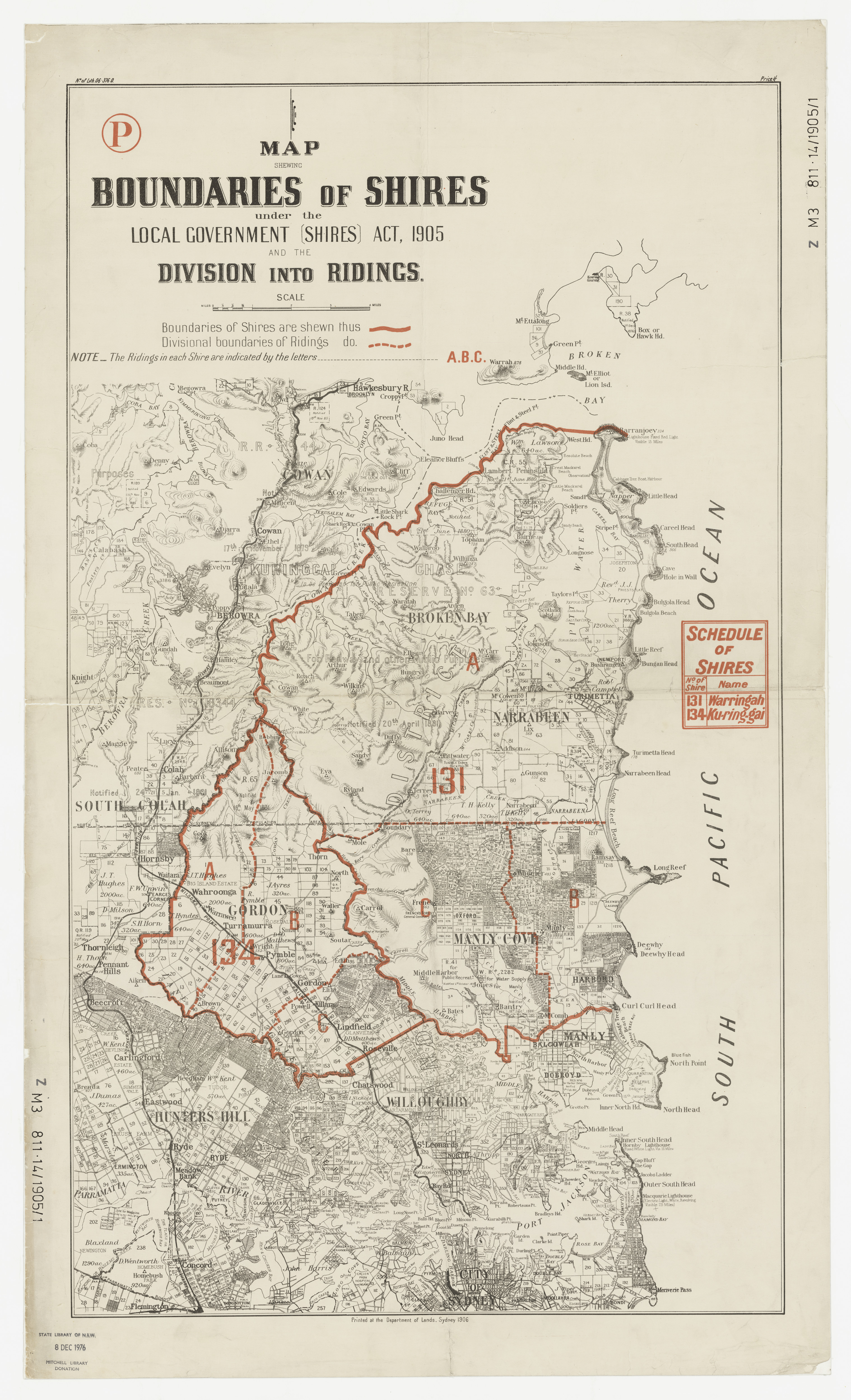
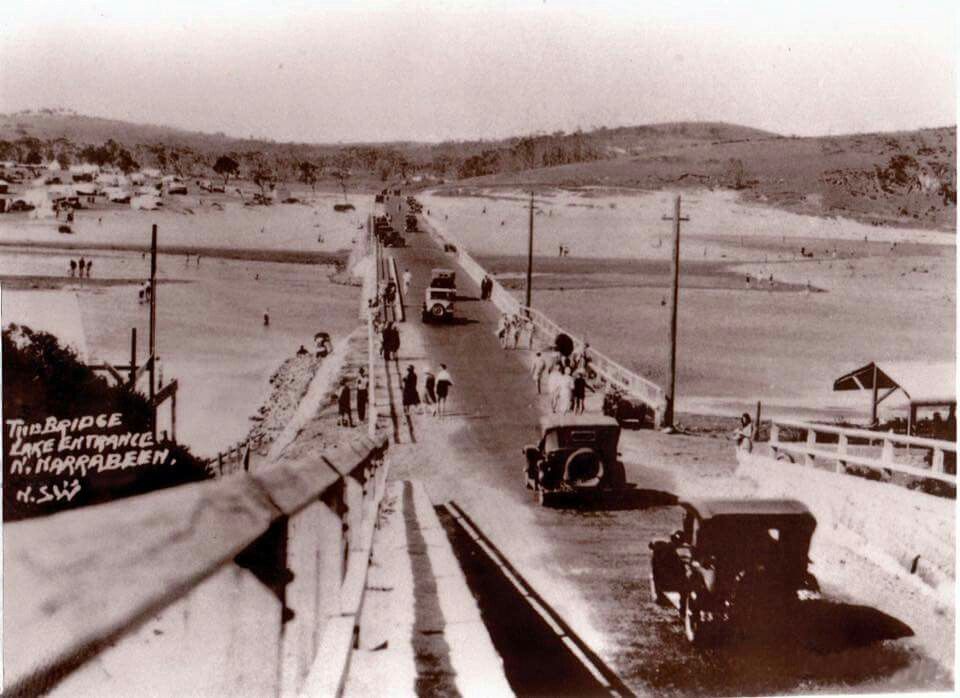
Buying Land for Parks & beach access

BIRDWOOD PARK. The land purchased by the Warringah Shire Council to give the public a right of way to Narrabeen Beach has been christened Birdwood Park. BIRDWOOD PARK (1916, December 28). The Sun (Sydney, NSW : 1910 - 1954), p. 4 (FINAL EXTRA). Retrieved from http://nla.gov.au/nla.news-article223373938
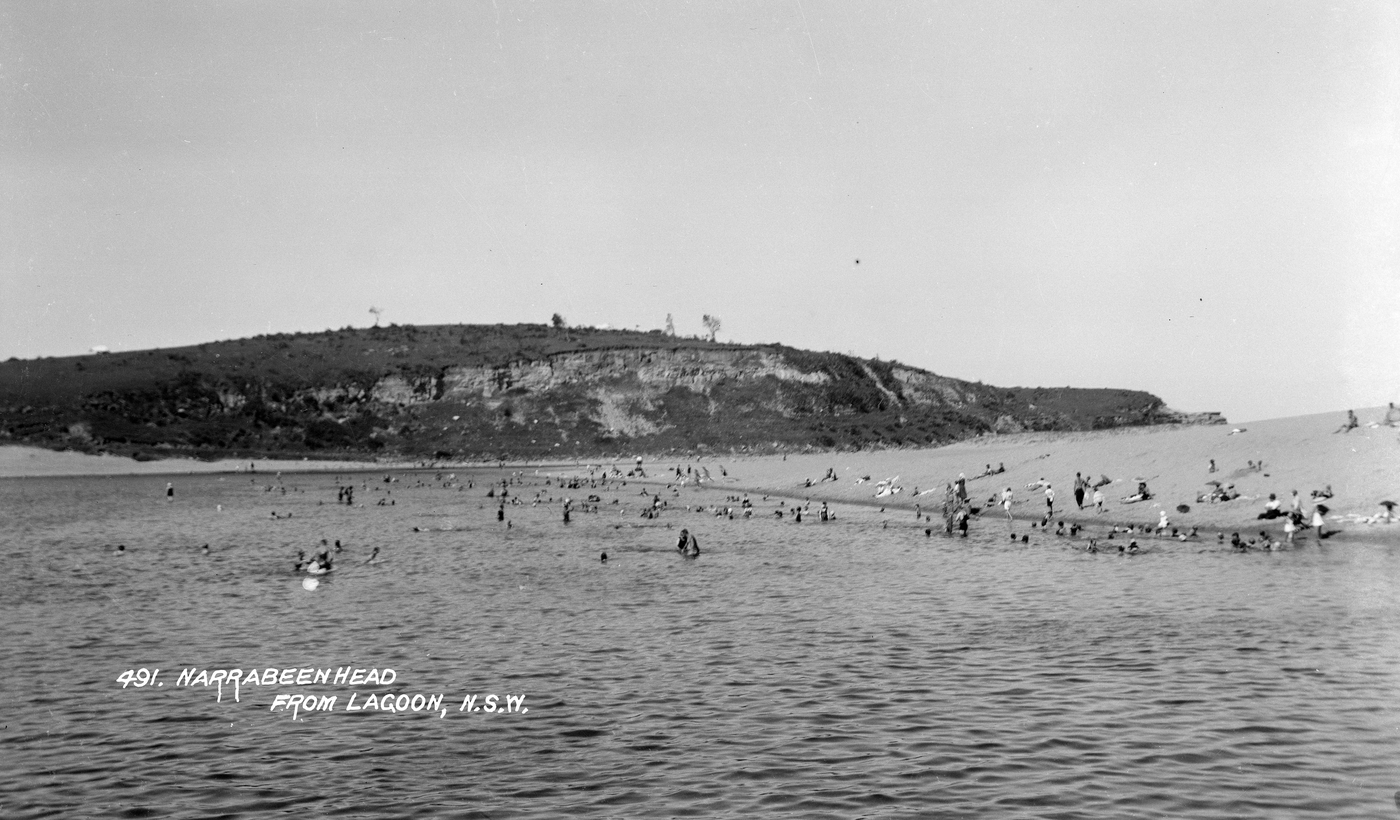
Narrabeen Head from Lagoon, circa 1928, from Album 'Samuel Wood - postcard photonegatives of Narrabeen,' - Item a1470094h, courtesy State Library of NSW
Field Marshal William Riddell Birdwood, 1st Baron Birdwood, GCB, GCSI, GCMG, GCVO, CIE, DSO (13 September 1865 – 17 May 1951) was a British Army officer. He saw active service in the Second Boer War on the staff of Lord Kitchener. He saw action again in the First World War as Commander of the Australian and New Zealand Army Corps during the Gallipoli Campaign in 1915, leading the landings on the peninsula and then the evacuation later in the year, before becoming commander-in-chief of the Fifth Army on the Western Front during the closing stages of the war. He went on to be general officer commanding the Northern Army in India in 1920 and Commander-in-Chief, India, in 1925.
Birdwood was made Baronet of Anzac and of Totnes, in the County of Devon, on 29 December 1919. He toured Australia to great acclaim in 1920, visiting Narrabeen and the site named to honour him:
GENERAL BIRDWOOD.
ACTIVE TIME IN SYDNEY.
Yesterday Sir William and Lady Birdwood enjoyed a launch trip in delightful weather on the waters of Kuring-gai Chase, and a motor Journey to Newport and Manly, thus gaining an excellent opportunity of seeing some of the beautiful scenery about Sydney. The party included Sir George Fuller and other Ministers. 0n the way from Newport to Manly a call was made at Furlough House, Narrabeen, where the guests were received by Lady Fuller and Mrs. Cooper Day, secretary of Furlough House, and entertained at afternoon tea. General Birdwood was very much interested in the scheme for enabling soldiers' wives and dependents to enjoy a holiday at this pleasant spot.
To-day, about 11.40 a.m., General Birdwood will inspect the Matraville Garden Village for soldiers. Originally this engagement was fixed for 3 p.m., and the change involves the cancellation of a large part of the programme arranged for the day. The Senior Cadets and Boy Scouts, who were notified to muster at Beauchamp-road at 2.30 p.m., will not be required. Many prominent citizens had accepted invitations to the village, and the board will welcome any who can attend the less picturesque event in the morning. After General Birdwood has inspected the village, which now consists of 50 fine cottages, he will motor to the city, and lunch, as arranged, with the Voluntary Workers' Association, at 189 Pitt-street.
In the evening he will be the guest of the Imperial Service Club, at dinner at the Town Hall.
Sir William and Lady Birdwood will visit the Bankstown Soldiers' Settlement Poultry Farms to-morrow afternoon, arriving at the settlement about 3 o'clock, and will be met by Mr. Ashford.
On Monday, Sir William Birdwood will be engaged all day with the Red Cross Society. Commencing at 10.45 a.m. there will be a re-view of V.A.D.'s on the grounds outside Government House, when General Birdwood will probably deliver a short address. He will then visit the weaving, toy-making, and basket-ware industries before going to Rose Hall for lunch. At 2.30 he will visit the Blinded Soldiers' Tearoom in Pitt-street, and then cross to North Sydney, where he will inspect the Graythwaite Convalescent Home.
On Monday evening Sir William Birdwood will dine at the Australian Club.
On Tuesday there will be a display by 10,000 Public School children at the Sydney Cricket Ground, in honour of General and Lady Bird-wood. A feature will be a tableau of welcome, and a general rehearsal for this event will be held at the Sydney Cricket Ground on Monday, commencing at 11.15 a.m., and lasting until about 3 p.m.GENERAL BIRDWOOD. (1920, April 10). The Sydney Morning Herald (NSW : 1842 - 1954), p. 13. Retrieved from http://nla.gov.au/nla.news-article15870061 - Morer available in North Narrabeen Rock Pool: Some History
Emma Schultz (1876-1951) born in Queensland, was the wealthy wife of a prosperous and well-connected North Sydney Master Builder, Charles Schultz (1872-1945), who, though also born in Queensland, was of Prussian parentage. He regularly undertook large public and private building projects for some of the leading architects of the day. The Schultz family had a house in Burns Bay Road, Lane Cove, and Charles himself was a Justice of the Peace (when such things had particular community recognition), while the Schultz children were sent to elite private schools in Sydney.
In 1905 Emma purchased seven large sections of land on the then isolated northern end of the North Narrabeen peninsula, including a waterfrontage on to the lagoon and overlooking the sand dunes and nearby ocean (the holding comprised the suburban block bordered today by Lagoon, Ocean and Malcolm streets). To gain an idea of the size of the purchase, some 19 modern houses, apartments, and shops have been built on the original block. Today the block appears as a singularly unattractive jumble of utilitarian apartments and flashier housing situated on ill-shaped, battle-axe sites. But in 1905 it was an ideal, unspoilt holiday and weekend retreat for a growing family and the Schultz's wide circle of friends in the building and military/aviation sectors. The original location of Emma's house can still be readily identified today by the stand of high palms along the lagoon edge (originally planted at the front of the house) and by a single, high, pine tree at the back of the house.
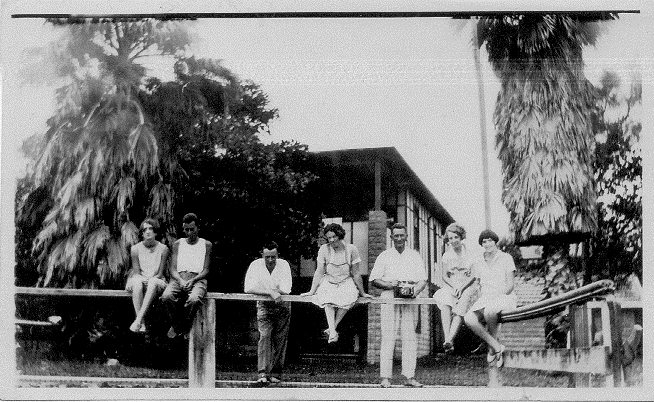
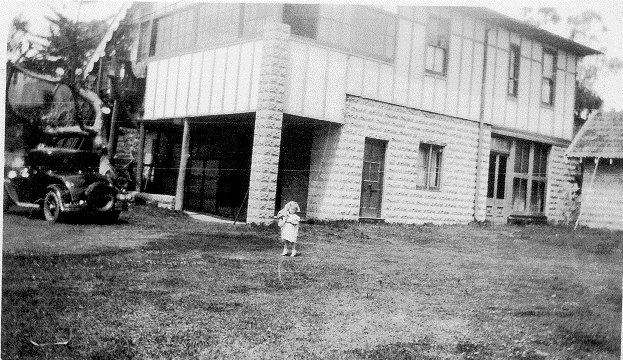
Photographs of Billabong, circa 1920's, courtesy of Michael Schultz, grandson of Charles and Emma Schultz
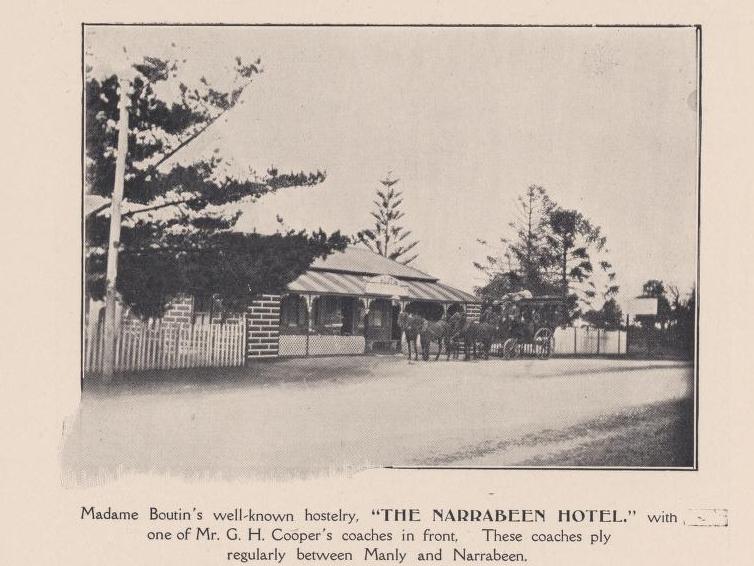
Narrabeen Lakes Estate, 1906 / Arthur Rickard & Co. Ltd Auctioneers. 1906. MAP Folder 114, LFSP 1695 (Copy 1). Part 2. (sales brochure) Image No.: 22704748, courtesy National Library of Australia.
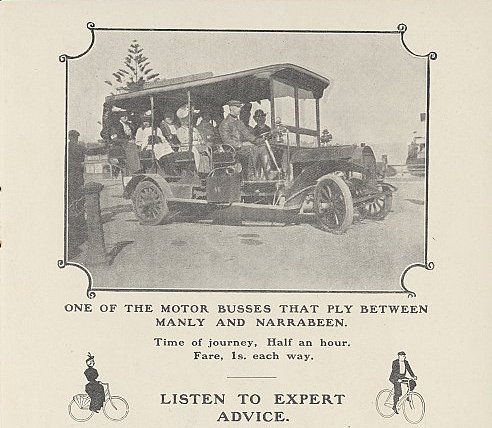
Other items from same folder:
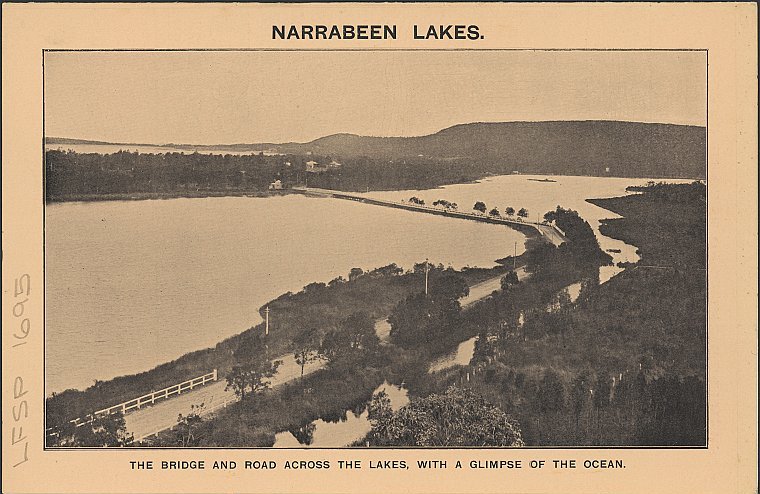
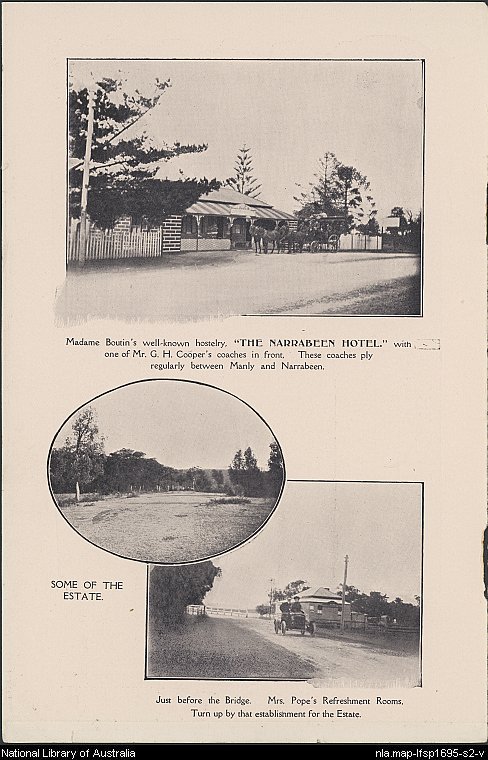
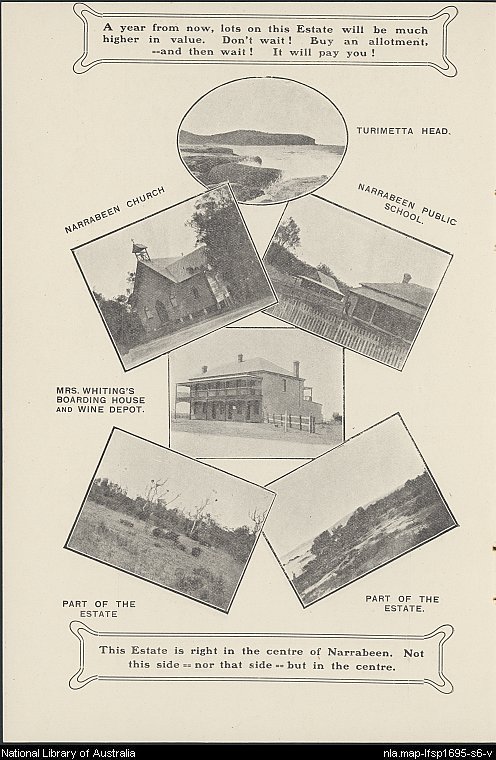
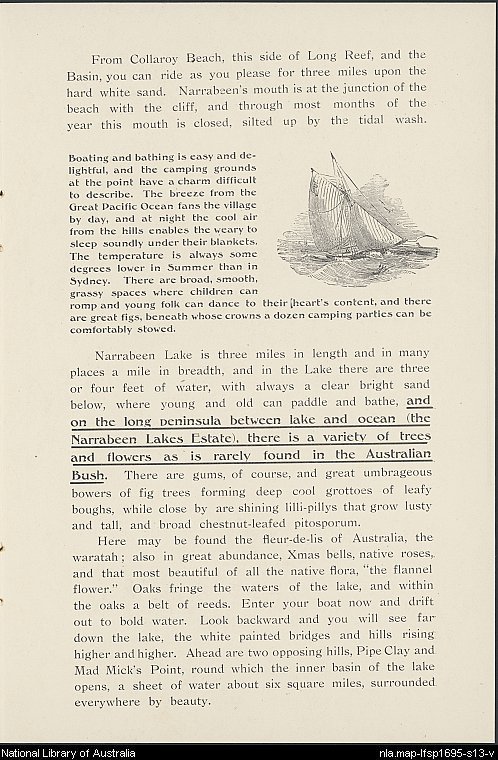
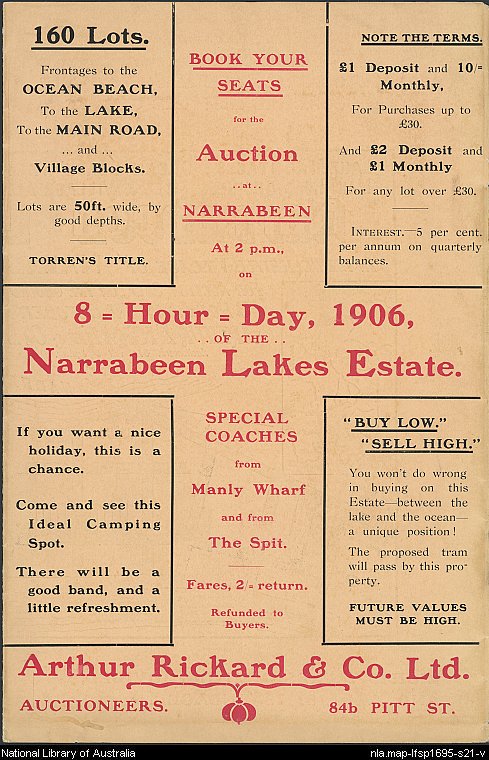
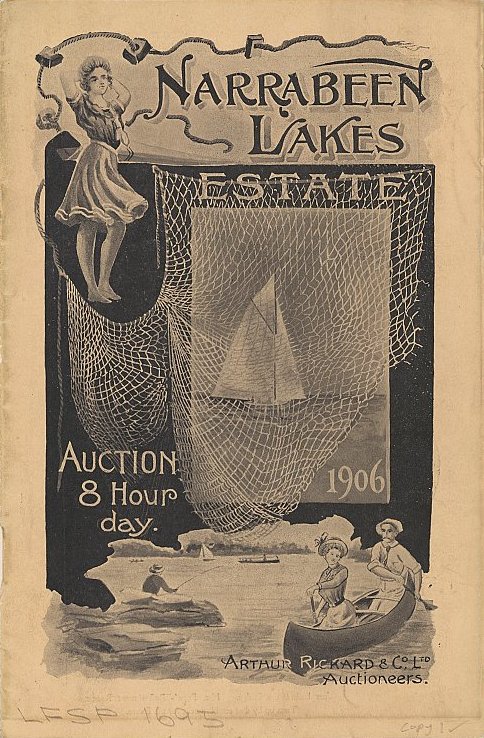
Above: Narrabeen Lakes Estate, 1906 / Arthur Rickard & Co. Ltd Auctioneers, Sales Brochure. 1906. MAP Folder 114, LFSP 1695, courtesy National Library of Australia.
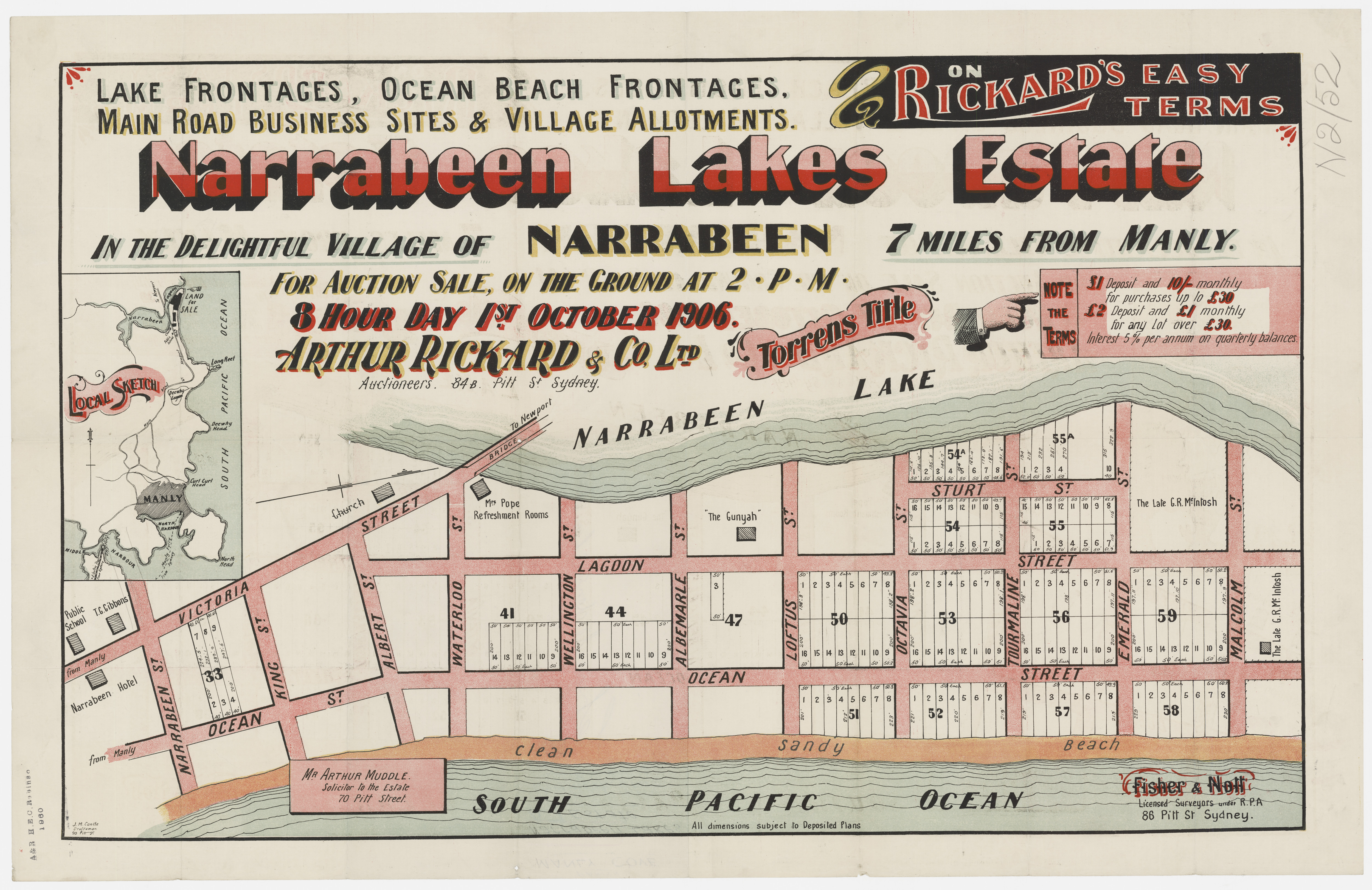
Narrabeen Lakes Estate 1906, Item c050370052, courtesy State Library of NSW, from Narrabeen Subdivisions folder - Street Names include Victoria, Albert, Waterloo, Wellington, Albemarle, Loftus, Octavia, Tourmaline, Emerald, Malcolm, Sturt, King as well as Ocean and Lagoon and Narrabeen streets.
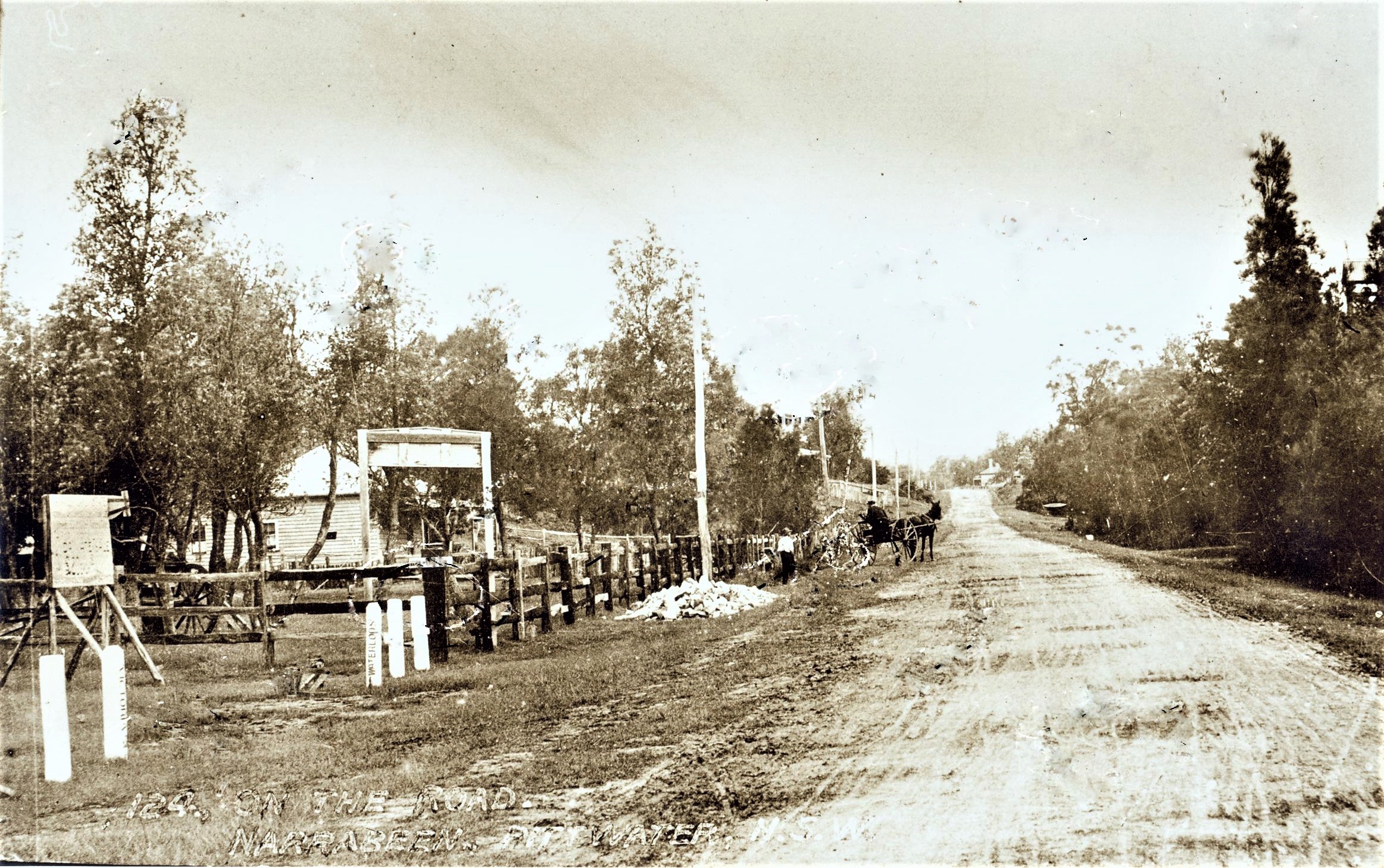
Waterloo street and Pittwater (Ocean) road looking south - Broadhurst Postcard, circa 1900, courtesy State Library of NSW
Sir Arthur Rickard (1868-1948), real estate developer, married Annie Eliza Addy, on February 28th, 1889 at Waverley. They had two daughters and a son, Ivy V M (born 1889), Edna E J (born 1891) and Arthur L (born 1895). Edna passed away in 1892. He divorced Annie in December 1901, gaining custody of their son and daughter. On March 19th, 1902 he married Nellie Crudge, a daughter of architect Thomas Rowe, at St Mark's, Darling Point. They had four children Mona N (born 1903), Gordon C (born 1904), Gwendoline N (born 1906) and Douglas R (born 1915).
THE NARRABEEN LAKES.
Who does not know of the beauties of Narrabeen Lakes?— that charming 'village by the sea,' seven miles from Manly. On one side the ocean beach — three miles long— a magnificent stretch of clean, hard sand — an ideal spot for bathing. On the other side the picturesque lake, fringed with wattle, fern, and lilli pillys, swarming with fish, and the habitat of the swan and shy waterhen, etc. This fine spot is destined to take a big leap forward very soon, as its manifold charms, attractions, and 'get-at-ableness' are commanding the attention of all sorts of people — people who want a quiet place to loaf at, families who want a safe place to boat, fish, and bathe at; quiet folk who are satisfied to ramble 'midst the hills and dells, and gather the beautiful waratahs, native roses, and other wild flowers; and, last, but not least, 'the keen-eyed man, with his optic fixed. on 'the main chance.' On eight-hours Day, at 2 o'clock, on the ground, Arthur Rickard and Company, Limited, auctioneers, of 84B Pitt-street, will sell a fine estate In subdivision — the Narrabeen Lakes Estate, close. to hotel, -school, P.O., church, stores, etc., fronting both lake and ocean. Full particulars of this important sale and the arrangements to convey visitors to and from it are advertised. THE NARRABEEN LAKES. (1906, September 27). Evening News (Sydney, NSW : 1869 - 1931), p. 3. Retrieved from http://nla.gov.au/nla.news-article114087901
PROPERTY SALES.
Arthur Rickard and Co., Limited, report that at the auction held yesterday, on the ground, of the Narrabeen Lakes Estate, Narrabeen, there -was a good attendance of buyers, and bidding was brisk. One hundred and fourteen lots were sold, totalling £2207 10s. Ocean beach lots fetched from £19 to £23, lake frontages from £30 to £40, main-road lots at £45 each, small interior lots from £9 10s to £15 each, and larger lots from £14 10s to £27. The balance is held for private sale. PROPERTY SALES. (1906, October 2). The Sydney Morning Herald (NSW : 1842 - 1954), p. 9. Retrieved from http://nla.gov.au/nla.news-article14827051
The next year acreage was brought under the Real Property Act by Florence, the wife of Manly Real Estate agent and developer Joseph William Hanson, who, with his brothers Walter and Frank, inherited land holdings across Sydney.
Joseph W. Hanson was born at Paddington in 1867 to Alexander George (also spelled Alcander) and Elizabeth Esther (nee Peisley). His grandfather, Joseph Samuel Hanson, (1811–1852) was aged 18 in 1828 and came free aboard the ship 'Albion' in the same year. He was a clerk in Sydney and listed as a Trustee in some insolvent farmer's estates. In 1830 he married May Ann Board, 'born in the colony' to William, bricklayer of George street Sydney, granted a conditional pardon, transported per the ship Fortune 1805 life, and Elizabeth , conditional pardon, per the Willaim Pitt, 1805, life. The couple had two daughters and three sons, Juliaretta Mary (born 1831) Alexander George (born 1839) George T. (born 1841) , Eliza (born 1842) and Albert G. (born 1845).
Joseph Samuel Hanson also seems to have speculated in Real Estate and although he is listed a few times as being a debtor, almost two decades after he passed away legal matters regarding his estate appear in the journals and newspapers of those ties and led, alike the Bassett-Darley Act, to one being written for this family as well, after his father passed away in 1873, in the ''Hanson's Trust Act 1876'', available at; ''An Act to enable the Trustees of the Will of Alcander Charles Hanson deceased to sell or join with the proper persons in selling certain Trust Real Estate. [26th May, 1876.]''
Some examples as trustee:
In the Insolvent Estate of John Rowley, of Burwood, near Sydney, Farmer, WILLIAM FORD and Joseph Samuel Hanson, of Sydney, having been confirmed Trustees to the above Estate, this is to give Notice, that all debts due to the same are to be paid to them, and that a third General Meeting will be held before me, at the Supreme Court House, Sydney, on Tuesday, the 7th day of February next, to commence at 10, a.m., and end at 10*30, a.m., then and there to receive further proof of Debts, and to receive the Report of the Trustees as to the condition of the said Estate, also to give directions as to its future management.— Sydney, 7th January, 1843.
WILLIAM H. KERR, Chief Commissioner. - New South Wales Government Gazette (Sydney, NSW : 1832 - 1900), Tuesday 10 January 1843 (No.4), page 56
In the Insolvent Estate of Peter Hill Rapsey, of Phoenix Park, near Morpeth, settler. JOHN ANLABY and Joseph Samuel Hanson having been confirmed Trustees to the above Estate, this is to give Notice, that all Debts, due to the same are to be paid to them, and that a third General Meeting will be held before the Commissioner of Insolvent Estates, at Maitland, on Thursday, the 28th day of December next, to commence at 10, a.m., and end at 10.30, a.m., then and there to receive further proof of Debts, and to receive the report of the Trustees as to the condition of the said Estate, also to give directions as to its future management.—Sydney, 26th November, 1843. WILLIAM H. KERR, Chief Commissioner. - New South Wales Government Gazette (Sydney, NSW : 1832 - 1900), Tuesday 28 November 1843 (No.102), page 1570
Joseph Samuel Hanson passed away in June 1852, just 40 years of age:
On the evening of the 7th instant, at his residence, Elizabeth-street, Sydney, Joseph Samuel Hanson, Esq., aged 40 years. Family Notices (1852, June 12). The Maitland Mercury and Hunter River General Advertiser (NSW : 1843 - 1893), p. 3. Retrieved from http://nla.gov.au/nla.news-article668307
In the Supreme Court of New South Wales.
In the will of Joseph Samuel Hanson, of Sydney, in the Colony of New South Wales, merchant, deceased.
NOTICE is hereby given, that it is the intention of Mary Hanson, the Executrix named in and appointed by the last will and testament of the abovenamed Joseph Samuel Hanson, deceased, to apply to the Honorable the Supreme Court after the expiration of fourteen days from the publication of this Notice, that probate of the said will be granted to her .—Dated the 17 th day of June, A.D., 1852.
PARRY LONG, Proctor for the said Mary Hanson. NOTICE is hereby given, that it is the intention of Mary Hanson, the Executrix named (1852, June 18). New South Wales Government Gazette (Sydney, NSW : 1832 - 1900), p. 968. Retrieved from http://nla.gov.au/nla.news-article230659797
William Joseph's father had died when he was just 7 years of age. He married Elizabeth Peisley in 1866 and the couple had three children; Joseph William Hanson, Walter George Hanson (born 1869) and Frank Hanson (born 1872). Walter George Hanson would marry Theresa Jane (Mildwater) Hanson at Manly in 1890 and they would have a son they named Alcander Charles Hanson, born 1892 in Manly, who would also have a Pittwater connection:
Sydney, 27th August, 1943.
OBJECTION TO SPECIAL PURCHASE.
IT is hereby notified that an application has been lodged for the purchase of an area particularised below. Any objections should be accompanied by a deposit of £10 and lodged with the Acting Metropolitan District Surveyor, Sydney, on or before 20th September, 1943.
H. H. GUEST, Under Secretary for Lands. Land District—Metropolitan; Shire—Warringah.
Parish Narrabeen, county Cumberland; Special Purchase 42-32 of an area of 8 1/2 perches situated below high-water mark of Pittwater, comprising portion 153; applicant, Alcander Charles Hanson. S. 43-7,786. OBJECTION TO SPECIAL PURCHASE. (1943, September 3). Government Gazette of the State of New South Wales (Sydney, NSW : 1901 - 2001), p. 1559. Retrieved from http://nla.gov.au/nla.news-article225081802
A few more family notes sourced from TROVE:
On Wednesday, the 21st instant, at St. James's Church, by the Rev. G. H. Moreton, ALCANDER CHARLES, second son of the late JOSEPH SAMUEL HANSON, Esq., to ELIZABETH, elder daughter of WILLIAM PEISLEY, Esq., Richmond House, Darlinghust Road. Family Notices (1866, November 24). The Sydney Morning Herald (NSW : 1842 - 1954), p. 1. Retrieved from http://nla.gov.au/nla.news-article13145702
William Peisley was the third son of John and Elizabeth Peisley (nee Boswell - married march 11, 1799 at Southwark) of Parramatta and born December 1st 1817, christened June 8th 1820. John Peasley aged 28 was convicted and sentenced to be hung at the Surrey Summer Assizes at Croydon on August 3rd 1801. This was commuted to life imprisonment. He was transported aboard the ship 'Perseus' which departed Spithead, England on February 12th 1802 and arrived in the colony on August 4th 1802. John's wife Elizabeth and daughter Ann came with him. John Peasley was given a conditional pardon and became a Publican and later a Butcher at Parramatta. William married in 1843:
MARRIAGE. On the 6th November, 1843, by Special License, by the Rev. Mr. Walsh, Esther, the eldest daughter of the late Mr. Charles Roberts, formerly of the Commissariat Department, and niece of the Rev. Frederick Roberts, of the Established Church, of Prince Edward's Island, to William Peisley, Esq , of Parramatta. Family Notices (1843, November 7). The Sydney Morning Herald (NSW : 1842 - 1954), p. 3. Retrieved from http://nla.gov.au/nla.news-article12417430
The couple had the following children; Elizabeth Esther, Martha J, William Henry Peisley and Robert George Peisley.
William Henry Peisley is named in the ''Hanson's Trust Act 1876'', as Elizabeth Esther Hanson was ''desirous of appointing the said William Henry Peisley the younger to be a trustee of the said will in the place and stead of the said Albert George Hanson The said Elizabeth Esther Hanson in exercise of the power given to her by the thereinbefore and hereinbefore recited will and of every other power or authority in anywise enabling her in that behalf did thereby nominate and appoint the said William Henry Peisley the younger to be a trustee of the said recited will in the place and stead of Albert George Hanson And the said Albert George Hanson and Elizabeth Esther Hanson did and each of them did thereby grant bargain sell release and confirm unto the said William Henry Peisley the younger and his heirs all the lands hereditaments and real estates then vested in the said Albert George Hanson'' and... ''And whereas it would be for the benefit and advantage of the several persons beneficially entitled under the said will of the said Alcander Charles Hanson that the trustees of such will should at once and before the youngest of the said Alcander Charles Hanson's children being a son attaining the age of twenty-one years and being a daughter attaining or marrying under that age have power to sell and concur with those interested under the said will of the said Joseph Samuel Hanson in selling the real estate devised by such will And whereas the said sale and joining in selling by the said trustees of the said will of the said Alcander Charles Hanson cannot be carried out without an Act in that behalf of the Legislature of New South Wales And whereas it is expedient that such trustees of the said will of the said Alcander Charles Hanson should have such power to sell or to join with the proper persons in selling the said real estate devised by the said will of the said Joseph Samuel Hanson and to invest the moneys or proportion of moneys coming to them upon any such sale Be it enacted by the Queen's Most Excellent Majesty by and with the advice and consent of the Legislative Council and Legislative Assembly of New South Wales in Parliament assembled and by authority of the same as follows :—
1. It shall be lawful for the trustees or trustee for the time being of the said will of the said Alcander Charles Hanson from time to time and at any time to sell or to join with all proper and necessary parties in selling either together or in parcels and either by public auction or private contract the real estate to which the said Alcander Charles Hanson was at the time of his death entitled under the said will of the said Joseph Samuel Hanson and upon any such sale or sales to make or join or concur in making any stipulations or conditions as to title or evidence or commencement of title or otherwise and to buy in or rescind or vary any contract for sale and to resell without being responsible for any loss arising or being occasioned thereby....''
William Peisley the elder passed away in 1879, Alcander/Alexander's death Notice:
DEATH. On the 29th May, at his residence. No. 2, Kellet-street, Darlinghurst, Alexander Charles Hanson, aged 34 years. Family Notices (1873, May 31). Empire (Sydney, NSW : 1850 - 1875), p. 1. Retrieved from http://nla.gov.au/nla.news-article63230978
In the Supreme Court of New South Wales.
ECCLESIASTICAL JURISDICTION.
In the will of Alexander Charles Hanson, late of Kellett-street, Sydney, in the Colony of New South Wales, gentleman, deceased.
NOTICE is hereby given, that after the expiration of fourteen days from the publication hereof, application will be made to this Honorable Court, in its Ecclesiastical Jurisdiction, that probate of the last will and testament of the abovenamed Alexander Charles Hanson, deceased, be granted to Albert George Hanson, of Sydney, in the said Colony, gentleman, and Elizabeth Esther Hanson, also of Sydney aforesaid, widow of said deceased, the executor and executrix in the said will named.—Dated this 12th day of June, A.D. 1873.
PATRICK JOHN HOURIGAN,
Proctor for the said Executor and Executrix, 129, King-street, Sydney. 3216 6s. 6d. ECCLESIASTICAL JURISDICTION. (1873, June 13). New South Wales Government Gazette (Sydney, NSW : 1832 - 1900), p. 1672. Retrieved from http://nla.gov.au/nla.news-article223100687
In the Supreme Court of New South Wales.
ECCLESIASTICAL JURISDICTION.
In the, will of William Peisley, late of Ithaca Road, Elizabeth Bay, near Sydney, in the Colony of New South Wales, gentleman, deceased.
NOTICE is hereby given, that at the expiration of fourteen days from the publication of this notice in the Government Gazette of New South Wales, application will be made to this Honorable Court, in its Ecclesiastical Jurisdiction, that probate of the will of the abovenamed William Peisley, deceased, may be granted unto William Henry Peisley, the sole executor appointed by the said will.—Dated this 17th day of March, a.d. 1879.
JAMES GREER, Proctor for the said William Henry Peisley, No. 1, Wentworth Place, Elizabeth-street, Sydney. ECCLESIASTICAL JURISDICTION. (1879, March 18). New South Wales Government Gazette (Sydney, NSW : 1832 - 1900), p. 1232. Retrieved from http://nla.gov.au/nla.news-article223660532
Elizabeth Esther Hanson (nee Peisely) married John Cecil Read after he passed away, but someone continued to pay for Memorium Notices for him in local newspapers into the 1880's and she continued to defend his holdings for his children, although it was clear she wanted to be free of this duty when youngest son Frank sought to have her and his uncle removed from being in charge:
READ—HANSON.—March 2, at St. Michael's, Surry Hills, by the Rev. Canon H. S. King, M.A., John Cecil, second son of John Cecil Read, of Darlinghurst, Sydney, the only son of the late Rev. Sir John Cecil Read, knight and baronet, of Moynoe House, county Clare, Ireland, to Elizabeth Esther, daughter of William Peisley, Esq., of Elizabeth Bay. Family Notices (1878, March 13). The Sydney Morning Herald (NSW : 1842 - 1954), p. 1. Retrieved from http://nla.gov.au/nla.news-article28395255
Worth noting about John Cecil's father:
DEATH OF SIR JOHN CECIL READ.
Sydney March 2
Sir John Cecil Read, Bart., died at his residence, Arawa, Waverley, to-day. The deceased was the ninth baronet. He was born at Moyne, County Clare, Ireland, in 1820. His younger days wore connected with the London police force, and after wards with the police force of New South Wales. Of later years he was Governor of Darlinghurst Gaol, which post he retained till his retirement ten years ago. He had issue, four sons and two daughters. DEATH OF SIR JOHN CECIL READ. (1899, March 3). The West Australian (Perth, WA : 1879 - 1954), p. 5. Retrieved from http://nla.gov.au/nla.news-article3205795
It's also worth noting that son Frank had a charge and filed bankruptcy against him in 1907 although an earlier Notice shows he had been placed in an asylum for the mentally unwell prior to this - he was then, too, a Manly resident. After his recovery he worked as an Insurance salesman:
A change of Trustee.
In the Equity Court yesterday, before Mr. Justice Manning, an application was made on behalf of Frank Hanson for an order to remove William Henry Peisley and Elizabeth Esther Read (the latter at her own request) from trusteeship under the will of the late Alcaner Charles Hanson, of Brougham-street, Woolloomooloo. Mr. Gordon and Mr. Rich (instructed by Messrs. Fitzhardinge, Son, and Houston) appeared for the plaintiff; Mr. Lunger Owen (instructed by Mr. Lunger Owen) for the defendant Peisley. Elizabeth Esther Read, Joseph William Hanson, and Walter George Hanson, who were joined as defendants, appeared to submit to any order the Court might make. Plaintiff also asked that defendants Piesley and Read should be restrained by injunction from in any way interfering with the estate, which it was prayed should be administered under the direction of the Court. After argument, counsel suggested that as the matter would have lo be referred to the Master to go into accounts and make a general investigation, the hearing should stand over until the following morning. This course was adopted. A CHANGE OF TRUSTEE. (1897, July 29). The Daily Telegraph (Sydney, NSW : 1883 - 1930), p. 2. Retrieved from http://nla.gov.au/nla.news-article238402534
LAW REPORT.
Wednesday, September 8. BANCO COURT.
(Before the Chief Justice and a jury of four.) READ AND ANOTHER v. PEISLEY. (Part heard )
Mr Pilcher Q C , and Mr Garland, instructed by Messrs Chenhall aud Eddie appeared for the plaintiffs ; and Mr Rolin, instructed by Mr. M. A. Williamson, for the defendant. This was an action brought by Elizabeth Esther Read (formerly Hanson) and William Henry Peisley, executrix and executor respectively of the late Mr Hanson, to recover the sum of £1700, stated to be due by defendant on a memorandum of mortgage under the Real Property Act, bearing date May 20, 1890, by which the defendant covenanted with the plaintiffs that he would pay the sum of £1700 on May 20, 1896 with interest at the rate of 6 percent per annum as agreed upon The defendant, among other pleas, stated that he was induced to sign the memorandum referred to by plaintiff, William Henry Peisley, falsely representing to him that the memorandum was a discharge or release, and that he never received any consideration for signing it.
After some further evidence had been given the parties, acting upon the suggestion of his Honor, settled the matter, and by consent a verdict for the plaintiffs was entered for £1700 upon terms filed in court. LAW REPORT. (1897, September 9). The Sydney Morning Herald (NSW : 1842 - 1954), p. 4. Retrieved from http://nla.gov.au/nla.news-article14092804
In 1892 Joseph William Hanson married:
HANSON— HACK.— June 14, at St. Matthews', Manly, by the Rev. R. S. Willis, Joseph William, eldest son of the late Alexander Charles Hanson, of Darlinghurst, to Florence Adele, third surviving daughter of Jesse Hack, Manly. Melbourne papers please copy. Family Notices (1892, June 29). The Daily Telegraph (Sydney, NSW : 1883 - 1930), p. 1. Retrieved from http://nla.gov.au/nla.news-article236170127
The couple had three children, Romeo, Keith and Enid (later Moore). Joseph Hanson was a strongly community focused person of Manly who would use his assets and rooms to help benefit the local populace as a sole trader and as part of the Manly Corso based Robey, Hanson and Strong who were the gentlemen who oversaw subdivisions from Pittwater to Manly - one example pf Mr. Hanson's community work:
A Bruce auction, organised by Mr. J. Hanson, was opened at his rooms in aid of the funds of the local hospital. The goods for sale were contributed by the hospital supporters. MANLY. (1903, October 17). The Sydney Morning Herald (NSW : 1842 - 1954), p. 14. Retrieved from http://nla.gov.au/nla.news-article14530427
Some of the Collaroy- Narrabeen holdings brought under the Real Property act include those parcels of land gifted to his wife - these were all beach frontages at the Long Reef-Collaroy beach end of the 1881 Mount Ramsay subdivision:
NOTICE UNDER REAL PROPERTY ACT.
APPLICATION baring been made to bring the land hereunder described under the provisions of the real Property Act Certificate of Indefeasible Title will issue, unless Caveat be lodged in accordance with, the Third Schedule to the said Act, OK OB BEFORE THE 19TH JUNE, 1907.
No, 14,681. APPLICANT:—Florence Adele Hanson, Manly. LAND:—County Cumberland, parish Manly Cove, Shire Warringah, 1 acre 1 rood 15 1/2 perches, 1 acre 2 roods 33 1/2 perches, and 1 acre 0 roods 5 1/2 perches, in Ocean, Clarke, Wetherill, Stuart, and Frazer Streets, Narrabeen,—being lots 1 to 6, section 10, lots 1 to 8, section 14, and lots 1 to 5, section 18, Mount Ramsay Estate, and part of 410 acres (portion 1,217) granted to John Ramsay; adjoining the properties of H. J. Ackland and Narrabeen Progress Association; Diagrams delineating this land may be inspected at the Land Titles Office, Elizabeth-street, Sydney. W. G. H-WILLIAMS, Registrar-General, 15th May, 1907. NOTICE UNDER REAL PROPERTY ACT. (1907, May 15). Government Gazette of the State of New South Wales (Sydney, NSW : 1901 - 2001), p. 2739. Retrieved from http://nla.gov.au/nla.news-article220931071
NOTICE UNDER REAL PROPERTY ACT.
APPLICATION having been made to bring the lands hereunder described under the provisions of the Real Property Act, Certificates of Indefeasible Title will issue, unless Caveats be lodged in accordance with the Third Schedule to the said Act on or before the 9th June, 1909: —
No. 15,781. APPLICANT:—Florence Adele Hanson, Manly. LAND : —County Cumberland, parish Manly Cove, Shire Warringah, 1 acre 2 roods 16 1/2 perches, in Clarke, Ocean, and Wetherill Streets, and on Long Reef Beach,—lots 1 to 8, section 17, Mount Ramsay Estate, and part 410 acres (portion 1,217 of parish) granted to John Ramsay.
Diagrams delineating these lands may be inspected at the Land Titles Office, Elizabeth-street, Sydney. W. G. H.-WILLIAMS, Registrar-General. 5th May, 1909. NOTICE UNDER REAL PROPERTY ACT. (1909, May 5). Government Gazette of the State of New South Wales (Sydney, NSW : 1901 - 2001), p. 2388. Retrieved from http://nla.gov.au/nla.news-article221596611
 too.jpg?timestamp=1609177237674)
Section from Mount Ramsay Estate, Parish of Manly Cove - Collaroy street, Malcolm St, Alexander etc. - 1881 - Auction Monday October 24th. Richardson and Wrench. Item: c050370117 - and parts from to show Section/Lot Numbers, courtesy the State Library of New South Wales.
Death of Jesse Hack.
An Interesting Old Identity.
Mr. Jesse Hack passed away about 9 o'clock on Thursday morning. Five days before his death, Dr. Waugh was called to see the old man, and found him suffering from paralysis and hemorrhage of the brain. The following, which appeared in "The Argus" last June, gives some interesting particulars of Mr. and Mrs. Hack: —
"Mr. and Mrs. Jesse Hack duly celebrated their diamond wedding on Saturday last. As we mentioned in our last issue, Mr. Hack is a native of Hollington, Sussex, England. He married Miss Green, the eldest daughter of Mr. Robert Green, of Rock Farm, Dundas; and both are with us still. On the 27th of June they celebrated their sixtieth wedding day. Mrs. Hack's memory was very good up till Saturday last; but she is free to confess now that the doings of Saturday after noon and evening have somewhat taxed her faculties. Imagine children and grand children — she said to "The Argus" trooping, nay, pouring in — amid a sort of confetti-shower of telegrams and cards of congratulation and other messages of joy — to take possession of the home for the time being, and play high jinks. Still, even now, Mrs. Hack can tell many an interesting tale of old Parramatta, of the Governors who lived here; of the building of Lennox Bridge, of the good old days when the crop on her father's orchard— where grew pears and apples and oranges — just a few yards past the Parramatta boundary stone — was worth thousands sterling a year, and when labor and dairy supplies were equally cheap.
For many years Mr. Jesse Hack (who came to New South Wales in 1841) was mine host at "'The White Horse," and what a position for a philosopher to occupy was that.— In the classical days of the historic borough, and of old Alder man " Jimmy " Pye, of Garnet Walsh, the days when Henniker Heaton was a clerk at John Taylor's and Hugh Taylor was going strong in the early laps of his long and strenuous political career. Those were the days' before the later knights — F. C. Cox, H. Tucker Jones, Tom Moxham, Dowell O'Reilly, Alderman "Ted." Brown, and all that generation (or those generations, rather), came along. Mr. and Mrs. Hack were married at the Wesleyan Church, Macquarie-street, Parramatta, by the Rev. Benjamin Chapman, on June 27, 1849. Mr.and Mrs. Hack's family included in the old home, two sons (Messrs. Robt. and Geo. Hack) and three daughters (Misses Gertrude, Emily, and Florence Hack). The first named daughter is a resident of Parramatta still, and is now Mrs. Arthur Hayes. Miss Emily Hack was twice married, her first husband, being Archdeacon Innes. At his death she married Mr. J. Maxwell, of Melbourne. She resides at Kew, Victoria.
Miss Florence Hack married Mr. Hanson, of Manly. Mr. Robert Hack's daughter is Miss Patience Hack (Burwood), the fiancee of one of the most popular of our younger citizens of Parramatta town. Mr. Geo. Hack's daughters are Misses Petrea, Gladys, Pauline, Muriel, and Mollie Hack, and his sons Messrs. Reginald, Darabin, and Robert Hack. In the family of Mr. and Mrs. Arthur Hayes are two daughters, Edith and May, and one son, Leo. The late Archeacon Innes' family include Mr. Geo. C. Innes (now of Western Australia), and two daughters, one now the wife of Dr. Sweetnam, of Pehshurst (Vic toria), and the other Mrs. Hutton, of Cheviot Hills (Vic). Dr. Sweetnam's little son. is Mr. and Mrs, Jesse Hack's one great-grand-child. Of the second family (Mr. Maxwell's), the daughter is Mrs. Hofman, of Berigan, N.S.W., and the son Mr. J. Maxwell, of Melbourne. Mrs. Hanson's children are Romney and Keefe, two sons.
At the family gathering on Saturday there were 38 of the family present, and Mr. and Mrs. Jesse Hack, in the centre of the happy group, received many telegrams and cards from those at a distance, and lovely presents from every quarter. Among those who did not forget, the family re-union were some of our own citizens, Mr. C. Beresford Cairnes, Dr. Isaac Waugh, and Dr. Brown. The toast of the day was pro posed by a nephew, Mr. S. Knight (of the "Barrier Miner"), son of Mrs. Hack's eldest sister. The day was spent in the way proper to such an occasion, the guests remaining under the old roof tree till 10 p.m." Mrs. Hack, who survives her husband, comes of a family remarkable for longevity. When Mr. and Mrs. Hack celebrated the 59th anniversary of their wedding, not quite two years ago, a feature of the gathering was the presence of no less than six sisters, of Mrs. Hack. another in Victoria having sent word of her inability to be present to do honor to the occasion.
The aggregate ages of the eight living sisters totals 547 years, Mrs. Hack. (79) being the eldest, whilst the youngest is in her 61st year. This is perhaps unequalled in Australia. Mrs. Hack was the eldest daughter of the late Mr. Robert Green, Rock Farm Estate, Dundas, near Parramatta, where a large family was reared. The children used to attend school at Parramatta, when Miss Houison (Macquarie-street) and Mr. Dan. Watsford were learning the three R's. Mr. Watsford, probably the oldest living native of Parramatta to-day, is a few years older than Mrs. Hack, and both are in splendid health.
Mr. Jesse Hack arrived per sailing vessel in the year 1841, and soon afterwards settled down in Parramatta, at which time one of the early Governors of the colony was also resident here. With the exception of a few years' residence at Manly, the respected aged couple have resided in Parramatta during the whole of their married life. Mrs. Hack has an excellent memory, and speaks interestingly of the Governors she has seen come and go in Parramatta. the building of Lennox Bridge, and other notable local events. Her father's orchard at Dundas was one of the best and most profitable in those days. The orange crop alone brought over £2000. The orchard, too was renowned for its splendid apples and pears. Orchard hands and domestic servants were paid 8s and 1s respectively per week. Mrs. Hack often bought butter at 6d per lb., eggs 3d and 4d dozen, and half a sheep for 2s 6d. Death of Jesse Hack (1910, March 12). The Cumberland Argus and Fruitgrowers Advocate (Parramatta, NSW : 1888 - 1950), p. 11. Retrieved from http://nla.gov.au/nla.news-article86004289
Unfortunately Florence suffered from insomnia and took her own life;
The Rock Farm Tragedy
A Wealthy Lady's Death.
The Coroner (Mr. Richardson Clerk) held an inquest at Parramatta on Friday touching the death of Mrs. Florence Adele Hanson, wife of Mr. Jos. Hanson (Manly), who was found dead with a pea-rifle under her at Dundas.
Dr. E. Cuthbert Hall deposed that about 7 p.m. on 2nd August he went to the house of Mr. Knight, at Rock Farm, Dundas. Constable Bailey was with him. He went into a bedroom, and there saw the body of deceased lying in a corner on the floor fully dressed. There was blood on the face and a considerable pool of blood on the carpet under her head. Lying under tile body was a pea-rifle with the muzzle pointing towards the head. The body was removed to the Parramatta morgue, and there he made an external examination and found a bullet wound of entrance in the right temple just above the eye. On probing he found that the bullet had passed through the brain and to have struck the left temporal bone just above the left ear, fracturing the bone but not passing through. Death must have been instantaneous. The wound of entrance was blackened, showing that the rifle must have been discharged at close range. Upon the bed in the room were three portraits, which, he was Informed, were those of deceased's children.
Joseph William Hanson deposed that he was a real estate agent, residing at Manly. Deceased was his wife. She was 52 years of age. There were three children, 26 years, 16 years and 8 years respectively. He identified the body at the Parramatta morgue on 3rd August. They lived together; but lately not as man and wife, owing to her health. She was possessed of real estate property valued at £9000 or £10,000, and her income was about £600 or £700 a year. Witness gave her the property. She had not been well for a long time and had been in hospitals. The last hospital was at a Randwick mental hospital, where she had been seven months. She came out in September last year. Saw her alive last about a fortnight before her death. She was at Rock Farm. She appeared to be reasonable and mentally all-right. She had never previously shown any suicidal tendencies. She was staying with Mr. Knight, her first cousin. Augustus Sydney Knight deposed that he resided at Rock Farm, Dundas. The deceased was his cousin. The deceased had been staying with him before; but that last time she stayed with him for two months. She seemed a great deal perturbed generally. She suffered from insomnia. Knew that she had been in a mental hospital. She prevailed upon him to let her stay at his place, because, as she said, the quiet of the surroundings of his home would suit her. Saw the deceased at breakfast-time on August 2. Went to town by the 9.15 a.m. train. She received a mail that morning. She received her taxation papers. They were simply for signature. They upset her, however, notwithstanding that witness advised her that everything was in order and that there was nothing to trouble about. Knew Mr. Hanson very well. So far as witness knows, Mr. Hanson was very attentive and devoted to his family. Got home by the 6.20 p.m. train; got home at 7.30 p.m. The members of the household (Miss Abell, the maid, in particular) told witness that Mrs. Hanson, had been very upset all day. Said, 'Where is she?' With that went into her room. She was lying in the corner. She was dead. Did not know that at the time. The walls of the house were very thick. The rifle found under the deceased's body was his property. It had been in his room for two months previously, unused. When witness left home there were two in the house -Miss Hack and Miss Abell. Witness's son was away. Had no doubt that the deceased committed suicide. There were some pellets of ammunition in his ash tray and elsewhere in the house. The pea rifle had not been loaded before for two months. The deceased — so far as he know — did not understand a pea-rifle. It had since puzzled him how she managed to manipulate the rifle. The deceased was a sober woman — -to an extreme. Vera Abell, one of the household at Knight's, Rock Farm, deposed that she knew Mrs. Hanson. Had never noticed anything queer in her behaviour. Was "about the place" all day on August 2. Saw Mrs. Hanson. She was at the back of the house and in the garden. Had just the ordinary conversation with her. Mr. Knight went away in the 9.15 a.m. train. Mrs. Knight and witness were left in the house and Mrs. Hanson. The Coroner:' Was Miss Hack there? The witness : Yes. The witness said that she heard no conversation between Mrs. Hanson and any one else. Saw Mrs. Hanson in the front part of the house about 5.15 p.m. She was just standing there by herself. Did not see her with a rifle during the after noon. Just noticed the deceased as she (witness) passed. Did not hear a shot. The walls of the house were thick. Mrs. Hanson was treated just the same as any lady would be expected to be treated. Did not say anything to Mr. Knight when he came home. Did say something. Told him that Mrs. Hanson had been upset all day. So far as witness could remember said, "Mrs. Hanson has been upset all day, and is in her room." Guessed that she was in her room. The Coroner: What gave you the impression that the deceased was upset? Witness: I don't know. I just noticed that she was upset. The deceased was not restful that day. She was walking about. The witness said that the deceased did not sleep well. Had been at Knight's for two years and three months. Did not know Mrs. Hanson very well; only whilst she had been staying there. Mrs. Knight and Miss Hack were somewhere in the house; but witness could not say Just where. The Coroner found that the deceased died at Rock Farm, Dundas, from a bullet wound In the head, self inflicted whilst temporarily insane. The Rock Farm Tragedy. (1919, August 23). The Cumberland Argus and Fruitgrowers Advocate (Parramatta, NSW : 1888 - 1950), p. 10. Retrieved from http://nla.gov.au/nla.news-article86116410
Joseph W. Hanson passed away May 31st 1943 at Bayview.
The changing of the landscape, the popularity of the waters of the lagoon as a fishing spot, coupled with the extension of the tram line brought even more ‘excursionists, and then a clubhouse was needed for equipment and all-season life-savers, many of whom stayed in these original clubhouses over the season;
NARRABEEN LAKES. WORKS DEPARTMENT'S SCHEME AGREED TO.
A special meeting of the Warringah Shire Council was held to consider the proposed scheme by the Works Department for improving the Narrabeen lakes. The proposal is to cut a channel in the rock at the foot of Narrabeen head from the ocean into the lake, in which the tide will flow.
Councillor Quirk moved that the Minister for Works be informed that the Council is prepared to guarantee the following-"To Carry out the work of constructing an opening on the on the lines of the plan and specifications submitted, 18ft wide, at a cost of £580 that the council guarantee to put the work in hand immediately the work of constructing the tram is commenced which will allow it to be completed some months before the tram reaches Narrabeen and that a sufficient number of boats will be provided at four different points on the lake " The motion was unanimously agreed to. NARRABEEN LAKES. (1911, May 11). The Sydney Morning Herald (NSW : 1842 - 1954), p. 3. Retrieved fromhttp://nla.gov.au/nla.news-article15239491
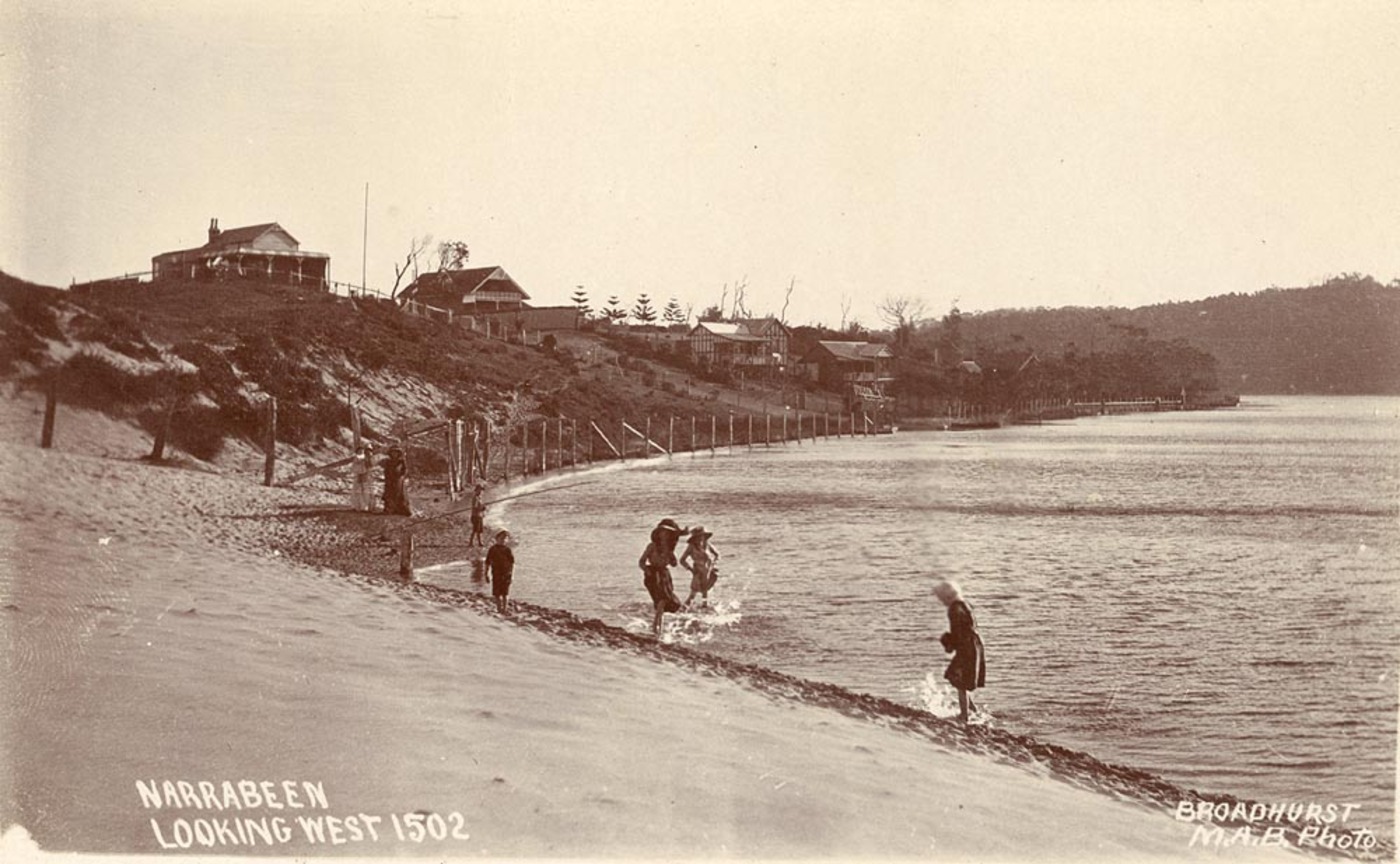
Narrabeen Looking West - From Scenes of Narrabeen album, ca. 1910-1927- Sydney & Ashfield : Broadhurst Post Card, courtesy State Library of NSW. Images No: a106056h (above) and a105060h Courtesy The Mitchell Library, State Library of Australia
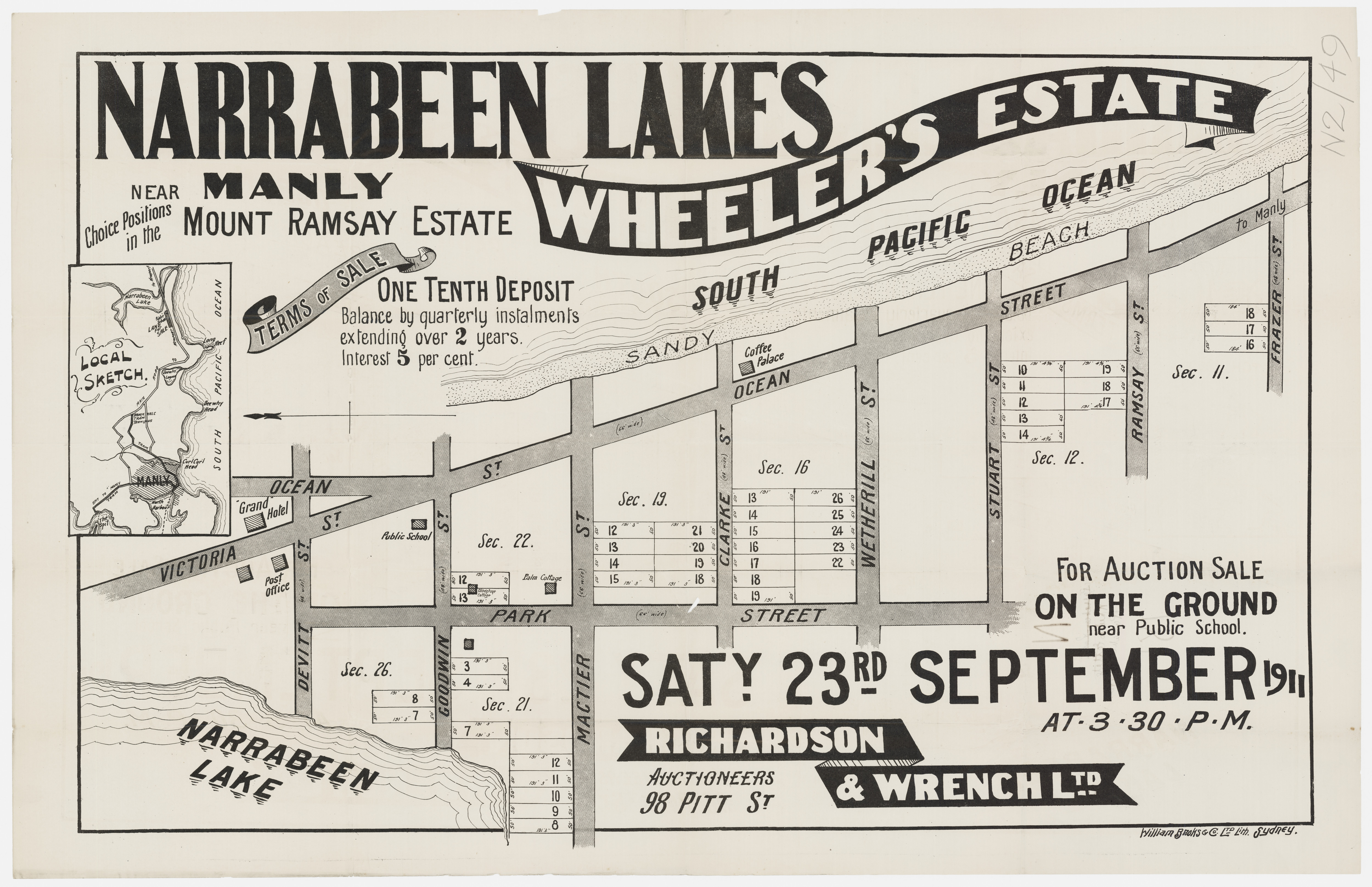
Narrabeen Wheelers estate 1911; Wetherill, Sturt now Stuart, Ramsay, Frazer, Goodwin, Mactier, Devitt, Ocean, Victoria Item c050370049
VANDALISM AT NARRABEEN.
The Narrabeen Progress Association has written to the Warrringah Shire Council, complaining that people were destroying the trees on the fringe Of the Narrabeen Lake, which robbed the locality of its natural beauty. A sharp lookout will be kept by the council overseer for the offender. VANDALISM AT NARRABEEN. (1911, March 22). The Sun (Sydney, NSW : 1910 - 1954), p. 7 (FINAL EXTRA). Retrieved from http://nla.gov.au/nla.news-article221576736
Growing Narrabeen: The West Family
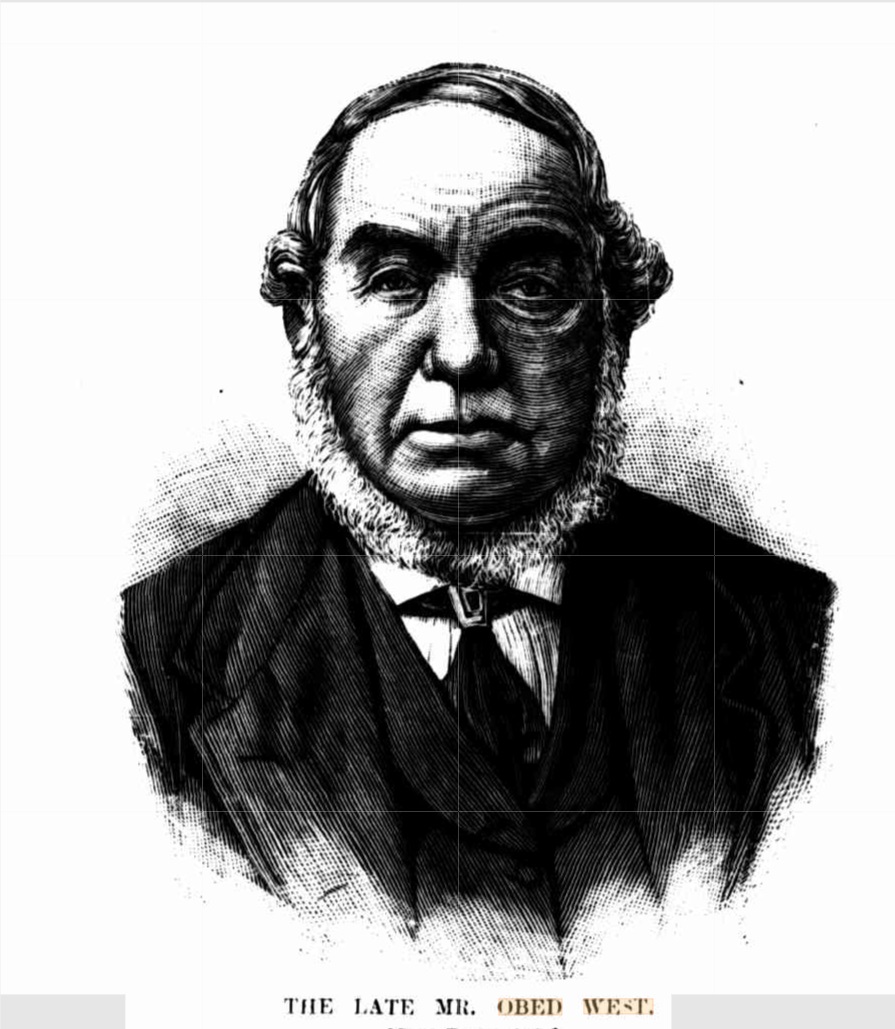
DISPUTED TITLE.
LAND AT CURL CURL.
West and others v Mulroney and another.
Mr. Mann, instructed by Messrs. Holdsworth end Son, appeared for plaintiffs; and Mr. Flaanery instructed by Mr. B. A. M'Bride, for defendant Mary Mulroney. The other defendant, Patrick Smith, was not represented.
The hearing of this part heard suit was resumed.
The plaintiffs are Thomas John West, Lancelot Peel Iredale, Duncan M'Lachlan, Edward Marriott, and Clara Mary Elizabeth West, who are the trustees of tho will of the late Obed West. The statement of claim set out that the latter purchased the land in dispute, which has an area of 20 acres 30 perches, and is situated at Curl Curl Lagoon, near Manly, from the Rewse family, and that it formed part of a grant from the Crown in 1845 to one John Wheeler. Plaintiffs claimed to have been in possession ever since testator died, in 1891.
The defence is that the land is not the land of plaintiffs, as claimed, and that defendant Mary Mulroney and her predecessors had been in possession for 35 years. She therefore asked the Court to say that even if plaintiffs' documentary title to the land were held to be good, their claim to possession was barred by the Statute of Limitations. The case stands part heard.IN EQUITY. (1906, March 7). The Sydney Morning Herald (NSW : 1842 - 1954), p. 7. Retrieved from http://nla.gov.au/nla.news-article14757673
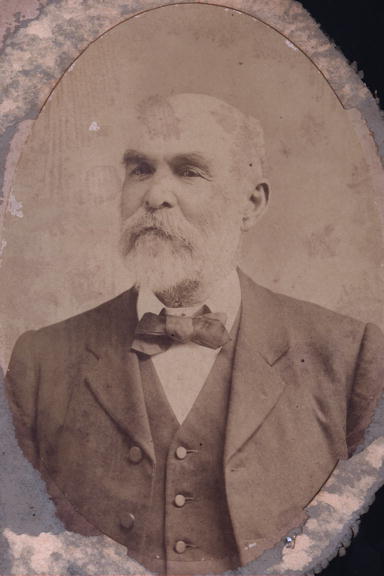
FOR CITY GIRLS holiday home
MEMBERS of the City Girls Amateur Sports Association have completed negotiations for a week-end holiday house at Narrabeen. "Palm Cottage" is an ideal place for a holiday, with the ocean in front and the big lake at the back. The creeks, too, offer pleasure to those whose fancy turns to quiet, inland waters. Mr. T. West, who built "Palm Cottage," went to Narrabeen in 1884, and from almost the whole coastline chose the site because it provided such an unusual vista of the sea. The house will accommodate 12 girls for each week-end, and it will probably be used for holidays also.
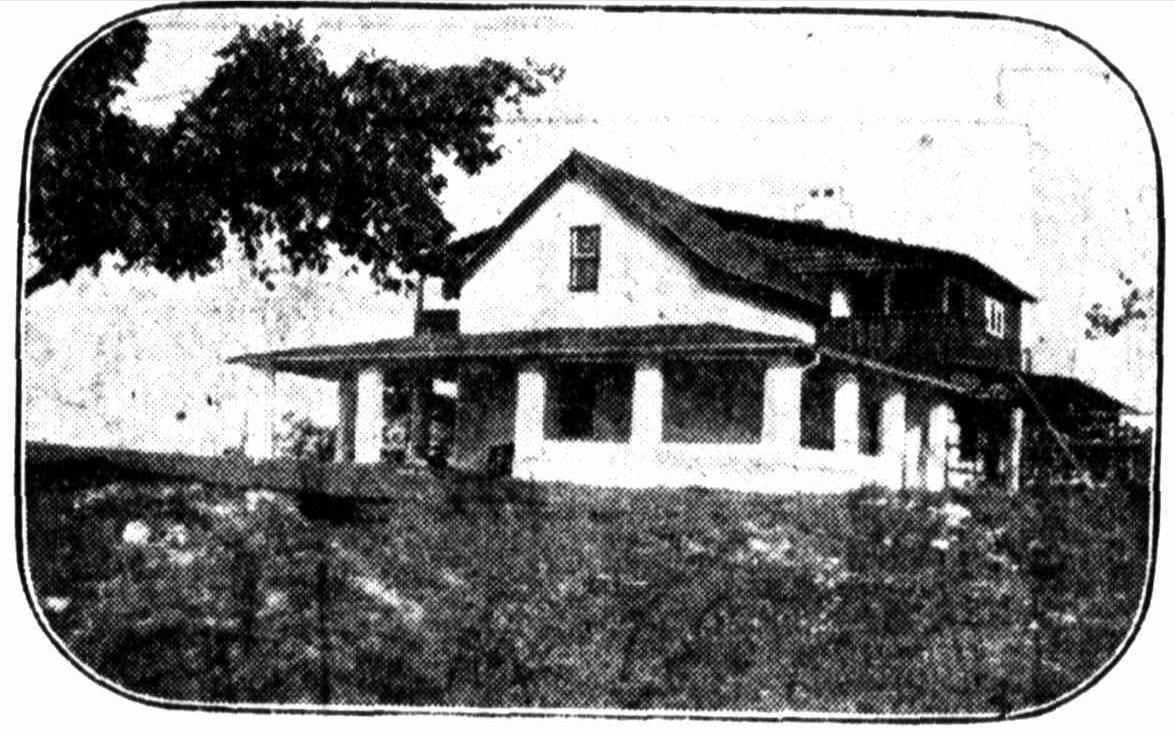
PALM COTTAGE The house at Narrabeen which has been secured by the City Girls' Amateur Sports Association for a week-end resort.FOR CITY GIRLS (1926, March 1). The Sun (Sydney, NSW : 1910 - 1954), p. 13 (FINAL EXTRA). Retrieved fromhttp://nla.gov.au/nla.news-article224055821
City Girls
New Holiday House At Narrabeen
PALM Cottage, one of the oldest houses In Narrabeen, Is to be the scene of many happy weekend parties for the City Girls' Amateur Sports Association. The cottage is large, and rambling, surrounded by wide verandahs, and stands on a hill, overlooking the ocean beach on one side and the Narrabeen Lakes on the other. It is an ideal place for large parties of club girls, the ample balcony space making It possible to accommodate unlimited numbers of camp stretchers for sleeping out, while a specially glassed-in portion will lend itself to the use of long, trestle dining-tables, to seat at least 20 girls.
The lawns surrounding the house are excellently suited for circles courts and basket-ball. Already a number of clubs affiliated to the C.G.A.S.A. have booked up week-ends well into the winter, for the colder weather will make no difference, as the charm of boating on the lakes and tramping into the woods surrounding them will afford sufficient interest as a substitute for the joys of surfing. Each girl, with a minimum number of eight, will be charged five shillings for a party. At present there is only accommodation for twelve, but, as the popularity of Palm Cottage grows, the association will be prepared to arrange for further accommodation. City Girls (1926, March 11). The Daily Telegraph (Sydney, NSW : 1883 - 1930), p. 4 (The Daily Telegraph Woman's Supplement). Retrieved from http://nla.gov.au/nla.news-article245839929
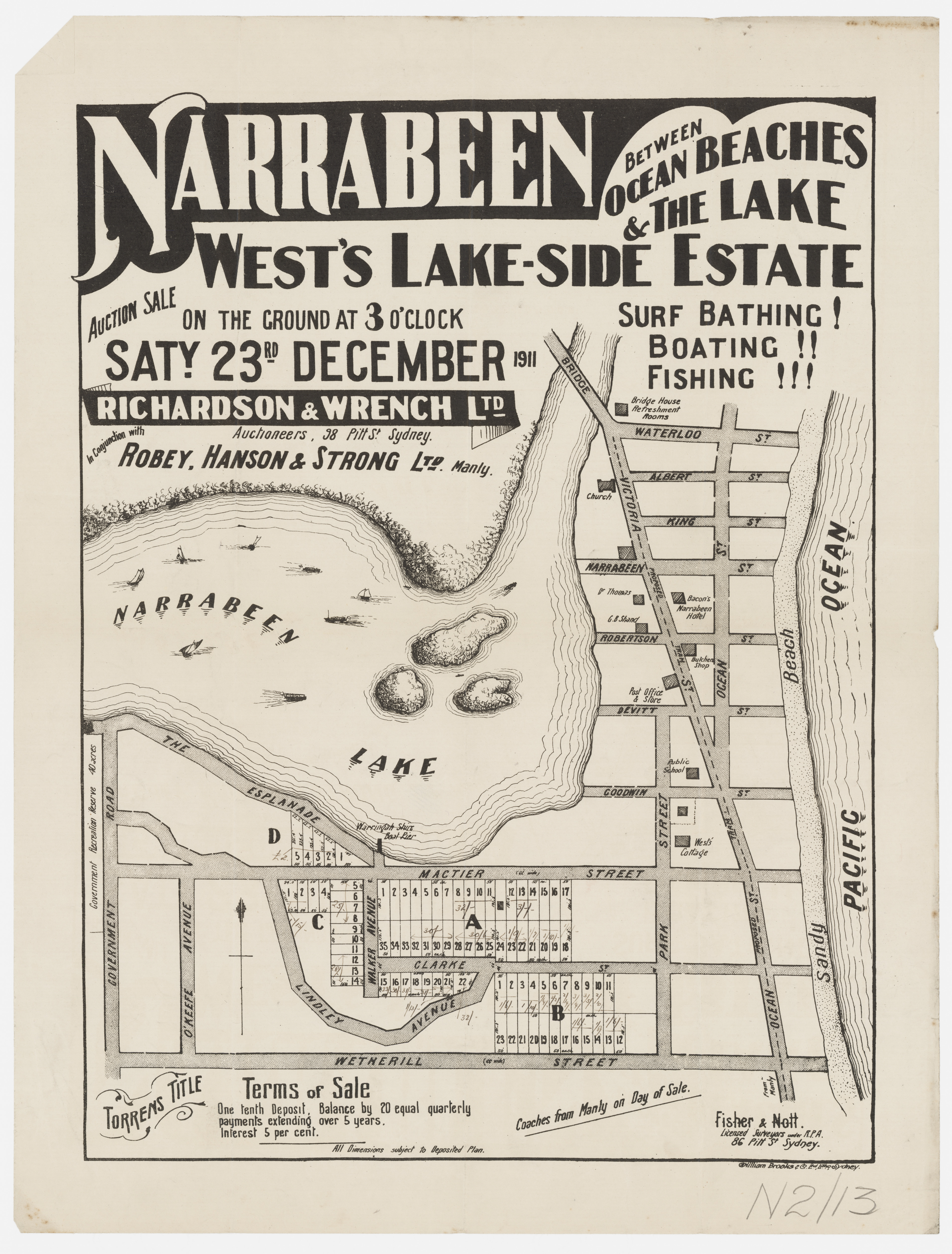
Title Primary Application - Edith Mary Loder, Edward Thomas West & Ada Blanche Ellis, Clarke Mactier Park & Wetherill Streets & a Government Road 66 feet wide and on Narrabeen Lagoon Shire Warringah Parish Manly Cove Volume 2210 Folios 132 to 137
Contents Date Range: 24-04-1911 to 15-12-1911 NRS-17513-4-87-Primary Application 17140 - in Volume 2210 Folios 132 to 137 - Septimus Charles Lindley (Vol-Fol 2210-135) and George Washington Walker (Vol-Fol 2210-136) with Charles Aldophus De Kantzow (Vol-Fol 2210-137) - has 12 acres, 2 roods and 23 1/2 perches together, making up the bulk of the 'West's Lake-side Estate', indicating the few lots then owned by the West family, subsumed into these sales, was used to promote the land sales through association with the family that had served and promoted that stretch of North Narrabeen since the commencement of the land sales.
1: Panoramic Photograph of Narrabeen and Collaroi Beach from West's Lakeside Estate.:
.jpg?timestamp=1749336676422)
2: Panoramic Photograph of View of Narrabeen Lakes from West's Lakeside Estate:

3: Panoramic Photograph of View of Narrabeen Lakes from West's Lakeside Estate:

.jpg?timestamp=1749338397954)
.jpg?timestamp=1749338652037)
.jpg?timestamp=1749338696434)
.jpg?timestamp=1749338730626)
.jpg?timestamp=1749338787920)
.jpg?timestamp=1749338819568)

.jpg?timestamp=1749338899367)
.jpg?timestamp=1749338935846)
.jpg?timestamp=1749338965544)
.jpg?timestamp=1749338992005)
.jpg?timestamp=1749339019924)

These photos were taken and sections and put together by the 'Exchange Studios of 49 Pitt Street'. The same firm also took panoramas of Manly during this era. The first panoramic photographs were created in the 1840s by assembling multiple images into single scenes. By 1898, specialised panoramic cameras such as the Al-Vista were being mass produced in America.
The renowned American panoramic photographer Mervin Vaniman visited Australia in 1903–04, further popularising the artform. Australian photographers including Robert Henry Ward and William Charles Farran, and Augustus George Sands recognised potential commercial opportunities. They applied for artistic copyright then exhibited and sold souvenir booklets and large-format prints of their work.
They worked successfully for years before dissolving their partnership:
WARD & FARRAN (Robert Henry Ward & William Charles Farran, trading.as), Exchange Studios, 49 Pitt-st., Sydney—Reported partnership dissolved as from September 24. Wm. Chas. Farran & Peter Volkert Payeris continue under the name of .“The Exchange Studios. ” (October 24 1921). BUSINESS CHANGES, ETC, Dun's gazette for New South Wales Retrieved June 8, 2025, from http://nla.gov.au/nla.obj-779841052
They show not much had changed between the above and when this photo was taken form around the same aspect:

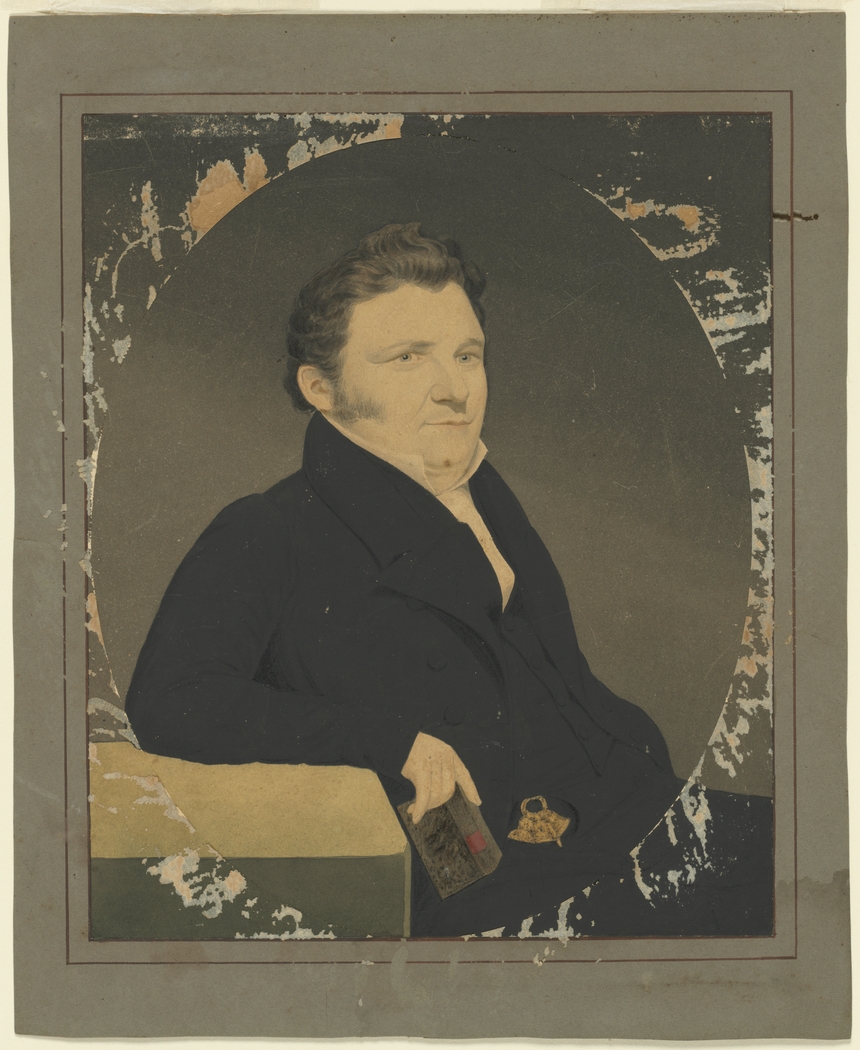
TRAM WAY CONNECTION WITH NARRABEEN.
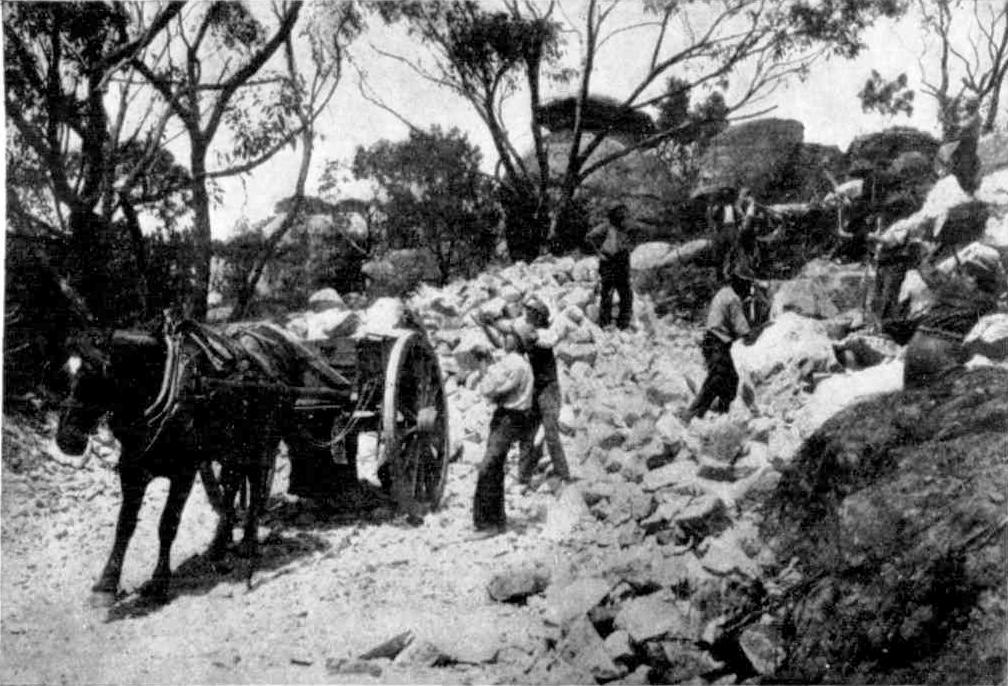
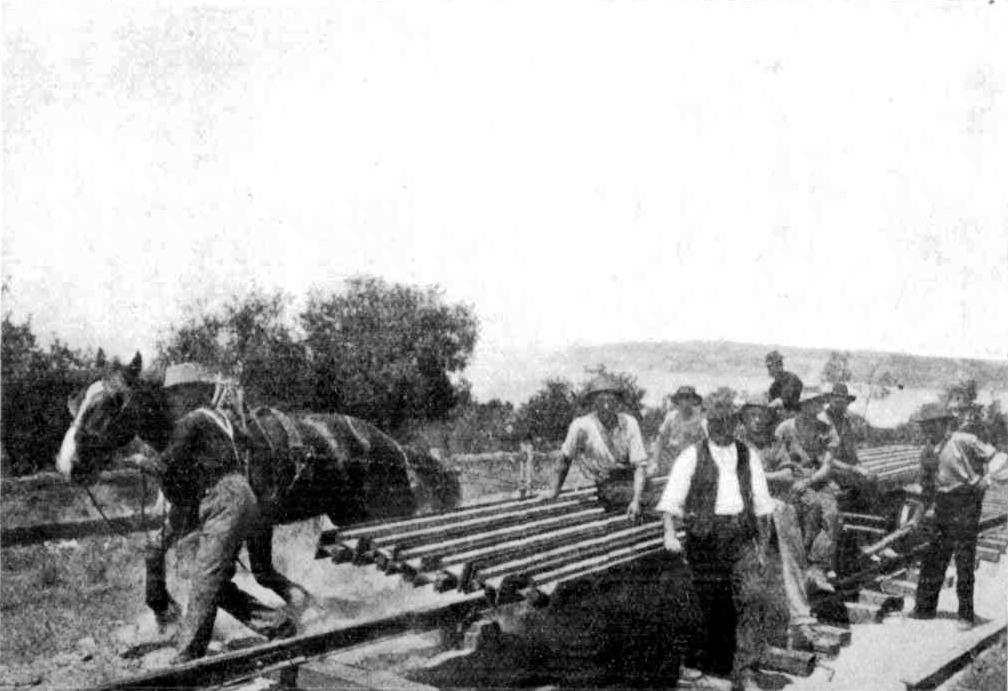
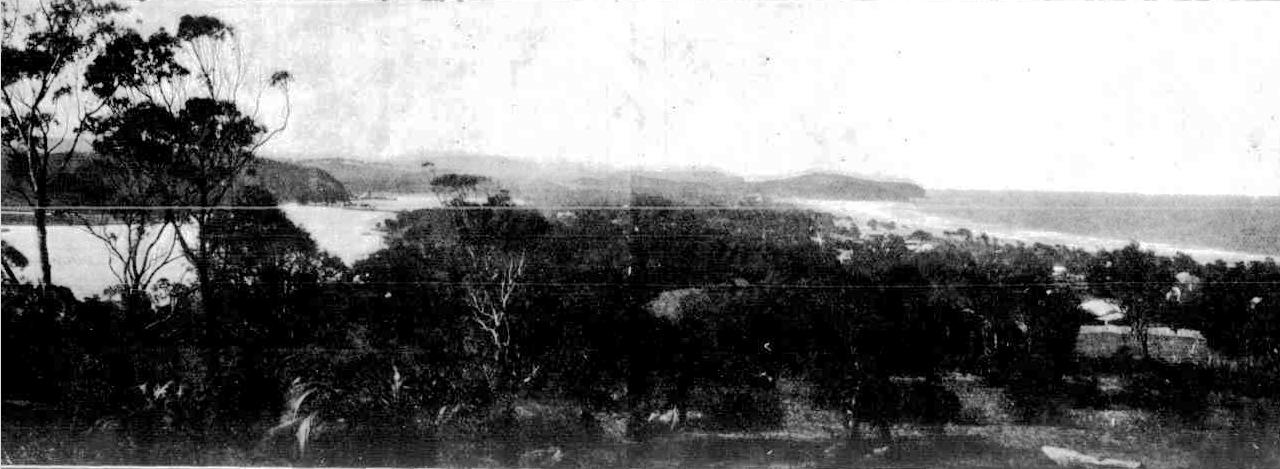
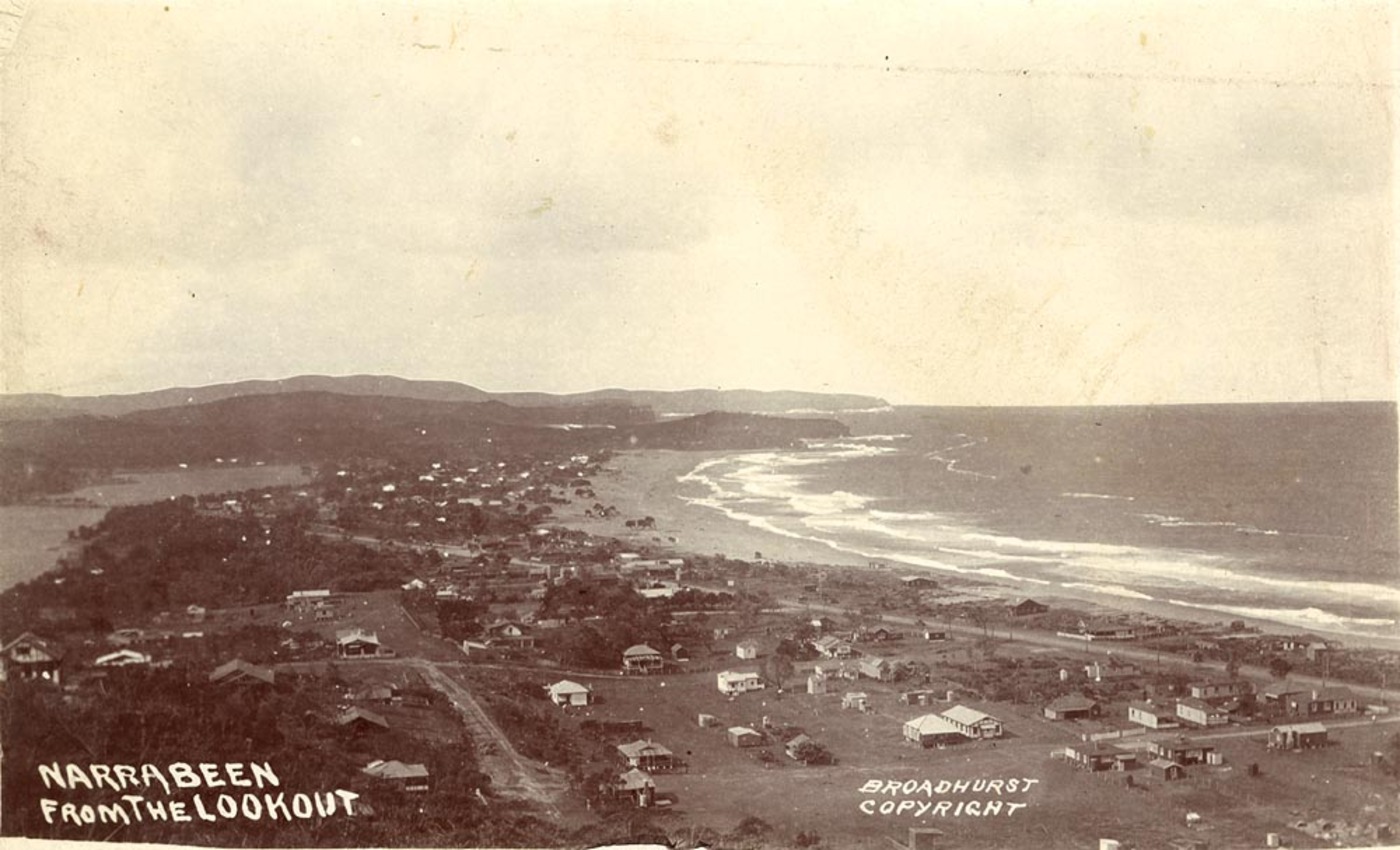
Narrabeen from the Lookout. Image No.: a106055h, from Scenes of Narrabeen Album, Courtesy The Mitchell Library, State Library of Australia - NB: no tram tracks as yet
There is also a distinct advance movement in real estate in the direction of Narrabeen. To-day the tramway is to be officially opened, and from this morning the public will have an hourly tram service between Manly and Narrabeen for 5d each way, and as the last tram from Manly for Narrabeen is somewhere about 10 p.m. the service will be a great improvement upon the present one of coaches and 'buses, running from Manly at the rate of only three or four trips a day, and at a cost to the traveller of at least 1s each way. The sales pf land at Narrabeen this season promise to be greater than last year. In fact, right along the Ocean beach, as far as Pittwater, estates will be opened up, and people will have an opportunity of securing a week-end allotment in a picturesque spot on that magnificent stretch of coast line from Manly to Pittwater. REAL ESTATE. (1912, August 3). The Sydney Morning Herald (NSW : 1842 - 1954), p. 18. Retrieved from http://nla.gov.au/nla.news-article15326801
CONNECTING CITY AND SUBURBS.
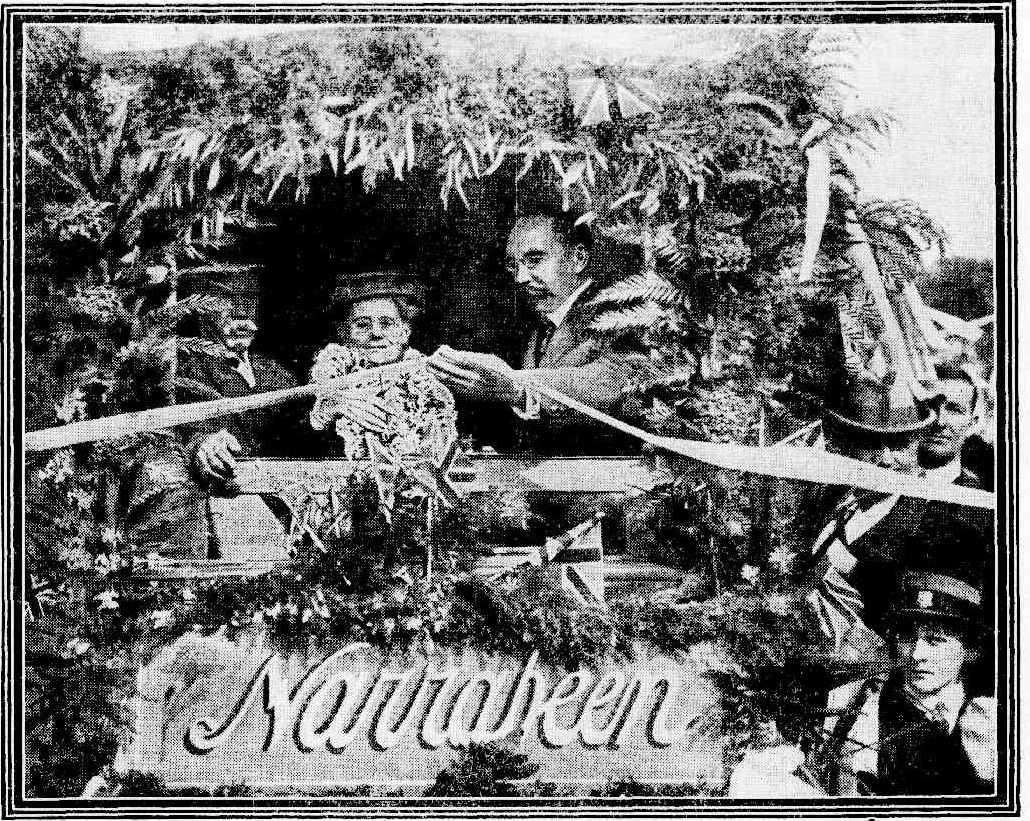
Mrs M’GOWEN (WIFE OF the PREMIER) cutting the ribbon, and declaring the new tramway extension from Manly to Narrabeen open for traffic. Mr. Arthur Griffith, minister for works, is holding the ribbon. CONNECTING CITY AND SUBURBS. (1912, August 5). The Daily Telegraph (Sydney, NSW : 1883 - 1930), p. 11. Retrieved from http://nla.gov.au/nla.news-article238632940
Although some reports state it was Mrs. Griffith who cut the ribbon, a comparison of the lady above and an article run the same year with Mrs. Emily McGowen (nee Towner) will show the same face.
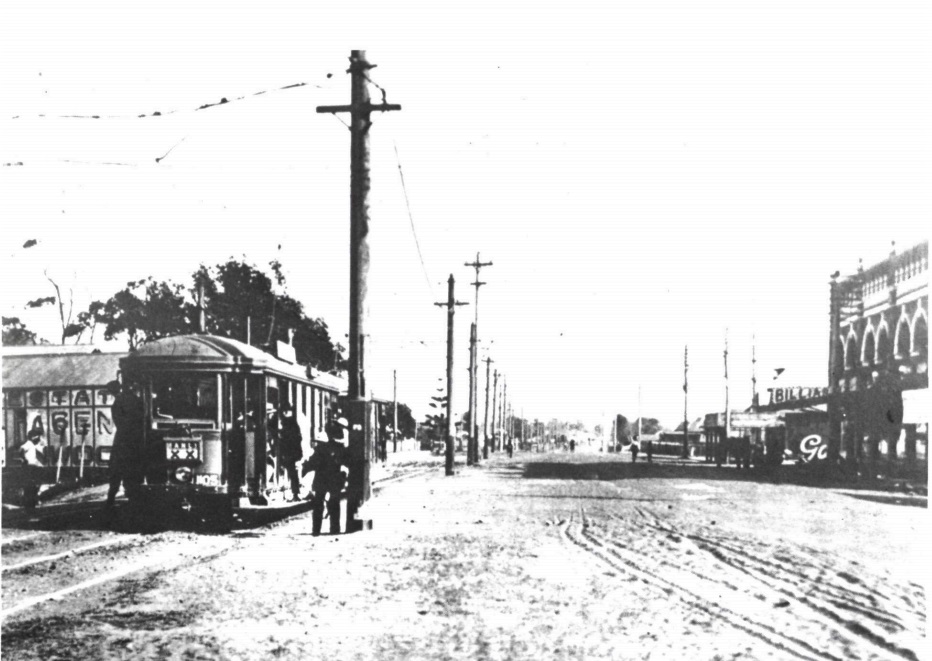
An O class tram headed by car 1105 at Collaroy bound for Manly, Circa 1920. from D O'BRIEN COLLECTION - appears Trolley Wire December 1984 as part of K. McCarthy series on Manly to Narrabeen Trams
The extension to the tram terminus at Narrabeen from Collaroy:
NARRABEEN TRAM.
Commencing Monday next, the extension of tram line from Collaroy Beach to Narrabeen will be opened for traffic, and a regular service of trams will be run daily between Manly Pier and Narrabeen, connecting with steamers to and from Circular Quay. NARRABEEN TRAM. (1913, December 6 - Saturday). The Sydney Morning Herald (NSW : 1842 - 1954), p. 22. Retrieved from http://nla.gov.au/nla.news-article28121325
The official opening took place on Saturday December 20th, 1913, and included a carnival:
NARRABEEN TRAM OPENING.
The official opening of the Narrabeen tram extension will be performed on Saturday next, at 3.30, by Mrs. Arthur Griffith, wife of the Minister for Works. The Warringah Shire Council and a committee are making arrangements to suitably celebrate the occasion.
A Venetian carnival on the lakes will be held at night, and there will also be a display of fireworks. The Pittwater tramway and transit committee has arranged to take the official party for a trip through the Pittwater district, including Newport, Bay View, and Church Point. Refreshments will be partaken of at the latter place, after which the party will journey back through Narrabeen for the purpose of witnessing the evening carnival.
The tram has been running since Monday last on the route, and the traffic on the line is regarded as satisfactory. Passengers are now landed right at the Narrabeen Lakes, and within easy distance of the beach and other adjoining tourist resorts. NARRABEEN TRAM OPENING. (1913, December 12). The Daily Telegraph (Sydney, NSW : 1883 - 1930), p. 7. Retrieved from http://nla.gov.au/nla.news-article238960637
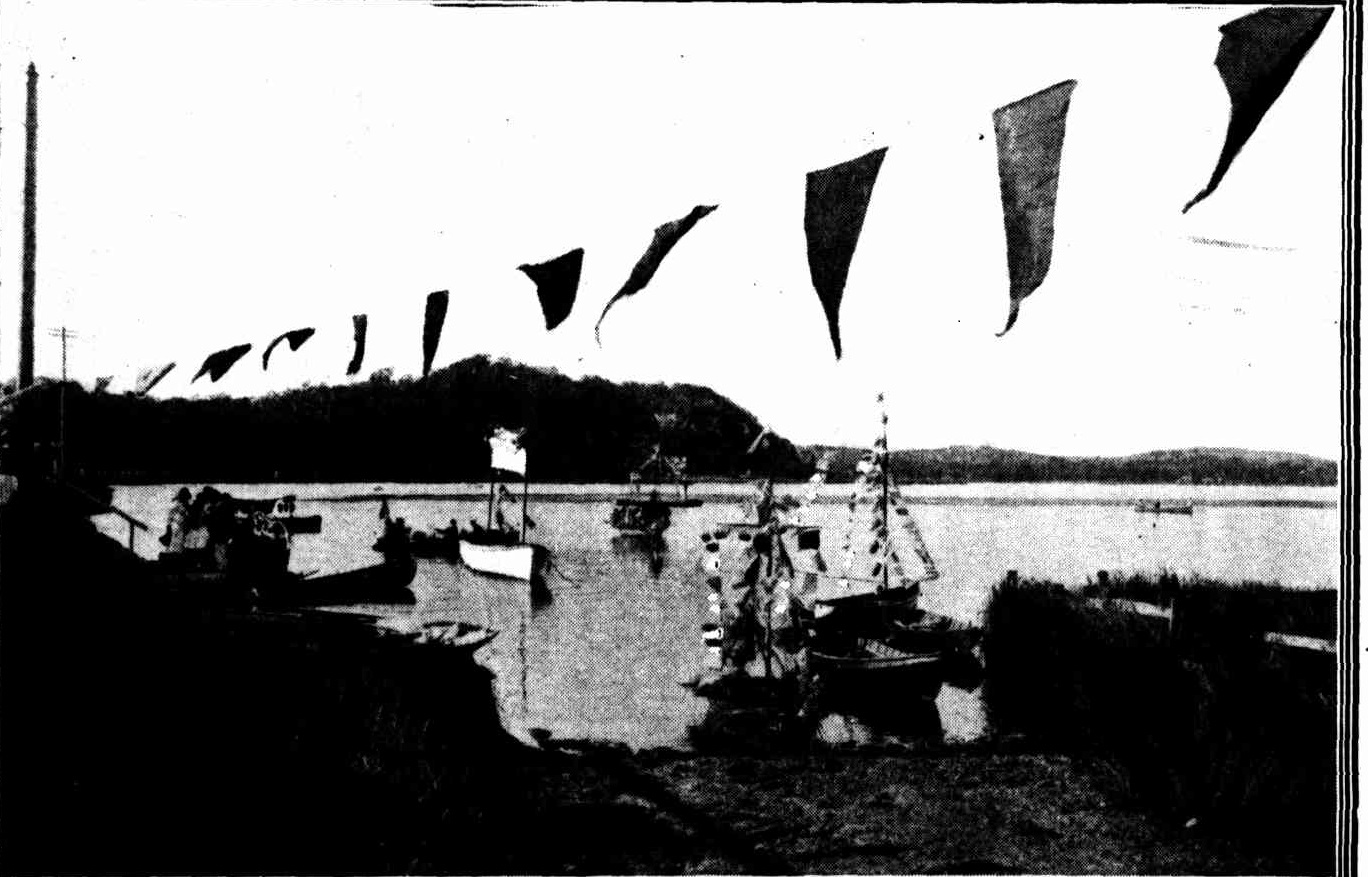
A Holiday at Narrabeen, between Manly and Newport. This view was taken on the occasion of the recent carnival at Narrabeen Lake in honour of the extension of the tramline to the bridge. OUTDOOR AUSTRALIA. (1914, January 7). Sydney Mail (NSW : 1912 - 1938), p. 10. Retrieved from http://nla.gov.au/nla.news-article158397083
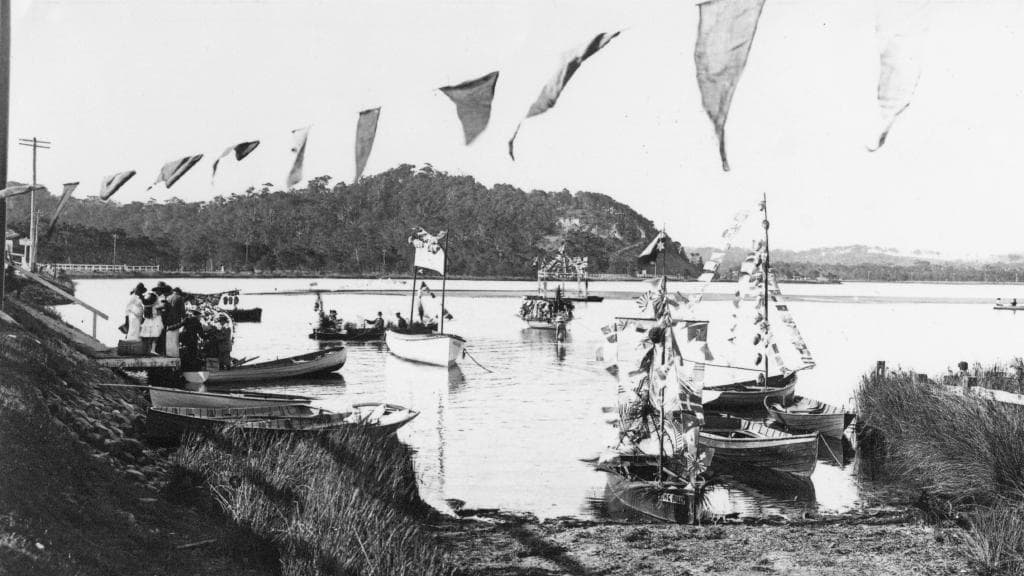
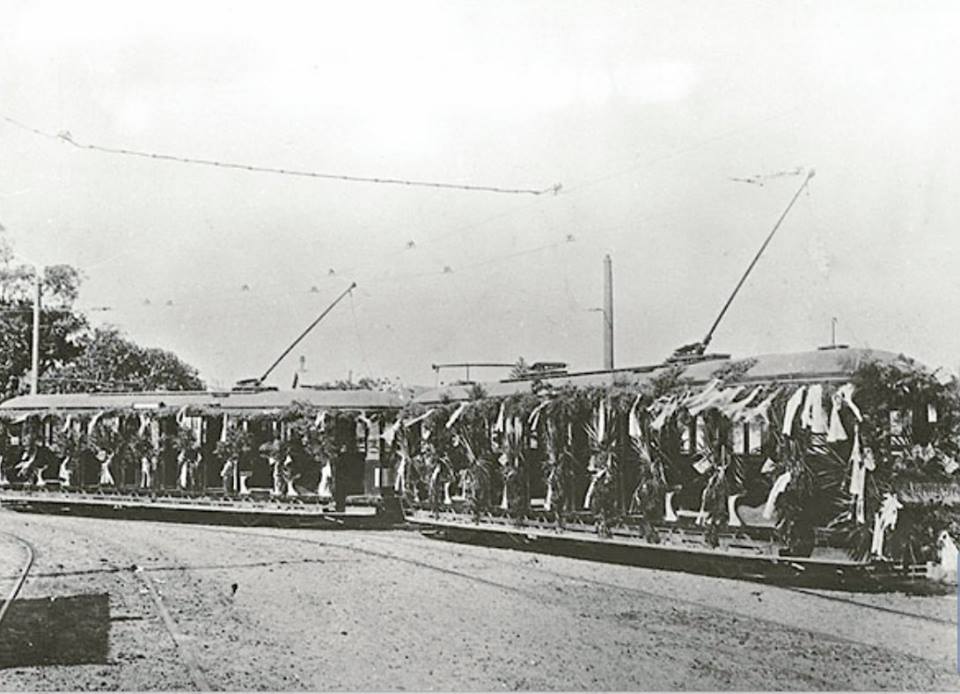
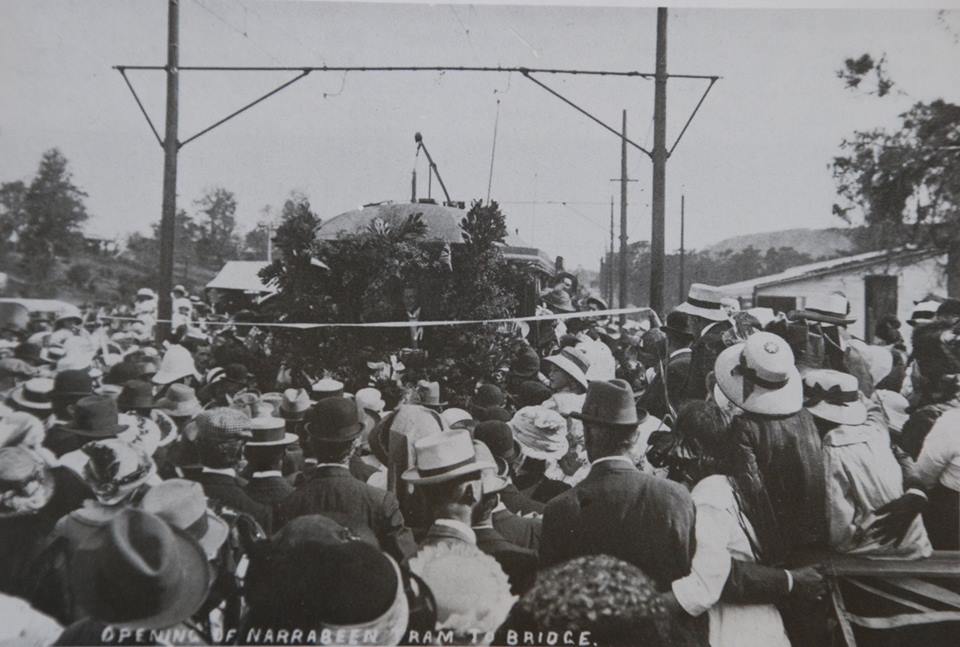
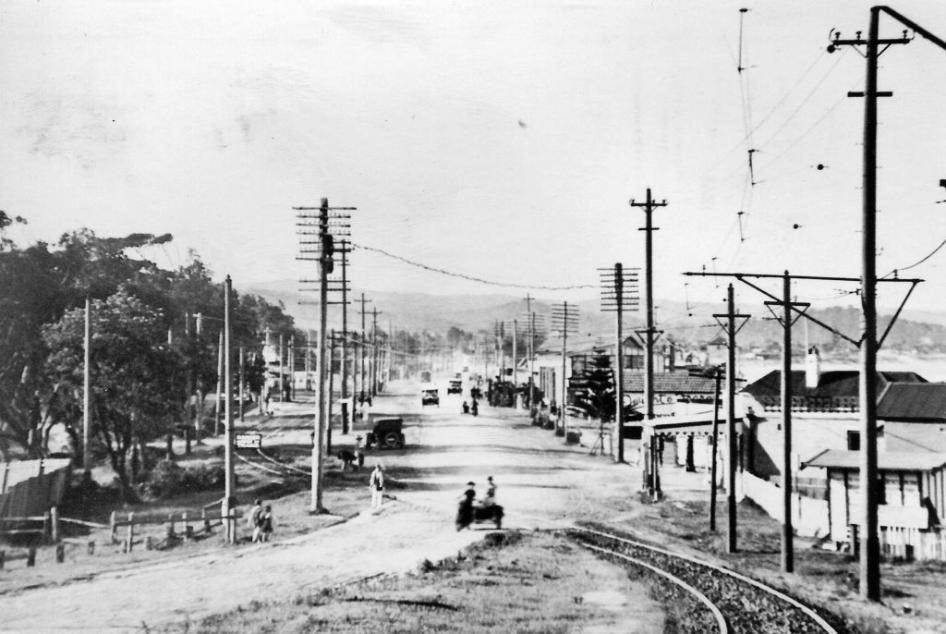
A mile south of Narrabeen Tram Terminus, 1925.
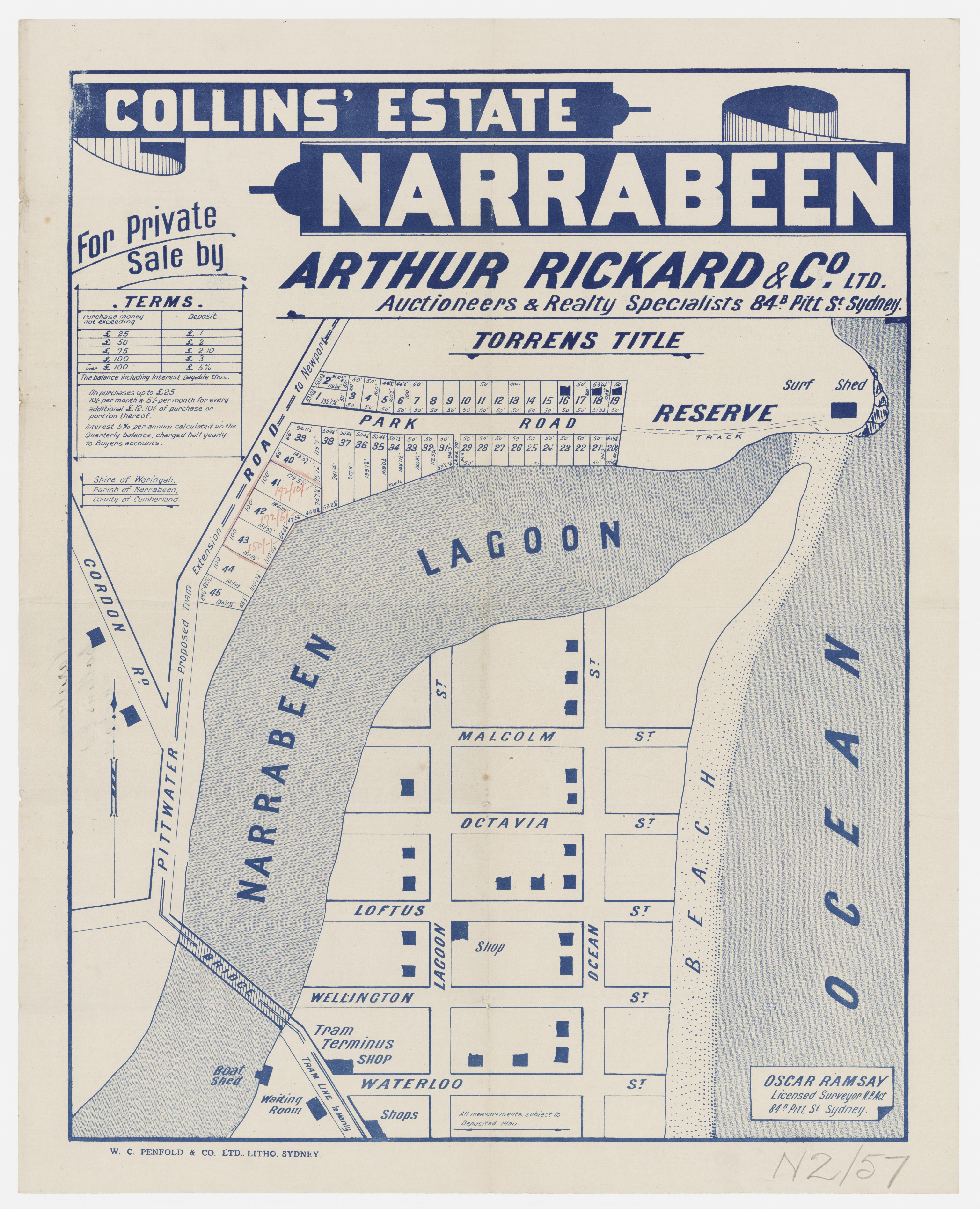
Narrabeen Collins Estate; Park Road - surf shed in place at north end of beach circa 1913 onwards Item c050370058
No. 14,499. APPLICANT:—John Thomas Collins, Narrabeen. LAND : —County Cumberland, parish Narrabeen, shire Warringah, 2 acres 37 perches and 3 acres 37 perches, on Narrabeen Lagoon, and on Manly to Pittwater road,—parts 50 acres (portion 47 of parish), granted to William Bernard Rhodes; adjoining property of J. T. Collins. NOTICE UNDER REAL PROPERTY ACT. (1912, June 12). Government Gazette of the State of New South Wales (Sydney, NSW : 1901 - 2001), p. 3668. Retrieved from http://nla.gov.au/nla.news-article221608288
No. 17,120. APPLICANT:—Roland James Pope, Manly. LAND:—County Cumberland, parish Manly Cove, shire Warringah, 2 roods 214 perches, and 1 acre 1 rood 34 3/4 perches, Victoria, King, and Ocean streets,—lots 7 to 10 inclusive, section 33, and lots 7 and 8, section 34, Mount Ramsay Estate, and lots o and 10, section 33 of Narrabeen Lakes subdivision of part Mount Ramsay Estate, and part 410 acres (portion 1,217 of parish) granted to John Ramsay; adjoining properties of Dr. R. J. Pope, and M. Mitchell. NOTICE UNDER REAL PROPERTY ACT. (1911, August 9). Government Gazette of the State of New South Wales (Sydney, NSW : 1901 - 2001), p. 4342. Retrieved from http://nla.gov.au/nla.news-article230685054
No. 16,973. APPLICANT James Wheeler, Narrabeen. LAND : County Cumberland, parish Manly Cove, shire Warringah, 1 acre 1 rood 31 1/2 perches, 3 roods 18 perches, 1 acre 3 roods 1 perch, 3 acres 11 perches, 1 acre 3 roods 3 perches, 34 perches, 1 rood 30 1/2 perches, 35 perches, 2 roods 2 1/2 perches, 1 rood 30 1/2 perches, 2 roods 2 3/4 perches, and 2 acres 3 roods If perches, in Jenkins, Frazer, Ramsay, Stuart, Wetherill, Clarke, Mactier, Goodwin, Devitt, Lagoon, Wellington, and Park streets, and on Narrabeen Lagoon,—lots 22 to 28. section 8; lots 9, 16, 17, 18, section 11: lots 10 to 14 and 17. 18, 19, scction 12; lots 13 to 26, section 16; lots 12 to 15 and 18 to 21, section 19: part lot 14a, section 20: lots 3, 4, 7, 11, 12, 13, section 21: lots 12, 13. section 22: lots 5, 7, 8, section 26: part lot 2: and lots 3 to 8, section 42, Mount Ramsay Estate: and part 410 acres (portion 1,217 of parish) granted to John Ramsay: adjoining properties of J. Wheeler, R. Pfoeffer, C. A. S. Hayden, E. A. Powell, C. M. E. West, H. S. Haynes, E J. West, Mrs. E. M. Loader, A. E. Ellis, C. A. de Kantzow, D. McLean, A. O. West, H. H. Gordon, W. Pollard, W. S. Beale, W. A. Lipscombe, W. L. McFarlane, estate J. Langley, J. F. C. Goodridge, A. E. Dowling, W. Nicholls, T. H. Page, and G. L. Pring. NOTICE UNDER REAL PROPERTY ACT. (1911, August 30). Government Gazette of the State of New South Wales (Sydney, NSW : 1901 - 2001), p. 4711. Retrieved from http://nla.gov.au/nla.news-article230685900
No. 16.930. APPLICANT:—Herbert Edgar McIntosh. Sydney. LAND:—County Cumberland, parish Manly Cove, shire Warringah, 4 acres 3 roods 36 perches. in Emerald, Lagoon, and Malcolm streets, and on Narrabeen Lagoon, whole section 60, Mount Ramsay Estate, and part 410 acres (portion 1,217 of parish) granted to John Ramsay. NOTICE UNDER REAL PROPERTY ACT. (1911, September 13). Government Gazette of the State of New South Wales (Sydney, NSW : 1901 - 2001), p. 4937. Retrieved from http://nla.gov.au/nla.news-article227592326
No. 17,037. APPLICANTS :—George Scales and David Lindesay Aitken, both Sydney. LAND : — County Cumberland, parish Manly Cove, shire Warringah, 96 acres 2 roods 7 1/4 acres, on Narrabeen Creek, near Narrabeen Lagoon,—land granted as 30 acres (portion 51 of parish), to James Wheeler, and 50 acres (portion 48 of parish), to John William Alexander White; adjoining property of estate late T. H. Kelly and Crown Land. NOTICE UNDER REAL PROPERTY ACT. (1912, April 10). Government Gazette of the State of New South Wales (Sydney, NSW : 1901 - 2001), p. 2230. Retrieved from http://nla.gov.au/nla.news-article227591158 - north west side of lagoon
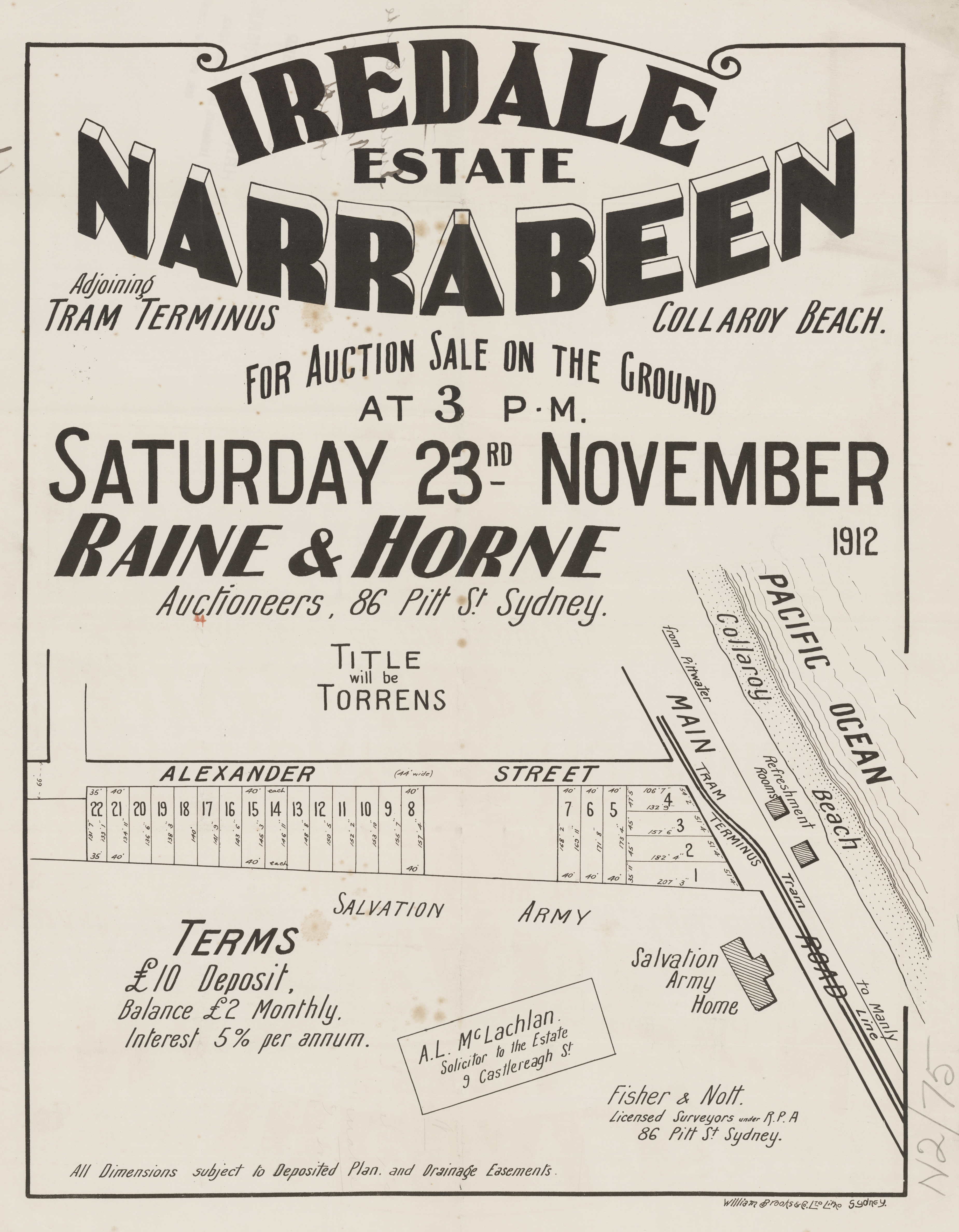
Narrabeen Iredale estate adjoining tram terminus 1912 - Item c050370078
No 18,067. APPLICANTS:—Lucy Maud Iredale, Alice Emily Iredale, and Florence Constance Iredale, all Surry Hills; Percy William Iredale, Glebe Point; Herbert Stanley Iredale, Marrickville ; and Leslie Peel Iredale, Darlinghurst. LAND :—County Cumberland, parish Manly Cove, shire Warringah,—1 acre 17 1/2 perches and 1 acre 3 roods 35 1/2 perches in Alexander-street, Narrabeen ; lets 5 and 6 and 12 to 2.3 and part lots 1 to 4, section 1, Mount Ramsey Estate ; and parts 410 acres (portion 1,217, parish), granted to John Ramsay; adjoining properties of M. M. Calvert, S. C. Twight and Salvation Army, and Crown Land. NOTICE UNDER REAL PROPERTY ACT. (1912, November 13). Government Gazette of the State of New South Wales (Sydney, NSW : 1901 - 2001), p. 6731. Retrieved from http://nla.gov.au/nla.news-article221611917
No. 18,068. APPLICANTS:—Lucy Maud Iredale, Alice Emily Iredale, Florence Constance Iredale, Surry Hills; Percy William Iredale, Glebe Point: Herbert Stanley Iredale, Marrickville; Leslie Peel Iredale, Darlinghurst. LAND: —County Cumberland, parish Manly Cove, shire Warringah, 1 acre 1 rood 7 1/2 perches, Victoria-street at Narrabeen,—lots 6 and 7, and part lot 8, section 32, Mount Ramsay Estate, and part 410 acres (portion 1,217, parish), granted to John Ramsay; adjoining properties of M. L. Marriott and Mrs. Naomi Cooper. NOTICE UNDER REAL PROPERTY ACT. (1912, December 18). Government Gazette of the State of New South Wales (Sydney, NSW : 1901 - 2001), p. 7367. Retrieved from http://nla.gov.au/nla.news-article221613534
NARRABBEN
Many land buyers have their eyes turned towards Narrabeen, which now that it has got tramway communication Is likely to rival many of the older seaside resorts. Land buyers will have their wishes gratified on Saturday. Messrs. Raine and Horne have the Iredale Estate in hand. This property has been cut up into 22 lots facing the main road, right opposite Collaroy Beach. Mr. Piercy Ethell is offering the beautifully situated Plateau Estate on Saturday, December 7. -This property, is on high land, and in close proximity to the famous fern gully. The land should bring tip-top prices. NARRABEEN. (1912, November 22). The Sun (Sydney, NSW : 1910 - 1954), p. 2. Retrieved from http://nla.gov.au/nla.news-article228835242
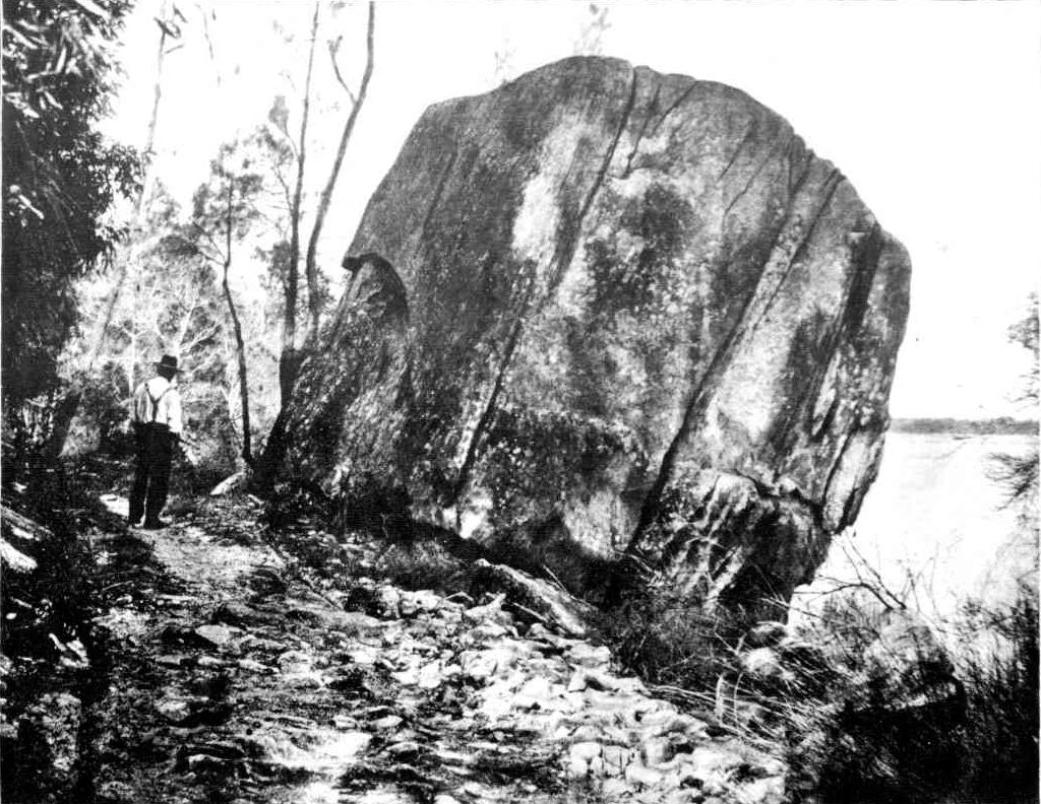
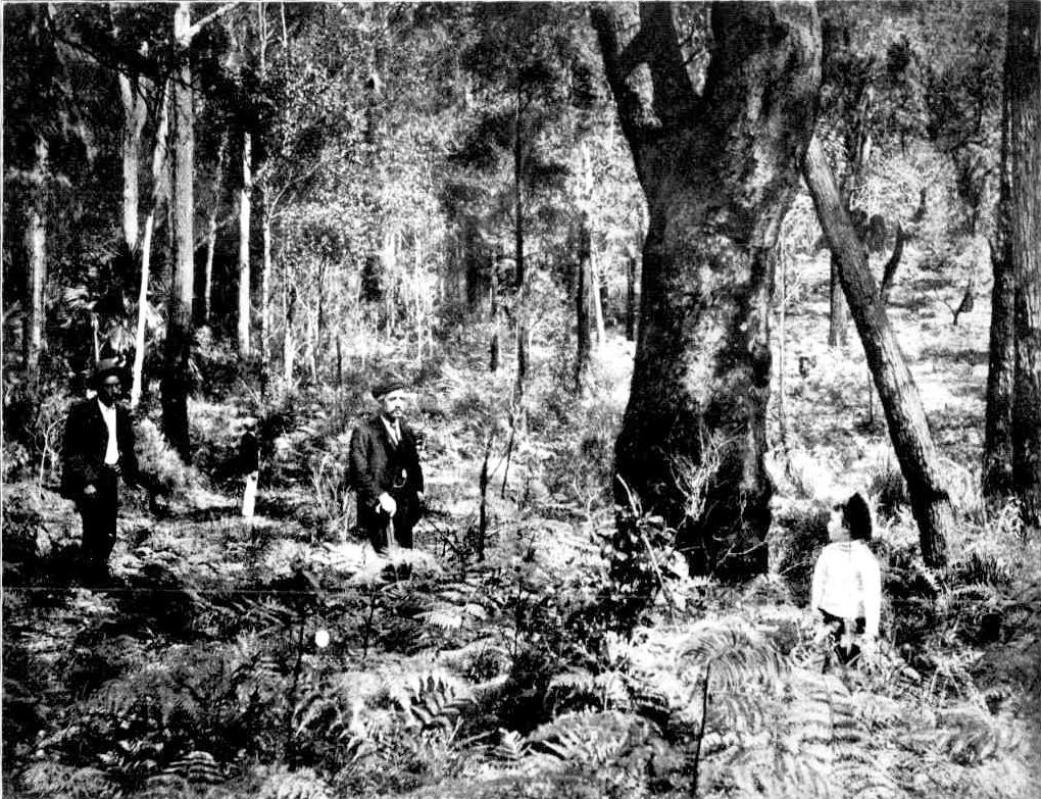
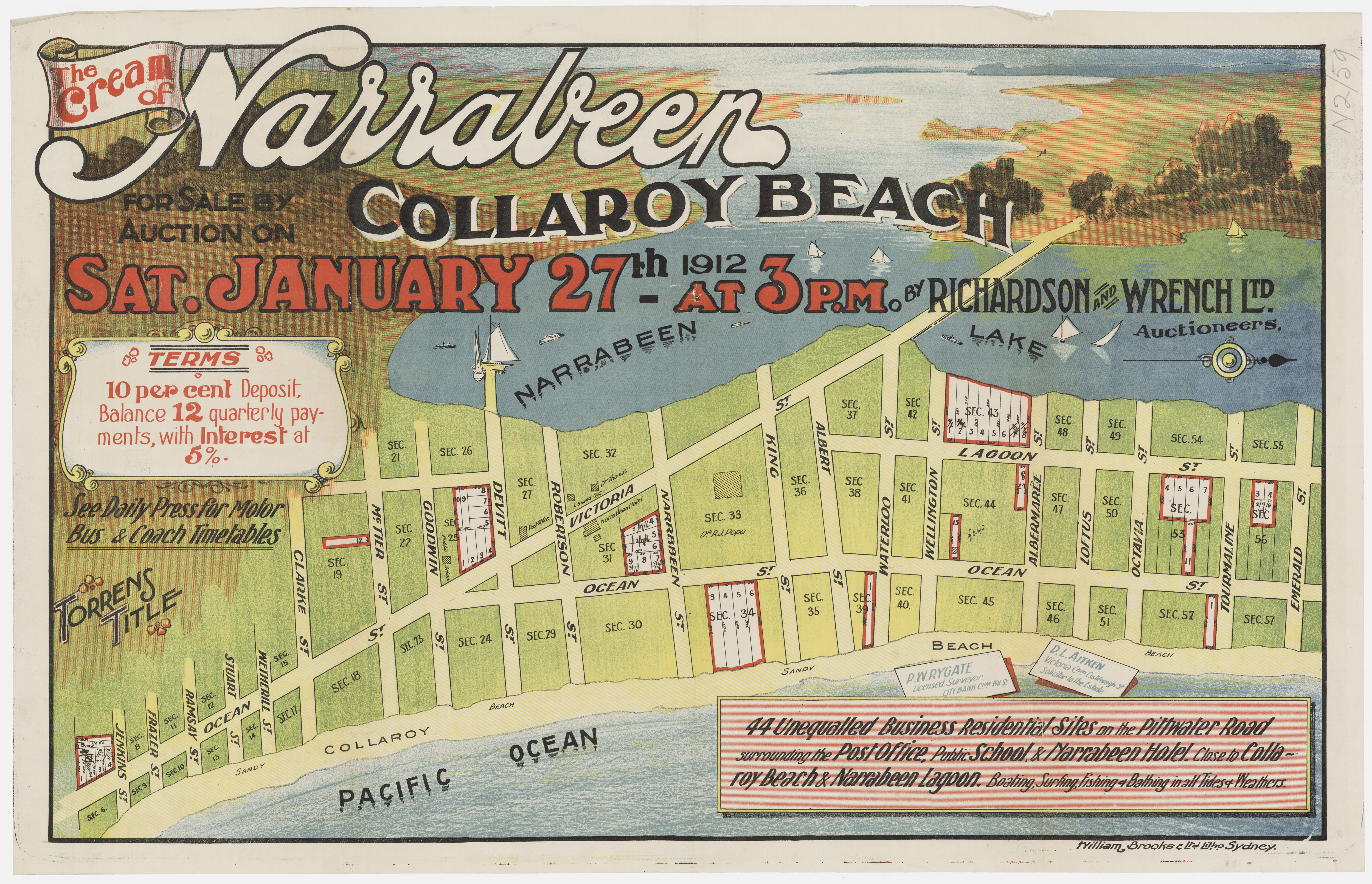
Narrabeen - Collaroy 1912 - Item c050370060, courtesy State Library of NSW
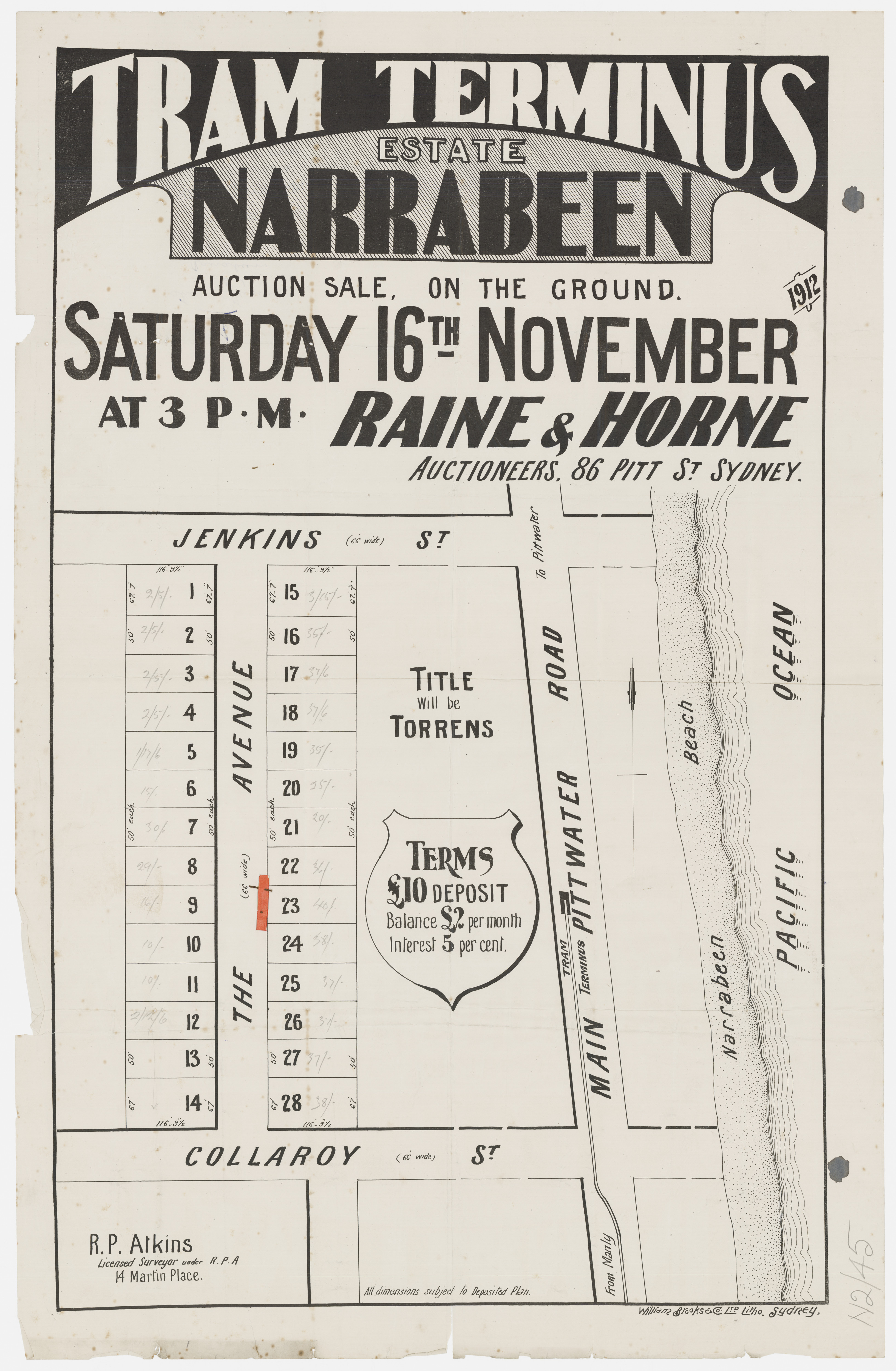
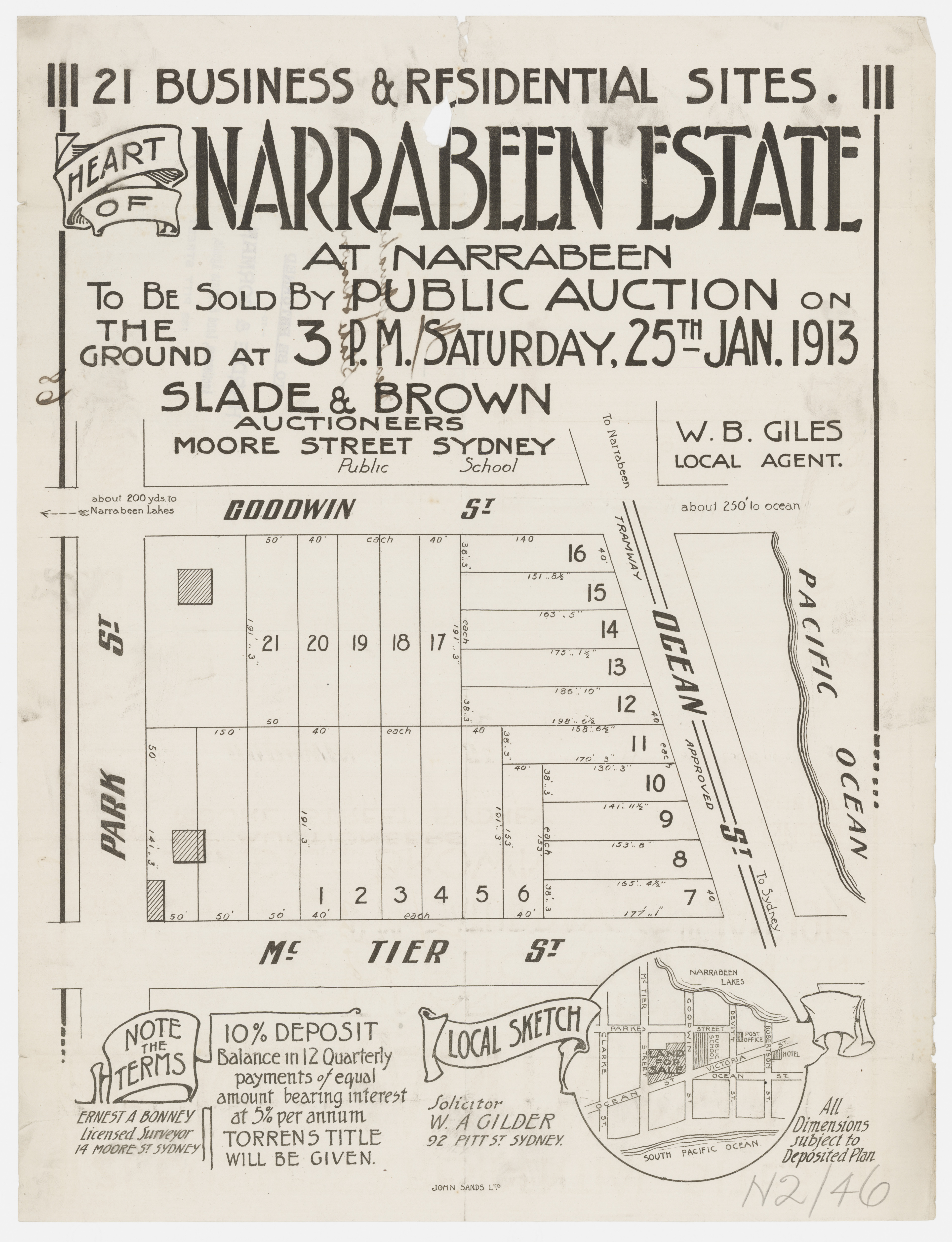
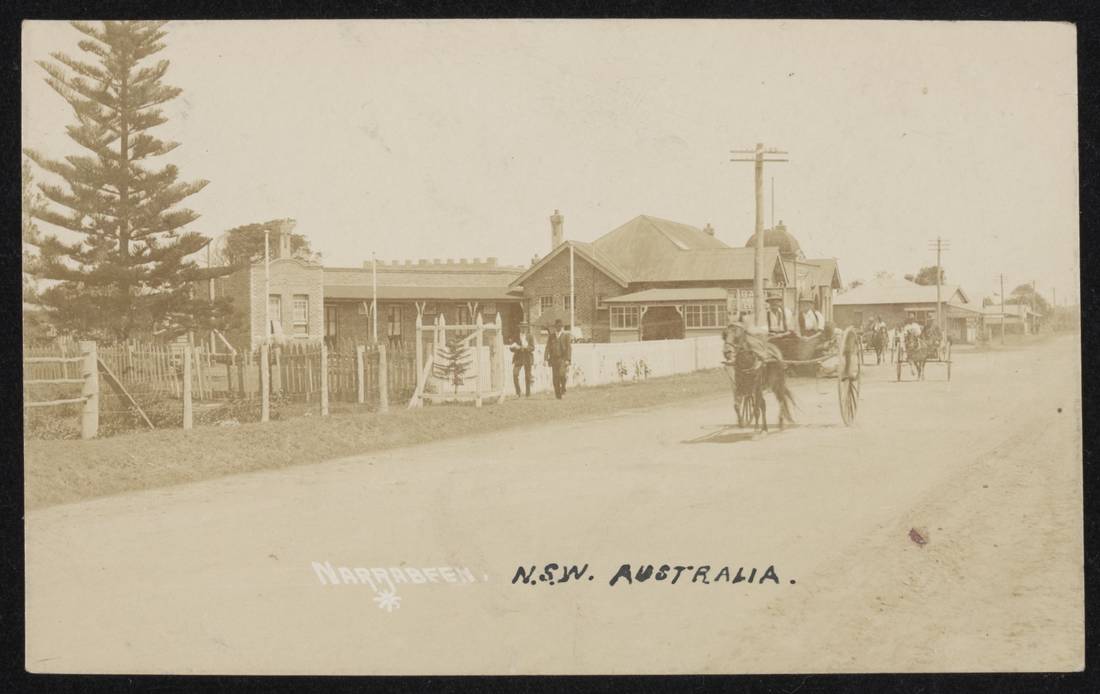
'Dear Ernie, Received your photo's today/ Thanks very much for same/ Glad to hear you are better and had a good time at Herne Bay/ I truly hope you will not have to go under an operation/ I think the photo at the Convalescent home is a good one of you considering how many there are in the photograph/ I have not much time to write you a letter this week and I know you like a p.c. now and again/ That is why I am sending p.c. this week, besides I wrote to Lill, Pop, Annie a letter each this week/ This is a photo of a place not far from Manly been there a good many times/ Bert'. - The partially rebuilt Narrabeen Hotel, courtesy National Museum of Australia.
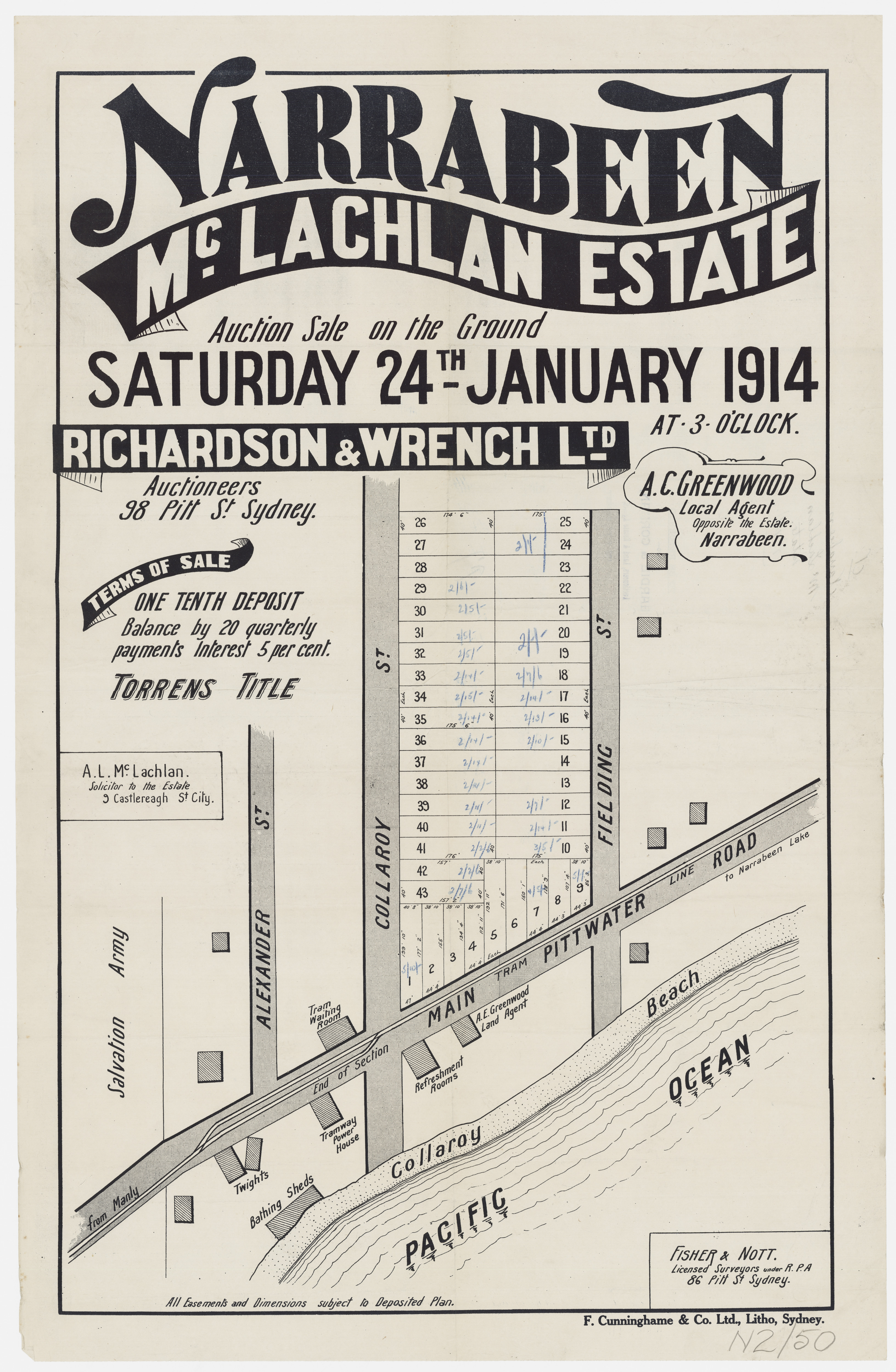
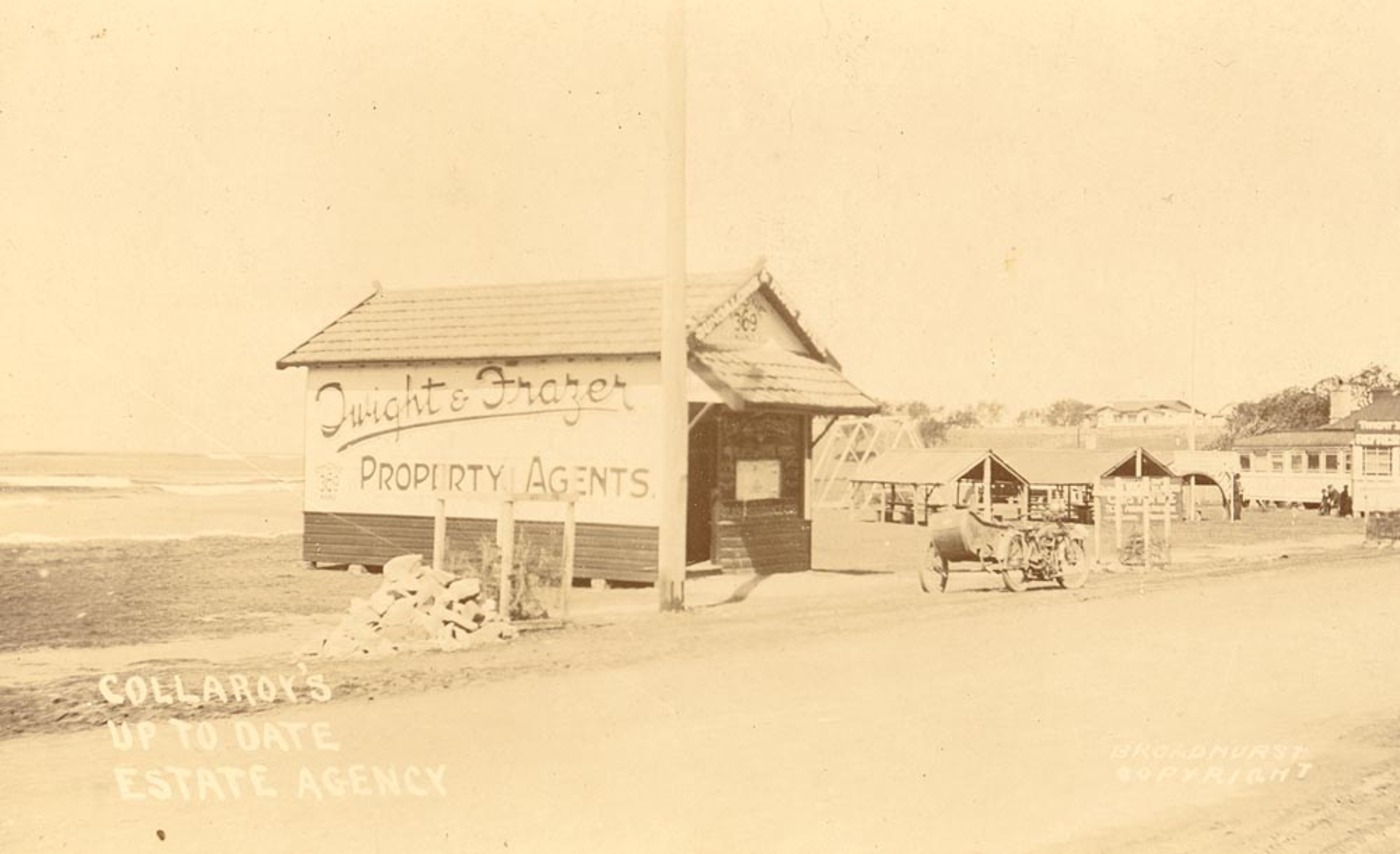
Collaroy's Up to Date Estate Agency [Twight & Frazer Property Agents] from Scenes of Collaroy, N.S.W. Album ca. 1900-1927 Sydney & Ashfield : Broadhurst Post Card Publishers, courtesy The Mithcell Library, State Library of NSW. Images No.: a105164h and below: a105163
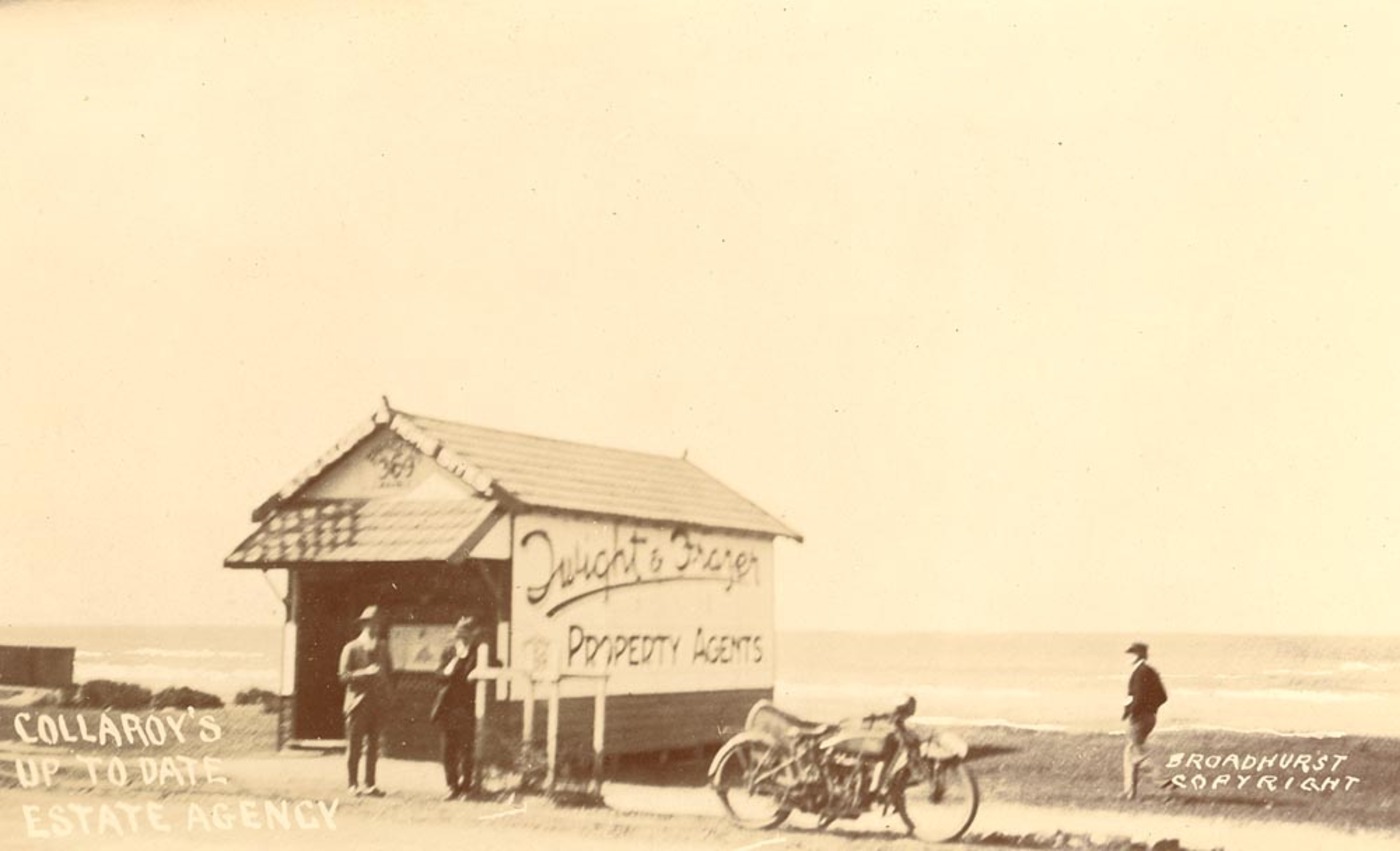
"THEATRES AND PUBLIC HALLS ACT, 1908." THE following list of theatres and public halls, to which the provisions of Part II of the "Theatres and Public Halls Act, 1908," have been applied, is published for general information. All previous lists are hereby cancelled. Narrabeen Beach Cafe Hall, Collaroy Beach:. Twight's Hall. "THEATRES AND PUBLIC HALLS ACT, 1908." (1920, April 1). Government Gazette of the State of New South Wales (Sydney, NSW : 1901 - 2001), , p. 2055. Retrieved from http://nla.gov.au/nla.news-article224641121
WANT, Young Girl to assist in shop; others kept. Good home found. Write particulars Mrs. Twight, Collaroy Tea Rooms, Narrabeen, Manly. Advertising (1921, February 28).Newcastle Morning Herald and Miners' Advocate (NSW : 1876 - 1954) , , p. 6. Retrieved from http://nla.gov.au/nla.news-article140025978
NOTICE UNDER REAL PROPERTY ACT.
APPLICATIONS having been made to bring the lands hereunder described under the provisions of the Real Property Act, Certificates of Indefeasible Title will issue, unless Caveats be lodged in accordance with the Third Schedule to the said Act on or before the 27th August, 1913:
No. 18.137. APPLICANT: James Wheeler, Narrabeen. LAND: County Cumberland, parish Narrabeen, shire Warringah, 109 acres 20 perches, on Pittwater and Gordon roads, at Narrabeen Lagoon, part land granted as 86 acres (portion 52. parish), to James Wheeler; adjoining properties of G. Sherring and J. Ingall, A Griffith, C. A. De Kantzow, G Powell, R. L. Walsh, J. T. Schecker, F. Francois, T. Watts, H. Shipp. A. J. Sheaves, J. E. Meller, Miss B. Munro, C. E. Ramsbotham, E. Young, A. Young, J. H. Mundy, C. Higson, A. Taylor. P. Fowler, P. Morrice, F. Eklum, J. Corless, T. H. Macpherson, and applicant. NOTICE UNDER REAL PROPERTY ACT. (1913, July 9). Government Gazette of the State of New South Wales (Sydney, NSW : 1901 - 2001), p. 4268. Retrieved from http://nla.gov.au/nla.news-article227051136
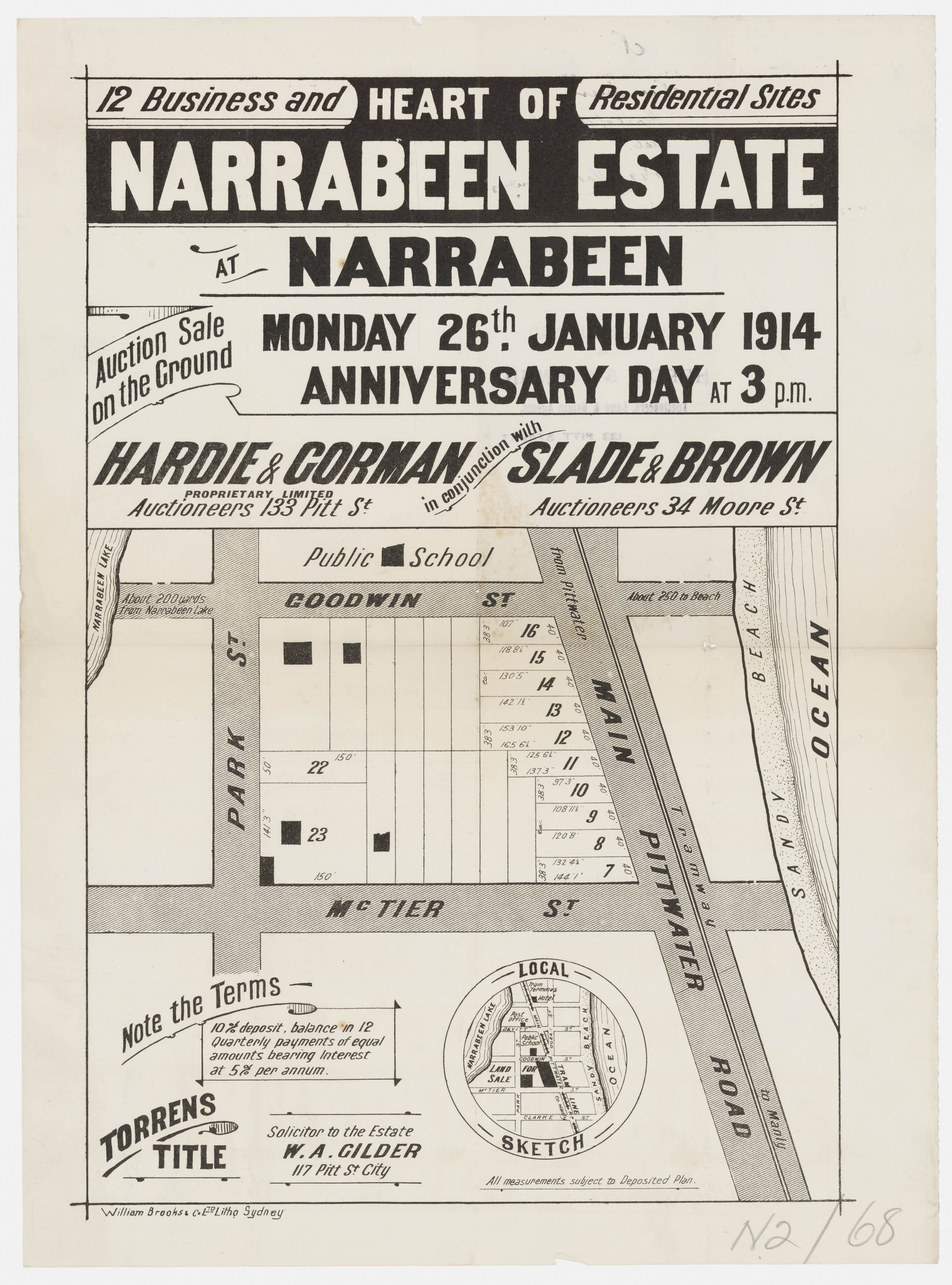
 larger.jpg?timestamp=1608629124087)
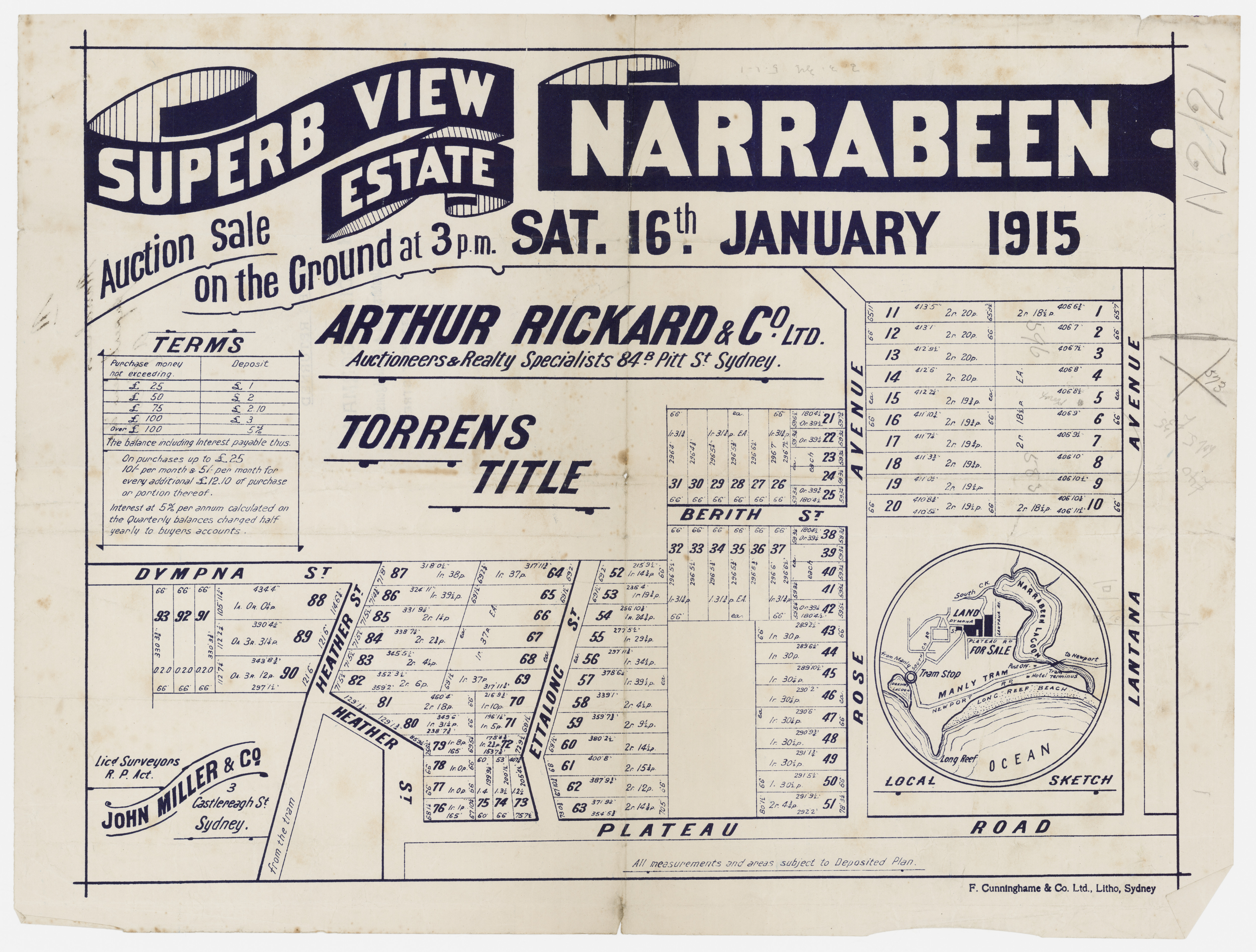
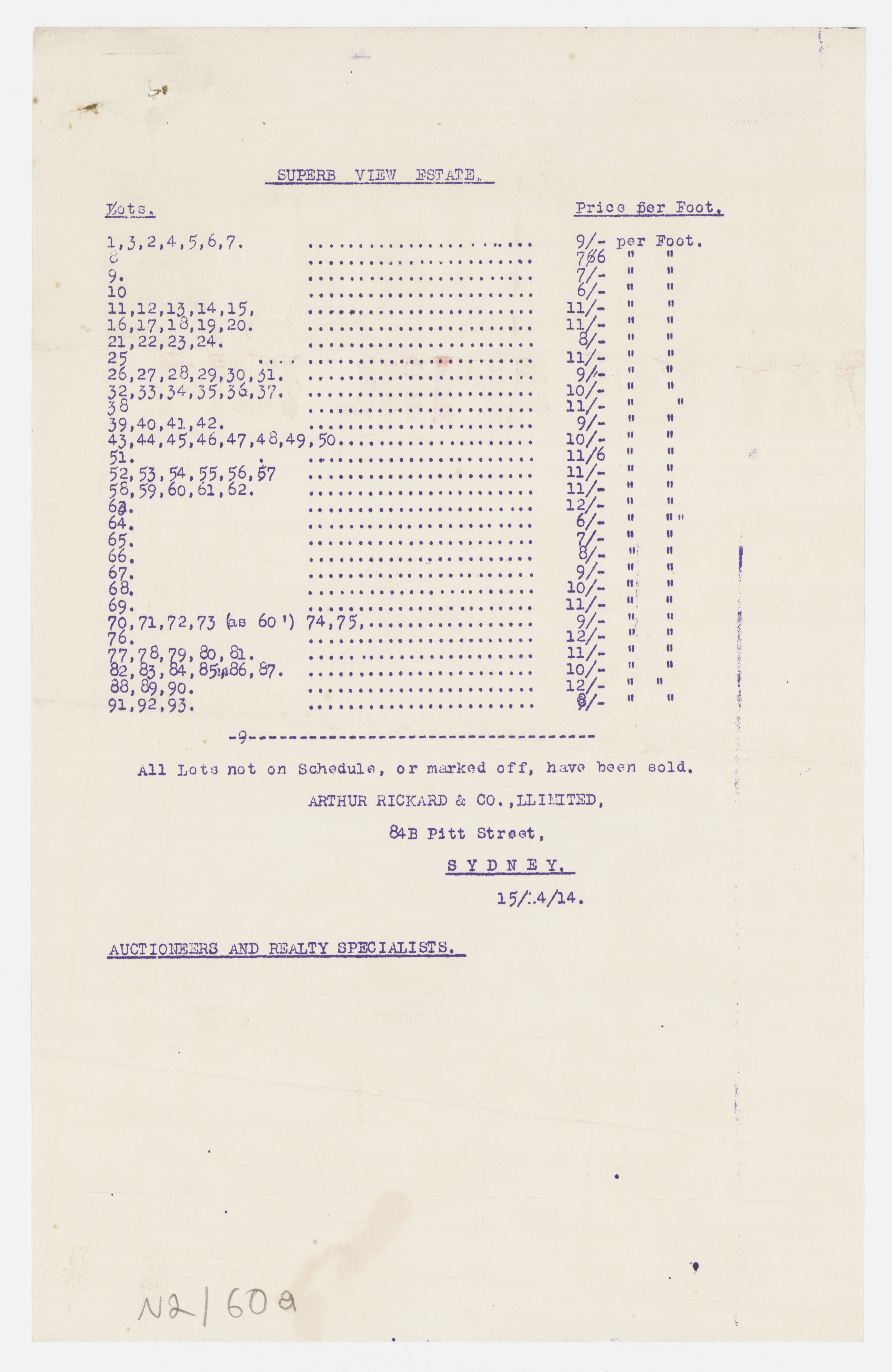
The Local Government Act 1919
The earliest form of planning controls in NSW were contained in the Local Government Act 1919 - this allowed local councils to control osubdivisions and declare "residential districts" to prevent industrial and retail development in such areas - but did not provide planning controls as understood today.
From its formation in October 1913 by Narrabeen frequenters to the Narrabeen home of Charles Scultz, accompanied by Edward Hallstrom (See: First Flight in Australia at Narrabeen) George and Florence Taylor, the Town Planning Association of New South Wales lobbied strongly for planning reforms, initially with strong support from the city's leading architects, surveyors and engineers. The outbreak of World War I hampered practical outcomes but the dialogue between state officials, civic authorities and planning advocates was revived as considerations of postwar reconstruction and repatriation loomed large towards the close of hostilities. In 1917 John Daniel Fitzgerald, minister for both Public Health and for Local Government in the Holman government, called for the universal adoption of town planning ideals, involving the;
benevolent co-operation of statesmen of all parties … of men of good will of all churches and creeds… [and] of [all] unclassified bodies of men and women who love their country and desire its development and progress.
His great passion was a new system of governance for greater Sydney to include metropolitan-wide town planning controls that culminated in the revised Local Government Act in 1919. This extended the range of discretionary powers for councils in subdivision and development matters (although not far enough according to Nesbit). While planning controls were not introduced, councils were empowered to declare 'residential districts', a provision exploited wilfully by well-heeled municipalities anxious to prevent incursions by factories and shops. Fitzgerald also appointed a Town Planning Advisory Board. The pattern of metropolitan growth was left to market forces.[4.]
From the Local Government Act 1919:
DIVISION 3.—Residential districts.
309. (1) The Governor may on the application of the council—
(a) declare by proclamation any defined portion of an area to be a residential district;
(b) by proclamation alter or abolish a residential district ;
(c) prohibit the erection in such district of any building for use for the purposes of such trades, industries, manufactures, shops, and places of public amusemen t as may be described in the proclamation ; and
(d) prohibit the use of any building in the district for any such purposes ; and
(e) prohibit the erection or use of advertisement hoardings in the district.
(2) Nothing in this section shall preclude the continuance of the use of any building for any purpose for which such building was used at the date of the proclamation aforesaid, or for such other purpose as the council may in the circumstances deem reasonable.
DIVISION 4.—Applications, plans, and specifications.
310. Subject to the provisions of this Ac t and of any ordinance every building hereafter erected in the area shall be erected to the satisfaction of the council—
(a) in conformity with this Act and the ordinances ;
and
(b) in conformity with the application, plans, and specifications in respect of which the council has given its approval for the erection of the building.
There was also, in the commencement of the Local Government Act 1919 in 1920, the status of roads shown in plans of subdivision has rarely been in doubt. That Act, and its successor, provided that, on the registration of a plan of subdivision showing a road and containing a statement of intention to dedicate it as a public road, the road was so opened, and remained so.
Before that date, and this Act, the status of roads in plans of subdivision could be, and often was, in doubt. Save for a limited number of roads governed by some early 19th century statutes, the question of whether a road in a subdivision had been opened as a public road or not was left to the common law, which required both an intention to dedicate the road as a public road, and actual use of the road by the public, or adoption by the council on the public's behalf (as, for example, by sealing it). The position was further complicated by the possible application of an ancient legal rule which provided, in effect, that the creation or sale of a lot described or shown as adjoining a road gave that lot title to the land to the middle of the road, subject to any rights of use which the public, or other owners, might enjoy.
Because of this uncertainty, the Local Government Act 1919 contained provisions enabling a council, in cases of doubt, to publish a notice in the Gazette after notifying affected owners, whereupon the roads became public roads. An appeal process was open to owners who received notice. Similar provisions are now found in sections 16 and 17 of the Roads Act 1993.
From the Local Government Act 1919:
226 . (1) Public roads may be classified in relation to the use which they are intended or calculated to serve.
(2) The classification shall be as follows, that is to say—
(a) main roads, being roads proclaimed as main roads ;
(b) secondary roads, being roads for general local traffic ;
(c) residential roads, being roads primarily for access to residences;
(d) pathways, being roads exclusively for footpassengers and such classes of vehicles propelled by foot-passengers as may be prescribed ;
(e) lanes, being roads primarily for access to the back of premises.
(3) The classification shall be made by the council except in respect of main roads.
(4) The classification shall be fixed and take effect upon notification in the Gazette. It shall also be notified in a newspaper.
(5) Subject to the provisions of this Act and until roads are classified hereunder—
(a) all public roads which are sixty-six feet wide or over (other than main roads) shall be deemed to be secondary roads ;
(b) all public roads which are more than twenty feet and less than sixty-six feet wide (other than main roads) shall be deemed to be residential roads ;
(c) all public roads which are more than twelve feet and not more than twenty feet wide shall be deemed to be lanes ;
(d) all public roads which are not more than twelve feet wide shall be deemed to be; pathways.
(6) The provisions of this Act with respect to classification of roads shall, unless inconsistent with the context, be deemed to include alteration of classification and re-classification.
227 . (1) There shall be a standard width for each class of public roads, that is to say—
(a) for a main road not less than eighty feet;
(b) for a secondary road—sixty-six feet;
(c) for a residential road—sixty-six feet;
(d) for a pathway—twelve feet;
(e) for a lane—twenty feet;
(2) In the case of a public road in existence at the commencement of this Act the fact that the road is less than the standard width for a particular class shall not preclude it from being assigned to that class.
(3) The Width of Streets and Lanes Act, 1902, shall not apply to a municipality or shire.
228 . The width of a road shall be ascertained by measuring at right angles to the course thereof from the alignment on each side of the road.
229 . (1) Subject to this Act every new public road shall—
(a) be classified before it is opened; and
(b) be opened to or beyond the standard width for its class.
(2) In the case of a new residential road the council may on such terms as it deems proper permit the opening of a residential road of less than the standard width :
Provided that any such residential road shall not have less space than three feet for a footway on each side and fourteen feet between the footways for carriage way, treeplanting, and the like, together with such turning and passing places of additional width for vehicles as the council may require.
Section 340A Local Government Act 1919 provides that parcels shown as 'public garden and recreation space' (and no others) can be conveyed or transferred to the council as public reserve. The provisions of s.340A were carried over to s.50 of the 1993 Act and still enable a council to acquire title to 'public garden and recreation space' shown in a plan approved before 15 June 1964. The section provides that the council may either:
direct that the parcel be transferred to the council (s.50(2)) or
publish a notice in the Government Gazette notifying that the land is vested in its name (s.50(4)).
Section 340D Local Government Act 1919 commenced on 16 June 1964 and enabled a 'Public Reserve' to vest automatically in Council upon registration of a deposited plan of subdivision provided the plan bears a statement (on the administration sheet) to that effect:
IT IS INTENDED TO DEDICATE LOT .... AS A PUBLIC RESERVE
See also s.195C(1)(d)(ii) Conveyancing Act 1919.
The words 'PUBLIC RESERVE' must be added to the relevant lot on the face of the plan.
A certificate of title for the new public reserve lot is created in the name of the council. A 'KP' notification is entered in the second schedule:
THE LAND WITHIN DESCRIBED IS PUBLIC RESERVE
The provisions of s.340 were carried over into ss.49(1) and (2) Local Government Act 1993.
Locally:
MAKING NEW HOMES FOR SYDNEY
NOTABLE SUSPENSION BRIDGE
Gordon-Narrabeen Belt
To the north of Sydney— not very far north, indeed, but sufficiently so to be out of the reach of anything short of well-organised exploration— lies a region where man (so far as a speculative builder can be called man) has never placed his foot. The dense population which accumulate more and more' thickly around Sydney's central area, do not spread that way. South of the harbor they have accumulated evenly and without serious gaps. A five-mile half circle, struck out from the post office, reaching1 the Heads on the east and Drummoyne on the west, -will take in Cook's River on the south, and this half circle will be full of houses. It practically represents the area of the congested residential suburbs.
But across the harbor, the remaining half of the circle will be filled mainly with scrub. There is an inhabited nucleus of Milson's Point and Neutral Bay, with Mosman, Artarmon and Gore Hill scattered around them, but once out of these redoubtable suburbs, whatever population there is drags along the three gradually dwindling lines of the Lane Cove, the northern line, and the ocean front, till it subsides, little by little, into the unpopulated deserts of the' Hawkesbury slopes beyond Hornsby and Newport.
Keeping away from the three main lines of settlement — or rather keeping between' them, for they stretch out like arms of a star fish from Lavender Bay — one can get into virgin bush in about three or three and a half miles in any direction.
New Residential Belt
Energetic spirits in the neighborhood have accordingly aimed at adding to the available residential area of their ''Shore' a new belt running east, and west from Gordon to Narrabeen. The proposal (which lately came before Mr. Estell, the Minister for Works) for a railway connecting these two points, owes its origin to the general rushfulness of the two enterprising shire councils of Kuring-Gai and Warringah — representing respectively the hills and the coast areas concerned. From Gordon the suggested route stretches across St. Ives, a highly successful orange-growing district, and then plunges at once into 10,000 acres of Crown lands — almost entirely unpeopled at present — all, or nearly all, of which it is asserted could be made to' (yield as freely as St. Ives, if connected up with the existing lines by a rail to Gordon.
The visitor to the district, before being permitted to tax his intellect with speculations of this character, however, is taken to see Gordon's latest triumph of local administrative and engineering skill, a suspension bridge across one of its many picturesque gorges, which, so Mr. Fitzsimmons, the president, freely boasts, has cost neither the Council nor the Government a penny. When one asks how this miracle has been achieved, It is replied, by the imposition of a light special tax upon the enhanced value of the land upon the farther side of the gorge, which the bridge has opened up.
Residences here — previously inaccessible—are now brought within ten minutes' easy walk of the station. Land is rapidly being built upon, and is in high demand, and owners pay without audible repining the tax required to cover interest and sinking fund on the cost ol the bridge 'that carries them over.' The design of this bridge-itself a most elegant example of constructional aesthetics — is the work of the shire engineer, Mr. Kirkpatrick, who is the son of the late Under Secretary to the Treasury.
The bridge, which is so built as to sway slightly under the footsteps of the pedestrian, thus had to be traversed twice by the members of a select party which waited upon Mr. Taylor, the 'oldest inhabitant' of the gorge, once M.P., and it was noted by all that the swaying was distinctly more perceptible on returning after a brief but quickening experience of his discriminating hospitality.
Tumble-down Dick
Having passed St. Ives and the homes of various orange growers who are making huge incomes on tiny allotments, one skirts the boundary of Kuringai Chase for a while, before plunging into the Crown land area before mentioned. This area is a rich one. The soil is black, the timber heavy, and the undergrowth o£ the dense and varied type that tells the experienced Sydneyites that there is something there besides his native sandstone. Beyond its eastern boundary .lie.; the long descent on the road which leads from the highlands one has hitherto been traversing, to the water levels of the coast.
This is Tumble-Down Dick, once, a mere vaguely known remoteness to dwellers on the southern side; now, in this age of motor cars becoming more familiar, from which a finer series of views of the Pacific can be had than from any other point this side of Newport. The ocean and the Narrabeen Lagoon come swiftly into view in aspects so rapidly changing and so enchanting that the journey is ended among them practically before one realises that the. plateau has been left behind. Narrabeen is reached — bustling and prosperous Narrabeen, with its new houses arising apparently in countless hundreds and its many thriving shops and businesses.
'This is the transformation,' it is said 'that a mere tramline has effected here. A few years ago and Narrabeen had no population beyond a couple of hotels full of guests, and a few dsmented artists who had wandered down here to seek for local color for pictures of the Dead Heart of Australia. What an infinitely greater change will a direct connection! with the Northern line necessarily bring' about!'
The financial prospects of the line are stated locally thus. First, the sale of Crown lands at an enhanced value would pay for the whole line, or nearly so. Secondly, there would be large settlement along its route — chiefly of orange growers —and their traffic would make the line pay; Thirdly, it would be used by residents of the Northern Suburbs as a way down to the ocean beaches of Collaroy and Narrabeen. The possibilities of this last source of revenue can, no doubt, be easily overstated, but apart from this its prospects look solid enough. The advantages to the metropolis as a whole of the opening-up of this hitherto untouched hinterland would be enormous.
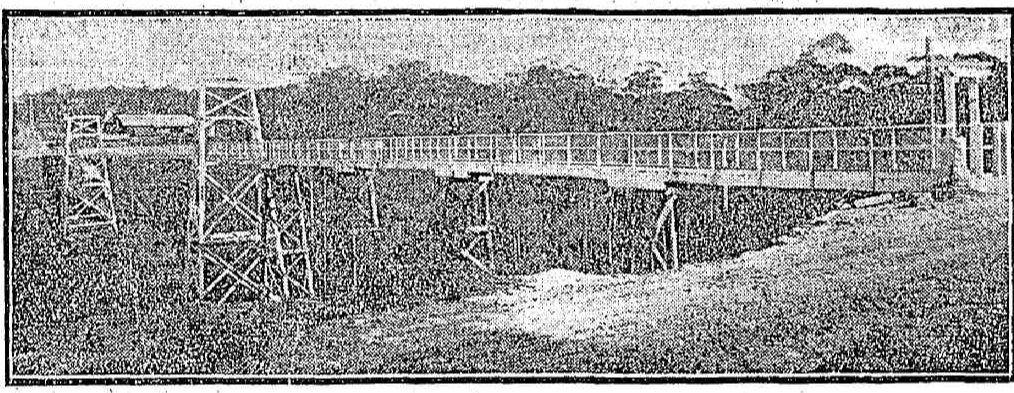
A SUSPENSION' BRIDGE BUILT WITHOUT A SHILLING OF GOVERNMENT OR MUNICIPAL LOAN. HOW WAS IT DONE. BELOW, MAP OF PROPOSED INTER-SUBURBAN RAILWAY.
.jpg?timestamp=1609949771270)
MAKING NEW HOMES FOR SYDNEY (1921, July 24). Sunday Times (Sydney, NSW : 1895 - 1930), p. 11. Retrieved from http://nla.gov.au/nla.news-article123240150
WHERE TO LIVE
Our Suburban Problem EXPANDING RESIDENTIAL ZONE Great Lack of Facilities
Sydney's rapidly expanding- suburban area and the congestion of the nearer suburbs raises the Important question; In which direction must people drift to make their homes?
There is adequate land in handy localities for all classes, but the system of transit is behind the times and people are being forced along certain defined routes at an ever - increasing distance from the city.
The City of Sydney, with its enormous suburban areas, is outgrowing itself. Like a great commercial giant, it is stretching its arms, and sweeping the rapidly Increasing suburban population further afield; and all this huge expansion is taking place at a pace that is years ahead of the transit and water and sewerage facilities.
In which directions is suburban Sydney to expand In the future? Where are the large tracts of land to be found within reasonable travelling distance of the great centre of employment and industry to house the people under the healthy hygiene conditions which ... civilisation demands?
Obviously settlement follows lines of communication, but on all sides there is the spectacle in suburban Sydney of important settlements springing up in areas where the transit facilities are hopelessly inadequate. Still, the tendency is to follow the railways and tramways, and so, in many cases, vast outer areas are being developed and settled while comparatively close tracts of land of exceptional residential value are lying idle for the want of communications and other facilities.
To express the position In a few words, there is ample land within less than a twenty miles radius of the Sydney General Post Office to carry more than double the present population.
Three Types of Expansion
There are, broadly speaking, three distinct types of residents drifting into the outer suburbs. There is the working man who, in increasing numbers, is acquiring his own home; there is the middle to wealthy class, who seek exclusive areas, and perhaps a larger area of land tor their homes; and there is, generally, the lover of the waterside, who insists on living within reach of the surf or the harbor.
So, accordingly, there are definite directions of expansion, chosen almost automatically by those different classes. Among all, however, the spreading out is rapid, and there is a vast quantity of land either on the market or ready to be put on In all quarters.
Hugging the Beaches
There is a growing tendency to flock to the beaches. All classes of people seek to get as near to them as possible, with the result that the suburbs situated handy to the City are already greatly over-crowded. But, fortunately, there is room for expansion, and those who are closely associated with the business of providing land for building purposes declare that the whole of that vast area between Manly and Narrabeen, and later on even as far as Newport, will become the waterside suburbs to the north; while on the southern side of Sydney the whole of the land between Bondi Coogee and Long Bay, will be taken up and built upon.
It is in this latter direction that the waterside expansion of the working class section of the community will in all probability rapidly drift, because of its proximity to the ever-growing Industrial areas.
The steamer Journey from Manly, preceded by the long tram trip from the beaches to the north, make it an awkward place for workers.
But the Increasing popularity of the beaches cannot be denied, and, apart from those definitely defined areas, such as the Illawarra suburbs, which are pretty well linked up with railway communication, should be among the most sought after localities.
Working Class Areas
A spreading out of the population throughout the whole of the county of Cumberland is Inevitable In the years to come. The county is rather a mysterious place to most persons who have not the faintest Idea of the actual area it embraces, despite the fact that it is brought under their notice every week by hundreds of Government notices and proclamations.
It extends from the Hawkesbury River on the north to between Bulli and Thirroul on the south, and to Penrith in the west. ....
Choice Sites
As Is only natural of course, the areas where large homes already and the direction in which this class of expansion is likely to go, is to be found among the higher altitudes of the North Shore and main northern lines, beyond Mosman, through Middle Harbor, and out over that magnificent high country that extends almost from Northbrldto to Narrabeen and Newport. .... WHERE TO LIVE (1919, March 6). Evening News (Sydney, NSW : 1869 - 1931), p. 4. Retrieved from http://nla.gov.au/nla.news-article120839591
Warringah (N.S.W.) Shire Council is considering a report furnished by their engineer, suggesting that 50 feet by 100 feet be the minimum size of building allotments in residential areas. Business Opportunities (1920, August 2). Construction and Local Government Journal (Sydney, NSW : 1913 - 1930), p. 8. Retrieved from http://nla.gov.au/nla.news-article108986690
Not every suburb in our area was instantly proclaimed a residential one, these occurred as more and more homes were built and people settled permanently in these areas or 'villages'. We still had a 'country' feel and 'resort' atmosphere that persisted, with lots of orchards, dairies or tomato growing districts that persisted into the 1960s. This first version of local governemnt often chose to respond to meeting the needs of its residents - one example comes from the Shire Conference of 1921:
Disposal of Fruit.
The Warringah Shire Council asked for co-operation-re the following resolution;
''That, in view of the recent wholesale wastage of fruit, this -council invites the co-operation of the Kuring-gai, Hornsby, Erina, and Baulkham Hills Shire Councils-in asking the Minister for Agriculture to convene a conference of representatives from all fruit-growing districts to consider the best means of disposing of this necessary commodity, either by co-operative jam factories on the lines of those of the butter industry, which have made dairying such an enormous success, or by any other means the conference may consider desirable."
Cr. Pye moved, '' That we co-operate." Something should be done with regard to this matter. They had adopted this idea at Leeton, and he did not see why it could not be done here.
The motion was carried.
The President and Cr. Pye were appointed delegates to the proposed conference. Blacktown Shire Council (1921, January 29). Nepean Times (Penrith, NSW : 1882 - 1962), p. 3. Retrieved from http://nla.gov.au/nla.news-article104928566
A few years later:
THE WONDERS OF WARRINGAH
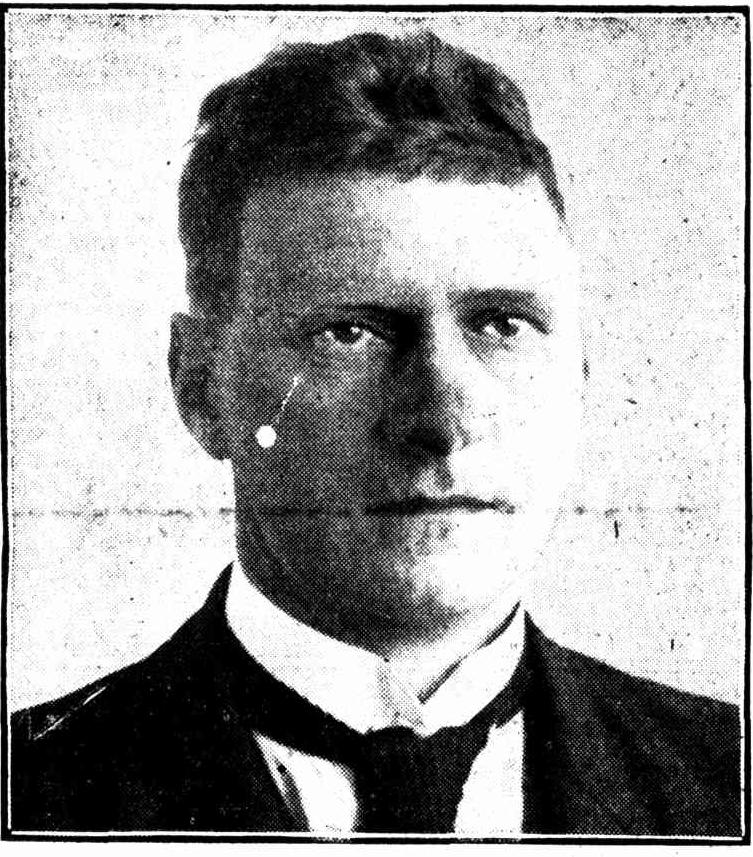
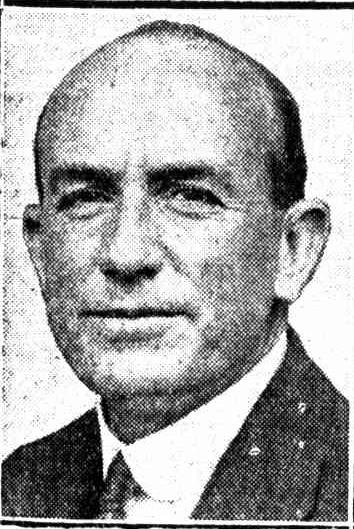
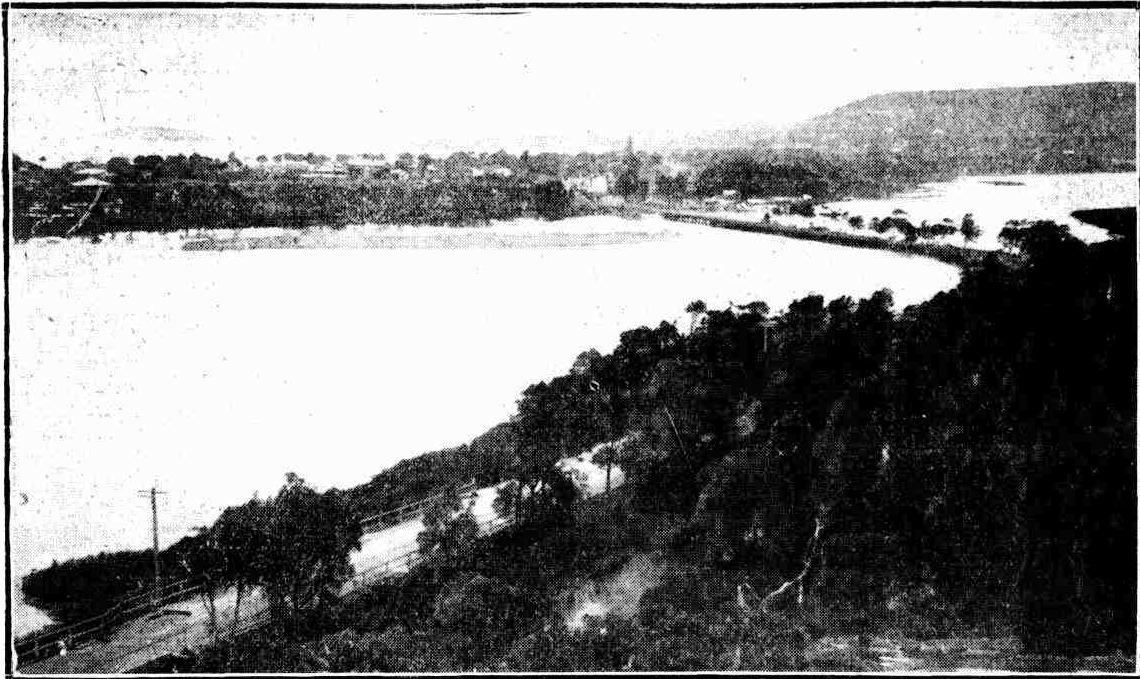
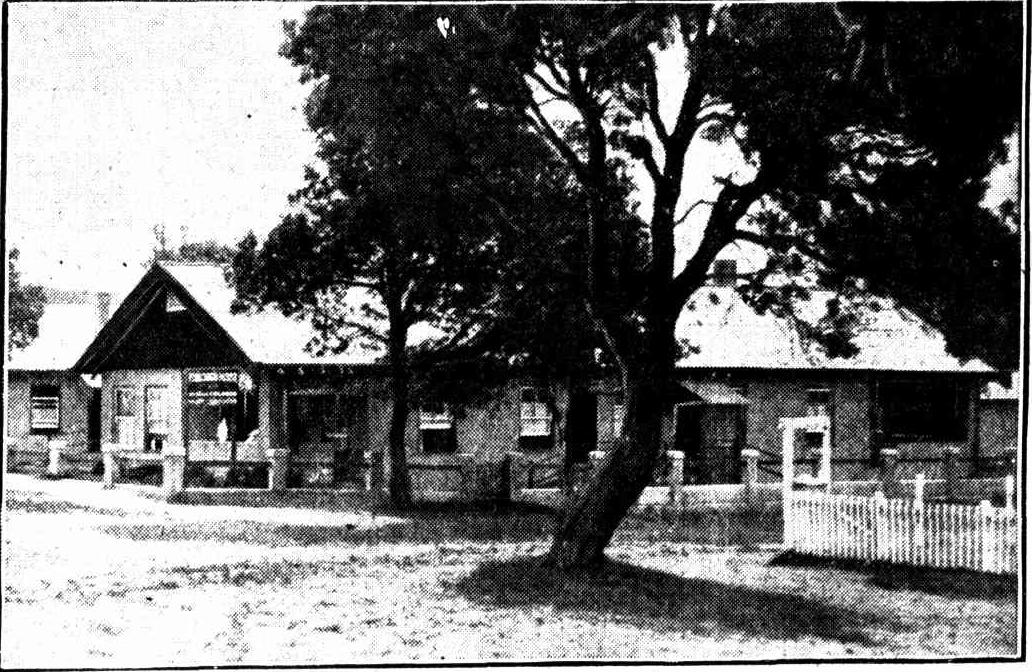

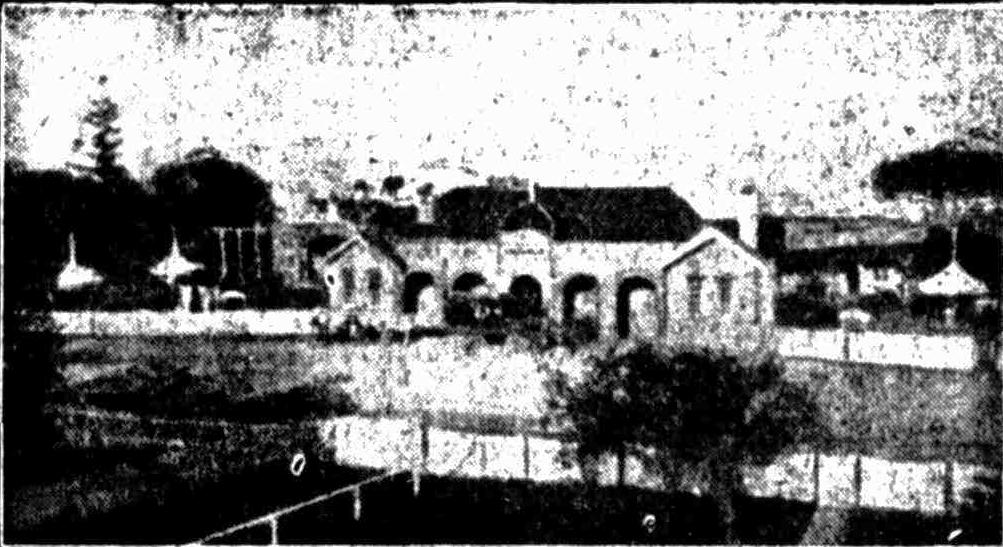
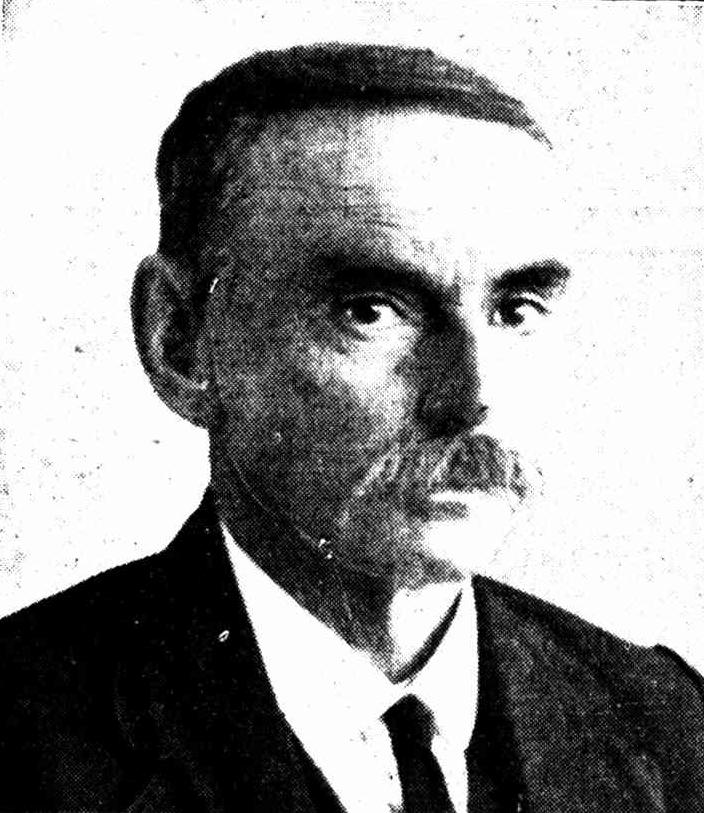
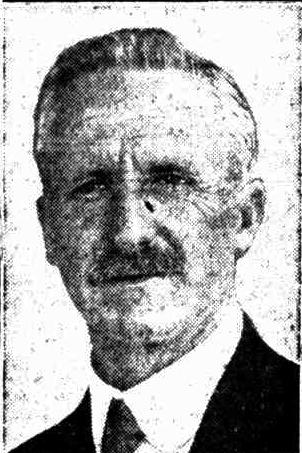
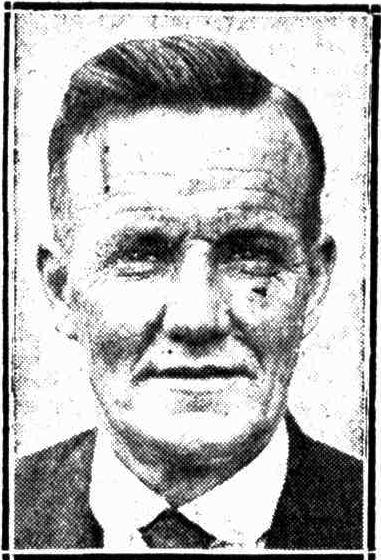
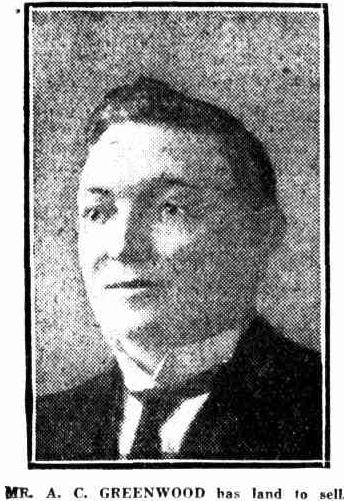
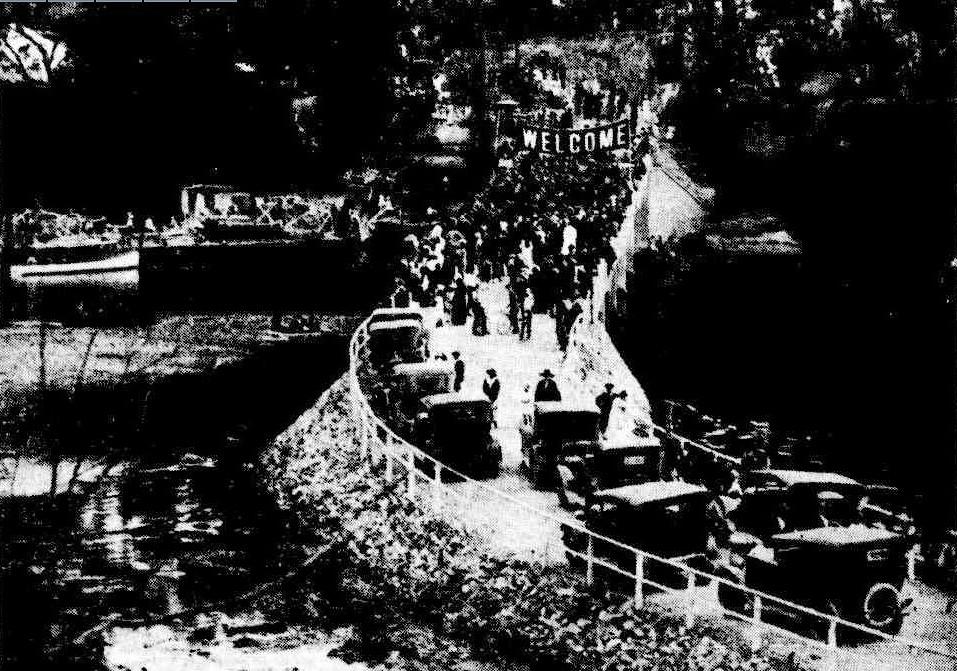
Above: OPENING OF THE BRIDGE ACROSS MIDDLE HARBOUR. THE CEREMONY NEAR ROSEVILLE ON SATURDAY, AFTERNOON. OPENING OF THE BRIDGE ACROSS MIDDLE HARBOUR. (1924, September 22). The Sydney Morning Herald (NSW : 1842 - 1954), p. 12. Retrieved from http://nla.gov.au/nla.news-article16174040
Below: OPENING OF THE MIDDLE HARBOUR BRIDGE. Several thousand people attended the official opening on Saturday afternoon of the –Middle Harbour Bridge between French's Forest and Roseville. After the opening ceremony, which was performed by the Premier, Sir George Fuller, hundreds of motor cars passed in procession over the bridge. Sir George Fuller said the new bridge would prove an important link between the northern suburbs and the important beaches on the northern side of Sydney Harbour, besides substantially assisting settlers in French’s Forest. OPENING OF THE MIDDLE HARBOUR BRIDGE. (1924, September 24). Sydney Mail (NSW : 1912 - 1938), p. 10. Retrieved from http://nla.gov.au/nla.news-article169149144
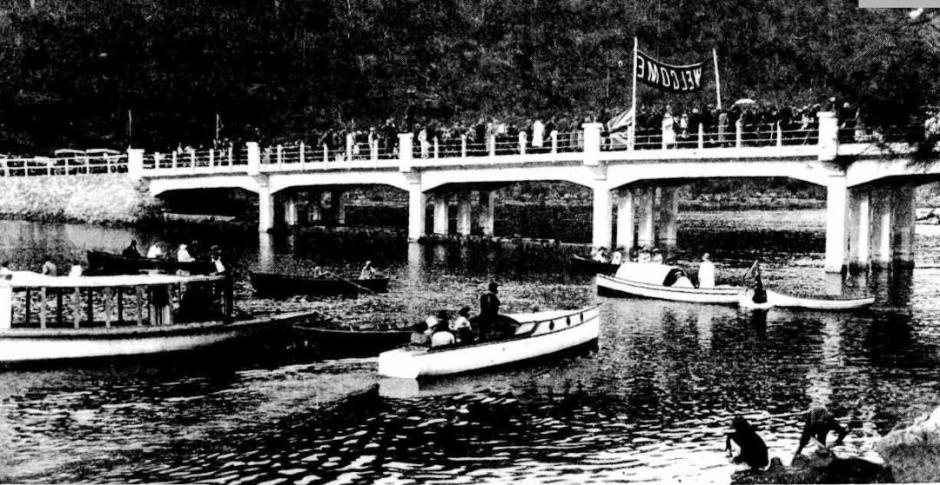
Changing The Landscape: The Macphersons
Narrabeen Lagoon and surrounds, alike elsewhere in waterside frontages of Pittwater, was subject to dredging. The most standout among these was the reclaiming of land to form the present site of Wimbledon Avenue and this was undertaken by a member of the Macpherson family during the 1920's. The Macpherson family is where the name of 'Warriewood' originates from. Although they allowed others to purchase and subdivide some of their many larger holdings along the peninsula, the reclaiming of land to form Wimbledon was undertaken by one of the Macpherson brothers.
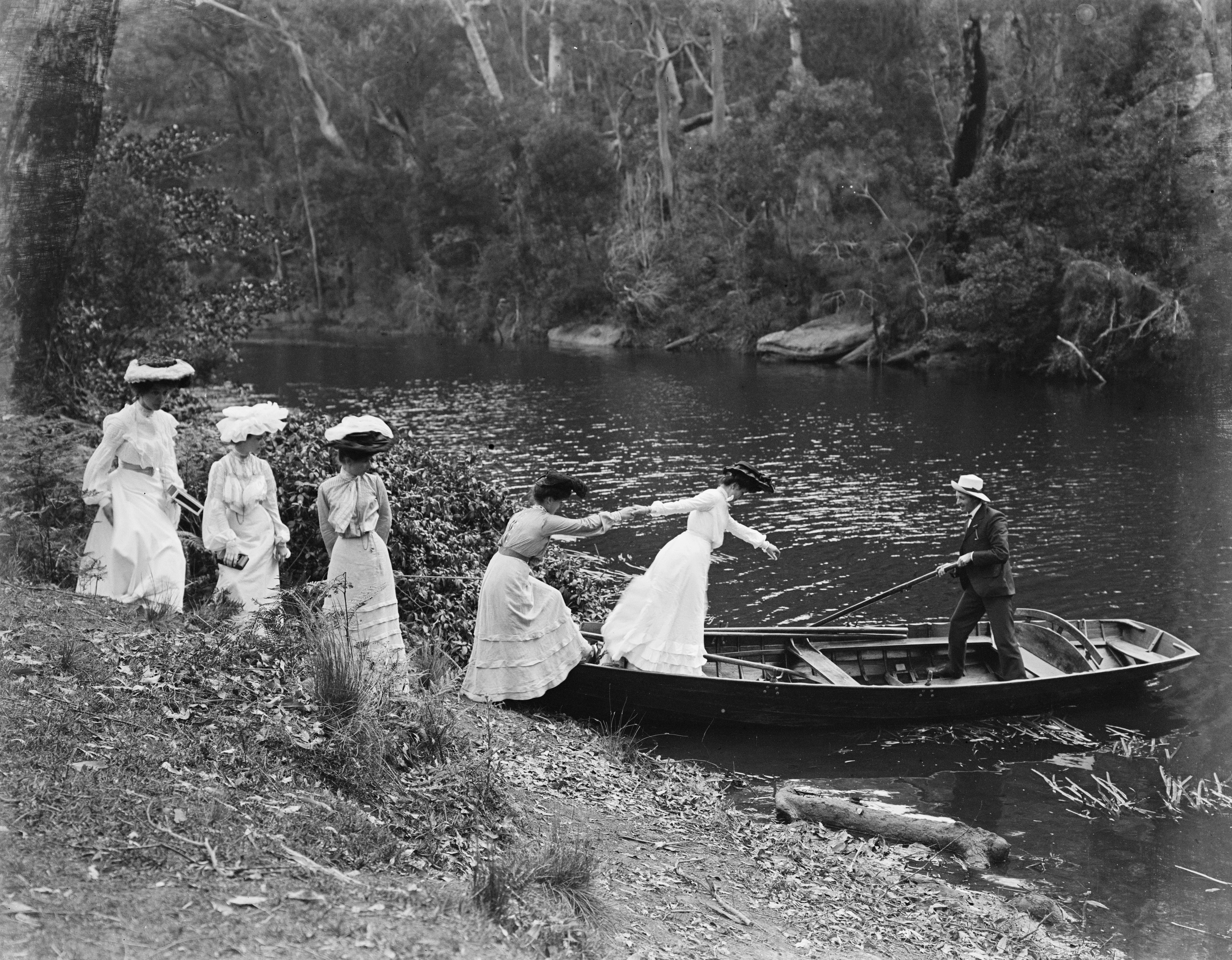
Five women stepping into a punt at Narrabeen Lagoon with [Macpherson] male at stern, c1905, Image No.: c071400026, courtesy State Library of NSW. From MacPherson Family Albums
Plan of Subdivision.
An owner of property submitted a plan of subdivision of an estate at Narrabeen to the Warringah Shire Council for approval. He proposed to allow a road around the waters of the Lake that would provide a beautiful parade, if the council would make some concession in return. Plan of Subdivision. (1911, October 20). The Land (Sydney, NSW : 1911 - 1954), p. 9. Retrieved from http://nla.gov.au/nla.news-article102900950
Further north, on the site of the present Narrabeen High School, the family brought land under the Real Property Act:
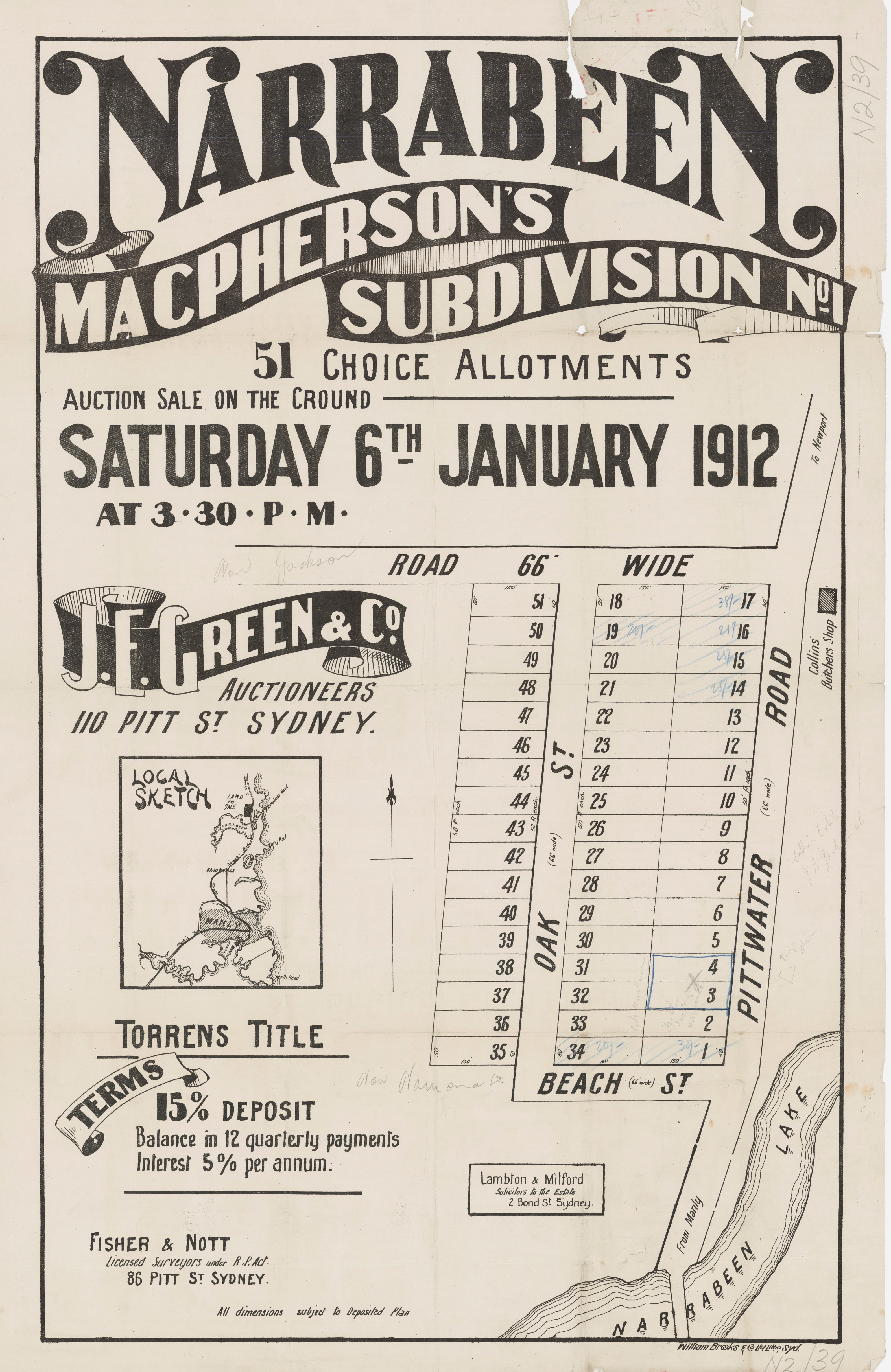
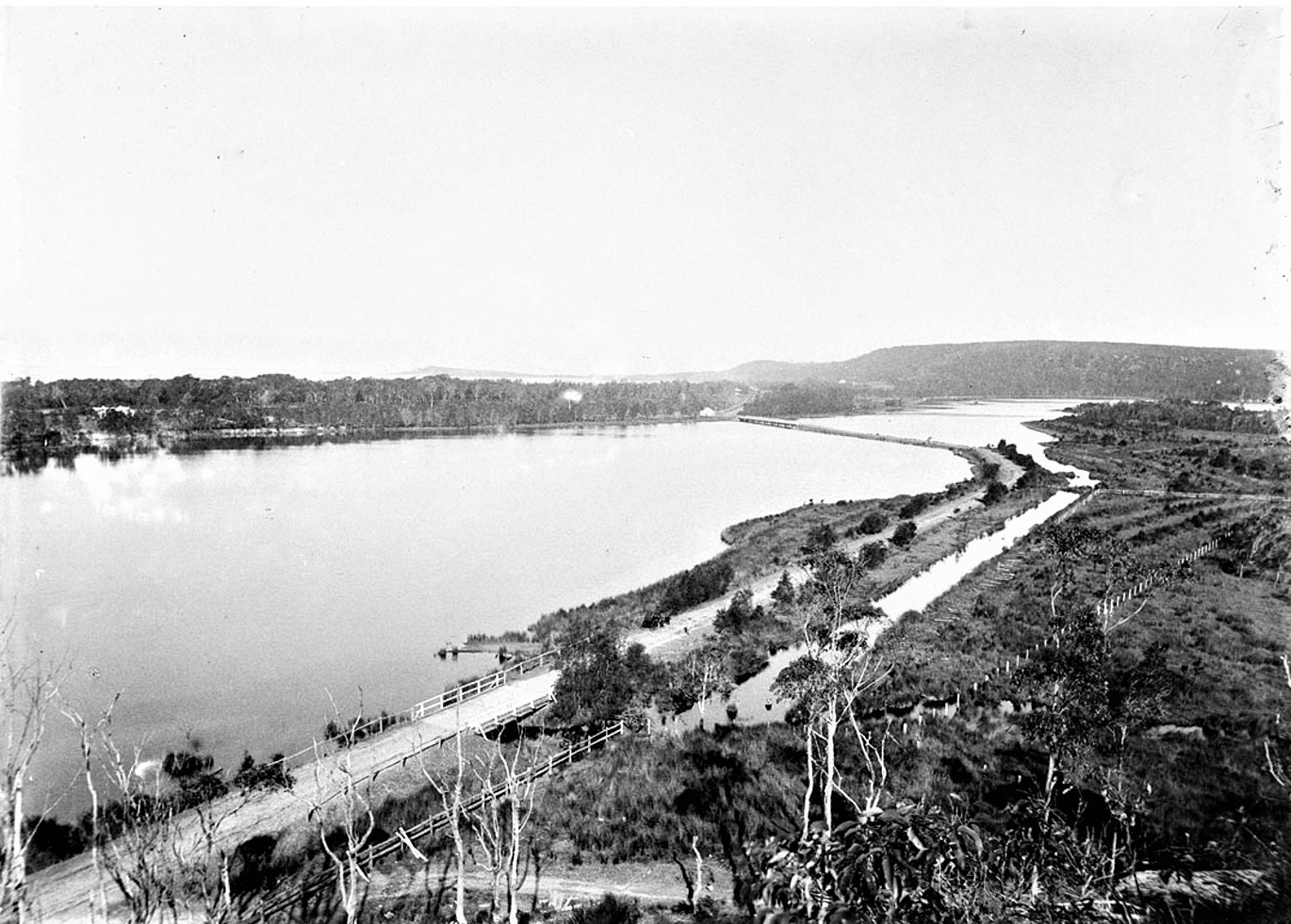
Narrabeen lagoon, circa 1915, Item hall_34703h, courtesy State Library of NSW
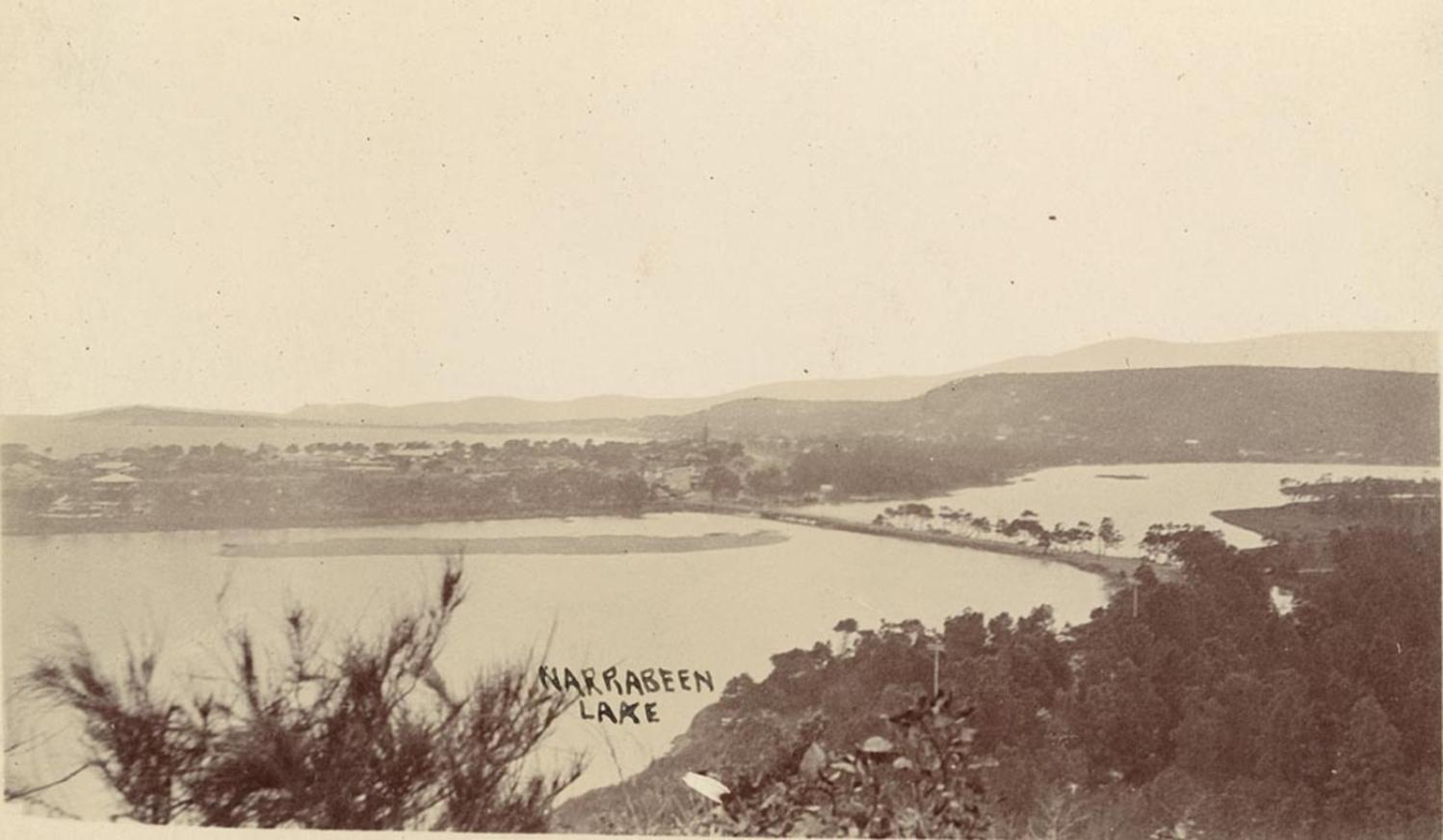
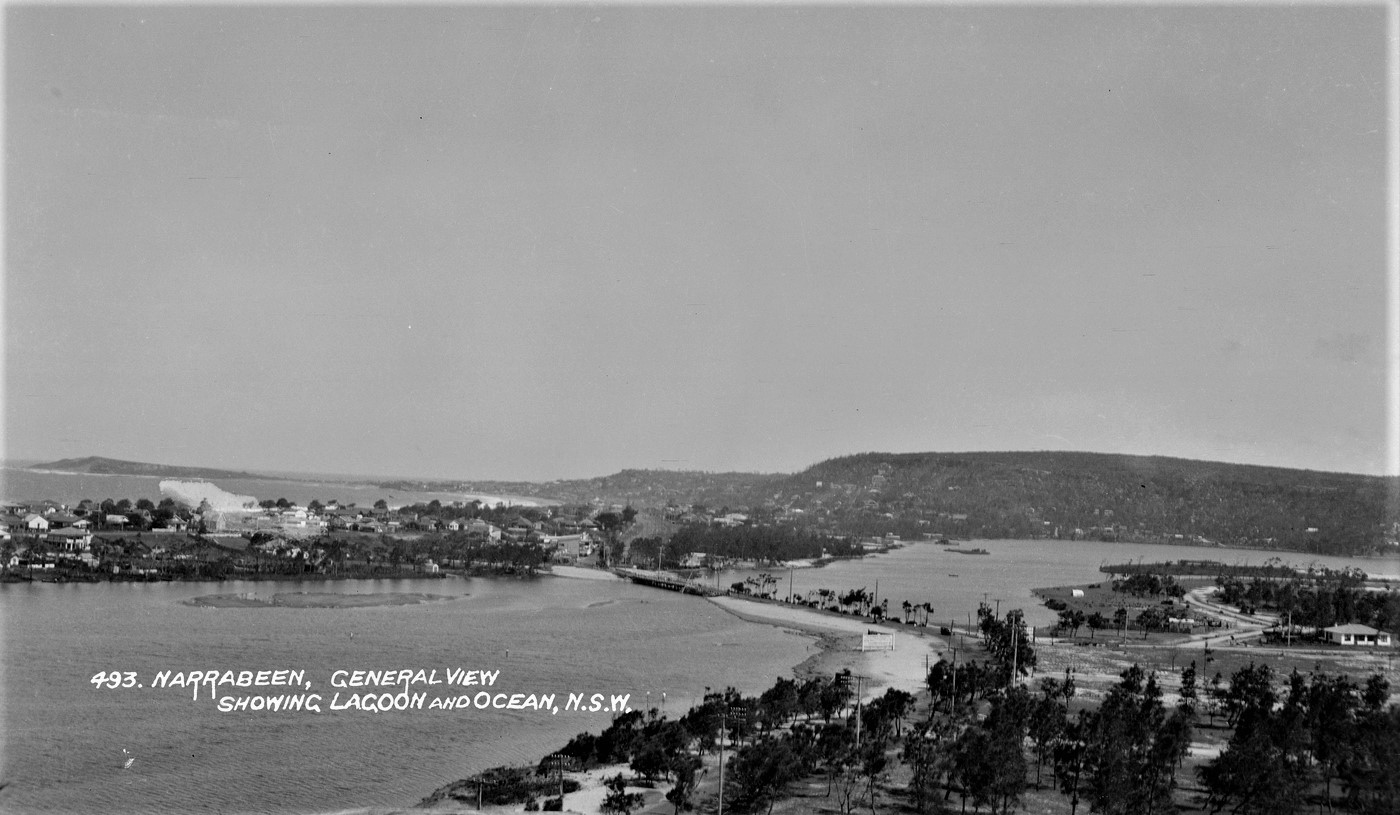
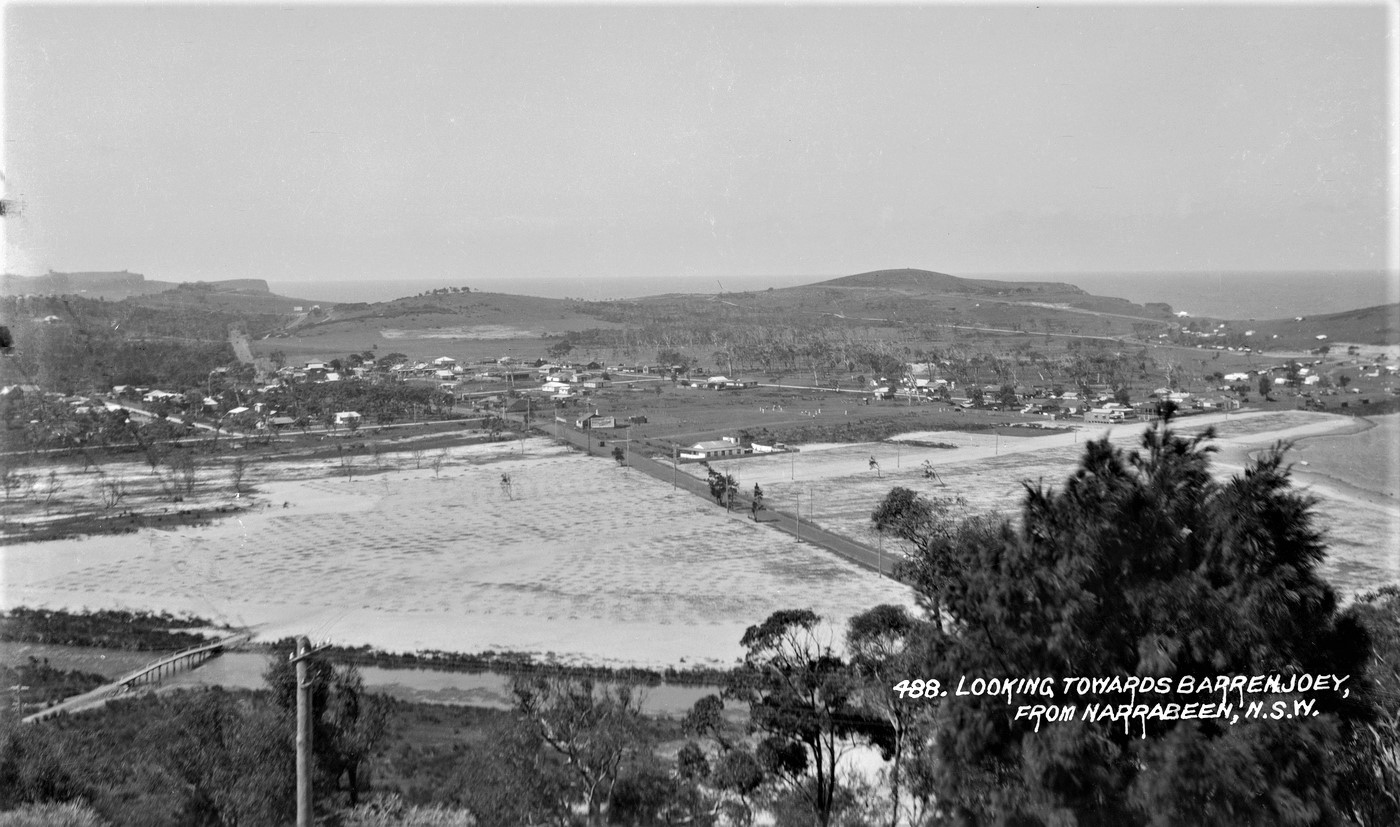
Narrabeen Lagoon, General View showing Lagoon and Ocean and Looking Towards Barrenjoey, From Narrabeen circa 1927, from Album 'Samuel Wood - postcard photonegatives of Narrabeen,' - Items a1470096h, a1470091h, courtesy State Library of NSW
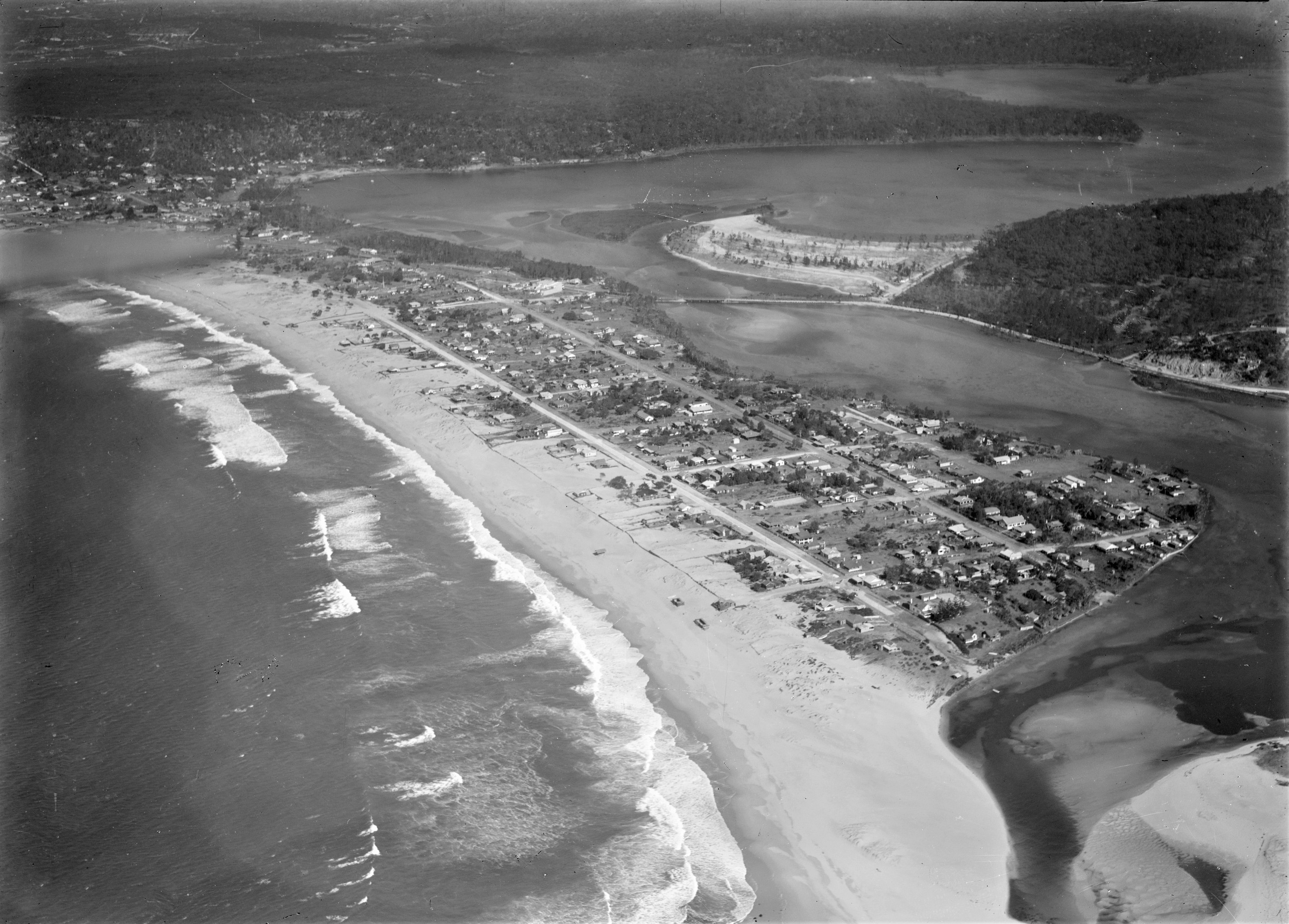
Narrabeen Lagoon aerial, from album Milton Kent aerial views of Bondi, Cronulla, Granville, Haberfield, Middle Harbour, Narrabeen, Mascot, Sydney, Sydney Harbour, Tempe, between 1926-1938, Item: c111660015, courtesy Mitchell Library, State Library of New South Wales - and sections from to show details; NB - no Bridge from Ocean street across Lagoon present, and old Nth. NSLSC still on beach - so pre-1927 and showing the larger section now reclaimed where Wimbledon Avenue will be formed.
.jpg?timestamp=1593071813851)
Striking Aerial Views : Newcastle and Narrabeen
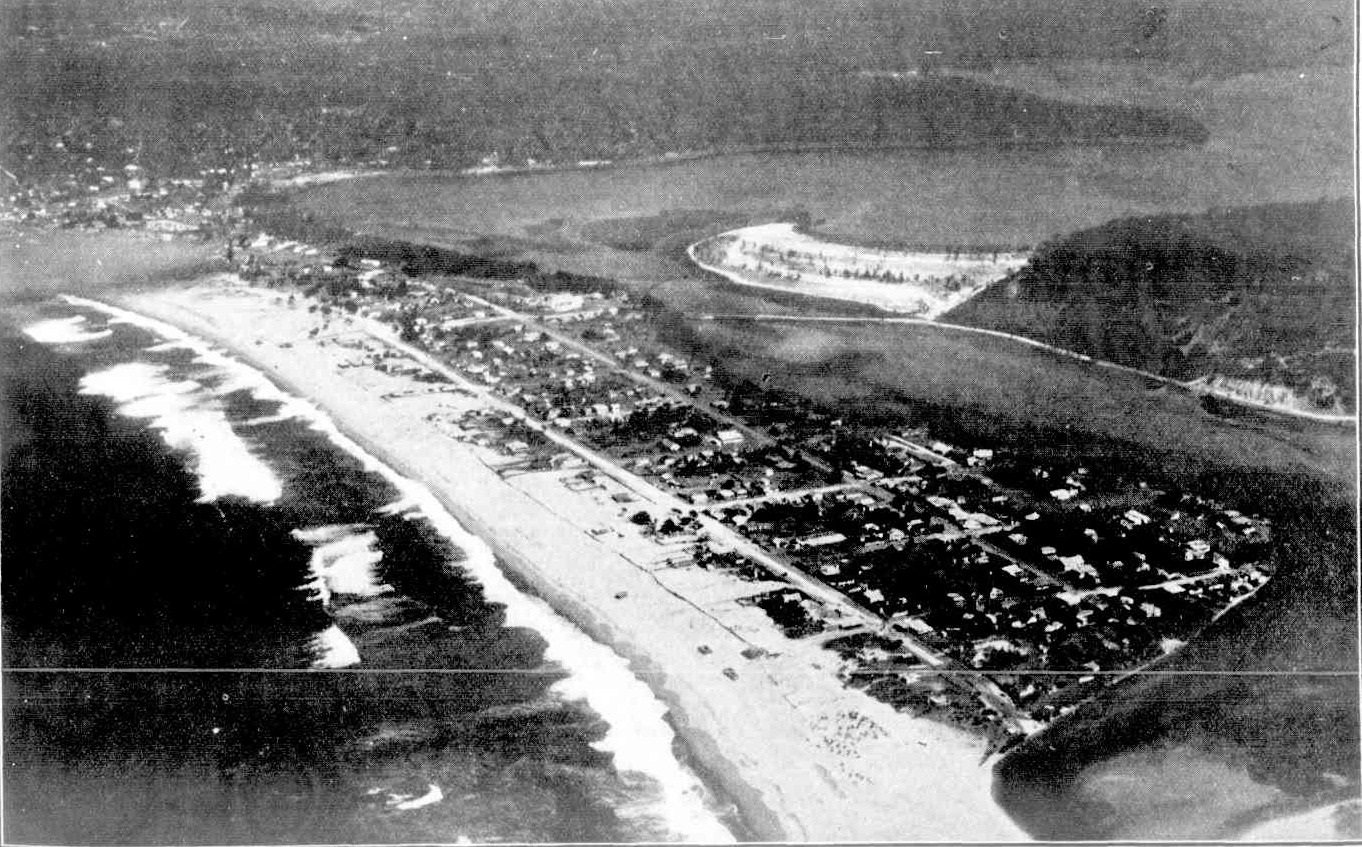
NARRABEEN, BETWEEN OCEAN AND LAKE. This fine strip of ocean beach runs from North Narrabeen through South Narrabeen to Collaroy (on the left). Narrabeen proper is situated on the peninsula in the centre of the picture. The main road from Manly to Newport, Avalon, and Palm Beach runs through the upper portion of Narrabeen, crossing the lake by the bridge, beyond which is seen a portion of low -lying land now being reclaimed. Striking Aerial Views : Newcastle and Narrabeen (1928, August 22). Sydney Mail (NSW : 1912 - 1938), p. 17. Retrieved from http://nla.gov.au/nla.news-article158401835
.jpg?timestamp=1615403587952)
A SECTION OF THE NEW ROAD FROM NARRABEEN TO NEWPORT.
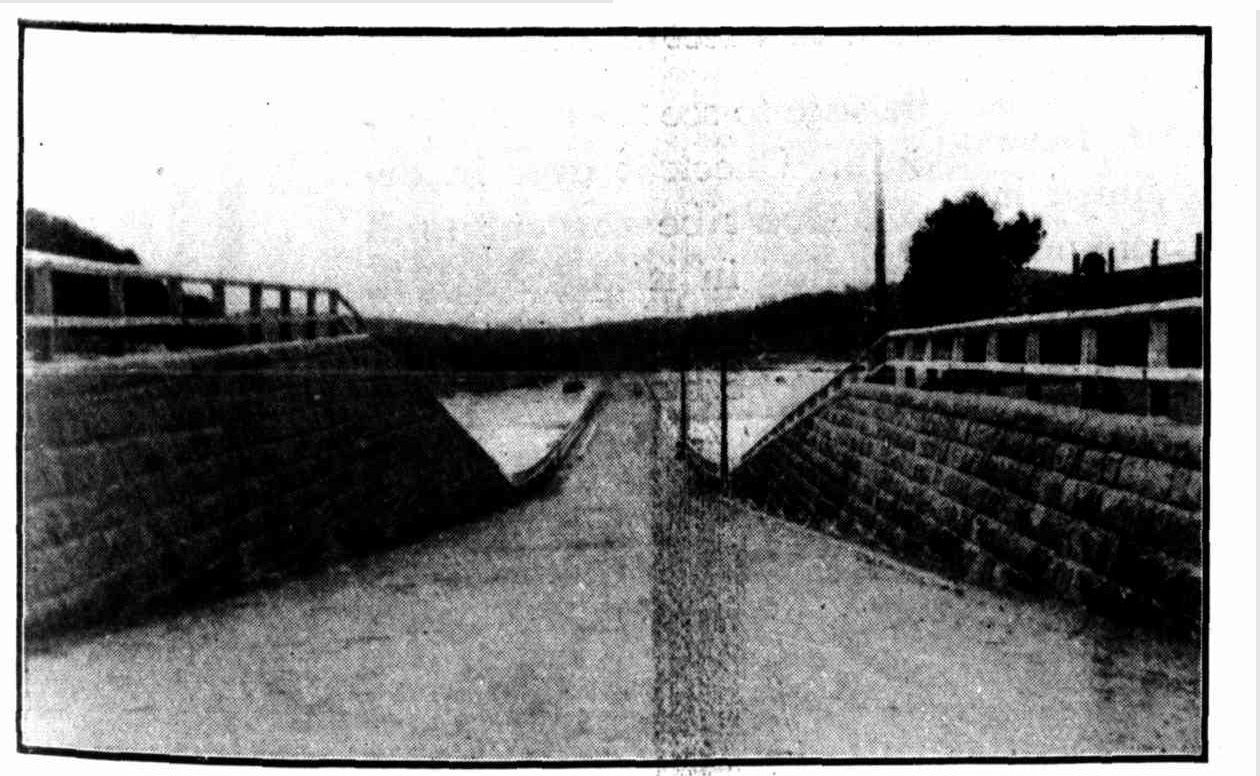
ANOTHER SECTION OF THE NARRABEEN-NEWPORT ROAD.
The trip from Sydney through Manly and Narrabeen to Newport and on to Palm Bead) is a very popular one. The scenery Is indescribably beautiful. A Good Road Performance (1928, November 14). Sydney Mail (NSW : 1912 - 1938), p. 47. Retrieved from http://nla.gov.au/nla.news-article158404160
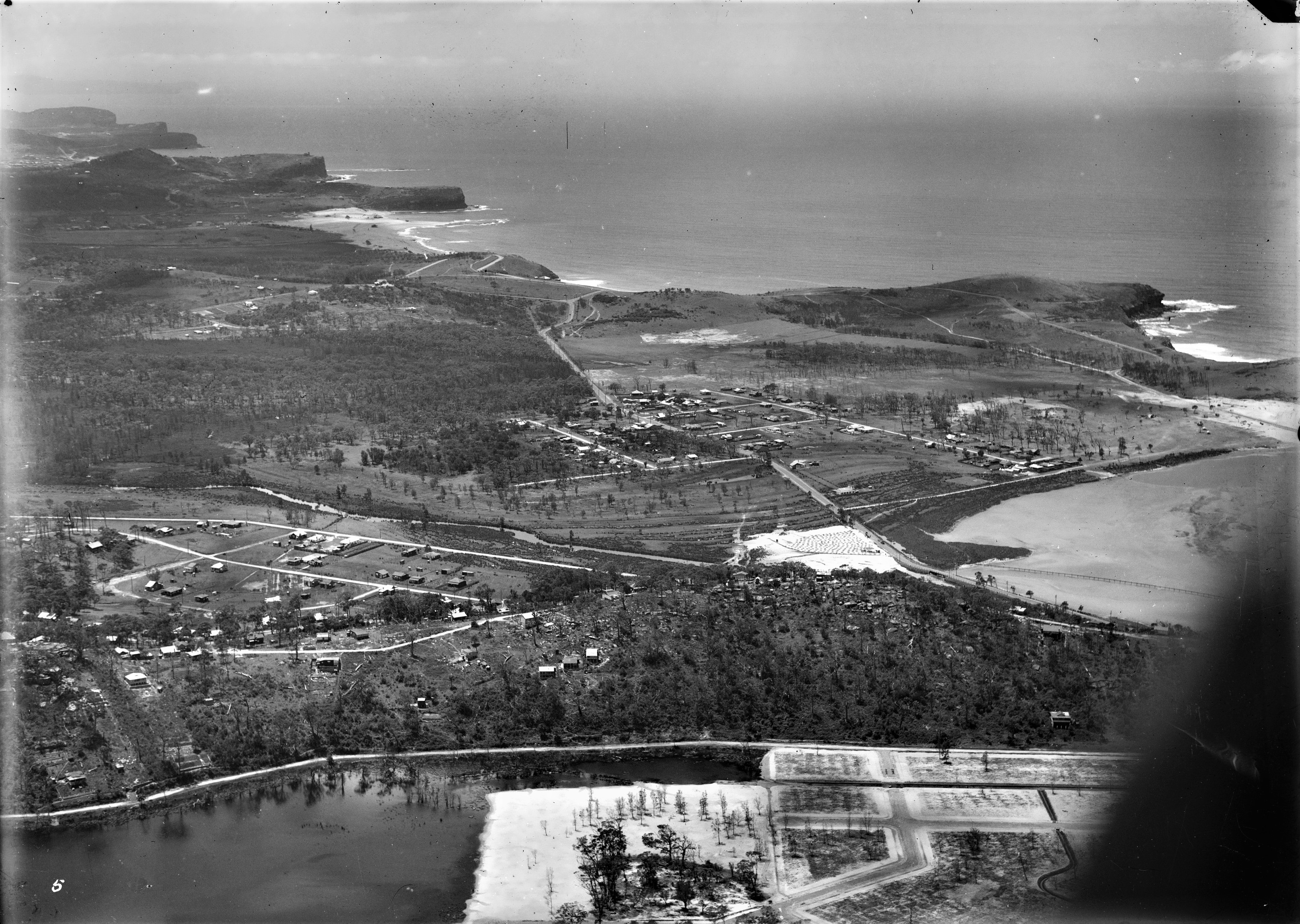
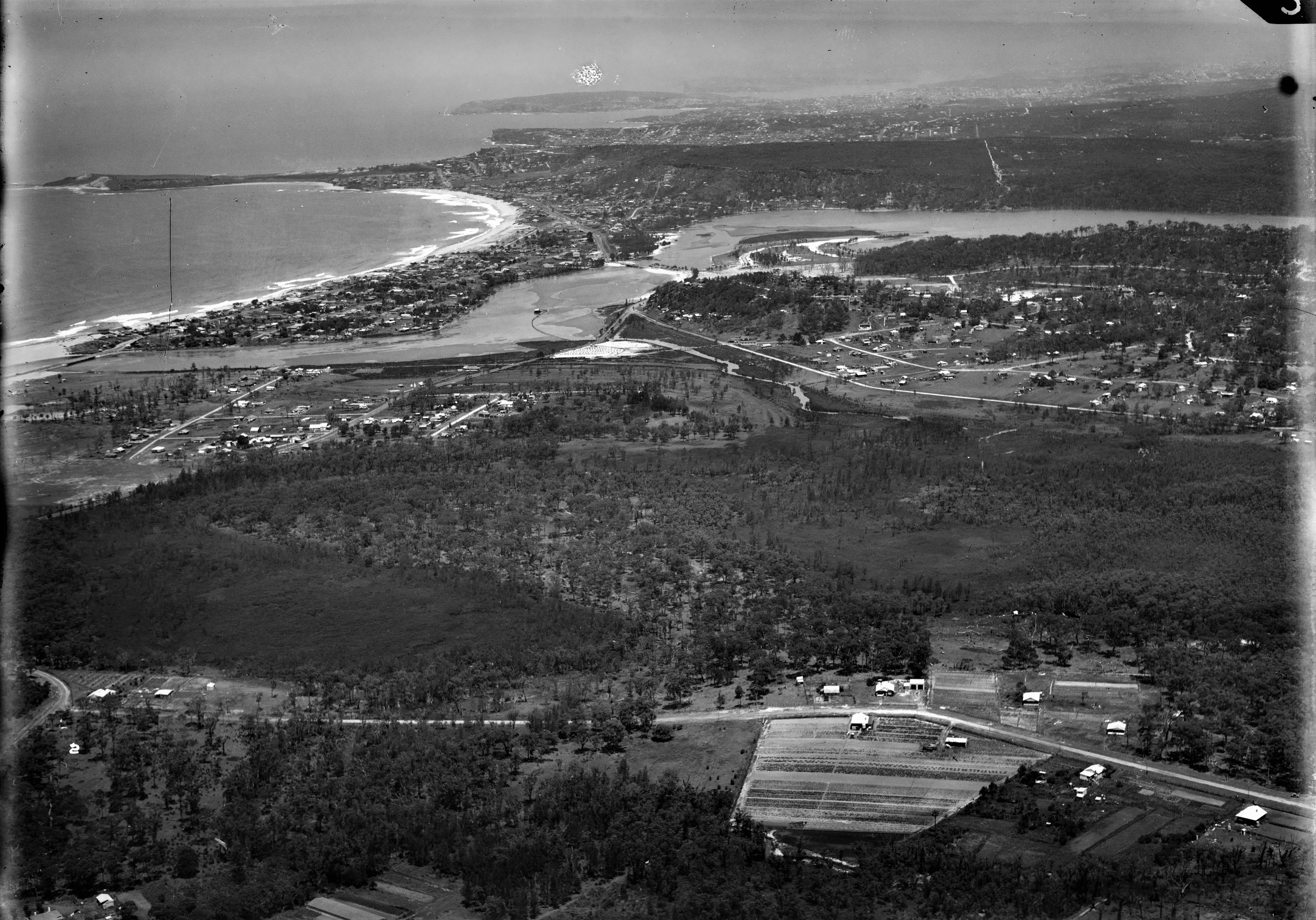
Narrabeen and Wimbledon Reserve, Wimbledon Island and streets being reclaimed at Narrabeen. Items: c112550013 to c112550014 from album: Item 08: Milton Kent aerial views of Broadway, Palm Beach, Potts Point, Surry Hills, Sydney, ca. 1937 to 1940, courtesy Mitchell Library, State Library of New South Wales
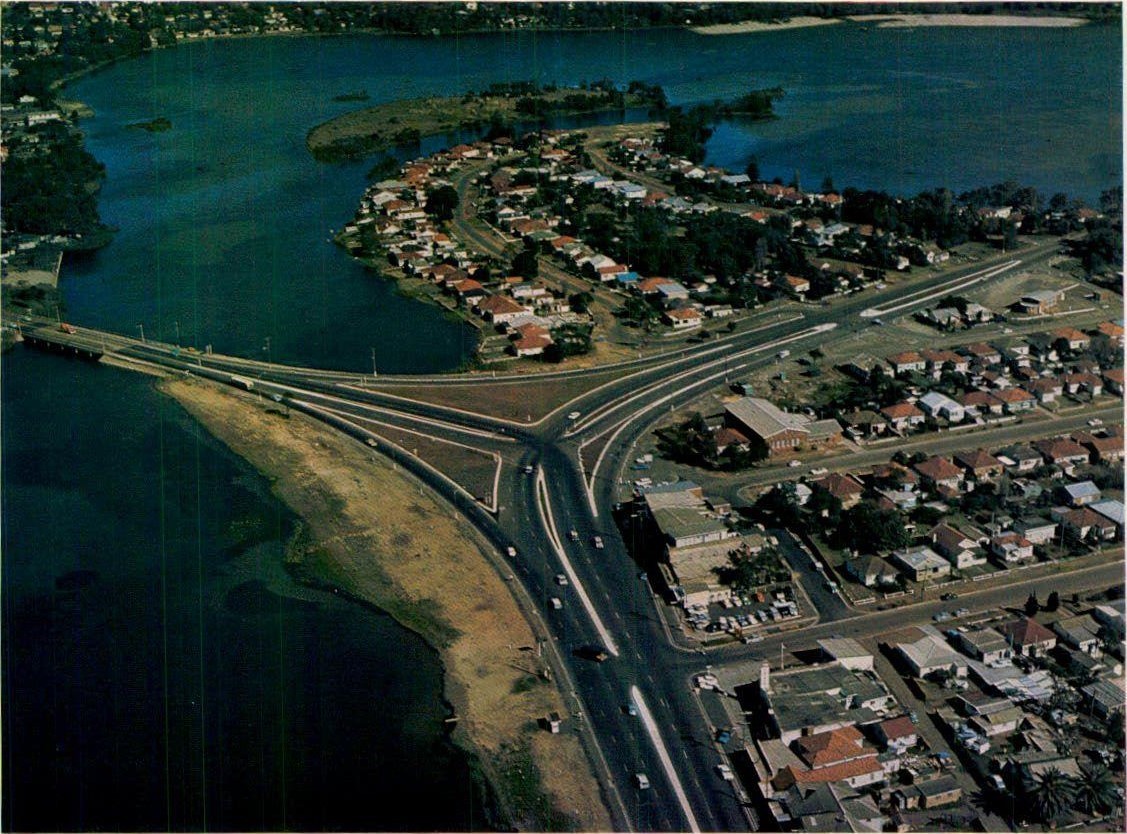
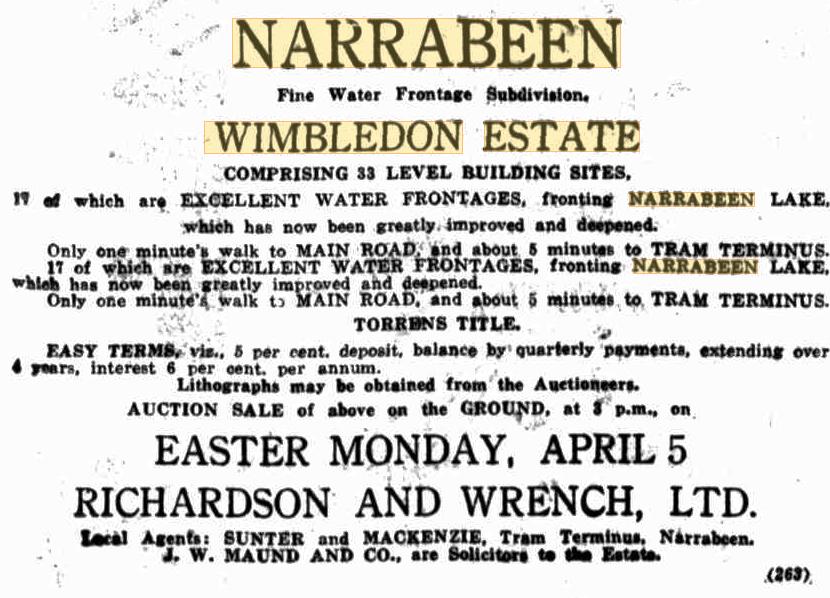
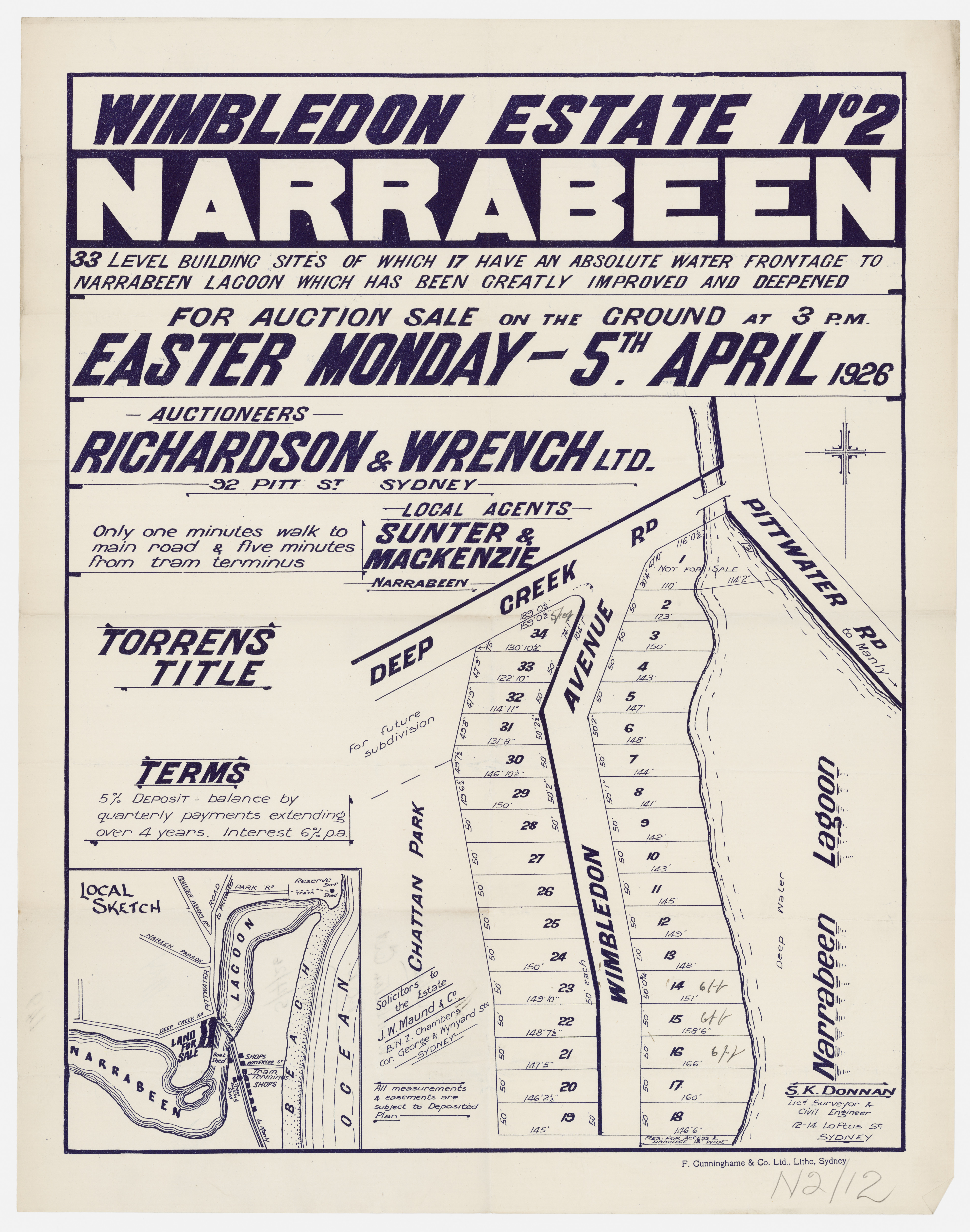
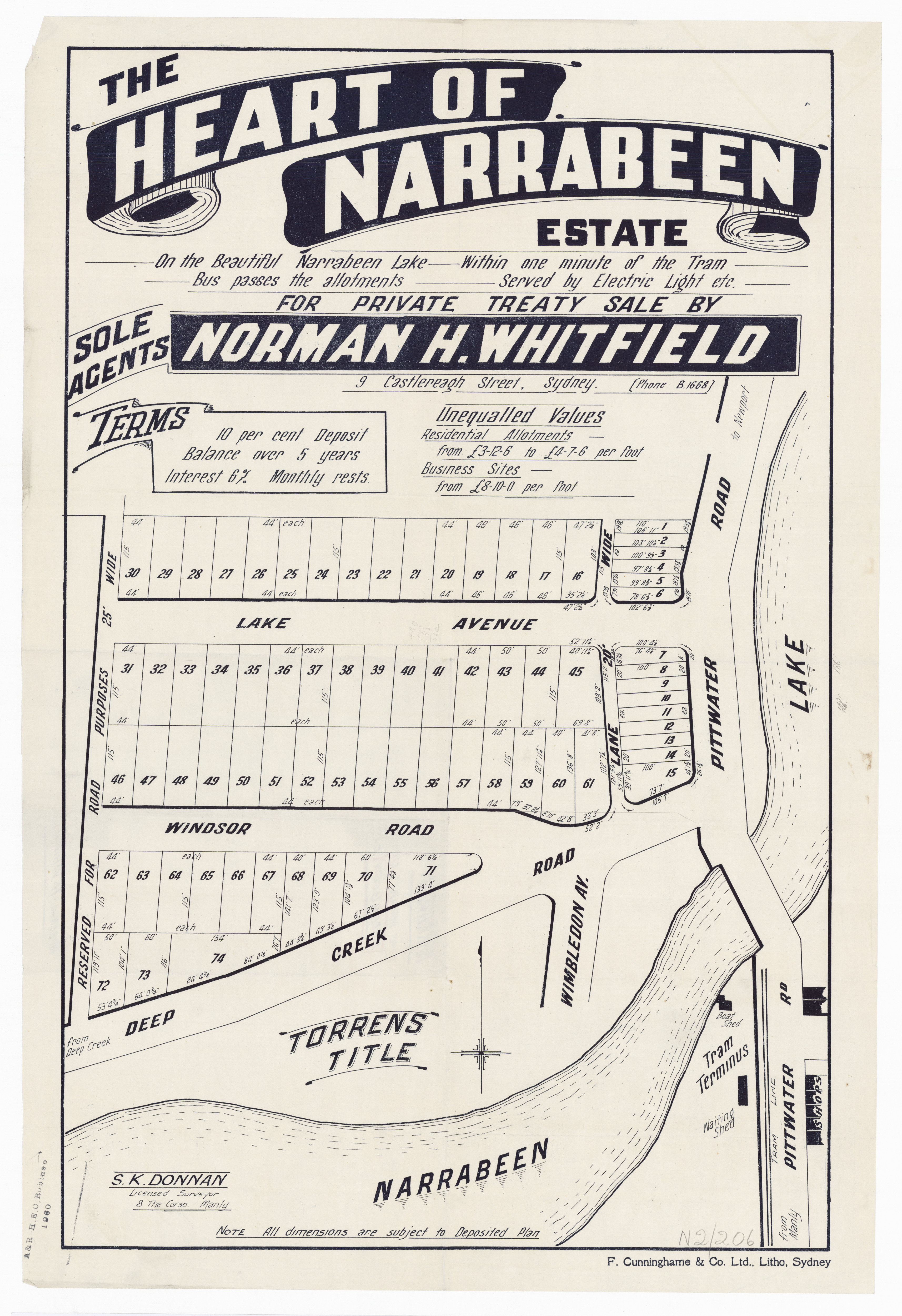
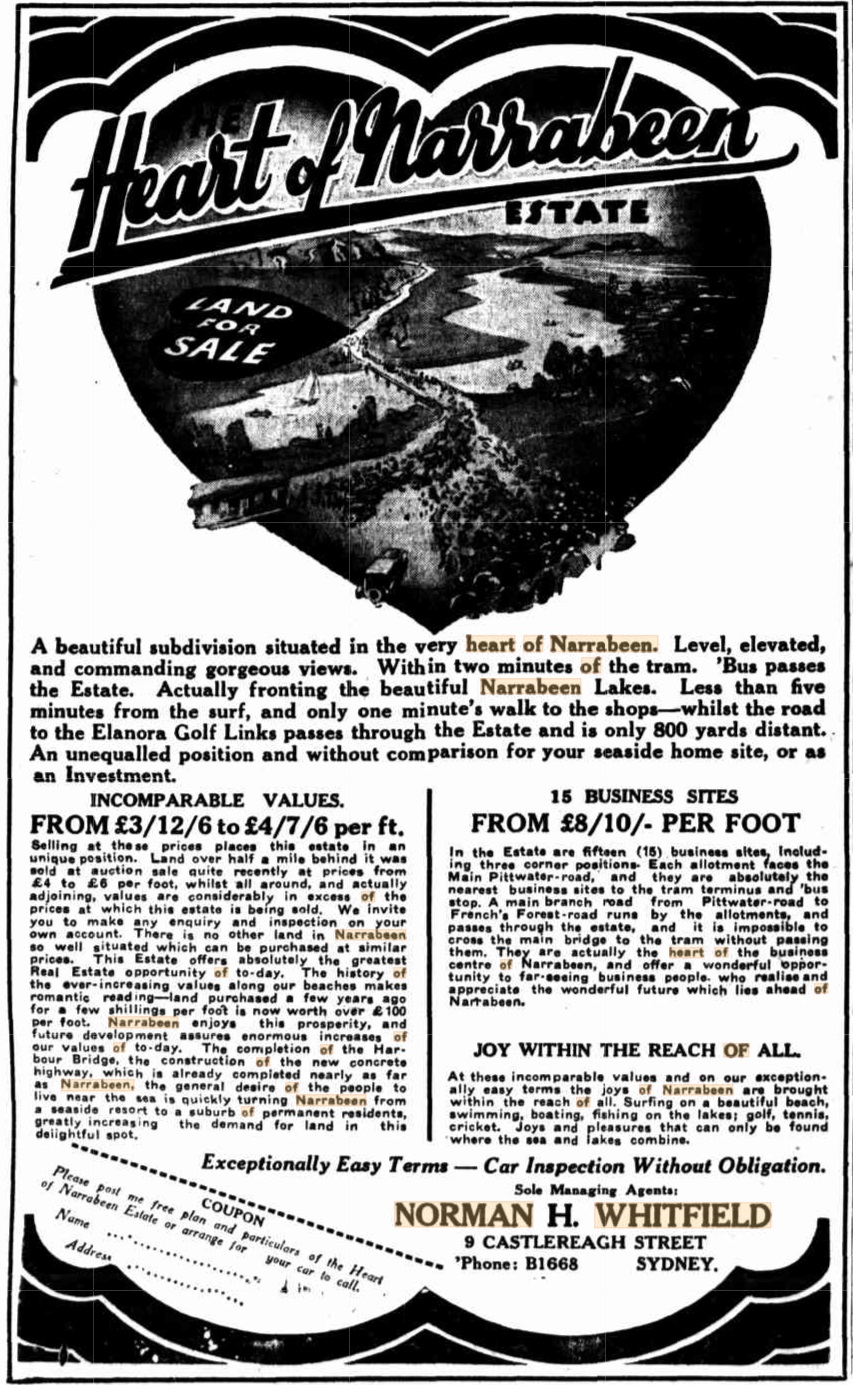
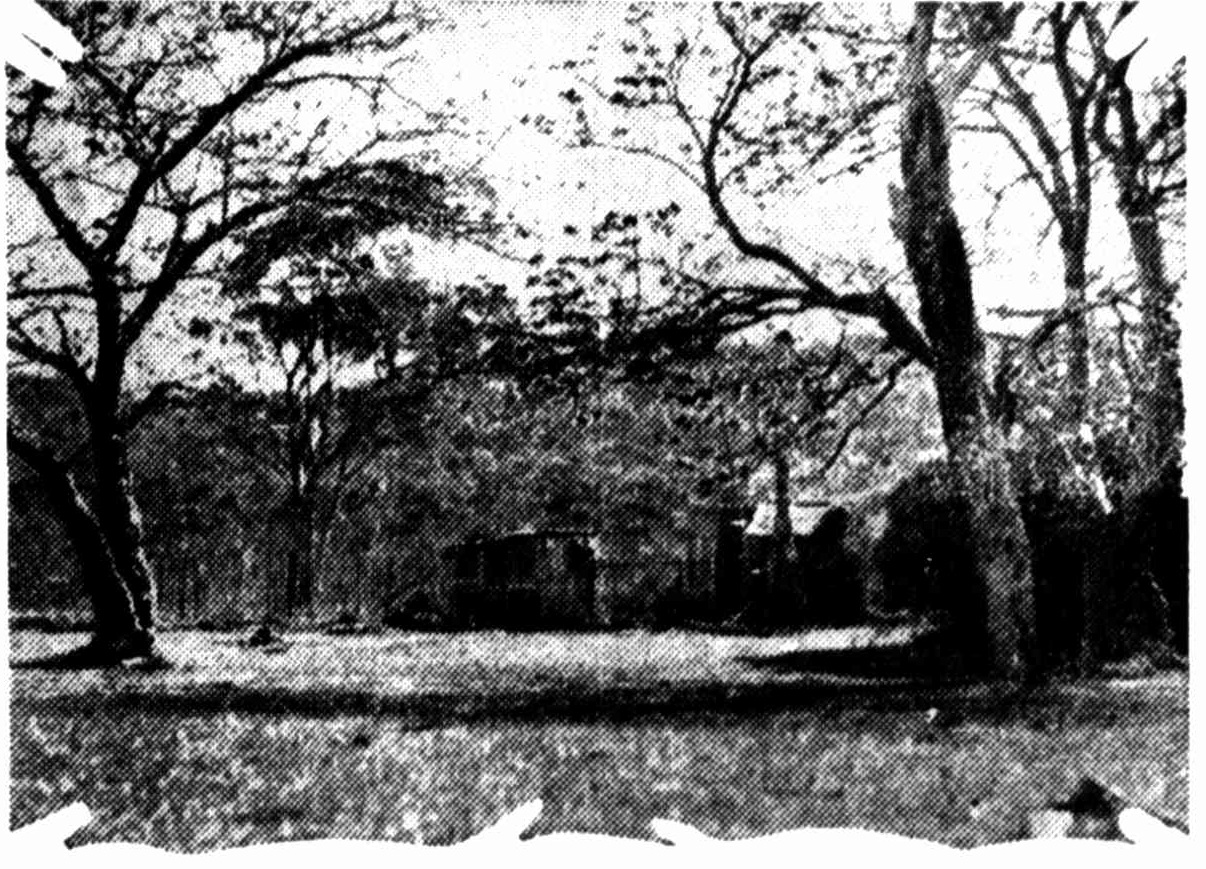
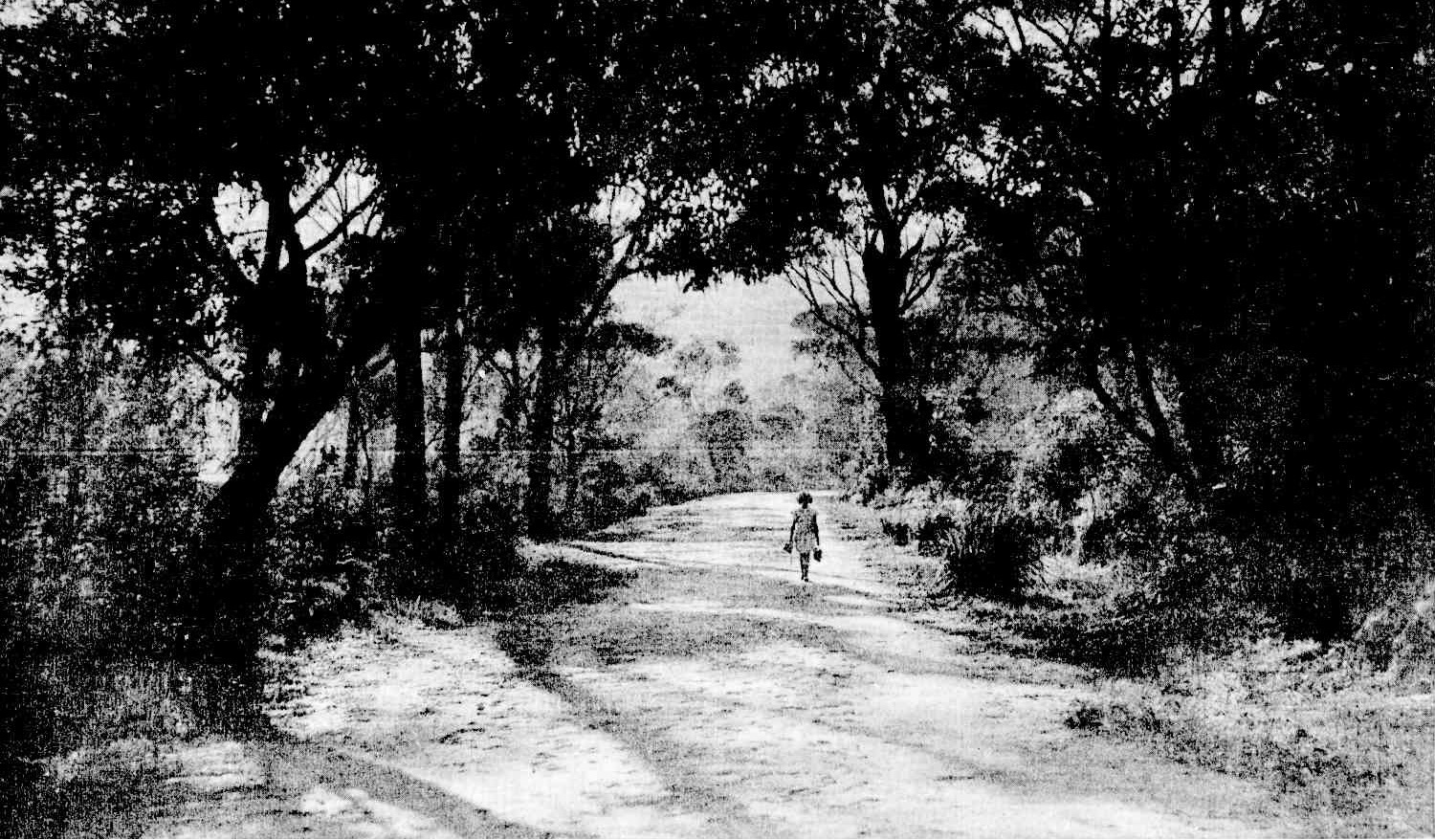
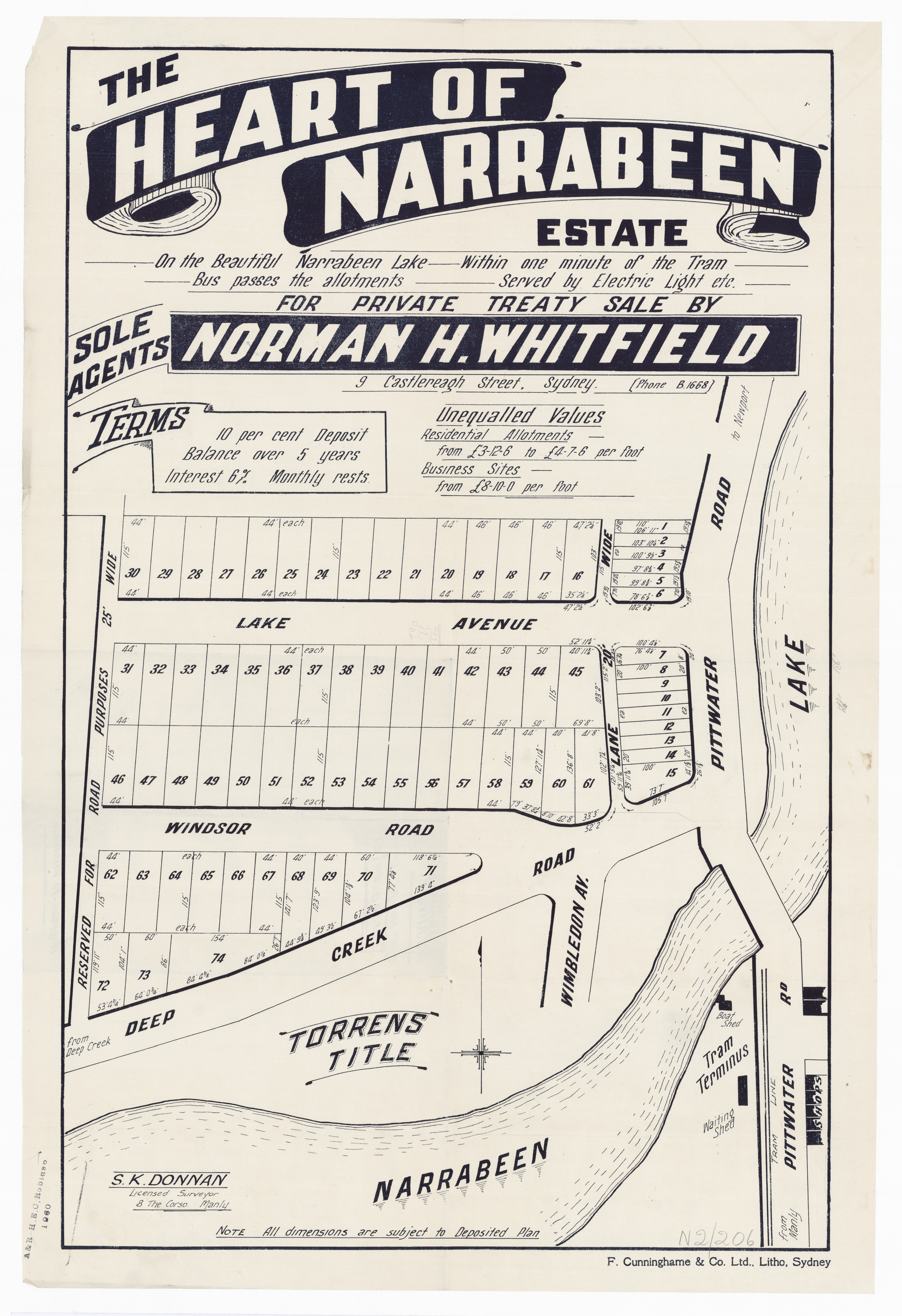
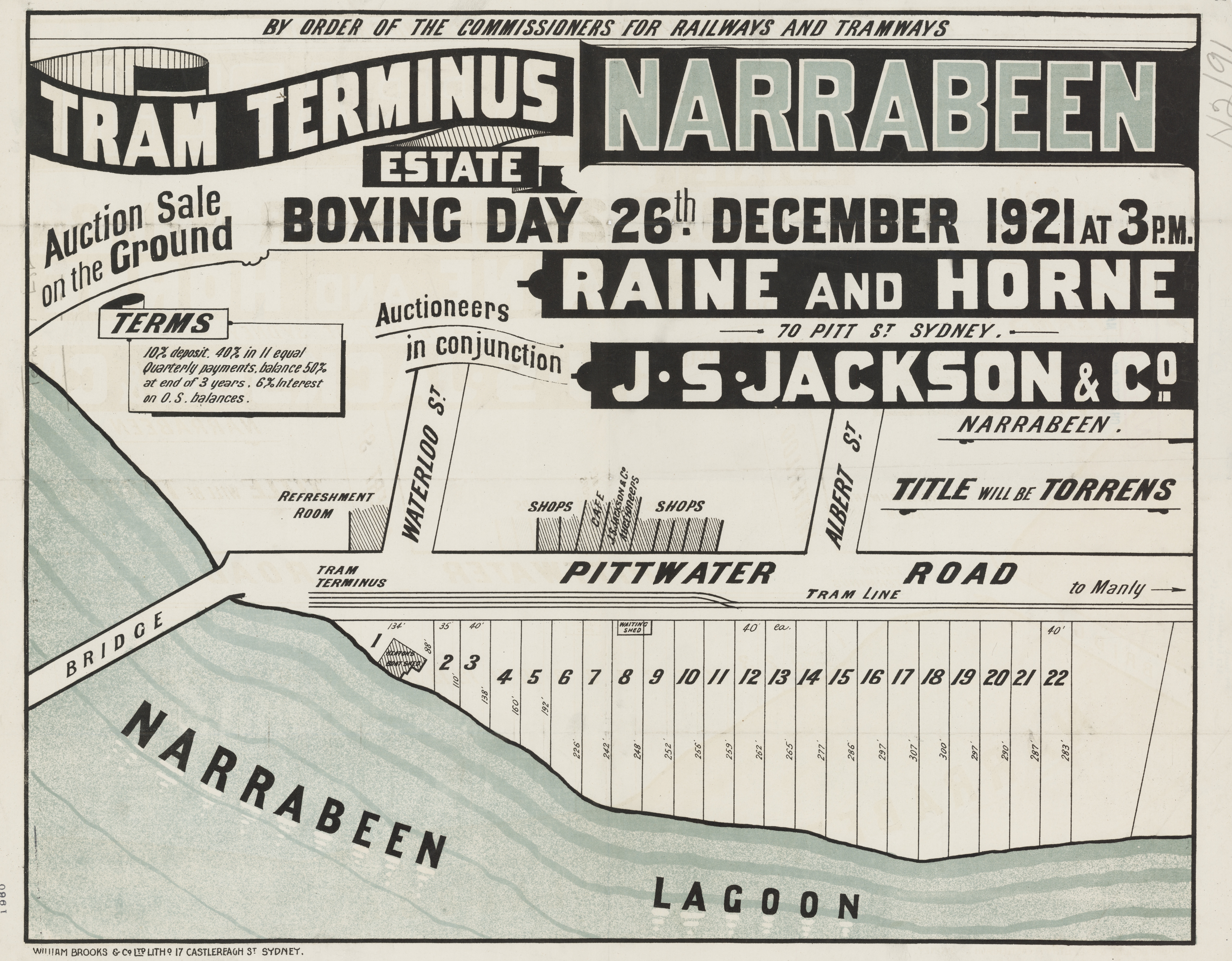
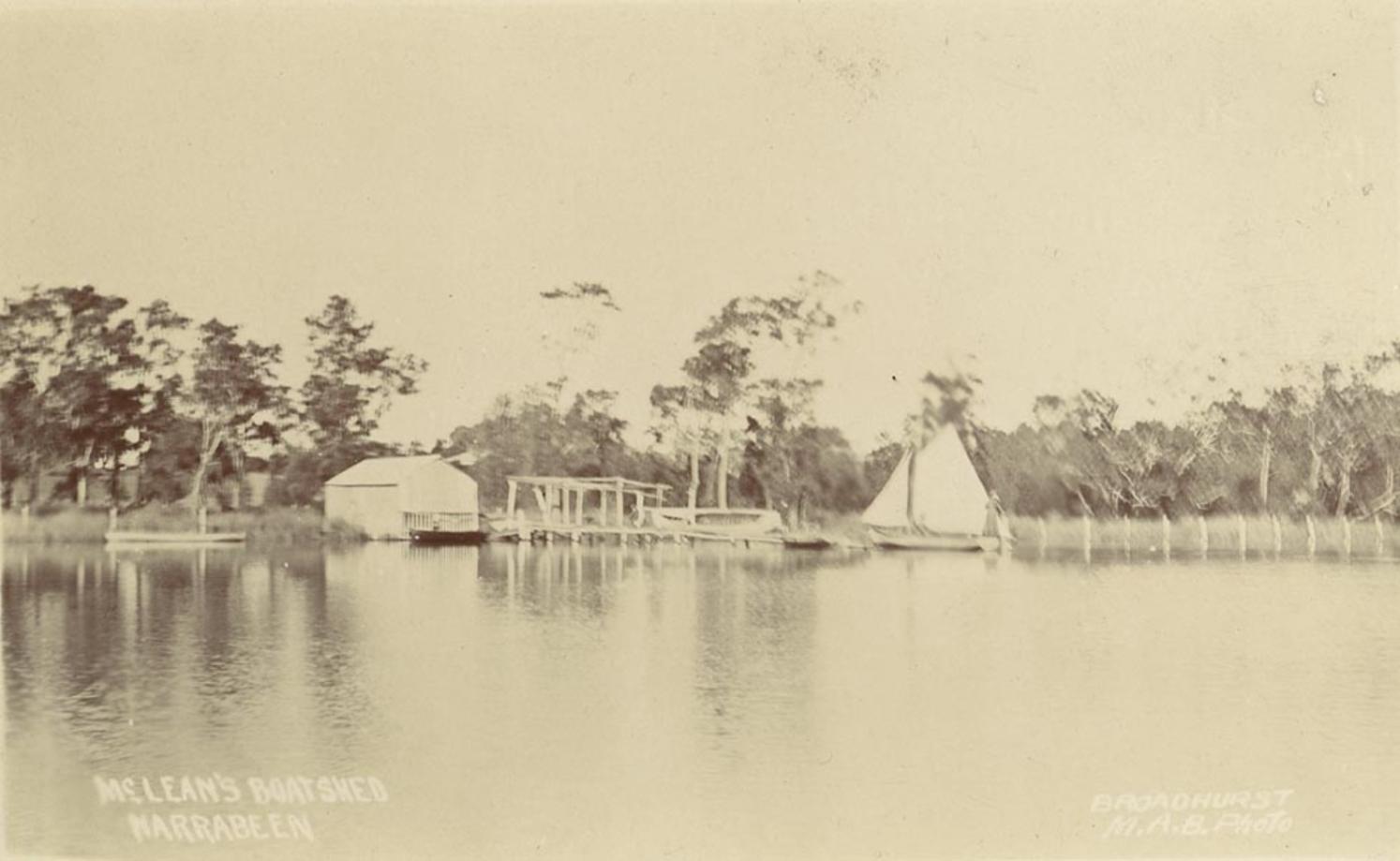
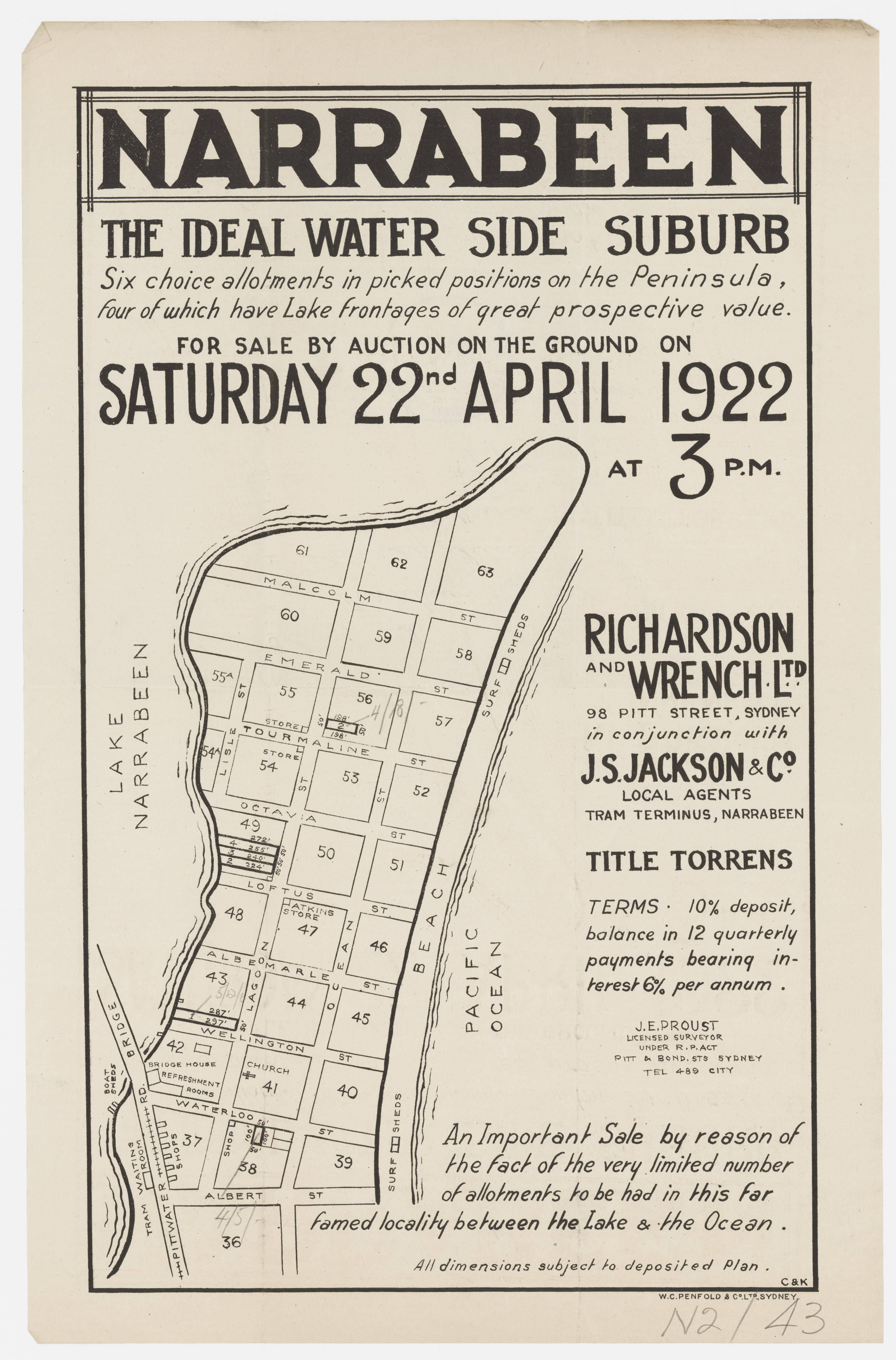
BY ORDER OF THE EXECUTOR ESTATE LATE JAMES WHEELER, NARRABEEN.
1.-WATER-FRONTAGE and BUSINESS POSITION, near the TRAM TERMINUS, AT THE BRIDGE. THE BRIDGE HOUSE, built of weatherboards, wood lined inside, on stone piers, iron roof, verandah In front, and containing 6 rooms and kitchen, detached sheds of wood and iron, standing on Lots 2 and 3, sec. 42, Mount Ramsay Estate, having 61ft 7in to PITTWATER ROAD, and 60ft 7 1/2in to the lake, with depths of 300ft and 331ft back to LAGOON-STREET, to which the frontage is 100ft,
2.-HARBORD. MANLY, VACANT ALLOTMENT, in DALLEY-STREET, situate on the north side, close to Harbord-road, JUST OFF PITTW'ATER-ROAD. Frontage 25ft 9Hn by depths of 188ft 10 1/2in. and 190ft 8in, being part of Lot 7, D.P., 1448. TORRENS,
RICHARDSON and WRENCH, LTD., will sell the above by PUBLIC AUCTION, at the Rooms, 92 PITT-STREET, on FRIDAY, 15th SEPTEMBER, at 11 a.m. Advertising (1922, September 6). The Sydney Morning Herald (NSW : 1842 - 1954), p. 17. Retrieved from http://nla.gov.au/nla.news-article16023116
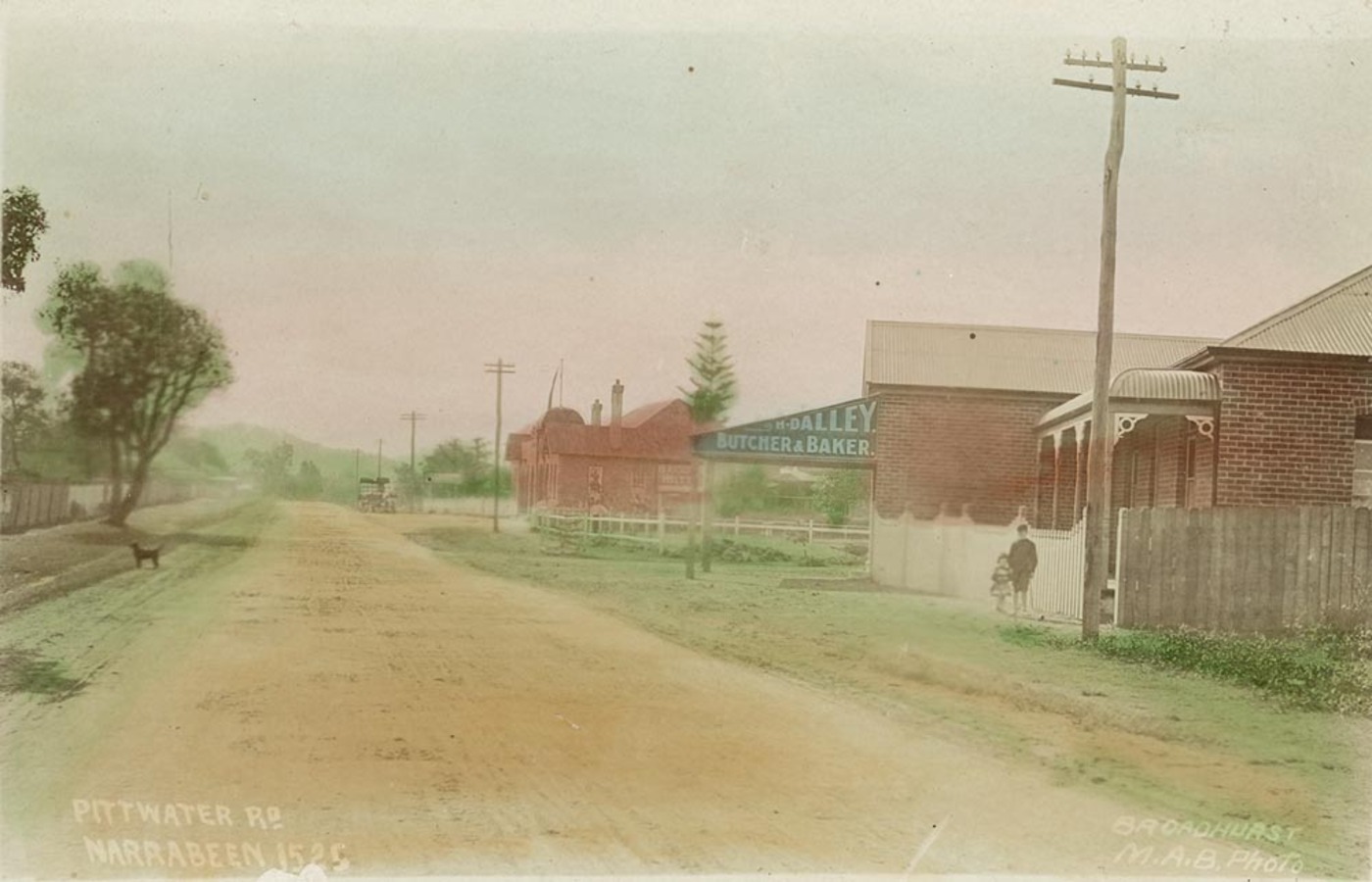
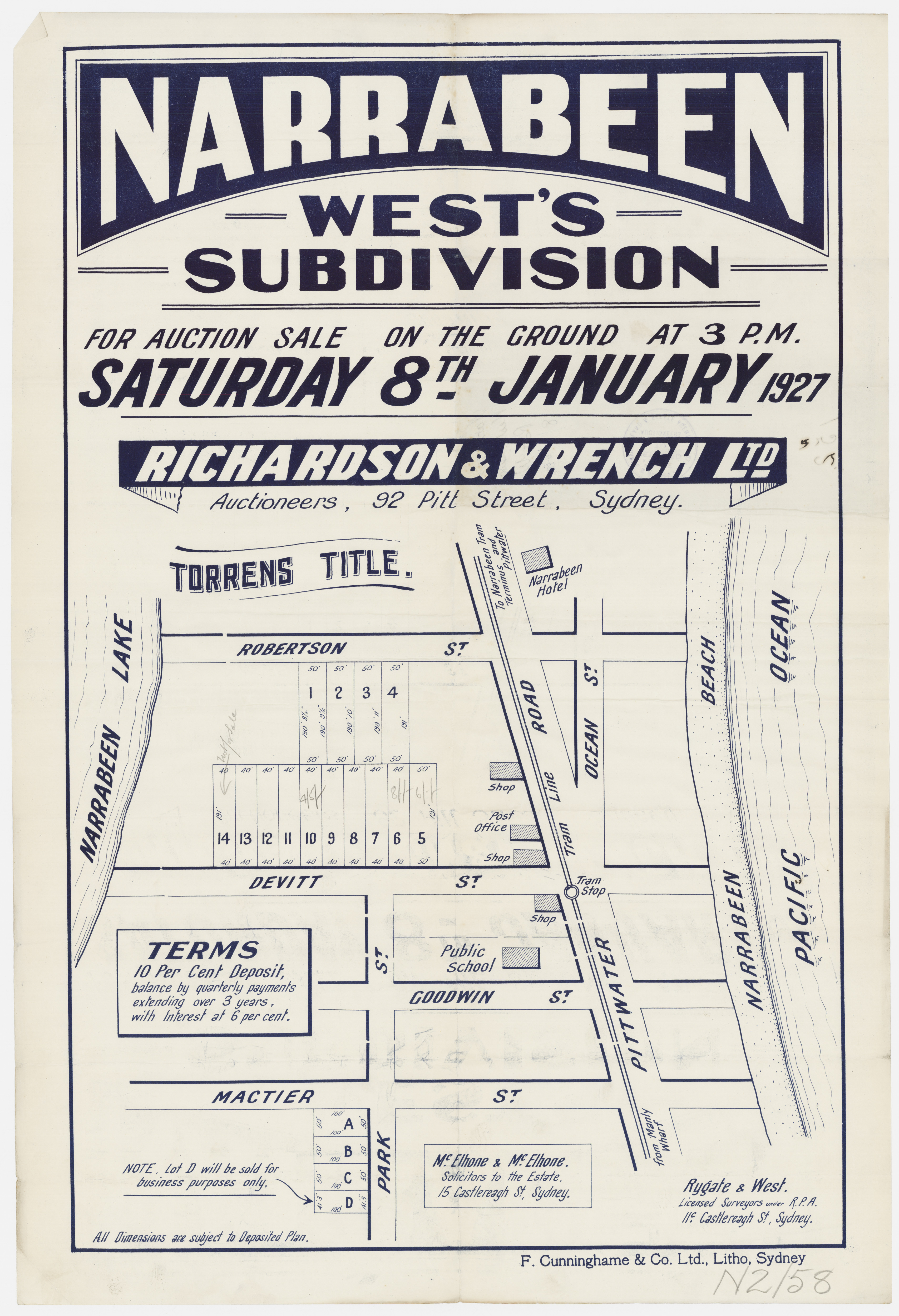
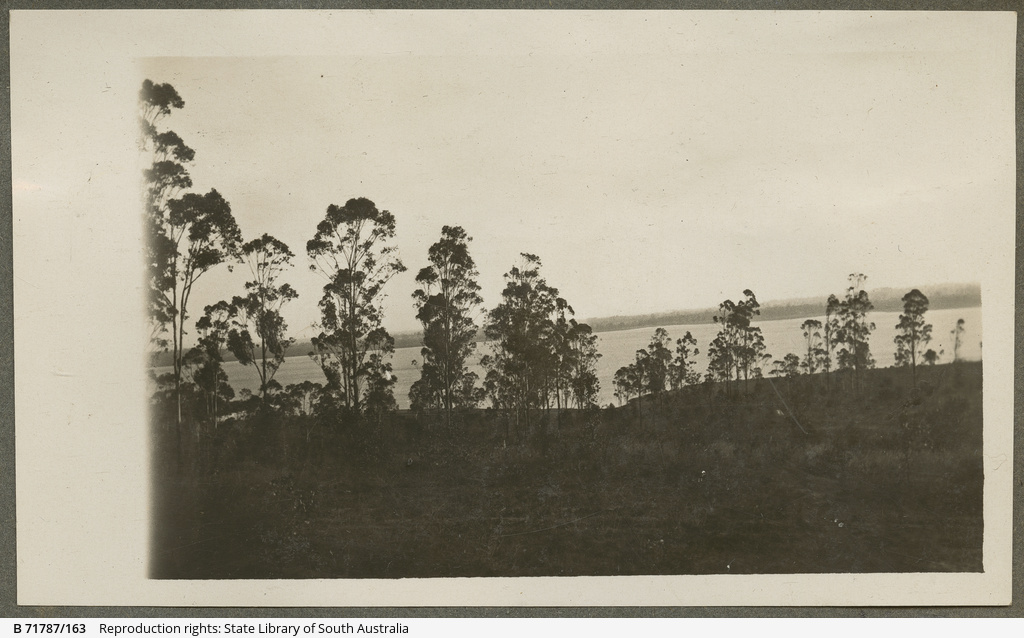
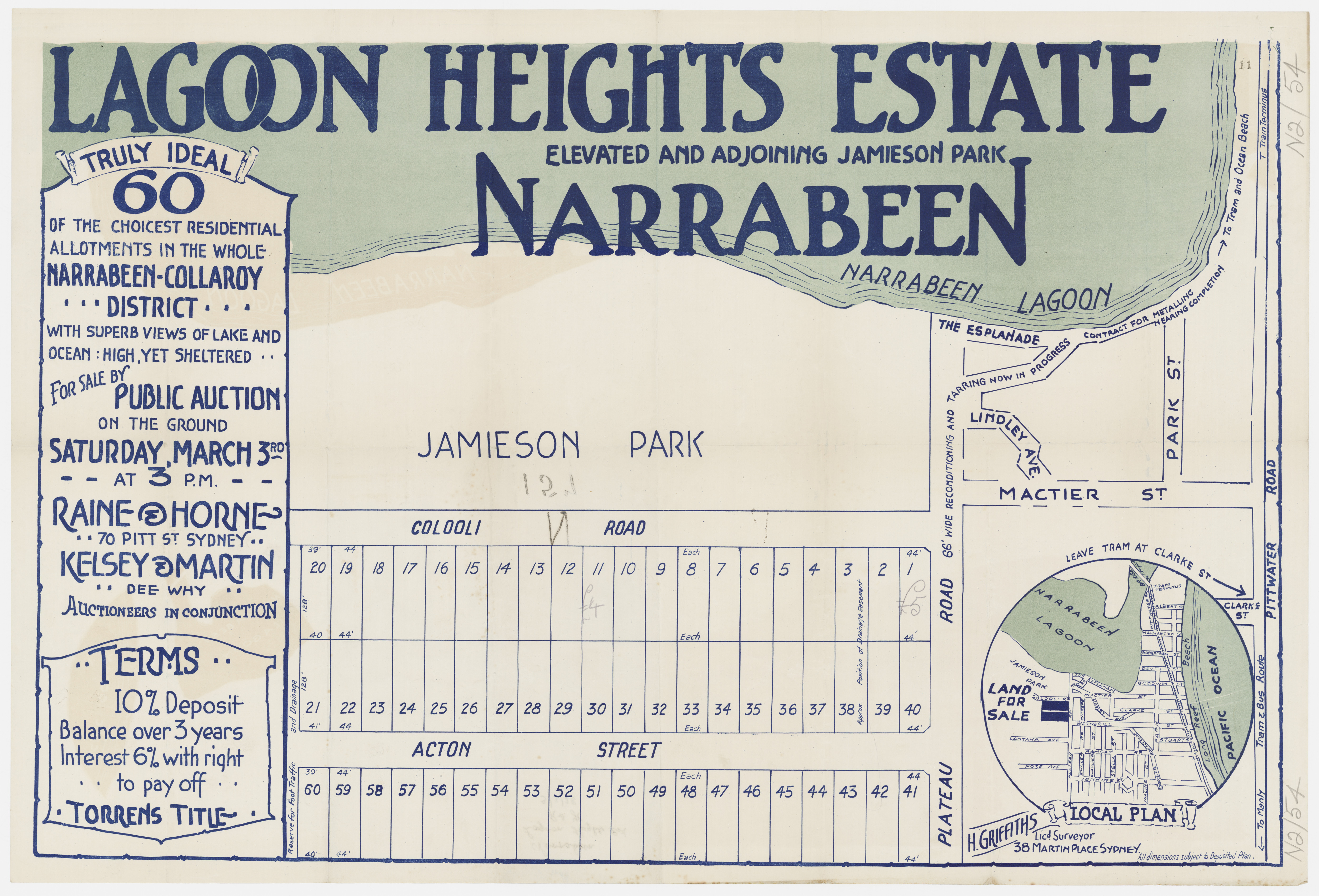
Lagoon Heights Estate 1928; Acton Street, Colooli Road Item: c050370054 , courtesy State Library of NSW
No. 25,989. James Wheeler, 179 acres, 1 rood 13 3/4 perches, on South Creek and Narrabeen Lagoon, Shire of Warringah. NOTICE UNDER REAL PROPERTY ACT. (1925, July 24). Government Gazette of the State of New South Wales (Sydney, NSW : 1901 - 2001), p. 3279. Retrieved from http://nla.gov.au/nla.news-article223014659
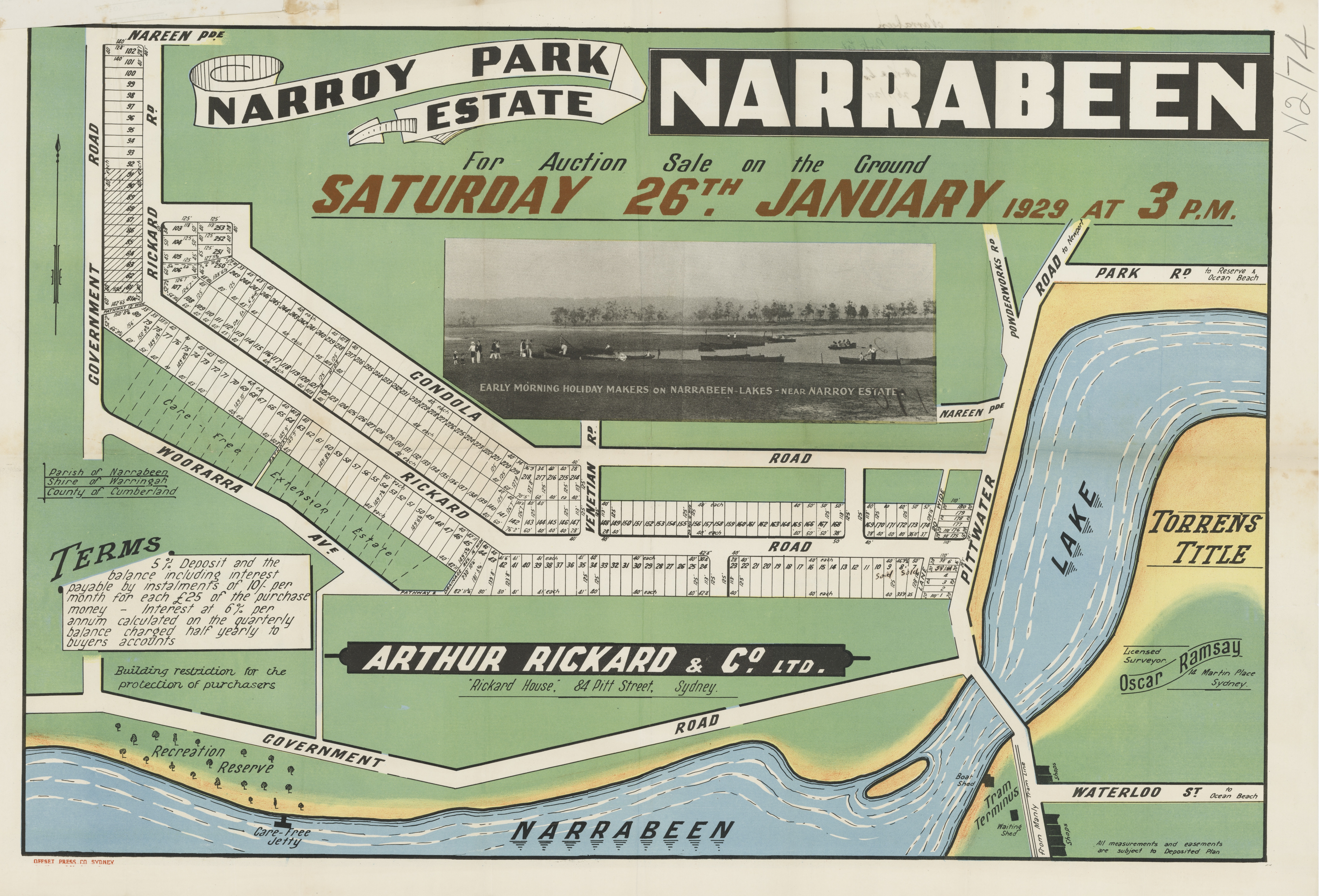
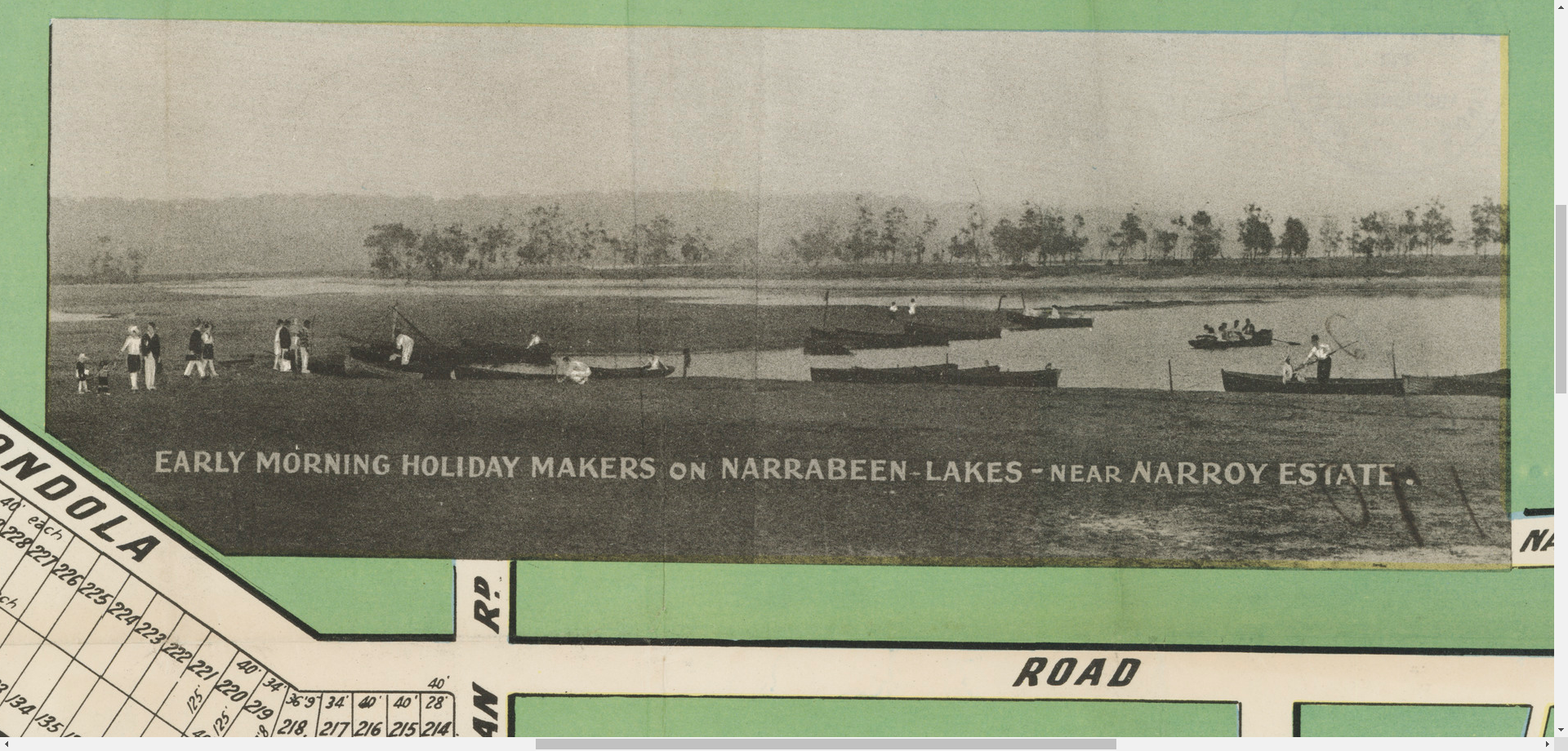
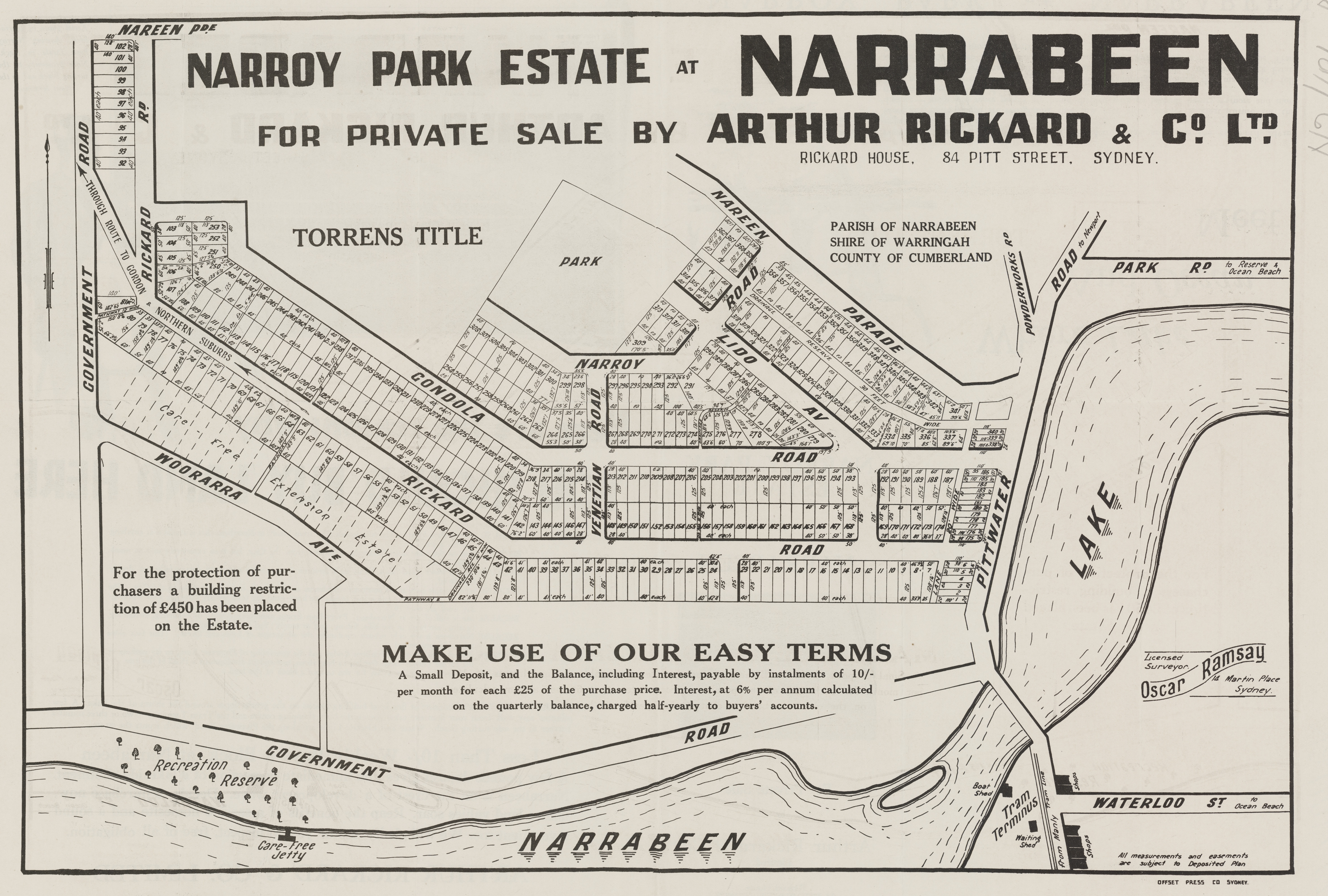
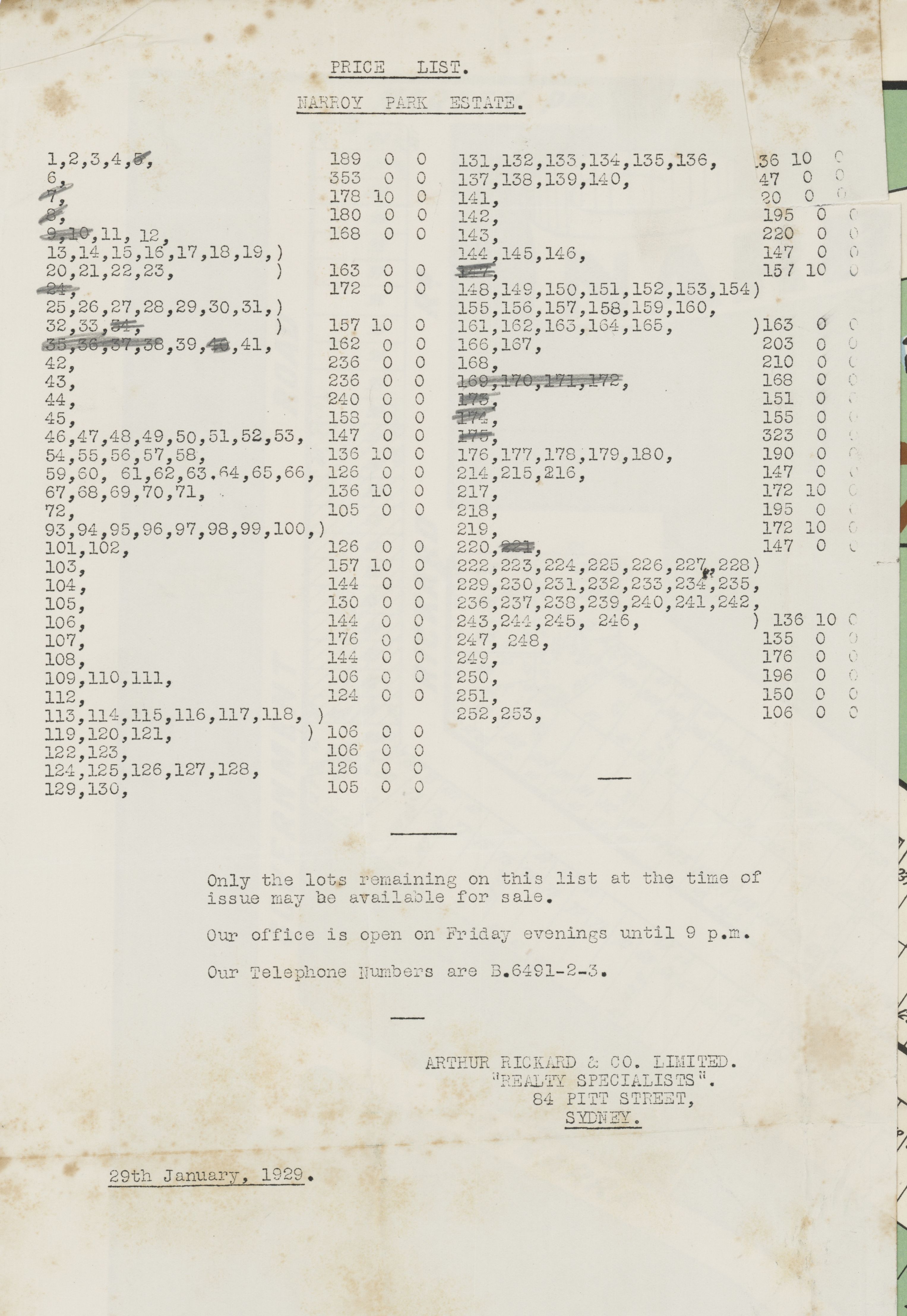
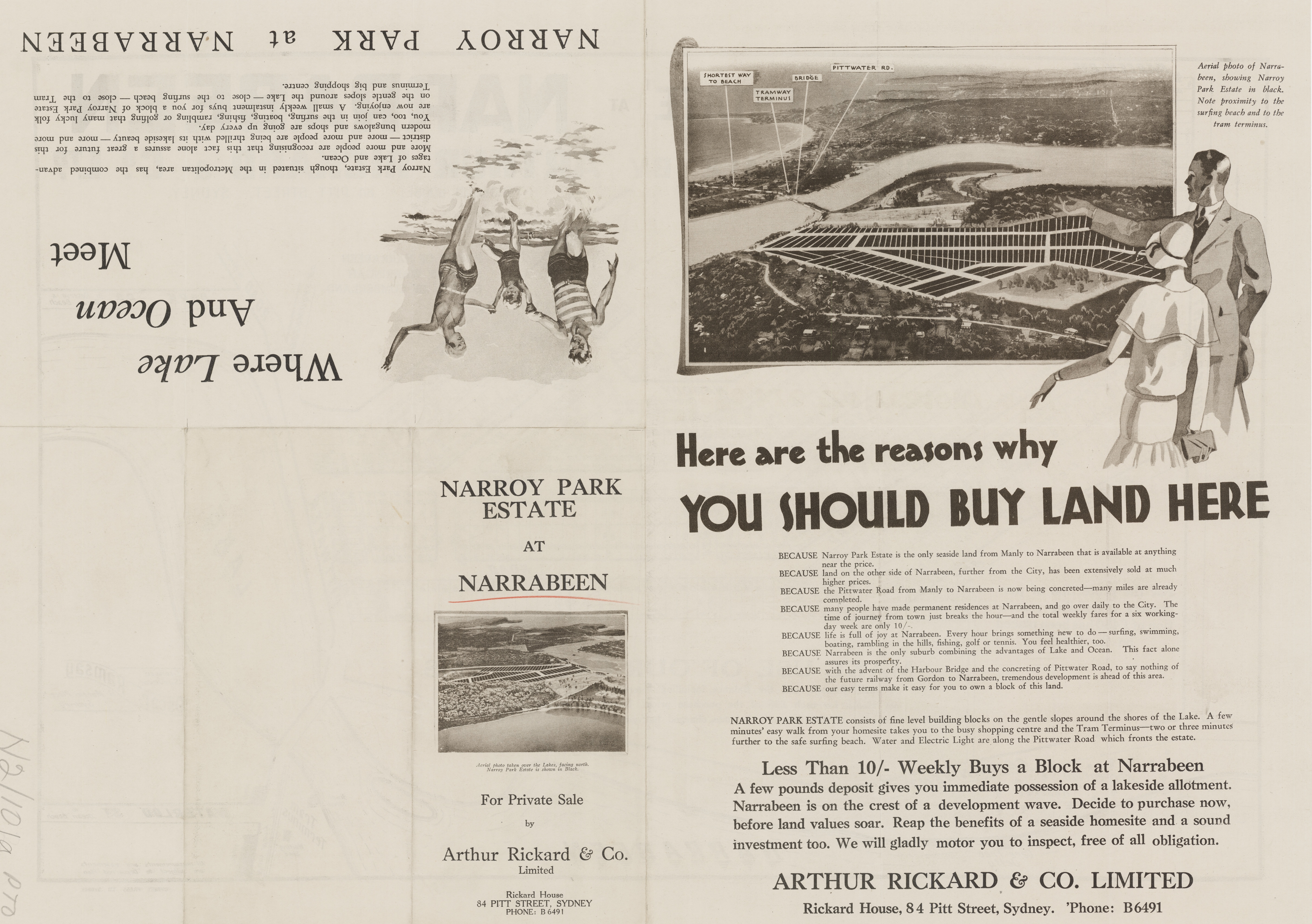
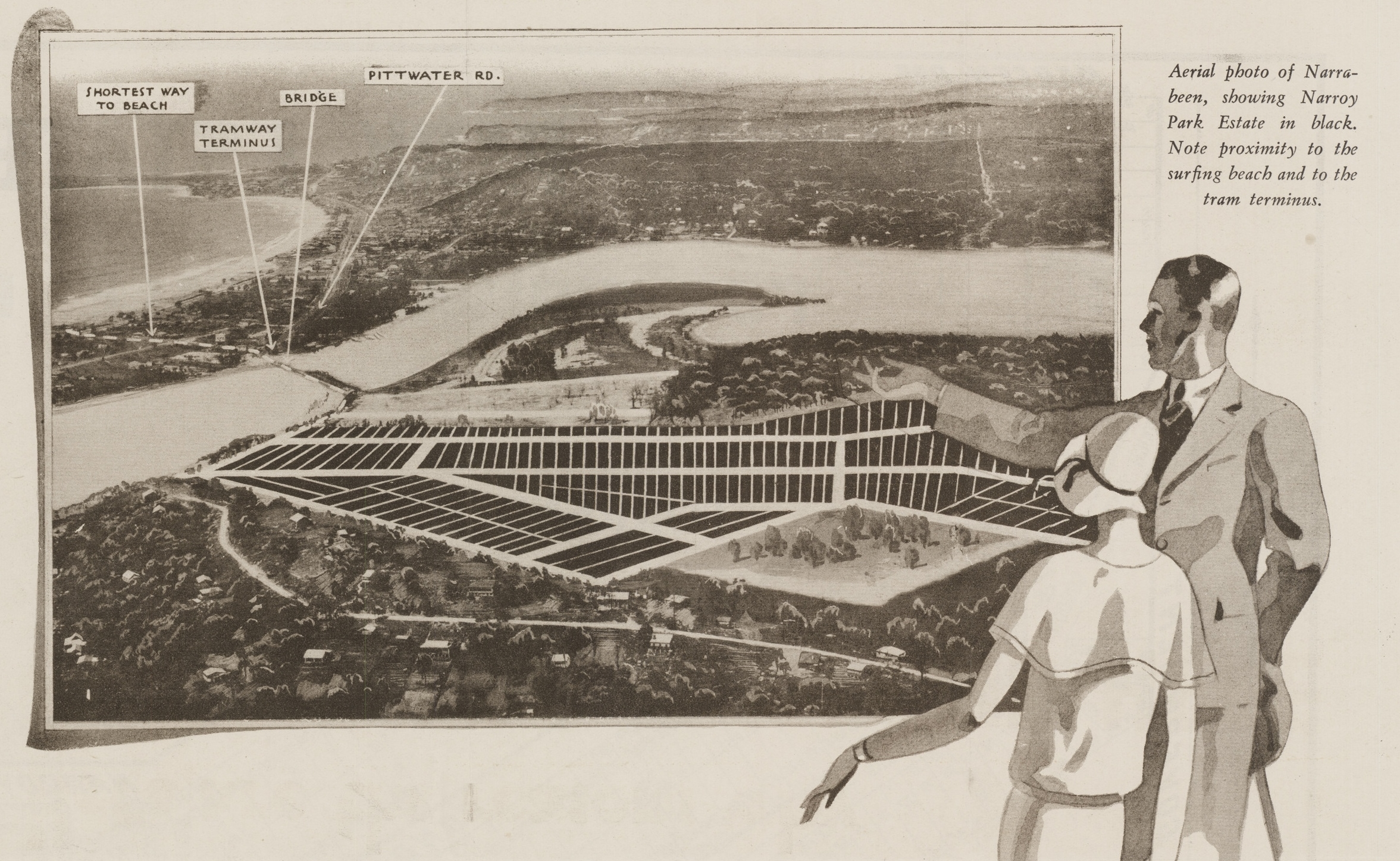
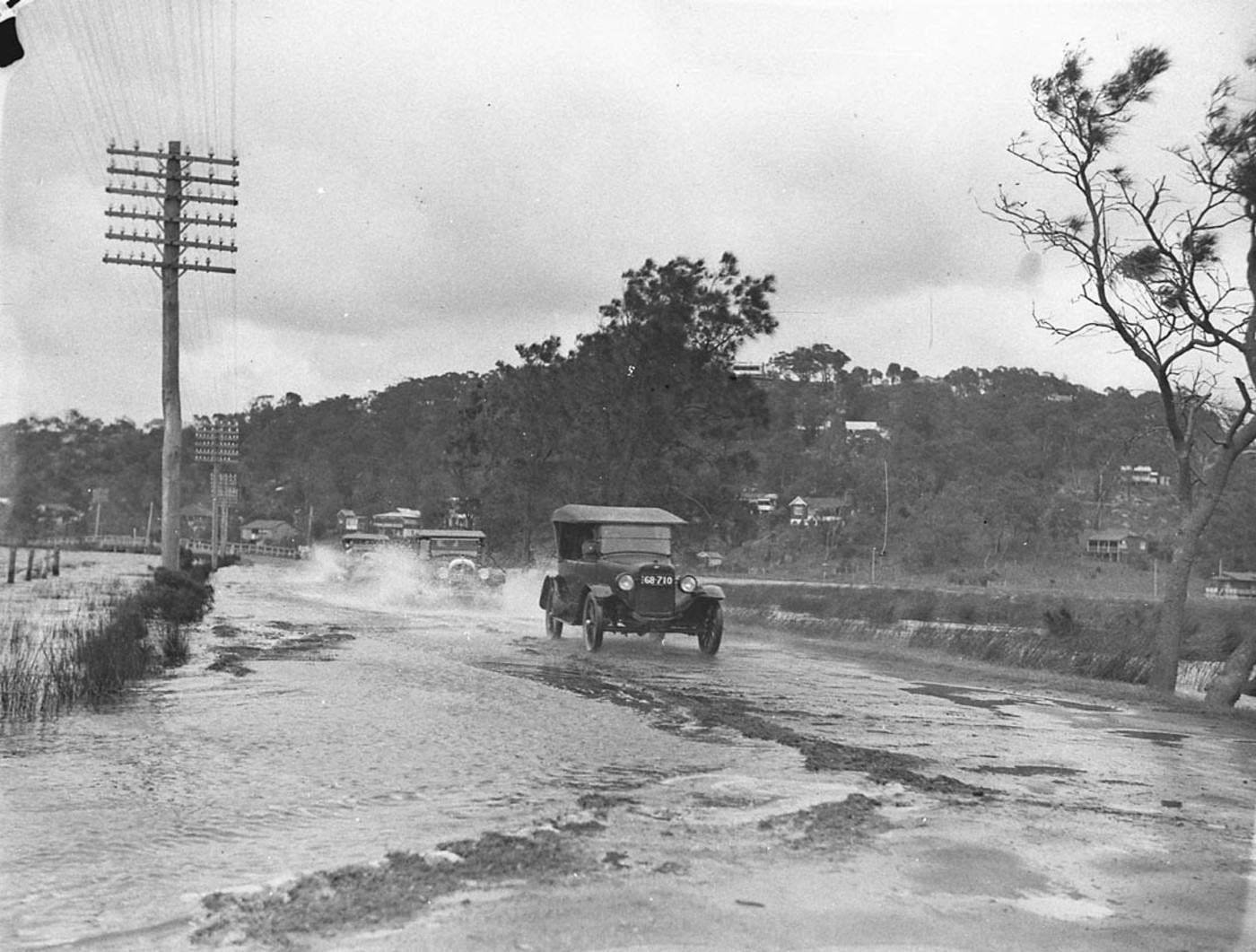
A 1926 Overland, a 1928 (?) Chrysler, and a 1928 (?) Dodge ploughing through Narrabeen floods - November 1927 Image. No: hood_06391- from the collections of the State Library of NSW.
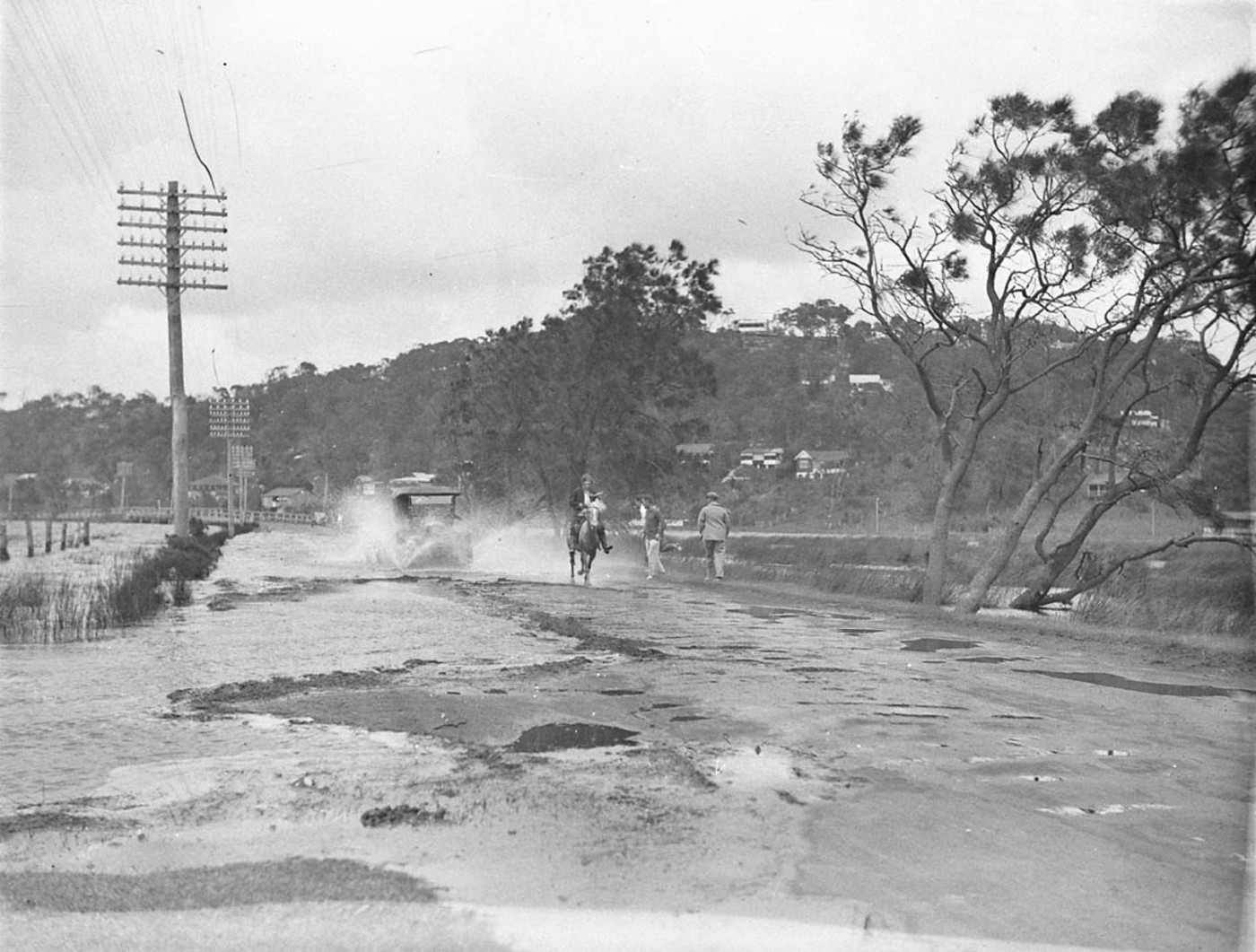
A car and a horse plough through a flooded road, Narrabeen - Image. No: hood-006394 from the collections of the State Library of NSW
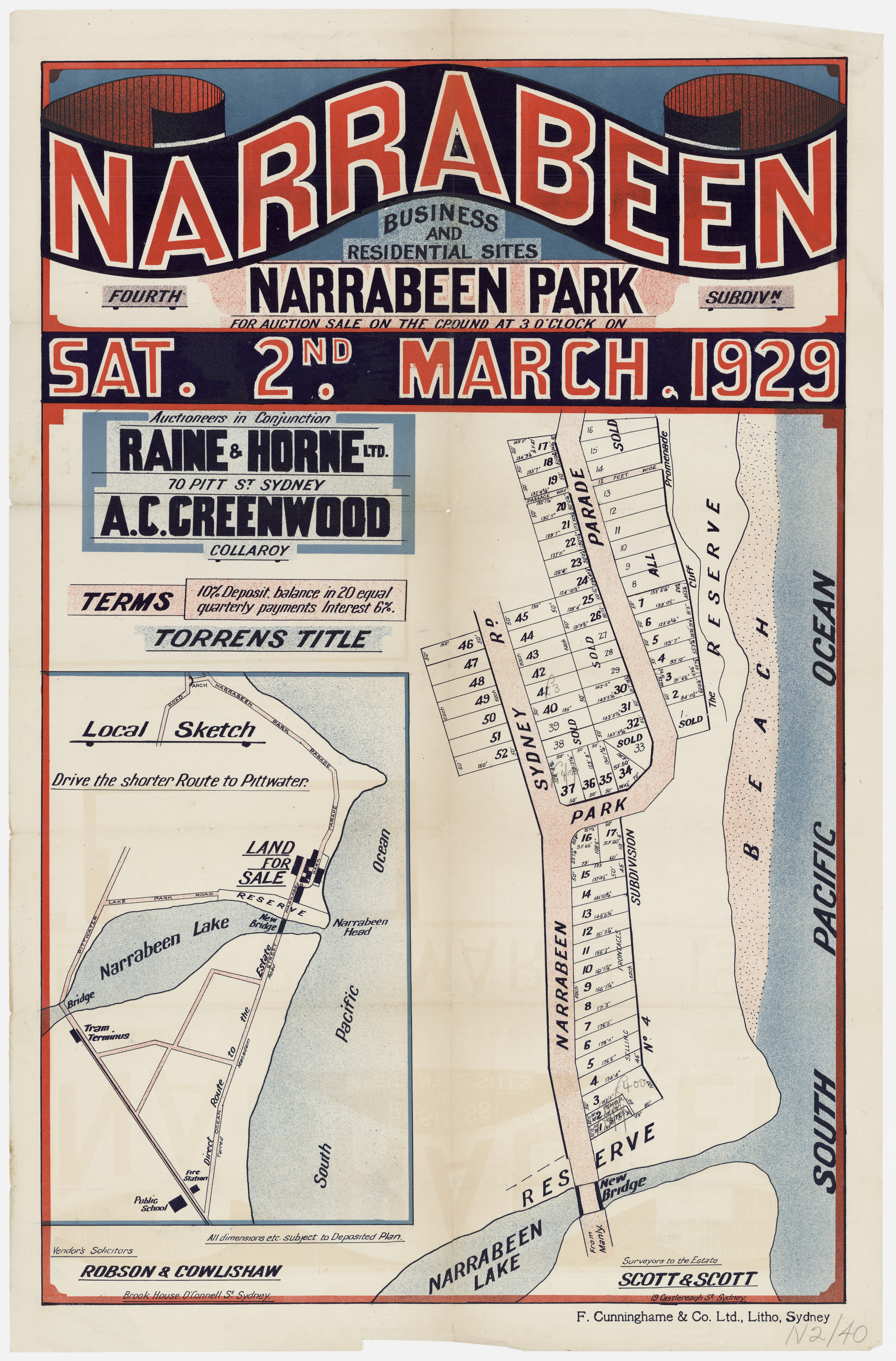
THE OLD ROAD
Narrabeen's Unspoilt Days
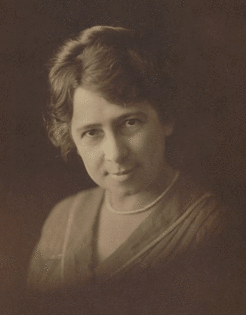 Once, long ago, the drive along this road was a feast of beauty, when one bowled along between sea and bush, with wide-spreading views on either side. We used to leave Circular Quay by the 8 o'clock boat to Manly, where at the wharf was waiting the old coach with its four horses. With luck-one seemed to be always lucky in those far-away days we got box seats and set out on our journey with gay spirits in the morning! sunshine. Down the Corso we rattled, and along the Steyne, with the pine trees making a delicate screen between us and the blue ocean. Leaving the Steyne, we crossed the bridge over the lagoon, not yet drained and ordered, into a golf course and suburban lots, but stretching lazily over the lowlands, where a vegetable gardener or two grew produce for "The Village." Then on past swamps, where red callistemon flowered in thousands, on round the foot of the hills, where a million flowers bloomed amongst the grey rocks and birds sang gaily and darted to and fro before us.
Once, long ago, the drive along this road was a feast of beauty, when one bowled along between sea and bush, with wide-spreading views on either side. We used to leave Circular Quay by the 8 o'clock boat to Manly, where at the wharf was waiting the old coach with its four horses. With luck-one seemed to be always lucky in those far-away days we got box seats and set out on our journey with gay spirits in the morning! sunshine. Down the Corso we rattled, and along the Steyne, with the pine trees making a delicate screen between us and the blue ocean. Leaving the Steyne, we crossed the bridge over the lagoon, not yet drained and ordered, into a golf course and suburban lots, but stretching lazily over the lowlands, where a vegetable gardener or two grew produce for "The Village." Then on past swamps, where red callistemon flowered in thousands, on round the foot of the hills, where a million flowers bloomed amongst the grey rocks and birds sang gaily and darted to and fro before us.
Here and there, at long intervals was a dwelling-some hermit in search of solitude, or an intrepid pioneer sensing the future value of the land. But so few they were that they scarcely made an impression on the landscape, and the drive seemed to be all bush. All bush and sea, for ever and again as the road leaned seawards we had the uninterrupted view of golden sand and blue ocean. Deewhy Lagoon, with its background of sand- hills and bushy cliffs, was a-swarm with black swans. Narrabeen stretched In a long, unbroken vista from Long Reef to the Lakes. What houses there were were mostly on the land side of the road, and a few on the shore were so scattered that they did not interrupt the view. (Our young architect used to plan an ideal Narrabeen, with all the dwellings on the hillside and the whole sea front a reserve.) And so all the way to Church Point. At Rock Lily and Bayview, where painters and professors had holiday homes, the houses were built on the higher side of the road, above the encroachment of the tide and the mosquito-laden swamps, and the view was free for all travelers to enjoy.
JOLTS AND JERKS.
Perhaps time has shed a glamour on that drive. Certainly the road surface was not what it is to-day, and the old coach rolled and rattled at times, but what are jolts and jerks to sixteen on a fresh spring morning, with sea and sky and bush alive with beauty?
Of the road which branched off to Newport and beyond we knew less, but we used to hear of the many charms along its length from two young men who every winter Sunday morning set out with a packet of sandwiches to walk to Barrenjoey. (They didn't "hike" in those days; they simply walked.) Later we came to know that road well, too. The green slopes and beach of Mona Vale, where a man ahead of his generation had built a mansion, almost at the end of the world it seemed then, the spreading sandhills of Newport, and the little beach beyond, with its rich palm grove-we knew them in their unspoiled days. Leaving the sea, the road climbed across to the inland harbour and ran along the water's edge, with nothing but the tall gumtrees to break our view of the blue bay; past Careel Bay, with its mangrove swamp; past the green flats, with their narrow border of pearly sand, to Palm Beach itself, where the gaunt grotesque tea-trees and banksias grew to the edge of the rosy sands.
But year by year the road grew, and In Its growing lost much of its charm. Tramlines stretched out mile upon mile; houses sprang up in long rows; the swamps were drained; the wild flowers disappeared. At Deewhy the black swans still floated on the lagoon, but in lessening numbers; Narrabeen Beach-now Collaroy-was hidden by a continuous line of cottages, and the sea was glimpsed only at the end of side streets; our young architect's dream of an ideal Narrabeen was gone for ever. The pleasant green sward which flanked Broken Bay at Palm Beach was covered with dwellings, and the white beach which encircled it "like a lovely woman's arm." as a poet said, was barely visible from the road. On the ocean front most of the tea-trees and banksias had gone to make way for neat lawns stretching to within a few yards of the water. Everywhere beauty had been driven out by profit, and the road which might have been one of the loveliest of seaside drives had been reduced to an almost suburban dullness.
THE NEW ROAD THREATENED.
With a luck which comes but seldom to those who have wasted their opportunities, this coastal strip has been given another chance. A new road has been built along the top of the cliffs, with wide views over hills and ocean. It is a road along which we always take our visitors, and we are never disappointed at their exclamations of surprise and delight. One world traveler said: "I have never seen a more beautiful seascape. It alone Is worth the long journey to Australia!" But alas! this new road is threatened with the fate of the old one. Already here and there a building stands between the road and the ocean. At present they are too few to spoil the landscape, but unless some action is taken in a few years, the whole of the view will be blocked out by rows of houses, and our last chance of a magnificent scenic drive will be gone.
From; THE OLD ROAD. (1933, May 6). The Sydney Morning Herald (NSW : 1842 - 1954), p. 9. Retrieved from http://nla.gov.au/nla.news-article16965117
Above: Photo of Amy Eleanor Mack, by May Moore - from National Library of Australia, nla.pic-an3084668
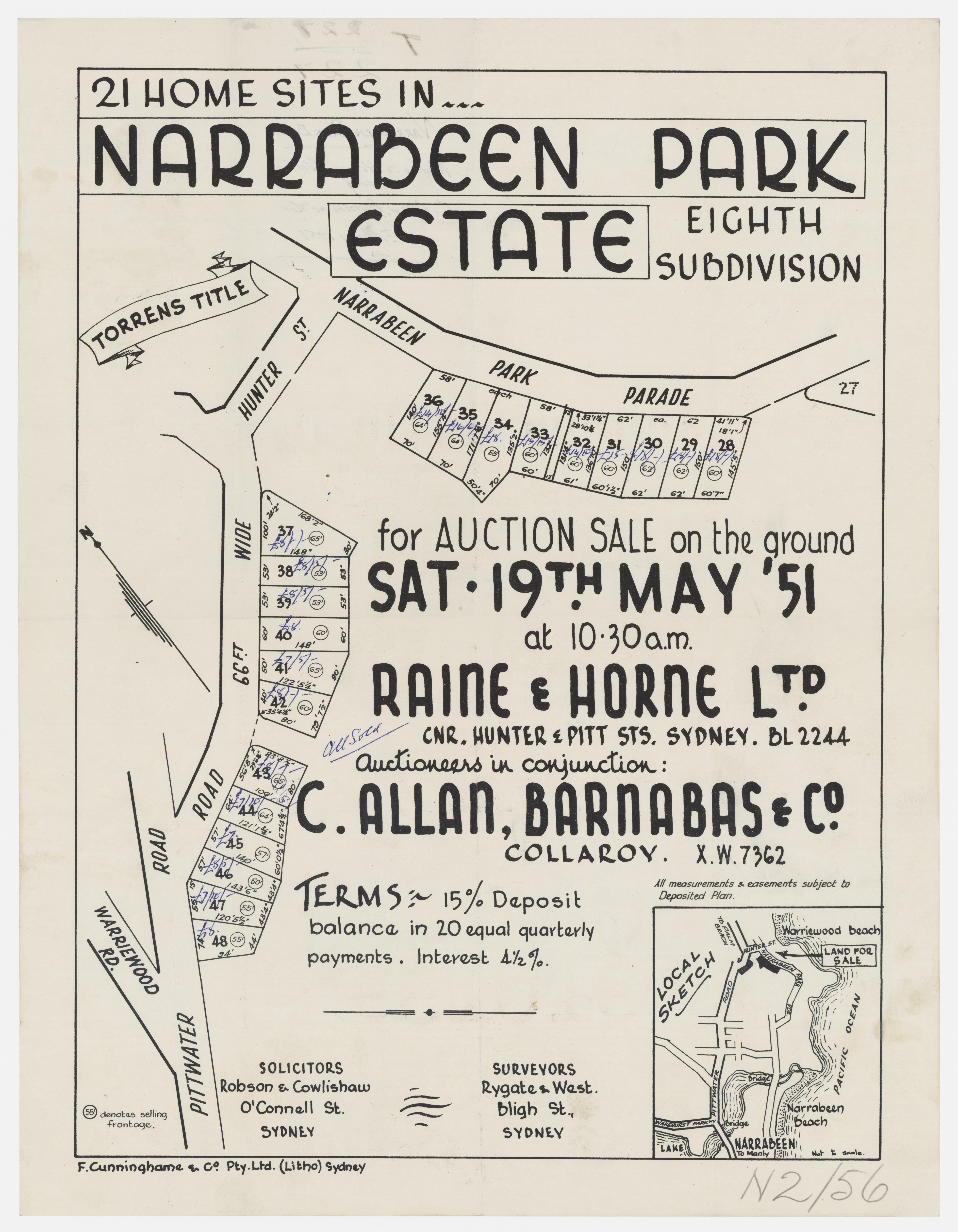
NARRABEEN
BENEATH a clouded sky of pearl and snow,
Where soft robes hide the sunset's rosy
hands,
The white gulls breast the wind, and far below,
White horses ride the breakers to the sands.
Beyond the clear green waves of Narrabeen,
The dim, long headlands, lying in the arc.
Grey with the evening hawks, keep, serene,
Their watch above the ocean's majesty.
— KITTY BARNES.
NARRABEEN (1926, January 30). Evening News (Sydney, NSW : 1869 - 1931), p. 4. Retrieved from http://nla.gov.au/nla.news-article126135763
Streets in Narrabeen and Real Property act
Albemarle Street
Albert Street
Catalina Close
Clarke Street
Claudare Street
Colooli Road
Cutler Circuit
Devitt Street
Edgecliffe Boulevard
Edmondson Drive
Emerald Street
Endeavour Drive
Essilia Street
Fuller Street
Gondola Road
Goodwin Street
James Wheeler Place
King Street
Lagoon Street
Lake Park Road
Lakeshore Drive
Lakeside Road
Lantana Avenue
Lindley Avenue
Lisle Street
Loftus Street
Mactier Street
Malcolm Street
Nareen Parade
Narrabeen Street
Narrabeen Park Parade
Nioka Road
Ocean Street
Octavia Street
Park Street
Pittwater Road
Rickard Road
Robertson Street
South Creek Road
Tallawarra Place
The Esplanade
Tourmaline Street
Veterans Parade
Wakehurst Parkway
Walker Avenue
Waterloo Street
Wellington Street
Wetherill Street: named for John Wetherill,
Wimbledon Avenue: named after the place in England which was visited by the Macpherson family and clearly was a place dear to their hearts. Visit: The Macphersons Of Wharriewood: The William Joseph Macpherson Albums
SHIRE OF WARRINGAH.—Renaming of Road.—
Ordinance 30, clause 53—Local Government Act.—Notice is hereby given that the undermentioned road has been renamed in accordance with section 249 (a) of the Local Government Act, 1919, as amended:—Past name or location: Millewa-road, North Narrabeen. New name: Nareen-parade, North Narrabeen. J. MORGAN, Shire Clerk, Shire Hal'. Brookvale, 11th March, 1963, 1776—16s. SHIRE OF WARRINGAH.—RENAMING OF ROAD.— (1963, March 15). Government Gazette of the State of New South Wales (Sydney, NSW : 1901 - 2001), p. 753. Retrieved November 7, 2020, from http://nla.gov.au/nla.news-article220329588
WARRINGAH SHIRE COUNCIL.—Naming of Lanes at North Narrabeen as Minarto Lane, Verona Street, and Bristol Lane.—Notice is hereby given that the Council, in accordance with the provisions of section 249 of the Local Government Act, 1919, as amended, has named—(a) the unnamed lane running between Windsor Parade, Rickard Road, Gondola Road, and Nareen Parade as Minarto Lane; (b) the unnamed road between Gondola and Rickard Roads as Verona Street; (c) the unnamed lane running between Grenfell Avenue, Windsor Parade, and Rickard Road as Bristol Lane, J. MORGAN, Shire Clerk, Shire Hall, Brookvale. 7883—$3.30. WARRINGAH SHIRE COUNCIL.—NAMING OF LANES AT NORTH NARRABEEN AS MINARTO LANE, VERONA STREET, AND (1970, May 8). Government Gazette of the State of New South Wales (Sydney, NSW : 1901 - 2001), p. 1748. Retrieved from http://nla.gov.au/nla.news-article220182364
_________________________________________________________
Property sale at Warriewood - Mona Vale end
On WEDNESDAY, February 27, 1884.
IN THE PARISH OF NARRABEEN, between MANLY and PITTWATER.
THE PICK OF THE DISTRICT, about 7 miles from Manly Beach, and only a short distance on the other side Of the newly-erected bridge across the Narrabeen Lagoon.
281 ACRES of RICH ARABLE LAND, situate at the junction of the main PITT WATER-ROAD with the LANE COVE ROAD.
THE PROPERTY will first be offered In ONE LOT, and, If not so sold,- then in THREE LOTS as per plan, comprising blocks of of 114a. 1r. 39p, 84a. 1r. 21p., and 80a. respectively.
THE LAND itself is of the richest possible soil, and most eminently adapted for fruit-growing, vine culture, market gardens, or equally well suited for subdivision into small farms of from 10 to 20 acres, the whole of the Land, with exception of about 20 acres (on which are good stones for building purposes), is capable of being ploughed. The property is bounded on almost all sides by good roads, and several Creeks run through the land, which, if regulated by a small outlay, would ensure a permanent water supply.
TITLE-CROWN GRANT.
Plans are ready and can be had on application at the Rooms, 133, Pitt-street.
HARDIE and GORMAN have received instructions to sell by public auction, at their Rooms, 133, Pitt-street, at-11.30 a.m., on WEDNESDAY. FEBRUARY 27, 1884.
The above-described block of RICH ARABLE LAND containing 281 ACRES, situate in the Parish of NARRABEEN, between MANLY and PITTWATER. Advertising (1884, February 20). The Sydney Morning Herald (NSW : 1842 - 1954), p. 14. Retrieved from http://nla.gov.au/nla.news-article28373191 - Warriewood valley.
PROPERTY SALES.
Messrs, Hardie and Gorman report having sold by public auction and private contract, during the week, the following properties: ...Mr Phillips, block of land at Narrabeen 53a 2r in area, for the sum of £1 per acre £53 10s-Mr Inglis, Pittwater, block of land, 6a 1r 2p In area being lot 7a of villa sites in Pittwater Estate, for £60 ...PROPERTY SALES. (1886, March 20). The Sydney Morning Herald (NSW : 1842 - 1954), p. 15. Retrieved from http://nla.gov.au/nla.news-article13614719
NOTICE UNDER REAL PROPERTY ACT.
APPLICATION'S having been made to bring the lands hereunder described under the provisions of the Real Property Act, Certificates of Indefeasible Title will issue, unless Caveats be lodged in Form B of the said Act, on or before the date named opposite each case respectively.
No. 6,571. Narrabeen, 107 acres, parish Manly Cove, comprises the land granted as 100 acres to D. Moores. Applicant John Wetherill. Caveats to be lodged by May 6, 1886
NOTICE UNDER REAL PROPERTY ACT. (1886, April 2). New South Wales Government Gazette (Sydney, NSW : 1832 - 1900), p. 2418. Retrieved from http://nla.gov.au/nla.news-article227667518
Real Property Act narrabeen + surrounds to Warriewood-Bayview-Mona vale
NOTICE UNDER REAL PROPERTY ACT.
APPLICATION'S having been made to bring the lands hereunder described under the provisions of the Real Property Act, Certificates of Indefeasible Title will issue, unless Caveats be lodged in Form B of the said Act, on or before the date named opposite each case respectively.
No. 6,571. Narrabeen, 107 acres, parish Manly Cove, comprises the land granted as 100 acres to D. Moores. Applicant John Wetherill. Caveats to be lodged by May 6, 1886 NOTICE UNDER REAL PROPERTY ACT. (1886, April 2). New South Wales Government Gazette (Sydney, NSW : 1832 - 1900), p. 2418. Retrieved from http://nla.gov.au/nla.news-article227667518
NOTICE UNDER REAL PROPERTY ACT.
APPLICATIONS having been made to bring the lands hereunder described under the provisions of the Real Property Act, Certificates of Indefeasible Title will issue, unless Caveats be lodged in Form B of the said Act, on or before the date named opposite each case respectively.
No. 6,845. Narrabeen, 455 acres 1 rood 38 perches,—comprises the land granted as 100 acres and 250 acres to James Jenkins and 50 acres to Daniel Rowan. Applicants: Elizabeth Jenkins, Martha Jenkins, and John Jenkins of Long Reef, Manly. NOTICE UNDER REAL PROPERTY ACT. (1887, April 1). New South Wales Government Gazette (Sydney, NSW : 1832 - 1900), p. 2327. Retrieved from http://nla.gov.au/nla.news-article224184246
Private advertisements.
REAL PROPERTY ACT.
Notice of intended issue op Provisional Certificate of Title,
Vol. 808, Folio 101.
Proprietor: Charles James Bulpin. Land: 1 acre 0 roods 6 perches, lots 1, 2, 19, and 20 of section 9 on deposited plan 1818, at Narrabeen, in the parish of Manly Cove and county of Cumberland.
THE proof of loss of the abovenamed original and other particulars required by section 98 of the abovenamed Act (26th Vic, No. 9) before issue of Provisional Certificate of Title having been supplied,—I hereby, with the consent of the Land Titles Commissioners, and in further pursuance of the requirements of this section, notify my intention to issue such Provisional Certificate of Title accordingly, at the expiration of twenty-one days from the date hereof.
E. G. WARD, Sydney, 13th December, 1888. Registrar General. Private Advertisements. REAL PROPERTY ACT. (1888, December 14). New South Wales Government Gazette (Sydney, NSW : 1832 - 1900), p. 8912. Retrieved from http://nla.gov.au/nla.news-article221690187
NOTICE UNDER REAL PROPERTY ACT.
APPLICATIONS having been made to bring the lands hereunder described under the provisions of the Real Property Act, Certificates of Indefeasible Title will issue, unless Caveats be lodged in Form B of the said Act, on or before the date named opposite each case respectively.
No. 7,879. Narrabeen Lagoon, 36 acres 0 roods 17 perches,—comprises the land granted as 30 acres to James Jenkins. Applicant: Ballington Booth - of New York, America, Charles Herbert Lindsay - of Ballarat, Victoria, and Thomas Henry Howard - of Melbourne, Victoria. Caveats may be lodged until 27, Feb., 1890. NOTICE UNDER REAL PROPERTY ACT. (1889, December 20). New South Wales Government Gazette (Sydney, NSW : 1832 - 1900), p. 9252. Retrieved from http://nla.gov.au/nla.news-article224336900
No. 6,571. Narrabeen, 107 acres, parish Manly Cove, comprises the land granted as 100 acres to D. Moores. Applicant: John Wetherill, Sydney. NOTICE UNDER REAL PROPERTY ACT. (1886, April 2). New South Wales Government Gazette (Sydney, NSW : 1832 - 1900), p. 2418. Retrieved from http://nla.gov.au/nla.news-article227667518
No. 6,845. Narrabeen, 455 acres 1 rood 38 perches,—comprises the land granted as 100 acres and 250 acres to James Jenkins and 50 acres to Daniel Rowan.Applicants: Elizabeth Jenkins, Martha Jenkins, and John Jenkins. Long Reef, Manly. NOTICE UNDER REAL PROPERTY ACT. (1887, April 1). New South Wales Government Gazette (Sydney, NSW : 1832 - 1900), p. 2327. Retrieved from http://nla.gov.au/nla.news-article224184246
No. 7,879. Narrabeen Lagoon, 36 acres 0 roods 17 perches,—comprises the land granted as 30 acres to James Jenkins. Applicants Ballington Booth New York, America, Charles Herbert Lindsay of Ballarat, Victoria and Thomas Henry Howard, Melbourne Victoria. NOTICE UNDER REAL PROPERTY ACT. (1889, December 20). New South Wales Government Gazette (Sydney, NSW : 1832 - 1900), p. 9252. Retrieved from http://nla.gov.au/nla.news-article224336900
No. 8,528. Near Narrabeen Lagoon, 109 acres,—comprises the land granted as 40 acres to Capper Pass and 50 acres to R. Stewart. Applicant: Thomas Collins of Manly. NOTICE UNDER REAL PROPERTY ACT. (1892, April 29). New South Wales Government Gazette (Sydney, NSW : 1832 - 1900), p. 3733. Retrieved from http://nla.gov.au/nla.news-article223544141
No. 12,176. County of-Cumberland, parish of Narrabeen, 1 acre 0 roods 1 1/2 perches, on the road from Manly to Pittwater, adjoining the properties of the trustee of the Salvation Army and J. T. Collins,—is part of 21 acres 2 roods 33 perches (portion No. 46 of parish) granted to John Thomas Collins. Applicant: John Thomas Collins. NOTICE UNDER REAL PROPERTY ACT. (1902, October 24). Government Gazette of the State of New South Wales (Sydney, NSW : 1901 - 2001), p. 7723. Retrieved from http://nla.gov.au/nla.news-article222048973
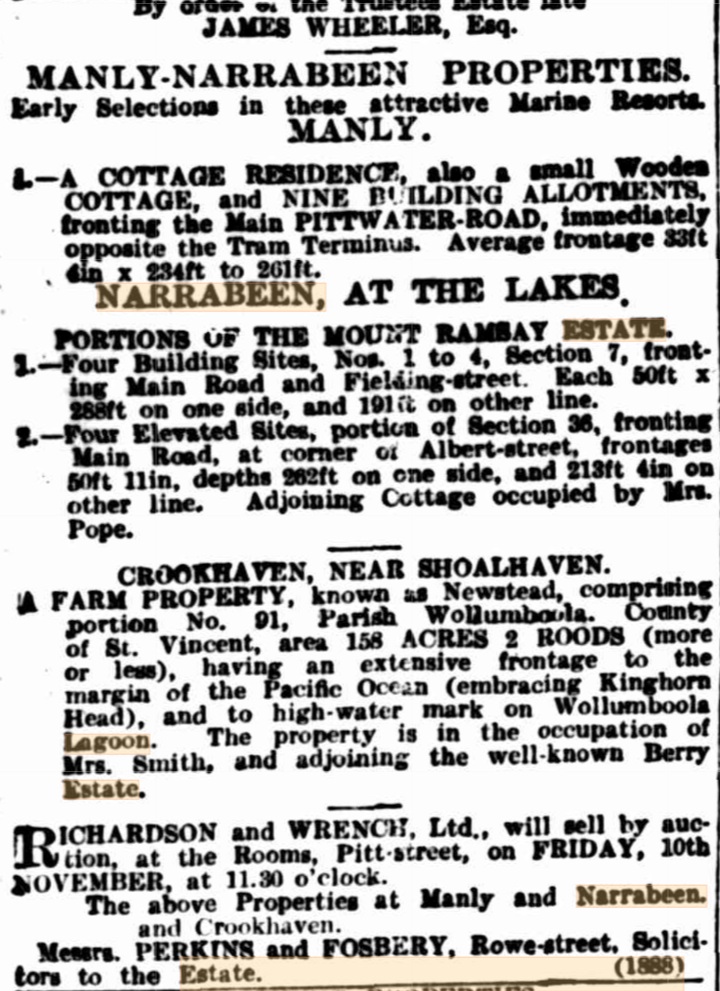
Advertising (1905, November 8). The Sydney Morning Herald (NSW : 1842 - 1954), p. 14. Retrieved from http://nla.gov.au/nla.news-article14730937
NOTICE UNDER REAL PROPERTY ACT.
APPLICATIONS having been made to bring the lands hereunder described under the provisions of the real Property Act( Certificates of Indefeasible Title will issue, unless Caveats be lodged in accordance with, the Third Schedule to the said Act, on or before the date named opposite each case respectively.
No. 13,759. County of Cumberland, parish of Manly Cove, 1 acre 2 roods 374 perches, 1 acre 2 roods 29 1/2 perches, 1 acre 2 roods 34 perches, 1 acre 2 roods 38 1/2 perches, 1 acre 3 roods 3 1/2 perches, 1 acre 3 roods 8 perches, 1 acre 2 roods 22 perches, 2 acres 2 roods 17 perches, 1 rood 1 perch, 4 acres 1 rood 22\ perches, 3 acres 3 roods 1 1/2 perches, 3 acres 2 1/2 perches, 4 acres 1 rood 22 1/2 perches, 4 acres 12 1/2 perches, 4 acres 1 rood 22 1/2 perches, 4 acres 1 rood 33 perches, 4 acres 18 1/2 perches, 4 acres, 2 roods 34 1/2 perches, 4 acres 2 roods 34 1/2 perches, 4 acres 3 roods 34^ perches, 4 acres 1 rood 21 1/2 perches, 4 acres 3 1/2 perches, 3 acres 3 roods 35 perches, 3 acres 2 roods 39 1/2 perches, 4 acres 3 roods 23 perches, 4 acres 2 roods 32 1/2 perches. 3 acres 36 1/2 perches, 3 acres 2 roods 6 1/2 perches, 2 acres 1 rood £2 perches, 1 acre 35 1/2 perches, 2 roods 15 perches, 2 acres 3 rood, 2 acres 3 roods 16 1/2 perches, 2 acres 3 roods 11 perches 2 roods 30 perches, 3 roods 20| perches, 2 roods 25 1/2 perches 2 acres 2 roods 7 1/2 perches, 1 acre 32 perches, 1 acre 1 rood 20 1/2 perches, 1 acre 3 roods 13 1/2 perches, 361 perches, 3 acres 2 roods 25 perches, 1 acre 3 roods 32 perches, 2 acres 4 perches, 3 acres 2 roods 24 1/2 perches, 2 acres 17 1/2 perches, 1 acre 1 rood 25 1/2 perches, 1 acre 13 perches, 1 rood 6 1/2 perches, 2 acres 2 1/2 perches 3 acres 2 roods 25 1/2 perches, 2 acres 1 1/2 perches, 2 acres 173 perches. 3 acres 2 roods 24 1/2 perches,—comprising lots Nos. 1 to 16, section A; lots Nos. 1 to 16, section B; lots Nos. 1 to 16, section C; lots Nos. 1 to 16, section D; lots Nos. 1 to 16. section .E; lots Nos. 1 to 16, section F; lots Nos. 1 to 7 and 9 to 16, section 6; lots Nos. 1 ti 16, section J; lot No. J, section K; lots Nos. 1 to 42, section L; lots Nos. 4 to 21 and Nos. 25 to 42, section M; lots Nos. 7 to 35, section O; lot? Nos. 1 to 42, section P; lots Nos. 1 to 21 and Nos. 25 to 42, section Q,; lots Nos. 1 to 42, section K; lots Nos. 1 to 36, section S ; lots Nos. 3 to 22 and Nos. 25 to 44, section T; lots Nos. 1 to 44, section U; lots Nos. 1 to 44, section V; lots Nos. 1 to 44, section W; lots Nos. 1 to 21 and Nos. 23 to 42, section X; lots Nos. 1 to 36, section Y; lots Nos. 2 to 21 and Nos. 26 to 43, section Z; lots Nos. 4 to 20 and Nob. 24 to 40, section A1; lots Nob. 1 to 40, section Bl; lots Nos. 1 to 38, section C1; lots Nos. 1 to 14 and Nos. 16 to 27, section D1; lots Nos. 1 to 29, section E1; lots Nos. 7 to 16 and Nos. 22 to 31, section F1; lots Nos. 6 to 9 and Nos. 11 to 14, section G1; lots Nos. 1 to 4, section H1 lots Nos. 7 to 21, section H1; lots Nos. 1 to 16, section K1; lots Nos. 1 to 18, section L1; lots Nos. 1, 2, and 3, section M1; lots Nos. 3, 4, 5, and reserve section Nl; lots Nos. 8 to 11, section M1, and Plateau Park of The Plateau; lots Nos. 2,3,4,7,8, and 9, section No. 33 of Fuller's subdivision; lots Nos. 9 to 14, section No. 41; lots Nos. 9 to 16, section No. 44; lot No. 3, section No. 47; lots Nos. 1 to 16, section No. 50; lots Nos. 1 to 8, section No. 51; lots Nos. 1 to 8, section No. 52 lots Nos. 1 to 16, section No. 53 ; lots Nos. 1 to 20, section No. 54 of Mount Ramsay Estate; lots Nos. I to 10, section No. 54, lots Nos. 1 to 5, section No. 55a ; lot No. 10, section 55a ; lots Nos. 2 to 20, section No. 55 of Fuller's subdivision; lots Nos. 1 to 16, section No. 56; lots Nos. 1 to 8, section No. 57; lots Nos. 1 to 8, section No. 58 ; lots No. 1 to 16, section No. 59 of Mount Ramsay Estate, situated at Narrabeen, in Victoria, Sturt, Lagoon, Ocean, Wellington, Albemarle, Loftus, Octavia, Tourmaline, Emerald, Malcolm, Collaroy, Jenkins, Ramsay, Wetherill, Mason, Fuller, Claudare, Essilia, Stella, Bland ford, Aubreen, Idaline, Hilma, and Alexander Streets, Park Road and Edgecliffe Boulevarde,— being parts of 410 acres (portion No. 1,217 of parish) granted to John Ramsay; adjoining the properties of F. B. Bays, Miss Alice M. Neal, E. J. Black, A. E. C. K. Lindfield, A. Porter, J, Berry, Isabella E. J. Shortland, Sarah Morris and G. Morris, Maude M. Rowson, Elizabeth Campbell, S. J. Fowler, C. Shepherd, G. E. Litchfield, Emily Mason, Amy F. Barton, T. W. Willans, A. Smithson, The Bank of New South Whales, The Salvation Army, Mrs. Mary Ann Osborne, Maria E. Mitchell, Dowling and Sullivan, D, McNab, A. Amos, — Harlow, Christina Beel, The Commercial Banking Company of Australia (Limited), J, Wheeler (junior) and J. Wetherill. Applicant. The Union Bank of Australia (Limited). NOTICE UNDER REAL PROPERTY ACT. (1905, November 17). Government Gazette of the State of New South Wales (Sydney, NSW : 1901 - 2001), p. 7654. Retrieved from http://nla.gov.au/nla.news-article220985744
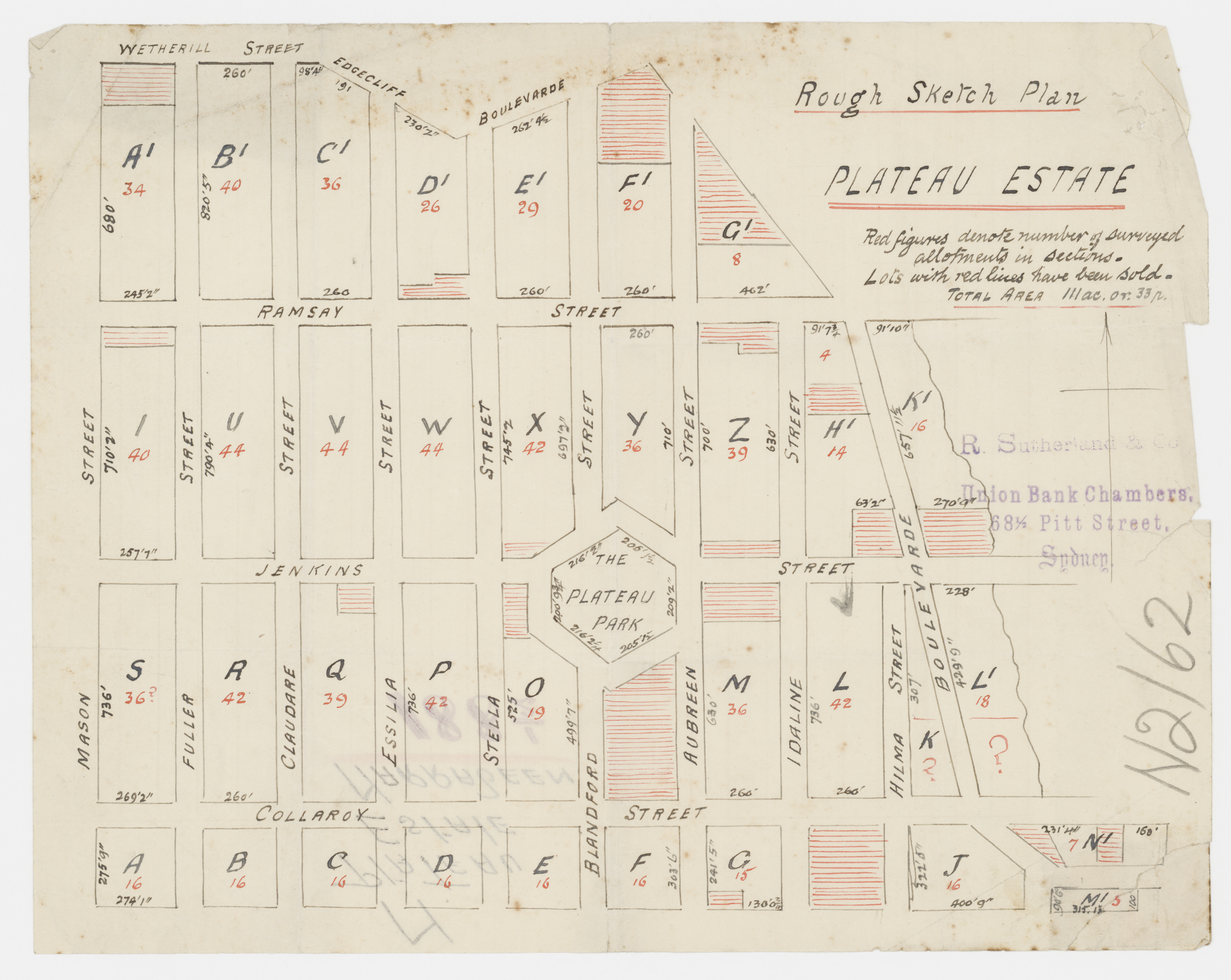
Rough sketch plan , Plateau Estate] - Mason St, Fuller St, Claudare St, Essilia St, Stella St, Blandford St, Aubreen St, Idaline St, Hilma St, Boulevarde, Collaroy St, Jenkins St, Ramsay St - circa 1905-1906. For the Union Bank of Australia. Item: c050370064, courtesy the State Library of New South Wales.
The Union Bank of Australia was an Australian bank in operation from 1837 to 1951, when it then merged with the Bank of Australasia to form the Australia and New Zealand Bank Limited (ANZ).
It was established in London in October 1837 with a subscribed capital of £500,000. The foundation of the bank had followed a visit to England by Van Diemen's Land banker Philip Oakden with a view to forming a large joint stock bank operating across the Australasian colonies, during which time he gained the support of businessman and banker George Fife Angas who had founded the South Australian Company. The new bank absorbed Oakden's struggling Launceston-based Tamar Bank upon his return, and opened its first branch in the former Tamar Bank premises on May 1st 1838. It expanded into Victoria on October 18th 1838, when it acquired the Melbourne business of the Tasmanian Derwent Bank, which had been the first bank in the city. It then opened its first Sydney branch on January 2nd 1839. In 1840, it opened its first New Zealand branch in Wellington. In its early years, it had an agreement with the original Bank of South Australia, of which Angas was also a director, not to open branches in that colony; however, an Adelaide branch was established in 1850. A Brisbane branch opened in 1858 and a branch in Perth followed in 1878.
It became the Union Bank of Australia Limited in March 1880.
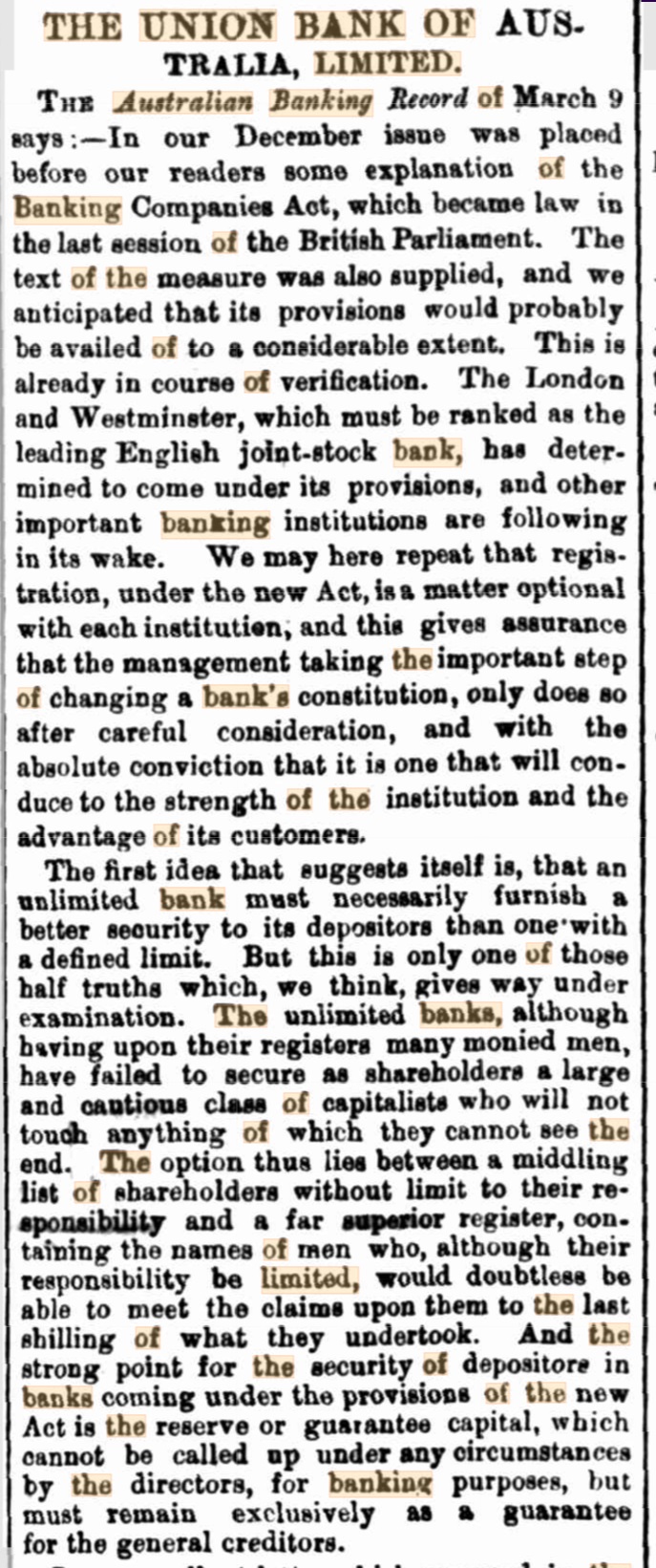
.jpg?timestamp=1609198775191)
.jpg?timestamp=1609198809989)
.jpg?timestamp=1609198839390)
THE UNION BANK OF AUSTRALIA LIMITED. (1880, March 23). The Telegraph (Brisbane, Qld. : 1872 - 1947), p. 3. Retrieved from http://nla.gov.au/nla.news-article174714370
The bank remained open throughout the economic crises of the 1890s. It acquired the Bank of South Australia in 1892.[7] By its centenary in 1937, it had 267 branches and agencies through Australia and New Zealand.
No. 14,531. APPLICANT Commercial Bank of Australia (Limited). LAND:—County Cumberland, parish Manly Cove,Shire Warringah, 3 acres 12 perches and 3 roods 25 1/2 perches, in Albert, Lagoon, Waterloo, and Ocean Streets, Narrabeen,— being lots I to 13, section 38, and lots 2, 3, 4, and 15, section 41, Mount Ramsay Estate, and part 410 acres (portion 1,217) granted to John Ramsay; adjoining the properties of A. K. Goldsmith, E. E. Fosbery, E. Fishburne, and J. Stevenson. NOTICE UNDER REAL PROPERTY ACT. (1907, April 24). Government Gazette of the State of New South Wales (Sydney, NSW : 1901 - 2001), p. 2352. Retrieved from http://nla.gov.au/nla.news-article223091411
No. 14,616. APPLICANT :—Alexander Barclay Shand, Sydney. LAND :—Shire Warringah, parish Manly Cove, county Cumberland, 3 roods 6 1/2 perches in Robertson and Victoria Streets. Narrabeen.—lot 1 and pait lot 2, section 32, Mount Ramsay Estate, and part 410 acres (portion 1,217) granted to John Ramsay ; adjoining the property of T. G. G. Gibbons. NOTICE UNDER REAL PROPERTY ACT. (1907, July 10). Government Gazette of the State of New South Wales (Sydney, NSW : 1901 - 2001), p. 3918. Retrieved from http://nla.gov.au/nla.news-article226593100
No. 14,756. APPLICANT:—N. S. W. Realty Co. (Limited). LAND :—County Cumberland, parish Manly Cove, shire Warringah, 1 acre 1 rood 22 1/2 perches, 1 acre 0 roods 29£ perches, 1 acre 1 rood 22 1/2 perches, and 2 acres 0 roods 12 perches, in Albemarle, Wellington, Ocean, Frazer, Jenkins, Fielding, and Collaroy Streets, Narrabeen ; lots I to 8, section 6, lots 1 to 8, section 6, lots 1 to 8, section 9, and lots 1 to 8, section 45, Mount Ramsay Estate, and part 410 acres (portion 1,217) granted to John Ramsay. NOTICE UNDER REAL PROPERTY ACT. (1907, October 9). Government Gazette of the State of New South Wales (Sydney, NSW : 1901 - 2001), p. 5642. Retrieved from http://nla.gov.au/nla.news-article221600550
NOTICE UNDER REAL PROPERTY ACT.
APPLICATIONS have been made to bring the lands hereunder described under the provisions of the Heal Property Act, Certificates of Indefeasible Title will issue, unless Caveats be lodged in accordance with the Third Schedule to the said Act, on or before the 15th JANUARY, 1908.
No. 13,753. APPLICANT:—Tertius Horatio Macpherson, Narrabeen. LAND:—County Cumberland, parish Narrabeen, Shire Warringah, 52 acres 1 rood 34 perches on Narrabeen Lagoon and Pittwater Road, part portion 8 granted to Thomas Collins, exclusive of the road 1 chain wide the area of which has been deducted from the total area ; adjoining the property of J. Wheeler. NOTICE UNDER REAL PROPERTY ACT. (1907, November 27). Government Gazette of the State of New South Wales (Sydney, NSW : 1901 - 2001), p. 6473. Retrieved from http://nla.gov.au/nla.news-article226586609
No. 14,938. APPLICANT:—Hannibal Hugh Gordon, Homebush. LAND:—County Cumberland, parish Manly Cove, shire Warringah, 2 acres 1 rood 38 perches, in Stuart, Ocean, and Ramsay Streets, near Narrabeen Lagoon, lots 1 to 8, 20 and 21, section 12, Mount Ramsay Estate, and part 410 acres (portion 1,217 of parish) granted to John Ramsay and adjoining the properties of W. Pollard and J. Wheeler. NOTICE UNDER REAL PROPERTY ACT. (1907, December 11). Government Gazette of the State of New South Wales (Sydney, NSW : 1901 - 2001), p. 6672. Retrieved from http://nla.gov.au/nla.news-article226587161
No. 14,852. APPLICANT :—Henry Ferdinand Halloran, Sydney. LAND :—County Cumberland, parish Manly Cove, Shire Warringah, 32 perches, 23 1/2perches, and 31 perches, in Robertson, Devitt, Ocean, and Victoria Streets, Narrabeen, lots 1 and 7, section 28, and lot 1a, section 29, Mount Ramsay Estate, and part 410 acres (portion 12,17), granted to John Ramsay; adjoining properties of Mrs. M. A. Heylin and P. E. Fallon. NOTICE UNDER REAL PROPERTY ACT. (1907, December 31). Government Gazette of the State of New South Wales (Sydney, NSW : 1901 - 2001), p. 6982. Retrieved from http://nla.gov.au/nla.news-article226587711
No. 16,385. APPLICANT:—Thomas George Gordon Gibbons, Narrabeen. LAND : — Shire Warringah, parish Manly Cove, county Cumberland, 1 acre 1 rood 5 perches, in Victoria-street,—lot 3, and part lot 2, of section 32, Mount Ramsay Estate, and part 410 acres (portion 1,217 of parish), granted to John Ramsay ; adjoining properties of N. Cooper and A. B. Shand. NOTICE UNDER REAL PROPERTY ACT. (1908, November 4). Government Gazette of the State of New South Wales (Sydney, NSW : 1901 - 2001), p. 5789. Retrieved from http://nla.gov.au/nla.news-article226595198
No. 10,674. APPLICANT; George Robert McIntosh, Hunter's Hill. LAND:—County Cumberland, parish Manly Cove, shire Warringah, 10 acres I rood 15 perches, on Narrabeen Lagoon and South Pacific Ocean, and in Lagoon, Malcolm, and Ocean Streets, sections 62 and 68 ; and adjoining portions of Mount Ramsay Estate, and part 410 acres granted to John Ramsay. NOTICE UNDER REAL PROPERTY ACT. (1909, January 28). Government Gazette of the State of New South Wales (Sydney, NSW : 1901 - 2001), p. 458. Retrieved from http://nla.gov.au/nla.news-article227059299
No. 16,112. APPLICANT:—N.S.W. Realty Co. (Limited). LAND: —County Cumberland, parish Manly Cove, Shire Waringah, 2 roods 27 1/2 perches, in Ocean-street, Narrabeen,—lots 4 and 5, section 39, Mount Ramsay Estate, and part 410 acres (portion I,217 of parish) granted to John Ramsay; adjoining the properties of J. P. Slack and C. De Burgh-Kirwan. NOTICE UNDER REAL PROPERTY ACT. (1909, September 22). Government Gazette of the State of New South Wales (Sydney, NSW : 1901 - 2001), p. 5150. Retrieved from http://nla.gov.au/nla.news-article226579215
LAND:—County Cumberland, No. 16, 072. APPLICANT:—John Calvert Lewtas, Manly. LAND:—County Cumberland, parish Manly Cove, shire Warringah, 2 acres 16 1/2 perches, in Ocean and Robertson streets, at Narrabeen, lots 1 to 8, section 30, Mount Ramsay Estate, and part 410 acres (portion 1,217 of parish) granted to John Ramsay; adjoining the property of W. H. McLaughlin. NOTICE UNDER REAL PROPERTY ACT. (1909, November 3). Government Gazette of the State of New South Wales (Sydney, NSW : 1901 - 2001), p. 5948. Retrieved from http://nla.gov.au/nla.news-article226590387
No. 16,145. APPLICANT: George Scales, Darlinghurst. LAND : County Cumberland, parish Manly Cove, Shire Warringah, 3 roods 26 1/4 perches, in Ocean and Collaroy streets, Narrabeen, lots 5 to 8, section 2. Mt. Ramsay Estate, and part 410 acres (portion 1,217 of parish) granted to John Ramsay; adjoining property of G. Scales. NOTICE UNDER REAL PROPERTY ACT. (1910, January 12). Government Gazette of the State of New South Wales (Sydney, NSW : 1901 - 2001), p. 144. Retrieved from http://nla.gov.au/nla.news-article227061041
Messrs. Hardie and Gorman report having sold during the week the following; ...Official Assignee's right, title, and interest (if any) in and to roads, streets, ways, and reserves, Mount Ramsay Estate, £250...PROPERTY TRANSACTIONS. (1910, February 13). The Sunday Sun (Sydney, NSW : 1903 - 1910), p. 2. Retrieved from http://nla.gov.au/nla.news-article226884387
No. 16, 330. APPLICANT:—Henry Wolstenholme, Killara. LAND:—County Cumberland, parish Manly Cove, shire Warringah, 1 acre 2 roods 15 1/2 perches, at intersection of Narrabeen and Ocean streets, at Narrabeen, lots 9 to 12, section 30, Mount Ramsay Estate, and part 410 acres (portion 1/J1T of parish) granted to John Ramsay; adjoining property of J. C. Lewtas. NOTICE UNDER REAL PROPERTY ACT. (1910, June 29). Government Gazette of the State of New South Wales (Sydney, NSW : 1901 - 2001), p. 3509. Retrieved from http://nla.gov.au/nla.news-article226906893
No. 16,518. APPLICANT:—Arthur Joseph Reynolds, Sydney. LAND:—County Cumberland, parish Manly Cove, shire Waningah, 1 rood 34 perches, at intersection of Ocean and Mactier streets, Narrabeen,—lots 7, 8, section 18, Mount Ramsay Estate, and part 410 acres (portion 1,217 of parish) granted to John Ramsay ; adjoining property of Narrabeen Progress Association. NOTICE UNDER REAL PROPERTY ACT. (1910, August 10). Government Gazette of the State of New South Wales (Sydney, NSW : 1901 - 2001), p. 4393. Retrieved from http://nla.gov.au/nla.news-article226765895
No. 10,577. APPLICANT:—N.S.W. Realty Co. (Limited). LAND:—County Cumberland, parish Manly Cove, shire Warringah, 1 rood 41 perches and 2 acres 3 roods 22} perches, in Victoria-street and on Narrabeen Lagoon.—lots 3 to 12, and 21, 22, and 23, section 32a, Mount Ramsay Estate, and part 410 acres (portion 1,217 of parish) granted to John Ramsay; adjoining properties of J. Russell, T. H. Macpherson, and Church of England. NOTICE UNDER REAL PROPERTY ACT. (1910, September 28). Government Gazette of the State of New South Wales (Sydney, NSW : 1901 - 2001), p. 5310. Retrieved from http://nla.gov.au/nla.news-article226763068
No. 16,239. APPLICANT Maria Emily Mitchell, Narrabeen. LAND: —County Cumberland, parish Manly Cove, shire Warringab, 1 acre 1 rood Hi perches and 2 roods 8 perches, in Victoria, Ocean, and Narrabeen streets—lots 1, 2, 15, and 16, section 33, and lot 2, section 34, Mount Ramsay Estate, and lots 1 and 6, section 33, Fuller's subdivision part Mount Ramsay Estate, and part 410 acres (portion 1,217 of parish) granted to John Ramsay; adjoining properties of Dr. Pope, O. J. Carr, and Mrs. Thompson or Mrs. McDonald. NOTICE UNDER REAL PROPERTY ACT. (1911, April 5). Government Gazette of the State of New South Wales (Sydney, NSW : 1901 - 2001), p. 1932. Retrieved from http://nla.gov.au/nla.news-article221617932
No. 17,0.58. APPLICANT:—George Scales, Manly. LAND:—County Cumberland, parish Manly Cove, shire Warringah, 1 acre 3 roods 33 perches, in Ocean street, Narrabeen,—lots 2 to 7, section 24. Mount Ramsay Estate, and part 410 acres (portion 1,217 of parish) granted to John Ramsay; adjoining property of Mrs. M. Thompson. NOTICE UNDER REAL PROPERTY ACT. (1911, June 28). Government Gazette of the State of New South Wales (Sydney, NSW : 1901 - 2001), p. 3480. Retrieved from http://nla.gov.au/nla.news-article226774250
No. 17,140. APPLICANTS:—Edith Mary Loder, Paddington, Edward Thomas West, Chatswood, and Ada Blanche Ellis, Chatswood. LAND:—County Cumberland, parish Manly Cove, shire Warringah, 13 acres I rood 1 1/2 perches, and 42 acres 2 roods 30 perches in Clarke, Mactier, Park, and Wetherill streets and on Narrabeen Lagoon,—lots 9 to 14, lot 14b, lots 15 to 20 and part lot 14a, section 20, lots 5 to 14, lots 14a and 1 in, and lots 15 to 28, section 20a, and blocks 1 and 2, Mount Ramsay Estate, and part of 410 acres (portion 1,217 of parish) granted to John Ramsay; adjoining properties of E. F. C. M. Sivyer, N.S.W. Realty Co., J. Wheeler, and N. Cooper. NOTICE UNDER REAL PROPERTY ACT. (1911, July 26). Government Gazette of the State of New South Wales (Sydney, NSW : 1901 - 2001), p. 3981. Retrieved from http://nla.gov.au/nla.news-article230684495
No. 17,120. APPLICANT:—Roland James Pope, Manly. LAND:—County Cumberland, parish Manly Cove, shire Warringah, 2 roods 214 perches, and 1 acre 1 rood 34 3/4 perches, Victoria, King, and Ocean streets,—lots 7 to 10 inclusive, section 33, and lots 7 and 8, section 34, Mount Ramsay Estate, and lots o and 10, section 33 of Narrabeen Lakes subdivision of part Mount Ramsay Estate, and part 410 acres (portion 1,217 of parish) granted to John Ramsay; adjoining properties of Dr. R. J. Pope, and M. Mitchell. NOTICE UNDER REAL PROPERTY ACT. (1911, August 9). Government Gazette of the State of New South Wales (Sydney, NSW : 1901 - 2001), p. 4342. Retrieved from http://nla.gov.au/nla.news-article230685054
No. 16,973. APPLICANT James Wheeler, Narrabeen. LAND : County Cumberland, parish Manly Cove, shire Warringah, 1 acre 1 rood 31 1/2 perches, 3 roods 18 perches, 1 acre 3 roods 1 perch, 3 acres 11 perches, 1 acre 3 roods 3 perches, 34 perches, 1 rood 30 1/2 perches, 35 perchos, 2 roods 2 1/2 perches, 1 rood 30 1/2 perches, 2 roods 2 3/4 perches, and 2 acres 3 roods If perches, in Jenkins, Frazer, Ramsay, Stuart, Wetherill, Clarke, Mactier, Goodwin, Devitt, Lagoon, Wellington, and Park streets, and on Narrabeen Lagoon,—lots 22 to 28. section 8; lots 9, 16, 17, 18, section 11: lots 10 to 14 and 17. 18, 19, scction 12; lots 13 to 26, section 16; lots 12 to 15 and 18 to 21, section 19: part lot 14a, section 20: lots 3, 4, 7, 11, 12, 13, section 21: lots 12, 13. section 22: lots 5, 7, 8, section 26: part lot 2: and lots 3 to 8, section 42, Mount Ramsay Estate: and part 410 acres (portion 1,217 of parish) granted to John Ramsay: adjoining properties of J. Wheeler, R. Pfoeffer, C. A. S. Hayden, E. A. Powell, C. M. E. West, H. S. Haynes, E J. West, Mrs. E. M. Loader, A. E. Ellis, C. A. de Kantzow, D. McLean, A. O. West, H. H. Gordon, W. Pollard, W. S. Beale, W. A. Lipscombe, W. L. McFarlane, estate J. Langley, J. F. C. Goodridge, A. E. Dowling, W. Nicholls, T. H. Page, and G. L. Pring. NOTICE UNDER REAL PROPERTY ACT. (1911, August 30). Government Gazette of the State of New South Wales (Sydney, NSW : 1901 - 2001), p. 4711. Retrieved from http://nla.gov.au/nla.news-article230685900
No. 16.930. APPLICANT:—Herbert Edgar McIntosh. Sydney. LAND:—County Cumberland, parish Manly Cove, shire Warringah, 4 acres 3 roods 36 perches. in Emerald, Lagoon, and Malcolm streets, and on Narrabeen Lagoon, whole section 60, Mount Ramsay Estate, and part 410 acres (portion 1,217 of parish) granted to John Ramsay. NOTICE UNDER REAL PROPERTY ACT. (1911, September 13). Government Gazette of the State of New South Wales (Sydney, NSW : 1901 - 2001), p. 4937. Retrieved from http://nla.gov.au/nla.news-article227592326
No. 17,037. APPLICANTS :—George Scales and David Lindesay Aitken, both Sydney. LAND : — County Cumberland, parish Manly Cove, shire Warringah, 96 acres 2 roods 7 1/4 acres, on Narrabeen Creek, near Narrabeen Lagoon,—land granted as 30 acres (portion 51 of parish), to James Wheeler, and 50 acres (portion 48 of parish), to John William Alexander White; adjoining property of estate late T. H. Kelly and Crown Land. NOTICE UNDER REAL PROPERTY ACT. (1912, April 10). Government Gazette of the State of New South Wales (Sydney, NSW : 1901 - 2001), p. 2230. Retrieved from http://nla.gov.au/nla.news-article227591158
No. 14,164. APPLICANT:—William Booth, London, England. LAND:—County Cumberland, parish Narrabeen, Shire Warringah, 259 acres, on Pacific Ocean and Narrabeen Lagoon; and on Manly to Pittwater-road,—lands granted as 60 acres (portion 13 of parish) 60 acres (portion 14 of parish), and 80 acres (portion 15 of parish) to Elizabeth Jenkins, exclusive of road 1 chain wide from Manly to Pitt water, and resumed road 1 chain wide near Narrabeen deducted from the total area, and adjoining properties of W. Booth, H. F. Hallorahan, trustees of E. H. Macpherson and Crown Land. NOTICE UNDER REAL PROPERTY ACT. (1912, June 5). Government Gazette of the State of New South Wales (Sydney, NSW : 1901 - 2001), p. 3564. Retrieved from http://nla.gov.au/nla.news-article221608059
No. 14,499. APPLICANT:—John Thomas Collins, Narrabeen. LAND : —County Cumberland, parish Narrabeen, shire Warringah, 2 acres 37 perches and 3 acres 37 perches, on Narrabeen Lagoon, and on Manly to Pittwater road,—parts 50 acres (portion 47 of parish), granted to William Bernard Rhodes; adjoining property of J. T. Collins. NOTICE UNDER REAL PROPERTY ACT. (1912, June 12). Government Gazette of the State of New South Wales (Sydney, NSW : 1901 - 2001), p. 3668. Retrieved from http://nla.gov.au/nla.news-article221608288
No 18,067. APPLICANTS:—Lucy Maud Iredale, Alice Emily Iredale, and Florence Constance Iredale, all Surry Hills; Percy William Iredale, Glebe Point; Herbert Stanley Iredale, Marrickville ; and Leslie Peel Iredale, Darlinghurst. LAND :—County Cumberland, parish Manly Cove, shire Warringah,—1 acre 17 1/2 perches and 1 acre 3 roods 35 1/2 perches in Alexander-street, Narrabeen ; lets 5 and 6 and 12 to 2.3 and part lots 1 to 4, section 1, Mount Ramsey Estate ; and parts 410 acres (portion 1,217, parish), granted to John Ramsay; adjoining properties of M. M. Calvert, S. C. Twight and Salvation Army, and Crown Land. NOTICE UNDER REAL PROPERTY ACT. (1912, November 13). Government Gazette of the State of New South Wales (Sydney, NSW : 1901 - 2001), p. 6731. Retrieved from http://nla.gov.au/nla.news-article221611917
No. 18,068. APPLICANTS:—Lucy Maud Iredale, Alice Emily Iredale, Florence Constance Iredale, Surry Hills; Percy William Iredale, Glebe Point: Herbert Stanley Iredale, Marrickville; Leslie Peel Iredale, Darlinghurst. LAND: —County Cumberland, parish Manly Cove, shire Warringah, 1 acre 1 rood 7 1/2 perches, Victoria-street at Narrabeen,—lots 6 and 7, and part lot 8, section 32, Mount Ramsay Estate, and part 410 acres (portion 1,217, parish), granted to John Ramsay; adjoining properties of M. L. Marriott and Mrs. Naomi Cooper. NOTICE UNDER REAL PROPERTY ACT. (1912, December 18). Government Gazette of the State of New South Wales (Sydney, NSW : 1901 - 2001), p. 7367. Retrieved from http://nla.gov.au/nla.news-article221613534
No. 17,790. APPLICANT:—Mary Scales and David Lindesay Aitken, both Sydney. LAND: — County Cumberland, parish Manly Cove, shire Warringah, 1 acre 2 roods 3 3/4 perches, in Victoria, Devitt, and Park streets, at Narrabeen,—lots 5 to 11 (inclusive), section 25, Mount Ramsay Estate, and part 410 acres (portion 1,217, parish), granted to John Ramsay; adjoining Crown Land. NOTICE UNDER REAL PROPERTY ACT. (1913, April 9). Government Gazette of the State of New South Wales (Sydney, NSW : 1901 - 2001), p. 2054. Retrieved from http://nla.gov.au/nla.news-article226761056
No. 18,043. APPLICANT:—Harry Sidney Haynes, Sydney. LAND:—County Cumberland, parish Narrabeen, Shire Warringah, 4 acres 1 perches, in Ocean, Mactier, Park, and Goodwin streets, at Narrabeen, —lots 1 to 11, and lots 14 to 20, section 22, Mount Ramsay Estate, and part 410 acres (portion 1,217, parish), granted to John Ramsay; adjoining property of estate of late J. Wheeler. NOTICE UNDER REAL PROPERTY ACT. (1913, April 9). Government Gazette of the State of New South Wales (Sydney, NSW : 1901 - 2001), p. 2053. Retrieved from http://nla.gov.au/nla.news-article226761048
No. 18,520. APPLICANT:—Emily Matilda McLachlan, Armadale, Victoria, Ethel Margaret McLachlan, and Arthur Lindsay McLachlan, both Sydney. LAND :—County Cumberland, parish Manly Cove, shire Warringah, 4 acres 2 roods 26 3/4 perches, and 3 roods 22 1/2 perches, in Ocean, Collaroy, and Fielding streets, at Narrabeen,—part lots 1 to 4 inclusive, parts of 6, 7, and 8, and whole lots 9 to 28 inclusive, section 4, Mount Ramsay Estate, and part 410 acres (portion 1,217, parish), granted to John Ramsay; adjoining properties of D. McLachlan and A. Reilly. NOTICE UNDER REAL PROPERTY ACT. (1913, May 7). Government Gazette of the State of New South Wales (Sydney, NSW : 1901 - 2001), p. 2782. Retrieved from http://nla.gov.au/nla.news-article221594288
No. 18.137. APPLICANT: James Wheeler, Narrabeen. LAND: County Cumberland, parish Narrabeen, shire Warringah, 100 acres 20 perches, on Pittwater and Gordon roads, at Narrabeen Lagoon, part land granted as 80 acres (portion 52. parish), to James Wheeler; adjoining properties of G. Sherring and J. Ingall, A Griffith, C. A. De Kantzow, G Powell, R. L. Walsh, J. T. Schecker, F. Francois, T. Watts, H. Shipp. A. J. Sheaves, J. K. Meller, Miss B. Munro, C. E. Ramsbotham, E. Young, A. Young, J. H. Mundy, C. Higson, A. Taylor. P. Fowler, P. Morrice, F. Ekium, J. Corless, T. H. Macpherson. and applicant. NOTICE UNDER REAL PROPERTY ACT. (1913, July 9). Government Gazette of the State of New South Wales (Sydney, NSW : 1901 - 2001), p. 4268. Retrieved from http://nla.gov.au/nla.news-article227051136
No. 18,442. APPLICANT:—Florence Amelia Shand, Sydney. LAND:—County Cumberland, parish Manly Cove, shire Warringah, 1 acre 6 3/4 perches, and 1 rood 33 1/2 perches, in Loftus and Lagoon streets, and on Narrabeen Lagoon,—lots 4 to 8, inclusive, section 48, and lots 5 and 6, section 41, Mount Ramsay Estate, and part 410 acres (portion 1,217, parish), granted to John Ramsav: adjoining properties of A. Barry, A. B. Shand, T. Rhodes, E. Aikens, and T. Barry. NOTICE UNDER REAL PROPERTY ACT. (1913, July 23). Government Gazette of the State of New South Wales (Sydney, NSW : 1901 - 2001), p. 4509. Retrieved from http://nla.gov.au/nla.news-article227051721
No. 18,443, APPLICANT: — Alexander Barclay Shand, Sydney. LAND:- County Cumberland, parish Manly Cove, shire Warringah, 1 rood 2 1/2 perches, 31 3/4 perches, 2 roods 23 3/4 perches, and 1 rood 33 1/4 perches, in Robertson, Victoria, Ocean, Devitt, Lagoon, and Wellington streets, at Narrabeen,—lot 5, section 23; lot 8, section 24; lots (5, 7, and 8, section 27; and lots 1 and 2. section 44, Mount Ilamsay Estate, and part 410 acres (portion 1.217, parish), granted to John Ramsay; adjoining properties of C. Thackeray, Miss King, T. Macpherson, A. R. West, C. Frape, A. J. Vause, and P. Maher. NOTICE UNDER REAL PROPERTY ACT. (1913, November 5). Government Gazette of the State of New South Wales (Sydney, NSW : 1901 - 2001), p. 6622. Retrieved from http://nla.gov.au/nla.news-article228060110
No. 17,739. APPLICANTS Mary Scales, and David Lindesay Aitken, both Sydney. LAND: County Cumberland, parish Manly Cove, shire Warringah, 2 acres 1 rood 22 1/2 perches, on Narrabeen Lake, in Albemarle, Lagoon, and Wellington streets. —lots 1 to 8, inclusive, section 43, Mount Ramsay Estate, and part 410 acres (portion 1,217, parish), granted to John Ramsay. NOTICE UNDER REAL PROPERTY ACT. (1913, December 10). Government Gazette of the State of New South Wales (Sydney, NSW : 1901 - 2001), p. 7336. Retrieved from http://nla.gov.au/nla.news-article228061585
No. 18,969. APPLICANT:—Caroline Marianne Buckland, Akaroa, New Zealand. LAND :-County Cumberland, parish Manly Cove, shire Warringah, 3 roods 6 1/2 perches, in MacTier-street, at Narrabeen,— part lots 5 to 8 inclusive, section 19, Mount Ramsay Estate, and part 410 acres (portion 1,217, parish), granted to John Ramsay; adjoining properties of E. Carter and R. Pfoeffer. NOTICE UNDER REAL PROPERTY ACT. (1914, March 4). Government Gazette of the State of New South Wales (Sydney, NSW : 1901 - 2001), p. 1398. Retrieved from http://nla.gov.au/nla.news-article227332864
No. 18.953. APPLICANTS: - Tom Raine Raine and Claude Gerard Phillips, both Sydney. LAND: — County Cumberland, parish Manly Cove, shire Warringah, 1 acre 1 rood 10 1/2 perches, in Clarke and Mactier streets. Narrabeen,—lots 6, 7, 8, 21, 22. and 23, section 20, Mount Ramsay Estate, and part 410 acres (portion 1.217, parish), granted to John Ramsay; adjoining properties of E. L. Chauvel, P. B. chauvel, E. T. West, W. R. Opie, S. C. Lindley, G. W. Walker, and C. A. De Kantzow. NOTICE UNDER REAL PROPERTY ACT. (1914, June 10). Government Gazette of the State of New South Wales (Sydney, NSW : 1901 - 2001), p. 3419. Retrieved from http://nla.gov.au/nla.news-article226768655
No. 18,962. APPLICANT :—Martha Alice Bors, Manly. LAND:—County Cumberland, parish Manly Cove, shire Warringah, 3 roods 20 1/2 perches, in Wetherill-street, Narrabeen,—lots 27 to 30, section 16, Mount Ramsay Estate, and part 410 acres (portion 1,217, parish), granted to John Ramsay; adjoining properties of F. A. Shand, Mrs. A. Vallack, E. Lines, W. A. Purves, D. McLean, junior, and W. Robinson. NOTICE UNDER REAL PROPERTY ACT. (1915, April 21). Government Gazette of the State of New South Wales (Sydney, NSW : 1901 - 2001), p. 2276. Retrieved from http://nla.gov.au/nla.news-article226911286
No. 19,961. APPLICANTS:-Lily May Langley and Sydney Burton Langley, both of Narrabeen. LAND: -County Cumberland, parish Manly Cove, shire Warringah, 3 roods 30 1/2 perches, in Ramsay street,—part lots 5 to 8 inclusive, section 11, Mount Ramsay Estate, and part 410 acres (portion 1,217, parish), granted to John Ramsay ; adjoining properties of Mrs. L. A. E. Robertson, C. Boutin, and A. 0. Tunbridge. NOTICE UNDER REAL PROPERTY ACT. (1915, October 6). Government Gazette of the State of New South Wales (Sydney, NSW : 1901 - 2001), p. 5846. Retrieved from http://nla.gov.au/nla.news-article227064426
No. 20,132, APPLICANT:- Duncan McLachlan, Armadale, Victoria. LAND:- County Cumberland, parish Manly Cove, shire Warringan, 1 rood 33 1/4 perches, in Albert-street, Narrabeen,- lots 10 and 11, section 30, Mount Ramsay Kstate, and part 410 acres (portion 1,217 of parish), granted to John Ramsay; adjoining properties of A. F, Pritchard, H. A. Hudson, A. King, A. Rawson, Mrs. J. Thompson, Mrs. B. L. Wall, Mrs. J. R. Millington, and Mrs. A. M. Russell. NOTICE UNDER REAL PROPERTY ACT. (1915, November 24). Government Gazette of the State of New South Wales (Sydney, NSW : 1901 - 2001), p. 7010. Retrieved from http://nla.gov.au/nla.news-article226922526
No. 20,102. APPLICANT:—Arthur Lindsay McLachlan, Sydney. LAND County Cumberland, parish Manly Cove, shire Warringah, 2 roods 6 1/2 perches, on Narrabeen Lagoon,—part lot 10, section 32, Mount Ramsay Estate, and part 410 acres fnortion 1,217, parish), granted to John Ramsay: adjoining properties of the Minister for Public Works, the Chief Commissioner for Railways and Tramways, and A. L. McLachlan. NOTICE UNDER REAL PROPERTY ACT. (1915, December 22). Government Gazette of the State of New South Wales (Sydney, NSW : 1901 - 2001), p. 7636. Retrieved from http://nla.gov.au/nla.news-article226923657
No. 20.467. APPLICANT:—Alice Mabel Ferrier, Surat, Queensland. County Cumberland, parish Manly Cove, shire Warringah, 2 roods 21 perches, in Aubreen, Jenkins, and Idaline streets, Narrabeen,— lots 1, 2, 3, 22, 23, and 24, section M, of The Plateau, Mount Ramsay Estate, and part 410 acres (portion 1,217, parish), granted to John Ramsay; adjoining property of J. Green. NOTICE UNDER REAL PROPERTY ACT. (1916, June 23). Government Gazette of the State of New South Wales (Sydney, NSW : 1901 - 2001), p. 3530. Retrieved from http://nla.gov.au/nla.news-article225963271
No. 20,393. APPLICANTS :—Ellen Jane Camden Goodridge, Sydney, and Georgina Mary Camden FitzGerald, Merewether. LAND:—County Cumberland, parish Manly Cove, shire Warringah, 3 roods 12 perches, in Jenkins-street,—lots 18 to 21, section 8, Mount Ramsay Estate, and, part 410 acres portion 1,217, parish, granted to John Ramsay; adjoining properties of F. K. Chisholm, N. E. Dowling, and C. N. Backhouse. NOTICE UNDER REAL PROPERTY ACT. (1916, September 1). Government Gazette of the State of New South Wales (Sydney, NSW : 1901 - 2001), p. 5237. Retrieved from http://nla.gov.au/nla.news-article225844876
No. 20,545. APPLICANT:—Sara Susan Nolan, Burwood. LAND:—County Cumberland, parish Manly Cove, shire Warringah, 35 perches, in MacTier street, Narrabeen,—lot 5, section 20, Mount Ramsay Estate, and part 410 acres (portion 1,217, parish), granted to John Ramsay; adjoining properties of P. B. Chauvel, A. L. Hinton, Mrs. C. G. Noller, and G. Goward. NOTICE UNDER REAL PROPERTY ACT. (1916, September 8). Government Gazette of the State of New South Wales (Sydney, NSW : 1901 - 2001), p. 5392. Retrieved from http://nla.gov.au/nla.news-article225845120
No. 21,142. APPLICANT:—Arthur Lindsay McLachlan, of Sydney. LAND:--Shire Warringah, 3 acres 1 rood 22 perches, part of section 27, Mount Ramsay Estate, situated on Narrabeen Lagoon, and fronting Devitt and Robertson streets. NOTICE UNDER REAL PROPERTY ACT. (1918, October 18). Government Gazette of the State of New South Wales (Sydney, NSW : 1901 - 2001), p. 5114. Retrieved from http://nla.gov.au/nla.news-article227332157
BY ORDER OF THE EXECUTOR ESTATE LATE JAMES WHEELER, NARRABEEN.
1.-WATER-FRONTAGE and BUSINESS POSITION, near the TRAM TERMINUS, AT THE BRIDGE. THE BRIDGE HOUSE, built of weatherboards, wood lined inside, on stone piers, iron roof, verandah In front, and containing 6 rooms and kitchen, detached sheds of wood and iron, standing on Lots 2 and 3, sec. 42, Mount Ramsay Estate, having 61ft 7in to PITTWATER ROAD, and 60ft 7 1/2in to the lake, with depths of 300ft and 331ft back to LAGOON-STREET, to which the frontage is 100ft,
2.-HARBORD. MANLY, VACANT ALLOTMENT, in DALLEY-STREET, situate on the north side, close to Harbord-road, JUST OFF PITTW'ATER-ROAD. Frontage 25ft 9Hn by depths of 188ft 10 1/2in. and 190ft 8in, being part of Lot 7, D.P., 1448. TORRENS,
RICHARDSON and WRENCH, LTD., will sell the above by PUBLIC AUCTION, at the Rooms, 92 PITT-STREET, on FRIDAY, 15th SEPTEMBER, at 11 a.m. Advertising (1922, September 6). The Sydney Morning Herald (NSW : 1842 - 1954), p. 17. Retrieved from http://nla.gov.au/nla.news-article16023116
NB: BRIDGE HOUSE, NARRABEEN LAKES-Good ACCOMMODATION for VISITORS. AFTERNOON TEAS. BOATS FOR HIRE. Mr KIRKPATRICK. Advertising. (1912, September 24). The Sydney Morning Herald (NSW : 1842 - 1954), p. 16. Retrieved from http://nla.gov.au/nla.news-article15363379
No. 23,909. Alfred Sydney Clayton and Edith Clayton, 8 p., in Pittwater-rd., 116 ft. 7 3/4 in., sthly. from Waterloo-st., Narrabeen. 6th April, 1923. NOTICE UNDER REAL PROPERTY ACT. (1923, March 2). Government Gazette of the State of New South Wales (Sydney, NSW : 1901 - 2001), p. 1288. Retrieved from http://nla.gov.au/nla.news-article225020957
No. 24,965. Robert Taylor, 27½ p., in Victoria-st., 149 ft. 9 in., nth.-wstly. from Devitt-st., Narrabeen. NOTICE UNDER REAL PROPERTY ACT. (1923, August 24). Government Gazette of the State of New South Wales (Sydney, NSW : 1901 - 2001), p. 3768. Retrieved from http://nla.gov.au/nla.news-article219903912
No. 25,567. Ellen Seares, 27 1/2 p., cor. Albemarle and Ocean sts., Narrabeen. NOTICE UNDER REAL PROPERTY ACT. (1924, February 15). Government Gazette of the State of New South Wales (Sydney, NSW : 1901 - 2001), p. 1043. Retrieved from http://nla.gov.au/nla.news-article223594556
No. 25,103. Bror Otto Englundh, 2 r. 14 p., part lot B, sec. 32, Mount Ramsay Este., Narrabeen. NOTICE UNDER REAL PROPERTY ACT. (1925, April 9). Government Gazette of the State of New South Wales (Sydney, NSW : 1901 - 2001), p. 1773. Retrieved from http://nla.gov.au/nla.news-article223030836
No. 25,989. James Wheeler, 179 acres, 1 rood 13 3/4 perches, on South Creek and Narrabeen Lagoon, Shire of Warringah. NOTICE UNDER REAL PROPERTY ACT. (1925, July 24). Government Gazette of the State of New South Wales (Sydney, NSW : 1901 - 2001), p. 3279. Retrieved from http://nla.gov.au/nla.news-article223014659
No. 27,153. Arthur William Bridge, Wilfred Charles Taylor, John Walter Jira, 20 1/2 perches, cor. Pittwaterrd. and Waterloo-st., Narrabeen. No. 27,169. Alfred Sydney Clayton and Edith Clayton, 16 perches in Pittwater-rd, abt. 77 ft., south-easterly from Waterloo-st., Narrabeen. NOTICE UNDER REAL PROPERTY ACT. (1926, February 26). Government Gazette of the State of New South Wales (Sydney, NSW : 1901 - 2001), p. 982. Retrieved from http://nla.gov.au/nla.news-article223020590
No- 27,523. Frank Albert, 2 r. 12 p., cor. Ocean and Albert sts., Narrabeen. NOTICE UNDER REAL PROPERTY ACT. (1926, June 18). Government Gazette of the State of New South Wales (Sydney, NSW : 1901 - 2001), p. 2610. Retrieved from http://nla.gov.au/nla.news-article222996351
No. 27,604. Eliza Jane Thomas, 35 p. cor, Mactier and Park sts., Narrabeen. NOTICE UNDER REAL PROPERTY ACT. (1926, June 25). Government Gazette of the State of New South Wales (Sydney, NSW : 1901 - 2001), p. 2737. Retrieved from http://nla.gov.au/nla.news-article222996566
24th August, 1928. No. 28,702. Robert Keith Stokes, 1 r. 8 1/4 p., lot 6, sec. 23, Mount Ramsay Este, Pittwater-rd., Narrabeen. NOTICE UNDER REAL PROPERTY ACT. (1928, July 13). Government Gazette of the State of New South Wales (Sydney, NSW : 1901 - 2001), p. 3223. Retrieved from http://nla.gov.au/nla.news-article219951178
No. 29,291. Edward Nicholas Atkin, 1 r. 2 p., cor. Loftus and Lagoon sts., Narrabeen. NOTICE UNDER REAL PROPERTY ACT. (1928, August 3). Government Gazette of the State of New South Wales (Sydney, NSW : 1901 - 2001), p. 3684. Retrieved from http://nla.gov.au/nla.news-article219952022
No. 28,888. Lebbeus Hordern, 1 r. 22 1/2 p., lot 6, sec. 49, Mount Ramsay Est., Lagoon-st. and on Narrabeen Lagoon, Narrabeen. NOTICE UNDER REAL PROPERTY ACT. (1928, December 7). Government Gazette of the State of New South Wales (Sydney, NSW : 1901 - 2001), p. 5168. Retrieved from http://nla.gov.au/nla.news-article223028463
NOTICE UNDER REAL PROPERTY ACT.
APPLICATIONS have been made to bring the lands respectively described under the provisions of the Heal Property Act. Caveats may be lodged on or before the 18th August, 1944:—
No. 34,089. Mary McLean, 1 r. 9 ½ p., lots A and E, Registered Plan No. 614, cor. Devitt-st. and Pittwater-rd., Narrabeen.
No. 34,090. Adelaide Narrabeen Giles, per., lot B, Registered Plan No. 614, Pittwater-rd., Narrabeen, together with an appurtenant easement (right of way) over pt. lot E as granted by Conveyance dated 31st May, 1934, regd. Book 1,692, No. 64.
No. 34,091. Amy Maud Hilliary McLean, 5 1/2 per., lot C. Registered Plan No. 614, Pittwater-rd., Narrabeen, together with an appurtenant easement (right of way) over pt. lot E as granted by Conveyance dated 31st May, 1934, rcgd. Book 1,692, No. 65.
No. 34,092. Christabelle McLean, 5 ½ per., lot D, Registered Plan No. 614, Pittwater-rd., Narrabeen, together with an appurtenant easement (right of way) over pt. lot E as granted by Conveyance dated 31st May, 1934, regd. Book 1,692, No. 63..
Diagrams delineating these lands may be inspected at the Land Titles Office, Sydney.
R. W. WILLIS, Registrar-General. 14th July, 1944. (8SC7) NOTICE UNDER REAL PROPERTY ACT. (1944, July 14). Government Gazette of the State of New South Wales (Sydney, NSW : 1901 - 2001), p. 1212. Retrieved from http://nla.gov.au/nla.news-article225096866
Street names - local family connections ongoing:
GOODWIN—ROBINSON.—June 15, 1932, at St.Matthew's Church, Manly, by Rev. Ebbs, Dorothy Jean Robinson of Narrabeen, to Enoch Kempshall Goodwin of Narrabeen. Family Notices (1932, August 13). The Sydney Morning Herald (NSW : 1842 - 1954), p. 12. Retrieved from http://nla.gov.au/nla.news-article16889257
References And Extras
- TROVE - National Library of Australia
- Charlotte Boutin
- The Macphersons Of Wharriewood: The William Joseph Macpherson Albums
- Ashton, Paul, Freestone, Robert, Planning, Dictionary of Sydney, 2008, http://dictionaryofsydney.org/entry/planning
- Leon Houreux
- Pittwater Restaurants You Could Stay At The Rock Lily Hotel – Mona Vale
- St Cloud Jersey Stud: Elanora Heights
- Waratah Farm: Ingleside - The Narrabeen Plum
- Leichhardt Historical Journal. No. 21 written by Dr Peter Reynolds
- Profiles of the Pioneers in Manly, Warringah and Pittwater (2013 Edit) by Shelagh and George Champion OAM'S.
- THE WATERLOO ROLL CALL. WITH BIOGRAPHICAL NOTES AND ANECDOTES. BY CHARLES DALTON, F.R.G.S., Online at: https://www.gutenberg.org/files/51143/51143-h/51143-h.htm
- North Narrabeen Rock Pool: Some History
- Tram Memorabilia - Historic Daylight Run For Sydney Light Rail Begins 80 Years After Last Tram To Narrabeen Closed
- 'Billabong' and 'Ocean House', Ocean Street, North Narrabeen
- The Narrabeen Hotel - Timeline included in Ken 'Sava lloyds' 'The Firecracker that Closed Narrabeen pub'
- Ingleside Powder Works
- Pittwater Roads II: Where the Streets Have Your Name - Warriewood
- Pittwater Roads II: Where the Streets Have Your Name - Elanora Heights, Green Hills and Ingleside
- Brown's Bay Public Wharf, on McCarrs Creek, Church Point: Some History
Also Available:
- Pittwater Roads II: Where the Streets Have Your name - Scotland Island
- Pittwater Roads II: Where the Streets Have Your Name - Newport Beach
- Pittwater Roads II: Where the Streets Have Your Name - Clareville
- Pittwater Roads II: Where the Streets Have Your Name - Avalon Beach
- Pittwater Roads II: Where the Streets Have Your Name - Warriewood
- Pittwater Roads II: Where the Streets Have Your Name - Elanora Heights, Green Hills and Ingleside
- Pittwater Roads II: Where the Streets Have Your Name - Mona Vale
- Pittwater Roads II: Where the Streets Have Your Name - Bungan
- Pittwater Roads II: Where the Streets Have Your Name - Bilgola
- Pittwater Roads II: Where the Streets Have Your Name - Coaster's Retreat and The Basin
- Pittwater Roads II: Where the Streets Have Your Name - Great Mackerel Beach
- Pittwater Roads II: Where the Streets Have Your Name - Whale Beach
- Pittwater Roads II: Where The Streets Have Your Name - Palm Beach
- Pittwater Roads II: Where The Streets Have Your Name - Careel Bay
- Pittwater Roads II: Where The streets Have Your name - Bayview
- Pittwater Roads II: Where The Streets Have Your name - Church Point
- Careel Bay Reserves and Playing Fields in Careel Bay Playing Fields Reserve - Including Hitchcock Park: Birds, Boots & Beauty
- Roads In Pittwater: The Bay View Road
- Roads In Pittwater - The Barrenjoey Road
- Motor Car Tours To and In Pittwater Show Us The Way This Place Once Was
- Roads To Pittwater: The Wakehurst Parkway Along Old Oxford Falls Track
- Roads To Pittwater: The Pittwater Road
- Roads To Pittwater: The Sandspit Punt and Spit Bridge
- Roads To Pittwater: The Mona Vale Road
- My Holiday by Charles de Boos – 1861
ANNO QUINQTJAGESIMO SECUNDO VICTORIA REGINA
An Act to authorize the construction of a Tramway from the northern terminus of the North Shore Cable Tramway to the Spit at Middle Harbour, and from the Spit aforesaid to Manly Village, and a Light Railway thence to Pittwater, Broken Bay. [Assented to, 10th January, 1889.]
WHEREAS Clement Alban Benbow and Leslie Johnston, both of Sydney, in the Colony of New South Wales, Esquires, are desirous of constructing a tramway from the northern terminus of the present cable tramway running from Milson's Point, Saint Leonards, in the parish of Wllloughby, to the Spit at Middle Harbour, in the parish aforesaid, and from the Spit aforesaid to Manly Village, and thence a light railway to Pittwater, Broken Bay; such tramway and light railway lines to run through certain private lands and certain streets described in the Schedules annexed hereto. And whereas it is desired to construct such tramway and light railway for the purpose of giving better access for the public to the districts through which the said proposed tramway and light railway run and the places before named, and also to the Hawkesbury Hiver. And whereas the increased facilities of communication and traffic which would result from the construction of the said proposed tramway and light railway would be for or the public convenience and benefit. And it is desirable to authorize by Legislative enactments the construction and maintenance of the said proposed tramway and light railway, subject to the provisions hereinafter contained. Be it therefore enacted by the Queen's Most Excellent Majesty, by and with the advice and consent of the Legislative Council and Legislative Assembly of New South Wales in Parliament assembled, and by the authority of the same, as follows :—
No. 1. It shall be lawful for the said Clement Alban Benbow and Leslie Johnston, their heirs, executors, administrators, or assigns, upon the terms and conditions and subject to the provisions hereinafter contained, to make and construct a tramway and light railway for conveying passengers and their luggage and other goods and merchandize from a point at or near the northern terminus of the aforesaid North Shore Cable Tramway, and thence by the lines described in the Schedules A and B to this Act, and to effect through communication between the said North Shore Cable Tramway and Manly Village and PittWater aforesaid, and to take and use so much of the streets or lands referred to in the said Schedules as may be required for the purposes of such tramway and light railway, but so that the same shall not occupy in any part thereof a greater space in breadth than twenty feet, including the support and foundations thereof. Provided that the said tramway and light railway shall be completely constructed between the points above indicated Respectively and brought into use within three years from the passing of this Act. And the same shall be constructed in a proper and workmanlike manner. Provided that the construction of the said tramway and light railway shall be commenced within six months from the passing of this Act, and that within twelve months from the passing of this Act four miles at least of the permanent way of the said tramway and light railway shall be completed, and that within eighteen months from the passing of this Act the whole of the permanent way of the said tramway and light railway, between Saint Leonards and M&nly, shall be completed, and in the event of the works provided by this Act or any of them not being commenced and carried out to the satisfaction of the Engineer-in-Chief for Railways, or other officer charged by the Government with the construction of railways, within the times in this Act prescribed, all the works and property of the said Clement Alban Benbow and Leslie Johnston, their heirs, executors, administrators, or assigns, in connection with the said tramway or light railway, shall go and belong to the Government, to be disposed of as the Governor, with the advice of the Executive Council, may direct; and as regards lands resumed or obtained in connection with the said tramway or light railway works, the same shall revert to the former owners thereof as of their former estate. Provided further that the authorities, powers, and privileges given by this Act shall not extend beyond thirty years from the passing thereof.
....
No 39. This Act may be cited for all purposes as the "North Shore, Manly, and Pittwater Tramway and Railway Act of 1888."
...
SCHEDULE B.
Manly Beach to Pittwater—Light Railway or Tram.
Commencing at the junction with the North Shore and Manly tram-line, situated five chains east of south-west angle of land marked on county map as belonging to J. Farrell; thence through south-west angle of said land and across a road into and through lands marked on county map as belonging to Thomas M'Clelland and H. G. Alleyne, through G-overnment reserve and across Curl Curl Lagoon into and through lands marked on county map as belonging to J. H. Palmer, across a road into and through land marked on county map as belonging to John Wheeler and W. Tobin, across a road into and through land shown on county map as belonging to John Wheeler, where the road will be required to be diverted half a chain to the east of present position across the Manly to Pittwater Road, into and through lands marked on county map as belonging to W. E. Parker and W. Nicholson, into and through the subdivision known as the Greendale Estate, across a Government road along Pittwater to Manly Road, which road at this point will be diverted one chain to the westward for the length of eight chains into land marked as belonging to W. Redman; thence through lands belonging to James Wheeler and James Jenkins to the southern boundary of the Mount Ramsay Estate; thence through lands belonging to C. E. Euller, for a length of four chains, and thence along Ocean-street to its intersection with Loftus-street; thence through lands belonging to C. E. Euller to Narrabeen Lagoon, across the said lagoon into and through lands belonging to J. E. Collins; thence through lands shown on county map as belonging to E. Jenkins and J. Jenkins, where the Pittwater to Manly Road will have to be diverted for a length of twenty-six chains to the west; thence through land shown on county map as belonging to J. C. Hedeman; thence through Government reserve No. C 46-20 30 roll lxxi lxx, across the Pittwater Road; thence into and through the property marked on county map as the Mona Yale Estate; thence across the head waters of an arm of Pittwater; thence along the foreshores of said Mona Vale property, across an inlet from Pittwater; thence into and through lots six and seven, section E of Newport subdivision, across Beaconsfield-street, across allotments five, six, seven, eight, section D same subdivision, across Queen's-parade, across Kings-street and Trafalgar-square and Gladstone-street, into and through allotments five to seventeen, section J of the same subdivision of Newport, which will be the terminus. Subject to power for the said Clement Alban Benbow and Leslie Johnston, their heirs, executors, administrators, or assigns, to deviate to the extent of fifty feet from either side of the above line, subject to the approval of the Railway Commissioners.
SYDNEY: Printed and Published by Charles Potter, Government Printer. [Pncej QdJ] .—1889. An Act to authorize the construction of a Tramway from the northern terminus of the North Shore Cable Tramway to the Spit at Middle Harbour, and from the Spit aforesaid to Manly Village, and a Light Railway thence to Pittwater, Broken Bay. [Assented to, 10th January, 1889.] (1889, January 15). New South Wales Government Gazette (Sydney, NSW : 1832 - 1900), p. 397. Retrieved from http://nla.gov.au/nla.news-article224312093
Chief Secretary's Office,
Sydney, 30th April, 1914.
PUBLIC HEALTH ACT, 1902," SECTI0N 55.
UNHEALTHY BUILDING LANDS, McPherson's Estates, Nos. 1 and 2 subdivisions; Collins' Estate; and Lakeside Estate, Narrabeen, Warringah shire, county of Cumberland.
In pursuance of the provisions of the "Public Health Act, 1902' I hereby declare that I have revoked the notices regarding McPherson's Estate, being part of portion 47, parish of Narrabeen, published in the Government Gazette of 24th May, 1911 ; Collins' Estate, being part of portions 39 and 47, parish of Narrabeen, published in the Government Gazette of 24th May, 1911 ; Rickard's Lakeside Estate, Narrabeen, published in the Government Gazette of 24th May, 1911; and McPherson's No. 2 subdivision, allotments 4 to 8, both inclusive, Pitt water-road, Narrabeen, published in the Government Gazette of 19th June, 1912, with a view to the issue of the subjoined amended notice.
FRED. FLOWERS,
For Chief Secretary,
Chief Secretary's Office,
Sydney, 30th April, 1914. PUBLIC HEALTH ACT, 1902' SECTION 55.
UNHEALTHY BUILDING LAND AT NARRABEEN LAGOON, WARRINGAH SHIRE.
THE Board of Health have reported that after due inquiry they are of opinion that it would be prejudicial to health if certain lands situated at Narrabeen, Warringah Shire, parishes of Manly Cove and Narrabeen, county of Cumberland, and fully described in Schedules numbered 1 to 8, were built upon in its present condition.
The Board of Health have further reported that in order to render such laud fit to be built upon it is necessary that
(a) the surface of the whole of the land described in Schedules Nos. 1 to 7 inclusive, be raised by clean, dry soil or sand to the height of 3 feet above the level of high-water during spring tides;
(b) the surface of the whole of the land described in Schedule No. 8 be raised by clean, dry soil to the height of 4 feet 6 inches above the level of high-water during spring tides;
(c) the surface of all that part of the land which is included within the walls of every building which may be built upon it (in case any weatherboard building is built upon such land raised on piles or piers, the whole of the surface occupied by such structure) be covered with a layer of concrete composed of the following ingredients, namely: One measure of cement of approved brand, 3J measures of clean, sharp sand, free from loam or organic matter, and 6J measures of broken metal or gravel of 2}-inch gauge, laid G inches thick, properly spread, and well rammed ;
(d) all floors be laid on joists raised not less than 1 foot above the concrete covering, the space thus formed to be ventilated by the insertion of air-bricks, each measuring 9 x 0 inches to every (i feet (lineal) of foundation ;
(e) in the case of buildings erected on piles or piers, the floor joists be not less than 2 feet above concrete covering, the space between piles or piers to be left open, but protected by wire-netting of 1/2-inch mesh—
the whole of the work to be done to the satisfaction of the Board of Health.
Now, therefore, in pursuance of the power and authority vested in me by section 55 (1) of the ''Public Health Act, 1902' I hereby declare that such land shall not be built upon until the measures above referred to, which are also specified in a document deposited in the office of the Local Authority (the Council of the Warringah Shire), and open to the inspection of any person, have been complied with, or until this notice has been revoked by me.
FRED. FLOWERS,
For Chief Secretary.
Schedule 1.
Commencing in the parish of Manly Cove, at the intersection of a southern side of Narrabeen Lagoon with the western side of Ocean-street, near the entrance to the said lagoon ; and bounded thence southerly by part of that side of the said Ocean-street to a point feet northerly from the north-eastern corner of allotment 7, section 02, of a subdivision of the Mount Ramsay Estate; thence generally south-westerly by a line to the north-western corner of allotment 5, the north-western boundaries of allotments 5 and 4, a prolongation of the boundary between allotments 3 and 4 north-westerly to the western side of Lagoon-street, a line to the south-western corner of allotment 8," section 60, a prolongation north-westerly of the boundary between allotments 7 and 8 for a distance of 150 feet, a line to the north-western corner of allotment 15 and the north-eastern boundary of allotment 14 to Narrabeen Lagoon ; and thence generally north-easterly by that lagoon, to the point of commencement, having an area of about 3 1/2 acres.
Schedule 2.
Commencing on an eastern side of Narrabeen Lagoon, in the parish of Manly Cove, at the southwestern corner of allotment 3, section 55a ; and bounded thence north-easterly by part of the southern boundary of that allotmont to a point 187 feet from Sturt-street; thence south-easterly by a lino to a point on the southern boundary of allotment 6, section 54a, 14 feet from its south-eastern corner; a lino to the south-western corner of allotment 11, section 54, part of the south-eastern side of Sturt-street; a line to the southern boundary of allotment 5, section 49, at a point 230 foet from the western sido of Lagoonstreet ; a line to a point in the south-western side of Loftus-street. 130 feet from Lagoon-street; a line to a point on the south-western side of Albemarle-street, 130 feet from Lagoon-street, part of the southern side of Albemarle-street north-westerly to a point 176 feet from Lagoon-street; a line to a point on the southern side of Wellington-street, 184 feet from Lagoon-street; a lino to the northern side of Waterloo-street at a point. 130 feet westerly from the western side of Lagoon-street, part of the northern side of Waterloo-street to the eastern side of Victoria-street; a line to the north-eastern corner of allotment 27, section 32a, part of the western side of Victoria-street to the south-eastern corner of allotment 8 of the last section by part of the northern boundary of allotment 8, 40 feet; a lino to the southern boundary of allotment 3 at a point 75 feet from Victoria-street; a lino to the southern side of Narrabeen-street at a point 140 feet westerly from Victoria-street; a line to the southern boundary of allotment 7, section 32, at a point 252 feet from Victoria-street; a line to the southern boundary of allotment 2 at a point 331 feet from Victoria-street : a line to the south-western corner of allotment 14, section 27; a line to the north-western corner of allotment 5. section 26. the western boundary of allotments 5 and 8 of the last section: and a lino to the north-western corner of allotment 5, of section 21, the northern boundaries of allotments 6 and 7, of section 21 : a line to the north-western corner of allotment 12; a line to the south-western corner of allotment 9; a line to the north-western corner of allotment 14, section A, the northern boundaries of allotments 13, 12, and a line to the north-eastern corner of allotment 11, part of eastern boundary of allotment 11 for 25 feet: a lino to the eastern boundary of allotment 7 at a point 40 feet from its south-eastern corner, part of the eastern boundary of the last allotment to its south-eastern corner, the northern boundaries of allotments 29, 30, 31, 32, 33, 34, and 35 and a line to the south-eastern corner of allotment 8, of section C, the eastern boundaries of allotments 8 and 7, part of the northern boundary of allotment 7 to a point 65 feet from Walker-avenue: a line northerly and parallel to the said avenue to Mactier-street; part of the last street- westerly to a point 125 feet from Walker-street: a lino to the south-eastern corner of allotment 2. of section D; a lino to the north-eastern corner of allotment 3, parts of south-western side of the Esplanade to a point on the north-eastern boundary of allotment 35 north-westerly 11 feet from its north-eastern corner; n lino to the eastern boundary of allotment 32 at a point 29 feet from its north-eastern corner; a lino to the eastern boundary of allotment 30 at a point 94 feet from its north-eastern corner; a lino to the eastern boundary of allotment 27 at a point 97' feet fronr its north-eastern corner; a line to a southern side of the Esplanade at a point 16 feet easterly from the north-western corner of allotment 25, the part of the southern side of the said Esplanade to the north-western corner of allotment 23; thence by the northerly prolongation of the western side of that allotment to a point 53*9 feet southerly from the north-eastern corner-peg of a Government road on the bank of the lagoon; thence by lines as follow: 268 degrees 2R.\ minutes 121*2 feet, 242 degrees 13} minutes 235 foot, 290 degree* 43. minute* 2718 feet, 318 degrees 50 minutes 627 6 feet, 335 degrees 404 minutes 375 feet, 314 degrees 41} minutes 144 feet, 283 degrees * 39$ minutes 1751 feet, 305 degrees 34£ minutes 245*7 feet, 335 degrees 54} minutes 684 4 feet, 310 degrees 12 minutes 226*4 feet, 244 degrees 14} minutes 145*8 feet, 207 degrees 35 minutes 102*4 feet, 179 degrees 874 minutes 419*4 feet, 178 degrees 21 minutes 478*7 feet, 207 degrees 32 minutes 502*8 feet, 220 degrees 274 minutes 524 6 feet, 229 degrees 10 minutes 360*9 feet, • 212 degrees 0} minutes 587'1 feet, 127 degrees 57£ minutes 143 7 feet, 242 degrees 19$ minutes 608*2 feet, 182 degrees 8} minutes 322*2 feet, 177 - degrees 2fc minutes 503*5 feet. 180 degrees 35} minutes 694*4 feet, 164 degrees 2 minutes 313*8 feet, 178 degrees 58# minutes 143*6 feet, 145 degrees 52 minutes 209*3 feet, 178 degrees 31} minutes 165*5 feet, 237 degrees 22} minutes 119*2 feet, 206 degrees ... minutes 126 9 feet,810 degrees 11 minutes 5026 feet, 327 degrees 38} minutes 208*2 feet, 357 degrees 15} minutes 310*4 feet, 287 degrees 31 minutes 190*7 feet, 311 degrees 1} minutes 285*4 feet, 108 degrees 27} minutes 159*2 feet, 99 degrees 26} minutes 270*6 feet, 353 degrees 26 minutes 94*8 feet, 36 degrees 59 minutes 167*6 feet, 319 degrees 9$ minutes 150*1 feet, 278 degrees 2} minutes 2611 feet, 300 degrees 49$ minutes 466*7 feet, 369 degrees 37$ minutes 294*9 feet, 335 degrees 24 minutes 601*8 feet, 338 degrees 42 minutes 657*7 feet, 11 degrees 9 minutes 157*7 feet, 19 degrees 28} minutes 288*3 feet, 5 degrees 2} minutes 240*6 feet, 264 degrees 40 minutes 295*8 feet, 247 degrees 53 minutes 2528 feet, 262 degrees 12$ minutes 306*6 feet, 256 degrees204 minutes 507*0 feet, 280 degrees 46} minutes 231*4 feet, 329 degrees 47} minutes' 168*3 feet, 9 degrees 6} minutes 198*5 feet, 313 degrees 26$ minutes 288*2 feet, 274 degrees 14$ minutes 322*1 feet, 267 degrees 17} minutes 426*8 feet, 309 degrees 59$ minutes 168*0 feet, 326 degrees 31$ minutes 505*0 feet, 22 degrees 52£ minutes 240*6 feet, 95 degrees 33 minutes 260*4 feet, and 25 degrees 34 minutes 238 feet respectively, to a tree marked broad-arrow dph on the right bank of Middle Creek; and thence downward by part of the right bank of that creek and by southern, eastern, other southern and other eastern sides of Narrabeen Lagoon, to the point of commencement, having an area of about 143 acres.
Schedule 3.
Commencing at the intersection of the southern boundary of a proposed subdivision of portions 48, and 51 (the former being partly in the parish' of Manly Cove and partly in that or Narrabeen) with a western side of Narrabeen Lagoon, in the parish of Manly Cove; bounded thence westerly by a line about 1 chain to the western side of a proposed road through that subdivision; thence generally northerly by western sides of that road and a line, to an eastern boundary of portion 77, by part of that boundary of that portion northerly to Narrabeen Creek, and by parts of that creek and Narrabeen Lagoon downward, to the point of commencement, having an area of about 47 acres.
Schedule 4.
Commencing at the south-westernmost corner of portion 55, in the parish of Narrabeen; and bounded thence by lines having bearings and lengths as follow: 72 degrees 31$ minutes 278 2 feet, 146 degrees 41fc minutes, 188*3 feet, and 171 degrees 32} minutes 498*9 feet to Narrabeen Creek at a point 14*1 feet west from broad-arrow dph on rock; and thence by that creek upward, to the point of commencement, having an area of about 24 -acres.
Schedule 5.
Commencing at the south-easternmost corner of portion 65, in though parish of Narrabeen ; and bounded thence northerly by part of the eastern boundary of that portion 17*7- feet; thence by lines having bearings and lengths as follow: 271 degrees 35} minutes 156*4 feet, 251 degrees 35} minutes 537*5 feet, 218 degrees 15 1/2 minutes 316*6 feet, 239 degrees 15 1/2 minutes 521*9 • feet, 219 degrees 32 minutes 224 feet, and 265 degrees 33} minutes 182*0 feet to Narrabeen Creek; and thence downward by part of that creek and by part of Narrabeen Lagoon, to the point of commencement, having an area of about 9 1/2 acres.
Schedule 6.
Commencing at the south-easternmost corner of portion 55, in the parish of Narrabeen; and bounded thence by part of tho eastern boundary of that portion northerly to its intersection with the southern side of a road passing in generally an easterly direction ; thence by that side of that road to a point hearing 78 degrees 34$ minutes, and distant 265*4 feet from the second angle in that side of that road south-westerly from its intersection with the road leading to the bridge : and bounded thence by lines having bearings and lengths as follow: 2.) degrees 26 minutes 1,097*5 feet, 241 degrees 40 minutes 434*4 feet, 333 degrees 57} minutes 701 feet, 16 degrees 23 minutes 821*2 feet, 339 degrees 46§ minutes 222*7 feet, 232 degrees 27 minutes 497*5 feet, 313 degrees 40$ minutes 6030 feet, 309 degrees 28$ minutes 303*0 feet, 331 degrees 48f minutes 440*7 feet, 12 degrees 5 minutes 328*4 feet, 85 degrees 30} minutes 303*5 feet, 141 degrees 34J minutes 281*2 feet, 123 degrees 30J minutes 281*0 feet, 95 degrees 59| minutes 432*6 feet, 125 degrees 19| minutes 680 4 feet, 140 degrees 8 minutes 345*8 feet, 130 degrees 9$ minutes 741*3 feet, 89 degrees 61 minutes 225*4 feet to the western side of a road, a prolongation of the last line to the eastern side of that road ; by that side of that road northerly to its intersection with a western side of the lagoon ; and thence by that lagoon upward, to the point of commencement, including the adjacent islands, and having an area of about 115 acres.
Schedule 7.
Commencing at the south-western corner of allotment 11 of a subdivision of portion 95, parish of Narrabeen and bounded thence northerly by the western boundaries of allotments 11, 12, and 13, north-western and north-eastern boundaries of the last allotment, an eastern, northern, and another eastern boundary of allotment 14, the eastern boundary of allotment 1. the southern boundaries of allotments 1, 2, 3, 4, and 5 to a point easterly 12 feet from its south-western corner, lines having bearing and lengths as follow: 208 degrees 54 minutes 278*6 feet, 172 degrees 57 1/2 minutes 697*7 feet, 127 degrees 17J minutes 254*3 feet, 99 | degrees 52 minutes 295 4 feet, 80 degrees 42 1/2 minutes 437*3 feet, 91 degrees 16} minute 390*4 feet, 143 degrees 51 minutes 208*9 feet, 188 degrees 45$ minutes 416'2 feet, 134 degrees 46 minutes 90*1 feet to the northern boundary of allotment 16 of Collins' No. 1 Narrabeen Lake Estate; thence by part of that boundary easterly 11*7 feet to the north-western corner of allotment 1< : thence by the western boundary of that allotment southerly 50 feet; thence easterly to the western boundary of allotment 18; thence southerly 50 feet to its south-western corner; thence by part of the northern side of a Government road easterly to the south-eastern corner of allotment 19; thence by a line southerly and the eastern boundary of lot 20 to Narrabeen Lagoon; and thence upward by part of that lagoon and by a creek forming the south-western boundary of portion 47 and a line to the point of commencement, having an area of about 91 acres, and more particularly shown on plan catalogued 243-66 in the Department of Public Works.
SCHEDULE 8.
Commencing at the south-eastern corner of allotment 1, being part of subdivision of portion 95 of 40 acres 1 rood, parish of Narrabeen; and bounded thence by a line bearing north-easterly to the north-western corner of allotment 3, McPherson's No. 2 subdivision, by the northern boundary of that allotment to Pitt water-road, by the north-western side of that road to the north-eastern corner of allotment 8 of the last subdivision; a line bearing easterly in prolongation of the northern boundary of the last abovementioned allotment to the south-eastern side of Pittwater-road ; a line bearing south 23 degrees 22 minutes east 6 chains; a line bearing south 9 chains; a line bearing east 7 1/2 chains; a line bearing south 6 chains; a line bearing east 16 chains; a line hearing north 12| chains; a line bearing west 11^ chains; a lino bearing north 14 chains or thereabouts to the northern boundary of portion 40; thence westerly to the south-eastern corner of portion 46, parish of Narrabeen, the eastern, northern, and part of the western boundaries of the last above-mentioned portion to the north-eastern corner of portion 96, the northern boundary of the last-mentioned portion, part of the eastern, the whole of the northern, part of the western, southwestern, and southern boundaries of portion 2, parish of Narrabeen, to the north-eastern corner of allotment 14, being part of subdivision of portion 95 aforesaid: thence by the eastern boundaries of the last-mentioned allotment and allotment 1 of the same subdivision, to the point of commencement.
Note.—All bearings are to the trigonometrical meridian. "PUBLIC HEALTH ACT, 1902," SECTION 55. (1914, May 6). Government Gazette of the State of New South Wales (Sydney, NSW : 1901 - 2001), p. 2692. Retrieved from http://nla.gov.au/nla.news-article226767056
No. 6,571. Narrabeen, 107 acres, parish Manly Cove, comprises the land granted as 100 acres to D. Moores. Applicant: John Wetherill, Sydney. NOTICE UNDER REAL PROPERTY ACT. (1886, April 2). New South Wales Government Gazette (Sydney, NSW : 1832 - 1900), p. 2418. Retrieved from http://nla.gov.au/nla.news-article227667518
No. 6,845. Narrabeen, 455 acres 1 rood 38 perches,—comprises the land granted as 100 acres and 250 acres to James Jenkins and 50 acres to Daniel Rowan. Applicants: Elizabeth Jenkins, Martha Jenkins, and John Jenkins. Long Reef, Manly. NOTICE UNDER REAL PROPERTY ACT. (1887, April 1). New South Wales Government Gazette (Sydney, NSW : 1832 - 1900), p. 2327. Retrieved from http://nla.gov.au/nla.news-article224184246
No. 7,879. Narrabeen Lagoon, 36 acres 0 roods 17 perches,—comprises the land granted as 30 acres to James Jenkins. Applicants Ballington Booth New York, America, Charles Herbert Lindsay of Ballarat, Victoria and Thomas Henry Howard, Melbourne Victoria. NOTICE UNDER REAL PROPERTY ACT. (1889, December 20). New South Wales Government Gazette (Sydney, NSW : 1832 - 1900), p. 9252. Retrieved from http://nla.gov.au/nla.news-article224336900
No. 8,528. Near Narrabeen Lagoon, 109 acres,—comprises the land granted as 40 acres to Capper Pass and 50 acres to R. Stewart. Applicant: Thomas Collins of Manly. NOTICE UNDER REAL PROPERTY ACT. (1892, April 29). New South Wales Government Gazette (Sydney, NSW : 1832 - 1900), p. 3733. Retrieved from http://nla.gov.au/nla.news-article223544141
No. 12,176. County of-Cumberland, parish of Narrabeen, 1 acre 0 roods 1 1/2 perches, on the road from Manly to Pittwater, adjoining the properties of the trustee of the Salvation Army and J. T. Collins,—is part of 21 acres 2 roods 33 perches (portion No. 46 of parish) granted to John Thomas Collins. Applicant: John Thomas Collins. NOTICE UNDER REAL PROPERTY ACT. (1902, October 24). Government Gazette of the State of New South Wales (Sydney, NSW : 1901 - 2001), p. 7723. Retrieved from http://nla.gov.au/nla.news-article222048973
NOTICE UNDER REAL PROPERTY ACT.
APPLICATIONS having been made to bring the lands hereunder described under the provisions of the real Property Act( Certificates of Indefeasible Title will issue, unless Caveats be lodged in accordance with, the Third Schedule to the said Act, on or before the date named opposite each case respectively.
No. 13,759. County of Cumberland, parish of Manly Cove, 1 acre 2 roods 374 perches, 1 acre 2 roods 29 1/2 perches, 1 acre 2 roods 34 perches, 1 acre 2 roods 38 1/2 perches, 1 acre 3 roods 3 1/2 perches, 1 acre 3 roods 8 perches, 1 acre 2 roods 22 perches, 2 acres 2 roods 17 perches, 1 rood 1 perch, 4 acres 1 rood 22\ perches, 3 acres 3 roods 1 1/2 perches, 3 acres 2 1/2 perches, 4 acres 1 rood 22 1/2 perches, 4 acres 12 1/2 perches, 4 acres 1 rood 22 1/2 perches, 4 acres 1 rood 33 perches, 4 acres 18 1/2 perches, 4 acres, 2 roods 34 1/2 perches, 4 acres 2 roods 34 1/2 perches, 4 acres 3 roods 34^ perches, 4 acres 1 rood 21 1/2 perches, 4 acres 3 1/2 perches, 3 acres 3 roods 35 perches, 3 acres 2 roods 39 1/2 perches, 4 acres 3 roods 23 perches, 4 acres 2 roods 32 1/2 perches. 3 acres 36 1/2 perches, 3 acres 2 roods 6 1/2 perches, 2 acres 1 rood £2 perches, 1 acre 35 1/2 perches, 2 roods 15 perches, 2 acres 3 rood, 2 acres 3 roods 16 1/2 perches, 2 acres 3 roods 11 perches 2 roods 30 perches, 3 roods 20| perches, 2 roods 25 1/2 perches 2 acres 2 roods 7 1/2 perches, 1 acre 32 perches, 1 acre 1 rood 20 1/2 perches, 1 acre 3 roods 13 1/2 perches, 361 perches, 3 acres 2 roods 25 perches, 1 acre 3 roods 32 perches, 2 acres 4 perches, 3 acres 2 roods 24 1/2 perches, 2 acres 17 1/2 perches, 1 acre 1 rood 25 1/2 perches, 1 acre 13 perches, 1 rood 6 1/2 perches, 2 acres 2 1/2 perches 3 acres 2 roods 25 1/2 perches, 2 acres 1 1/2 perches, 2 acres 173 perches. 3 acres 2 roods 24 1/2 perches,—comprising lots Nos. J to 16, section A; lots Nos. 1 to 16, section B; lots Nos. 1 to 16, section C; lots Nos. 1 to 16, section D; lots Nos. 1 to 16. section .E; lots Nos. 1 to 16, section F; lots Nos. 1 to 7 and 9 to 16, section 6; lots Nos. 1 ti 16, section J; lot No. J, section K; lots Nos. 1 to 42, section L; lots Nos. 4 to 21 and Nos. 25 to 42, section M; lots Nos. 7 to 35, section O; lot? Nos. 1 to 42, section P; lots Nos. 1 to 21 and Nos. 25 to 42, section Q,; lots Nos. 1 to 42, section K; lots Nos. 1 to 36, section S ; lots Nos. 3 to 22 and Nos. 25 to 44, section T; lots Nos. 1 to 44, section U; lots Nos. 1 to 44, section V; lots Nos. 1 to 44, section W; lots Nos. 1 to 21 and Nos. 23 to 42, section X; lots Nos. 1 to 36, section Y; lots Nos. 2 to 21 and Nos. 26 to 43, section Z; lots Nos. 4 to 20 and Nob. 24 to 40, section A1; lots Nob. 1 to 40, section Bl; lots Nos. 1 to 38, section C1; lots Nos. 1 to 14 and Nos. 16 to 27, section D1; lots Nos. 1 to 29, section E1; lots Nos. 7 to 16 and Nos. 22 to 31, section F1; lots Nos. 6 to 9 and Nos. 11 to 14, section G1; lots Nos. 1 to 4, section H1 lots Nos. 7 to 21, section H1; lots Nos. 1 to 16, Bee'ion K1; lots Nos. 1 to 18, section L1; lots Nos. 1, 2, and 3, section M1; lots Nos. 3, 4, 5, and reserve section Nl; lots Nos. 8 to 11, section M1, and Plateau Park of The Plateau; lots Nos. 2,3,4,7,8, and 9, section No. 33 of Fuller's subdivision; lots Nos. 9 to 14, section No. 41; lots Nos. 9 to 16, section No. 44; lot No. 3, section No. 47; lots Nos. 1 to 16, section No. 50; lots Nos. 1 to 8, * section No. 51; lots Nos. 1 to 8, section No. 52 lots Nos. 1 to 16, section No. 53 ; lots Nos. 1 to 20, section No. 54 of Mount Ramsay Estate; lots Nos. I to 10, section No. 54, lots Nos. 1 to 5, section No. 55a ; lot No. 10, section 55a ; lots Nos. 2 to 20, section No. 55 of Fuller's subdivision; lots Nos. 1 to 16, section No. 56; lots Nos. 1 to 8, section No. 57; lots Nos. 1 to 8, section No. 58 ; lots Nob. 1 to 16, section No. 59 of Mount Ramsay Estate, situated at Narrabeen, in Victoria, Sturt, Lagoon, Ocean, Wellington, Albemarle, Loftus, Octavia, Tourmaline, Emerald, Malcolm, Collaroy, Jenkins, Ramsay, Wetherill, Mason, Fuller, Claudare, Essilia, Stella, Bland ford, Aubreen, Idaline, Hilma, and Alexander Streets, Park Road and Edgecliffe Boulevarde,— being parts of 410 acres (portion No. 1,217 of parish) granted to John Ramsay; adjoining the properties of F. B. Bays, Miss Alice M. Neal, E. J. Black, A. E. C. K. Lindfield, A. Porter, J, Berry, Isabella E. J. Shortland, Sarah Morris and G. Morris, Maude M. Rowson, Elizabeth Campbell, S. J. Fowler, C. Shepherd, G. E. Litchfield, Emily Mason, Amy F. Barton, T. W. Willans, A. Smithson, The Bank of New South Whales, The Salvation Army, Mrs. Mary Ann Osborne, Maria E. Mitchell, Dowling and Sullivan, D, McNab, A. Amos, — Harlow, Christina Beel, The Commercial Banking Company of Australia (Limited), J, Wheeler (junior) and J. Wetherill. Applicant. The Union Bank of Australia (Limited). NOTICE UNDER REAL PROPERTY ACT. (1905, November 17). Government Gazette of the State of New South Wales (Sydney, NSW : 1901 - 2001), p. 7654. Retrieved from http://nla.gov.au/nla.news-article220985744
No. 14,531. APPLICANT Commercial Bank of Australia (Limited). LAND:—County Cumberland, parish Manly Cove,Shire Warringah, 3 acres 12 perches and 3 roods 25 1/2 perches, in Albert, Lagoon, Waterloo, and Ocean Streets, Narrabeen,— being lots I to 13, section 38, and lots 2, 3, 4, and 15, section 41, Mount Ramsay Estate, and part 410 acres (portion 1,217) granted to John Ramsay; adjoining the properties of A. K. Goldsmith, E. E. Fosbery, E. Fishburne, and J. Stevenson. NOTICE UNDER REAL PROPERTY ACT. (1907, April 24). Government Gazette of the State of New South Wales (Sydney, NSW : 1901 - 2001), p. 2352. Retrieved from http://nla.gov.au/nla.news-article223091411
No. 14,616. APPLICANT :—Alexander Barclay Shand, Sydney. LAND :—Shire Warringah, parish Manly Cove, county Cumberland, 3 roods 6 1/2 perches in Robertson and Victoria Streets. Narrabeen.—lot 1 and pait lot 2, section 32, Mount Ramsay Estate, and part 410 acres (portion 1,217) granted to John Ramsay ; adjoining the property of T. G. G. Gibbons. NOTICE UNDER REAL PROPERTY ACT. (1907, July 10). Government Gazette of the State of New South Wales (Sydney, NSW : 1901 - 2001), p. 3918. Retrieved from http://nla.gov.au/nla.news-article226593100
No. 14,756. APPLICANT:—N. S. W. Realty Co. (Limited). LAND :—County Cumberland, parish Manly Cove, shire Warringah, 1 acre 1 rood 22 1/2 perches, 1 acre 0 roods 29£ perches, 1 acre 1 rood 22 1/2 perches, and 2 acres 0 roods 12 perches, in Albemarle, Wellington, Ocean, Frazer, Jenkins, Fielding, and Collaroy Streets, Narrabeen ; lots I to 8, section 6, lots 1 to 8, section 6, lots 1 to 8, section 9, and lots 1 to 8, section 45, Mount Ramsay Estate, and part 410 acres (portion 1,217) granted to John Ramsay. NOTICE UNDER REAL PROPERTY ACT. (1907, October 9). Government Gazette of the State of New South Wales (Sydney, NSW : 1901 - 2001), p. 5642. Retrieved from http://nla.gov.au/nla.news-article221600550
No. 14,938. APPLICANT:—Hannibal Hugh Gordon, Homebush. LAND:—County Cumberland, parish Manly Cove, shire Warringah, 2 acres 1 rood 38 perches, in Stuart, Ocean, and Ramsay Streets, near Narrabeen Lagoon, lots 1 to 8, 20 and 21, section 12, Mount Ramsay Estate, and part 410 acres (portion 1,217 of parish) granted to John Ramsay and adjoining the properties of W. Pollard and J. Wheeler. NOTICE UNDER REAL PROPERTY ACT. (1907, December 11). Government Gazette of the State of New South Wales (Sydney, NSW : 1901 - 2001), p. 6672. Retrieved from http://nla.gov.au/nla.news-article226587161
No. 14,852. APPLICANT :—Henry Ferdinand Halloran, Sydney. LAND :—County Cumberland, parish Manly Cove, Shire Warringah, 32 perches, 23 1/2perches, and 31 perches, in Robertson, Devitt, Ocean, and Victoria Streets, Narrabeen, lots 1 and 7, section 28, and lot 1a, section 29, Mount Ramsay Estate, and part 410 acres (portion 12,17), granted to John Ramsay; adjoining properties of Mrs. M. A. Heylin and P. E. Fallon. NOTICE UNDER REAL PROPERTY ACT. (1907, December 31). Government Gazette of the State of New South Wales (Sydney, NSW : 1901 - 2001), p. 6982. Retrieved from http://nla.gov.au/nla.news-article226587711
No. 16,385. APPLICANT:—Thomas George Gordon Gibbons, Narrabeen. LAND : — Shire Warringah, parish Manly Cove, county Cumberland, 1 acre 1 rood 5 perches, in Victoria-street,—lot 3, and part lot 2, of section 32, Mount Ramsay Estate, and part 410 acres (portion 1,217 of parish), granted to John Ramsay ; adjoining properties of N. Cooper and A. B. Shand. NOTICE UNDER REAL PROPERTY ACT. (1908, November 4). Government Gazette of the State of New South Wales (Sydney, NSW : 1901 - 2001), p. 5789. Retrieved from http://nla.gov.au/nla.news-article226595198
No. 10,674. APPLICANT; George Robert Mcintosh, Hunter's Hill. LAND:—County Cumberland, parish Manly Cove, shire Warringah, 10 acres I rood 15 perches, on Narrabeen Lagoon and South Pacific Ocean, and in Lagoon, Malcolm, and Ocean Streets, sections 62 and 68 ; and adjoining portions of Mount Ramsay Estate, and part 410 acres granted to John Ramsay. NOTICE UNDER REAL PROPERTY ACT. (1909, January 28). Government Gazette of the State of New South Wales (Sydney, NSW : 1901 - 2001), p. 458. Retrieved from http://nla.gov.au/nla.news-article227059299
No. 16,112. APPLICANT:—N.S.W. Realty Co. (Limited). LAND: —County Cumberland, parish Manly Cove, Shire Waringah, 2 roods 27 1/2 perches, in Ocean-street, Narrabeen,—lots 4 and 5, section 39, Mount Ramsay Estate, and part 410 acres (portion I,217 of parish) granted to John Ramsay; adjoining the properties of J. P. Slack and C. De Burgh-Kirwan. NOTICE UNDER REAL PROPERTY ACT. (1909, September 22). Government Gazette of the State of New South Wales (Sydney, NSW : 1901 - 2001), p. 5150. Retrieved from http://nla.gov.au/nla.news-article226579215
LAND:—County Cumberland, No. 16, 072. APPLICANT:—John Calvert Lewtas, Manly. LAND:—County Cumberland, parish Manly Cove, shire Warringah, 2 acres 16 1/2 perches, in Ocean and Robertson streets, at Narrabeen, lots 1 to 8, section 30, Mount Ramsay Estate, and part 410 acres (portion 1,217 of parish) granted to John Ramsay; adjoining the property of W. H. McLaughlin. NOTICE UNDER REAL PROPERTY ACT. (1909, November 3). Government Gazette of the State of New South Wales (Sydney, NSW : 1901 - 2001), p. 5948. Retrieved from http://nla.gov.au/nla.news-article226590387
No. 16,145. APPLICANT: George Scales, Darlinghurst. LAND : County Cumberland, parish Manly Cove, Shire Warringah, 3 roods 26 1/4 perches, in Ocean and Collaroy streets, Narrabeen, lots 5 to 8, section 2. Mt. Ramsay Estate, and part 410 acres (portion 1,217 of parish) granted to John Ramsay; adjoining property of G. Scales. NOTICE UNDER REAL PROPERTY ACT. (1910, January 12). Government Gazette of the State of New South Wales (Sydney, NSW : 1901 - 2001), p. 144. Retrieved from http://nla.gov.au/nla.news-article227061041
No. 16, 330. APPLICANT:—Henry Wolstenholme, Killara. LAND:—County Cumberland, parish Manly Cove, shire Warringah, 1 acre 2 roods 15 1/2 perches, at intersection of Narrabeen and Ocean streets, at Narrabeen, lots 9 to 12, section 30, Mount Ramsay Estate, and part 410 acres (portion 1/J1T of parish) granted to John Ramsay; adjoining property of J. C. Lewtas. NOTICE UNDER REAL PROPERTY ACT. (1910, June 29). Government Gazette of the State of New South Wales (Sydney, NSW : 1901 - 2001), p. 3509. Retrieved from http://nla.gov.au/nla.news-article226906893
No. 16,518. APPLICANT:—Arthur Joseph Reynolds, Sydney. LAND:—County Cumberland, parish Manly Cove, shire Waningah, 1 rood 34 perches, at intersection of Ocean and Mactier streets, Narrabeen,—lots 7, 8, section 18, Mount Ramsay Estate, and part 410 acres (portion 1,217 of parish) granted to John Ramsay ; adjoining property of Narrabeen Progress Association. NOTICE UNDER REAL PROPERTY ACT. (1910, August 10). Government Gazette of the State of New South Wales (Sydney, NSW : 1901 - 2001), p. 4393. Retrieved from http://nla.gov.au/nla.news-article226765895
No. 10,577. APPLICANT:—N.S.W. Realty Co. (Limited). LAND:—County Cumberland, parish Manly Cove, shire Warringah, 1 rood 41 perches and 2 acres 3 roods 22} perches, in Victoria-street and on Narrabeen Lagoon.—lots 3 to 12, and 21, 22, and 23, section 32a, Mount Ramsay Estate, and part 410 acres (portion 1,217 of parish) granted to John Ramsay; adjoining properties of J. Russell, T. H. Macpherson, and Church of England. NOTICE UNDER REAL PROPERTY ACT. (1910, September 28). Government Gazette of the State of New South Wales (Sydney, NSW : 1901 - 2001), p. 5310. Retrieved from http://nla.gov.au/nla.news-article226763068
No. 16,239. APPLICANT Maria Emily Mitchell, Narrabeen. LAND: —County Cumberland, parish Manly Cove, shire Warringab, 1 acre 1 rood Hi perches and 2 roods 8 perches, in Victoria, Ocean, and Narrabeen streets—lots 1, 2, 15, and 16, section 33, and lot 2, section 34, Mount Ramsay Estate, and lots 1 and 6, section 33, Fuller's subdivision part Mount Ramsay Estate, and part 410 acres (portion 1,217 of parish) granted to John Ramsay; adjoining properties of Dr. Pope, O. J. Carr, and Mrs. Thompson or Mrs. McDonald. NOTICE UNDER REAL PROPERTY ACT. (1911, April 5). Government Gazette of the State of New South Wales (Sydney, NSW : 1901 - 2001), p. 1932. Retrieved from http://nla.gov.au/nla.news-article221617932
No. 17,140. APPLICANTS:—Edith Mary Loder, Paddington, Edward Thomas West, Chatswood, and Ada Blanche Ellis, Chatswood. LAND:—County Cumberland, parish Manly Cove, shire Warringah, 13 acres 1 rood 1¼ perches, and 42 acres 2 roods 30 perches in Clarke, Mactier, Park, and Wetherill streets and on Narrabeen Lagoon,—lots 9 to 14, lot 14B, lots 15 to 20 and part lot 14A, section 20, lots 5 to 14, lots 14A and 14B, and lots 15 to 28, section 20A, and blocks 1 and 2, Mount Ramsay Estate, and part of 410 acres (portion 1,217 of parish) granted to John Ramsay; adjoining properties of E. F. C. M. Sivyer, N.S.W. Realty Co., J. Wheeler, and N. Cooper. NOTICE UNDER REAL PROPERTY ACT. (1911, July 26). Government Gazette of the State of New South Wales (Sydney, NSW : 1901 - 2001), p. 3981. Retrieved from http://nla.gov.au/nla.news-article230684495
No. 17,120. APPLICANT:—Roland James Pope, Manly. LAND:—County Cumberland, parish Manly Cove, shire Warringah, 2 roods 214 perches, and 1 acre 1 rood 34 3/4 perches, Victoria, King, and Ocean streets,—lots 7 to 10 inclusive, section 33, and lots 7 and 8, section 34, Mount Ramsay Estate, and lots o and 10, section 33 of Narrabeen Lakes subdivision of part Mount Ramsay Estate, and part 410 acres (portion 1,217 of parish) granted to John Ramsay; adjoining properties of Dr. R. J. Pope, and M. Mitchell. NOTICE UNDER REAL PROPERTY ACT. (1911, August 9). Government Gazette of the State of New South Wales (Sydney, NSW : 1901 - 2001), p. 4342. Retrieved from http://nla.gov.au/nla.news-article230685054
No. 16,973. APPLICANT James Wheeler, Narrabeen. LAND : County Cumberland, parish Manly Cove, shire Warringah, 1 acre 1 rood 31 1/2 perches, 3 roods 18 perches, 1 acre 3 roods 1 perch, 3 acres 11 perches, 1 acre 3 roods 3 perches, 34 perches, 1 rood 30 1/2 perches, 35 perchos, 2 roods 2 1/2 perches, 1 rood 30 1/2 perches, 2 roods 2 3/4 perches, and 2 acres 3 roods If perches, in Jenkins, Frazer, Ramsay, Stuart, Wetherill, Clarke, Mactier, Goodwin, Devitt, Lagoon, Wellington, and Park streets, and on Narrabeen Lagoon,—lots 22 to 28. section 8; lots 9, 16, 17, 18, section 11: lots 10 to 14 and 17. 18, 19, scction 12; lots 13 to 26, section 16; lots 12 to 15 and 18 to 21, section 19: part lot 14a, section 20: lots 3, 4, 7, 11, 12, 13, section 21: lots 12, 13. section 22: lots 5, 7, 8, section 26: part lot 2: and lots 3 to 8, section 42, Mount Ramsay Estate: and part 410 acres (portion 1,217 of parish) granted to John Ramsay: adjoining properties of J. Wheeler, R. Pfoeffer, C. A. S. Hayden, E. A. Powell, C. M. E. West, H. S. Haynes, E J. West, Mrs. E. M. Loader, A. E. Ellis, C. A. de Kantzow, D. McLean, A. O. West, H. H. Gordon, W. Pollard, W. S. Beale, W. A. Lipscombe, W. L. McFarlane, estate J. Langley, J. F. C. Goodridge, A. E. Dowling, W. Nicholls, T. H. Page, and G. L. Pring. NOTICE UNDER REAL PROPERTY ACT. (1911, August 30). Government Gazette of the State of New South Wales (Sydney, NSW : 1901 - 2001), p. 4711. Retrieved from http://nla.gov.au/nla.news-article230685900
No. 16.930. APPLICANT:—Herbert Edgar McIntosh. Sydney. LAND:—County Cumberland, parish Manly Cove, shire Warringah, 4 acres 3 roods 36 perches. in Emerald, Lagoon, and Malcolm streets, and on Narrabeen Lagoon, whole section 60, Mount Ramsay Estate, and part 410 acres (portion 1,217 of parish) granted to John Ramsay. NOTICE UNDER REAL PROPERTY ACT. (1911, September 13). Government Gazette of the State of New South Wales (Sydney, NSW : 1901 - 2001), p. 4937. Retrieved from http://nla.gov.au/nla.news-article227592326
No. 17,037. APPLICANTS :—George Scales and David Lindesay Aitken, both Sydney. LAND : — County Cumberland, parish Manly Cove, shire Warringah, 96 acres 2 roods 7 1/4 acres, on Narrabeen Creek, near Narrabeen Lagoon,—land granted as 30 acres (portion 51 of parish), to James Wheeler, and 50 acres (portion 48 of parish), to John William Alexander White; adjoining property of estate late T. H. Kelly and Crown Land. NOTICE UNDER REAL PROPERTY ACT. (1912, April 10). Government Gazette of the State of New South Wales (Sydney, NSW : 1901 - 2001), p. 2230. Retrieved from http://nla.gov.au/nla.news-article227591158
No. 14,164. APPLICANT:—William Booth, London, England. LAND:—Oounty Cumberland, parish Narrabeen, Shire Warringah, 259 acres, on Pacific Ocean and Narrabeen Lagoon; and on Manly to Pittwater-road,—lands granted as 60 acres (portion 13 of parish) 60 acres (portion 14 of parish), and 80 acres (portion 15 of parish) to Elizabeth Jenkins, exclusive of road 1 chain wide from Manly to Pitt water, and resumed road 1 chain wide near Narrabeen deducted from the total area, and adjoining properties of W. Booth, H. F. Hallorahan, trustees of E. H. Macpherson and Crown Land. NOTICE UNDER REAL PROPERTY ACT. (1912, June 5). Government Gazette of the State of New South Wales (Sydney, NSW : 1901 - 2001), p. 3564. Retrieved from http://nla.gov.au/nla.news-article221608059
No. 14,499. APPLICANT:—John Thomas Collins, Narrabeen. LAND : —County Cumberland, parish Narrabeen, shire Warringah, 2 acres 37 perches and 3 acres 37 perches, on Narrabeen Lagoon, and on Manly to Pittwater road,—parts 50 acres (portion 47 of parish), granted to William Bernard Rhodes; adjoining property of J. T. Collins. NOTICE UNDER REAL PROPERTY ACT. (1912, June 12). Government Gazette of the State of New South Wales (Sydney, NSW : 1901 - 2001), p. 3668. Retrieved from http://nla.gov.au/nla.news-article221608288
No 18,067. APPLICANTS:—Lucy Maud Iredale, Alice Emily Iredale, and Florence Constance Iredale, all Surry Hills; Percy William Iredale, Glebe Point; Herbert Stanley Iredale, Marrickville ; and Leslie Peel Iredale, Darlinghurst. LAND :—County Cumberland, parish Manly Cove, shire Warringah,—1 acre 17 1/2 perches and 1 acre 3 roods 35 1/2 perches in Alexander-street, Narrabeen ; lets 5 and 6 and 12 to 2.3 and part lots 1 to 4, section 1, Mount Ramsey Estate ; and parts 410 acres (portion 1,217, parish), granted to John Ramsay; adjoining properties of M. M. Calvert, S. C. Twight and Salvation Army, and Crown Land. NOTICE UNDER REAL PROPERTY ACT. (1912, November 13). Government Gazette of the State of New South Wales (Sydney, NSW : 1901 - 2001), p. 6731. Retrieved from http://nla.gov.au/nla.news-article221611917
No. 18,068. APPLICANTS:—Lucy Maud Iredale, Alice Emily Iredale, Florence Constance Iredale, Surry Hills; Percy William Iredale, Glebe Point: Herbert Stanley Iredale, Marrickville; Leslie Peel Iredale, Darlinghurst. LAND: —County Cumberland, parish Manly Cove, shire Warringah, 1 acre 1 rood 7 1/2 perches, Victoria-street at Narrabeen,—lots 6 and 7, and part lot 8, section 32, Mount Ramsay Estate, and part 410 acres (portion 1,217, parish), granted to John Ramsay; adjoining properties of M. L. Marriott and Mrs. Naomi Cooper. NOTICE UNDER REAL PROPERTY ACT. (1912, December 18). Government Gazette of the State of New South Wales (Sydney, NSW : 1901 - 2001), p. 7367. Retrieved from http://nla.gov.au/nla.news-article221613534
No. 17,790. APPLICANT:—Mary Scales and David Lindesay Aitken, both Sydney. LAND: — County Cumberland, parish Manly Cove, shire Warringah, 1 acre 2 roods 3 3/4 perches, in Victoria, Devitt, and Park streets, at Narrabeen,—lots 5 to 11 (inclusive), section 25, Mount Ramsay Estate, and part 410 acres (portion 1,217, parish), granted to John Ramsay; adjoining Crown Land. NOTICE UNDER REAL PROPERTY ACT. (1913, April 9). Government Gazette of the State of New South Wales (Sydney, NSW : 1901 - 2001), p. 2054. Retrieved from http://nla.gov.au/nla.news-article226761056
No. 18,043. APPLICANT:—Harry Sidney Haynes, Sydney. LAND:—County Cumberland, parish Narrabeen, Shire Warringah, 4 acres 1 perches, in Ocean, Mactier, Park, and Goodwin streets, at Narrabeen, —lots 1 to 11, and lots 14 to 20, section 22, Mount Ramsay Estate, and part 410 acres (portion 1,217, parish), granted to John Ramsay; adjoining property of estate of late J. Wheeler. NOTICE UNDER REAL PROPERTY ACT. (1913, April 9). Government Gazette of the State of New South Wales (Sydney, NSW : 1901 - 2001), p. 2053. Retrieved from http://nla.gov.au/nla.news-article226761048
No. 18,520. APPLICANT:—Emily Matilda McLachlan, Armadale, Victoria, Ethel Margaret McLachlan, and Arthur Lindsay McLachlan, both Sydney. LAND :—County Cumberland, parish Manly Cove, shire Warringah, 4 acres 2 roods 26 3/4 perches, and 3 roods 22 1/2 perches, in Ocean, Collaroy, and Fielding streets, at Narrabeen,—part lots 1 to 4 inclusive, parts of 6, 7, and 8, and whole lots 9 to 28 inclusive, section 4, Mount Ramsay Estate, and part 410 acres (portion 1,217, parish), granted to John Ramsay; adjoining properties of D. McLachlan and A. Reilly. NOTICE UNDER REAL PROPERTY ACT. (1913, May 7). Government Gazette of the State of New South Wales (Sydney, NSW : 1901 - 2001), p. 2782. Retrieved from http://nla.gov.au/nla.news-article221594288
No. 18.137. APPLICANT: James Wheeler, Narrabeen. LAND: County Cumberland, parish Narrabeen, shire Warringah, 100 acres 20 perches, on Pittwater and Gordon roads, at Narrabeen Lagoon, part land granted as 80 acres (portion 52. parish), to James Wheeler; adjoining properties of G. Sherring and J. Ingall, A Griffith, C. A. De Kantzow, G Powell, R. L. Walsh, J. T. Schecker, F. Francois, T. Watts, H. Shipp. A. J. Sheaves, J. K. Meller, Miss B. Munro, C. E. Ramsbotham, E. Young, A. Young, J. H. Mundy, C. Higson, A. Taylor. P. Fowler, P. Morrice, F. Ekium, J. Corless, T. H. Macpherson. and applicant. NOTICE UNDER REAL PROPERTY ACT. (1913, July 9). Government Gazette of the State of New South Wales (Sydney, NSW : 1901 - 2001), p. 4268. Retrieved from http://nla.gov.au/nla.news-article227051136
No. 18,442. APPLICANT:—Florence Amelia Shand, Sydney. LAND:—County Cumberland, parish Manly Cove, shire Warringah, 1 acre 6 3/4 perches, and 1 rood 33 1/2 perches, in Loftus and Lagoon streets, and on Narrabeen Lagoon,—lots 4 to 8, inclusive, section 48, and lots 5 and 6, section 41, Mount Ramsay Estate, and part 410 acres (portion 1,217, parish), granted to John Ramsav: adjoining properties of A. Barry, A. B. Shand, T. Rhodes, E. Aikens, and T. Barry. NOTICE UNDER REAL PROPERTY ACT. (1913, July 23). Government Gazette of the State of New South Wales (Sydney, NSW : 1901 - 2001), p. 4509. Retrieved from http://nla.gov.au/nla.news-article227051721
No. 18,443, APPLICANT: — Alexander Barclay Shand, Sydney. LAND:- County Cumberland, parish Manly Cove, shire Warringah, 1 rood 2 1/2 perches, 31 3/4 perches, 2 roods 23 3/4 perches, and 1 rood 33 1/4 perches, in Robertson, Victoria, Ocean, Devitt, Lagoon, and Wellington streets, at Narrabeen,—lot 5, section 23; lot 8, section 24; lots (5, 7, and 8, section 27; and lots 1 and 2. section 44, Mount Ramsay Estate, and part 410 acres (portion 1.217, parish), granted to John Ramsay; adjoining properties of C. Thackeray, Miss King, T. Macpherson, A. R. West, C. Frape, A. J. Vause, and P. Maher. NOTICE UNDER REAL PROPERTY ACT. (1913, November 5). Government Gazette of the State of New South Wales (Sydney, NSW : 1901 - 2001), p. 6622. Retrieved from http://nla.gov.au/nla.news-article228060110
No. 17,739. APPLICANTS Mary Scales, and David Lindesay Aitken, both Sydney. LAND: County Cumberland, parish Manly Cove, shire Warringah, 2 acres 1 rood 22 1/2 perches, on Narrabeen Lake, in Albemarle, Lagoon, and Wellington streets. —lots 1 to 8, inclusive, section 43, Mount Ramsay Estate, and part 410 acres (portion 1,217, parish), granted to John Ramsay. NOTICE UNDER REAL PROPERTY ACT. (1913, December 10). Government Gazette of the State of New South Wales (Sydney, NSW : 1901 - 2001), p. 7336. Retrieved from http://nla.gov.au/nla.news-article228061585
No. 18,969. APPLICANT:—Caroline Marianne Buckland, Akaroa, New Zealand. LAND :-County Cumberland, parish Manly Cove, shire Warringah, 3 roods 6 1/2 perches, in MacTier-street, at Narrabeen,— part lots 5 to 8 inclusive, section 19, Mount Ramsay Estate, and part 410 acres (portion 1,217, parish), granted to John Ramsay; adjoining properties of E. Carter and R. Pfoeffer. NOTICE UNDER REAL PROPERTY ACT. (1914, March 4). Government Gazette of the State of New South Wales (Sydney, NSW : 1901 - 2001), p. 1398. Retrieved from http://nla.gov.au/nla.news-article227332864
No. 18.953. APPLICANTS: - Tom Raine Raine and Claude Gerard Phillips, both Sydney. LAND: — County Cumberland, parish Manly Cove, shire Warringah, 1 acre 1 rood 10 1/2 perches, in Clarke and Mactier streets. Narrabeen,—lots 6, 7, 8, 21, 22. and 23, section 20, Mount Ramsay Estate, and part 410 acres (portion 1.217, parish), granted to John Ramsay; adjoining properties of E. L. Chauvel, P. B. chauvel, E. T. West, W. R. Opie, S. C. Lindley, G. W. Walker, and C. A. De Kantzow. NOTICE UNDER REAL PROPERTY ACT. (1914, June 10). Government Gazette of the State of New South Wales (Sydney, NSW : 1901 - 2001), p. 3419. Retrieved from http://nla.gov.au/nla.news-article226768655
No. 18,962. APPLICANT :—Martha Alice Bors, Manly. LAND:—County Cumberland, parish Manly Cove, shire Warringah, 3 roods 20 1/2 perches, in Wetherill-street, Narrabeen,—lots 27 to 30, section 16, Mount Ramsay Estate, and part 410 acres (portion 1,217, parish), granted to John Ramsay; adjoining properties of F. A. Shand, Mrs. A. Vallack, E. Lines, W. A. Purves, D. McLean, junior, and W. Robinson. NOTICE UNDER REAL PROPERTY ACT. (1915, April 21). Government Gazette of the State of New South Wales (Sydney, NSW : 1901 - 2001), p. 2276. Retrieved from http://nla.gov.au/nla.news-article226911286
No. 19,961. APPLICANTS:-Lily May Langley and Sydney Burton Langley, both of Narrabeen. LAND: -County Cumberland, parish Manly Cove, shire Warringah, 3 roods 30 1/2 perches, in Ramsay street,—part lots 5 to 8 inclusive, section 11, Mount Ramsay Estate, and part 410 acres (portion 1,217, parish), granted to John Ramsay ; adjoining properties of Mrs. L. A. E. Robertson, C. Boutin, and A. 0. Tunbridge. NOTICE UNDER REAL PROPERTY ACT. (1915, October 6). Government Gazette of the State of New South Wales (Sydney, NSW : 1901 - 2001), p. 5846. Retrieved from http://nla.gov.au/nla.news-article227064426
No. 20,132, APPLICANT:- Duncan McLachlan, Armadale, Victoria. LAND:- County Cumberland, parish Manly Cove, shire Warringan, 1 rood 33 1/4 perches, in Albert-street, Narrabeen,- lots 10 and 11, section 30, Mount Ramsay Kstate, and part 410 acres (portion 1,217 of parish), granted to John Ramsay; adjoining properties of A. F, Pritchard, H. A. Hudson, A. King, A. Rawson, Mrs. J. Thompson, Mrs. B. L. Wall, Mrs. J. R. Millington, and Mrs. A. M. Russell. NOTICE UNDER REAL PROPERTY ACT. (1915, November 24). Government Gazette of the State of New South Wales (Sydney, NSW : 1901 - 2001), p. 7010. Retrieved from http://nla.gov.au/nla.news-article226922526
No. 20,102. APPLICANT:—Arthur Lindsay McLachlan, Sydney. LAND County Cumberland, parish Manly Cove, shire Warringah, 2 roods 6 1/2 perches, on Narrabeen Lagoon,—part lot 10, section 32, Mount Ramsay Estate, and part 410 acres portion 1,217, parish), granted to John Ramsay: adjoining properties of the Minister for Public Works, the Chief Commissioner for Railways and Tramways, and A. L. McLachlan. NOTICE UNDER REAL PROPERTY ACT. (1915, December 22). Government Gazette of the State of New South Wales (Sydney, NSW : 1901 - 2001), p. 7636. Retrieved from http://nla.gov.au/nla.news-article226923657
No. 20.467. APPLICANT:—Alice Mabel Ferrier, Surat, Queensland. County Cumberland, parish Manly Cove, shire Warringah, 2 roods 21 perches, in Aubreen, Jenkins, and Idaline streets, Narrabeen,— lots 1, 2, 3, 22, 23, and 24, section M, of The Plateau, Mount Ramsay Estate, and part 410 acres (portion 1,217, parish), granted to John Ramsay; adjoining property of J. Green. NOTICE UNDER REAL PROPERTY ACT. (1916, June 23). Government Gazette of the State of New South Wales (Sydney, NSW : 1901 - 2001), p. 3530. Retrieved from http://nla.gov.au/nla.news-article225963271
No. 20,545. APPLICANT:—Sara Susan Nolan, Burwood. LAND:—County Cumberland, parish Manly Cove, shire Warringah, 35 perches, in MacTier street, Narrabeen,—lot 5, section 20, Mount Ramsay Estate, and part 410 acres (portion 1,217, parish), granted to John Ramsay; adjoining properties of P. B. Chauvel, A. L. Hinton, Mrs. C. G. Noller, and G. Goward. NOTICE UNDER REAL PROPERTY ACT. (1916, September 8). Government Gazette of the State of New South Wales (Sydney, NSW : 1901 - 2001), p. 5392. Retrieved from http://nla.gov.au/nla.news-article225845120
No. 21,142. APPLICANT:—Arthur Lindsay McLachlan, of Sydney. LAND:--Shire Warringah, 3 acres 1 rood 22 perches, part of section 27, Mount Ramsay Estate, situated on Narrabeen Lagoon, and fronting Devitt and Robertson streets. NOTICE UNDER REAL PROPERTY ACT. (1918, October 18). Government Gazette of the State of New South Wales (Sydney, NSW : 1901 - 2001), p. 5114. Retrieved from http://nla.gov.au/nla.news-article227332157
No. 23,909. Alfred Sydney Clayton and Edith Clayton, 8 p., in Pittwater-rd., 116 ft. 7 3/4 in., sthly. from Waterloo-st., Narrabeen. 6th April, 1923. NOTICE UNDER REAL PROPERTY ACT. (1923, March 2). Government Gazette of the State of New South Wales (Sydney, NSW : 1901 - 2001), p. 1288. Retrieved from http://nla.gov.au/nla.news-article225020957
No. 24,965. Robert Taylor, 27½ p., in Victoria-st., 149 ft. 9 in., nth.-wstly. from Devitt-st., Narrabeen. NOTICE UNDER REAL PROPERTY ACT. (1923, August 24). Government Gazette of the State of New South Wales (Sydney, NSW : 1901 - 2001), p. 3768. Retrieved from http://nla.gov.au/nla.news-article219903912
No. 25,567. Ellen Seares, 27 1/2 p., cor. Albemarle and Ocean sts., Narrabeen. NOTICE UNDER REAL PROPERTY ACT. (1924, February 15). Government Gazette of the State of New South Wales (Sydney, NSW : 1901 - 2001), p. 1043. Retrieved from http://nla.gov.au/nla.news-article223594556
No. 25,103. Bror Otto Englundh, 2 r. 14 p., part lot B, sec. 32, Mount Ramsay Este., Narrabeen. NOTICE UNDER REAL PROPERTY ACT. (1925, April 9). Government Gazette of the State of New South Wales (Sydney, NSW : 1901 - 2001), p. 1773. Retrieved from http://nla.gov.au/nla.news-article223030836
No. 25,989. James Wheeler, 179 acres, 1 rood 13 3/4 perches, on South Creek and Narrabeen Lagoon, Shire of Warringah. NOTICE UNDER REAL PROPERTY ACT. (1925, July 24). Government Gazette of the State of New South Wales (Sydney, NSW : 1901 - 2001), p. 3279. Retrieved from http://nla.gov.au/nla.news-article223014659
No. 27,153. Arthur William Bridge, Wilfred Charles Taylor, John Walter Jira, 20 1/2 perches, cor. Pittwaterrd. and Waterloo-st., Narrabeen. No. 27,169. Alfred Sydney Clayton and Edith Clayton, 16 perches in Pittwater-rd, abt. 77 ft., south-easterly from Waterloo-st., Narrabeen. NOTICE UNDER REAL PROPERTY ACT. (1926, February 26). Government Gazette of the State of New South Wales (Sydney, NSW : 1901 - 2001), p. 982. Retrieved from http://nla.gov.au/nla.news-article223020590
No- 27,523. Frank Albert, 2 r. 12 p., cor. Ocean and Albert sts., Narrabeen. NOTICE UNDER REAL PROPERTY ACT. (1926, June 18). Government Gazette of the State of New South Wales (Sydney, NSW : 1901 - 2001), p. 2610. Retrieved from http://nla.gov.au/nla.news-article222996351
No. 27,604. Eliza Jane Thomas, 35 p. cor, Mactier and Park sts., Narrabeen. NOTICE UNDER REAL PROPERTY ACT. (1926, June 25). Government Gazette of the State of New South Wales (Sydney, NSW : 1901 - 2001), p. 2737. Retrieved from http://nla.gov.au/nla.news-article222996566
24th August, 1928. No. 28,702. Robert Keith Stokes, 1 r. 8 1/4 p., lot 6, sec. 23, Mount Ramsay Este, Pittwater-rd., Narrabeen. NOTICE UNDER REAL PROPERTY ACT. (1928, July 13). Government Gazette of the State of New South Wales (Sydney, NSW : 1901 - 2001), p. 3223. Retrieved from http://nla.gov.au/nla.news-article219951178
No. 29,291. Edward Nicholas Atkin, 1 r. 2 p., cor. Loftus and Lagoon sts., Narrabeen. NOTICE UNDER REAL PROPERTY ACT. (1928, August 3). Government Gazette of the State of New South Wales (Sydney, NSW : 1901 - 2001), p. 3684. Retrieved from http://nla.gov.au/nla.news-article219952022
No. 28,888. Lebbeus Hordern, 1 r. 22 1/2 p., lot 6, sec. 49, Mount Ramsay Est., Lagoon-st. and on Narrabeen Lagoon, Narrabeen. NOTICE UNDER REAL PROPERTY ACT. (1928, December 7). Government Gazette of the State of New South Wales (Sydney, NSW : 1901 - 2001), p. 5168. Retrieved from http://nla.gov.au/nla.news-article223028463
______________________________________________________________________________________________________________________________________________________
30. Narrabeen—JAMES JENKINS, 500 Five hundred Acres bounded on the South by his own Land, and on the East by that of Mr. Robert Campbell Jun. Classified Advertising (1829, April 23). The Sydney Gazette and New South Wales Advertiser (NSW : 1803 - 1842), p. 3. Retrieved from http://nla.gov.au/nla.news-article2192273
COLONIAL SECRETARY'S OFFICE,
30th OCTOBER, 1832.
GRANTS OF LAND.
THE following descriptions of Grants of Land, with the names of the Persons to whom they were respectively promised, are published for general information, in order that all Parties concerned may have an opportunity of correcting any errors and omissions which may have been made inadvertently.
And Notice is hereby given, that, at the end of three months from the present date, unless written caveats be previously lodged in this Office, Deeds of Grant will be prepared accordingly.
It is requested that all Christian and Surnames may be communicated to this Office at full length, together with the intended name of the Property, and the present residence of the Parties.
106. JAMES M‘DONALD, 30, Thirty Acres, Parish of Manly Cove, commencing at a marked tree, and bounded on the South by a line West thirty-nine chains to Narrabeen Lagoon, and on all other sides by that Lagoon to the commencing corner. Promised by Governor Macquarie on 31st March, 1821. Quit-rent 1s. sterling per annum, commencing 1st January, 1827. - New South Wales Government Gazette
Colonial Secretary's Office,
Sydney, 15th August, 1837.
SALE OF LAND.
AT Eleven o'clock of Wednesday, the 13th day of December next, the Colonial Treasurer will put up to AUCTION, within the George-street Market Building, Letter C, the undermentioned PORTIONS OF LAND, on the conditions authorised by Government.
Further information respecting the lands may be obtained from the Surveyor-General, and respecting the conditions from the Colonial Treasurer.
4. CUMBERLAND, 300, Three hundred acres, more or less, parish of Narrabeen ; bounded on the north by Jackson's and M'Donald's lands ; on the east by M'Donald's land and a Creek ; on the south by Narrabeen Lagoon, to B. Rhodes' 50 acres purchase, and by Lee's and Schoeffer's lands, which are bounded by Narrabeen Lagoon ; and on the west by a continuation of the west boundary of Mrs. Jenkins' 250 acres. Price 5s. per acre.
5. CUMBERLAND, 300, Three hundred acres, more or less, parish of Narrabeen ; bounded on the north by Schoeffer's and Lee's lands ; and on the east by the neck leading into Narrabeen Lagoon ; on the south by Narrabeen Lagoon ; and on the west by a continuation of the east boundary of Robert Pearce's 50 acres purchase. Price 5s. per acre.
6. CUMBERLAND, 50, Fifty acres, parish of Narrabeen ; bounded on the north by Narrabeen Creek ; on the east by Narrabeen Lagoon ; on the south by a line from Narrabeen Lagoon to Narrabeen Creek, to include the quantity. Price 5s. per acre.
By His Excellency's Command,
E. DEAS THOMSON.SALE OF LAND. (1837, August 16). New South Wales Government Gazette (Sydney, NSW : 1832 - 1900), p. 574. Retrieved December 15, 2020, from http://nla.gov.au/nla.news-article230670477
Memorials Nos. 15, 16, 50, 21, 22, 23, and 24.
Register No. 1.
THE Commissioners for hearing and determining upon Claims to Grants of Land within the Colony of New South Wales, under the Act of the Governor and Council, 4th Wm. IV. No. 9, do hereby give Notice, that the following Claims have been filed with their Secretary : To wit—
10.—By Robert Stewart, of Erskine-street in the township of Sydney, parish of St. Philip, and county of Cumberland, in the said Colony—To 50 acres of land, described as follows : Situate in the county of Cumberland, district of Narrabeen parish unnamed ; bounded on the north by a line west 22 chains 70 links ; on the west by a line south 21 chains ; on the south by a line east 30 chains ; and on the east by Narrabeen Swamp.
And the said Commissioners do hereby require all and every person or persons having any claim to the said lands, to present their claims or pretensions thereto within the period of three months from the date of this present Notice, and in default thereof, all claims and pretensions to such Lands will be barred and extinguished, except as now filed.
Dated at Sydney, New South Wales, this 27th day of January, One thousand eight hundred and thirty-four.
By Order of the Board,
JOHN DILLON, Secretary. Memorials Nos. 15, 16, 17, 18, 19, 20, 21, 22, 23, and 24. (1834, February 12). New South Wales Government Gazette (Sydney, NSW : 1832 - 1900), p. 79. Retrieved from http://nla.gov.au/nla.news-article230686211
83. Cumberland, 50, Fifty acres, parish of Narabeen, at the junction of Narabeen Creek with the lagoon; bounded on the north by a line beating east 30 chains* commencing at a small creek flowing into Narabeen Creek ; on the east by a line bearing south 9 chains to Narrabeen Lagoon; on the south-east by Narrabeen Lagoon to Narrabeen Creek; on the south-west by Narabeen Creek ; and on the west by the small creek aforesaid, on which lie north boundary line commences. Applied for by Robert Pearce, Price 5s, per acre. SALE OF LAND. (1835, October 28). New South Wales Government Gazette (Sydney, NSW : 1832 - 1900), p. 759. Retrieved from http://nla.gov.au/nla.news-article230656579
Thomas Collins arrived in Sydney as a convict on the Lady Nugent, on 9 April 1835. He was sentenced to transportation for life at the Lancaster Assizes on 9 August 1834, for assault. His occupation at the time of sentencing was given as farm labourer. He was single, a Protestant, and could read, but not write. He was aged 20, and described as being 5 feet 9¾ inches tall, of brown pockpitted complexion, with brown hair and grey eyes. There was a perpendicular scar over the inner corner of his right eye brow, the nail of the little finger on his left hand was split, and there was a scar on the back of the fore and middle fingers of the same hand. He had lost the forefinger from his right hand. His native place was Cheshire, England. He had no record of any previous conviction.
Collins, who had been working as an assigned convict on Mount Ramsay farm in 1837, was recommended in January 1843 by the Hyde Park Barracks Bench to be granted a Ticket of Leave and “allowed to remain in the District of Pitt Water for so long as he remains in the service of Mr. John Clarke.” His Ticket of Leave was granted on 9 May 1843. [AO Reel 949] John Clarke lived on Schaffer’s farm at North Narrabeen.
Thomas Collins married Lavinia Maria Ellery on 11 March 1844, at St Philip’s Church, Sydney. He was described as a bachelor of Pitt Water and Lavinia as a spinster of Pitt Water. They were married by Rev. William Cowper, with the consent of Lavinia’s father Peter Ellery, as she was only 18 years of age. Witnesses to the marriage were Peter Ellery of Pitt Water and William Cock of Sydney. Both Thomas and Lavinia signed the marriage certificate with their mark. Collins continued to live on Clarke’s farm, with his wife. By 1847 it is evident that Mrs Sarah Clarke had died, and John Clarke was becoming very feeble. On 11 February 1847 Collins bought three pigs from Clarke, for £3. Then five days later they came to an arrangement:
“16th February 47. Thomas Collins on the One Part and John Clarke on the Other Part. Thomas Collins to agree to take all my land at Narabean and all that I have or have any thing to do with in my possession with 38 Cows and all utensils for is use 4 yeares for 40 Pounds P. Anum. wittnes our hands - Thomas Collins - John Clarke - Susan H. Ellery - Peter Ellery.”
On 9 April 1847 John Clarke, landholder, made his will, leaving all his real and personal estate and effects to Thomas Collins, who was then residing with him. The will was witnessed by John Williams, and Richard Driver Junior. [Supreme Court of NSW; Will No. 1805 Series 1] Clarke died on 1 May 1847, and Thomas Collins thus became the owner of the farm. He received a Conditional Pardon on 1 March 1848, in consideration of his good conduct since his arrival in the Colony. The Schaffer grant was still legally in the name of Robert Stewart, who had died. On 14 September 1848 the grant was conveyed by Robert Stewart’s son John to Thomas Collins, on payment of £17-0-11 which John Stewart had paid to the Crown in the form of fees and quit rents.
W.B. Rhodes, of Wellington, New Zealand, merchant, sold his land, the site of the present Narrabeen High School, to Thomas Collins for £50 on 5 September 1849.
Thomas and Lavinia had four children: Mary (b.1848), John Thomas (b.about 1852), Peter (b.about 1856), and Samuel. Frank Poyner, Lavinia’s uncle, was living with the Collins on their farm when he and Thomas Collins were suspected of murdering David Foley, on 8 November 1849. (See The Murder of David Foley in 1849 near Bungin (now Mona Vale), by S. and G. Champion.
Collins received other land grants by purchase in the Mona Vale area, on both sides of Mona Vale Road, in 1858 and 1859:
- 115 acres 2r. Advertised as Lot 1 on 22 November 1858 Purchased by Thomas Collins on 29 December 1858 for £115-10-0 Granted to Thomas Collins on 13 May 1859
- 20 acres Advertised as Lot 2 on 22 November 1858 Purchased by Thomas Collins on 29 December 1858 for £65 Granted to Thomas Collins on 13 May 1859
- 80 acres Advertised as Lot 2 on 21 February 1859 Purchased by Thomas Collins on 30 March 1859 for £80 Granted to Thomas Collins on 4 July 1859
- 40 acres Advertised as Lot 3 on 21 February 1859 Purchased by Thomas Collins on 30 March 1859 for £40 Granted to Thomas Collins on 4 July 1859
- 26 acres Advertised as Lot 5 on 21 February 1859 Purchased by Thomas Collins on 30 March 1859 for £39 Granted to Thomas Collins on 4 July 1859
- 55 acres Advertised as Lot 8 on 21 February 1859 Purchased by Thomas Collins on 2 May 1859 for £116-6-6 Granted to Thomas Collins on 4 July 1859
Collins’ 55 acres, just north of the bridge over Narrabeen Lagoon, on the western side of Pittwater Road, was conveyed to F. C. Hedemann on 26 November 1883 for £460. The bridge was constructed at this time, which enhanced the value of the land.
Collins’ five grants near Mona Vale Road were conveyed to F.C. Hedemann for a total of £1990-10-0, being £20 deposit, previously paid at Collins’ Narrabeen house at 10.30 a.m. on 7 April 1883, and £1970-10-0 on 3 December 1883.
A Sale Note was also made on 3 December 1883, Hedemann agreeing to purchase J.T. Hughes’ grant on Mona Vale Road for £350, “Mr. Collins to endeavour to find the title deeds within two years”, or the sale would be void. The sale went ahead on 13 November 1885.
Collins sold Rhodes’ grant, the site of Narrabeen High School, to Manly builder James Blair on 30 September 1886, for £900.
Collins contracted to sell Lees’ grant, which formed part of his own farm at North Narrabeen, to John George Cousins of Manly for £30 per acre on 3 May 1886. Cousins paid a deposit of £250 but the contract was cancelled on 15 June 1891, Cousins then owing Collins £233-9-5 for interest and his costs. Collins applied to have two grants (Schaffer’s, granted in the name of Robert Stewart, and Lees’, granted in the name of Capper Pass) brought under the Real Property Act, and a Certificate of Title was issued to him on 15 June 1892.
The farm was sold to Edward Augustus Macpherson on 20 March 1895. It was finally subdivided and sold by Sir Allen Taylor, timber merchant, in 1912.
Thomas died at his Manly home, “Addiscombe” on 6 June 1897. He was 82 years old, although his gravestone in Manly cemetery wrongly states that he was aged 94.
James Wheeler, 1812–1890 (aged 78 years)
George Ayres of this parish and Sophia Pope of this parish were published on the three Sundays underwritten: that is to say, on Sunday the 17th July, the 24th and 31st.George Ayres of this parish and Sophia Pope of this parish were married in this church by banns this 1st day of August in the year 1803 by me [John Pocock]. George and Sophia both made their X marks in the register in the presence of John Deacon and Robert Deacon, who both signed the register
Bay mare, white stripe down face, white near hind foot, J G over D near shoulder, 14 hands.
Bay entire colt, white spot on forehead, unbranded, 18months, 14 hands.
If not released, will be sold at this Pound at noon on the 27th March, 1884.
2095—2b. J. BUNN, Poundkeeper. MANLY.—Impounded at Manly, on the 18th day of March, 1884, from Mount Brown Estate, Narrabean, by James (1884, March 18). New South Wales Government Gazette (Sydney, NSW : 1832 - 1900), p. 1890. Retrieved from http://nla.gov.au/nla.news-article223768456

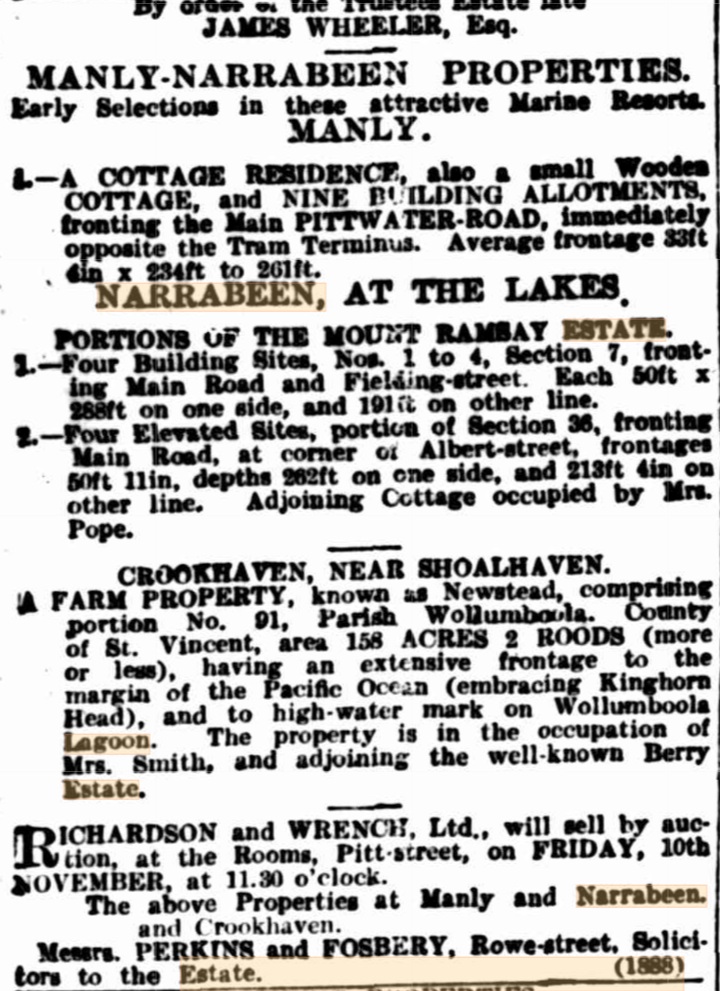
Advertising (1905, November 8). The Sydney Morning Herald (NSW : 1842 - 1954), p. 14. Retrieved from http://nla.gov.au/nla.news-article14730937
MRS. HANNAH WHEELER. Mrs. Hannah Wheeler, wife of Mr. George Wheeler, one of the older residents of Manly and district, died recently at her home Delmar, Pittwater-road, Deewhy. The Wheeler family have been landholders in the Manly, Deewhy, and Narrabeen districts since 1836, where the late Mr. James Wheeler made extensive purchases, the family being established at The Homestead, at the top of Narrabeen Lake. Mrs. Wheeler went to reside at Deewhy many years ago, when the coach was still the principal means of communication in the Warringah district. She leaves six sons and four daughters. The interment took place in the Manly Cemetery. MRS. HANNAH WHEELER. (1930, August 2). The Sydney Morning Herald (NSW : 1842 - 1954), p. 20. Retrieved from http://nla.gov.au/nla.news-article1669265
John Clarke
John Wetherill
Marriages:
70/1856 WETHERILL JOHN HOUSTON ELLEN ELIZA HANNAY SYDNEY
653/1863 WETHERILL JOHN HOLBORROW ELIZABETH AUSTRALIA SYDNEY
MARRIAGES. March 20th, at the residence of Mr. Hugh Houston, Macquarie street, by the Rev. G. H. Stanley B.A., Mr. John Wetherill, of George street, to Miss Ellen Eliza Houston. Family Notices (1856, March 21). The Sydney Morning Herald (NSW : 1842 - 1954), p. 8. Retrieved from http://nla.gov.au/nla.news-article12977938
Births: December 25, at her residence, 202, George-street, Mrs. John Wetherill, of a son. Family Notices (1856, December 29). The Sydney Morning Herald (NSW : 1842 - 1954), p. 1. Retrieved from http://nla.gov.au/nla.news-article12990630
Deaths: On Monday, the 7th instant, at 212, George-street, Hugh Houston Wetherill, infant son of John and Eliza Wetherill, aged eleven months. Family Notices (1857, December 9). Empire (Sydney, NSW : 1850 - 1875), p. 4. Retrieved from http://nla.gov.au/nla.news-article60265297
The couple had another son in 1858, John Walter Wetherill, who also became a draper. Unfortunately he died young, just 24 years of age, in 1883.
Some of his early business partnerships prior to going into business by himself:
DISSOLUTION
THE Partnership lately subsisting between the undersigned William Francis Pickering, John Wetherill, and Walter Hancock. carrying on business as Linen Drapers, at Brickfields Hill, in the City of Sydney, has been THIS DAY dissolved by mutual consent; and all debts due from and owing to the said Partnership will be paid and received by the said William Francis Pickering, who will continue to carry on the said business, at the premises aforesaid, on his own account.
Dated Sydney May 19th. 1855.
WILLIAM FRANCIS PICKERING,
JOHN WETHERILL,
WALTER HANCOCK.
Witness-James HUBBAND, 19, Pitt Street. Advertising (1855, May 21). Empire (Sydney, NSW : 1850 - 1875), p. 1. Retrieved from http://nla.gov.au/nla.news-article60179536
DISSOLUTION OF PARTNERSHIP_NOTICE is hereby given, that the partnership heretofore existing between us the undersigned JOHN WETHERILL, and JAMES WALTER HANCOCK, trading under the style or firm of Wetherill and Hancock, as Drapers, at Number 409 and 202, George street, in Sydney, has been this day dissolved by mutual consent. All debts due from and to the said co-partnership are to be paid and received by the said James Walter Hancock. Dated 31st January, 1857.
JOHN WETHERILL,
JAMES WALTER HANCOCK.
Witness-JAMES HUSBAND, Solicitor, Pitt-street. Advertising (1857, February 2). Empire (Sydney, NSW : 1850 - 1875), p. 1. Retrieved from http://nla.gov.au/nla.news-article60276103
Then Ellen passed away, very young:
DEATHS. On the 27th instant, at her residence, 307, George-street, Mrs. John Wetherill, in the 27th year of her age. Family Notices (1862, February 28). The Sydney Morning Herald (NSW : 1842 - 1954), p. 1. Retrieved from http://nla.gov.au/nla.news-article13225042
A little about Ellen's family. In 1862 the gold rush in Victoria brought thousands of immigrants, and with them, epidemics in the form of tuberculosis, smallpox, measles, chickenpox, cholera, whooping cough and influenza, . Just one month, for November 1862, lists 35 deaths in the town for 'epidemics'. Cholera and the measles feature heavily in the newspapers of mid 1862 and the years preceding these, while influenza appears from April on. It seems Ellens' mother, for whom she may have been named, could have been looking after her daughter and John Wetherill Jnr.:
HOUSTON—March 4th, Ellen, wife of Mr. Hugh Houston, resident surgeon, Sydney Infirmary, aged forty-nine years. Family Notices (1862, March 21). The Sydney Morning Herald (NSW : 1842 - 1954), p. 7. Retrieved from http://nla.gov.au/nla.news-article13226162
HOUSTON—August 21st, at the Sydney Infirmary, after a short illness, Hugh Houston, aged 51, having been upwards of twenty-one years resident surgeon of that institution. Family Notices (1866, September 22). The Sydney Morning Herald (NSW : 1842 - 1954), p. 7. Retrieved from http://nla.gov.au/nla.news-article13137263
FUNERAL.
THE Friends of Mr. HUGH HOUSTON, Surgeon, are respectfully invited to attend his Funeral, which will move from his late residence, North wing, Sydney Infirmary, Macquarie-street, THIS (Thursday) AFTERNOON, at 3 o'clock. R. STEWART, Undertaker, Bathurst and Pitt streets. Family Notices (1866, August 23). Empire (Sydney, NSW : 1850 - 1875), p. 8. Retrieved from http://nla.gov.au/nla.news-article60598670
In the Supreme Court of New South Wales.
ECCLESIASTICAL JURISDICTION.
In the will of Hugh Houston, late of Sydney, in the Colony of New South Wales, surgeon, deceased.
NOTICE is hereby given, that at the expiration of fourteen days from the publication hereof, application will be made to this Honorable Court, that probate of the last will and testament of the said Hugh Houston, deceased, be granted to John Williams and the Reverend Henry Gr. Stanley, the Executors therein named.—Dated this 27th day of August, a.d. 1866.
DEANE & DEANE,
Proctors for the Executors,
112, Elizabeth-street, Sydney. ECCLESIASTICAL JURISDICTION. (1866, August 28). New South Wales Government Gazette (Sydney, NSW : 1832 - 1900), p. 2008. Retrieved from http://nla.gov.au/nla.news-article225470876
THE SYDNEY INFIRMARY. -THE LATE HOUSE-SURGEON
TO THE EDITOR OF THE EMPIRE.
Sir,-As one of the executors of the late Dr. Hugh Houston, and, therefore, in some sense, a natural guardian of his memory, I beg leave to ofter one or two explanatory remarks on a portion of the evidence taken before the Weekly Committee of the Sydney Infirmary, and noticed in a recent issue of the Empire. A person named Mrs. Harrison states, amongst other things, that the "house-surgeon has neither butcher, baker, milk- man, grocer." The inference clearly intended to be drawn is, that Dr. Houston obtained supplies for himself and his family in some irregular if not dishonest way, at the expense of the institution.
The witness who makes the above assertions is flatly contradicted, as regards most of her statements, by various other witnesses, and both oral and document-ary evidence was brought before the committee to prove that the late Mrs. Ghost, the matron, had private accounts with the butcher and other tradesmen. Nothing, however, appeared in the published evidence to show that Dr. Houston and his family were regularly supplied by private tradesmen. A cruel wrong was hereby done, perhaps unintentionally, to the memory of one whom all acquainted with him know to have been the very soul of honour.
The simple facts of the case are these: Dr. Houston, after his wife's death, several years ago, feeling himself unfitted by his peculiar habits and disposition for looking after the petty details of house-keeping, was glad to avail himself of the kind offer of the matron to relieve him of such cares. His supplies were therefore ordered by the matron along with her own, and the bills made out to her, Dr. Houston settling with her privately from time to time.
On the general management of the institution I offer no opinion. There may have been, and still be abundant grounds for a searching inquiry ; but of this I am quite assured, that, by the sudden and lamentcd decease of Dr. Houston, the institution lost a devotcd and faithful servant, and that noblest work of God, a truly " honest man."
Dr. Houston did far more than mere duty required. A large file of letters, found amongst his papers, proved this - letters of thanks from former patients, or from the friends and surviving relatives of persons who had been under his care. One or more of these contained small remittances, in repayment of trifling expenses voluntarily incurred by Dr. Houston, for postage, etc.; and the nature of the man is seen from the fact that these remittances remained in their envelopes unappropriated. To have to defend the character of such a man is something like what the poet speaks of- "To gild refined gold, to paint the lily, or throw a perfume on the violet.''
l am, Sir. yours faithfully.
G. H. STANLEY. Paddington, October 22. THE SYDNEY INFIRMARY.—THE LATE HOUSE-SURGEON. (1866, October 24). Empire (Sydney, NSW : 1850 - 1875), p. 8. Retrieved from http://nla.gov.au/nla.news-article60601479
In the Supreme Court of New South Wales.
ECCLESIASTICAL JUBISDICTION.
In the will of Bathsheba Ghost, late of the City of Sydney, in the Colony of New South Wales, widow, deceased.
NOTICE is hereby given, that after the expiration of fourteen days from the publication hereof, application will be made to the Supreme Court of New South Wales, in its Ecclesiastical Jurisdiction, that probate of the last will and testament of the abovenamed Bathsheba Ghost may be granted unto Matthew Henry Stephen and Hugh Houston, both of the City of Sydney, Esquires, the Executors named in the said will.—Dated this 17th day of August, a.d. 1866.
JOHN SMITH,
Proctor for the said Executors,
18, O'Connell-street, Sydney. ECCLESIASTICAL JURISDICTION. (1866, August 17). New South Wales Government Gazette (Sydney, NSW : 1832 - 1900), p. 1941. Retrieved from http://nla.gov.au/nla.news-article225470505
Mr. William Houston.
The Department of Crown Lands is a huge one — the largest in the State. No fewer than 716 officers are employed in it, exclusive of contract surveyors and others numbering about 367, and its revenue last year amounted to £2,147,211 ; and the building in Bridge-street (and three other streets) in which the business of the Department is transacted is the largest and finest of the buildings used as Government offices. The pile in Macquarie and Phillip streets is shared 'by the Chief Secretary and the Minister for Public 'Works and their staffs ; and even that big building is less imposing than the colossal structure occupied by the Minister for Lands and his army of ' officers.' The exterior of this great building is an interesting study, with its numerous niches, containing the statues of men whose names are racy of the soil of New South Wales — Mitchell, Blaxland, Lawson Mr. William Houston, Cunningham, Wentworth, Leichhardt, Robertson, and the rest.
The boy who should set about knowing something of all the men who have niches in front of the Crown Lands Office, would, incidentally, learn an abundance of the history and geography of the mother colony of Australia. The permanent head of a department like that of the Crown Lands must be an important officer of state. The amount of business which is daily transacted within the four walls of that great building in Bridge-street is enormous. The Under-Secretary himself works 12 hours a day. The branch offices of the Lands Department, which number 109, are found in nearly all the principal towns of the colony. Mr. William Houston, the Under-Secretary for Lands, was born in Sydney in 1847. He is a son of the late Dr. William Houston, formerly a well-known medical practitioner in Sydney, and a nephew of Dr. Hugh Houston, for many years resident physician and surgeon at the Sydney Hospital. Mr. Houston received his early education at the school of Dr. Creeny, where, for several 3-ears, he enjoyed the distinction of being dux. He left Dr. Creeny's at an early age, and subsequently read classics and higher mathematics with the late Mr. Stanley, LL.D. Mr. Houston turned his attention to medicine when very young, but immediately acquired a strong dislike for the profession of his father and his uncle, and abandoned the idea of ever becoming a doctor.
On April 1, 1863,he entered the Surveyor-General's office as a cadet, at the suggestion of the late Sir John Robertson, then Minister for Lands, and a friend of the Houston family. He passed through the various branches of this office, which in a few years after the passing of the Land Act of 1861 expanded very rapidly and became one of the most important and extensive departments under the Government. He was appointed in 1875 to the charge of an important branch of the Surveyor-General's Office, having a large staff of draftsmen and clerks under him. Mr. Houston was first allotted special duty in 1876, in connection with the preparation of preliminaries of revocation and opening to conditional ' purchase the Yanko and Colombo Reserves, which contained some of the most fertile country of the Riverina Plains. He subsequently proceeded to Urana as representing the Surveyor-General at the opening of the reserves for selection, and received warm commendation from the then Minister for Lands (Mr. T. Garrett) and the Surveyor-General for the efficiency which characterised all the arrangements.
In 1878, a new method of dealing with the business of the Surveyor-General's office — a large part of which being as the law was then constituted, of an administrative character — was proposed by the then Deputy Surveyor-General, the late Mr. R. G. D. Fitzgerald. Mr. Houston was selected to initiate and take charge of an experimental division organised on the new lines. The experiment was so successful that some two years later Mr. Houston was given the task of remodelling the entire office with similar divisions, which were placed in the charge of the best officers obtainable. The system proved an excellent preparation for the decentralised form of administration which followed upon the introduction of the Crown Lands Act of 1884.
In 1883 Mr. Houston was appointed with a former Under-Secretary, Mr. S. Freeman, to assist the commission created by the Stuart Government, consisting of Messrs. G. Ranken and A. Morris, to inquire into the operation of the land laws. The commission was issued on January 8, 1883, and the report, which contained much valuable information, placed in the hands of the Government on April 12 following. Later on Mr. Houston was called on to assist with the Land Bill introduced by Mr. J. S. Farnell in 1883, which came into operation on January 1, 1885. In the latter year Mr. Houston was appointed Inspector of Local Land Board and Crown Land Offices, and under the then Under-Secretary for Lands, Mr. Charles Oliver, was given the important duty of carrying into effect the provisions of the Land Act relative to the division of the pastoral runs. This operation was, in fact, the pivot of the act, and it had been prophesied the measure would never come into operation, or that years would elapse before the completion of this work. The bulk of the divided runs were, however, gazetted- in July and August, 1885, and the work was practically completed in September of the same year. This work, in view of its importance to the state at the time, and its dimensions, represents probably one of the greatest undertakings the which have ever fallen to the lot of any government department in the colonies.
In 1886 Mr. Houston was promoted to the position of chief inspector of the Lands Department and appointed acting chairman of local land boards during the absence from duty for several months of one of these officers. In November, 1886, he was appointed to further special and important duty. He was nominated by Mr. Copeland, then Minister for Lands, a member of a commission of inquiry, consisting with him of Mr., W. H. Traill M.L.A. for South Sydney, and the late Mr. R. G. D. Fitzgerald, Deputy Surveyor-General, to inquire into the organisation and working of the Lands Department with the view to general retrenchment. This idea originated with, and the appointments were made by the recent Minister for Lands, Mr. Copeland, then presiding over the Lands Department for the first time. The result of this inquiry, which was carried through with great rapidity, was an entire reconstruction, of the head office branches and staff, by which only the best officers were retained, the positions re-allotted, and the salaries of all adjusted to the nature and value of the duties required to be performed j the result, according to the printed papers, being that an annual saving of £73,390 in salaries was made.
In 1887 another board, consisting of Mr. Houston, the chairman of the local land board (the late Mr. Conder), and Mr. B. M'Donald, district surveyor, was appointed by Mr. Thomas Garrett, then Minister for Lands, to continue this work in the Country Land Board and District Survey offices, and all other offices under the control of the Lands Department. This resulted in a further animal saving in salaries of £30,000 and in 'contingencies' of £30,000, making in all £140,000, besides which improved methods of business, and a more uniform system of administration were secured. Some such way is the only method to go about retrenchment and reorganisation, as on the one hand thoroughness, efficiency, and economy are secured to the public ; while on the other, the employees are protected by the searching nature of the inquiry and the recommendations of a body thoroughly conversant with the business and the best means of securing an efficient management.
In 1888 Mr. Houston was appointed Assistant Under-Secretary for Lands, and in 1889 prepared the draft of the Land Bill of that year, under the direction of Mr. Brunker, the then Minister for Lands. Mr. Houston was appointed, in January, 1890, Under-Secretary for Lands, by the Government of Sir Henry Parkes, and in April of that year submitted a scheme, which was approved by Mr. Brunker, for a further reorganisation of the administrative divisions of the department. This scheme provided for the partitioning of the work into three main divisions, presided over by responsible officers of ability and experience qualified to advise and direct the public. It also had for its aim the encouragement of officers to take more direct responsibility, with a Mew to expediting business, than had formerly been the custom, subject, however, to certain safeguards. Judging from the expression of satisfaction received by the Undersecretary from time to time, tins system meets with the approval of the public, and is considered highly satisfactory.
Mr. Houston has found time to do a little soldiering. He held a commission as lieutenant in the Artillery Brigade from 1864 to 1880. In 1875 he acted as adjutant at the Campbelltown encampment. He is fond of all field sports, is a good shot, and was almost continually on the water in sailing boats and yachts until prevented by the press of official duties. He is also an omniverous reader, but finds that the pressure of duties at the Lands Office is now so heavy and continuous as to render systematic reading, such as he formerly pursued, impossible. In private life Mr. Houston is quiet, genial, and affable, and is sincerely valued as a friend. Mr. William Houston. (1894, March 1). Evening News (Sydney, NSW : 1869 - 1931), p. 3. Retrieved from http://nla.gov.au/nla.news-article114070678
NSW Births, Deaths and Marriage records show he was born in 1846, the eldest son and first child.
His father, brother of Hugh, had predeceased him in December 1862, the 1862 that took his cousin and aunt. Maria Jane (nee Hemming) is his step-mother, whom his father married in 1858. His mother was Mary Anne (nee Harris - married William in 1845). Mary Anne Houston died in 1857:
DEATHS.
On the 28th instant, at his residence, 267, Castlereagh-street, William Houston, Esq., surgeon, aged 45. Family Notices (1862, December 29). The Sydney Morning Herald (NSW : 1842 - 1954), p. 1. Retrieved from http://nla.gov.au/nla.news-article13071730
FUNERAL.-The Friends of the late WILLIAM HOUSTON, Esq., (Surgeon), are hereby respectfully informed, that his Funeral will take place, THIS AFTERNOON ; to move from his late residence, 257, Castlereagh-street, at 4 o'clock precisely. CHARLES BEAVER, Undertaker, St. James' Church, King-street.
Volunteer Office, Sydney, 29th December, 1862. BATTALION ORDER. - Agreeably with this day's Brigade Order, the Sydney Battalion will Parade at Hyde Park Barracks, at 3-35 p.m. TO-MORROW (Tuesday), to attend the FUNERAL of the late Assistant-Surgeon HOUSTON, and will move from his late residence, Castlereagh -street, at 4 p.m. By order. THOMAS BAYNES, Lieutenant-Adjutant Sydney Battalion Volunteer Rifles.
VOLUNTEER ARTILLERY-The Volunteer Artillery will PARADE at three p.m. THIS DAY (Tuesday), Inner Domain, full uniform, without carbines, for the purpose of attending the FUNERAL of the late Assistant-Surgeon Houston, Volunteer Rifles, P. L. C. SHEPHERD, Captain, Assistant-Inspector Volunteer Artillery.
VOLUNTEER RIFLE BAND.-The Members are requested to assemble at Hyde Park Barracks, THIS AFTERNOON, at 3 o'olock, to attend the FUNERAL of Assistant-Surgeon HOUSTON. D. CALLEN, Director. Family Notices (1862, December 30). Empire (Sydney, NSW : 1850 - 1875), p. 8. Retrieved from http://nla.gov.au/nla.news-article60520902
In the Supreme Court of New South Wales.
ECCLESIASTICAL JURISDICTION.
In the goods of William Houston, late of Castlereagh-street, in the City of Sydney in the Colony of New South Wales, surgeon, deceased.
NOTICE is hereby given, that fourteen days after the publication hereof, application will be made to this Honorable Court, in its Ecclesiastical Jurisdiction, that letters of administration of the goods, chattels, credits and effects, of the abovenamed William Houston, may be granted to Maria Jane Houston, his widow.—Dated this thirtieth day of December, 1862.
ROWLEY, HOLDSWORTH, & GARRICK,
Proctors for the Applicant.
120, Elizabeth-street, Sydney. ECCLESIASTICAL JURISDICTION. (1863, January 2). New South Wales Government Gazette (Sydney, NSW : 1832 - 1900), p. 7. Retrieved from http://nla.gov.au/nla.news-article225239366
Tragically Maria gave birth to a child that year too:
HOUSTON—On the 30th April, at her residence, 237, Castlereagh-street, the wife of William Houston, Esq., surgeon, of a son. Family Notices (1862, May 21). Empire (Sydney, NSW : 1850 - 1875), p. 4. Retrieved from http://nla.gov.au/nla.news-article60475687
HOUSTON ALFRED J H1048/1862 WILLIAM MARIA J SYDNEY
What he was responsible for in 1862:
SYDNEY INFIRMARY and DlSPENSARY.
The public are informed that the Wards and Districts described below as PADDINGTON, and REDFERN und GLEBE WARDS, have been apporiined respectively to Messrs. W. HOUSTON and GILHOOLEY, Surgeons, who will he in attendance at the Dispensary daily, between the hours of 3 and 3 p.m., to prescribe for necesaitous cases within their wards or districts.
PADDINGTON WARD-W. Houston, Esq, Surgeon.
Bounded on the north by Upper William-street, commenoing at its intersection with Victoria-street, and along its continuation as the New South Head Road to Its intersection with the Point Piper Road.
Bounded on the east by the Point Piper Road, commencing at its intersection with .the New South Head Road, and ending at its intersection with the Old South Head Road.
Bounded on the south by a line running west-south west at the rear of the' Victoria -Barracks, across the Randwick Road-to Baptist's residence at the south end of Bourke-street.
Bounded on the west by a line running north from' Baptist's residence along the east side of Bourke-street to Arthur-street,' and thence down Darling-street into Victoria-street, and along it northerly to its intersection with Upper William-street, the point of departure.
REDFERN and GLEBE WARD-J. C. Gilhooley. Esq, surgeon.
Bounded on the north by a line commencing at the boundary stone at the intersection of Cleveland and Elisabeth streets; running thence west along Cleveland street and its proposed continuation to Newtown Road ; thence from-the Newtown Road by Bay-street] to Blackwattle Swamp' Cove, and thence along' the south-west shore of that cove to the Glebe Point.
Bounded on-the west by a line running east from Glebe Point by the south side of Toxteth Park and the Bishopthorpe Estate to the intersection of the proposed continuation of Cleveland-street with Newtown Road, and thence by the Newtown Road to the Toll-gate.
Bounded on the south by a line running east from the Newtown Toll-gate through Calder House property, and thence to the south side of Mount Lachlan.
Bounded on the east by a line running north from the south side of Mount Lachlan and along the proposed continuation of Elizabeth-street to its intersection with Cleveland-street at the Boundary Stone, the point of departure.
To' which is added the following portion of Phillip and Denison Wards, to the south of the following lines, commencing at : the intersection of Elizabeth and Devonshire streets, thence along Devonshire-street to Parramatta-street, along Parramatta-street ' to Harris-street, along Harris-street to the south enclosure of Ultimo House; thence a line -from Harris-street passing in a westerly direction the southern enclosure of Ultimo House to the Bay.
JOHN DOUGALL, M. H. STEPHEN. Joint Hon. Secretaries. Advertising (1862, May 14). Empire (Sydney, NSW : 1850 - 1875), p. 1. Retrieved from http://nla.gov.au/nla.news-article60475350
You can read more about James Charles Gilhooley (1825-1886) here and here, and his wife, Mary Ann Agnes (1835–1916) here.
His first marriage:
MARRIED. On the 13th instant, by special license, by the Rev. Dr. McGarvie, William Houston, Esq., Surgeon, to Mary Ann, only daughter of Mr. William Harris, of Hunter-street, Sydney. Family Notices (1845, August 14). The Sydney Morning Herald (NSW : 1842 - 1954), p. 3. Retrieved from http://nla.gov.au/nla.news-article12881497
Rev. Dr. John McGarvie was the second Presbyterian minister in colonial Sydney, the first incumbent at Pitt Town and Ebenezer, and of St Andrews Scots Church. While living in the area, he recorded the names of places along the Hawkesbury River, or Dyarubbin, that local Aboriginal people shared with him. His papers are held in the Mitchell Library, State Library of NSW. He was a writer for the Sydney Gazette and New South Wales Advertiser and a Journalist for the Sydney Morning Herald. He was the Minister of religion Ebenezer Uniting Church 1826 - 1830, Founder of the Sydney Infirmary and Dispensary in 1826, Committee member of the Sydney Infirmary and Dispensary 1826 - 1853, Minister of religion; Scots Church and Assembly Hall 1830, Minister of religion; St Andrew's Scots Presbyterian church 1832 - 1853, Founder; Sydney Mechanics' School of Arts 1833.
The Sydney Infirmary and Dispensary Clinic was created in 1826 to provide outpatient care for 'free poor persons, unable to pay for medical attendance'. It operated from several city premises before obtaining occupancy at the Rum Hospital.
The hospital was constructed between 1811 and 1816 by convict labour. The British government did not pay for it, as Macquarie had turned to three of Sydney's entrepreneurs for funding: Garnham Blaxcell, Alexander Riley and D'Arcy Wentworth. It was commonly referred to as the Rum Hospital, because the contractors were given a limited monopoly on the distribution of spirits in the colony, in return for building it. Initially, the hospital was too big for the population of Sydney, and the northern and southern wings, originally intended as accommodation for the surgeon and assistant surgeon, were eventually given over to other uses. However, buildings on the site of the central wing have been in continuous use as hospital wards from the time of the hospital's completion in 1816.
The hospital was criticised because it was considered shoddily constructed and structurally unsound. The convict architect Francis Greenway was appointed to oversee extensive repairs to the three wings during the 1820s.
The central wing of the hospital was initially used for the treatment of convict patients. In 1826, the Sydney Dispensary was formed. It was a charitable organisation for the treatment of paupers, both free settlers and ex-convicts, and it was housed in the southern hospital wing (the building which is now the Mint). With the end of transportation in the 1840s, and the subsequent dissolution of the convict medical system, the Sydney Infirmary and Dispensary, as it was then known, moved from the southern wing to take over the central wing. In 1844 it changed its name from the Sydney Dispensary to the Sydney Infirmary and Dispensary, and in 1881 became the Sydney Hospital.
By the 1850s, the hospital, now comprising only the main central wing, was outgrowing its space. In the 20 years from 1857, a number of buildings were constructed in the hospital grounds behind the central wing for offices, wards and staff accommodation. In 1869, the Florence Nightingale wing was built to a design by the Cornish architect Thomas Rowe to provide accommodation for a group of trained Nightingale nurses led by Lucy Osburn. This is now the oldest building on the hospital grounds. - From: Ellmoos, Laila, Sydney Hospital and Eye Hospital, Dictionary of Sydney, 2008, http://dictionaryofsydney.org/entry/sydney_hospital_and_eye_hospital
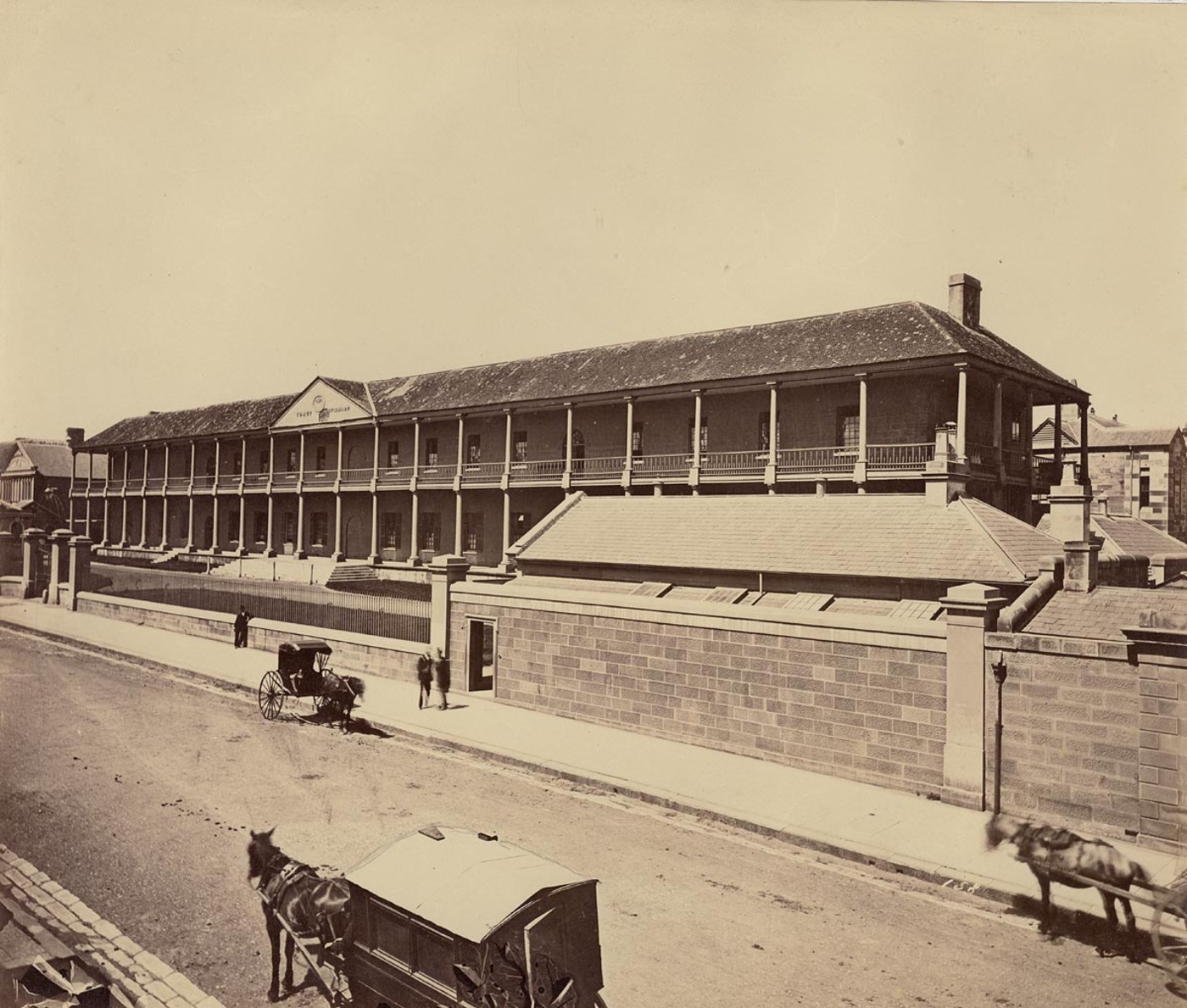
Sydney Infirmary, Macquarie Street 1870, By Charles Percy Pickering. From the collections of the State Library of New South Wales [a089176 / SPF/176]
Hugh and William Houston were both born in Ballyclare, County Antrim, Ireland on 1815 to William HOUSTON and Jane McAMONT. Dr Hugh HOUSTON. MD (registered in 1839) passed away on 21 Aug 1866 in Sydney Infirmary Sydney. Reg: 1092. Parents: William Houston (1773 - October 22nd, 1841) Jane Mcamont (1777 - 1839)
William Houston (1817–1862). Born 1817 in Antrim, Ireland. Died. 28 December 1862. Maria Jane Holt, who married William Houston, is the 5th daughter of Joshua Holt whose father was transported for being a 'General' at Vinegar Hill, 1898, in Ireland.
But wait, there's more - Australia was Federated and finally had a Federal Government in 1901:
MR. WILLIAM HOUSTON, C.M.G.
Mr.'.William Houston, who was recently created CM.G., is one of the Commissioners of the Land,-Appeal Court of New South Wales, and is Deputy Governor of Norfolk Island. Born in Sydney in 1847, he is a son of the late Dr. William Houston, a well-known Sydney medical practitioner, and a nephew of Dr. Hugh Houston, for many years resident physician and surgeon at the Sydney Hospital.
....
His work as Under-secretary received the highest encomiums; and it was, therefore, only a natural corollary that he was selected to fill the important position of Commissioner of the Land Appeal Court. This was in 1900, and two years later he was appointed by the Governor, Sir Harry Rawson, to be Deputy Administrator of Norfolk Island. Under the same instrument he was made a Commissioner to conduct inquiries into such matters as the Governor might direct; and in 1903 he was accordingly dispatched to the Island to inquire into the causes of unrest. This occupied some weeks' painstaking inquiries, after which Mr. Houston furnished a voluminous report to His Excellency, which enabled him shortly after reading it to announce his intentions in no uncertain tones, and with such sound judgment and tact as to at once dispel hostile feeling, and gain the confidence of the people. Of his services as Deputy Administrator, Mr. Houston has from time to time received generous acknowledgment from Sir Harry Rawson.
Among other public duties which Mr. Houston carried out was the subdivision of the State of New South Wales into divisions in accordance with the Commonwealth electoral law. His report was described as "a monument of skill and care," and of his whole, public career of over forty years the dominant features have been characteristic conscientiousness and great determination and strength of character.
In 1896 and in 1897 he served as a Deputy Public Service Commissioner, and at the present time is a trustee of the Sydney Cricket Ground and managing trustee of the historical Captain Cook's landing place at Kurnell, Botany Bay.
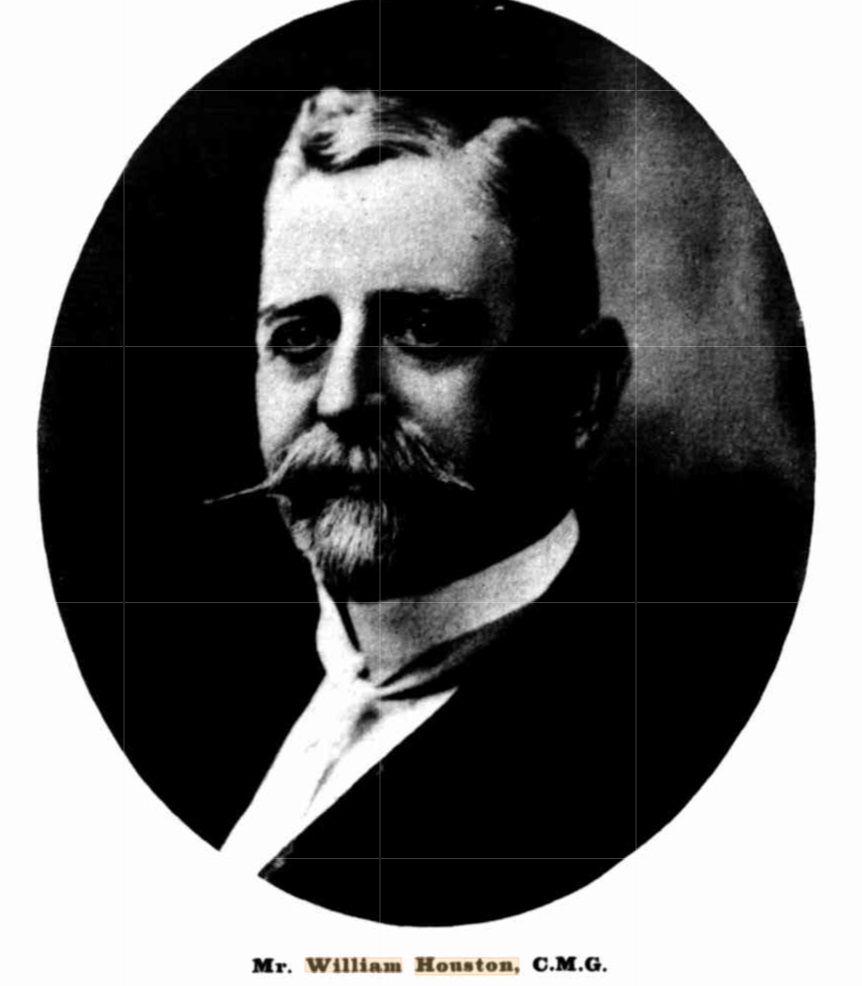
Prom 1864 to 1880 Mr. Houston held a commission as lieutenant in the Artillery Brigade, and in 1875 acted as Adjutant at the Campbelltown encampment. He is a lover of field sports and boating; and in his early days was considered a crack open-boat sailer, and was also keen on athletics, and excelled at boxing and fencing. An omnivorous reader, Mr. Houston is reserved in disposition, but possesses a faculty of making lifelong friendships, and has a quiet, genial manner, which makes him a pleasant and interesting companion. MR. WILLIAM HOUSTON, C.M.G. (1906, December 5). Australian Town and Country Journal (Sydney, NSW : 1870 - 1907), p. 22. Retrieved from http://nla.gov.au/nla.news-article71543483
The Most Distinguished Order of Saint Michael and Saint George is a British order of chivalry founded on 28 April 1818 by George, Prince Regent, later King George IV, while he was acting as regent for his father, King George III. It is named in honour of two military saints, St Michael and St George. Originally awarded to those holding commands or high position in the Mediterranean territories acquired in the Napoleonic Wars, it was subsequently extended to holders of similar office or position in other territories of the British Empire. It is at present awarded to men and women who hold high office or who render extraordinary or important non-military service in a foreign country, and can also be conferred for important or loyal service in relation to foreign and Commonwealth affairs.
The Order includes three classes, in descending order of seniority and rank:
- Knight Grand Cross or Dame Grand Cross (GCMG)
- Knight Commander (KCMG) or Dame Commander (DCMG)
- Companion (CMG)
HOUSTON ?
In reply to reader: — The Houstons did not begin with this surname. Their first was Paduinan which may not look Scotch but is, and so is Houston. At least they were Scottish place-names, or become such. The story of the surname begins with one Hugh de Paduinan, who had that name from a place In Lanark. This was seven hundred years ago, and he acquired a parish called Kil-peter, or the cell of Peter. Having done this he built his seat there and himself called it Hugh's-Town. That is how Houston in Renfrewshire got Its name, and, the descendants of, this Hugh de Paduinan carried forward Houston as -their surname.
There appears to be no representative In the direct line from the Hugh de Paduinan, who founded the town and the surname. The ancient family of the Houstons of Renfrewshire derived from the second son of Sir Lurovic Houston of that ilk. The Houstuns of Cotrioch were hereditary bailees and justiciaries of the baronies of Busbie, Wigtownshire, and of Caldorhall, Midlothian. Although the spelling varies, General Sir William Houston, the first baronet, represented this family. The second baronet, who assumed the additional name of Boswell, also appears to have preferred to spell the surname as Houstoun.
The name spread extensively. Most of the Houstons In the United States, where the name has been a healthy growth, could doubtless find a link with Scotland somewhere. It has also been u notable name In Ireland. At the beginning of the last century John Houston, who was curator of the Dublin College of Surgeons, had a considerable reputation as an anatomist. Two hundred years ago Richard Houston was a noted engraver, and examples of his work are now eagerly sought after by collectors. Sir Robert Paterson Houston, who was millionaire shipowner and represented the West Toxtcth division in Parliament for thirty-two years, was born in Liverpool. He was the first and last baronet. His widow, Lady Houston, who became a Dame of the British Empire five years ago, has become famous for her philanthropies. Her first husband was the ninth Lord Byron. Lady Houston provided the funds which enabled Britain to retain the Schneider Trophy last year, and she founded the first Rest Home for Nurses. Sir Thomas Houston Is an eminent pathologist and Director of the Clinical Laboratories in the Belfast Royal Victoria Hospital. Sir Alexander Houston has been director of water examinations to the Metropolitan Water Board for more than a quarter of a century. HOUSTON ? (1932, September 27). The Telegraph (Brisbane, Qld. : 1872 - 1947), p. 10 (FINAL). Retrieved from http://nla.gov.au/nla.news-article181159533
FUNERAL.-The Friends of Mr. JOHN WETHERILL are hereby respectfully informed that the Funeral of his beloved WIFE will take place on SATURDAY Afternoon. To move from her late residence, George-street, At 3 o'clock. No circulars will be issued. CHARLES BEAVER, undertaker, St. James' Church, King-street. Family Notices (1862, February 28). The Sydney Morning Herald (NSW : 1842 - 1954), p. 8. Retrieved from http://nla.gov.au/nla.news-article13225027
Houston, a village in the council area of Renfrewshire and the larger historic county of the same name in the west central Lowlands of Scotland, grew around a 16th-century castle and parish church dedicated to Saint Peter, which gave the area its former name of Kilpeter ("Cille Pheadair" in Scottish Gaelic). In the mid 12th century, the fee of Kilpeter was granted by Baldwin of Biggar, Sheriff of Lanark, to Hugh of Pettinain. From Hugh, the lands eventually became known as Houston (meaning "Hugh's tun or manor").
Other sources state:
Sir Hugh de Paduinan (1140 – 1189) was a Scoto-Norman baron, Knight Templar and progenitor of the Clan Houston. Both Sir Hugh's given name and surname are subject to a number of different spellings: Hugh or Hugo and Paduinan, Padinan and Padvinan.Sir Hugh was born in 1140 of Anglo-Norman ancestry. He is believed to have married a Scottish lord's daughter, and his heir was his son Reginald. He was a follower of Sir Walter Fitzalan (a twelfth-century Scottish magnate and Steward of Scotland who was a minor English baron, but on arriving in Scotland received a substantial grant of lands from his Scottish sovereigns including the western provincial lordships of: Mearns, Strathgryfe, Renfrew and North Kyle.
Both Sir Hugh and his descendants often arise as signatories of deeds, particularly pertaining to Scottish churches. He died in 1189 in the Holy Land, possibly amongst the Templars who were killed at the Battle of Hattin.
During the reign of Malcolm IV of Scotland Sir Hugh was granted the lands of Kilpeter, around the modern parish of Houston and Killellan in the west-central Lowlands of Scotland county of Renfrewshire, by Baldwin of Biggar, the Sheriff of Lanark. Baldwin may have been Sir Hugh's father in law. His descendants remained the Lairds of Houston until 1740, where the lands were sold to Alexander Speirs of Elderslie, a Glasgow tobacco lord.
John Wetherill remarried:
On the 18th instant, by special license, at St. Philip's Church, by the Very Rev. Dean of Sydney, Mr. John Wetherill to Elizabeth Australia, eldest daughter of Mr. D. Holborow, of Sydney. Family Notices (1863, August 22). The Sydney Morning Herald (NSW : 1842 - 1954), p. 1. Retrieved from http://nla.gov.au/nla.news-article28620832
On Saturday, the 19th instant, at her residence, Lincolnshire House, George-street, Mrs. John Wetherill, of a daughter. Family Notices (1864, November 22). The Sydney Morning Herald (NSW : 1842 - 1954), p. 1. Retrieved from http://nla.gov.au/nla.news-article30934997
The children of this second union:
WETHERILL MARY J 2340/1864 JOHN ELIZABETH A SYDNEY
WETHERILL DANIEL H 937/1866 JOHN ELIZABETH SYDNEY
WETHERILL AMY L 2626/1868 JOHN ELIZABETH A BALMAIN
WETHERILL WILLIAM E 3020/1869 JOHN ELIZABETH A BALMAIN
WETHERILL ARTHUR E 3119/1871 JOHN E ELIZABETH A BALMAIN
WETHERILL FRANK F J 3224/1875 JOHN ELIZABETH A BALMAIN
WETHERILL ALBERT 3713/1878 JOHN ELIZABETH A BALMAIN
WETHERILL RUBY LOUISE 3737/1880 JOHN ELIZABETH A SYDNEY
WETHERILL PERCY G 15121/1883 JOHN ELIZABETH A CENTRAL
CUMBERLAND
Deaths:
WETHERILL STEPHEN H1590/1870 JOHN ELIZABETH A BALMAIN
WETHERILL AMY L1625/1868 JOHN ELIZABETH A BALMAIN
On the 21st April, at Elswick House, Petersham, the wife of John Wetherill, of a son. Family Notices (1871, May 5). Empire (Sydney, NSW : 1850 - 1875), p. 1. Retrieved from http://nla.gov.au/nla.news-article60871751
WETHERILL.—January 19, at her residence, Elswick House, Petersham, the wife of John Wetherill, of a son. Family Notices (1875, February 4). The Sydney Morning Herald (NSW : 1842 - 1954), p. 1. Retrieved from http://nla.gov.au/nla.news-article13350989
WETHERILL.—May 27, Petersham, Mrs. J. Wetherill, son. Family Notices (1878, June 20). The Sydney Morning Herald (NSW : 1842 - 1954), p. 8. Retrieved from http://nla.gov.au/nla.news-article13419072
WETHERILL.—June 3, at her residence, Elswick House, Petersham, the wife of John Wetherill, of a daughter. Family Notices (1879, June 20). The Sydney Morning Herald (NSW : 1842 - 1954), p. 1. Retrieved from http://nla.gov.au/nla.news-article13437037 - NSW BDM's: WETHERILL RUBY LOUISE 3737/1880 JOHN ELIZABETH A SYDNEY
A little about Elizabeth Australia's family:
DEATH OF MR. DANIEL HOLBOROW.
Mr. Daniel Holborow, a oolonist of over 50 years' standing, died at his residence. Gads-hill, Croydon, shortly after half-past 4 on Tuesday afternoon. The deceased gentleman, who had been unwell for some time, appeared to be unable to withstand the great heat experienced on Monday last, and gradually sinking, expired as stated above. Mr. Holborow's medical attendant was Dr. Sydney Jones, but he had lately been attended by Dr. Jones, of Ashfleld.
The deceased gentleman was born in 1818 near Wootton-Underedge, Gloucestershire, England. In 1839, having attained his majority, he came to this colony. In 1850 he paid a visit to England, where he resided for four years while the education of his two surviving children was being completed. A second visit to the old country was paid in 1865. He was well and honorably known in Sydney business circles having for many years conducted an extensive drapery business at the corner of George and Wynyard streets. He had resided at Gads-Hill, Croydon, for some 25 years.
For 15 years he was an alderman of Ashfield, and occupied the Mayoral chair of that borough for eight successive years, receiving a handsome testimonial of his ability on leaving office. During his Mayoralty the rates were increased from £500 to about £13,000. In 1887 he was requisitioned by a large number of the electors of Canterbury to stand as the Parliamentary representative of that district. He consented, and was accorded very warm support; but, Sir Henry Parkes being defeated for East Sydney, several of that gentleman's supporters prevailed upon Mr Holborow to retire in his favor. Mr. Holborow had always taken a lively interest in the welfare of the borough in which he resided, and yesterday nearly the whole of the townspeople veiled their windows as a mark of respect. The exterior of the Ashfleld Town-hall, also, was draped with crape, and flags were flown at half mast. The deceased gentleman leaves, in addition to his widow, three children, Colonel W. H. Holborow, C.M.G., of Richmond, Mrs. J. Wetherill, of Devon, Randwick, and Miss Holborow, of Croydon. The remains will to-day be conveyed to the family vault at Rookwood. The deceased gentleman died in his 78th year. DEATH OF MR. DANIEL HOLBOROW. (1896, January 10). Goulburn Herald (NSW : 1881 - 1907), p. 3. Retrieved from http://nla.gov.au/nla.news-article101103378
THE FRIENDS of Mr. and Mrs. JOHN WETHERILL are kindly invited to attend the Funeral of the late DANIEL HOLBOROW, beloved father of Mrs. Wetherill ; to leave his late residence, Edwin-street, Croydon, THIS DAY, Thursday, at 1.30 pm , to St James' Church, thence by funeral train to Necropolis. Family Notices (1896, January 9). The Sydney Morning Herald (NSW : 1842 - 1954), p. 8. Retrieved from http://nla.gov.au/nla.news-article14032625
Obituary.
THE death occurred at his late residence, Gad's Hill, Croydon, on Tuesday evening last, of Mr Daniel Holborow, father of Colonel Holborow, C M G., of Richmond. The deceased was 78 years of age, and had lived an active life. Mr Holborow was for 14 years a member of the Ashfield Council, and for eight consecutive years he was Mayor of the Borough. He arrived in Sydney by the ship Annie Watson in the early part of 1839. He visited England in 1856, and returned to the colony in 1860. In 1865 he went to England again, and remained there 12 months. On his return to Sydney in 1866 he purchased the property known as "Gad's Hill," Croydon, where he afterwards resided. He took great interest in local affairs, and on retiring from the Mayorality in 1881 he was presented with an illuminated address. In 1877 he was nominated as a candidate for the Legislative Assembly for Canterbury, but retired in favor of Sir Henry Parkes. Mr Holborow had been in failing health for some time, and the great heat of Monday hastened his end.
The funeral took place on Thursday, and was largely attended. The chief mourners were Colonel Holborow, C.M.G., Colonel Burnet, and Messrs J Wetherill (Randwick), D Wetherill (Randwick), Grantley Holborow, D Holborow, A Wetherill. H Hillier, S E Lees, M.L.C., F E Dixon, and R Bone. The floral tributes of sympathy forwarded were so numerous that a special carriage was necessary to bear them. Among the many handsome tokens sent were wreaths from Colonel Holborow and family, Mr and Mrs Hudson and family, Mrs A S Low, Mr and Mrs Sydney Bull, Mr and and Mrs Wetherill, Mr and the Misses Hillier, the Misses Wetherill, Mr and Mrs S H Carey, Mr F E Dixon, Miss Holborow, Mrs Pearce (Randwick), Mr and Mrs W Garey, Mr and Mrs Quong Tart, Mrs Hezlet, Mrs Simpson, Mr W Hudson and family, Mr and Mrs Bone, Mrs Clissold and the Mayor and Aldermen of Ashfield. Obituary. (1896, January 11). Windsor and Richmond Gazette (NSW : 1888 - 1961), p. 4. Retrieved from http://nla.gov.au/nla.news-article72547556
On the 24th March, at Bristol House, 512, George-street, Emily Jane, aged thirteen months, infant daughter of Daniel and Mary Holborow. - 1854
wife died: HOLBOROW MARY J 568/1900 RICHARD MARY ASHFIELD
HOLBOROW.—The Friends of Mr. J. HILLIER are kindly invited to attend the Funeral of his late SISTER, Mrs. Mary J. Holborow ; to move from her residence, Gad's Hill Villa, Edwin-street, Croydon, TO-MOR-ROW (Wednesday) MORNING, at 9.20, for the Necropolis. HENRY HART and SON, Undertakers, Ashfield.
HOLBOROW.—The Friends of Mrs. J. WETHERILL are kindly invited to attend the Funeral of her late MOTHER, Mrs. Mary J. Holborow; to move from her residence, Gad's Hill Villa, Edwin-street, Croydon, TO-MORROW (Wednesday) MORNING, at 9.20, for the Necropolis. HENRY HART and SON, Undertakers, Ashfield.
HOLBOROW.—The Friends of Miss LOUISE HOLBOROW are kindly invited to attend the Funeral of her late MOTHER, Mrs. Mary J. Holborow, to move from her residence Gad's Hill Villa, Edwin-street, Croy-don, TO-MORROW (Wednesday) MORNING, at 9.20, for Necropolis. HENRY HART and SON, Undertakers, Ashfield.
HOLBOROW.—The Friends of Colonel the Hon. W. H. HOLBOROW, C.M.G., are kindly invited to attend the Funeral of his late MOTHER, Mrs. Mary J. Holborow; to move from her residence, Gad's Hill Villa, Edwin-street, Croydon, TO-MORROW (Wednesday) MORNING, at 9.20, for the Necropolis. HENRY HART and SON, Undertakers, Ashfield.
HOLBOROW.—The Friends of the late Mrs. MARY J. HOLBOROW are kindly invited to attend her Funeral ; to move from her residence, Gad's Hill Villa, Ed-win-street, Croydon, TO-MORROW (Wednesday) MORNING, at 9.20, for the Necropolis. HENRY HART and SON, Undertakers, Ashfield. Family Notices (1900, January 16). The Sydney Morning Herald (NSW : 1842 - 1954), p. 10. Retrieved from http://nla.gov.au/nla.news-article14257357
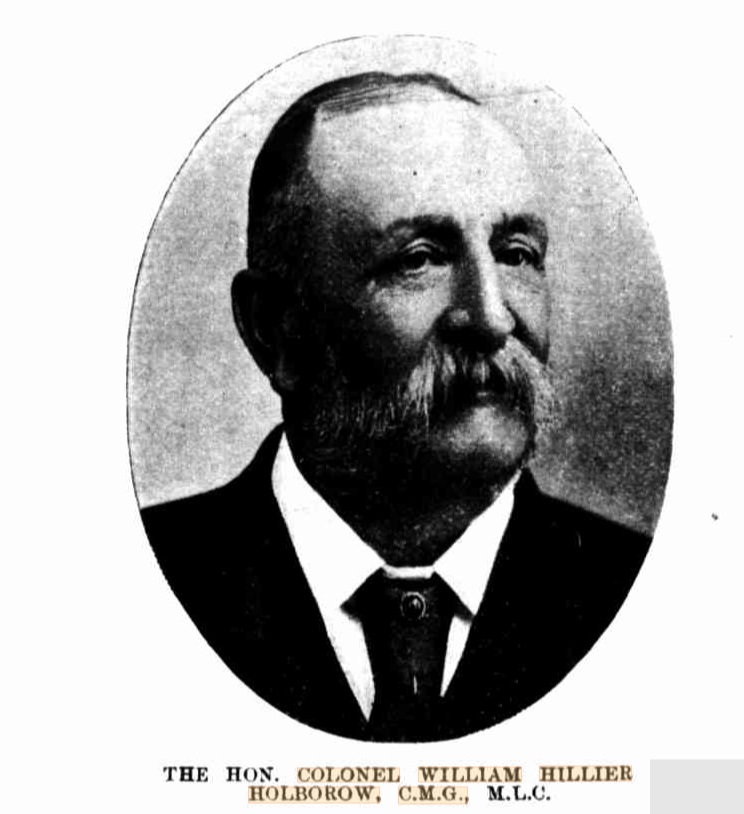
THE HON. COLONEL WILLIAM HILLIER HOLBOROW, C.M.G., M.L.C. RECENT APPOINTMENTS TO THE LEGISLATIVE COUNCIL. (1899, April 22). The Sydney Mail and New South Wales Advertiser (NSW : 1871 - 1912), p. 924. Retrieved from http://nla.gov.au/nla.news-article165227574
DEATH OF COLONEL W. H. HOLBOROW.
After an illness extending over five weeks, Colonel William Hillier Holborow, C.M.G., V.D., M.L.C., died at his residence, High-bury-street, Croydon, yesterday afternoon.
A son of the late Mr Daniel Holborow, well known in commercial circles, Colonel Holborow was born in Sydney in 1841, and the greater portion of his education was de-rived from private study under the late Canon Druitt. In 1860 he joined the military forces, and was responsible for the formation of the Richmond Corps of Volunteer Rifles being captain of the corps in 1871. He be-came major commanding three years later. In 1880 he was promoted to the rank of lieutenant-colonel, and was made brevet colonel in 1890, and full colonel after six years' further service. Three years later he was placed on the reserved list.
In recognition of his long military career, Colonel Holborow was created a C.M.G. in 1896 and in the same year he received the V.D. He was at one time a member of the colonial defence committee.
The deceased was elected to Parliament for the Argyle electorate in 1880, and held the seat until 1894, being then defeated by Mr Thomas Rose. He was appointed to the Upper House In 1899. Colonel Holborow was four times Mayor of Richmond, where he followed commercial pursuits for many years. He was an enthusiastic member of the Masonic body and a close follower of sport, more especially cricket.
Colonel Holborow married Maria, a sister of the late well-known sportsman and horse breeder Andrew Town. He leaves a widow, six sons, and four daughters.
The funeral will take place to-morrow morning, leaving the deceased's late resi-dence at 10 o'clock for the Enfield Cemetery. DEATH OF COLONEL W. H. HOLBOROW. (1917, July 11). The Sydney Morning Herald (NSW : 1842 - 1954), p. 10. Retrieved from http://nla.gov.au/nla.news-article15743456
DISTRICT COURT LAW.
TO THE MAYOR AND ALDERMEN,
(FOR THE FAVOUR OF THE EMPIRE.)
Gentlemen,-You summoned me at the present sittings of the District Court for the sewer rate of two houses for the year 1866. You thought proper to abolish one claim, and obtained a judgment against me on the other. Why you did so I cannot imagine, for you had an equal right to judgment in both cases, seeing I was not the occupier of either house for the year sued for - 1866.
The 17th clause of the Sewerage Act declares "that the occupiers of houses shall pay the sewer rate ANNUALLY, and that such rate shall be due and payable in advance."
The assessment paper describes the person rated for the year 1866 to be W. I. Johnson, and, as such, is entered in the assessment books. These are the premises on which you have obtained judgment against me.
I ask you - possessing, as I presume you do, the collective wisdom of the city of Sydney - how it was possible for me to comply with the law, and pay the rate in advance when the premises were occupied, by Mr. Johnson. during the whole year, and also six months of 1867? I ask you how it was possible for me to appeal against the city rate which regulates the sewer rate for premises I was not the occupant of? You have now got a judgment against me on a rate for which I had no appeal - Mr. Johnson being the only person who could use that privilege. I ask you, is this either law or justice? I notified to your Town Clerk these facts, and cautioned you against such illegal proceedings.
If you take out execution, and send your bailiff into my house, I shall take such steps as I may be advised in the matter.
I am, your obedient servant,'
JOHN WETHERILL, 235, Pitt-street. DISTRICT COURT LAW. (1867, November 15). Empire (Sydney, NSW : 1850 - 1875), p. 3. Retrieved from http://nla.gov.au/nla.news-article60847111
I, THE undersigned, William Edward Ebblewhite, hereby make application to register the Golden Bar Gold Mining Company, under the provisions of the Mining Partnership Limited Liability Act, 1861 ; and I do solemnly and sincerely declare, that the following statement is, to the best, of my belief and knowledge, true in every particular, namely :—
1. The name and style of the Company is the " Golden Bar G. Mining Company, Limited."
2. The place of operations is at Maitland Bar, Avisford, in the Colony of New South Wales.
3. The nominal capital of the Company is two thousand four hundred pounds (£2,400), in one hundred and twenty shares (120) of twenty pounds (£20) each.
4. The amount already paid up is one thousand three hundred and fifty pounds (£1,350), represented by fifty proprietors' shares fully paid up to twenty pounds (£20) each, and three hundred and fifty pounds (£350) paid in cash by the subscribing shareholders.
5. The name of the Manager is William Edward Ebblewhite.
6. The Office of the Company is situate in Mort's-passage, Sydney.
7. The names and several residences of the shareholders, and the number of shares held by each at this date, are as follow :—
Name of Shareholder. Residcnce. No. of Shares.
Angus William Thomas Sydney 3
Beattie Mrs. Mary Jane „ 3
Buttle William „ 1
Booth John „ 1
Budd James „ 2
Drynan Thomas M „ 1
Ellwood Miss Mary Frances ... 1
Elphinstone Alexander L „ 1
Francis John „ 3
Guyatt George „ 3
Fay Henry „ 1
Howell John Benjamin „ 3
Henderson James „ 1
Johnson George „ 1
Keatts Joseph „ 1
Kendall Miss Elizabeth „ 1
Linney Charles „ 1
Lewis Clement „ 1
Laws Samuel..... „ 1
M'Carthy Edmund Charles „ 1
Munro „ 1
Newton Christopher „ 5
Roberts Mrs. Charlotte „ 1
Renwick William Condie „ 5
Renwick Arthur, M.D „ 9
Rolin Thomas Bately „ 5
Shankland Robert „ 3
Taylor William Smith „ 1
Vallack Richard G „ 1
Wetherill John „ 5
Wilson John „ 1
Yeo Thomas Roger „ 2
70
PROPRIETORY SHARES.
Alcock John Sydney 8
Alcock Thomas „ 4
Alcock Francis Avisford 4
Delph John ,, 8
Guyatt Goorgo Sydney 1
Leeder Frederick Avisford 8
Renwick William Condio Sydney 8
Renwick Arthur, M.D „ 1
Wetherill John „ 8
50
W. E. EBBLEWHITE, Manager.
Witness,—John D. FOTHERINGHAM. I, THE undersigned, William Edward Ebblewhite, hereby make application to register the Golden Bar Gold Mining (1872, November 1). New South Wales Government Gazette (Sydney, NSW : 1832 - 1900), p. 2863. Retrieved from http://nla.gov.au/nla.news-article230134060
LATEST MINING.
At a meeting of shareholders in the Golden Bar Gold Mining Company (limited), Maitland Bar, Avisford, Meroo Creek, held on Friday, at the office of Mr. Ebblewhite, Mort's passage George-street, the company was declared duly formed. Dr. Renwick and Christopher Newton, Esq., were elected trustees ; and Messrs. Renwick, Wetherill, Alcock, Angus, and Booth, the first five directors ; Messrs. Henderson and Elphinstone were appointed auditors, and W. E. Ebblewhite manager. LATEST MINING. (1872, September 2). Empire (Sydney, NSW : 1850 - 1875), p. 2. Retrieved from http://nla.gov.au/nla.news-article60865085
An indication of what could be found there:
A Monster Nugget.
A nugget of gold weighing 347 ounces has been lodged at the bank in Mudgee by three miners, who found it at Maitland Bar near Mudgee. A Monster Nugget. (1887, June 17). The Armidale Express and New England General Advertiser (NSW : 1856 - 1861; 1863 - 1889; 1891 - 1954), p. 8. Retrieved from http://nla.gov.au/nla.news-article192881639
A Jubilee Nugget.
We have great pleasure in recording the arrival in Mudgee on Tuesday evening, from Maitland Bar, of a nugget weighing no less than 347 ounces. It was found by Messrs. Leeder, Thorpe, and Isaac Holmes, who have, for the last month, been working in the shallow alluvial about 300 or 400 yards from the bank of the Meroo River, at Maitland Bar. The nugget was found at a depth of only seven feet from the surface, and holes had been sunk all round it. This is one of the largest nuggets ever found in Australia, and it is certain that nothing like it has ever before (at any rate since the discovery of their great specimen by Beyers and Holterman) been found in this district. Mr. Stacy, the manager of the Commercial Bank, estimates its value at more than £1200. During the last few days a perfect furore has been created in Ballarat by the discovery of a nugget weighing l67oz. — less than half the weight of our jubilee nugget. — Mudgee Post. A Jubilee Nugget. (1887, July 1). The Richmond River Herald and Northern Districts Advertiser (NSW : 1886 - 1942), p. 3. Retrieved from http://nla.gov.au/nla.news-article127715104
The Mudgee Nugget.
The Government has decided, in response to the representations of Mr. Haynes, M.L. A., to purchase the great nugget of gold, weighing over 350oz., which was found at Maitland Bar, in the Mudgee district, a few days ago. The nugget, which is now at the Commercial Bank, Pitt-street, is one of the finest specimens that can be seen of solid gold. It is, we understand, the intention of the Government to give for the nugget the fair market or Mint value, and to forward it to the Melbourne International Exhibition. Mr. Haynes yesterday waited upon Mr. T. A. Dibbs, the manager of the Commercial Bank, with a view to facilitating the arrangements for the pure base, and that gentleman agreed to the sale of the nugget at the Mint value' which would be about £1400. The consent of the finders, who have already turned the nugget into coin of the realm, will be obtained by Mr. Dibbs; and the nugget will then be handed to the Colonial Secretary. The Mudgee Nugget. (1887, July 2). The Sydney Mail and New South Wales Advertiser (NSW : 1871 - 1912), p. 28. Retrieved from http://nla.gov.au/nla.news-article165222053
About 1869 Mr. Beames and three other residents-Messrs. John Keep, Frederick Parsons, and John Wetherill-each contributed £2 for the employment of a man to canvas for signatures for a petition urging the formation of the district into a municipality. This course was opposed by Mr. W. Pratt, chemist, on the ground, so it is stated, that there would be a vacant block between the pro-posed municipality and that of Marrickville. The Government turned the proposal down. Arrangements, however, were made later for the boundaries of those two municipalities to be in the middle of Parramatta-road. In this arrangement the Government concurred. The first ballot was taken in the residence of Mr. Beames, at the corner of Piper and Catherine streets. The first aldermen were Messrs. F. Beames, John Keep, Frederick Parsons, John Wetherill, Albert Barnett, and Aaron Wheeler. Mr. Beames was elected Mayor and occupied the position for two years. He then left Leichhardt and lived at Glebe; but later removed to Parramatta, where he was Mayor for two years, and an alderman for three years. Mr. Beames then retired from municipal and also commercial life, and re-moved to Summer Hill, where he is still living. FIFTY YEARS AGO. (1921, December 15). The Sydney Morning Herald (NSW : 1842 - 1954), p. 8. Retrieved from http://nla.gov.au/nla.news-article15973555
MUNICIPAL DISTRICT OF LEICHHARDT.
IT is hereby notified, that Alderman Wetherill has been appointed Treasurer for the current municipal year; and that His Excellency the Administrator of the Government, with the advice of the Executive Council, has been pleased to appoint John Hutcheson Macfie, Esq., an Auditor, for the current municipal year. FRANK BEAMES, Mayor. Council Chambers, 8th May, 1872. Private Advertisements. MUNICIPAL DISTRICT OF LEICHHARDT. (1872, May 10). New South Wales Government Gazette (Sydney, NSW : 1832 - 1900), p. 1212. Retrieved from http://nla.gov.au/nla.news-article225841064
NOTICE is hereby given, that at a Meeting of Aldermen for the Municipal District of Leichhardt, held at the Working-men's Institute, Leichardt, on February the 16th, 1872, Alderman Frank Beames -was elected Mayor for the ensuing year.
FRED. PARSONS, JOHN WETHERILL, Aldermen for the Municipal District of Leichhardt.
WALTER BEAMES, First Returning Officer for the Municipal District of Leichhardt.
Dated at Leichhardt, this 19th day of February, 1872. NOTICE is hereby given, that at a Meeting of Aldermen for the Municipal District of Leichhardt, held at the (1872, February 20). New South Wales Government Gazette (Sydney, NSW : 1832 - 1900), p. 466. Retrieved from http://nla.gov.au/nla.news-article223086497
BOROUGH COUNCILS.
Leichardt . - The usual fortnightly meeting of the Council was held on Monday, the 4th September. Present- Aldermen Parsons (in the chair), M'Donald, Wetherill, Wheeler, and Linney. The minutes of the pievious meeting were read and confirmed. With reference to the rates in arrears Alderman Linney moved, and Alder-man M Donald seconded,-"That a notice be inserted twice In the Herald, that all rates must be paid by Monday, 13th October, otherwise legal proceedings to be at once commenced." Carried. A report from the Committee of Works was received. A letter was read, from the Under-secretary of the Treasury, stating that the endowment, £184 48. Id., had been paid into the credit of the Municipality, at the City Bank. Received. It was proposed by Alderman Linney, and seconded by Alderman M'Donald, "that £ 50 be voted to carry on the works now in progress in the Municipality." Carried. The report of the inspector of nuisances, stating that upon receiving the necessary funds he was ready to proceed against a number of persons for breaches of the by-laws, upon the motion of Alderman Wetherill, seconded by Alderman M'Donald, the necessary amount was voted. It was proposed by Alderman M'Donald, and seconded by Alderman Wheeler,-"that tenders be called for the horse and cart work of the municipality." Carried. A. C. DELOHERY, Council Clerk. BOROUGH COUNCILS. (1872, October 5). The Sydney Morning Herald (NSW : 1842 - 1954), p. 3. Retrieved from http://nla.gov.au/nla.news-article13264254
MUNICIPAL DISTRICT OF LEICHARDT.
NOTICE is hereby given, that Alderman John Wetherill was this day unanimously elected Mayor of the Municipal District of Leichardt for the current municipal year.
THOS. W. MORTON, Council Chambers, Leichardt, Council Clerk. 9th February, 1874. MUNICIPAL DISTRICT OF LEICHARDT. (1874, February 13). New South Wales Government Gazette (Sydney, NSW : 1832 - 1900), p. 466. Retrieved from http://nla.gov.au/nla.news-article223692590
NOTICE is hereby given, that Mr. Walter Beames and Mr. David Weir have been duly appointed Valuers for the current municipal year. JOHN WETHERILL, Council Chambers, Leichhardt. Mayor. NOTICE is hereby given, that Mr. Walter Beames and Mr. David Weir have been duly appointed Valuers for the current (1874, March 20). New South Wales Government Gazette (Sydney, NSW : 1832 - 1900), p. 858. Retrieved from http://nla.gov.au/nla.news-article223693915
On Tuesday, a deputation, consisting of Messrs. G. A. Mansfield, W. T. Pinhey, W. Clarke, and A. Thomley, representing the municipality of the Glebe ; Mr. J. Taylor (Mayor), and H. Perdriau, representing Balmain ; Messrs. J. Wetherill (Mayor), J. Keep. F. Parsons, and H. Burrows, representing Leichardt Municipal Council— waited upon Mr. Parkes to represent to him the imperative necessity for the immediate removal of the Abattoirs. In the absence of the Mayor of the Glebe, the deputation was introduced by Mr. Mansfield, who at some length pointed out the evils arising, not only from the presence of the abattoirs themselves, but of the various industries of an offensive character which were attracted around them. The sources of complaint were not merely injurious to the property-holders, but still more to the health of the inhabitants. It was urged that the removal of the abattoirs was only a question of time, that it must inevitably take place at no very distant date, and that it would be easier to effect the transfer of possession now than it will be at a future time. These statements were fully endorsed by Mr. Taylor, Mr. Keep, Mr. Thornley. and Mr. Pinney, who also strongly urged the Colonial Secretary that as this was no ordinary matter, but one eo largely affecting the well-being of an extensive population, immediate action was called for. The Colonial Secretary said he fully admitted the existence of the evils referred to, and that the matter had already received the serious consideration of the Government on several occasions within the last few months. He pointed out that great difficulty existed in the removal of the abattoirs, and also that to erect new ones elsewhere would involve a large outlay, for which. Government could not ask the sanction of Parliament unless they were quite sure that they were making permanent arrangements to obviate all causes of complaint. The freezing process which Mr. Mort is maturing would, he hoped, render unnecessary the presence of abattoirs close to the city. The Government intend to await the result of Mr. Mort's experiments before deciding upon any course of action. If those experiments were unsuccessful, the Government would have to grapple with the question of removing the abattoirs from Glebe Island entirely to some more distant site. The deputation having thanked Mr. Parkes for the courteous manner in which he had received them, and for the intentions expressed, the interview terminated.The Week. (1874, June 6). The Sydney Mail and New South Wales Advertiser (NSW : 1871 - 1912), p. 728. Retrieved from http://nla.gov.au/nla.news-article162484728
MUNICIPAL DISTRICT OF LEICHHARDT.
NOTICE is hereby given that the following gentlemen have been duly elected Aldermen and Auditors for the above Municipality for the current year :
As ALDERMEN.
JOHN THOMSON FRASER.
FREDERICK PARSONS.
As AUDITORS.
W. BRADE.
JOSEPH DREW.
JOHN WETHERILL, Returning-Officer.
February 6, 1876. Advertising (1876, February 8). The Sydney Morning Herald (NSW : 1842 - 1954), p. 3. Retrieved from http://nla.gov.au/nla.news-article13363904
Department of Lands,
Sydney, 10th September, 1878.
HIS Excellency the Governor, with the advice of the Executive Council, has been pleased to appoint the following gentlemen to be additional Trustees of the General Cemetery at Haslem's Creek, viz.:—
S. H. Pearce, Esquire, J.P., William Day, Esquire, J.P., and John Wetherill, Esquire.
[Ms. 78-9,845] JAMES S. FARNELL. Government Gazette Appointments and Employment (1878, September 10). New South Wales Government Gazette (Sydney, NSW : 1832 - 1900), p. 3638. Retrieved from http://nla.gov.au/nla.news-article223112191
Leichhardt : Messrs. John Wetherill and Tasker Charles Smith. To be trustees of the land dedicated for general cemetery purposes at Sweeney Creek, parish of Ulmarra, hereafter particularized, viz :-Church ot England : Rev. John Leslie Smith, Messrs. Jolin Davidson and William Campbell. Roman Catholic : Very Rev. Patrick White, D.D. ; Messrs. James O'Hara, William Corrigan, and Henry Gilbert, jun. Presbyterian : Messrs. Robert Young, James Drummond, and John M'Farlaue, sen. GOVERNMENT GAZETTE. (1879, September 10). The Sydney Morning Herald (NSW : 1842 - 1954), p. 7. Retrieved from http://nla.gov.au/nla.news-article13454660
At the instance of M. Greenwood, copies of tenders for the supply of blankets to the Government for 1879-80, together with copies of letters, minutes, reports, memo's, and other papers in connection therewith, have been published by the Government Printer. The documents collectively show that Alessrs. Moore, Henderson, and Boweher contracted to supply blankets to the probable value of £5321 5s ; that the goods on being examined were found by exports not to be of the same quality or value as that of the sample blankets furnished with the tender, and that, consequently, they were condemned and removed from the Government stores. Subsequently Messrs. Prince, Ogg, and Co., entered into a similar contract, and through a like cause came to grief. The implication in both cases was that of attempting to pass goods of an inferior quality to those tendered for, but whether it was so or not is a matter which rests with the gentle men who acted as experts. It would secm, however, from the reports of Messrs. Chris. Newton, Rob. W. Hagg, and George Munro, and also Messrs. J. Wetherill and R. Shanklin, who acted in the former case, and of Messsrs. Wetherill and Shanklin and Messrs. Anthony Hordern and John Pomeroy, who officiated in the latter, that the Colonial Treasurer was guided by the reports of these gentlemen in deciding against the contractors. The contractors stated in their correspondence with the Colonial Treasurer that it was almost impossible to obtain a large supply of blankets from home manufacturers of absolutely the same weight and value, and urged that that fact ought to have been considered before the matter was decided against them. No title (1879, July 25). The Sydney Daily Telegraph (NSW : 1879 -1883), p. 2. Retrieved from http://nla.gov.au/nla.news-article239288862
Department of Justice and Public Instruction,
Sydney, 5th September, 1879,
HIS Excellency the Governor, with the advice of the Executive Council, directs it to be notified, for general information, that in accordance with the 22nd section of the Public Schools Act of 1866 (30 Vic. No. 22), the undermentioned gentlemen have been appointed additional members of the Public School Boards of the Public Schools established at the places specified in connection with their names respectively, viz, :—
CESSNOCK— Mr. William Pinchen. NARELLAN— Mr. Isaac Rudd. PORTLAND LOWER— Mr. Thomas John Christie. ERSKINE PARK—Mr. Samuel Marks. LEICHHARDT—Messrs. John Wetherill, Tasker Charles Smith.
F. B. SUTTOR. Government Gazette Appointments and Employment (1879, September 9). New South Wales Government Gazette (Sydney, NSW : 1832 - 1900), p. 3971. Retrieved from http://nla.gov.au/nla.news-article223436078
[Advt.] Rockhampton.
We, the undersigned passengers per Lord Ashley, to Rockhampton, have great pleasure in certifying to the efficient manner in which the table was supplied, and the passengers waited upon, in fact so well was all the arrangements that we have seldom seen it equalled and never surpassed in the colony. ...
8th July, 1879.
To Mr. Eussell, Provedore S.S. Lord Ashley.
We, the undersigned passengers per S.S. Lord Ashley, have much pleasure in testifying to the excellent table provided for saloon passengers, and to the attention of the stewards generally :—
J. Abbot, First Judge N.D.C., Maryborough
W. H. Tulloh, Sydney
J. A. Young
P. H. Alcock
D. M. Hunter
W. Hays
G. T. Nott
B. P. Peterson
John Wetherill
M. Vallick. SHIPPING. (1872, July 8). Evening News (Sydney, NSW : 1869 - 1931), p. 2. Retrieved from http://nla.gov.au/nla.news-article114731335
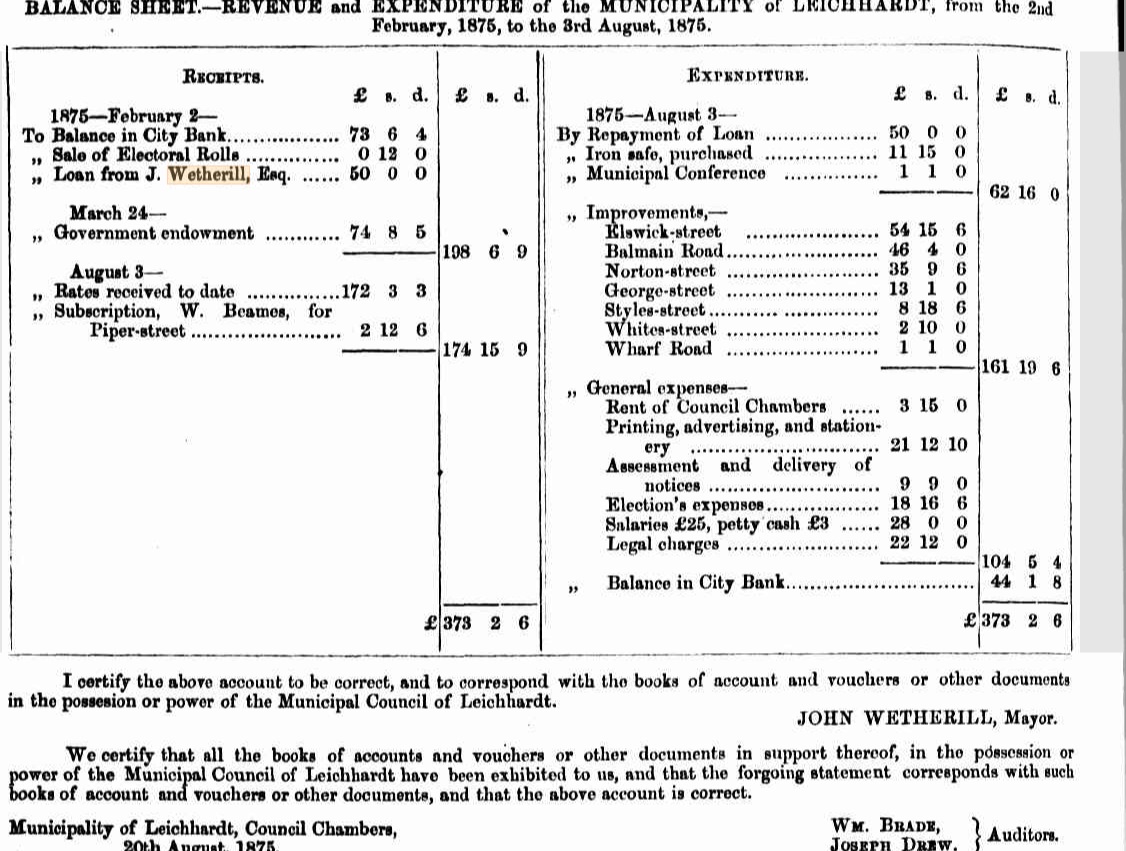
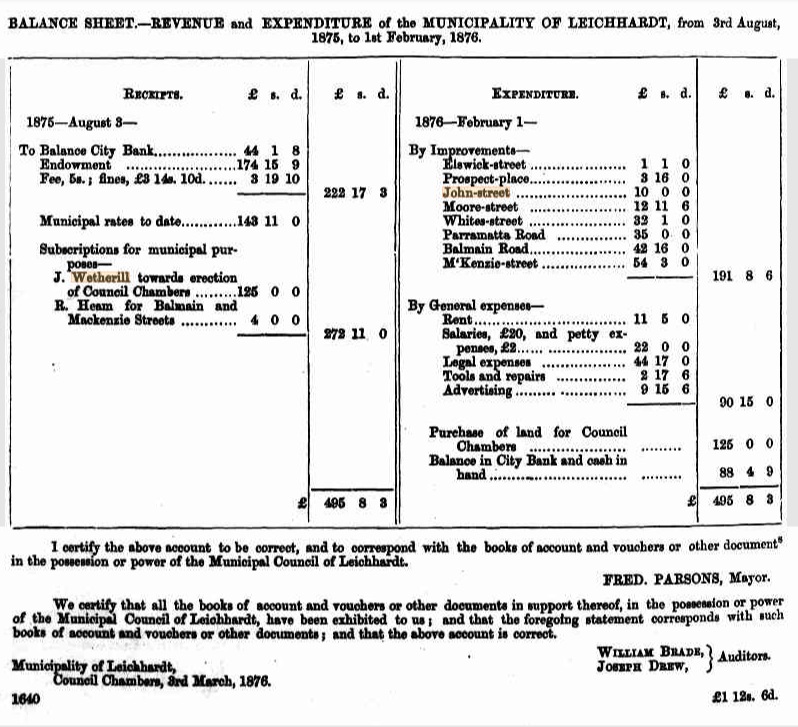
BALANCE SHEET.—REVENUE and EXPENDITURE of the MUNICIPALITY OF LEICHHARDT, from 3rd August, 1875, to 1st February, 1876. (1876, March 7). New South Wales Government Gazette (Sydney, NSW : 1832 - 1900), p. 964. Retrieved from http://nla.gov.au/nla.news-article223647011
Colonial Secretary’s Office,
Sydney, 21st August, 1878.
HIS Excellency the Governor, with the advice of the Executive Council, has been pleased to appoint the undermentioned gentlemen to be Magistrates of the Colony, namely:—
Wetherill John, Elswick, Petersham. Government Gazette Appointments and Employment (1878, August 28). New South Wales Police Gazette and Weekly Record of Crime (Sydney : 1860 - 1930), p. 306. Retrieved from http://nla.gov.au/nla.news-article251895067
NOTICE is hereby given, that Alderman John Wetherill was this day elected Mayor of the municipal district of Leichhardt for the current municipal year.
W. BEAMES, Council Chambers, Leichhardt, Council Clerk.
12th February, 1875. NOTICE is hereby given, that Alderman John Wetherill was this day elected Mayor of the municipal district of Leichhardt (1875, February 16). New South Wales Government Gazette (Sydney, NSW : 1832 - 1900), p. 469. Retrieved from http://nla.gov.au/nla.news-article223653640
John Wetherill served as a provider of funds for mortgagees across Sydney, sometimes alone, other times with equity partners, including John Sutherland, and would foreclose if they could not meet payments. He was also a Director of the 1871 established Australian Mutual Fire Society from which it may be assumed he derived large profits that were then reinvested in land as well as some philanthropic ventures:
Prospectus OF THE AUSTRALIAN MUTUAL FIRE INSURANCE SOCIETY FOR MUTUAL FIRE INSURANCE WITHOUT MUTUAL LIABILITY.
ALL THE PROFITS BELONG TO THE INSURERS.
Provisional Directors :
Hon. John Sutherland, M.L.A., Chairman.
M. F. Josephson, Esq. William J. Day, Esq. John Wetherill, Esq. William Heslett, Esq. James Murphy, Esq. Randolph Nott, Esq. William Jarrett, Esq.
Bankers : The Bank of New South Wales.
Solicitors : Messrs. Allen, Bowden and Allen.
Interim secretary : James Henderson.
Temporary Offices 235, Pitt-street, Sydney.
1.— At a public meeting held in the Temperance Hall, Pitt street, 8ydney, on Monday, 11th December, 1871, after free discussion and mature deliberation, it was unanimously resolved— 'That the above Society should be formed and established as a general Mutual Fire Insurance Society and with a view to its speedy formation and establishment, it was then further unanimously resolved—' That the foregoing Provisional Directory should co-operate in such formation and establishment.'
2.— The object of the society's projectors is to check the LARGE STREAM OF INSURANCE PREMIUMS now flowing out of the colony, whereby irreparable injury is sustained, and to turn the same, in the form of profits, into the pockets of THE INSURERS THEMSELVES, ratably, according to their respective interests in the society.
3.— The extent of the large sum now thus passing FROM THE FIRE INSURERS may be estimated in some degree by the expensive staff necessarily employed by the FIFTEEN FOREIGN FIRE SOCIETIES at present carrying on business in Sydney, with COUNTRY AGENCIES throughout the colony. Societies, upon falling to be productive of profit, are invariably discontinued ; and the best evidence that THE INSURERS can possibly possess of the satisfactory success of the fifteen foreign societies referred to, and their injurious drain upon OUR INSURERS' RESOURCES is their long and continued existence amongst us, during which insurers and the colony have been losing huge sum* ol money, which have been remitted by the various foreign branches to their respective head offices.
4 — It will therefore be apparent that there is a very exten sive and profitable field of operation for a COLONIAL MUTUAL FIRE INSURANCE SOCIETY. under an energetic and economical management, the members of which to consist of insurers of this colony, associated together to do their own business, thereby securing for their personal benefit A LARGE PROPORTION OF THE PROFITS OF THE FIFTEEN FOREIGN SOCIETIES. nothing short of which will enable insurers to occupy their legitimate positions as independent colonial insurers, which s mere reduction in rates by those foreign societies will nevei accomplish. 5. —As a bright example of the inestimable value of LOCAL MUTUAL INSTITUTIONS, the particular attention of our fire insurers is specially directed to the AUSTRALIAN MUTUAL PROVIDENT SOCIETY, whose gross premiums up to July 1870 amounted to no less a sum than £1,737, 390, and Its total invested capital £693,492 2s 5d, which, under the foreign proprietary system would have been swept from both insurers and the colony, and out of whose funds unprecedented profits have been paid to Its members, thereby proving to be a great boon to the Life Insurers of this Colony, as well as this southern hemisphere generally; and the Society whose prospectus is now being laid before you, will assume the same high position, with equally lofty objects in view, namely, PROTECTION AGAINST FIRE TO INSURERS WITH THEIR RATABLE SHARE OF ALL THE PROFITS realized by the society.
6.— The projectors of the AUSTRALIAN MUTUAL FIRE INSURANCE SOCIETY are proprietors of insurable property, who feel from experience that the exigencies of the times, such as reduction in rents bad tenants, empty houses, insurance, rates, repaint, etc. urgently demand the utmost economy, and are therefore convinced that, by becoming THEIR OWN INSURERS AND RECEIVING ALL THE PROFITS, they will not only considerably reduce their own expenses, but will thereby be contributors towards the permanent establishment of THE INSURERS OWN COLONIAL SOCIETY which is destined to assume huge proportions, to take a high position amongst the institutions of the colony, and to cenfe a lasting boon upon our Insurers generally, by keeping a very large sum of money in the country, and putting it, in the shape of profits, into the pockets of those who contribute it. With these praiseworthy objects in view, special care has been taken to secure the fullest protection to Insurers at the smallest rates of premium, as well as the most rigid economy; in management with the largest possible profits to its members.
7. The simple and equitable principles upon 'which this society is based are mutual participation in the profits by all the insurers, with a subscribed capital of £50,000, consisting of shares of £1 each. The members (subscribing such capital an styled 'original members, and those merely insuring ordinary members.' The liability of original members is intended to be limited to the amount of their respective shares, and no liability shall attach to more insurers in the society style-* 'ordinary members,'
8. Of the capital, two shillings and sixpence per share will be paid up on application, which amount, with the large immediate income from business pledged and promised to the society, will constitute ample available capital for th society's purposes, as business of 6uch a character only will be accepted by the directors as will leave small room for losses. Consequently the society's receipts, less a small percentage (or working expenses, may also be regarded as clear profit. A guaranteed eight per cent, per annum upon the paid up capital will be paid every six months to the original members holding the society's share scrip, and upon the remainder subscribed, but not paid up, they will receive rateable share of the profits, along with the ordinary members' or insurers of the society, at the expiration of each official year.
9.— There shall be five directors of the society elected from time to time by the 'original members' from among their own number.
10.— The funds of the society, consisting of the paid up capital and accumulation of premiums, shall be invested in Government or city debentures, or in real [and approved societies, and pending such investment, the same shall be deposited with the society's bankers.
11. —The books of the society will close on the 31st day of January in each year, and the annual meeting will be held within sixty days thereafter, at which a report and balance sheet will be submitted.
12. — The business of the society will be commenced as soon as £20,000 of the capital has been subscribed.
13.— Application will be forthwith made for an Act to incorporate the society, and to limit the liability of the share holders to the amount of their respective shares.
14.— Applications for shares to be made to tbe provision directors in the form annexed, accompanied by two shillin, and sixp- nee rer share, to the secretary, at the temporary offices, 235, Pitt-street, Sydney.
FORM OF APPLICATION FOR SHARES.
To the Provisional Directors of the Aubtualmk Mutual Fire Inbubance Society I have to request that you allot me Shares in the above Society ; for which I hand you herewith £ „ being at the rate of Two Shillings and Sixpence per Share and I hereby agree to accept the same, or any small number that may be alloted to me, and to sign the Deed of Settlement when requested to do so.
Name in full
Address
Occupation
Date
Family Notices (1871, December 23). Evening News (Sydney, NSW : 1869 - 1931), p. 4. Retrieved from http://nla.gov.au/nla.news-article129964550
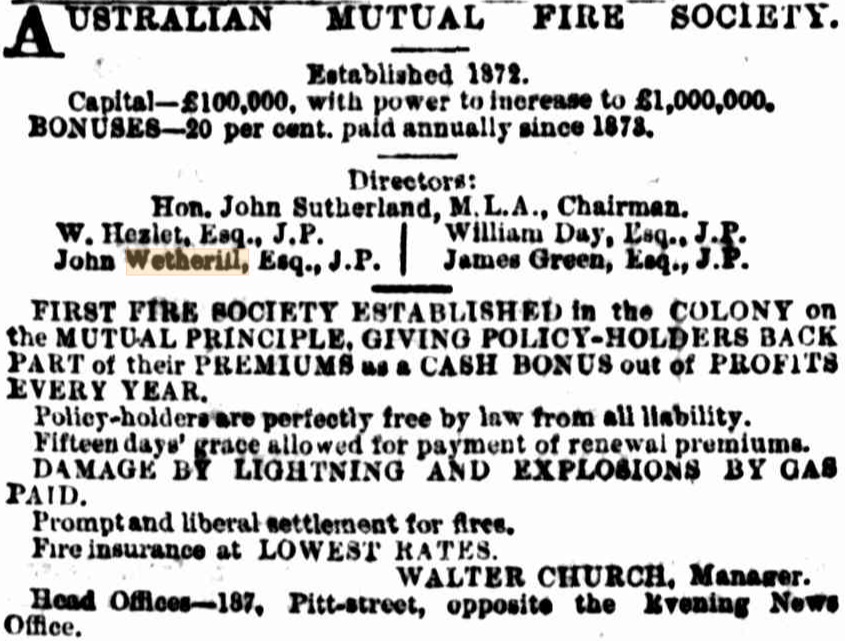
Advertising (1884, June 3). The Sydney Morning Herald (NSW : 1842 - 1954), p. 9. Retrieved from http://nla.gov.au/nla.news-article13569692
New Building of the Australian Mutual Fire Insurance Society.
CONCERNING the grand block of buildings now being erected by this society at the corner of Pitt and King streets, and which are illustrated in another page, the following is interesting:
The design is of the Italian style, adapted to modern street architecture, combining lightness with solidity. The two facades of the building are to be entirely of the best Pyrmont stone. The frontage to King-street is 71ft 8in, and that to Pitt-street 51ft 10in. A lofty tower at the corner is one of the features of the building, and will be another landmark in the city. The two elevations are uniform, with rusticated and moulded piers, balustrades in front of ground floor windows, and a massive cornice continued along each front. The cornice projects over the main entrance, whore it is supported upon carved trusses, and forms a balconette with columns on each side bearing a circular pediment under the base of tower. The second and third stories are lighted by largo windows placed between handsome, fluted engaged columns; the windows of the first floor have alternate pointed and circular pediments with enriched trusses, keystones, and carved wreaths. The columns support a handsome entablature and cornice surmounted by an ornamental parapet and balustrade with a largo pediment and carved and enriched tympanum on each façade, crowned at the top with a group of statuary emblematic of the society's business. The tower will be 105ft in height, with stone piers, enriched pediments, and carved shield, and finished with a handsome cupola and lantern of metal. The ground floor is divided into two parts ; the northern part, comprising the corner entrance and the King-street frontage, is reserved for the society's offices, the insurance chamber and manager's room ; and the southern part is arranged for the Pitt-street branch of the Bank of Australasia. The directors' and shareholders' rooms occupy a portion of the first floor ; all those rooms will be handsomely decorated. The remaining portion of the first floor as well as the second floor is subdivided into offices for letting. A separate entrance at the north-east side in King-street is provided for these offices. Mr. Alexander Dean is the contractor for the buildings, which, it is expected, will be completed within the next 12 months.
Of the history of the society the following facts wore made public at the laying of the foundation stone, June 7, as described in our last issue :-
At a public meeting held in the Temperance Hall, Pitt-street, on December 11, 1871, it was unanimously resolved, after free discussion and mature deliberation, that this society should be formed as a Mutual Fire Insurance Society, for which purpose provisional directors wore then appointed, who speedily and most successfully completed their labours and handed the infant society over to the first board of directors, viz. :-The Hon. John Sutherland, M.L.A., Manuel Francis Josephson, John Wetherill, William Hezlet, and William Day, and operations were commenced on February 1, 1872, with a capital of £100,000 (with power to increase to £1,000,000), consisting of snares of £1 each, represented by a numerous and substantial body of owners of insurable property.
The special objects of the society's promoters were to protect themselves and the owners of property generally from the extreme rates hitherto charged on private dwellings, and to check the large stream of fire insurance premiums then flowing out of, and thereby causing irreparable injury to the colony, and to turn the same, in the form of profits, into the pockets of the insurers, yearly and ratably according to the premiums paid by them respectively to the society for the preceding year.* The promotors of the Australian Mutual Fire Insurance Society were large proprietors of insurable property, who, feeling from experience that the exigencies of the times, such as reduction in rents, bad tenants, empty houses, insurance rates, repairs, &c, urgently demanded the utmost economy, were convinced that by insuring in their own society and receiving their share of the profits yearly, they would not only reduce they own expenses, but would also be contributors towards the permanent establishment of a fire insurers' own Colonial Mutual Society, undertaking to give the same protection against fire as afforded by other insurance companies, by promptly settling all claims for loss or damage by fire, lightning, or by gas explosions ; to exempt the insurers from all liability for losses and claims of every kind whatever, either in law or equity ; and at the end of each official year to halve the profits realised by the society with the policy holders. The shareholders receive interest at the rate of eight per cent, per annum upon the paid-up capital of the company, payable every six months, with the half pf the bonus _ distributed ratably amongst them at the expiration of each official year. The deed of settlement provides that the directors shall yearly lay aside out of the net profits of the society, not less than 10 per cent, of such profits as a reserve fund.
The following figures illustrate the wonderful progress and success of the society since its birth :-
Total amount of premiums received for the eleven years, £164,409 ;
total amount of bonuses divided between shareholders and policyholders for same period, £31,960 ;
total amount of losses paid, £50.208 ;
amount of reserve fund accumulated to present time, £40,000 ;
amount of investments to March 31 last, £53,324.
The above figures show that the Australian Mutual Fire Insurance Society, the first fire society permanently established in New South Wales on the mutual principle, giving policy-holders back part of their premiums as a cash bonus out of the profits every year, has proved the good judgment of the projectors, being now one of the most successful insurance offices in the colonies.
From such results it may reasonably be assumed that the future history of this society will rebound to the credit of its founders as the promoters of the best interests of our fire insurers in this colony, by securing to them those privileges hitherto denied them by the former and proprietary fire companies.
If insurers, therefore, consult their own interests they will insure in this society-where only such business is accepted as is likely to partake of both a permanent and profitable character-and will influence their respective friends to follow their praiseworthy example, as the more business there is done by the society the greater will be the profit ; and the greater the profit, the larger the sum for division.
In the year 1877, the directors were particularly fortunate in securing a valuable property at the corner of Pitt and King streets, which at the present time is worth more than double the amount paid for it, and they are now enabled to place upon the land a first-class building, affording ample accommodation for the society's increasing business, besides a eargo banking room, and providing other offices which will produce a satisfactory rental. With one exception, the present directors have held office since the formation of the society-having been re-elected without opposition on each occasion of their term of office expiring - the exception being that of the late Manuel F. Josephson, Esq., whose decease took placo in May, 1881. The death of Mr. Josephson was deeply regretted by his colleagues, he having by earnest co-operation, great energy, and straightforward principles, assisted them materially for some nine years in bringing the society to its present prosperous position. Mr. Alderman Jas. Green was duly elected as a director in place of Mr. Manuel F. Josephson, deceased.
Mr. Jas. Henderson, the first manager of the society, died in October, 1870, since which period the management has been in the hands of Mr. Walter Church.
Under the stone, and in the cavity preparations was placed a glass vase containing the following :
1. Record on parchment of the society: Australian Mutual Fire Insurance Society, established A.D. 1872, for fire insurance on the mutual principle. The amount of capital is £100,000, with power to increase to £1,000,000. The foundation stone of the society's new office was laid this 7th day of June, 1883, by the Hon. Jno. Sutherland, M.L.A., chairman of the board of directors. The architect for the building is G. A. Morell, Esq., CE., and the contractor for the erection is Alexr. Dean, Esq. The directors of the society are the Hon. Jno. Sutherland, M.L.A., William Hezlet, Esq., J.P., William Day, Esq., J.P., John Wetherill, Esq., J.P., and Mr. Alderman Jas. Green, J.P. The officers of the society are : Walter Church, manager ; Henry Hodgson, surveyor ; Thos. Fisher, adjuster and valuator of stocks ; solicitors : Messrs. Allen and Allen ; auditors : Jas. C. Taylor and J. H. Davies. The society has agents all through Now South Wales. The revenue of the society at 31st March, 1883, was £28,089 11s 10d, the accumulated fund was £53,324 4s 8d, the reserve fund was £40,000. 2. Last report of the society. 3. Copies of the "Sydney Morning Herald" and "Sydney Daily Telegraph" of June 7, 1883, the " Evening News " of same day, and the " Town and Country Journal" and "Sydney Mail" of last Saturday's date.
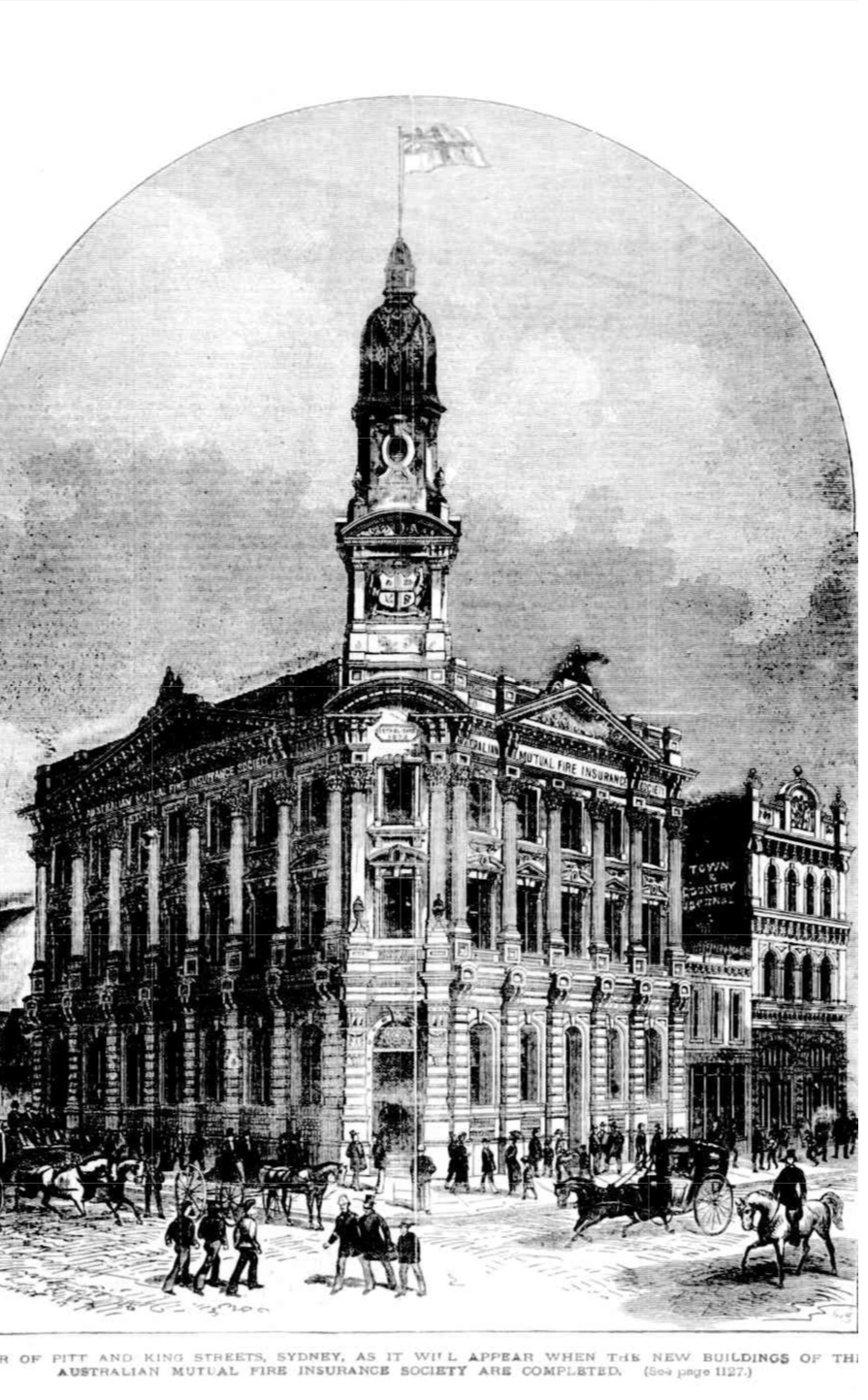
CORNER OF PITT AND KING STREETS, SYDNEY, AS IT WILL APPEAR WHEN THE NEW BUILDINGS OF THE AUSTRALIAN MUTUAL FIRE INSURANCE SOCIETY ARE COMPLETED. (See page 1137*) New Building of the Australian Mutual Fire Insurance Society. (1883, June 16). Australian Town and Country Journal (Sydney, NSW : 1870 - 1907), p. 23. Retrieved from http://nla.gov.au/nla.news-article71000526
The Queen's Jubilee
ILLUMINATIONS AND FIREWORKS IN SYDNEY
(See Illustrations on Pages 26 and 27.)
The display of Fireworks in Sydney Harbor on June 21 in honor of the Queen's jubilee was undoubtedly the finest pyrotechnic exhibition ever seen in Sydney, and was witnessed by "everybody and his wife." In the illustrations on page 26, No. . 1 is a view taken from near Fort Macquarie, showing the German war vessels and other large ships now in the harbor, Fort Denison, and Kirribilli Point, during a discharge of rockets accompanied, by a maze of blue and red fires.
The ships were ornamented with rows of white, .lights, so arranged as to show off the fineness of their lines ; while ever and anon, brilliant lights were burned at the yard arms and elsewhere on the rigging. The rain of sparkling fire balls of the brightest colors, after a discharge of rockets lighted up the waters with variegated hues.
No. 2 shows a discharge of serpents from Port Macquarie, and No. 3 one of the set pieces on Garden Island, showing the Queen's head with the words " Hail, Empress, 1837-1887." The point on which Fort Macquarie stands appears to have been one of the favorite points from which to view the display, as it was inconveniently crowded; the mass of people stretching along the shore to "the entrance to the Botanic Gardens ; and, as each successive discharge was fired, the exclamations of wonder and ' admiration were loud and enthusiastic. Taken altogether, the display was one to be remembered. The effects of the gorgeously-colored fires were enhanced and intensified by the reflection in the waters ¡of the harbor; which1 flashed .and sparkled as ' they had never done before.
The illumination of the offices of the Australian Mutual Fire Insurance Company, at the corner of Pitt and King streets, Sydney, on the night of June 20, attracted much notice. A fine illustration, with a description, will be found on page 27.
The Jubilee Fireworks Display in Sydney Harbor-A Brilliant Commemoration. (For Letterpress see Page 10.)
Jubilee Illuminations in Sydney- Australian Mutual Fire Insurance Society's building, Pitt and King Streets.
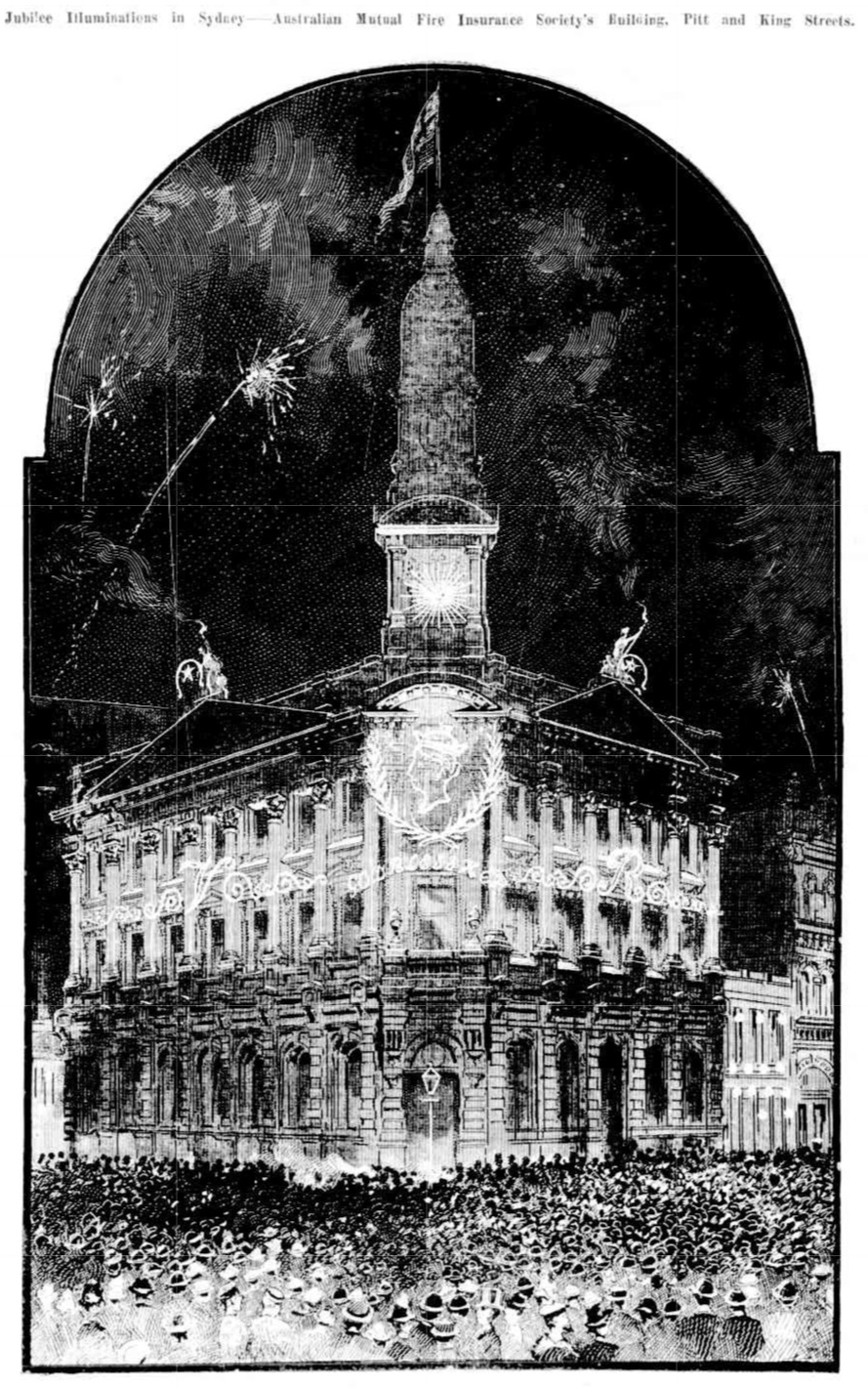
The illumination of this company's beautiful building was in complete harmony with the structure. On the King-street frontage was a large capital letter " V.," gracefully designed and flanked on either side with most elaborate treble scrolls, Italian style. On the Pitt-street face of the building was the letter "R.," beautifully worked out, and with similar scrolls as above. In the corner of the building was reserved the masterpiece of gas-illuminators' art, in the form of an immense wreath ; each leaf truly following nature's vagaries, and vieing with her in beauty ; in the centre of this was a perfect illuminated profile of her Majesty Queen Victoria, which was instantly recognised by the many thousands who viewed it, with spontaneous remarks of admiration. The Imperial Crown resting on her head was beautifully constructed in its minutest details. The motto "God Bless Her" was elaborately displayed in gas in the form of a semi-arc beneath the wreath ; each letter being true to outline. Still with all this brilliancy the upper symmetrical designs were not forgotten, and were brought out with great effort by large horseshoes ; prismatic and Brunswick stars bringing out most distinctly the handsome bronze figures facing each street which, with arms extended, held large flaming torches, setting off their beautiful outlines most admirably. The main transom window of the principal entrance was illuminated with large reflectors, bringing out the name of the society with great distinctness ; the whole combined producing a most brilliant effect. The work was designed and manufactured by Mr. Valentine Tomkins, gas engineer, 213, Clarence-street, taking many thousands of feet of tubing, and proving conclusively that our native workmen can compete with the world. Established 1872. Capital, £100,000, with power to increase to £1,000,000. Bonuses : 20 per cent, paid annually since 1873. Directors: Hon. John Sutherland, M.L.A., chairman ; William Day, Esq., J.P. 5 James Green, Esq., J.P. John Wetherill, Esq., J.P. ; Wm. Hezlet, Esq., J.P. Walter Church, manager. The Queen's Jubilee. (1887, July 2). Australian Town and Country Journal (Sydney, NSW : 1870 - 1907), p. 10. Retrieved from http://nla.gov.au/nla.news-article71086667
In 1890 John Sutherland died:
The Late Hon. John Sutherland
With deep regret we have to announce that the the Hon. John Sutherland expired at his residence, Abercrombie-street, shortly after 8 o'clock on Sunday evening. Mr. Sutherland was born in the county of Caithness, Scotland, on February 16, 1816, and ; consequently was in his 74th year. He arrived in this colony in the year 1838, and has been a colonist upwards of half a century. From the time of his arrival here Mr. Sutherland carried on the business of a builder and contractor, in which his industry and prudence found abundant and profitable occupation. Many of the finest building in Sydney some 20 or 30 years ago were erected by him, but of late years he had ceased to take a very active interest in business, and had confined his energies more to political and legislative pursuits.
Mr. Sutherland was one of the oldest, best known, and most respected of our public men. Like many others who subsequently obtained a prominent place in politics, he graduated in the municipal school. It will be remembered that in the year 1849 the affairs of the city of Sydney had got into such a disorganised condition as to be almost unworkable. A motion was brought forward in the Legislative Council, then partly elective and partly nominee, by Mr. Robert Lowe, afterwards Lord Sherbrooke. for the appointment of a select committee to inquire into the working of the Corporation of Sydney. This was agreed to, and a report was brought 'up by the committee recommending that the Act incorporating the city should be repealed, and that an Act should be passed appointing three Commissioners to act instead of the Municipal Council, in whom the powers exercised by the Council should be vested. This was afterwards done, and in the year 1853 a bill was passed dissolving the corporation and appointing three commissioners. For about three years the affairs of the city were administered by the Commissioners, but in 1856 the city was again incorporated, and aldermen were again appointed, Mr. Sutherland being one of the number, and he continued to look after the interests of the citizens in this direction until, having taken office as a Minister of the Crown, he was no longer able to give his time and attention to civic matters. As an alderman Mr. Sutherland was indefatigable in the discharge of his duties, for which his business experience and shrewd common tense eminently fitted him, and he filled the civic chair in 1861 with dignity, and liberality without ostentation.
It was in January, 1861, that Mr. Sutherland first entered the Legislative Assembly, having been elected member for Paddington in the general election by which the fourth Parliament of New South Wales under responsible government was brought into being. Redfern was then part of the electorate of Paddington, to Mr. Sutherland has practically represented the same constituency for 28 years. That Parliament lasted until November 1864, when a dissolution took place. Mr. Sutherland was re-elected for Paddington in the same month, the Ministry of Sir James Martin (tben Mr. Martin), being in power. In this Government Mr. Parkes (now Sir Henry) was Colonial Secretary until he resigned on account of a disagreement with the Premier in regard to the dismissal' of Mr. Duncan, the Collector of Customs. Mr. James Byrnes was at the same time the Minister for Works. ' When the fifth session of this Parliament met, in October, 1868, an amendment on the Address in Reply was moved by Mr. (now Sir John) Robertson, which was carried by the casing vote of the Speaker. Mr. Martin, having failed to persuade the Governor (Lord Belmore) to grant a dilution, tendered the resignation of his colleagues and himself. Mr. Robertson having been called upon to form a Government, selected Mr. Sutherland for the onerous position of Minister for Works, a position for which he was peculiarly fitted, and which gave the greatest satisfaction to the country at large. The fact that this gentleman has been called upon to fill the same position no less than five times, in different Ministries, is abundant proof that the choice made by Mr. John Robertson in 1868 was a wise and judicious one.
Mr. Sutherland was never an orator, but his utterances always commanded attention and respect, for he spoke only on subjects that he understood, and with an earnestness and evident sincerity that could not fail to convince his hearers that, even if they did not accept the arguments, they could not question the good faith of the speaker.
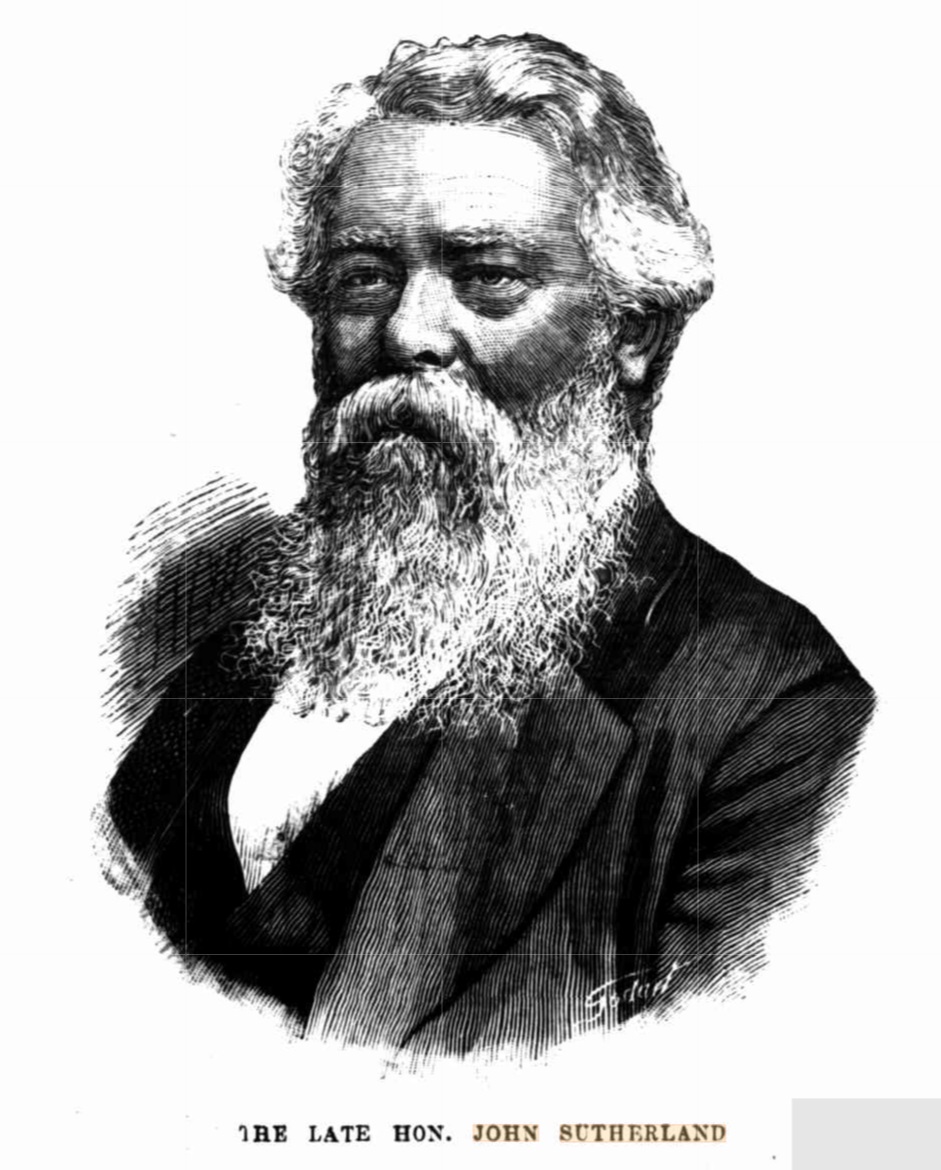
THE LATE HON. JOHN SUTHERLAND
In his office' Mr. Sutherland was a conscientious and painstaking Minister; he took nothing for granted, but looked into every matter for himself ; and his subordinates soon found that they had to deal with a man whose practical knowledge gave him a clear insight into the workings of the Department, and whose honesty of purpose and roundness of judgment prevented injustice being done to the officers on the one hnd, and the public on the other. . .
An anecdote, is told of Mr. Sutherland to the effect that while inspecting some department of the railway works, he pointed out to the officer in charge a defect which should be at once rectified. The officer said it could not be done, whereupon Mr. Sutherland literally took the matter into his own hands, and showed how it could be done, very much to the astonishment of the official.
In January, 1870, a re-constitution of the Ministry took place, Mr. Cowper becoming Colonial Secretary and Premier, and Mr. John Robertson Minister for Lands. In this Cabinet Mr. Sutherland continued to hold the position of Minister for Public Woiks, until having suffered a defeat on a fiscal question, the Government resigned their offices on December 15. The Ministry of Sir James Martin, which followed, having resigned in April 1872, Mr. Parkes formed a new Government, in which Mr. Sutherland once more accepted the portfolio of Minister for Works, and this Ministry, with a few changes in its composition, remained in office until February, 1875. Mr. Sutherland remained as a private member, being very regular and punctual in his attendance, and devoting a great deal of time to the business' of legislation.
In 1877, after a series of alternations of Government between Sir John Robertson and Sir Henry Parkes, the 'third party,' of which Mr. Famell was the head, came into power in December of that year, with Mr. Sutherland again as Minister for Works. About this time the question was raised whether Mr. Sutherland was entitled to retain his seat as member for Paddington, he being a partner in the Lilhgow Valley Iron-mining Company, which had a contract for the supply of tramway rails and other ironwork to tbe Government. The matter was referred to the Committee of Elections and Qualifications. whose decision was that Mr. Sutherland was entitled to retain his seat.
In December, 1878, the Farnell Government was defeated on the Land Bill, and resigned, and Mr. Sutherland once more retired to the position of a private member. The last time Mr. Sutherland took office was in 1887, when Sir Henry Parkes formed the twenty-fourth Cabinet since the introduction of responsible government. In this Ministry the position of Minister for Works was again offered to Mr. Sutherland, and accepted by him, although his health had already shown signs of giving way under the stress of the cares and responsibilities of official and Parliamentary life. The Government remained in office until the beginning of tbe present year, when an adverse motion for the adjournment of the House having been carried on the motion of Mr. Want the Ministry retired from office.
Since that period Mr. Sutherland's health has been such that his attendances in Parliament were very irregular, and of late he was compelled to be absent for several weeks together, and, indeed, at one time his condition was so critical that serious anxiety was felt. But when, a week or two ago, in proposing the names of the gentlemen selected by the Government to represent the Assembly on the Parliamentary Standing Committee on Public Works, Mr. Bruce Smith mentioned the name of Mr. John Sutherland, and said he was happy to announce that that Hon. gentleman had sufficiently recivered to attend to the duties, there was a burst of spontaneous cheering from all parts of the House, plain'y showing the universal respect and esteem felt for him by all sections of the House. Unfortunately, the hon. gentleman was not destined to enjoy for long the distinction to whish he was appointed, and the committee had but little benefit from his knowledge and practical experience.
Mr. Sutherland attended at the first business meeting of the committee, held on Thursday afternoon, but the effort was too much for him, for his strength was not so great as was hoped, and the malady from which he suffered had taken too great a hold on his constitution. He was worse on Friday, and unable to leave his bed. During the day he became unconscious, and remained in that condition until towards the end. Dr. Kingsbury, who had been in unwearying attendance all through the illness, on Saturday evening deemed it wise to call in Dr. Mackellar in consultation, but it was found that nothing could be done, and about eight minutes past 8 o'clock on Sunday evening the veteran politician passed away peacefully to his rest in the presence of the greater number of the members of his family.
There were few movements of a social or philanthropic character in Sydney with which Mr. Sutherland was not more or less connected. He was one of the oldest Freemasons in the colony, and he was also for very many years connected with the Oddfellows' and Foresters' Friendly Societies Technical education was a matter in which he took the deepest interest, and which be did his utmost to promote. As a member of the Board of Technical Education, he gave good and gratuitous services in endeavouring to establish facilities for tho scientific training of young workmen, before whom he stood as a fine example of the success to which industry, energy, and perseverance may attain.
Mr. Sutherland leaves a widow, one married daughter, and 10 grandchildren. In May last the 50th anniversary of his marriage took place, and among the family the 'golden wedding' was celebrated, although he was too unwell to take an active part in the rejoicings himself. Throughout his long career, as private citizen, alderman, member of Parliament, and Minister, he acquired and maintained a reputation for integrity and independence of character while his genial disposition and generous liberality gained him the esteem, and friendship of even his keenest political opponents. The deepest sympathy is felt for his family in their loss. It was arranged that the funeral should take place on Thursday afternoon. OBITUARY. (1889, June 29). The Sydney Mail and New South Wales Advertiser (NSW : 1871 - 1912), p. 1361. Retrieved from http://nla.gov.au/nla.news-article161931746
FUNERAL OF THE HON. JOHN SUTHERLAND.
The high esteem in which the deceased gentleman, Mr. John Sutherland, M.L.A., was held was amply demonstrated yesterday, when his mortal remains were conveyed from his late residence in Abercrombie-Street, Redfern, to the Necropolis at Rookwood. Long before the hour fixed for the funeral Abercrombie-Street was crowded, but even before reaching Redfern evidences of respect to the memory of the deceased could be seen in various directions. Flags were flying half-mast from many places, but notably from the Town Hall, which as an additional mark of respect was closed for the afternoon. The railway employees assembled in front of the residence in very large numbers, and all classes of the citizens, including members of both Houses of Parliament, city and suburban alder-men, Civil servants, professional and commercial men were present in scores. Many of deceased's most familiar friends were to be seen in the house, where the coffin was lying, but the house was much too small to contain all who wished to enter.
Among those present, and who joined in the funeral cortege, were-- Sir John Hay, President of the Legislative Council; Sir William Manning, Dr. Renwick, Messrs. William Walker and G A. Lloyd, Ms. L C. ; Sir John Robertson ; Mr. James H. Young, Speaker of the Legislative Assembly ; Mr. McMillan, Colonial Treasurer ; Mr. Bruce Smith, Minister for Works ; Mr. Brunker, Minister for Lands ; Mr. Gould, Minister for Justice ; Mr. Carruthers, Minister for Education ; Mr. O'Connor, Postmaster-General ; and Mr. Sydney Smith, Minister for Mines. Sir Henry Parkes was un-able to attend, and sent a letter of apology.
The following members of the Legislative Assembly were present-- Messrs. T. Garrett, J. Inglis, S. Burdekin, Howe, Barbour, W. Stephen, Hawthorne, Melville (Chairman of Committees), F. Farnell, Dalton, Paul, Wilshire, Bowman, Travers Jones, Slattery, G. R. Dibbs, J. F. Cullen, C. A. Goodchap (who returned from America yesterday, just in time to attend the funeral), and F. Abigail. The Parliamentary Standing Committee on Public Works (of which Mr. Sutherland was a member) was represented by Messrs. J. P. Abbott, M L A., chairman ; John Lackey, M.L.C., vice-chairman ; Dr. Garran, M.L.C. ; F. T. Humphery, M.L.C ; W. J. Trickett, M.L.C. ; Jacob Garrard, M.L.A. ; H Copeland, M.L.A. ; W. O'Sullivan, M.L.A. ; W. S. Dowel, M.L.A. ; J. E. Tonkin, M.L.A , J. Hurley, M.L.A. ; and the secretary, Mr. Chas. Lyne.
All the city aldermen and the town clerk, Mr. Daniels, attended in carriages. Mr. Fehon represented the Railway Commissioners. There were also present the Clerk of the Legislative Assembly, Mr. F. W. Webb ; the second assistant clerk, Mr R. W. Robertson, and the sergeant-at-arms, Mr. L. J. Harnett ; Messrs. Charles Cowper, the sheriff; John Young, C. Moore, Jos. Barling, Under-Secretary of Works, John Rea, formerly of the Works Department ; Harrie Wood, Under-Secretary of Mines, Duncan McLachlan, of the Works Department, A. C. Fraser, Under-Secretary Department of Justice ; Wm Hezlet, S. Herbert Cary, Jno. Wetherill, D Williams, Frank Bennett, J. H. Davis, Wm. Pritchard ; W. V. Reed, secretary for railways ; D. Vernon, ex-secretary for railways ; A Bridge, secretary to the Executive Council, T. R. Smith. W. F. Schey, G. T. Evans, H. M'Lachlan, Ed. J. H. Knapp, Martin Gibbons, Wm. Beaumont, and Quong Tart. FUNERAL OF THE HON. JOHN SUTHERLAND. (1889, June 28). The Sydney Morning Herald (NSW : 1842 - 1954), p. 5. Retrieved from http://nla.gov.au/nla.news-article13727349
In the Supreme Court of New South Wales.
Sheriff's Office,
Sydney, 6th August, 1894.
Wetherill v. M'Lachlan and another.
ON Friday, the seventh day of September, 1894, at noon, unless the writ of fieri facias herein be previously satisfied, the Sheriff will cause to be sold by public auction, under the verandah, Supreme Court, King-street, Sydney,—All that the one-fourth undivided share and interest of Duncan M'Lachlan and T. H. Jones, the defendants herein as executors of the will of the late John Sutherland, deceased, of, in, and to all that the equity of redemption and all other the right, title, and interest (if any) of them the said Duncan M'Lachlan and T. H. Jones, as executors as above, of, in, and to,—
All those leasehold pieces of land situate in the parish of Willougbby, and county of Cumberland, containing respectively 23 acres 2 roods 39 perches, 19 acres 2 roods 28 perches, and 11 acres 2 roods 3 perches, which said pieces of land are parts of Thrupp's grant, and are together now known as the Watersleigh Estate, North Shore, and are subject to the rent, covenants, and conditions reserved by and contained in an indenture of lease of the 13th July, 1881, and made between John Cooper therein described of the one part, and William Jonathan Green, John Sutherland, Thomas Michael Slattery, and Jane Waters all therein-described of the other part, subject to a mortgage to the Commercial Banking Company of Sydney to secure £1,800 and further advances and interest, and subject 8lso to the several indentures of underlease heretofore granted of parts of the said land.
Terms, cash. Cheques not accepted.
CHARLES COWPER, Sheriff.
L. P. Heydon, Plaintiff's Attorney, 416, George-street, Sydney. New South Wales Government Gazette (Sydney, NSW : 1832 - 1900), Tuesday 7 August 1894 (No.517), page 4962
The huge acreage encompassed in the Ramsay estate which he bought from Jenkins was one of several large holdings he had across Sydney, including blocks within the CBD. The Newington Estate was first offered to the Government for use as an Asylum for the Insane in 1874. The Government did not accept this offer, however in 1879, Government Architect James Barnett prepared a report on the suitability of the Newington estate for a Reformatory School for Boys. His report concluded that the site was suitable for a Boys Reformatory or a Benevolent Asylum for Aged Women.
In September 1897 the Crown Solicitor confirmed that 5,000 pounds would be paid to John Wetherill for the property.
Newington: In 1878, John Wetherill registered a subdivision plan for the entire 520 hectare Newington Estate. This proposal comprised an extensive grid layout, of some 114 lots, which extended well into the mud flats and mangroves of Wentworth Bay and Homebush Bay.
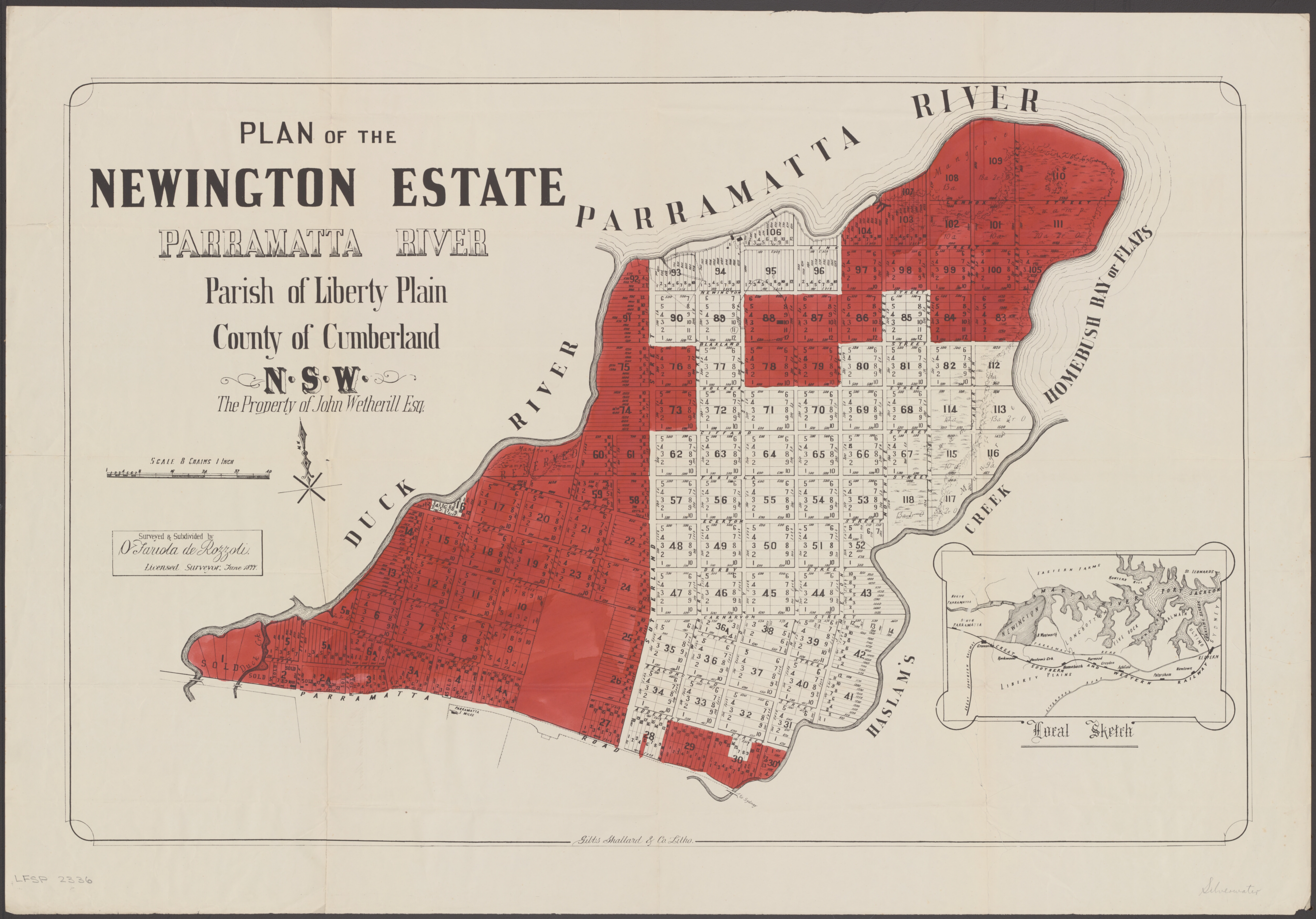
De Rozzoli, O. Fariola & Gibbs, Shallard & Co. (1877). Plan of the Newington Estate, Parramatta River, Parish of Liberty Plain, County of Cumberland, N.S.W., the property of John Wetherill Esq Retrieved from http://nla.gov.au/nla.obj-230448351
In 1906 and 1909 Wetherill further subdivided his property as Riverside Heights, with the first allotments sold in that year. It was hoped that the location of the subdivision in close proximity to the developing State Abattoirs and Brickworks would attract people to the area in association with the employment opportunities offered by these establishments. This venture was largely unsuccessful, with only a few lots being sold. However the layout of the western part of the Newington subdivision remains obvious in today's street pattern and street names.
Homebush Village: Homebush was subdivided in 1883. The subdivision affected approximately half of the Wentworth Estate and extended from Parramatta Road in the south to the Parramatta River in the north. The estate comprised some 22 large, irregularly shaped lots on a curvilinear scheme and was named the Homebush Village. Like the subdivision proposals devised for the Newington Estate, this proposal was unsuccessful. As such, the estate remained virtually intact until its resumption by the Public Works Department in 1907 for the establishment of the State Abattoirs.
WETHERILL.—March 26, at "Devon," Church-street, Randwick, Elizabeth Australia (Lizzie), the dearly beloved wife of John Wetherill, aged 59 years. Family Notices (1903, April 1). Australian Town and Country Journal (Sydney, NSW : 1870 - 1907), p. 20. Retrieved from http://nla.gov.au/nla.news-article71479713
Mr. Wetherill advertised this home from 1901 as well as advertising yet another holding, Nepean Towers, which he acquired in 1883. Nepean Towers was previously 'Parkhall' and renamed by Dr. Richard Lewis Jenkins in 1860. Dr. Jenkins came to New South Wales in 1841 as medical officer on the ship James Moran. He practised medicine on the Hunter, then owned pastoral properties on the Namoi and Peel Rivers, before moving to Sydney where he was elected to Parliament. In 1860 he retired from active Sydney life and purchased Parkhall, which he renamed Nepean Towers.
“A residence of fine freestone, built in the style of the middle Ages, castellated with towers. One of the towers, sixty feet high, and adapted for astronomical observations is a fine specimen of good masonry. The whole premises is justly considered to be one of the finest private residence in the colony, and strongly reminds the visitor of the ancestral homes of England.:”
Though Dr Jenkins had left political life, he did not retire from the intellectual or social life of New South Wales. He intended to make Nepean Towers “a centre of social, intellectual, religious, pastoral and agricultural activity.” He continued to cultivate vineyards, sowed other crops (including an unsuccessful attempt at cotton growing), and raised prize winning Durham Shorthorn cattle. He developed further the lawns and gardens and improved the grand avenue.
To the house he added the colonnades on the north and east sides, a low square tower, and a beautiful chapel. These additions were designed by the celebrated architect Edmund Blacket. A deeply religious member of the Church of England, Dr Jenkins gained a licence from the Bishop of Sydney for worship in his chapel.
Nepean Towers also became briefly the centre of social life in the colony when the Duke of Edinburgh visited in 1868, arriving by train and following the zig zag road to the property, where the social set went rabbit shooting.
Parkhall (also sometimes written as Park Hall) was to built to be the country retreat of Thomas Livingstone Mitchell, Surveyor General to succeed the ailing John Oxley. As a major on half pay, Thomas Mitchell was entitled to a grant of 2560 acres in the colony. He had selected property in the County of St. Vincent soon after he arrived in 1828, but in the next year exchanged this for land at East Bargo, in an unnamed parish that would soon be the parish of Wilton. The land was the traditional country of the Dharawal people, a place of meeting aboriginal people and for the reconciliation of disputes. Mitchell soon purchased a further 1950 acres adjacent to the grant. This was the country through which he believed the Great South Road was to pass, but a different route through the Camden area was chosen.
In memory of his happy childhood home, he dreamed of erecting a new Parkhall on the land, but nothing was done until he returned in 1841 from his visit to England. In April 1842 he was able to lay the foundation stone, with a cavity containing a parchment inscribed in Latin:
Thomas Livingstone Mitchell, Knight, Honorary of Civil Law in the University of Oxford, accompanied by Charles Nicholson, Doctor of Medicine, in the year of grace 1842, and in the reign of Queen Victoria, laid the foundation stone of this house in a land now divided from the world, but which may one day equal in all the acts of civilization the illustrious regions of his native country.
The house was patterned on ‘A Villa in the Cottage Style’ from an English book of designs described as Gothic Picturesque, with tall chimneys, pointed gables, dormer windows, crenellation, tracery and turrets. Mitchell and the builder James Hume modified the design to make it somewhat simpler, and added the observation tower. It was built with local materials: shingles cut from the bush, sandstone from Clements Creek; but it was to be a little bit of the old country in the new colony.
National Estate Listing: ‘A two storey Gothic Revival sandstone house (c. 1842-4) built for the Surveyor General Sir Thomas Livingston Mitchell, to a design from Francis Goodwin ‘s ‘Rural Architecture’ and supervised by James Hume. There is a fine geometrical stone stair with cast iron balusters, several original chimney pieces, and Mitchell Arms on the eastern gable. An arcade, tower and chapel were added sometime after 1860, Blacket being commissioned to add the arcade. Apart from its importance as Mitchell ‘s country residence, “Park Hall” is one of the last stylistically significant houses built before the depression of the early 1840s.”
On Sir Thomas Mitchell’s death in 1855, his son Thomas Octavius Mitchell inherited the property, and is said to have made some improvements to the property.
John Wetherill bought Nepean Towers in 1883 after the death of Dr Jenkins. John’s son Arthur lived there as caretaker. When he subdivided the estate in 1904, after failing to sell it as one whole, the main portion of 1720 acres was sold to the Missionaries of the Sacred Heart. They renamed the estate 'St Mary’s Towers'.:
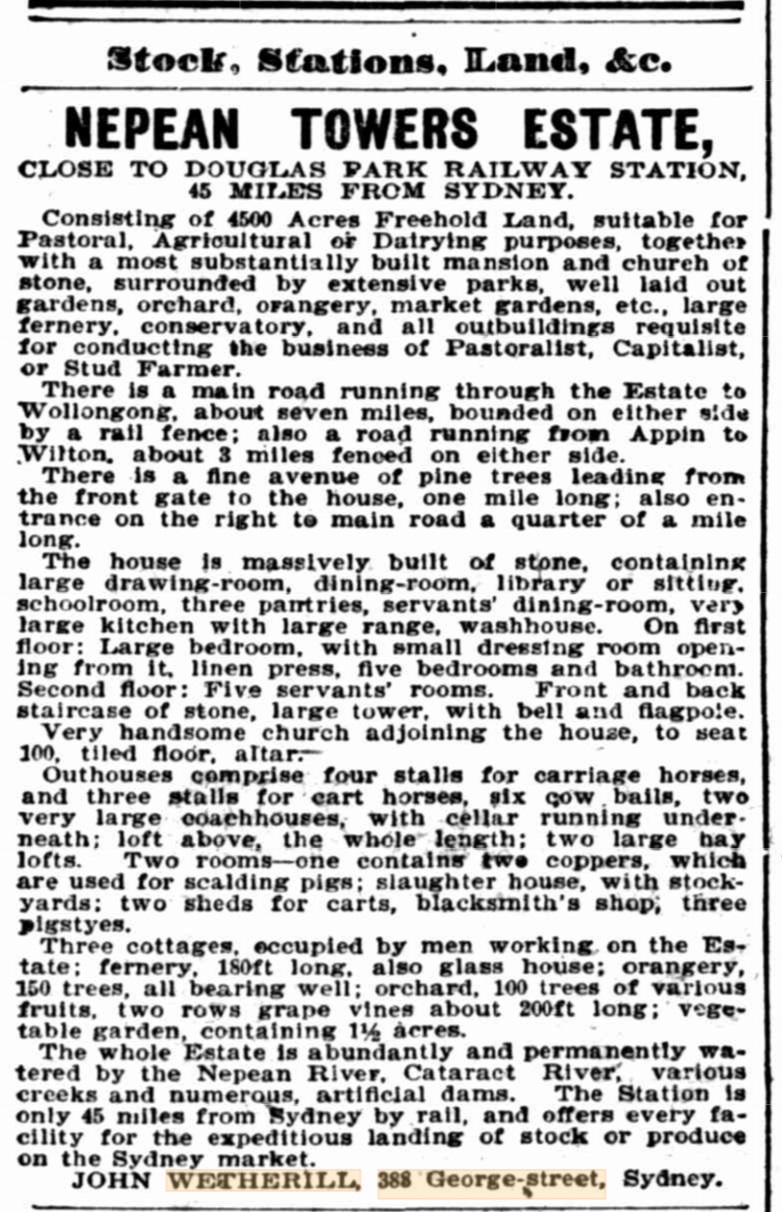
Advertising (1900, April 28). Australian Town and Country Journal (Sydney, NSW : 1870 - 1907), p. 5. Retrieved from http://nla.gov.au/nla.news-article71379744
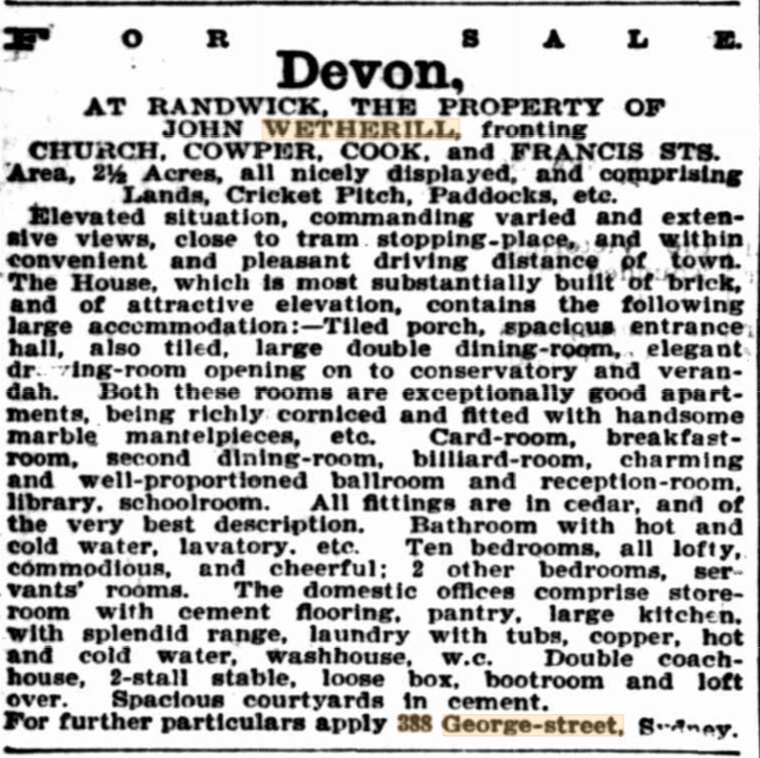
Advertising (1901, July 6). Australian Town and Country Journal (Sydney, NSW : 1870 - 1907), p. 6. Retrieved from http://nla.gov.au/nla.news-article71469174
NEPEAN TOWERS ESTATE.
CLOSE TO DOUGLAS PARK RAILWAY STATION.
45 MILES FROM SYDNEY.
4500 ACRES.
FREEHOLD LAND suitable for Pastoral, Agricultural, or Dairying Purposes, close to the SYDNEY MARKET, and a superior property for a Capitalist or Stud Farmer.
The CLIMATE and SOIL are EXCELLENT.
The House ls massively built of stone, and contains about 18 rooms and usual domestic offices. The Outbuildings are numerous, comprising 7-stall stabling, 2 coachhouses, haylofts, slaughter-house, cartsheds, piggeries, stockyards, etc., etc. Three Cottages, occupied by men working on the estate; fernery, also glasshouse; orchard, 250 trees of Various fruits, and vineyard, vegetable garden.
The whole estate ls abundantly and permanently watered by the Nepean River, Cataract River, various creeks, and numerous artificial dams. The Station is only 45 miles from Sydney by rail, and offers every facility for the expeditious landing of Stock or produce.
JOHN WETHERILL, 388 George-street, Sydney. Advertising (1901, July 6). Australian Town and Country Journal (Sydney, NSW : 1870 - 1907), p. 6. Retrieved from http://nla.gov.au/nla.news-article71469174
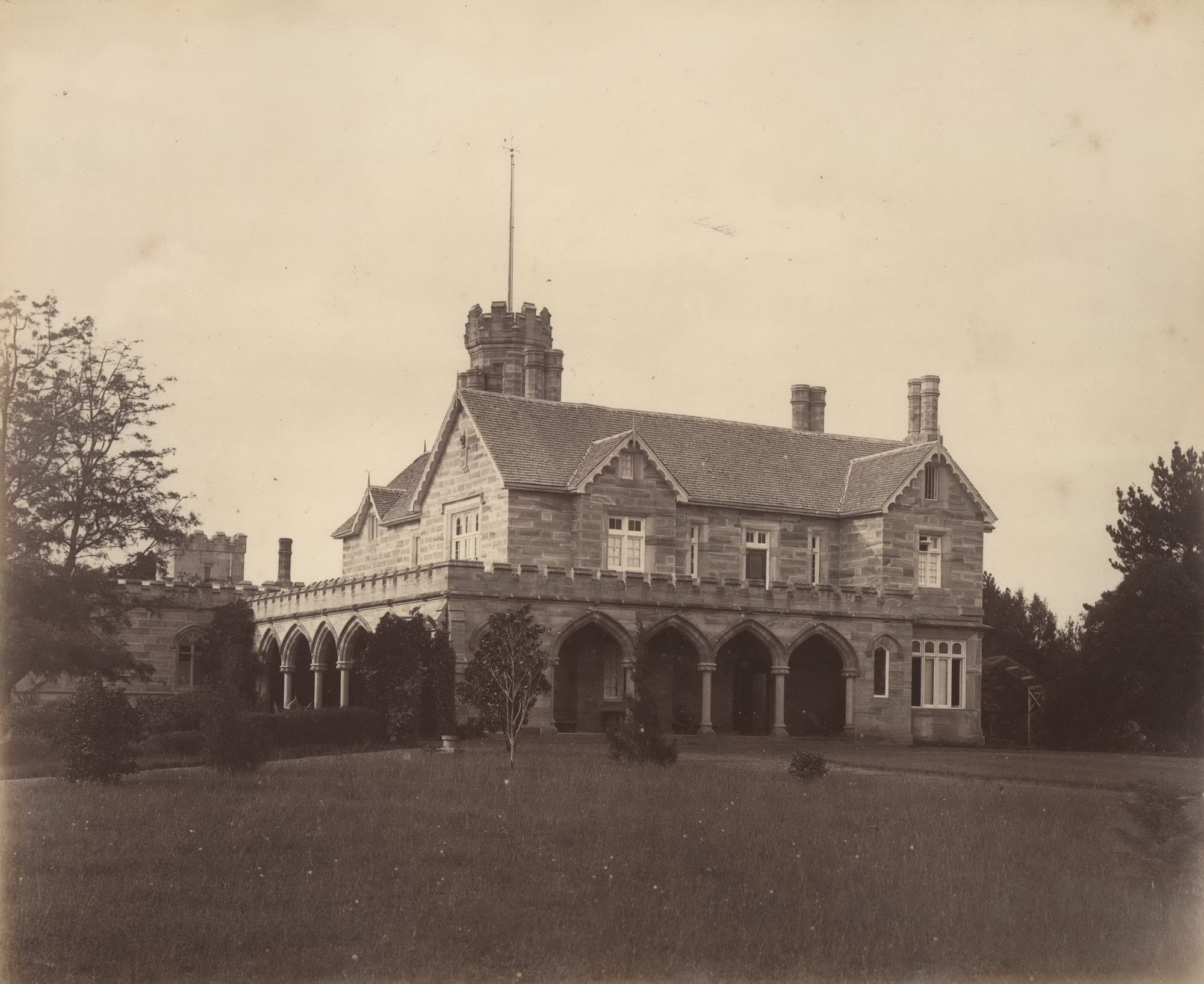
Nepean Towers, Douglas Park, NSW, circa 1870's
c1870s. Group of nine albumen paper photographs, each titled in pencil on backing below image, 22.6 x 27.8cm (approx. each). Slight foxing overall, minor dents or surface loss to edges of some, each laid down on original album page. Titles include “Dr [Jenkins’] House; Chapel, Nepean Towers; and Nepean Towers.” Some images show a party including a horse-drawn carriage, cattle with wagon and women on foot crossing a river at a ford with a footbridge. The estate and residence, built by Sir Thomas Livingstone Mitchell (c1842-1844), was originally named Parkhall after his family home in Scotland. Between 1860 and 1883 it was owned by Dr Richard Lewis Jenkins, who renamed it Nepean Towers and added the colonnades and chapel visible in some images. Images courtesy JOSEF LEBOVIC GALLERY, full album here.
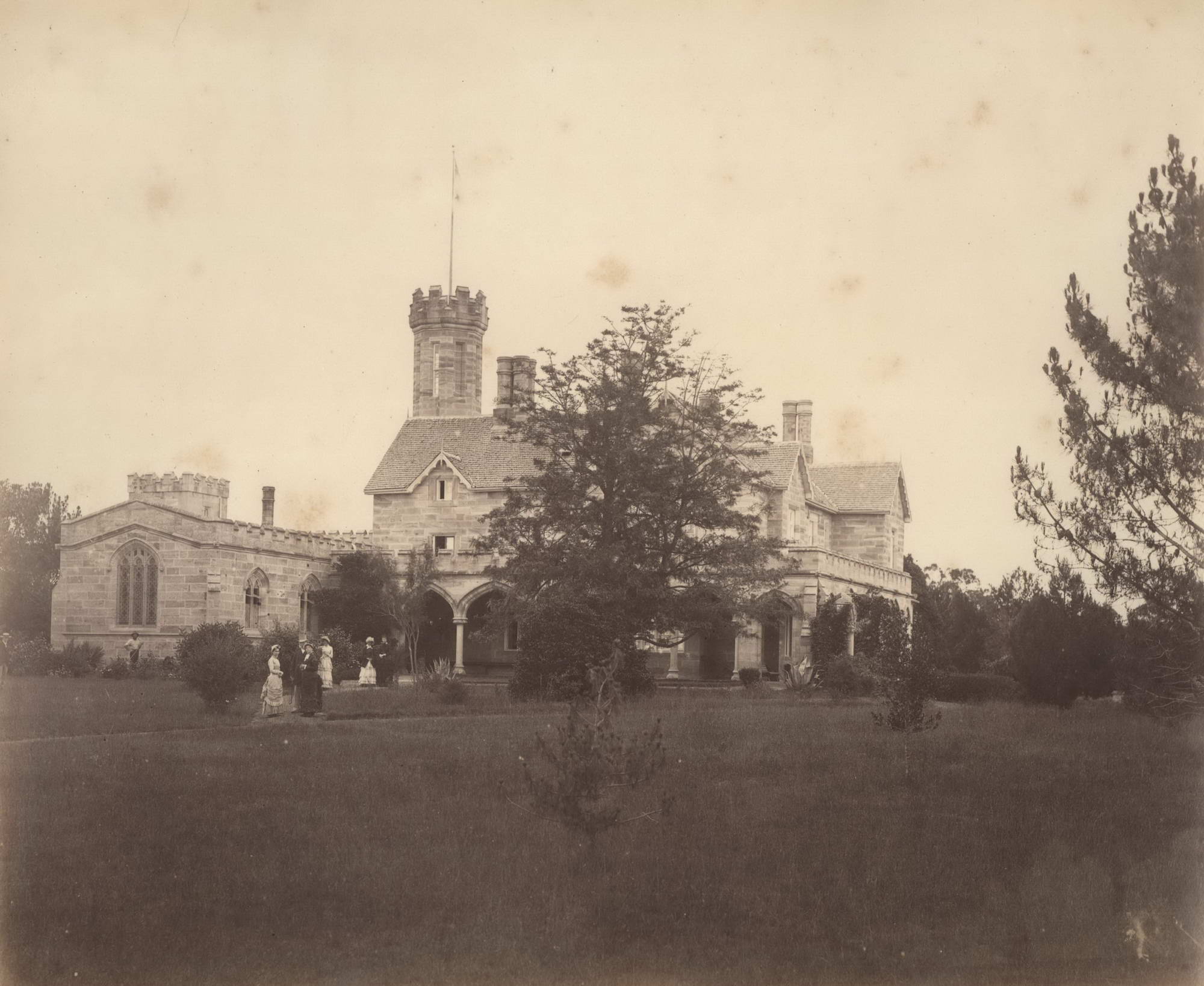
Nepean Towers, Douglas Park, NSW, circa 1870's
NEPEAN TOWERS ESTATE.
CLOSE TO DOUGLAS PARK RAILWAY STATION.
46 MILES FROM SYDNEY. 4500 ACRES
FREEHOLD LAND, suitable for Pastoral, Agricultural, or Dairying Purposes, close to the SYDNEY MARKET, and a superior property for a Capitalist or Stud Farmer.
The CLIMATE and SOIL are EXCELLENT.
The Outbuildings are numerous, comprising 7-stall stabling, 2 coachhouses, hayloft, slaughter-house, car sheds, piggeries, stockyards, &c, &c.
The whole Estate is abundantly and permanently watered by the Nepean River, Cateract River, various creeks, and numerous artificial dams. The Station is only 35 miles from Sydney by rail, and offers every facility for the expeditious landing of stock or produce.
JOHN WETHERILL.
388 George-street, Sydney.
FOR SALE - DEVON - AT RANDWICK, THE PROPERTY OF JOHN WETHERILL, fronting CHURCH, COWPER, COOK and FRANCIS STS., Area 2 1/2 acres, all nicely displayed, and comprising Lands, Cricket Pitch, Paddocks, &c.
Elevated situation, commanding varied and extensive views, close to tram stopping-place, and within convenient and pleasant driving distance of town.
The House, which is most substantially built of brick, and of attractive elevation, contains the following large accommodation:- Tiled porch, spacious entrance hall, also tiled, large double dining-room, elegant drawing-room opening on to conservatory and verandah. Both these rooms are exceptionally apartments, being richly corniced and fitting with handsome marble mantelpieces, &c. Cardroom, breakfast-room, second dining-room, billiard-room, charming and well-proportioned ballroom and reception-room, library, schoolroom. All fittings are in cedar, and of the very best description. Bathroom with hot and cold water, lavatory, &c.. Ten bedrooms, all lofty, commodious, and cheerful; 2 other bedrooms, servants' rooms. The domestic offices comprise store-room with cement flooring, pantry, large kitchen, with splendid range, laundry with tubs, copper, hot and cold water, washhousc, w.c. Double coachhouse, 2-stall stable, loose box, bootroom and loft over. Spacious courtyards in cement. For further particulars apply 388 George-st., Sydney. Advertising (1903, April 18). The Sydney Morning Herald (NSW : 1842 - 1954), p. 15. Retrieved from http://nla.gov.au/nla.news-article14573463
The late Mr. John Wetherill, who recently, died at Randwick, formerly carried on business as a draper in Pitt-street, city. He was a native of Caythorpe, Lincolnshire, England, and arrived in Sydney in the ship Bank of England about 1850. He was one of the founders of the Australian Mutual Fire Insurance Society, Ltd., and held a position as director up to the date of his death. PERSONAL. (1909, January 21). The Sydney Morning Herald (NSW : 1842 - 1954), p. 6. Retrieved from http://nla.gov.au/nla.news-article15030384
Messrs. Richardson and Wrench sold by auction, to-day, Parkham Lodge and land, Bourke-street, Surry Hills, £2000-Mr. John Wetherill purchaser; MERCANTILE AND MONEY ARTICLE. (1867, March 5). The Sydney Morning Herald (NSW : 1842 - 1954), p. 5. Retrieved from http://nla.gov.au/nla.news-article28610771
BOURKE-STREET, SURRY HILLS.-Parkham Lodge and Grounds, a commodious family residence, with 2 acres and 33 perches land, having a very large frontage to Bourke-street. By order of the Trustee of the will of the late Samuel Jones, Esq. Advertising (1866, November 9). The Sydney Morning Herald (NSW : 1842 - 1954), p. 7. Retrieved from http://nla.gov.au/nla.news-article13148887
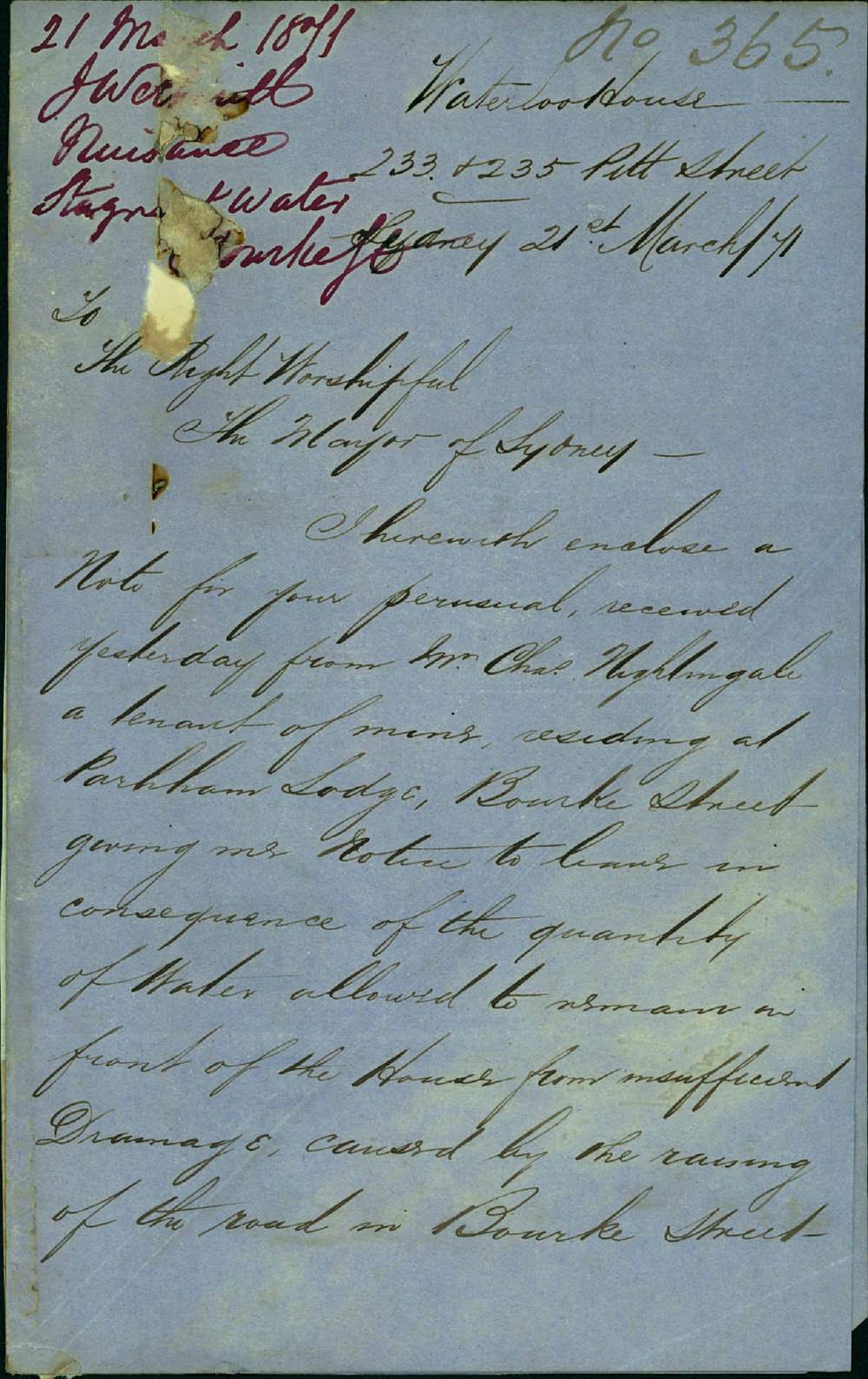
Letter: 21st March 1871- Letter: John Wetherill, Waterloo House, 233 & 235 Pitt St to Mayor. Have received notice to quit from tenant of house, Mr Nightingale at Parkham Lodge, Bourke St, due to raising of road and lack of drainage. (Letter Mr Nightingale: knee deep water, compelled to leave Fri & Sat over hills at rear, silt washed down path and blocked gates, took an hour to clear sand from gates. Will leave, happy to assist with access for prospective tenant) Note: 1. acknowledged 2. report. 3.Thos H Bradridge, City Surveyor report: filling of Bourke St to adopted level prevented rain from escaping as formerly, since letter, a trench dug, now better than previously.From City of Sydney Archives
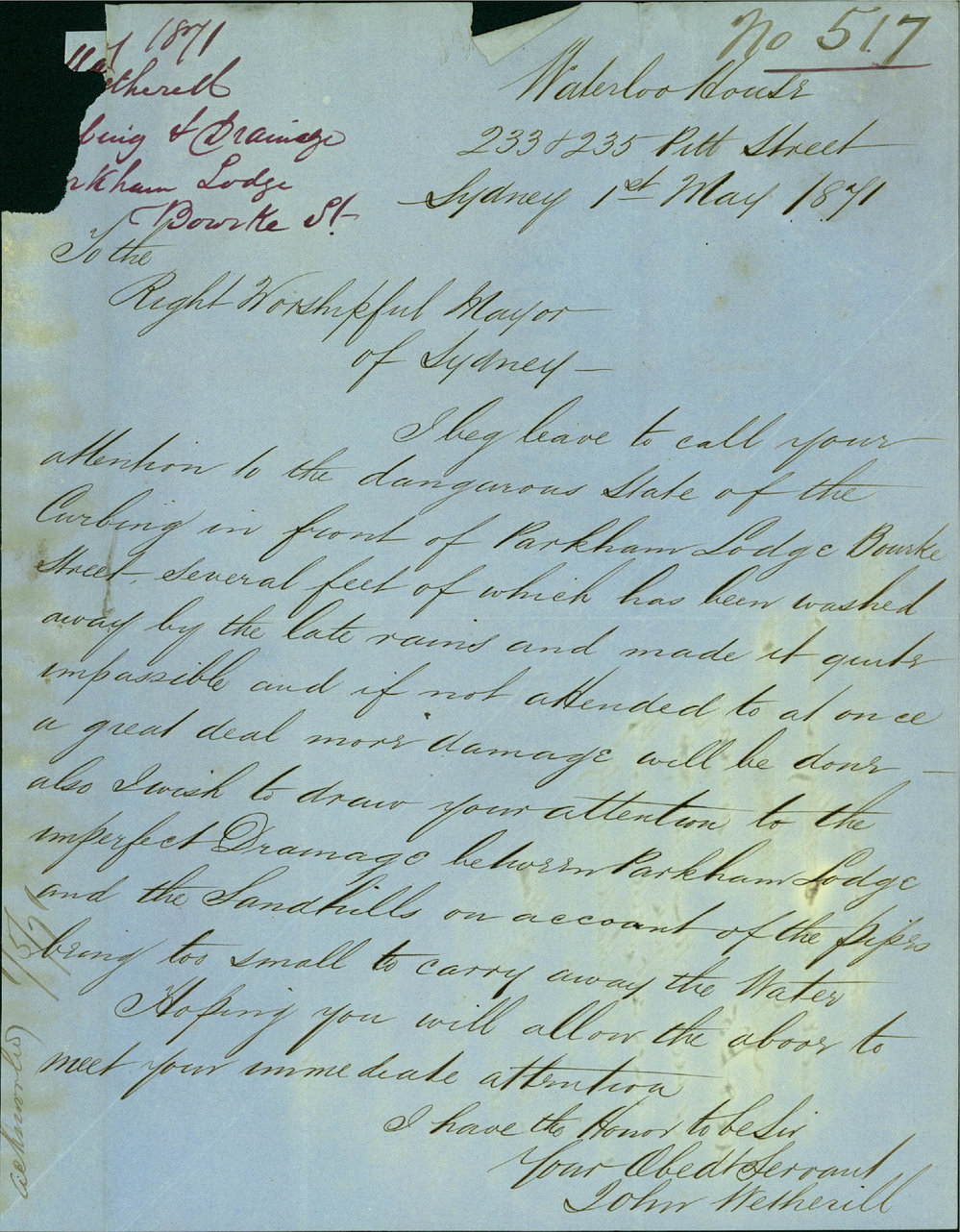
1871 May 1st: Letter: John Wetherill, Waterloo House 233 & 235 Pitt St to Mayor. Call your attention to dangerous state of curbing in front of Parkham Lodge, Bourke St, several feet of which have been washed away.There will be more damage as the pipes to the sandhills are too small. Notes:1. Acknowledged; 2.Surveyor: drainage attended to, a trench cut to relieve his property of the surface water, k&g reset within 2 days of that letter; 3. carried out. From City of Sydney Archives
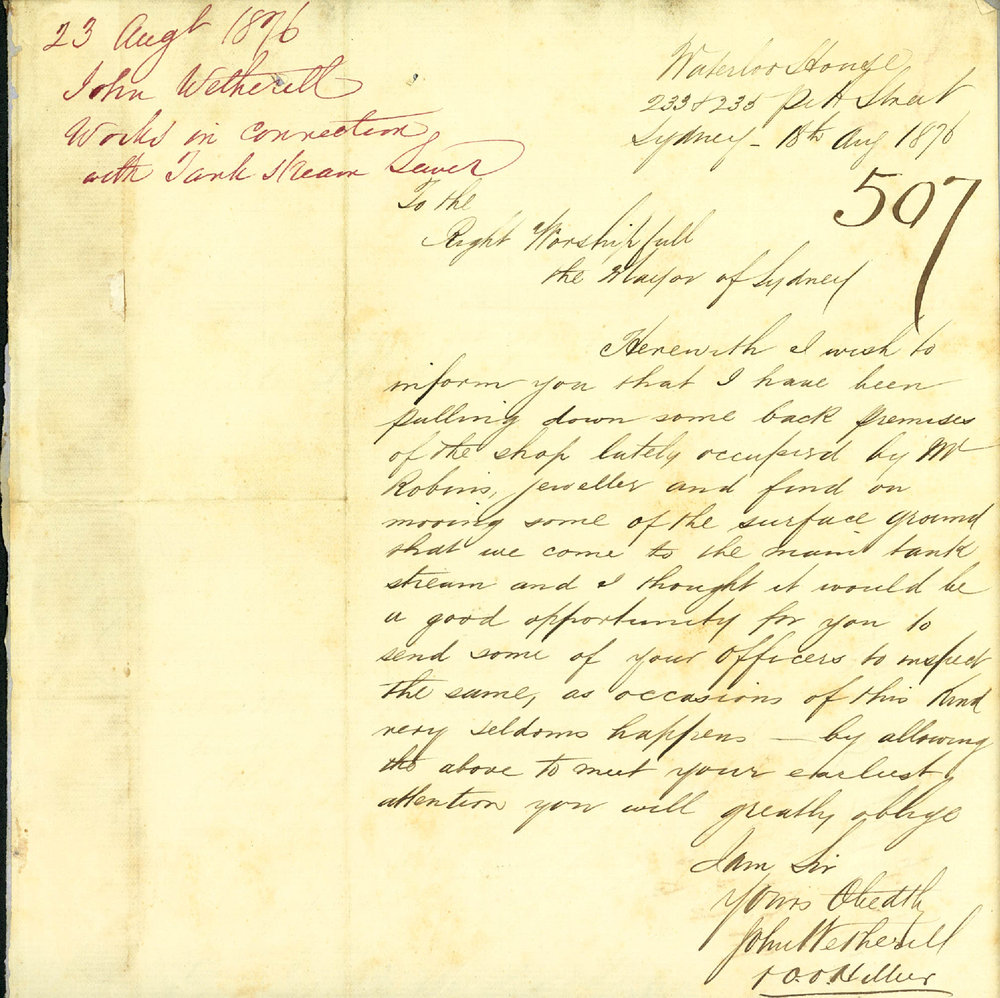
Letter : 18th August 1876 Letter. John Wetherill, Waterloo House 233 & 235 Pitt Street offering the opportunity for Council Officers to inspect the main tank stream which has been revealed during building work in the shop. Alfred Morris, Assistant City Engineer, submits a report to the Mayor following an inspection by Dogherty. From City of Sydney Archives
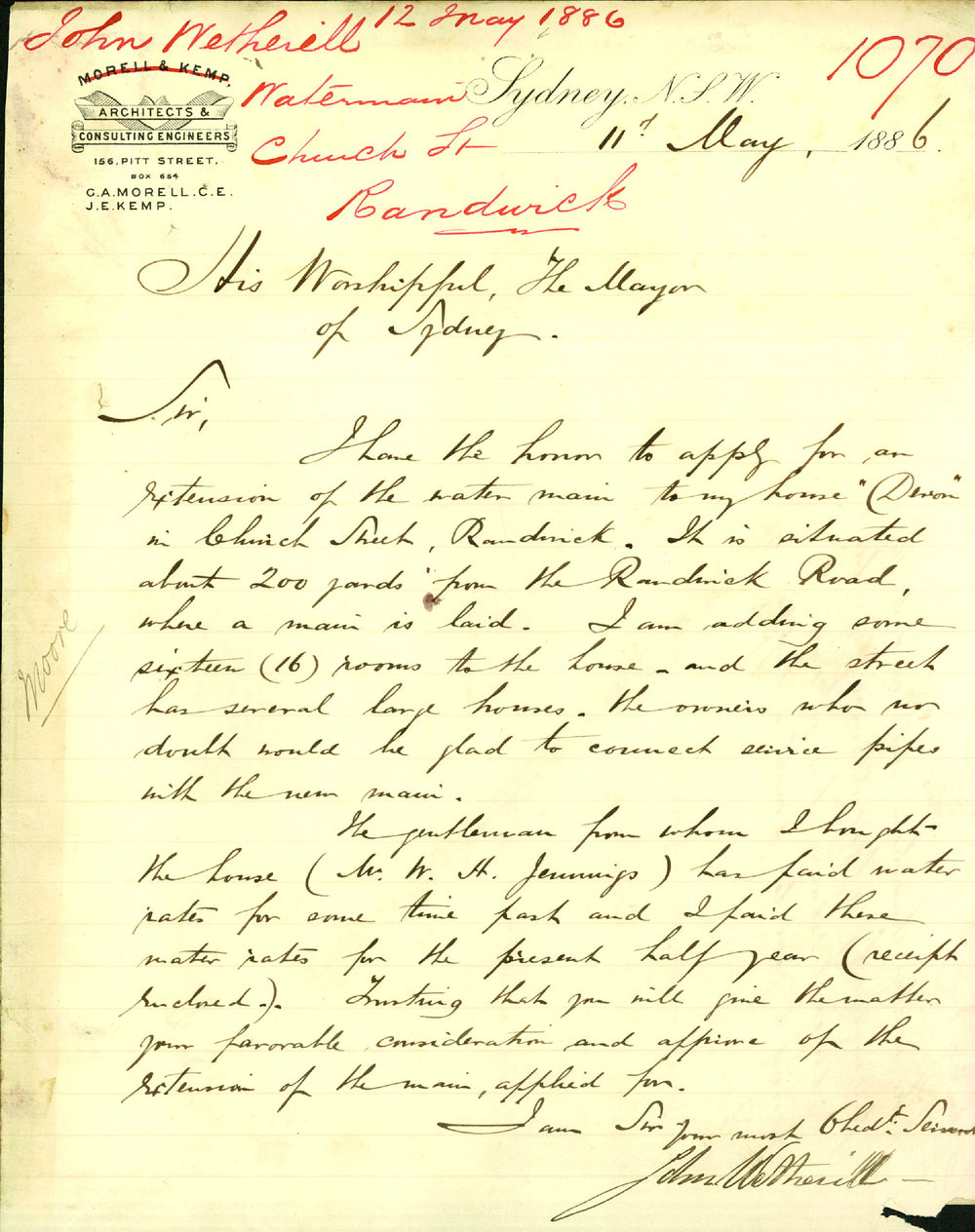
Letter: 10th May 1886- Letter: John Wetherill to Mayor. Apply for extension of water main to my house "Devon" in Church St Randwick, abt 200 yds from the Randwick Rd where a main is laid. Am adding 16 rooms and the street has several large houses who would be glad to connect. I bought the property from Mr W H Jennings who has paid water rates. Notes: rate notice £1/16/9 ½ yr for 21 rooms at 3/6 p.a.; City Eng: water by a long service pipe laid by original owners, now gives too small a supply; done by Mayors orders. 332 yds 4" main. From City of Sydney Council Archives.
William Henry Hocking Jennings, contractor, according to an extensive article by Mary Salmon ('Randwick and Coogee, Evening News, July 16, 1904), built 'Devon'. Mary reports in her article that 'Devon' is now owned by 'the bank' - which bank is not stated; '' Mr. Wetherill, the draper's, built by Mr. William Jennings, the contractor, known as 'Devon,' now owned by the bank;'' - THE SUBURBS OF SYDNEY. (1904, July 16). Evening News (Sydney, NSW : 1869 - 1931), p. 3 (EVENING NEWS SUPPLEMENT). Retrieved from http://nla.gov.au/nla.news-article113293329
The acreage and house was subdivided a few years later - you can see what appears to be the outline of 'Devon' in this lithograph - no photos of what reads like an outstanding building could be found:
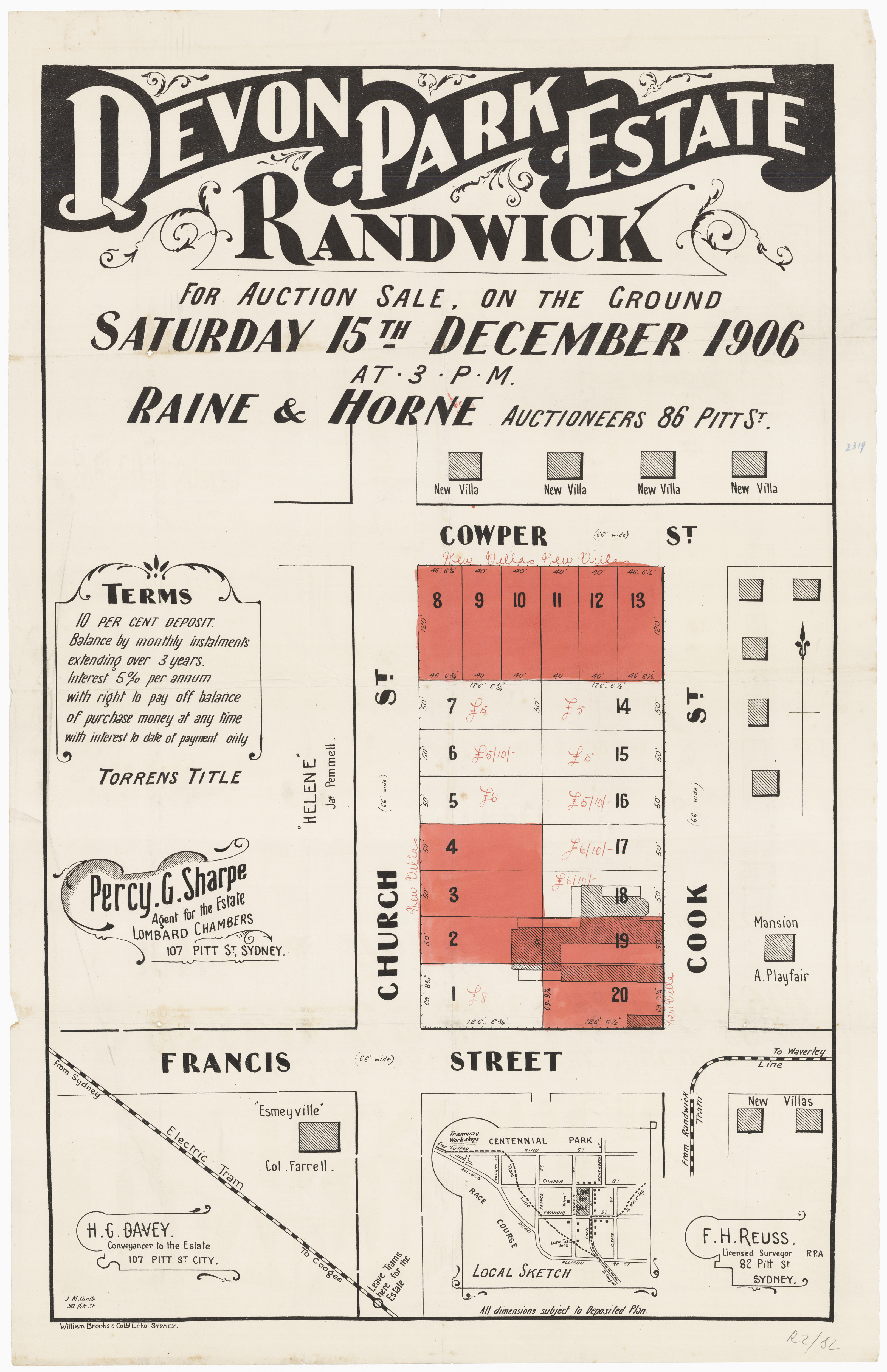
Devon Park Estate, Randwick - Francis St, Church St, Cowper St, Cook St, 1906 Item ; c054760092 - from the Randwick Subdivisions collections of the State Library of New South Wales.
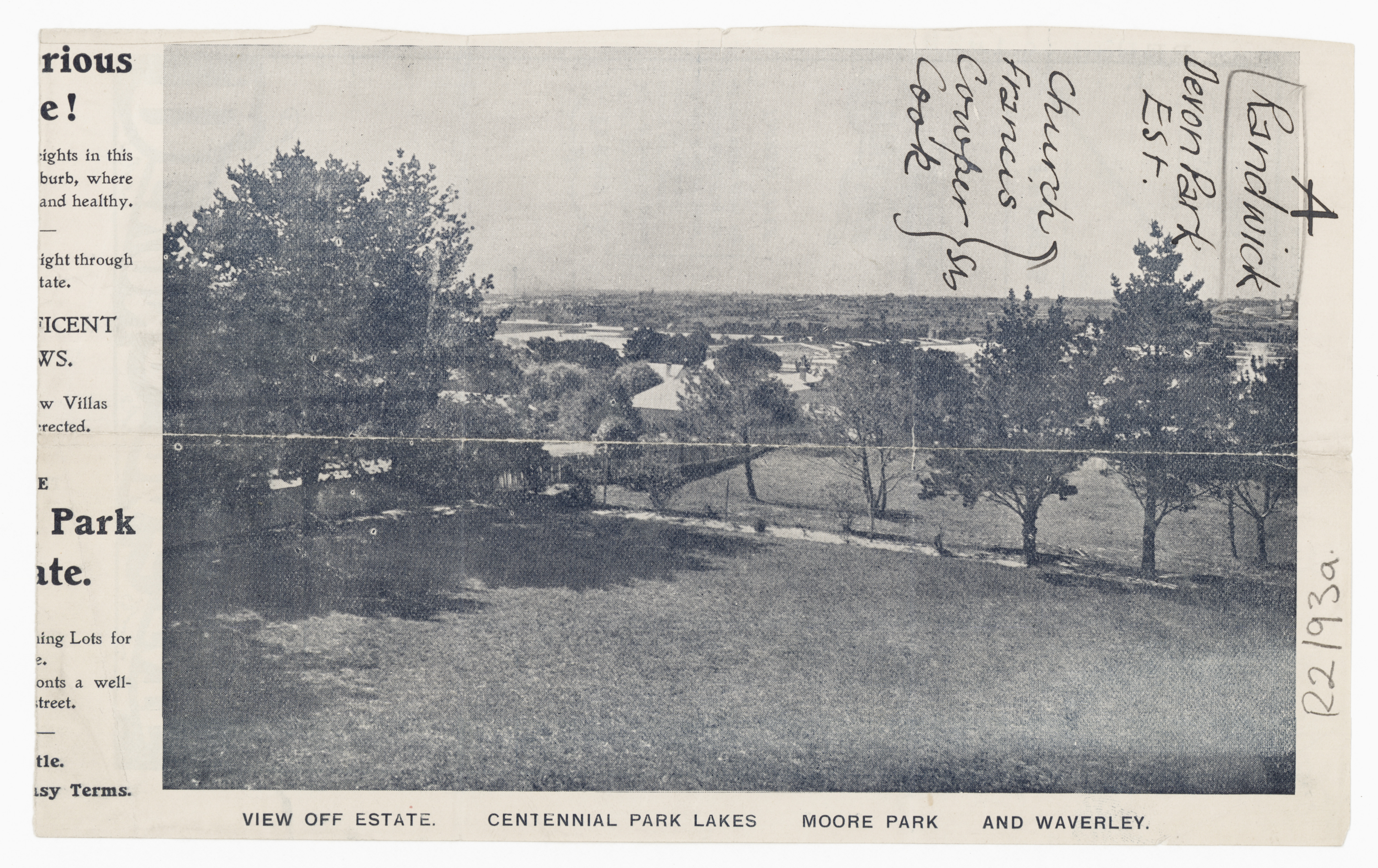
Devon Park Estate, Randwick - No boundaries shown (no date either) View off estate. Item c054760104 - from the Randwick Subdivisions collections of the State Library of New South Wales.
William Jennings also served as an alderman for Randwick:
BOROUGH OF RANDWICK.
NOTICE is hereby given that William H. Jennings, has been duly elected as Alderman for West Ward of this Borough.
GEORGE DENNING,
Randwick, 14th January, 1885. Returning Officer. BOROUGH OF RANDWICK. (1885, January 20). New South Wales Government Gazette (Sydney, NSW : 1832 - 1900), p. 589. Retrieved from http://nla.gov.au/nla.news-article221623376
John Wetherill's boys, as can be seen by the reference to a cricket ground/pitch at Devon, were involved in cricket in the area. TROVE searches provide numerous references to them being part of the local cricket scene:
CRICKET
On Thursday Fairlawn Grammar School met Woollahra Public School, the resuts being a win for the latter by five runs. Scores: 32 and 37. For Woollahra, Howard scored 9 and Fernando 7; Lloyd 11, Barns 8, Wetherill 7, for Fairlawn. Davies (Fairlawn) was the most successful, bowler, capturing seven for 21. Cricket. (1894, December 10). The Australian Star (Sydney, NSW : 1887 - 1909), p. 8. Retrieved from http://nla.gov.au/nla.news-article227493055
CRICKET
Club secretaries are notined that teams for insertion in Friday's issue must reach this office by noon on Thursday to insure publication. Reports of Saturday's matches should be sent In not later than the Monday, and each report must be signed by the captain or the honorary secretary of one of the clubs. In each of the matches appended, teams have been chosen as. follow to represent the first-named club tomorrow:
Randwick.Glenmervyn v. Newtown Ferngrove, on latter's wicket.— Anderson,- Phelan (2), Fisher (2), Robertson, Jones, Wetherill, Hermann, Neal, Somers, Woods (12), Powell (13). (Meet ' 1; 30 tram from Randwick, at Liverpool -street.) CRICKET. (1899, September 22). Evening News (Sydney, NSW : 1869 - 1931), p. 2. Retrieved from http://nla.gov.au/nla.news-article113259087
CRICKET
The annual match between Randwick and Waverley Borough will take place to-day at the Randwick Oval. The following will represent Randwick; Stubbin, Wetherill, J. Shiels, Woods, Austin, Scott, Bullett, Heselhurst, Tucker, Graham (12).CRICKET (1903, January 1). The Daily Telegraph (Sydney, NSW : 1883 - 1930), p. 8. Retrieved from http://nla.gov.au/nla.news-article237410933
The above is also (Tank Stream opportunity and invitation) another instance of John Wetherill's interest in History and pride in his new home. Even though he was still in his birth land when this item appears in local newspapers, it is some indication that what seems a far distant event when he was naming the streets in that first Long Reef-Collaroy-Narrabeen Mount Ramsay subdivision, these events were what he grew up surrounded by:
THE WATERLOO BANQUET
The anniversary of Waterloo was celebrated on Saturday, the 18th of June, by the customary banquet at Apsley-house, given by the Duke of Wellington to the officers who took part in that memorable battle. As upwards of a quarter of a century has elapsed, it yearly becomes of additional interest, not only to those moving in the military circles, but the nation at large.
The sumptuous entertainment given by the noble and gallant Duke on Saturday was graced by the presence of his Royal Highness Prince Albert, who, with the single exception of the Marquess of Exeter, groom of the stole to his Royal Highness, m attendance on the Prince, was the only personage in the party who was uot actually present in either of the actions of the 16th,17th,-or 18th of June, 1815.
Covers were laid for eighty persons, the noble and gallant. Duke presiding, with His Royal Highness Prince Albert on his right and the Marquess of Anglesey on his left, the noble marquess being the next senior Waterloo officer to the gallant host.
The fine band of the Grenadier Guards, the duke's regiment, who during the arrival of the guests performed' in the vestibule, was stationed in an ante-room communicating with the gallery.
At a quarter to nine o'clock dessert was placed on the table, the beautiful service of Potsdam china, a gift from the late King of Prussia, being used on the occasion, with a service entirely of gold.
The health of her Majesty the Queen was then proposed by the noble duke, which was enthusiastically honoured, the band playing the national anthem.
His Grace then gave his Royal Highness Prince Albert, a toast which was similarly honoured.
His Royal Highness Prince Albert then rose and proposed " the health of the Duke of Wellington."
The next toast given was that of "The Marquess of Anglesey" by the Duke, to which the gallant Marquess responded.
The noble host then proposed "Lord Hill and the British Army ;" after which was given " The heroes who fell at Waterloo." Drunk in solemn silence.
"The health of Prince Castelcicala, the Neapolitan minister," was the succeeding toast, to which his Excellency replied.
The other toasts of the evening were" Sir Henry Hardinge, Lord Seaton, Sir Charles B. Vere, and Sir Peregrine Maitland," which were respectively acknowledged by those gallant officers.
The Locking-in Controversy.(From the Rev. Sidney Smith.)-The following letter cannot, consistently with justice to our readers, be withheld from them. They must laugh, of necessity, at its quaintness. It is in reply to Sir Robert Peel's allusion to the reverend writer in the railway debate of Saturday :
" To Sir Robert Peel. A cruel attack upon me, Sir Robert, to attribute all my interference with the arbitrary proceedings of railroads to personal fear. Nothing can be move ungrateful and uukind. I thought only of you and for you, as many Whig gentlemen will bear me testimony who re-buked me for my nnxiety. I said to my-self and to them, ' Our lovely and intrepid l minister may be overthrown on the rnil. The locked door may be uppermost. He will kick and call on the speaker and sergeantiat-arms in vain. Nothing will remain of all his graces, his flexibilities, bis fascinating, facetious fun, his social warmth ; nothing of his flow of soul-of his dear heavy pleasantry-of his prevail-ing sk'll to impart disorderly wishes to the purest heart ; nothing will remain of it all but a heap of ashes but the parish chuTch of Tamworth. He perishes at the moment that he is becoming as. powerful in the drawing-room of court as in the House of Parliament-at the moment when Hullah (not without hopes of ultimate success) is teaching him to sing, and Melmot to dance.' I have no doubt of your bravery, Sir Robert, though you have of mine ; but, then, consider what different lives we have led, and what a school of courage is that troop of yeomanry at Tamworth, the Tory fencibles. Who can doubt of your courage who has seen you at their head, marching up Pitt-street, through Dundas-square, on to Liverpool-lane, and looking all the while like those beautiful medals of Bellona Frigida and Mars sine Sanguine, the very horses looking at you as if you were going to take away three per cent, of their oats. After such speeches as these, the accouut you give of your own courage cannot be doubted. The only little circumstance which I cannot entirely recon-cile to the possession of this very high attribute in so eminent a degree, is, that you should have selected for your uncourteous attack enemies who can-not resent, and a place where there can be no remedy. I am, Sir, your obedient servant, Sydney Smith."- [The following is the passage in Sir Robert Peel's speech, which has called foi th the above rejoinder :-" He repeated, however, that he did not think that it would be expedient to legislate on the sub-ject, but by far the best course to pursue was, to let public opinion, which generally acted in the right direction, operate on the railway companies, and he had little doubt but that would soon set the matter right. If there should happen to be any old ladies or ecclesiastics-(Laughter)- who were so. excessively timid as to be afraid to be locked up in a carriage, he had no doubt that after a short time the railway directors and those persons would settle it between them. He believed that, with the greatest security, the nature of the suggestions or recommendations to be made to the rail-way companies would be best left to the direction of the board of trade, assisted as their opinions would be by the advice of such destinguished officers as Sir Frederick Smith and Colonel Pasley. (Hear.) "
Hamburgh-The Queen's Letter.
-Hamburgh, June 20 : The senate having written to her Majesty the Queen of Great Britain, expressing their grati-tude for the sympathy shown by her. Majesty by sending tents and blankets, and by opening a subscription for the relief of the sufferers by the fire, her Ma-jesty has been pleased to return the fol-lowing gracious answer:-"Victoria, by the grace of God, Queen of the United Kiiigdom of Great Britain and Ireland, defender of the Faith, &c, &c, to the Burgomasters and Senate of the free Hanseatic city of Hamburgh, sendeth greeting. Our good friends,-We have received the letter which you addressed to us, on the 24 th ultimo, expressing your gratitude for the assistance furnished from this country to the Bufferers by the late calamitous fire at Hamburgh. In acknow-ledging andithanking you for the senti-ments of friendship and attachment which are contained in your letter, we assure you that we most sincerely sympathise iu the distress with which so many of the inha-bitants of your ancient city have been overwhelmed by this awful calamity ; and that it has afforded us real pleasure to be enabled to contribute, in some manner, to their relief. In the hope that, by the aid of Divine Providence, yon may succeed iii speedily repairing the effects of the deso-lation which has fallen upon you, we recommend you to the,protection of the Almighty.-Given at our Court, at Windsor-castle, the 8th day of June, in the year of our Lord, 1842, and in the fifth year of our reign. Your good friend, Victoria Reg.-Aberdeen. THE WATERLOO BANQUET. (1842, November 5). The Sydney Morning Herald (NSW : 1842 - 1954), p. 4. Retrieved from http://nla.gov.au/nla.news-article12425339
His sons Daniel and William carried on the subdivisions of land holdings after his death. His surviving children married and had children of their own.
WETHERILL—FENTON.—November 7, at St. Michael's, Moore Park, by the Rev. J. S. Fenton, brother of the bride, assisted by the Rev. Dr. Manning, Daniel Holborow, eldest son of John Wetherill, of Devon, Randwick, to Dinisha Sara, youngest daughter of James Fenton, 71 St. John's-road, Forest Lodge. Family Notices (1895, November 23). The Sydney Morning Herald (NSW : 1842 - 1954), p. 1. Retrieved from http://nla.gov.au/nla.news-article14026066
WETHERILL—BROWN.—July 27, at Christ Church, Sydney, by the Rev. Gerard Trower, M.A., William Ernest Wetherill, second son of John Wetherill, of Devon, Church-street, Randwick, to Amy Adelaide Brown, third daughter of Jabez Brown, of Louieville, Church-street, Randwick. Family Notices (1898, August 13). The Sydney Morning Herald (NSW : 1842 - 1954), p. 1. Retrieved from http://nla.gov.au/nla.news-article14182107
Sons Marriages (further):
3943/1913 WETHERILL ARTHUR E BOWMAN EILEEN M WOOLLAHRA
10827/1920 WETHERILL PERCY G TEMPLEMAN MILLICENT A SYDNEY
Just as Narrabeen honours his presence in Narrabeen by the street named for him, Wetherill Park in Fairfield was named after John Wetherill, businessman, who offered 21 acres (85,000 m2) of his property to the State government as a park. A characteristic of Wetherill Park is that all the streets are named after famous writers. Some examples include: Vidal Street (for Gore Vidal), Shakespeare Street (for William Shakespeare), Stevenson Street (for Robert Louis Stevenson), Locke Street (for John Locke), Gogol Place (for Nikolai Gogol), Swinburne Crescent (for Richard Swinburne), Homer Place (for Homer), Emerson Street (for Ralph Waldo Emerson), Wordsworth Street (for William Wordsworth), Dickens Road (for Charles Dickens), Longfellow Street (for Henry Wadsworth Longfellow), Chaucer Street (for Geoffrey Chaucer), Ainsworth Crescent (for William Harrison Ainsworth), Coleridge Road (for Samuel Taylor Coleridge), Frost Close (for Robert Frost), Gissing Street (for George Gissing), Maugham Crescent (for Somerset Maugham) and Langland Street (for William Langland).
FOR CITY GIRLS holiday home
MEMBERS of the City Girls Amateur Sports Association have completed negotiations for a week-end holiday house at Narrabeen. "Palm Cottage" is an ideal place for a holiday, with the ocean in front and the big lake at the back. The creeks, too, offer pleasure to those whose fancy turns to quiet, inland waters. Mr. T. West, who built "Palm Cottage," went to Narrabeen in 1884, and from almost the whole coastline chose the site because it provided such an unusual vista of the sea. The house will accommodate 12 girls for each week-end, and it will probably be used for holidays also.

PALM COTTAGE The house at Narrabeen which has been secured by the City Girls' Amateur Sports Association for a week-end resort.FOR CITY GIRLS (1926, March 1). The Sun (Sydney, NSW : 1910 - 1954), p. 13 (FINAL EXTRA). Retrieved fromhttp://nla.gov.au/nla.news-article224055821
City Girls
New Holiday House At Narrabeen
PALM Cottage, one of the oldest houses In Narrabeen, Is to be the scene of many happy weekend parties for the City Girls' Amateur Sports Association. The cottage is large, and rambling, surrounded by wide verandahs, and stands on a bill, overlooking the ocean beach on one side and the Narrabeen Lakes on the other. It is an ideal place for large parties of club girls, the ample balcony space making It possible to accommodate unlimited numbers of camp stretchers for sleeping out, while a specially glassed-in portion will lend itself to the use of long, trestle dining-tables, to seat at least 20 girls.
The lawns surrounding the house are excellently suited for circles courts and basket-ball. Already a number of clubs affiliated to the C.G.A.S.A. have booked up week-ends well into the winter, for the colder weather will make no difference, as the charm of boating on the lakes and tramping into the woods surrounding them will afford sufficient interest as a substitute for the joys of surfing. Each girl, with a minimum number of eight, will be charged five shillings for a party. At present there is only accommodation for twelve, but, as the popularity of Palm Cottage grows, the association will be prepared to arrange for further accommodation. City Girls (1926, March 11). The Daily Telegraph (Sydney, NSW : 1883 - 1930), p. 4 (The Daily Telegraph Woman's Supplement). Retrieved from http://nla.gov.au/nla.news-article245839929
It is worth noting that the Houston family of doctors associated with John Wetherills' first wife Ellen do not appear to be related to the Houstouns of Johnstone and Renfrewshire with which Sir George Houstoun Reid (1845-1918), premier, prime minister and high commissioner, had been named to honour.
In his autobiography, 'My Reminiscences (1917)' Sir G H Reid states; ''I was born in Johnstone, near Paisley, in 1845, on February 25th. My name-father—English people say godfather—was the Member for Renfrewshire, Mr. George Houstoun.''
This George Houston was the son of Ludovic and Ann, born on the 31st July 1810. He attended Eton and in 1828 matriculated at Christ Church, Oxford. He was an officer in the Renfrew Yeomanry Cavalry and in 1831 was commissioned as Captain. He was a Conservative candidate in the Parliamentary elections in 1835 for the County of Renfrew but lost by 68 votes to Sir Michael Shaw Stewart. Sir Michael died early in 1837 and George won the subsequent by election by 170 votes. Later that year there was a general election and he again won the seat. He remained an M.P. until 1841 when he decided not to stand again in the coming election.
George was the heir apparent to the Lairdship however in 1843 he collapsed and died whilst on a shoot at Invercauld in Aberdeenshire. In the transept of Paisley Abbey there is a plain stone tablet, executed by Mossman, over his grave surmounted by a sand glass which is inscribed “George Houstoun, only child of Ludovic Houston and Ann Stirling of Kippendavie – born 31st July 1810, died 14th September 1843.”
Sir Reid's father, Presbyterian minister John Reid, moved to Johnstone, Renfrewshire, in April 1841, where he stayed for four years, three of his children were born there; Hugh Ronald (b. 1841 in Johnstone), Mark Watt (b. 1843 in Johnstone), George Houstoun (b. 1845 in Johnstone). So Mark was born prior to George Houstouns' death, while George was born to honour a man and family that did much for their community.
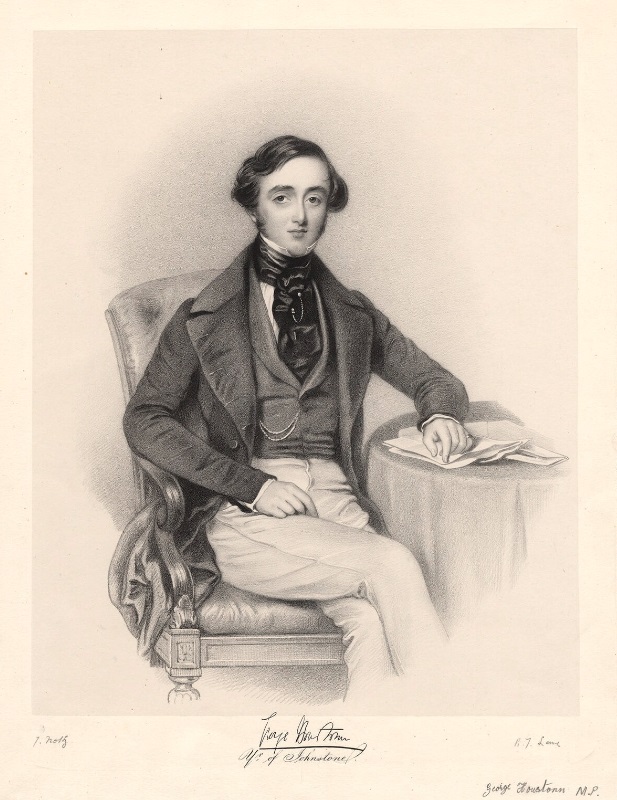
George Houston (1810-1843), Politician; MP for Renfrewshire. by Richard James Lane, after Johannes Notz stipple engraving, 1830s-1840s, 15 in. x 11 7/8 in. (380 mm x 303 mm) paper size. Given by Sir Sydney Hugo Nicholson, 1924. Reference Collection: NPG D3275 - courtesy National Portrait Gallery, St Martin's Place, London. © National Portrait Gallery, London
Sir George Houstoun Reid was one of our 'Federation Fathers'. In 1901, when Australians were voting for their first Federal Senator representatives, with polling booths at Narrabeen, Pittwater, Greendale and Manly, he was among them, easily winning East Sydney.
FATAL BOLT
Lad Kicked As He Fell From Horse
Raymond Alexander Hudson, 17, a dairy-hand, of Nareen-parade, Narrabeen, was killed last night in a fall from a bolting horse.
Raymond George Clark, who was riding with him in Pittwater-road, and who raced after him when his horse bolted, heard Hudson scream as he fell from the saddle. In falling, he was either kicked In the head or trodden on. A hoof-mark was found on his forehead, his skull being fractured. He died on the way to Manly Hospital. Hyson's 10-months-old brother Keith is in Sydney Hospital with a tack in one of his eyes. FATAL BOLT (1932, June 30). The Sun (Sydney, NSW : 1910 - 1954), p. 28 (FINAL EXTRA). Retrieved from http://nla.gov.au/nla.news-article230116387
LOCAL GOVERNMENT ACT, 1919
Suspension of Provisions of Warringah Planning Scheme in Respect of Certain Land Within the Shire of Warringah and Notification of Interim Development Order No. 2—Warringah Made in Respect Thereof
WHEREAS a resolution of the Warringah Shire Council for the preparation of a Town and Country Planning Scheme (hereinafter called the Varying Scheme) under Part XIIa of the Local Government Act, 1919, to vary the Warringah Planning Scheme (hereinafter called the Prescribed Scheme) was passed by the Council on 6th August, 1963; and whereas, after consideration of a report of The State Planning Authority of New South Wales, it appeared to me, as Minister, expedient so to do for securing that development permitted by the Prescribed Scheme may be regulated: Now, I, the Minister aforesaid, in pursuance of the provisions of section 342y of the Local Government Act, 1919, hereby notify the suspension of the provisions of the Prescribed Scheme as respects all development on the land referred to in Schedule "A" hereto and do, by this my notification, make an interim development order as set out in Schedule "B" hereto regulating, restricting or prohibiting, or conferring on the Warringah Shire Council powers, authorities, duties and functions with respect to regulating, restricting or prohibiting, interim development on the said land in the manner and to the extent set out in the said order, pending the coming into operation of the Varying Scheme. (275/2/45/4)
P. D. HILLS, Minister for Local Government. Department of Local Government,
Sydney, 29th January, 1965.
Schedule "A"
All land zoned Residential or General Business or Neighbourhood Business within the area bounded on the west by Ocean Street and Pittwater Road, on the south by Birdwood Avenue, Collaroy, on the east by the Pacific Ocean and on the north by Birdwood Park, North Narrabeen, as shown by red edging on plan catalogued No. 245:748 in the office of The State Planning Authority of New South Wales.
Schedule "B"
1. This Order may be cited as "Interim Development Order No. 2—Shire of Warringah".
2. The set of standard or model provisions adopted by the Minister for Local Government and published in Government Gazette No. 108 of 2nd November, 1962, shall be adopted for the purposes of this Order.
3. Interim development shall not be carried out except in accordance with this Order.
4. Interim development may be carried out only with the consent of the Council for the following purposes:— Dwelling-houses; open space; utility installations.
5. Any development consent granted by the Council as responsible authority either under the Prescribed Scheme Ordinance or the County of Cumberland Planning Scheme Ordinance in respect of the following land:—
Lots 5 and 6, section 45, Deposited Plan 5234, Ocean Street, Narrabeen; Lots 5 and 6, section 40, Ocean Street, Narrabeen; Lots 3 and 4, section 40, and lot 1, Deposited Plan 12977, corner Ocean and Waterloo Streets, Narrabeen; Lots 1 and 2, section 13a Deposited Plan 10757, Pittwater Road, Collaroy; Lot 1 and part lot 2, section 14, Deposited Plan 7417, Pittwater Road, Collaroy; Lot 8, section 14, Deposited Plan 7417, Pittwater Road, Collaroy; Lots 3, 4 and 5, section 24, Ocean Street, Narrabeen; Lot 6, section 24, Ocean Street, Narrabeen; Lot 4, section 57, Deposited Plan 4888, Ocean Street, Narrabeen; Lots 3 and 4, section 57, Deposited Plan 4888, Tourmaline Street, Narrabeen; and, in particular the following consents:—
65/7—18th January, 1965, issued to Arthur H. Gillott Pty. Limited of 237 Mona Vale Road, St. Ives, in respect of lots 5 and 6, section 45, Deposited Plan 5234, Ocean Street, Narrabeen; 65/8—18th January, 1965, issued to Arthur H. Gillott Pty. Limited of 237 Mona Vale Road, St. Ives, in respect of lots 5 and 6, section 40, Ocean Street, Narrabeen;
65/6—18th January, 1965, issued to Messrs. Clarke, Gazzard & Partners, Architect/Planners, of 117 Harrington Street, Sydney, in respect of lots 3 and 4, section 40, and lot 1, Deposited Plan 12977, corner Ocean and Waterloo Streets, Narrabeen;
65/9—18th January, 1965, issued to Messrs. John Jackson & Company, Solicitors, of 631 Pittwater Road, Dee Why, in respect of lots 1 and 2, section 13, Deposited Plan 10757, Pittwater Road, Collaroy; 64/8—5th February, 1964, issued to Mr. H. D. E. and Mrs. G. E. Young of 1150/1152 Pittwater Road, Collaroy, in respect of lots 1 and part 2, section 14, Deposited Plan 7417, Pittwater Road, Collaroy;
63/165—6th November, 1963. issued to Collaroy Surfside Lodge Pty. Limited of 21 Mooramba Road, Dee Why, in respect of lot 8, section 14, Deposited Plan 7417, Pittwater Road, Collaroy;
63/172—22nd November, 1963, issued to Thomas Murray Investments Pty. Limited of 21 Mooramba Road, Dee Why, in respect of lots 3, 4 and 5, section 24, Ocean Street, Narrabeen;
63/7—16th January, 1963, issued to Mr. G. J. Richardson of 19 Ocean Street, Narrabeen, in respect of lot 6, section 24, Ocean Street, Narrabeen;
63/127—2nd September, 1963, issued to Mr. B. W. Lake of 31 Quirk Road, Manly Vale, in respect of lot 4, section 57, Deposited Plan 4888, Ocean Street, Narrabeen; and
62/122—20th November, 1962, issued to Mr. A. C. Kayser, Tourmaline Court Pty. Limited of 2a Hegarty Street, Glebe, in respect of lots 3 and 4, section 57, Deposited Plan 4888, Tourmaline Street, Narrabeen; are hereby revoked. (1210) LOCAL GOVERNMENT ACT, 1919 (1965, January 29). Government Gazette of the State of New South Wales (Sydney, NSW : 1901 - 2001), p. 279. Retrieved from http://nla.gov.au/nla.news-article220355760
Land Grants
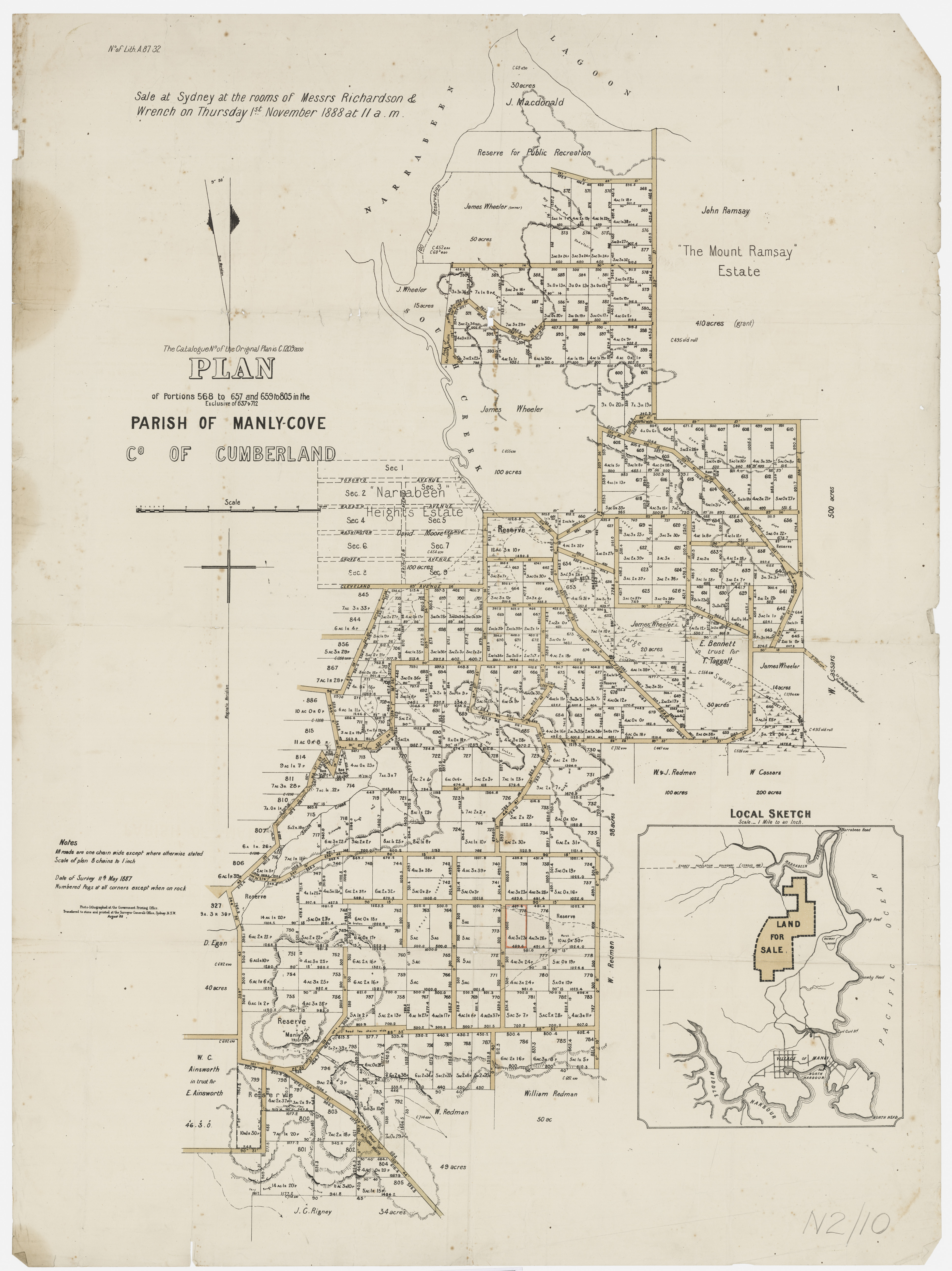
Plan of the Portions 568 to 657 and 659 to 805 in the exclusive of 637 and 712 - Parish of Manly-Cove - No boundaries shown, 1887. Item: c050370010, from Narrabeen subdivision plans, courtesy state Library of NSW - shows Ramsay estate, James Wheeler land holdings and J McDonald eland holdings
Relics of an Early Settler.
Certainly the most picturesque spot on the road between Manly and Pittwater (Newport) is Narrabeen beach and lagoon, or rather lake, the beach for some time providing a resting-place of the steamship Collaroy. Running behind and parallel with the beach is a strip of level well-grassed land, and from the borders of this rises a pretty ridge, heavily timbered at the southern end, but sloping on the north to the beautiful still waters, the meaning of the native name, of Narrabeen Lagoon. On this slope, commanding a view to the east over a wide expanse of ocean and sea coast, and to the west over Narrabeen, stood some old ruins buried almost in the grassy hillside. The ruins have lain undisturbed for many years, and have formed the subject of many conjectures as to the nature of the buildings which they represented. It is said that in the earliest times a sergeant in His Majesty the King's service, attracted by the beauty of the site, built the place. The escaped convicts were at the time very troublesome, and stealing forth from their hiding places in the rough country between the head of Middle Harbour and the Hawkesbury, gave much trouble to the settlers. The sergeant's house was at one time the scene of an encounter with an ex-convict, in which that officer and his wife were killed, and from that time the house was allowed to fall into ruin, and has gradually been covered by the hillside.
Some little time since, the land was purchased by Mr. Obed West, of Barcom Glen, and on it he had erected a handsome stone cottage. During the course of the work the men engaged dug up a number of coins, both silver and copper all bearing date about 1825. No doubt, it was about this time that the cottage stood inhabited, and it would be then that the tragic event referred to must have occurred. Relics of an Early Settler. (1884, December 13). The Maitland Mercury and Hunter River General Advertiser (NSW : 1843 - 1893), p. 13 (Second Sheet the the Maitland Mercury). Retrieved from http://nla.gov.au/nla.news-article18941705
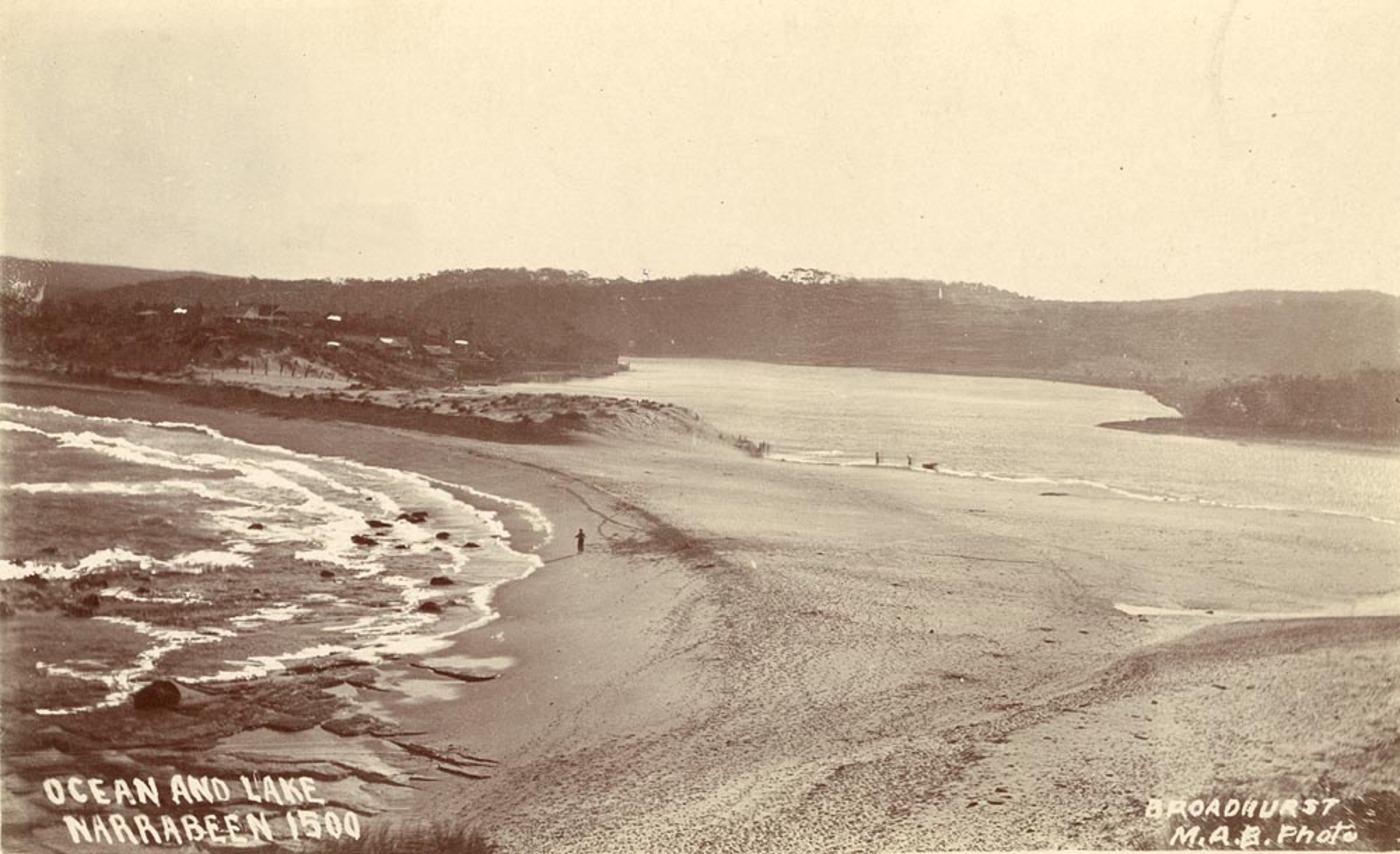
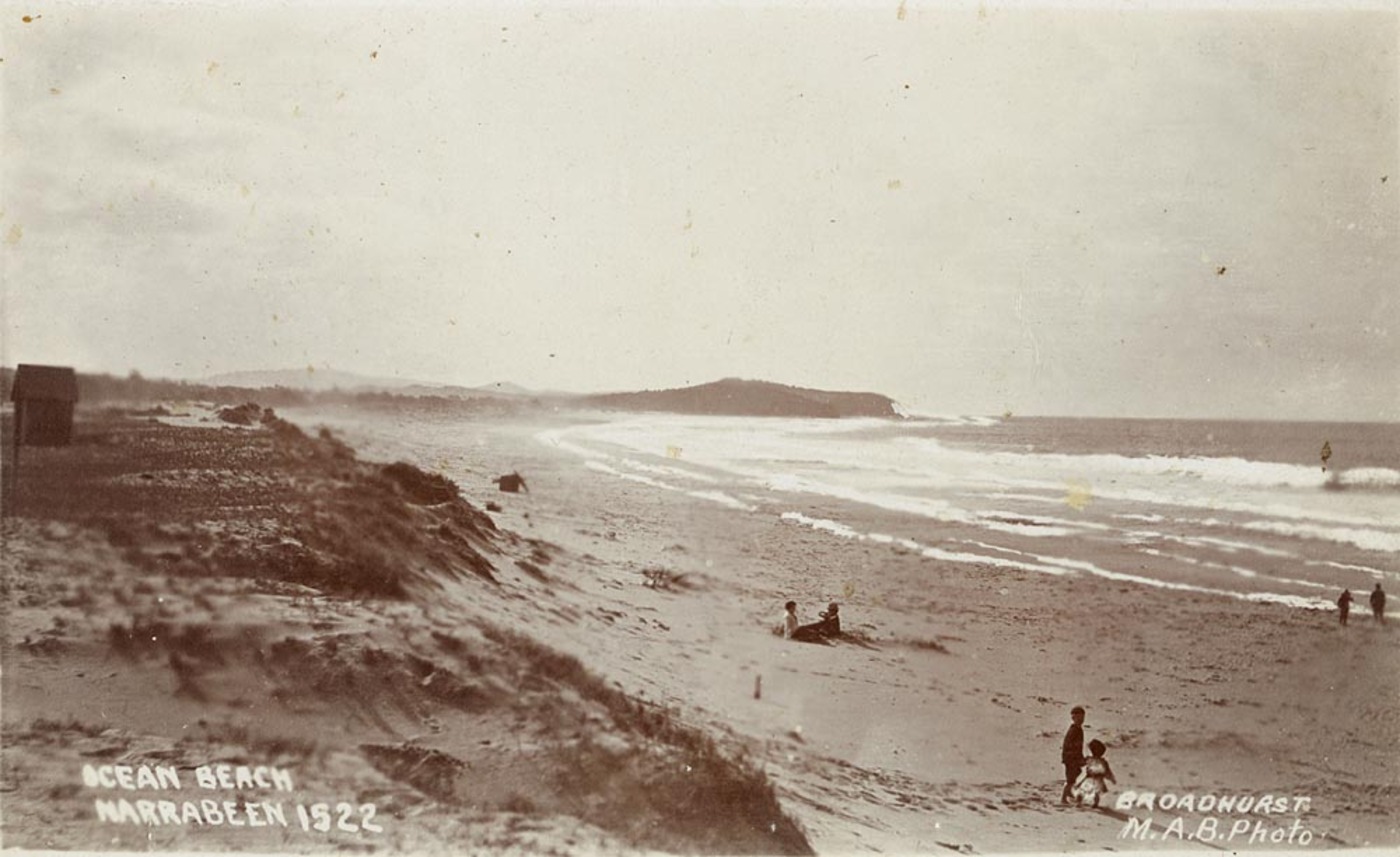
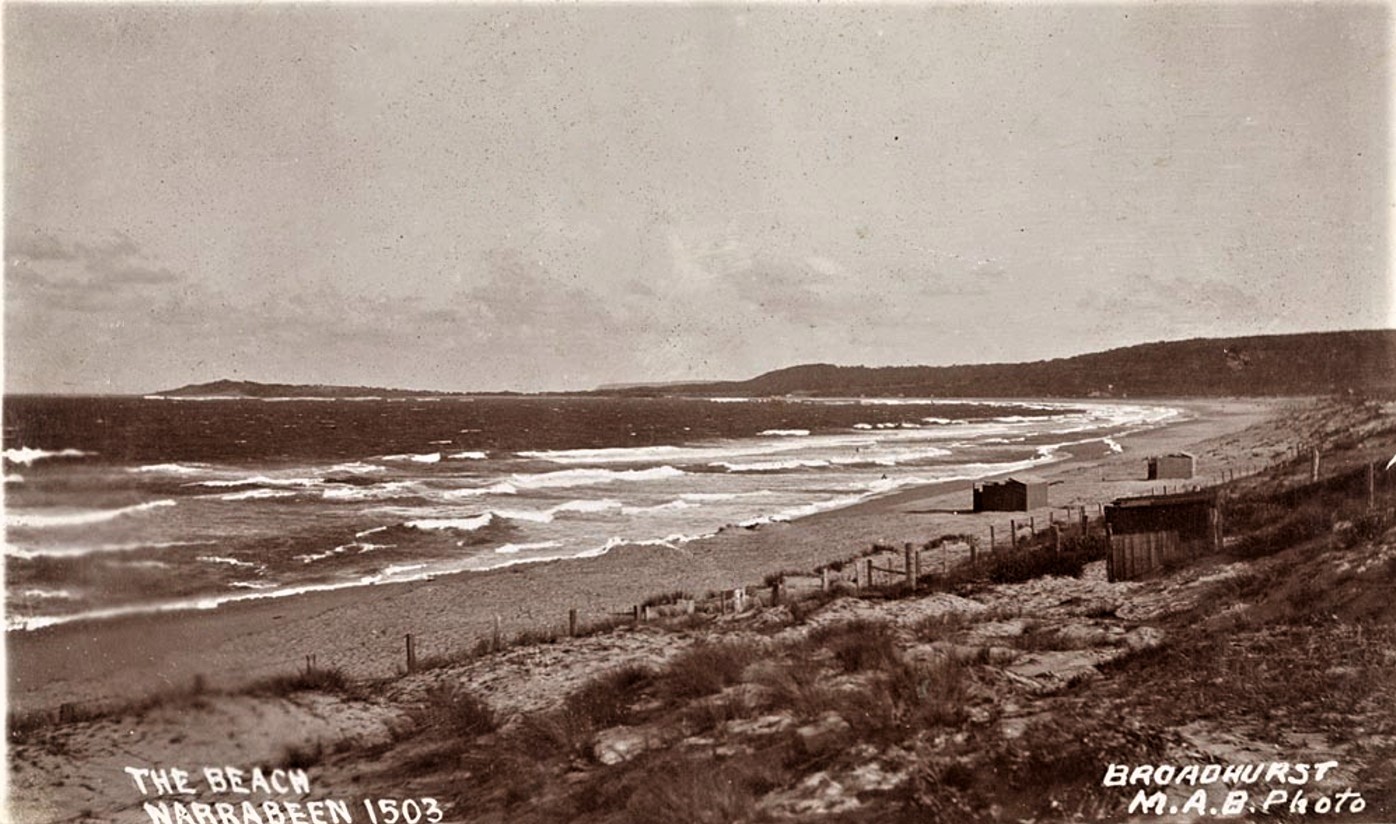
Ocean Beach Narrabeen and Views north and south at North Narrabeen and Collaroy Beach Image No.: .a106050h, a106051h a106052h, from Scenes of Narrabeen Album, Courtesy The Mitchell Library, State Library of Australia

Narrabeen from the Lookout. Image No.: a106055h, from Scenes of Narrabeen Album, Courtesy The Mitchell Library, State Library of Australia
